Cardano price teeters as Hoskinson rebuts mounting criticism
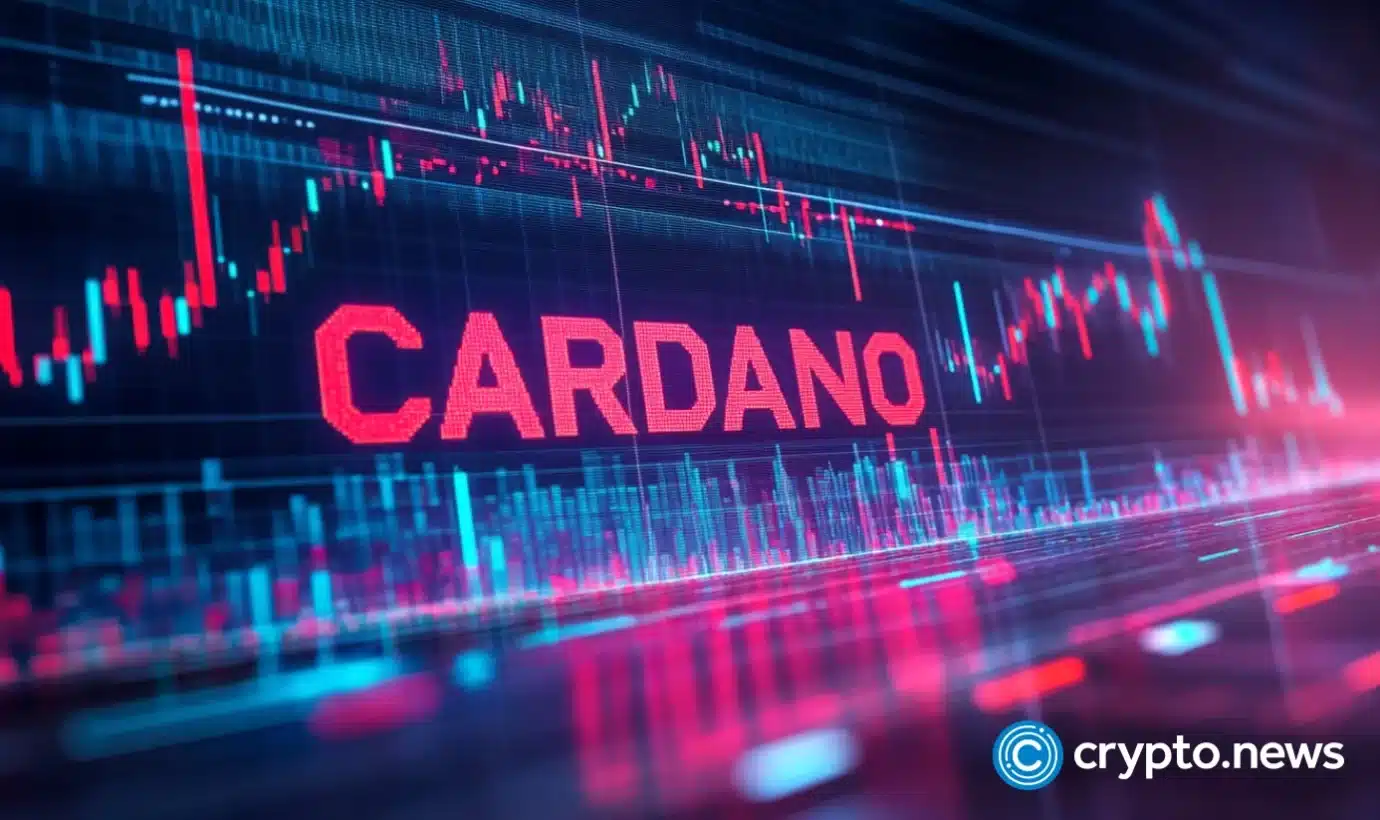


The post Coinpedia Digest: This Week’s Crypto News Highlights | 1st November, 2025 appeared first on Coinpedia Fintech News
It’s been a defining week for crypto. From SBF’s latest attempt to reshape his own history to PayPal’s entry into AI-powered payments, the headlines have been interesting.
If one thing stood out this week, it’s that crypto is entering a more grown-up phase and settling into its role as finance’s disruptor. Missed out on anything? We’ve got you!
Dive right in for the biggest stories.
Sam Bankman-Fried is back in headlines, insisting that FTX’s 2022 collapse wasn’t about insolvency but bad decisions. In a new 15-page statement, he claimed the exchange held $25 billion in assets, enough to repay users, before lawyers and new CEO John J. Ray III “forced” FTX into bankruptcy for profit.
[SBF says:]
— SBF (@SBF_FTX) October 31, 2025
This is where the money went. https://t.co/HVRwEw5Z1k https://t.co/5DrA13L5YE pic.twitter.com/O6q77DvmTn
He also alleged nearly $1 billion in fees were paid while assets worth billions were lost. Court records, however, showed Alameda secretly used customer funds, leading to the $8 billion shortfall.
The long wait for Mt. Gox creditors isn’t over yet. Trustee Nobuaki Kobayashi has extended the repayment deadline to October 31, 2026, citing unfinished procedures and verification delays. Many creditors are still waiting for restitution more than a decade after the exchange’s 2014 collapse.
Earlier repayments covered only verified claims, leaving thousands in limbo. Recent blockchain activity, including a $1 billion Bitcoin transfer in March, has fueled fresh speculation about how and when the remaining funds will finally move.
Seventeen years ago, an anonymous name, Satoshi Nakamoto, shared a short paper that changed how the world sees money. On October 31, 2008, the Bitcoin: A Peer-to-Peer Electronic Cash System white paper introduced the idea of a decentralized digital currency.
What started as a technical proposal is now a trillion-dollar industry and a global movement. The nine-page document set the foundation for blockchain technology and a new era of financial freedom that’s still unfolding today.
The Trump-Xi meeting ended with Washington backing off its trade pressure while Beijing barely blinked. The U.S. agreed to cut a fentanyl-related tariff by 10% and delay new ones, while China extended its pause on rare earth export controls – a move experts say keeps it in control.
“It’s more like our surrendering,” wrote Nicholas Kristof in The New York Times. Trump called the meeting “amazing,” but Beijing’s cautious response hinted at who really came out stronger. For crypto markets, the thaw could signal a possible boost in risk appetite.
Bybit has stopped accepting new user registrations in Japan from October 31 as it works to meet the Financial Services Agency’s regulatory requirements. The pause, which applies to both individuals and companies, won’t affect existing users for now.
Japan’s regulators have become more watchful of unregistered exchanges, tightening crypto laws over the past year. Interestingly, even as it slows in Japan, Bybit has secured a full license in the UAE, strengthening its position as a compliant global exchange.
Cardano founder Charles Hoskinson has taken aim at gold supporter Peter Schiff, saying his Bitcoin predictions have been wrong time and again. In a post on X, Hoskinson said Schiff’s constant bearish calls “no longer move markets,” noting he’s been off at every major price level – from $100 to $100,000.
Peter continues to be wrong and utterly irrelevant. He was wrong at 100 dollar bitcoin. He was wrong at 1000 dollar bitcoin. He was wrong at 10,000 dollar bitcoin. He is wrong at 100,000 dollar bitcoin.
— Charles Hoskinson (@IOHK_Charles) October 29, 2025
He will be wrong at million dollar bitcoin. https://t.co/hpTVATc1qf
Schiff recently claimed Bitcoin remains over 10% below its all-time high, calling it “a speculative asset.” Hoskinson fired back, saying Schiff’s model has failed four times over.
Shiba Inu has taken a big step toward Wall Street. T. Rowe Price, a global investment firm managing over $1.7 trillion, has filed a Form S-1 with the SEC to launch its Active Crypto ETF. The fund will track major digital assets including Bitcoin, Ethereum, Dogecoin, and Shiba Inu.
If approved, it would mark the first U.S. ETF to include SHIB, giving institutional investors regulated exposure to the token. The move adds new credibility to Shiba Inu’s growing ecosystem.
Fight Fight Fight LLC, the company behind the TRUMP token, is in talks to buy the U.S. arm of Republic.com, Bloomberg reported. The move could give the token a bigger real-world use, allowing investors and startups to transact directly in crypto.
Republic.com, backed by Galaxy Digital and Binance’s venture arm, has supported over 3,000 fundraises. If the deal goes through, it could mark a major step in bringing the Trump memecoin into mainstream finance.
Also Read: After 13 Million Tokens and a 90% Drop, Are Meme Coins Finally Done?
JPMorgan CEO Jamie Dimon, long known for his harsh stance on Bitcoin, is finally giving blockchain some credit. Speaking recently, Dimon said stablecoins and JPMorgan’s internal blockchain systems could hold real value in modern finance.
“This technology could replace many of today’s outdated systems – slow, fragmented, and far from 24/7,” he noted. Still, Dimon stressed that decentralization makes coordination difficult, which is why JPMorgan continues building on its private blockchain.
Western Union is stepping further into the crypto space. Just a day after announcing its Solana-based stablecoin USDPT, the company has filed a trademark for “WUUSD.” The filing covers wallet software, payments, and trading services, suggesting a wider digital asset plan in the works.
Analysts say stablecoins could lower settlement costs and speed up cross-border payments – a potential game-changer for remittance markets.
Read More: How Did the Bitwise Solana ETF Perform Compared to Bitcoin and Ethereum?
Here’s a few quick hits you shouldn’t miss!
PayPal Teams Up With OpenAI for ChatGPT Shopping: The tie-up will bring instant checkout inside the chatbot, letting users browse and buy products seamlessly. It also hints at PayPal’s growing digital focus and possible future links between AI payments and crypto.
Ethereum’s Fusaka Hard Fork Set for December 3: The upgrade will boost scalability and efficiency with PeerDAS and a higher gas limit, marking another milestone in Ethereum’s development.
KRWQ Becomes First Korean Won Stablecoin on Base: IQ and Frax launched the fiat-backed token on Base using LayerZero’s tech, bringing the Korean won on-chain with cross-chain transfers and plans for full regulatory compliance.
CZ Statue Memecoin Crashes 99% After Founder’s Warning: The “czstatue” token soared 27,000% before collapsing after CZ told followers, “Don’t buy the meme.” Over 1,100 holders were left with losses as the contract was flagged a honeypot.
Chinese Man Arrested in Bangkok Over $14M Crypto Scam: Thai police arrested Chinese national Liang Ai-Bing, accused of running the FINTOCH Ponzi scheme that defrauded nearly 100 investors. The arrest followed cross-border cooperation with Chinese authorities.
Major shifts to expect ahead
Momentum, regulation, and innovation are finally moving in the same direction. This is an exciting phase for the market. Tune back in next week for another edition of Coinpedia Digest!
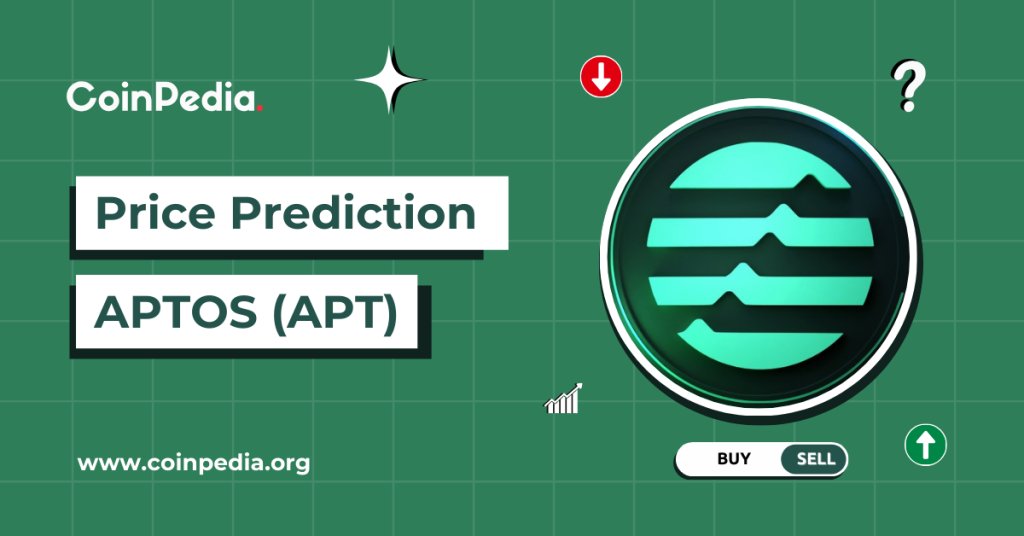
The post Aptos Coin Price Prediction 2025, 2026 – 2030: Will APT Price Hit $25? appeared first on Coinpedia Fintech News
Aptos is a next-gen layer-1 blockchain designed to fix scalability and security. Launched in October 2022, it’s built on the Move programming language, which helps developers create safer and more scalable smart contracts.
Unlike other blockchains that struggle with speed and high costs, it uses the Proof-of-Stake (PoS) mechanism, making it one of the fastest blockchains in the space. It also supports a wide range of Web3 applications.
Now, as the crypto market gears up for its next big rally, many are eyeing Aptos’ token APT’s price. Even as the token unlock is scheduled for the current month. If you are one among the many, read our detailed Aptos price prediction to know what’s coming next.
| Cryptocurrency | Aptos |
| Token | APT |
| Price | $3.3004
|
| Market Cap | $ 2,374,572,007.05 |
| 24h Volume | $ 89,342,976.9935 |
| Circulating Supply | 719,487,243.9258 |
| Total Supply | 1,182,335,055.8240 |
| All-Time High | $ 19.9032 on 30 January 2023 |
| All-Time Low | $ 2.2209 on 10 October 2025 |
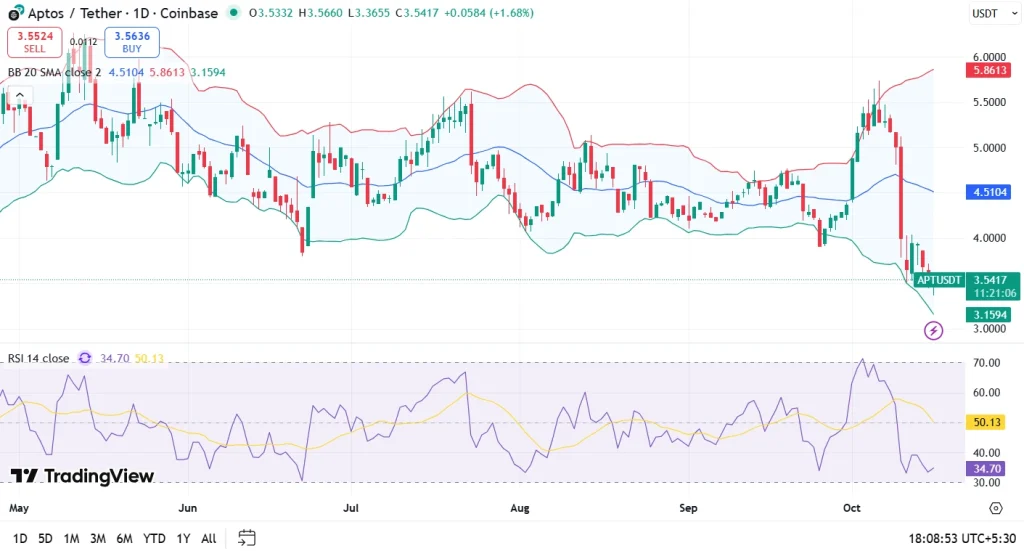
Aptos (APT) is trading near $3.28, holding below the 20-day SMA at $4.51. Technicals indicate:
Aptos now ranks third in tokenized asset value, with $538 million in TVL. Institutional players like BlackRock’s BUIDL and Franklin Templeton’s BENJI are contributing to this growth. Moreover, the team is also working on a horizontal scaling solution to stabilize 500,000+ TPS by September 2025.
On the technical front, Aptos is developing Shardines, a horizontal scaling upgrade expected by September 2025. While 32.5 percent of APT tokens remain locked until 2028, periodic unlocks may lead to short-term dips.
Successively, this could lead the APT coin price prediction to surge to a maximum of $20.68 in 2025. Conversely, growing dominance and potential rivals could bring the Aptos price down to $4.62. Considering the volatile market situation, the average price could settle at $12.62.
| Year | Potential Low | Average Price | Potential High |
| 2025 | $4.62 | $12.62 | $20.68 |
Curious about the future of crypto AI tokens? Explore our NEAR Token Price Prediction to find out if it will hit $10!
| Year | Potential Low ($) | Average Price ($) | Potential High ($) |
| 2026 | $10.28 | $18.56 | $28.97 |
| 2027 | $15.78 | $25.00 | $33.22 |
APT coin price prediction for the year 2026 could range between $10.28 to $28.97, and the average price of Aptos could be around $18.56.
Apto’s price for the year 2027 could range between $15.78 to $33.22, and the average price of APT could be around $25.00.
| Year | Potential Low ($) | Average Price ($) | Potential High ($) |
| 2028 | $20.36 | $30.91 | $45.61 |
| 2029 | $25.66 | $38.16 | $53.54 |
| 2030 | $30.95 | $45.47 | $60.13 |
APT crypto prediction for the year 2028 could range between $20.36 to $45.61, and the average Aptos coin price could be around $30.91.
Aptos’s forecast for the year 2029 could range between $25.66 to $53.54, and the average APT coin price could be around $38.16.
APT predictions for the year 2030 could range between $30.95 to $60.13, and the average Aptos price could be around $45.47.
| Firm | 2025 | 2026 | 2030 |
| Wallet Investor | $16.25 | $19.92 | – |
| priceprediction.net | $21.84 | $32.36 | $141.41 |
| DigitalCoinPrice | $29.43 | $40.17 | $86.30 |
*The targets mentioned above are the average targets set by the respective firms.
Factors like more projects and collaboration could bring more recognition to Aptos. This will also boost the sentimental belief of investors and traders. Hence, the price prediction of APT could reach $21.62 in 2025.
On the downside, increasing FUD amongst investors and a lack of updates could curb the price to the bottom at $4.62, making an average of $12.62.
| Year | Potential Low | Average Price | Potential High |
| 2025 | $4.62 | $12.62 | $20.62 |
Unlock the potential of AI with Fetch.ai! Dive into our FET price prediction and discover how this AI token could drive innovation in the coming years!
Aptos has shown a very strong potential lately, this could be a good opportunity to invest in this asset.
Yes, Aptos is a layer 1 blockchain with resource objects and Move programming language.
The price of APT could possibly reach its maximum of $20.68 this year.
It has a circulating supply of 486 Million APT coins and a total supply of 1,130,000,000,000 APT tokens.
With a potential surge, the price may go as high as $60.13 by 2030.
Aptos uses a different smart contract programming language than that of Ethereum. As a result, it could be much better equipped to handle Web3 innovations related to apps, games, and the metaverse.
Aptos was founded by Avery Ching and Mo Shaik, on 12th October 2022.
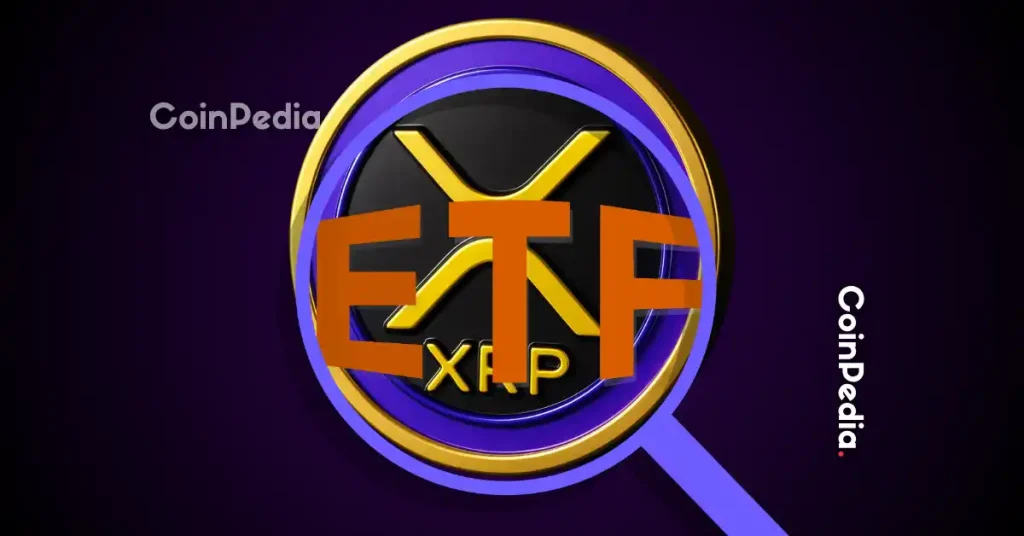
The post XRP Price Prediction November 2025: Traders Eyes $5 Ahead Of Canary’s ETF Approval appeared first on Coinpedia Fintech News
As the XRP price prediction November 2025 gains attention, the token’s outlook is brightening ahead of ETF approval. With the XRP ETF launch date drawing near, Ripple’s expanding payment infrastructure and a surge in on-chain metrics could ignite a significant rally, potentially driving prices toward the long-awaited $5 mark.
After months of anticipation, the XRP community is preparing for a defining moment as Canary Capital’s XRP ETF gears up for a potential November 13, 2025 debut.
This development follows the firm’s amended filing that removed the “delaying amendment,” allowing the ETF to become auto-effective 20 days after submission.
If approved, this ETF would mark a major turning point, potentially mirroring the success of earlier Bitcoin and Ethereum ETF launches. Ripple’s previous legal victory against the SEC already boosted investor confidence earlier this year, and this ETF approval could provide the next wave of momentum.
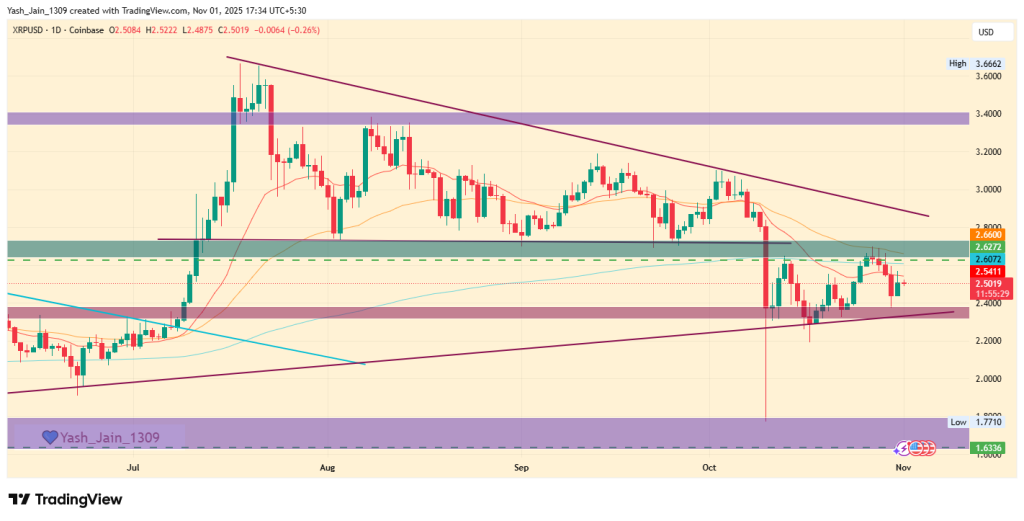
Currently, XRP price today sits near $2.5, recovering steadily from October’s pullback. Analysts believe that confirmation of a U.S.-listed ETF could set off a bullish breakout, supported by increasing speculative activity in XRP derivatives and growing institutional participation.
Beyond ETF headlines, Ripple’s ecosystem continues to show powerful on-chain expansion. According to data from XRPSCAN, the number of daily payments jumped from 37,539 in early October to over 1.05 million by month-end. Payment volumes have also skyrocketed from 11.19 million to 1.108 billion, underscoring renewed network demand.

Even the count of active sender accounts surged from just 2,035 to 28,297, while total transactions hit 1.93 million by late October. These metrics suggest growing adoption across Ripple’s payment network, driven by its efficient cross-border infrastructure that continues to bridge traditional finance and blockchain technology.

Such utility-driven expansion strengthens the XRP price forecast, reflecting both fundamental and speculative interest. With the weekly XRP price chart showing strong consolidation after a major breakout from a seven-year symmetrical triangle, the pattern indicates bullish accumulation before a potential next leg higher.
In the derivatives market, XRP crypto activity remains robust. Futures open interest now hovers around $4.21 billion, while derivative volumes have surged to $9.91 billion, up sharply from early October’s $3.7 billion lows. These figures highlight that traders are actively positioning for heightened volatility ahead of the ETF launch.

At the same time, competition among major asset managers is heating up. Besides Canary, several firms including WisdomTree, Grayscale, Bitwise, Franklin Templeton, and 21Shares have already filed for XRP ETF approval. The growing institutional race indicates that market confidence in XRP’s long-term utility is at an all-time high.
From a technical standpoint, XRP’s weekly chart suggests strong structural support, pointing to a potential move toward $5–$5.25 by year-end. The first half of 2026 could see prices advancing toward $7, with XRP price prediction models hinting at a $10 potential if institutional demand sustains.
$XRP price is under weekly rally retest phase from symm. tri
— topnotch (@topnotch1309) November 1, 2025patt. that suggest:-
2025: close at $5-$5.25
2026: Q1 will retest $XRP's $4 support
2026: Q2 will rise to $7.0 -$7.50
2026: Q3 will retest $XRP's $5 support
2026: Q4 will increase to $10.#CryptoTrading #XRP_analysis pic.twitter.com/22lCxcGrgj
As November unfolds, the XRP price prediction November 2025 reflects an turning point defined by utility growth, ETF momentum, and market conviction. Also it is signaling that the next breakout may just be around the corner.
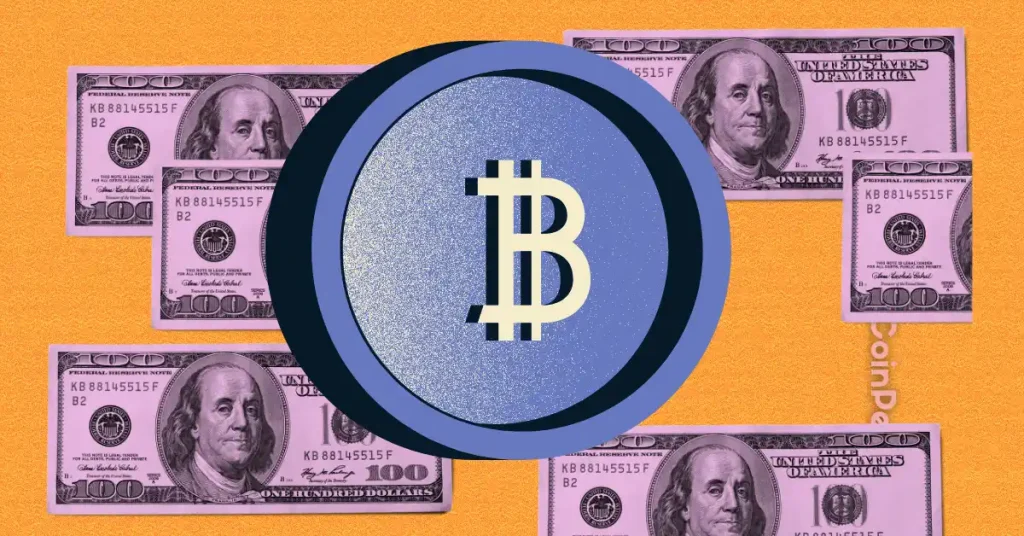
The post How Bitcoin Adoption in the U.S. Could Double by 2025 Insights from the Bitcoin Conference appeared first on Coinpedia Fintech News
At the Bitcoin 2025 conference, U.S. Senator JD Vance made a bold prediction that the number of Americans owning Bitcoin will double from around 50 million to 100 million in the coming years. He described Bitcoin as a symbol of innovation, financial freedom, and a strong hedge against inflation and government overreach, emphasizing that crypto is no longer a fringe movement but a mainstream reality.
Vance’s comments come as the U.S. moves closer to passing the Clarity Act, a long-awaited bill expected to settle crypto’s biggest legal gray area: who regulates it. For years, the SEC and CFTC have fought over jurisdiction, creating confusion for projects, exchanges, and investors. The Clarity Act aims to fix that by clearly defining which tokens are securities and which are commodities, giving the crypto industry a solid legal foundation to grow.
Analysts at Bitwise estimate there’s now an 80% chance the Clarity Act will pass by early 2026. If approved, it could mark the start of a new era for U.S. crypto markets, paving the way for banks, corporations, and institutional investors to fully embrace blockchain and Bitcoin integration.
The growing wave of Bitcoin ETFs and Wall Street interest has already boosted confidence in digital assets, but regulatory clarity could take that momentum to another level. With clear rules, more institutions are expected to launch crypto products, and more Americans could start viewing Bitcoin as part of their long-term savings or retirement strategies.
Vance’s optimism reflects the broader sentiment that Bitcoin’s best days may still be ahead. As the U.S. edges toward clearer regulation and financial institutions prepare to integrate blockchain into everyday use, the dream of mainstream crypto adoption looks closer than ever.
If the Clarity Act delivers on its promise, 2026 could be remembered as the year Bitcoin truly became a household name, not just an investment, but a cornerstone of the modern financial system.
Bitcoin is currently trading at around $109,956, with nearly 19.94 million BTC in circulation out of the total supply cap of 21 million coins. The top cryptocurrency hit an all-time high of $126,198 on October 7, 2025, and once traded as low as $0.0486 back in July 2010, a massive gain of over 226 million percent since then.
Although Bitcoin is down about 12.8% from its recent peak, it’s still showing strong long-term momentum. With its fixed supply limit, Bitcoin remains a deflationary asset, meaning scarcity could help support its value over time.
For traders, the 50-day moving average sits at $114,076, reflecting short-term price action, while the 200-day average is around $109,491, suggesting Bitcoin is holding steady in a broader uptrend despite the recent dip.
Stay ahead with breaking news, expert analysis, and real-time updates on the latest trends in Bitcoin, altcoins, DeFi, NFTs, and more.
Around 50 million Americans currently own Bitcoin in 2025, and experts predict that number could reach 100 million as adoption and regulation expand.
The Clarity Act defines which crypto assets are securities or commodities, providing long-awaited legal clarity that could boost investor confidence.
The CLARITY Act gives Bitcoin a clear regulatory status as a commodity, helping banks and institutions safely integrate it into financial systems.
Despite short-term volatility, Bitcoin’s fixed supply and rising global adoption make it a long-term store of value for many investors.
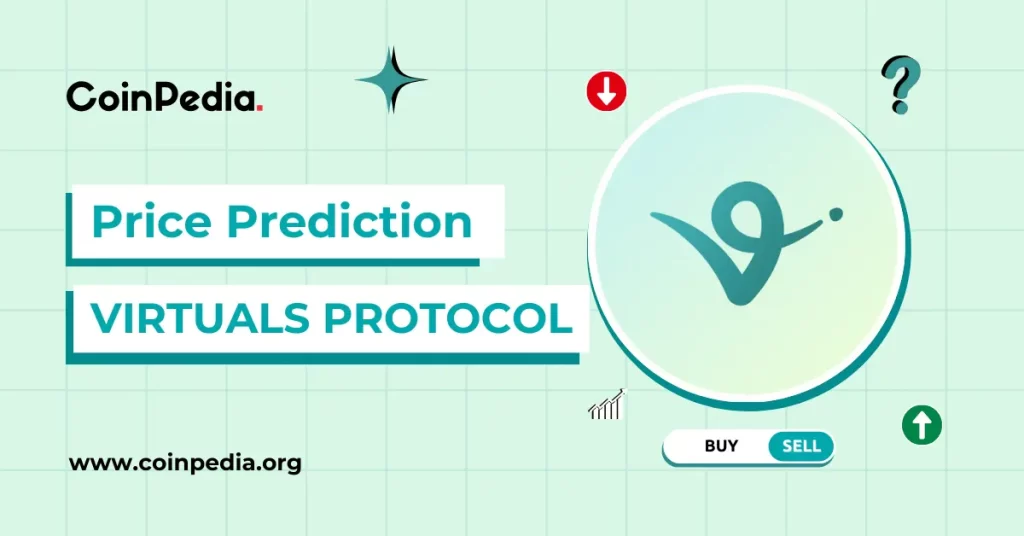
The post Virtuals Protocol Price Prediction 2025, 2026 – 2030: Will VIRTUAL Price Hit $5? appeared first on Coinpedia Fintech News
Launched on the Ethereum chain, the Virtuals Protocol is an innovative AI project to revolutionize virtual interactions. Notably, it is at the forefront of integrating AI with virtual atmospheres. Primarily designed to facilitate seamless virtual interactions, it is a key player in the Metaverse space.
Notably, it leverages AI to enhance user experiences in virtual worlds, enabling a more engaged and interactive space. This makes this one-of-a-kind project of this segment in the ever-growing crypto-verse.
Planning on investing in this undervalued AI project? CoinPedia’s expert panel has covered the Virtuals Protocol (VIRTUAL) Price Prediction 2025, 2026-2030.
| Cryptocurrency | Virtuals Protocol |
| Token | VIRTUAL |
| Price | $ 1.83861499  34.11% 34.11% |
| Market cap | $ 1,206,260,399.9583 |
| Circulating Supply | 656,070,141.7701 |
| Trading Volume | $ 989,270,944.2068 |
| All-time high | $5.07 on 02nd January 2025 |
| All-time low | $0.007605 on 24th January 2024 |
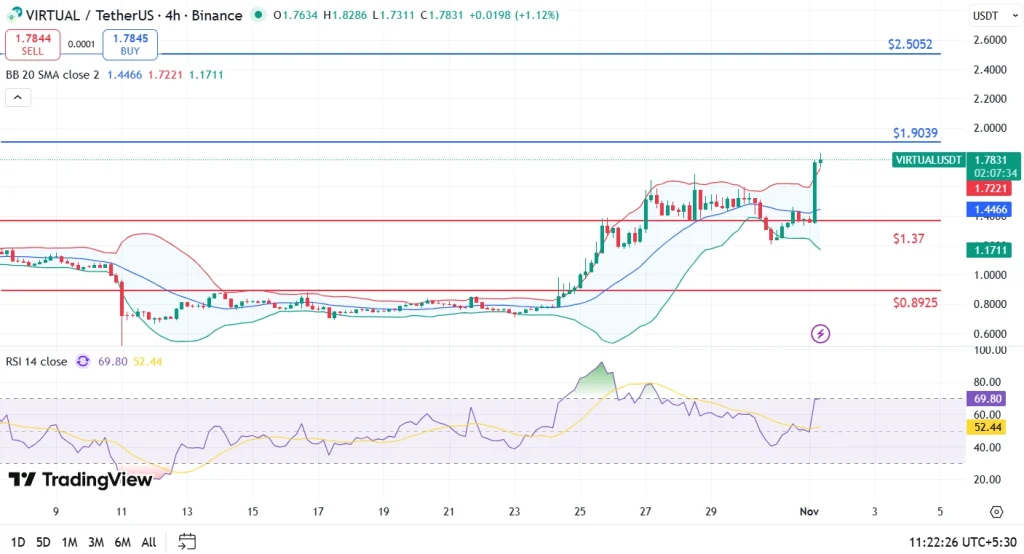
VIRTUAL) is trading at $1.79, with strong upward momentum. Technicals indicate:
If the Artificial Intelligence (AI) segment continues gaining momentum, this could result in this category experiencing exponential growth in the near future. Moreover, the token is also under consideration of Grayscale. With this, the VIRTUAL price could surpass its previous high and conclude the year with a new annual high of $4.50.
However, a bearish setback or unfavorable cryptocurrency regulations could pull the price of Virtuals Protocol toward its low of $1.50. Considering the market sentiment, the average price could settle at around the $3.00 mark.
| Year | Potential Low | Potential Average | Potential High |
| 2025 | $1.50 | $3.00 | $4.50 |
Wondering about the long-term price targets of ETH token? Read CoinPedia’s Ethereum Price Prediction to unfold the possible mysteries!
| Year | Potential Low ($) | Potential Average ($) | Potential High ($) |
| 2026 | $2.25 | $4.50 | $6.75 |
| 2027 | $3.38 | $6.75 | $10.13 |
Virtuals could witness increased traction from expanding AI-metaverse adoption, with prices likely stabilizing around $2.25 to $6.75 as investor confidence grows.
Enhanced partnerships and new real-world integrations may push the token’s value between $3.38 and $10.13, reflecting deeper ecosystem engagement.
| Year | Potential Low ($) | Potential Average ($) | Potential High ($) |
| 2028 | $5.06 | $10.13 | $15.19 |
| 2029 | $7.59 | $15.19 | $22.78 |
| 2030 | $11.39 | $22.78 | $34.16 |
As decentralized identity solutions evolve, Virtuals may sustain growth momentum, potentially fluctuating from $5.06 to $15.19 during the year.
With wider adoption of AI avatars and virtual environments, the VIRTUAL token might range between $7.59 and $22.78, driven by rising metaverse demand.
If Virtuals maintains innovation and secures global recognition, the token could achieve long-term stability near $11.39 to $34.16 as market maturity peaks.
Are you considering stacking AIOZ token in your portfolio? Read our Aioz Network Price Prediction until 2030!
| Firm Name | 2025 | 2026 | 2030 |
| CoinCodex | $4.08 | $3.32 | $6.96 |
| Changelly | $1.90 | $2.35 | $10.27 |
*The aforementioned targets are the average targets set by the respective firms.
With more fundamental updates and partnerships with data giants, the Virtuals Protocol crypto token could create a significant impact in the AI segment. With this, the altcoin could push its value toward a new all-time high (ATH) in this AltSeason.
Suppose the crypto market turns extremely greedy, in that case, the VIRTUAL price could reach a high of $4.50. However, under a bearish situation or a pump-and-dump situation, this AI project could plunge toward its annual low of $1.50.
| Year | Potential Low | Potential Average | Potential High |
| 2025 | $1.50 | $3.00 | $4.50 |
Planning on investing in JUP crypto token before the altcoin market begins? Read CoinPedia’s Jupiter Price Prediction!
Virtuals Protocol is a unique blockchain-based Artificial Intelligence project that aims to restructure virtual interchanges via its AI and Metaverse protocol.
The VIRTUAL crypto token is available for trading on major centralized cryptocurrency exchanges.
Considering a bullish outlook, this altcoin could conclude the year 2025 with a potential high of $4.50.
Yes, the Virtuals Protocol token is listed on the Coinbase wallet for trading.
With a potential surge, the VIRTUAL coin price may reach a maximum trading price of $34.16 by 2030.
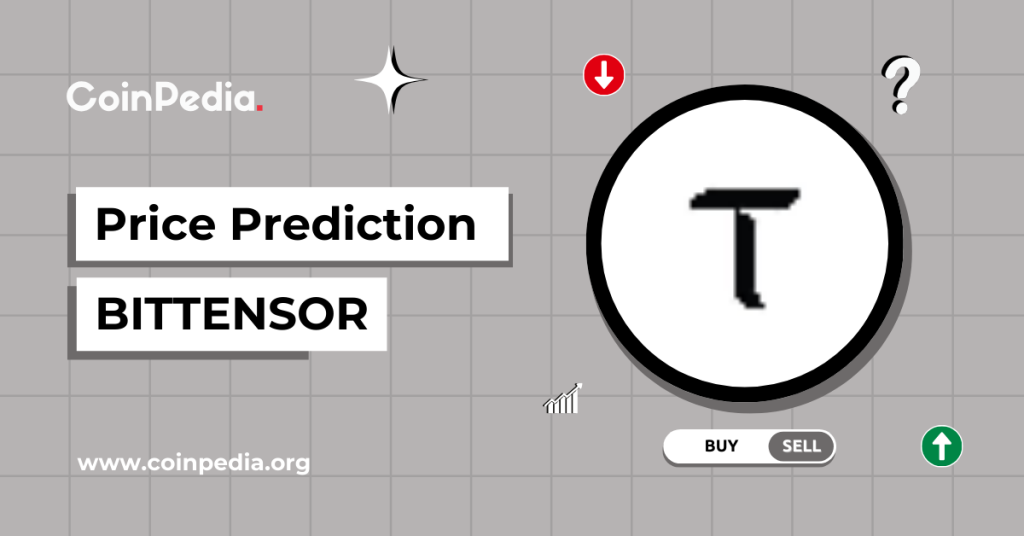
The post Bittensor Price Prediction 2025, 2026 – 2030: Will TAO Price Record A 2X Surge? appeared first on Coinpedia Fintech News
Bittensor is proving to be one of the most exciting projects in the crypto and AI world. After a big price surge in early 2025 during the AI investment boom, TAO’s price dropped back to the same price it had in mid-2024. But despite the volatility, the token continues to push forward, refining its technology and expanding its ecosystem.
Contrarily, Libertex has officially listed TAO in its CFD lineup, making the token easier to trade and more accessible to a wider audience. The listing allows traders to engage with TAO through leveraged products. With CFDs now available, TAO could see stronger liquidity as market participants gain more ways to enter, boosting exposure for the project across global markets.
Read the detailed Bittensor price prediction 2025, 2026-2030 to see where the AI-powered crypto price is headed.
| Cryptocurrency | Bittensor |
| Token | TAO |
| Price | $523.5209
|
| Market Cap | $ 5,347,568,553.73 |
| 24h Volume | $ 1,023,472,038.6224 |
| Circulating Supply | 10,214,622.2964 |
| Total Supply | 21,000,000.00 |
| All-Time High | $ 767.6797 on 11 April 2024 |
| All-Time Low | $ 30.4010 on 14 May 2023 |
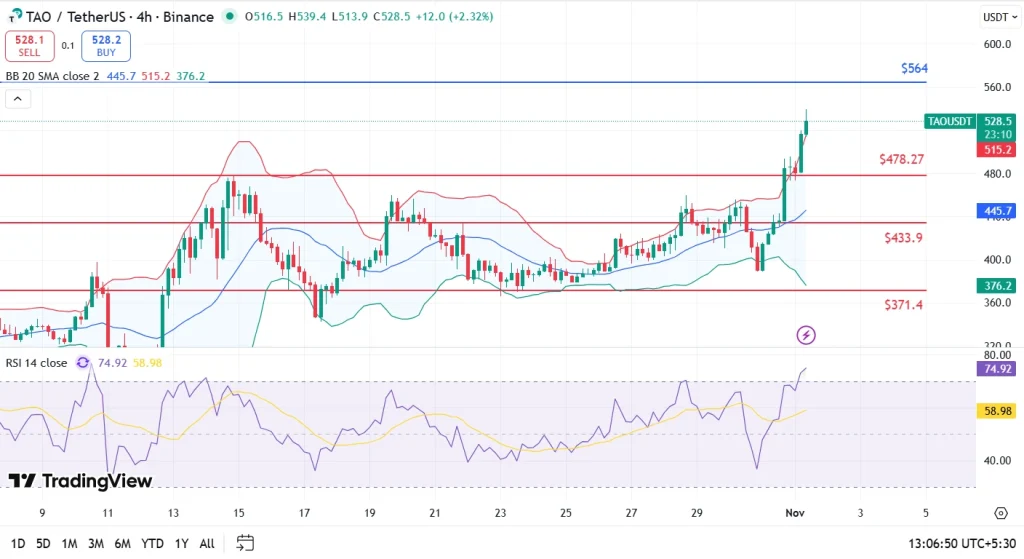
TAO is trading near $525.62, holding above the 20-day SMA at $343.9 after a sharp spike. Technicals indicate:
A major event is set for December 2025 when Bittensor will undergo its first halving, cutting daily TAO emissions from 7,200 to 3,600. This scarcity model mirrors Bitcoin but is tailored for AI adoption timelines. Institutional moves, such as Oblong Inc.’s $8 million TAO acquisition and increased staking by TAO Synergies, show confidence in its potential, though such concentrated buying may cause market swings.
A major part of the token lies in its incentive model. Every day, 7,200 TAO are emitted, with 18% flowing directly to subnet creators, which are like mini AI apps or services on the Bittensor network. Big firms are also starting to pay attention: Nasdaq-listed companies like Synaptogenix and Oblong have acquired $17.5 million worth of TAO since June 2025, mirroring the strategic moves MicroStrategy made with Bitcoin.
On an optimistic note, the TAO coin price could surge to a maximum of $779.00 during 2025. However, stricter regulation or a bearish action could result in this AI token losing momentum. With this, the price may conclude the year with a potential low of $259.67. Considering the buying and selling pressure, the average price could land at $519.33.
| Year | Potential Low | Potential Average | Potential High |
| 2025 | $259.67 | $519.33 | $779.00 |
Also, read our FET Price Prediction 2025, 2026 – 2030!
| Year | Potential Low ($) | Potential Average ($) | Potential High ($) |
| 2026 | $389.50 | $779.00 | $1,168.50 |
| 2027 | $584.25 | $1,168.50 | $1,752.75 |
The Bittensor crypto can record a potential high of $1,168.50 in 2026, with a potential low of $389.50. This could result in it experiencing an average price of $779.
Looking forward to 2027, the TAO price may record a low of $584.25, with a potential high of $1,752.75, and an average forecast price of $1,168.50.
| Year | Potential Low ($) | Potential Average ($) | Potential High ($) |
| 2028 | $876.38 | $1,752.75 | $2,629.13 |
| 2029 | $1,314.57 | $2,629.13 | $3,943.69 |
| 2030 | $1,971.85 | $3,943.69 | $5,915.54 |
Furthermore, the Bittensor Price for 2028 projects values between $876.38 and $1,752.75. With this, the average price could land at around $2,629.13.
TAO coin price could conclude 2029 with a potential high of $3,943.69, and a potential low of $1,314.57, with an average price of $2,629.13.
During 2030, the Bittensor token may record its lowest price at $1,971.85, with a potential high of $3,943.69, and an average trading price of $5,915.54.
| Firm Name | 2025 | 2026 | 2030 |
| Wallet Investor | $900.18 | $1,215.11 | – |
| priceprediction.net | $565.20 | $829.31 | $3,625 |
| DigitalCoinPrice | $1,211.42 | $1,672.52 | $3,586.02 |
CoinPedia’s price prediction for the TAO token suggests that this crypto may record a new all-time high (ATH) during the upcoming AltSeason. The Bittensor Price projection for 2025 predicts a high of $259.67, with an average price of $779.00.
| Year | Potential Low | Potential Average | Potential High |
| 2025 | $259.67 | $519.33 | $779.00 |
Read our Gnosis Price Prediction 2025, 2026 – 2030!
One can buy, hold, or sell TAO tokens by creating an account on a centralized or decentralized crypto exchange.
Yes, this project has aligned many exciting upgrades and features. This makes this altcoin a good buy for the long-term perspective.
The Bittensor price could reach a maximum of $779 in 2025.
This Artificial Intelligence (AI) token is available for buying and selling on all major centralized and decentralized platforms.
With a potential surge, this altcoin could range between $2,473 and $3,106 during 2030.
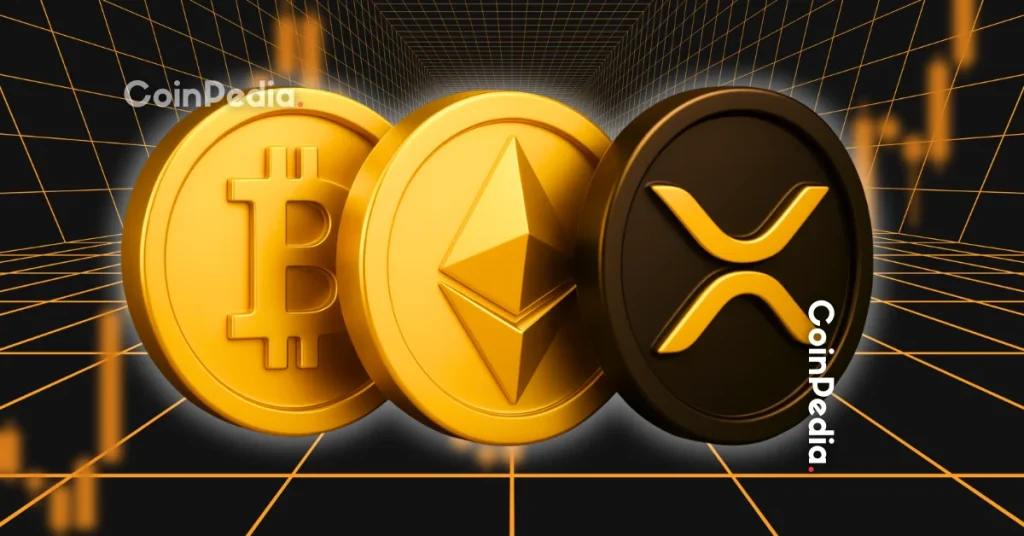
The post Bitcoin, Ethereum, XRP Price Prediction for November 2025, What’s Coming? appeared first on Coinpedia Fintech News
As November 2025 opens, the crypto market posts a 0.58% daily gain, taking global capitalization to $3.71 trillion. Despite the modest uptick, traders face a climate of caution: the market’s 7-day loss stands at -1.01%, even as privacy coins rally and technical indicators show mixed momentum.
Total 24-hour volume is robust at $143.461 billion, but the Fear & Greed Index reflects skittish sentiment at just 33. The broader Altcoin Season Index prints a tepid 32/100, and with the average crypto RSI at 46.3, most majors sit in neutral territory. Ethereum’s negative funding rates hint at an impending short squeeze, while a 0.45 correlation to the Nasdaq reflects strong macro optimism.
Bitcoin price trades at $110,163.62 after slipping -1.45% for the week, but retains a near-flat 24-hour change. The chart indicates a series of lower highs above $109,200, closely shadowing tightening Bollinger Bands—a classic precursor to heightened volatility. With volume dropping 2.7% over 24 hours, traders are bracing for a large directional move.
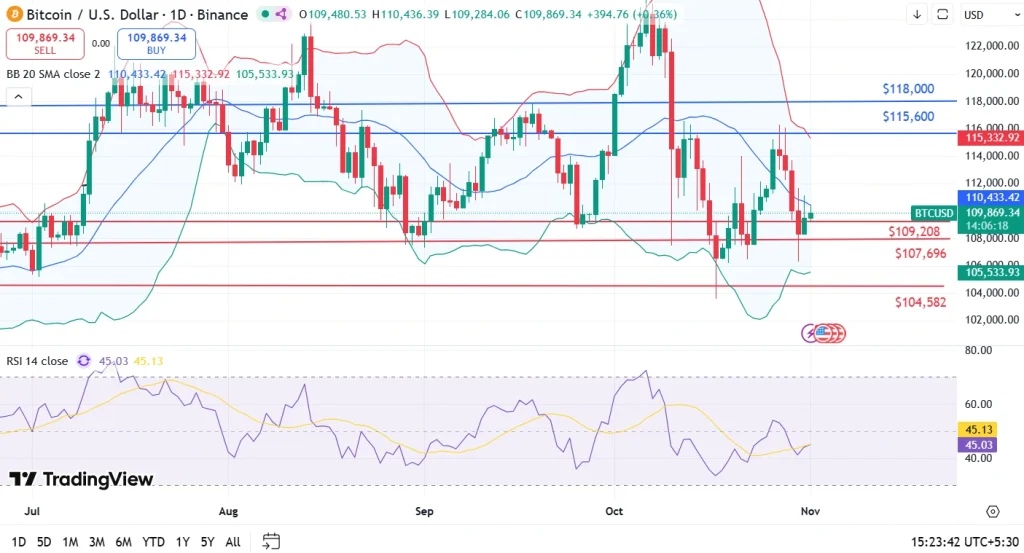
Technically, BTC’s daily support holds at $109,208, with secondary cushions at $107,696 and $104,582. Resistance aligns with the mid-band near $110,433 and extends toward $115,600. If BTC breaks above today’s immediate resistance at $110,433, it could target the $115,600-$118,000 region. Conversely, failing to hold $109,200 risks a further dip to $107,696.
Historically, November delivers outsized Bitcoin gains (42.5% average since 2013). And institutional interest, underscored by Steak ’n Shake’s treasury allocation, bolsters the bullish narrative for a possible late-month surge.
Ethereum hovers at $3,878.86, down slightly for the week but up 0.79% in 24 hours. The daily chart reveals a technical bounce from the $3,713 support, with price rebounding inside a tightening Bollinger Band. Oversold RSI readings and a nascent MACD crossover suggest a short-term momentum reversal is forming.

ETH price faces strong resistance at $4,101 and upper hurdles at $4,194 and $4,265. On the downside, $3,713 remains the pivot to watch, with deeper support near $3,698. This week saw $643 million in ETH exit exchanges, reducing immediate sell pressure, while persistent negative funding rates offer short squeeze fuel. If bulls reclaim $3,950, a move toward $4,100–$4,200 is feasible. However, failure at $3,713 would expose $3,698 and possibly $3,495.
XRP trades at $2.51 with minor daily gains (+1%) despite a -1.29% weekly slip. The chart displays sideways movement around $2.50 as Bollinger Bands tighten and RSI hovers near 45, indicating neither strong overbought nor oversold conditions. Notably, a potential bullish MACD crossover is materializing near the critical $2.50 support.
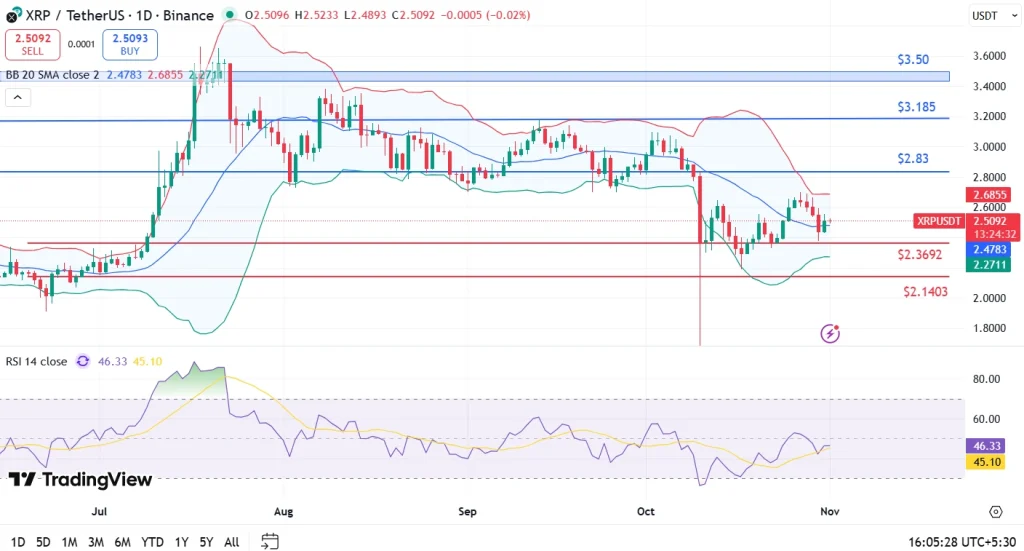
Bitwise’s XRP ETF progress and RLUSD stablecoin adoption headlines have cheered sentiment, counteracting weak volume (-28.57% in 24 hours). If XRP holds above $2.50, price targets cluster at $2.68 and stretch to $2.83. A breakdown risks $2.37 and, in extension, $2.14. With fundamentals aligning and technicals cautiously optimistic, XRP price could challenge $2.68–$2.83 on positive news flow.
Tightening Bollinger Bands and lower volumes usually precede significant price swings, combined with institutional accumulation, this sets the stage for volatility.
Oversold RSI, strong exchange outflows, and negative funding rates signal conditions are ripe for a short squeeze-driven recovery.
If ETF approval occurs and RLUSD adoption widens, XRP could see renewed upside, targeting the $2.68–$2.83 resistance band.
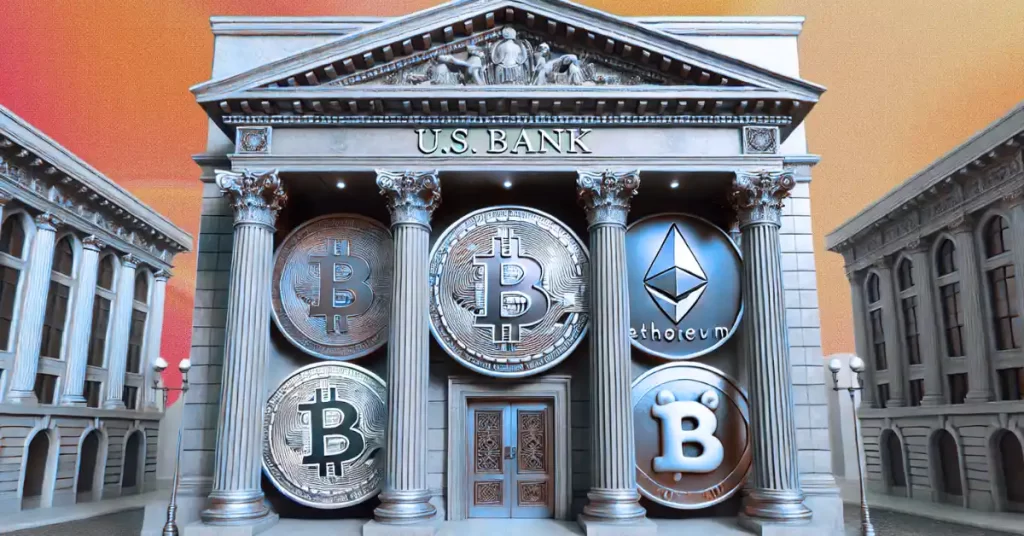
The post Custodia Bank Loses Appeal as Court Upholds Fed’s Crypto Account Rejection appeared first on Coinpedia Fintech News
The fight between Custodia Bank and the Federal Reserve just took another sharp turn, and it’s not in favor of crypto. A U.S. 10th Circuit Court of Appeals has sided with the Fed’s decision to deny Custodia Bank a master account, a move that effectively keeps crypto-focused banks locked out of the nation’s central banking system for now.
Custodia applied for a Fed master account in 2020 to bridge crypto and traditional banking. After a 19-month wait, the Fed rejected the request in January 2023, citing weak risk management in its crypto-focused model.
Custodia sued, arguing the Fed had no right to deny eligible applicants. However, the appeals court recently ruled in favor of the Fed, upholding its authority to protect financial stability.
In its recent decision, the appeals court sided with the Fed.
Statement of @custodiabank: pic.twitter.com/6U0FPzaKCm
— Custodia Bank(@custodiabank) October 31, 2025
Judge Timothy Tymkovich disagreed with the decision, saying the Fed’s rules require it to give access to all eligible banks. Custodia called the ruling “disappointing” but said it might appeal, as similar cases could set different precedents.
For now, the decision keeps crypto-focused banks locked out of the Fed’s payment system, a setback for those trying to bridge crypto with traditional finance.
Still, change could be coming. Fed Governor Christopher Waller has proposed introducing “skinny master accounts” for fintech and stablecoin firms. These accounts would allow limited, highly regulated access to the Fed’s payment systems, with strict conditions like no overdrafts, no interest, and capped balances.
If implemented, it could represent the Fed’s cautious first move toward engaging with the crypto sector, offering access, but under tight control.
Stay ahead with breaking news, expert analysis, and real-time updates on the latest trends in Bitcoin, altcoins, DeFi, NFTs, and more.
The court ruled the Fed has discretion to deny access, citing weak risk controls in Custodia’s crypto model and its duty to protect financial stability.
The decision keeps crypto-focused banks out of the Fed’s system for now, limiting their ability to directly settle payments or hold reserves.
No. The court clarified that eligibility doesn’t guarantee access — the Fed can deny accounts to safeguard the financial system.
Yes. Custodia plans to consider an appeal, and future cases could shape how courts balance innovation with regulatory oversight.
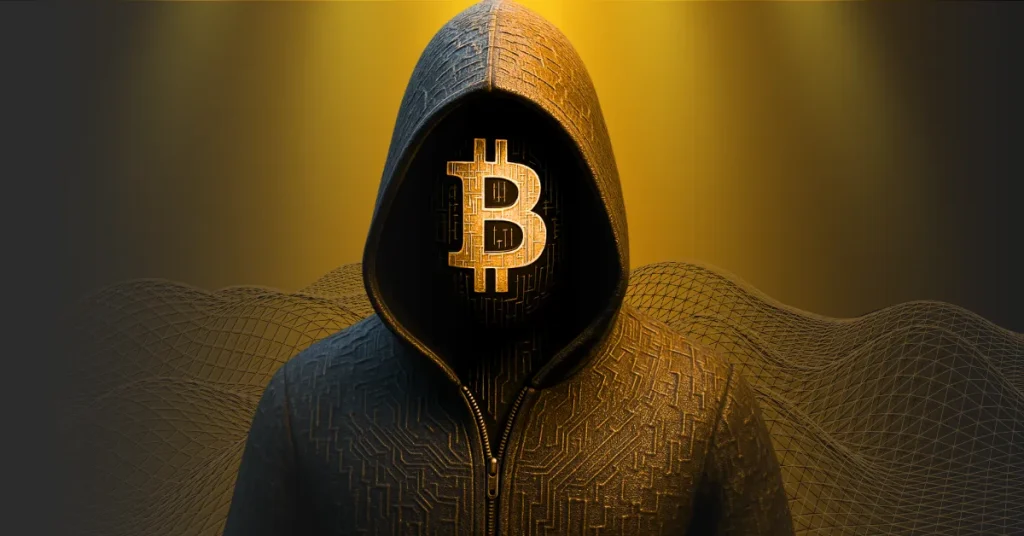
The post Thodex Founder Found Dead in Prison appeared first on Coinpedia Fintech News
Faruk Fatih Ozer, founder and former CEO of the Turkish cryptocurrency exchange Thodex, was found dead on November 1, 2025, in his prison cell. Authorities are investigating the possibility of suicide. Ozer was serving a staggering 11,196-year sentence, given in 2023 for charges including fraud and money laundering. Thodex, founded in 2017, collapsed suddenly in 2021, leaving thousands of investors with losses around $2.6 billion. Ozer fled to Albania but was arrested and extradited back to Turkey. His death has renewed calls for stronger crypto regulations.

The post Solana vs XRP: Institutional Adoption Battle Heats Up Ahead of Ripple Swell Conference 2025 appeared first on Coinpedia Fintech News
A light-hearted clash broke out on X between Solana and an XRP supporter after Ripple promoted its upcoming Swell conference. The debate centered around which blockchain holds stronger institutional credibility, and Solana didn’t hold back in defending its position.
The drama began when an XRP fan commented under Ripple’s Swell promo, claiming that Ripple and XRP “are not on the same level” as Solana, tagging both Solana and Western Union. The comment came after news broke that Western Union would launch its new stablecoin on Solana’s blockchain, a move that caught the attention of both the XRP and Solana communities.
Solana quickly responded, agreeing with the post, but with a twist. “Correct, not on the same level,” the Solana account wrote, before sharing proof of its growing institutional traction. The reply included mentions of major partnerships and endorsements from financial giants like Citi, Franklin Templeton, and Fidelity, along with reminders of recently approved spot Solana ETFs in the U.S.
Western Union’s decision to build on Solana reignited comparisons with Ripple, as the remittance firm had previously explored using Ripple’s technology and XRP for cross-border transfers. Now, with the company choosing Solana instead, XRP supporters expressed disappointment, while Solana fans celebrated the win as a sign of growing trust in its ecosystem.
However, both Ripple and Solana are expanding into institutional finance, but in different ways. Ripple continues to focus on regulated payments and partnerships through events like its Swell conference, which will feature executives from Citi, Franklin Templeton, and Fidelity. Solana, on the other hand, has rapidly gained recognition for its scalability and real-world applications, particularly in stablecoins and tokenized assets.
The playful online exchange highlights how competition between top blockchain projects is heating up, especially as institutions increasingly embrace blockchain technology. For now, Solana’s confident response seems to have given it the upper hand, at least on social media.
Stay ahead with breaking news, expert analysis, and real-time updates on the latest trends in Bitcoin, altcoins, DeFi, NFTs, and more.
Western Union chose Solana for its high speed, low fees, and scalability, ideal for global remittance and real-world payments.
Both have strong ties—Ripple with regulated banks, Solana with asset giants like Fidelity and Franklin Templeton.
Speed, efficiency, and scalability make Solana a preferred choice for stablecoins and tokenized asset projects.
Yes, Solana’s fast and low-cost network could make it more appealing for large-scale financial integrations.



Kronos Research’s Vincent Liu expects Solana ETF inflows to continue next week, noting that rotation from Bitcoin and Ether will likely persist.

Crypto debates DeFi forks while AI companies lock trillions of tokens into proprietary training runs, building permanent data set monopolies. The window closes fast.

Bitcoin fell nearly 4% in October as ETF outflows closed out the month, but Bollinger Bands BTC price volatility odds hit record levels.
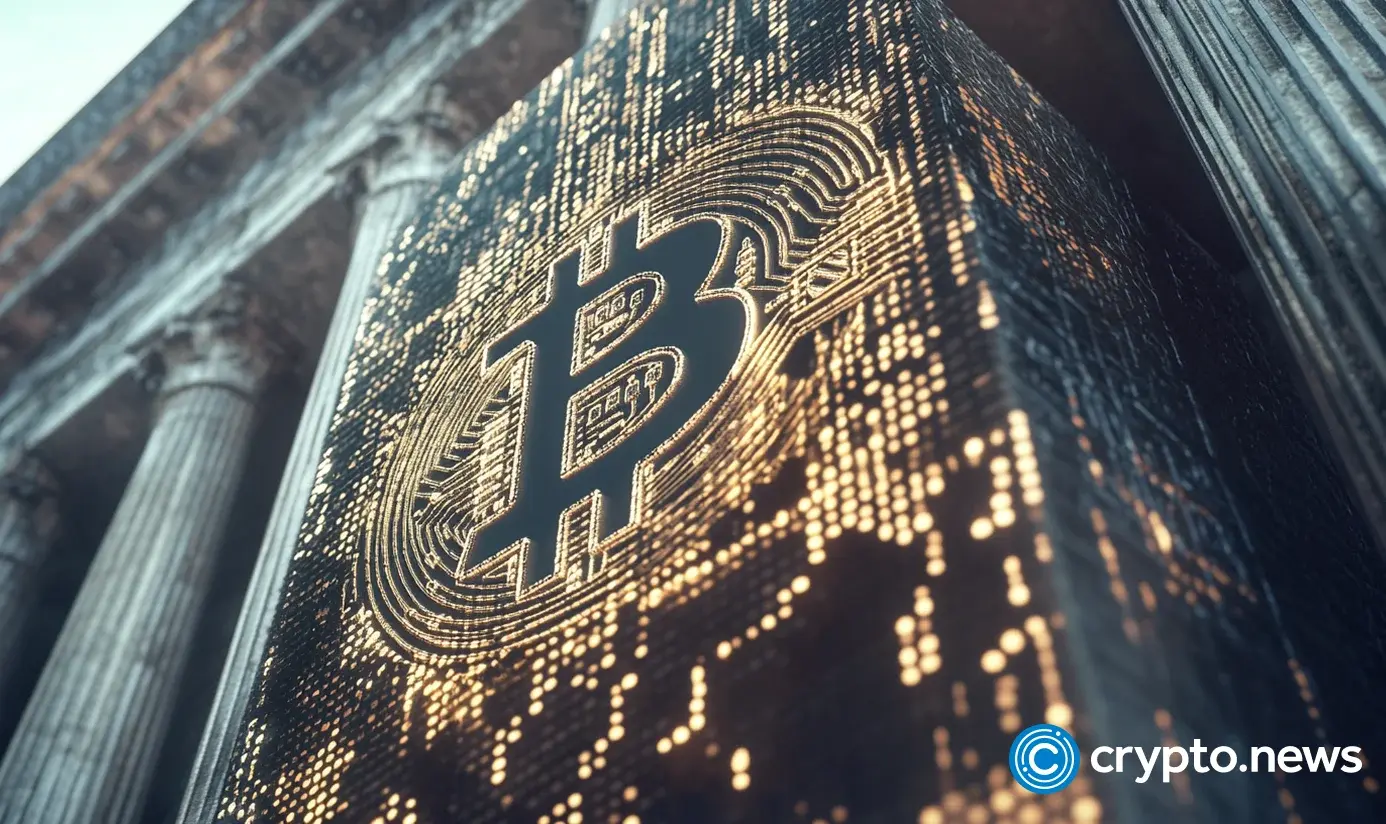
zer's death highlights the severe consequences of crypto fraud, raising concerns about security and oversight in the digital currency sector.
The post Thodex exchange founder Faruk Fatih Özer found dead in prison while serving 11,196-year sentence appeared first on Crypto Briefing.

The recent Ethereum price rejection that pushed it back below the $4,000 level has created a concerning trend that could send the price spiraling. The major point of interest lies at the 0.618 Fibonacci retracement level, where the last rejection occurred. Given this, it is likely that the Ethereum price could see more declines in the coming days, although there is still the possibility of the bulls taking over and invalidating the entire bearish setup.
The rejection from the 0.618 Fibonacci retracement level marked the start of the decline from the $4,200 level during the last recovery. This rejection resulted in the formation of a lower high on the 4-hour timeframe, and historically, such lower high formations mean that there is more selling pressure piling up for the digital asset.
As the bullish momentum looks to be fading, it puts the Ethereum price in a precarious position. Crypto analyst The Alchemist Trader explains that the rejection had come with increased bearish volume as investors offloaded their holdings on the market, putting bears in charge once again.
Following this development, the Ethereum price has continued to struggle around $3,900, where the next local support lies. The cryptocurrency has maintained a tentative hold at best on this local support, suggesting that the bulls could indeed be losing ground at this level.
If this corrective phase continues, then the Ethereum price decline is far from over. The current local weakness has put a strain on the support, and if $3,900 fails completely, the next major support lies below $3,400, more specifically at $3,385. This will serve as the next stronghold for the bulls to make their move.
“From a structural perspective, Ethereum’s inability to sustain momentum signals growing bearish pressure across lower timeframes,” the crypto analyst explained.

Despite the mounting bearish pressure, there is still the possibility that the Ethereum price could break out of this downtrend. Just like with the bearish case, the key lies at the $3,900 support and how well it holds.
In the case that bulls are able to reclaim and hold this support with momentum, then it could invalidate the bearish setup that has emerged. In this case, the crypto analyst believes that the Ethereum price could resume its uptrend above the 0.618 Fibonacci retracement level.

Seychelles-based cryptocurrency exchange MEXC found itself in the midst of controversy on Friday as users on social media site X (formerly Twitter) called for immediate withdrawals amid speculation about the exchange’s potential bankruptcy.
Market analyst J.A. Maartun was among the first to draw attention to the situation, sharing a chart on social media that indicated a significant spike in withdrawal transactions around midday.

Researcher Hanzo also shed light on the unfolding drama, revealing the plight of a user known as “The White Whale.” This individual claimed that his account was suspended despite engaging in trading without the use of bots or APIs, leaving him unable to access his funds, which he estimated at between $3 million and $5 million.
The White Whale alleged that customer support was unresponsive and that when he engaged with Cecilia Hsueh, MEXC’s new Chief Strategy Officer, he was pressured to admit to breaking the rules to have his funds released, a claim he firmly denied.
Cecilia later responded that their conversation should have remained private and accused The White Whale of misrepresenting the facts. MEXC subsequently announced its intention to take legal action against him for alleged misinformation.
However, as the situation escalated, a wave of support emerged from the cryptocurrency community, including notable figures like ZachXBT, as many users reported similar issues with MEXC.
This collective response led to warnings on social media urging users to withdraw their funds immediately, fueling the growing unrest.
In a rapid development, Cecilia issued an apology and confirmed that The White Whale’s withdrawal had been processed. She stated:
We fucked up. We apologize to @TheWhiteWhaleV2, and his money is already released. He can claim it at any time. I messed up in communicating with him. I got emotional, and I shouldn’t have. Since I joined MEXC 2 months ago I’ve been fighting behind the scenes to get MEXC to change. We grew really fast—a few years ago, we were a very small exchange, but given our current scale, our risk, operations, and PR teams have not kept up.
She noted that MEXC has experienced rapid growth, but its operational and public relations teams had struggled to keep pace. “We’re going to change that,” she stated, emphasizing that leadership has begun to recognize the need for improvement in transparency and operations.
In response to the swirling rumors of bankruptcy, MEXC took to social media to clarify its financial status. The exchange stated, “Recent online discussions have circulated unverified rumors regarding MEXC’s financial status. We would like to clearly state that these claims are false and misleading.” They assured users that MEXC remains financially healthy, with all user assets fully backed.
Featured image from DALL-E, chart from TradingView.com

Crypto trades all night, and most wallets still wait for taps and confirmations. That mismatch is the central risk for everyday users. A recent industry op-ed argued that self-custody tools behave like passive vaults and leave people exposed when markets flip at 3 a.m. The author’s thesis is blunt: automation belongs inside the wallet, not bolted on as an afterthought.
The claim resonates because every modern finance stack already uses background rules. Stop losses and scheduled rebalancing are standard on traditional platforms, yet many DeFi interfaces still require manual approval flows that are too slow when volatility spikes.
For proof that minutes matter, the TerraUSD collapse remains a cautionary tale. On Monday, May 9, 2022, around 18:30 GMT, UST fell materially off its peg and swung between ninety-five cents and twenty-five cents over the next three days. Earlier signs had flashed over the weekend, but self-custodied users without pre-defined rules faced a tidal move while asleep.
Timers and thresholds inside the wallet could have trimmed positions or hedged risk automatically. The timeline shows how fast the break unfolded and why manual clicks lose to market speed.
Ethereum’s account abstraction standard, often discussed under ERC-4337, turns a wallet into a programmable smart contract that can enforce custom spending rules, sponsor gas, and run scheduled or conditional actions. The official documentation describes a new transaction flow built on UserOperation objects, a decentralized alt-mempool, and an on-chain EntryPoint that validates and executes rules. In practice it unlocks rule sets a normal person actually wants, such as automatic daily rebalancing or a liquidation guard that pays down debt when a collateral ratio crosses a threshold.
When Ethereum’s co-founder weighed in on this direction, he called the approach “really elegant” and highlighted that account abstraction is a “pretty big deal” for adoption because it lets non-custodial wallets behave like programmable accounts. That view matters because it frames self-custody as more than a seed phrase. It becomes a set of predictable behaviors a user defines once and trusts to run in the background.
The DeFi smart wallets describes wallets that implement account abstraction to provide programmable risk controls, recovery options, and gas handling. DeFi smart wallets collapse multiple steps into one clean action. DeFi smart wallets can hold rules for recurring allocations or borrowing caps.
DeFi smart wallets can also route transactions through paymasters so fees are paid in stablecoins, a minor detail that removes friction in real life. People need DeFi smart wallets that guard downside without sacrificing sovereignty. With DeFi smart wallets, the rules live with the keys. DeFi smart wallets keep the person in command while executing the plan precisely. DeFi smart wallets can finally make “set it and sleep” a reality for self-custody. DeFi smart wallets are not a luxury; they are a safety feature.
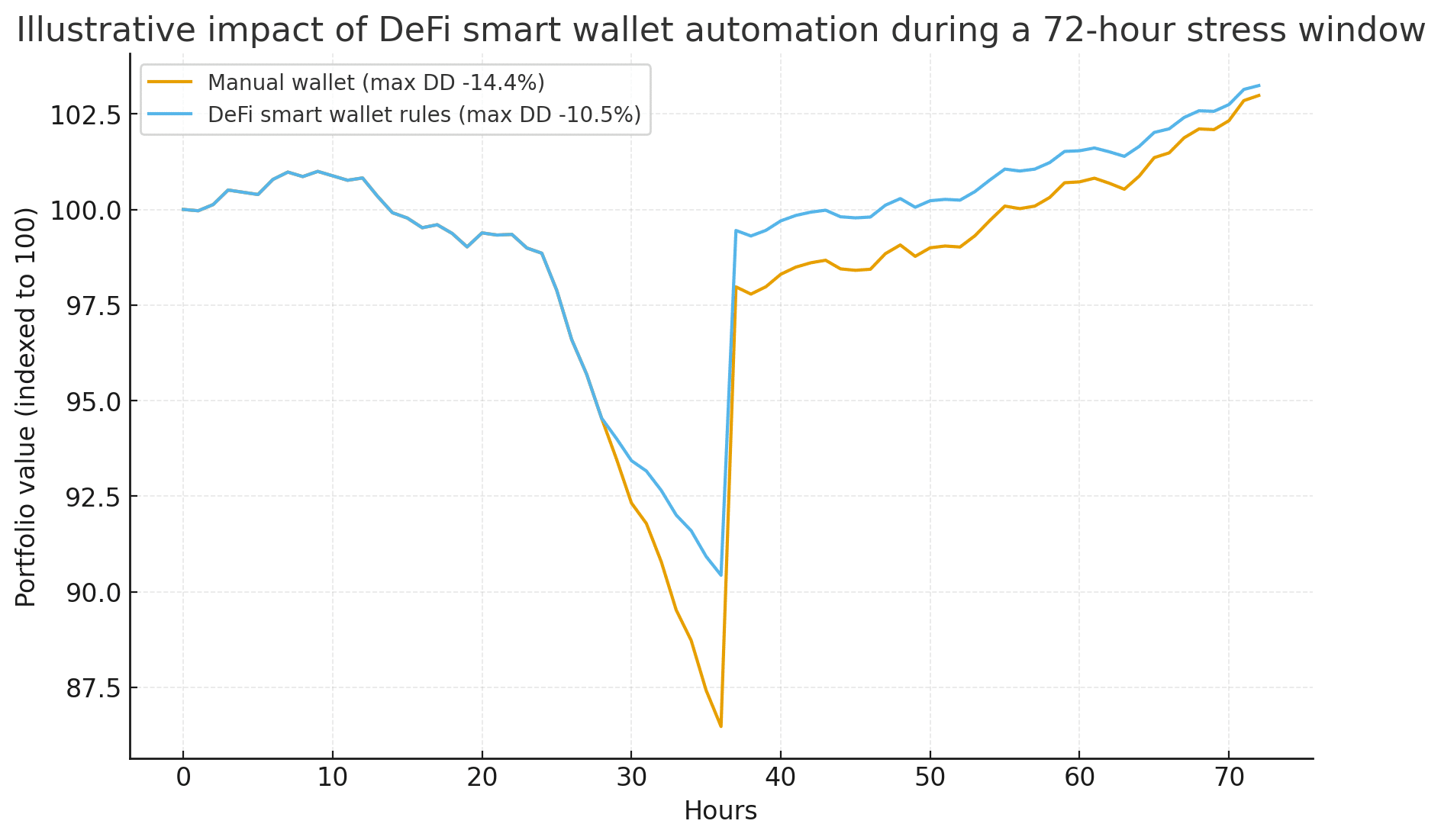
DeFi smart wallets also reduce support headaches because users define thresholds instead of relying on frantic approvals. DeFi smart wallets are the practical bridge between crypto’s ideals and normal finance muscle memory. DeFi smart wallets deserve to be the default setting, not the premium tier.
Major builders have rolled out smart wallet flows where a user signs in with a passkey instead of memorizing a seed phrase. The help pages and product posts explain how a passkey based on device biometrics can unlock a non-custodial account, while gas fees can be sponsored or paid in tokens other than ETH.
That combination makes a complex action feel like any mainstream fintech app. It is the usability shift that unlocks the automation shift. If the wallet can sign safely without the user wrestling with seed phrases and gas coins, it can also follow the user’s rules at 2 a.m. without nagging for approval.
Industry research roundups from last year tracked the rise of these features across multiple chains, noting support for passkeys, sponsored transactions, and SDKs that let apps trigger wallet actions behind clean interfaces. The trend line is clear. Smart wallets are maturing from a developer demo into the baseline of consumer crypto.
There is no need to imagine science fiction. The portfolio-automation startups that raised funding in 2025 pitch a simple promise: set allocation rules, risk limits, and timing once, then let the system execute continuously inside a non-custodial setup.
In an interview this year, one founder put it in plain language: “We need to get to a point where we can say, ‘Hey, Mom, do you want to participate in this?’” and described converting a plain-English plan into an automated on-chain portfolio that the user still owns. The same team stated publicly that “your assets should work for you” because the platform runs the portfolio “around the clock,” positioning this as the next evolution of programmable finance.
That is not a radical departure from tradition. It is a reapplication of what brokerage accounts and robo-advisors did years ago. The difference is architectural. Here the rules sit in a smart contract account that the user controls, not in a custodial back office.
Picture a simple spot portfolio with three assets and a lending position that backs a stablecoin. In a smart wallet, the user can store three guardrails. First, a volatility circuit that reduces the high beta allocation by ten percent when a 24-hour move breaches a set band.
Second, a collateral health trigger that automatically repays debt by swapping a slice of spot assets when the ratio falls under a chosen number.
Third, a periodic rebalance that nudges allocations back to target on a fixed cadence. None of that requires a person to watch charts at night. It requires rules that live where the assets live.
The mechanics exist. ERC-4337 lets wallets validate UserOperation packages against spending policies. Paymasters can sponsor gas or accept stablecoins for fees. Developers can wire a scheduler that submits a UserOperation at set intervals. Smart recovery can use guardians so a lost device does not equal a lost life savings. The entire experience looks less like a trader’s terminal and more like a modern banking app that quietly follows instructions.
Automation does not remove all risk. It changes the shape of risk. A poorly written rule can sell a long-term position at the exact bottom. A misconfigured paydown could create taxable events. Implementation bugs in smart accounts or paymasters can create novel failure cases.
Those realities argue for transparent audits, conservative defaults, and clear logs inside the wallet so users can see every rule and every action in human-readable form. The goal is not blind trust. The goal is visible, predictable behavior that beats panic clicking.
The next wave of wallet design should revolve around plain-English rule templates backed by battle-tested contracts. A user should be able to select “Protect from liquidation,” choose a ratio, pick which asset funds the paydown, and preview the worst-case spend before enabling it.
The wallet should show a timeline of upcoming scheduled ops. If the market moves sharply, the user should see which safeguard fired, with a link to the on-chain transaction. That level of clarity is table stakes in regulated finance and should be normal in open finance too.
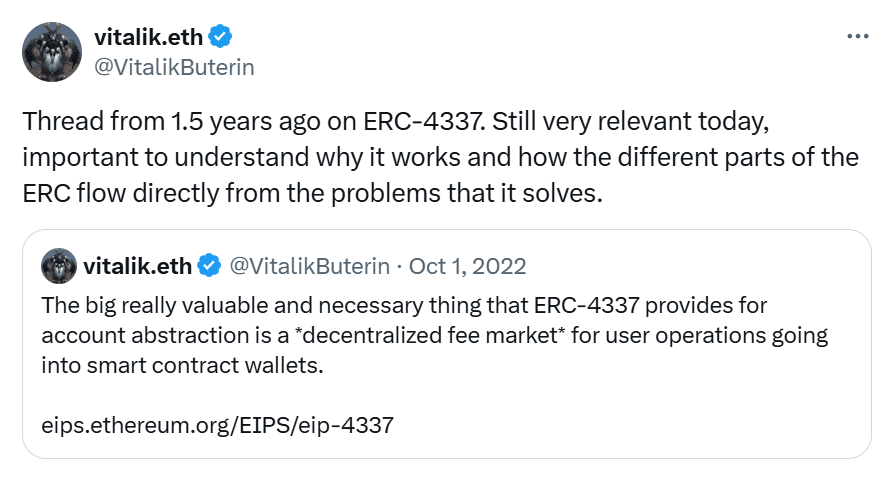
“It is time for crypto to catch up and deliver what users actually need to thrive. Sleepless traders will not lead the next wave of adoption.” The argument is that built-in automation improves sovereignty rather than undermines it because the user defines the rules.
“The big really valuable and necessary thing that ERC-4337 provides for account abstraction is the ability for smart contract wallets to be first-class citizens.”
The position underscores that programmability is essential infrastructure, not a nice-to-have gadget.
“Your assets should work for you. The platform executes your portfolio strategy around the clock so you can focus on ideas, not transactions.” That is a direct line from a founder who is betting on automation as the default.
Developer posts this year have predicted hundreds of millions of smart accounts over time as chain-level upgrades and wallet defaults tilt toward account abstraction. Forecasts point to chain abstraction and new transaction infrastructure as catalysts. Whether those precise numbers arrive is less important than the direction. Simpler onboarding plus programmable accounts equals an environment where everyday savers can use guardrails without becoming power users.
Education matters too. Clear explainers and help pages on passkeys, gas sponsorship, and recovery patterns are improving. People can now authenticate with a passkey, skip seed-phrase anxiety, and let the wallet sponsor gas or accept stablecoin fees. That seemingly small change breaks a major barrier for first-time users.
The first wallet to offer easy liquidation guards, threshold hedges, and set-and-review rebalancing will not just win users. It will reduce support costs and regulatory friction because fewer people will suffer preventable blowups. In that world, the phrase DeFi smart wallets signals more than a feature list. It signals a philosophy that self-custody should be safe by default and flexible by design. The best implementations will publish transparent audits, use minimal permissions, and expose simple toggles for every background rule so nothing happens without explicit consent.
Stablecoin depegs remain rare, but recent years have delivered several big ones. Education portals have documented those episodes and explained how to think about depeg risk across different collateral models. A wallet that lets a user set a rule like “exit if this stablecoin trades two percent below peg for more than thirty minutes” provides a clear, human tool for managing that rare scenario without drama. In self-custody, that kind of rule belongs in-wallet, not in a separate bot that might lose a key or go offline.
Self-custody should not require sleepless nights. The industry finally has the building blocks to embed risk rules, scheduled tasks, and emergency safeguards directly inside wallets. Account abstraction, passkeys, sponsored gas, and clean recovery flows form the plumbing.
Clear rule templates and readable logs form the user experience. The result is a class of DeFi smart wallets that act as intelligent stewards of a user’s plan. If the sector delivers that standard, volatility becomes less frightening, participation becomes more durable, and crypto starts to look like a place where everyday people can invest with confidence.
What exactly is a smart wallet in this context?
A smart wallet is a non-custodial wallet implemented as a smart contract account. It can enforce user-defined rules for spending, scheduling, and security, and it can accept sponsored gas or alternative fee tokens. It brings automation into self-custody.
How does account abstraction help normal users?
Account abstraction lets wallets behave like programmable accounts. That means passkey sign-ins, recovery helpers, and background actions that follow a person’s instructions. It reduces the number of manual steps needed to perform safe operations.
Can automation harm users if configured poorly?
Yes. Bad rules can trigger at the wrong time. The mitigation is conservative defaults, clear previews, and simple logs so users know what will happen and what did happen. Independent audits and minimal permissions also matter.
Are big builders actually shipping this, or is it theory?
Large teams shipped passkey logins, gas sponsorship, and SDKs for smart wallets this year. Research roundups tracked multi-chain support and developer adoption. The shift is underway.
Account Abstraction (ERC-4337)
A framework that lets wallets act as smart contract accounts. It introduces UserOperation objects, a decentralized alt-mempool, and an on-chain EntryPoint that validates and executes programmable rules for spending and security.
UserOperation
A data structure defined by ERC-4337 that carries a user’s intent to the EntryPoint. Bundlers collect these operations, and the EntryPoint verifies rules before execution. It enables features such as sponsored gas and batched actions.
Programmatic Rebalancing
A wallet rule set that shifts portfolio weights back to target allocations on a schedule or when thresholds are crossed. In smart wallets it can run without manual confirmations.
Liquidation Guard
A rule inside a smart wallet that pays down debt or adds collateral when a lending position approaches a risk threshold. It helps reduce forced liquidations during sharp market moves.
Depeg Risk
The risk that a stablecoin trades away from its peg. Past incidents demonstrate how quickly a peg can fail. Wallet rules that watch price bands and durations can limit exposure.
Editor’s note for clarity: Direct quotations in this article are attributed to identifiable public figures or company posts, and each quotation includes a source link via the citations.
Read More: How DeFi Smart Wallets Cut Liquidations Overnight">How DeFi Smart Wallets Cut Liquidations Overnight


What if the next big crypto bull could leap from peanuts to a power-house overnight? In a market crowded with iconic names like Bitcoin and XRP, the dream remains the same: landing a 1000x altcoin before it moves. Meanwhile, new plays are charging from the sidelines, and one fresh contender is gaining real traction.
The focus now turns to MoonBull, which promises that exact shot at a 1000x altcoin. With the MoonBull presale live in Stage 5, the $MOBU presale is attracting meme-coin fans and crypto developers alike. The question is: will MoonBull deliver where giants like Bitcoin and XRP show less runway?
MoonBull is engineered for the meme-coin crowd with real structure behind the hype. Its Stage 5 presale price is $0.00006584, and the listing price is projected at $0.00616, translating to a current ROI of over 9,256% for Stage 5 entrants. MoonBull early entry yields big token counts: for example, $1 into 15,188.34 tokens, $100 into 1,518,833.54 tokens, $1,000 into 15,188,335.36 tokens.

Here’s the vibe: this 1000x altcoin opportunity isn’t just a catchy phrase, MoonBull is built on that promise. The whitelist is first-come, first-served and once slots fill, they’re gone. Tokenomics include reflections, liquidity boosts and burns to back value.
Imagine grabbing the ground-floor ticket while others are still circling the building. That’s the essence of the 1000x altcoin play with MoonBull. It’s not for the faint of heart, but if the herd charges, the momentum could be wild.
MoonBull empowers every holder to shape its destiny. Each $MOBU equals one vote — no barriers, no lockups. From Stage 12 onward, community members can decide on key proposals like burns, features, and development priorities. All votes are transparent and recorded publicly, ensuring fairness and accountability. This is true decentralized control, giving every investor a voice in the project’s evolution. MoonBull’s governance system turns holders into decision-makers, building a project that’s led by conviction and community power.
Bitcoin (BTC) is currently trading at $110,117.08, marking a 5.3% decline over the past month as the broader crypto market enters a cooling phase. The leading cryptocurrency maintains a market capitalization of $2.19 trillion, down 0.48%, with 24-hour trading volume at $65.05 billion, an 8.25% increase as traders reposition their holdings.
The recent BTC price dip comes amid investor profit-taking after weeks of sustained gains, along with minor outflows from Bitcoin ETFs. Macroeconomic factors, including shifting interest rate expectations and global market uncertainty, have also contributed to cautious sentiment.
XRP is trading at $2.48, down 14.62% over the past month amid market volatility weighing on major altcoins. The project has a market capitalization of $149.17 billion, down 3.65%, while 24-hour trading volume stands at $5.38 billion, down 10.14%.
The recent XRP price drop can be attributed to profit-taking after its prior rally, coupled with broader crypto market corrections. Additionally, ongoing uncertainty surrounding Ripple’s regulatory situation in the U.S. continues to influence investor sentiment.

XRP and Bitcoin have their place in the crypto zoo, but for bulls chasing the next big breakout, neither stacks up as a true 1000x altcoin from here. Bitcoin is mature and has limited upside, while XRP is solid but lacks the potential for a wild explosion. Now the rocket may rest with MoonBull, which is built for that breakthrough jump.
MoonBull’s presale is live, the Stage 5 entry price is ultra-low, and the token mechanics are structured for early-mover advantage. If the herd catches this now, the upside could match the dream of a 1000x altcoin ride. Don’t sit still, secure your spot, lock in your entry and ride the bull.

Website: Visit the Official MOBU Website
Telegram: Join the MOBU Telegram Channel
Twitter: Follow MOBU ON X (Formerly Twitter)
MoonBull is expected to be one of the top performers in 2025, driven by its presale momentum, strong liquidity rewards, and scarcity-based model.
MoonBull’s early-stage investors are eyeing 1000x returns as the project expands its ecosystem and gains traction among mainstream crypto communities.
MoonBull currently leads as one of the fastest-growing presales, attracting massive investor attention for its utility-driven token and high APY rewards.
MoonBull stands out as the best buy right now due to its presale discount and growth potential compared to established but slower-moving coins.
MoonBull is predicted to dominate 2025, with analysts highlighting its unique reward system and sustainable tokenomics as catalysts for massive long-term gains.
Missed the early moonshots like Bitcoin and XRP? The 1000x altcoin dream might still be alive with MoonBull’s Stage 5 presale. Bitcoin and XRP offer stability, but limited upside. MoonBull offers urgency, discounted entry, structured rewards and meme-power combined. If timing, hype and mechanics align, the next big move may be on the table.
This article is for informational purposes only and does not constitute financial, investment or trading advice. Always carry out your own research and consult a professional advisor before investing in cryptocurrencies.
Read More: 1000x Altcoin? MoonBull Says Yes – As Bitcoin and XRP Slow Down, MOBU Leads as Top Analysts’ Pick">1000x Altcoin? MoonBull Says Yes – As Bitcoin and XRP Slow Down, MOBU Leads as Top Analysts’ Pick
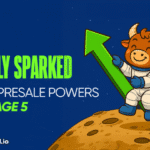


The post Coinbase Close to $2B Deal to Buy BVNK Stablecoin Platform appeared first on Coinpedia Fintech News
Coinbase is reportedly in talks to buy BVNK, a stablecoin infrastructure firm, for nearly $2 billion. The deal is said to be in its final stages and could be completed by the end of this year or early next year. If successful, this would be one of Coinbase’s biggest acquisitions yet and a major step toward expanding its role in the stablecoin market.
According to Bloomberg, Coinbase has already begun the final due diligence process ahead of closing the deal with BVNK, a London-based fintech startup. The company helps businesses handle both crypto and traditional currency payments. Coinbase Ventures, the exchange’s investment arm, is already one of BVNK’s early backers, alongside Citi Ventures, Visa, and Haun Ventures.
People close to the matter say Coinbase won exclusive rights to negotiate the acquisition after a tough bidding process. The company hopes this deal will strengthen its position in the global payments market, especially after new U.S. laws were passed this year to regulate stablecoins.
Stablecoins have become an important part of Coinbase’s business. They now make up nearly 20% of the company’s total revenue, mainly thanks to its partnership with Circle, the issuer of USDC. Coinbase earns a share of the interest from USDC reserves and has also helped integrate USDC payments into Shopify, making it easier for businesses to accept crypto.
Buying BVNK would give Coinbase access to more tools and infrastructure to grow its stablecoin business. It would also allow the exchange to help more companies handle both fiat and crypto payments easily, boosting adoption worldwide.
Founded in 2021, BVNK has quickly become a key player in the stablecoin space. It has raised about $90 million and built a strong payment network that connects crypto and traditional finance. Through this deal, Coinbase would gain BVNK’s technology and network, allowing it to expand into stablecoin-based corporate payments.
This comes after Coinbase recently partnered with Citigroup to test stablecoin payments for corporate clients, aiming to modernize how money moves between banks and crypto wallets.
Coinbase CEO Brian Armstrong recently said he expects the U.S. crypto market structure bill to pass before the end of the year, calling it a big step for regulatory clarity. If the BVNK deal goes through, Coinbase could become a major force in digital payments, combining stablecoins, regulatory oversight, and global merchant access into a powerful ecosystem.
Stay ahead with breaking news, expert analysis, and real-time updates on the latest trends in Bitcoin, altcoins, DeFi, NFTs, and more.

The post XRP ETF Launch Could Happen This November After Bitwise SEC Filing appeared first on Coinpedia Fintech News
The long-awaited XRP exchange-traded fund (ETF) from Bitwise could soon become a reality. Bitwise, the $15 billion asset management giant, has just submitted Amendment No. 4 to its XRP ETF filing with the U.S. Securities and Exchange Commission (SEC), revealing two crucial details.
Experts believe such updates usually signal the final step before approval. If cleared by the SEC, the XRP ETF could go live within just 20 days.
On Oct 31, Bitwise filed an Amendment No. 4 with the SEC to update its S-1 form. The latest updated document includes two crucial details: first, the listing venue will be the New York Stock Exchange (NYSE); and second, the management fee will be 0.34%.
Eric Balchunas, senior ETF analyst at Bloomberg, believes Bitwise’s latest filing marks a major step forward for XRP’s entry into traditional finance. “Adding the NYSE and fee means Bitwise has checked nearly all boxes.”
Bitwise just updated their XRP ETF filing to include exchange (NYSE) and fee of 0.34%, which are typically the last boxes to check. Amendment #4. pic.twitter.com/BUnkasSQY5
— Eric Balchunas (@EricBalchunas) October 31, 2025
Historically, once issuers include exchange and fee details in their S-1 forms, it usually means they’re just waiting for the final green light from the SEC.
Following the update news, ETF expert James Seyffart of Bloomberg Intelligence added more context to it, noting that Bitwise’s latest filing contains “shorter language” that could allow the product to go live within just 20 days, pending SEC clearance.
Seyffart noted that Bitwise isn’t alone, major players like VanEck, Fidelity, and Canary Funds have also updated their filings, signaling that the race to launch an XRP ETF is heating up fast.
Meanwhile, Crypto America host Eleanor Terrett revealed that Canary Funds removed the “delaying amendment” from its S-1 filing, which gives the SEC control over timing.
This sets Canary’s XRP ETF up for a launch date of November 13, if the Nasdaq approves its 8-A filing.
After the latest XRP ETF updates, XRP’s price saw a small uptick, trading around $2.51, showing growing optimism among traders.
Analysts say that if the XRP ETF gets approved, it would mark the first-ever U.S. spot ETF for XRP, a historic moment that could push the token toward its all-time high price.
At present, XRP faces strong resistance near the $2.75 level. A breakout above this could open the door for a test of the $3 psychological mark.
However, if selling pressure continues, XRP might correct by up to 19%, retesting the $2 support zone within its long-term channel pattern.
Stay ahead with breaking news, expert analysis, and real-time updates on the latest trends in Bitcoin, altcoins, DeFi, NFTs, and more.
The Bitwise XRP ETF is a proposed investment fund tracking XRP’s price, awaiting SEC approval. It would trade on the NYSE, making it easier for traditional investors to gain exposure to the asset.
The XRP ETF could launch as soon as 20 days after SEC approval. One issuer, Canary Funds, has a potential launch date of November 13, but this is still pending final regulatory and exchange clearance.
An XRP ETF approval is widely expected to boost the price by increasing demand and institutional legitimacy. This could help it break key resistance levels and challenge its all-time high.
Yes, once approved and live, retail investors can buy shares of the XRP ETF through any standard brokerage account, just like a stock, making investment accessible without holding XRP directly.
When the XRP ETF launches, you can purchase it through your usual online broker by searching for its ticker symbol. It will be listed on major exchanges like the NYSE for easy access.
Key risks include XRP’s inherent price volatility, regulatory uncertainty, and market sentiment shifts. An ETF carries fund-specific risks like fees but simplifies exposure compared to direct ownership.

The post Bittensor TAO Price Surges Past $510, Eyes on $540 and $580? appeared first on Coinpedia Fintech News
Bittensor (TAO) price has set the crypto scene abuzz with a dramatic +21.35% price pump in the past 24 hours. It is now climbing to a 2025 peak of $536.88 on surging volumes. Riding a wave of fresh institutional interest from the debut of the Safello Bittensor Staked TAO ETP, TAO’s price action has turned decisively bullish.
This move comes as attention intensifies ahead of Bittensor’s much-anticipated first halving, fueling speculation and positioning TAO for a technically charged rally.
Bittensor price has delivered an explosive breakout from its multi-week range, chugging past the crucial $510 resistance. Bulls pushed the price as high as $536.88, a level unseen since early 2025, dramatically shifting near-term sentiment. The 4-hour chart shows firmly escalating momentum:
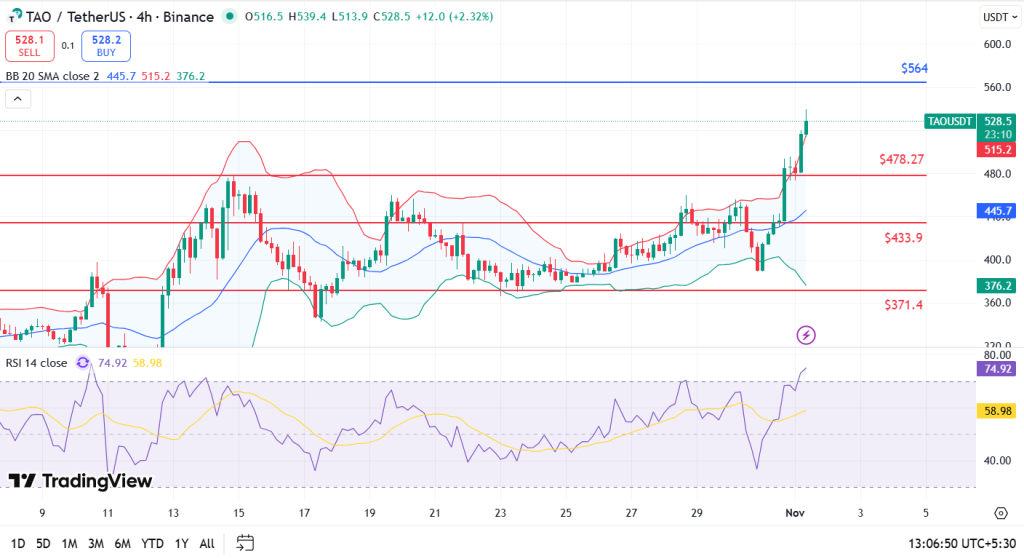
Short-term volatility is likely as traders secure gains near the $540 zone, raising the risk of sharp pullbacks if momentum hampers. However, TAO’s ability to hold above $510 on closing intervals may open a path for another attempt at its all-time high around $767. That being said, if profit-taking intensifies, corrections lie at $478 and $433, both recent support levels.
TAO’s price spike is linked to the Safello Bittensor Staked TAO ETP’s launch, unlocking institutional inflows and daily trading volume up 59%.
The RSI shows overbought conditions, but price momentum is intact. Sudden pullbacks are possible, so traders should be watchful.
If TAO remains above $510, technical signals point to $580.5 as the next resistance, with a longer-term target at the ATH near $767 if bullish flows persist.

The post Malaysia Asset Tokenisation Roadmap: BNM’s 3-Year Plan to Build a Digital Asset Innovation Hub appeared first on Coinpedia Fintech News
Bank Negara Malaysia (BNM) has kicked off a three-year programme to test real-world asset tokenisation. A newly released roadmap aims to understand how blockchain-based tokenization can transform Malaysia’s financial landscape, from Islamic finance to supply chain management, with industry feedback open until March 1, 2026.
BNM has released a Discussion Paper on Asset Tokenisation to collect feedback from the financial and technology sectors. The goal is to create a Digital Asset Innovation Hub and an industry working group that will explore how tokenization can be used in real-world financial systems.
The plan follows a clear three-year roadmap
BNM’s working group will explore use cases in areas such as:
However, BNM has made it clear that not every idea qualifies, projects must show tangible real-world benefits, use blockchain only when it’s the right fit, and remain technically feasible within current infrastructure.
BNM wants tokenization to fix real-world challenges, starting with Malaysia’s RM101 billion SME financing gap by turning invoices into digital tokens, helping small businesses get quicker and cheaper loans.
The central bank also plans to apply this to Islamic finance, where Malaysia already leads globally. Using tokenized sukuk & smart contracts to automate payments, increase liquidity, and improve Malaysia’s RM2.4 trillion Islamic market, while following Shariah rules.
For sustainability, tokenized green bonds could tie payments to verified climate results, reducing greenwashing and boosting investor trust in Malaysia’s fast-growing ESG sector.
With this structured plan, BNM aims to bridge innovation and practicality, positioning Malaysia as a regional leader in regulated digital finance.
Stay ahead with breaking news, expert analysis, and real-time updates on the latest trends in Bitcoin, altcoins, DeFi, NFTs, and more.
It’s a guide for industry feedback on how tokenization can be safely applied in finance, forming the base for Malaysia’s digital asset framework.
By converting invoices or assets into tokens, SMEs can access faster, lower-cost financing and improve cash flow transparency.
Yes. Tokenised sukuk and smart contracts can streamline trading, cut settlement time, and boost liquidity in Malaysia’s Islamic markets.
BNM pilots begin in 2026, testing tokenized finance for SMEs, supply chains, and Islamic products before scaling nationwide in 2027.

The post MEXC Confirms 100% Asset Backing Amid Withdrawal Surge appeared first on Coinpedia Fintech News
MEXC exchange has reassured users that it remains financially strong despite recent record withdrawals. The platform confirmed all user assets are fully backed, with Proof of Reserves data showing major assets covered over 100%. To boost transparency, MEXC will update its Merkle tree data tonight, enabling users to verify their holdings independently. The exchange called solvency rumors false and emphasized its commitment to security and trust in the crypto community.

The post Bitcoin Price Prediction: $50,000 Or $500,000 — What Does The Future Hold For BTC As XRP Price Slides appeared first on Coinpedia Fintech News
The market just closed October on edge, and the Bitcoin price prediction debate is boiling. If policy stays tight and risk fades again, the next move could be violent. Traders want clarity, and a growing crowd is already gravitating toward real utility plays. Consider this your heads up: a payments-first project with a live wallet beta and third exchange in view is catching smart money for a reason.
Here is what to watch now, why XRP keeps wobbling, and why a utility coin with bank payout rails is getting serious attention. This is not the day to get comfortable. It is the day to position before the crowd does.

Bitcoin trades at around $109,203 today, with an intraday range of $106,463 to $110,905. The cautious Bitcoin price prediction identifies the first stress zone as ranging from $100,000 to $104,000. Lose that, and liquidity gaps can pull the price toward sub-$90,000.

The optimistic Bitcoin price prediction hinges on 2025 easing and a reversal to ETF inflows, which could put prior highs back in play and keep the multi-year $500,000 path on the table. Catalysts that could flip the script are straightforward: clearer Fed guidance, a reversal in ETF inflows, and stabilizing yields. Until those arrive, funding, basis, and treasury moves keep the Bitcoin price prediction tug-of-war alive.
XRP slipped again into the month-end and trades near $2.51 today after ranging between $2.39 and $2.54 intraday. Bulls still point to payment narratives and improved legal optics, but the tape is unforgiving. If ETF outflows cool and broader risk steadies, XRP can bounce.

If macro tightens again, XRP likely lags higher beta leaders. For now, momentum belongs to catalysts, not hopes. Traders should mark breakdown levels and respect the tape. XRP needs real bids, not wishful thinking.
Here is where early capital is leaning. Remittix targets real transaction utility with a simple promise: move crypto directly to bank accounts in over 30 countries, featuring a clean user experience and merchant tools. The team is fully verified by CertiK and ranked number 1 on CertiK for Pre-Launch Tokens, a huge due diligence win that big buyers notice.
The wallet beta is now live with community testers, and momentum is building with centralized exchanges. BitMart listing was secured after passing the $20 million raise milestone, LBank followed after $22 million, and a third major listing reveal is in view.
Numbers that matter right now: you can buy Remittix at $0.1166, the project has raised over $27.7 million, sold 681 million tokens, and more than 30,000 investors have already secured allocation. Price steps are not waiting for anyone. Supply moves fast when serious buyers step in.
If your Bitcoin price prediction is cautious into year-end, you need an asset with measurable utility that does not wait for the Fed to smile. If your Bitcoin price prediction is wildly bullish, you still want exposure to a payment rail that can capture real flows while the cycle trends up. XRP remains on watch, but the market is rewarding live product and clear execution.
Remittix checks those boxes today, at $0.1166, with over $27.7 million raised, 681 million tokens placed, and a community already testing the wallet. When the crowd wakes up, it will be late.
Discover the future of PayFi with Remittix by checking out their project here:
Website: https://remittix.io/
Socials: https://linktr.ee/remittix
$250,000 Giveaway: https://gleam.io/competitions/nz84L-250000-remittix-giveaway

The post Robert Kiyosaki Warns of Biggest Crash Coming, Urges Buying Bitcoin, Gold, and Silver appeared first on Coinpedia Fintech News
The crypto market today is back in the red, with fear creeping in after cautious signals from the U.S. Federal Reserve and rising trade tensions between Donald Trump and China’s Xi Jinping. Bitcoin slipped 3.8% to $110,063, while Ethereum dropped 3.6% to $3,853, and XRP fell 4.1% to $2.51. The pullback reflects a clear risk-off sentiment, as investors step back amid growing uncertainty over global policy decisions.
Traders are in panic mode after Fed Chair Jerome Powell hinted that the recent 25-basis-point rate cut could be the last one for 2025. He warned that the Fed might “wait a cycle” before introducing further easing, dashing hopes for faster monetary relief.
The comments hit risk assets across the board, with the Dow Jones slipping 0.2% and the S&P 500 remaining flat, as markets began pricing in a longer stretch of tight financial conditions.
Adding to the pressure, the much-hyped Trump–Xi meeting delivered little clarity. While both sides described it as “productive,” traders viewed it as a temporary truce rather than a real breakthrough. The lack of concrete progress has kept nerves high, especially as global markets brace for potential ripple effects from renewed trade disputes and tariff tensions.
Despite the price decline, institutional demand for crypto remains robust. Bitcoin ETFs recorded $202.48 million in net inflows on October 28, led by BlackRock, Fidelity, and Ark & 21Shares, pushing total inflows past $62 billion.
Ethereum ETFs also gained traction, attracting more than $246 million in net inflows. This suggests that major players continue to see long-term value in digital assets — even as short-term traders panic.
Amid the market volatility, Rich Dad Poor Dad author Robert Kiyosaki once again sounded the alarm.
“MASSIVE CRASH BEGINNING: Millions will be wiped out. Protect yourself. Silver, gold, Bitcoin, Ethereum investors will protect you,” he warned on X.
Kiyosaki believes the global economy is on the brink of a severe financial crisis, arguing that real assets like gold, silver, and crypto are the only reliable protection against inflation and currency collapse.
He recently doubled down on his stance, calling silver and Ethereum the best-value buys right now due to their industrial and technological utility. While critics point out that he has predicted crashes for years, his warnings resonate strongly in today’s climate of economic uncertainty.
Echoing Kiyosaki’s warning, trader Jonesy cautioned that rate cuts often precede major market crashes, citing 2000, 2007, and 2020 as examples when markets plunged by as much as 56%. His trading indicators now point to instability, suggesting that the April lows might only mark the beginning of a deeper decline.
For now, Bitcoin remains above $108,000, but fear is spreading fast. With the Fed holding firm and global tensions rising, investors are once again seeking safety in gold, silver, and crypto — just as Kiyosaki warned.
Stay ahead with breaking news, expert analysis, and real-time updates on the latest trends in Bitcoin, altcoins, DeFi, NFTs, and more.
Crypto prices are down as traders react to Fed comments hinting at fewer rate cuts in 2025 and uncertainty from the Trump–Xi trade talks.
When the Fed delays rate cuts, liquidity tightens, making investors risk-averse. This often pushes Bitcoin and other cryptos lower temporarily.
Yes. Big firms like BlackRock and Fidelity continue buying Bitcoin and Ethereum, showing confidence in crypto’s long-term potential.
Some traders fear deeper declines if global tensions rise, though steady ETF inflows hint at growing institutional trust in digital assets.

The post Ethereum Price Prediction: Can Ethereum Make A Huge Comeback This Winter? Hyperliquid Whales Prepare For Another Rally appeared first on Coinpedia Fintech News
Ethereum is showing signs of life again as traders speculate on a potential winter comeback. The ETH price has started to recover, supported by renewed whale activity on Hyperliquid and optimism around growing DeFi adoption.
While Ethereum eyes a move above $4,000, another rising star, Remittix (RTX), is gaining ground fast, with analysts calling it one of the most promising PayFi tokens to watch this season.

The current price of ETH is at around $3,865, with a slight recovery following a low near $3,700 at the beginning of this week. Despite recent volatility, optimism is creeping back into the market as whales on Hyperliquid and other derivatives platforms quietly reload long positions.
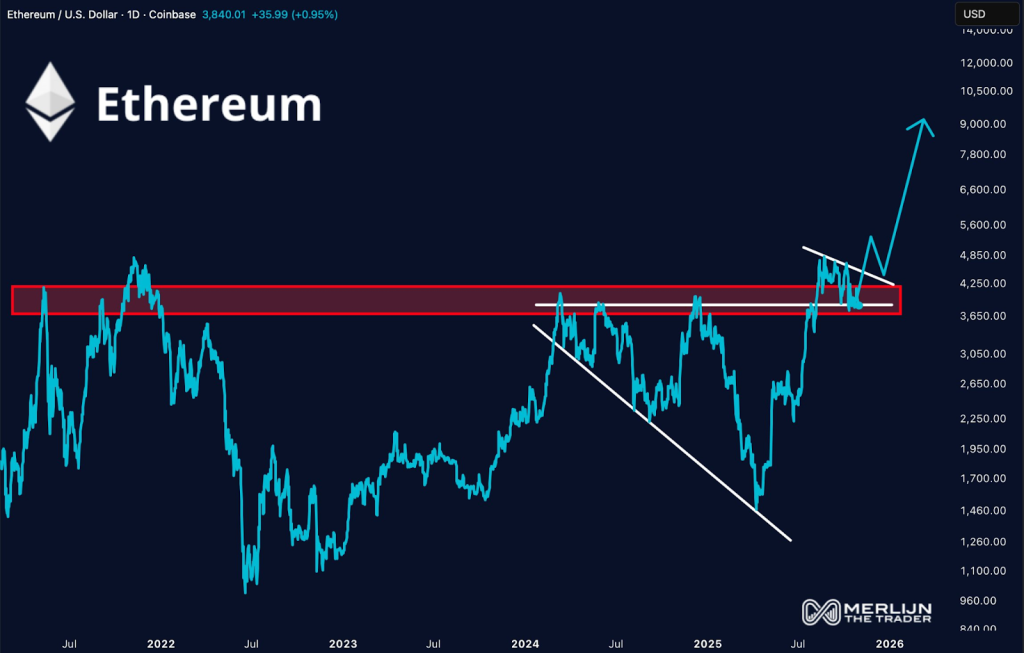
Analysts are optimistic that renewed ETF inflows and an increase in DeFi activity might make way for an effective Ethereum price rebound this winter. As long as market sentiment keeps improving, ETH price prediction points to targets north of $4,200. For now, Ethereum news shows cautious accumulation and growing institutional interest. Both of these are signs that a major comeback may be forming.
The HYPE price today is holding near $47, with traders watching closely for a breakout above the key $50 level. The latest Hyperliquid news about 21Shares filing for a spot ETF tracking HYPE has stirred cautious optimism across the market. Analysts believe this move could inject new liquidity and visibility into the project, supporting a potential winter rebound.
The HYPE price prediction now hinges on whether demand from ETF exposure can spark fresh accumulation. Despite muted volatility, whales appear to be preparing for another run. Hyperliquid price may revisit its past highs before the year is over as momentum picks up.
Remittix (RTX) continues to capture investor attention as excitement builds around its growing payment ecosystem. The PayFi-driven platform is reinventing how crypto connects with real-world banking by allowing users to send funds directly to any bank account in over 30 fiat currencies — all in seconds.
With support for more than 40 cryptocurrencies, Remittix simplifies global payments while offering low fees and total transparency.
Now fully verified by CertiK and ranked #1 among pre-launch tokens, Remittix keeps building real momentum while other altcoins focus on speculation.
Discover the future of PayFi with Remittix by checking out their project here:
Website: https://remittix.io/
Socials: https://linktr.ee/remittix
$250K Giveaway:https://gleam.io/competitions/nz84L-250000-remittix-giveaway
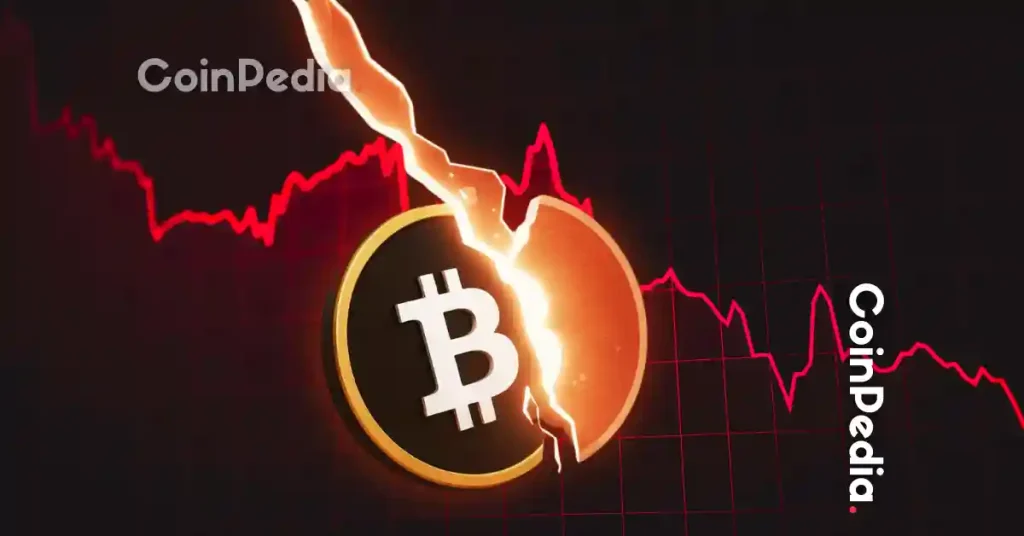
The post Bitcoin’s 7-Year ‘Uptober’ Streak Ends appeared first on Coinpedia Fintech News
Bitcoin fell about 10% in October 2025, ending a seven-year streak of positive “Uptober” months. After hitting an all-time high near $126,300 early in the month, Bitcoin dropped to around $110,000 by month-end. The fall was driven by traders taking profits and a cautious market mood amid global economic shifts and Federal Reserve signals. Despite the drop, Bitcoin remains up over 16% this year, and experts see the dip as a healthy correction with a strong outlook for November.
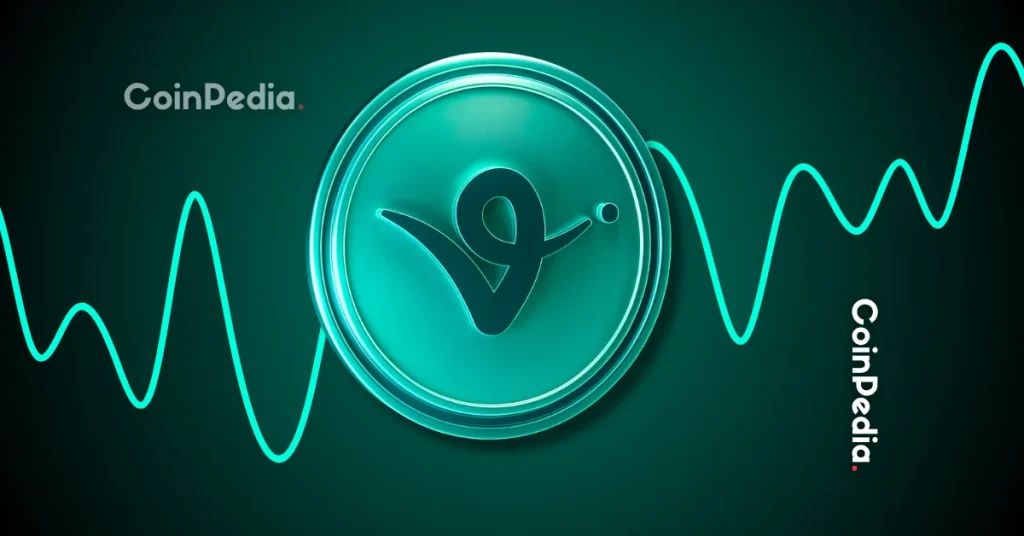
The post Virtuals Protocol Price Surges Past $1.79 As Traders Eye $1.90 Breakout appeared first on Coinpedia Fintech News
I’ve been tracking Virtuals Protocol’s price closely, and today’s surge is hard to ignore. The price soared 35.8% in the past 24 hours, zooming past short-term resistance and adding to a week of powerful gains.
Traders and investors are buzzing on social media, urged by news of x402 protocol integration with Coinbase’s AI payment standards. A notable uptick in whale accumulation and decisive buy-side momentum. These factors seem to have ignited fresh enthusiasm. Seeing such swift action, I can sense the FOMO building as technical signals point to further movement incoming.
Looking at the technicals, VIRTUAL’s price push above $1.37 marked a clean breakout of the Fibonacci 23.6% retracement level. Thereby flipping an important resistance into support. The daily price ranged from $1.82 to $1.33, reflecting strong volatility alongside increased activity. Market cap shot up 34.9% to $1.17 billion, and 24-hour trading volume grew to $758 million.

On the charts, the RSI now sits at 60.7. This is comfortably bullish without venturing into overbought territory, hinting that the rally isn’t exhausted yet. Meanwhile, the MACD histogram flipped positive (+0.063). Successively, the Bollinger Bands expanded with price hugging the upper band, suggesting a strong trend but also pointing to possible short-term exhaustion if momentum dries.
For short-term traders, the current setup opens the door for FOMO-driven buying. But if the sentiment cools, the 61.8% Fibonacci retracement at $0.89 will be a crucial support to watch for any sharp pullbacks. The most critical level ahead is $1.90, a close above that could unlock a run toward $2.50.
Contrarily, if VIRTUAL price dips below $1.37, consolidation could take hold as buyers wait for a reset. It’s this push and pull at key levels that keeps the action dynamic and keeps me on my toes.
The rally comes from protocol upgrades, whale accumulation, and an overall bullish shift in technical momentum, which pushed VIRTUAL above key resistance levels.
Traders are closely watching $1.90 for a breakout, with $2.50 as the next upside target. If prices drop, $1.37 and $0.89 act as critical support zones.
With RSI not yet overbought and MACD positive, short-term momentum looks solid, but traders should monitor volume and sentiment shifts, especially around $1.90 resistance.
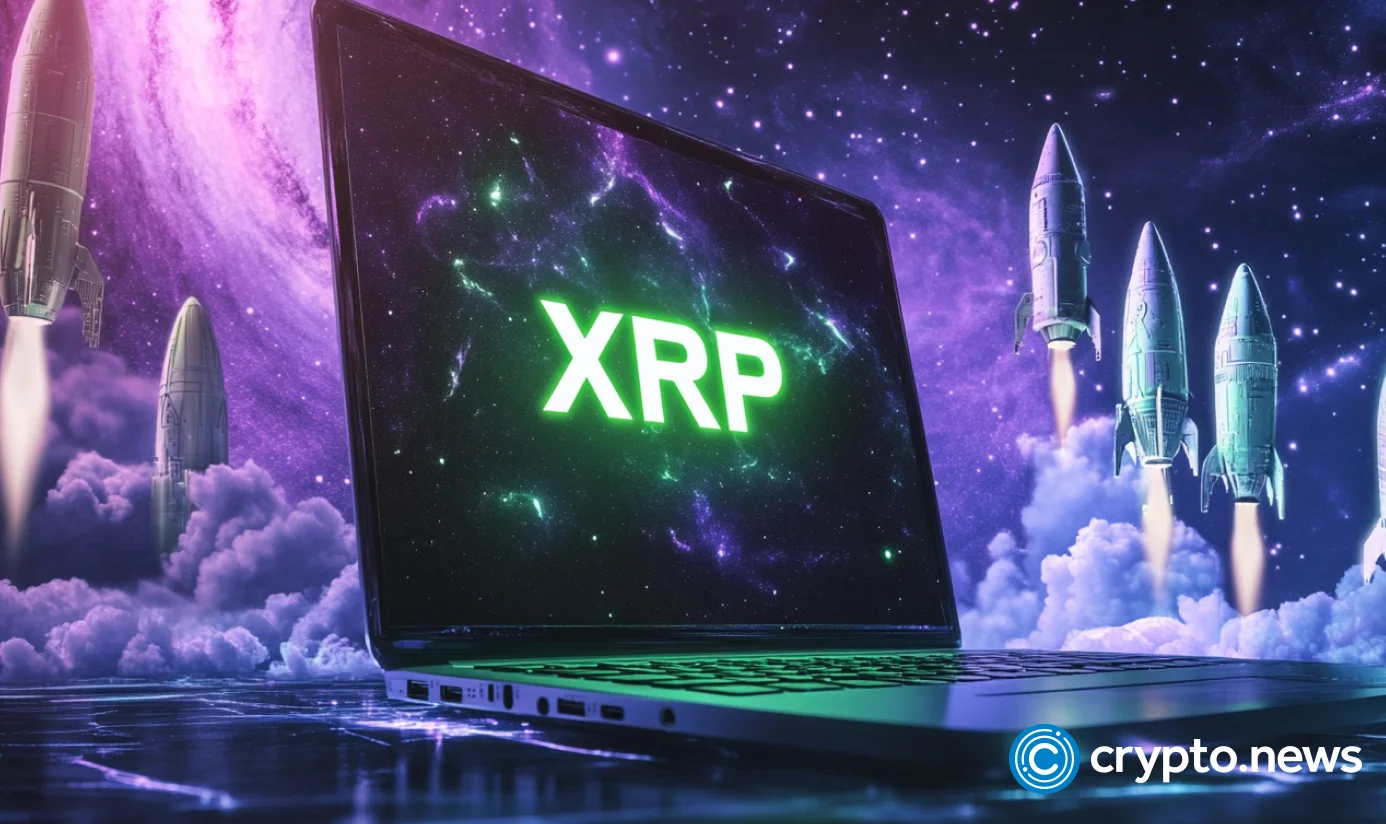

Bullish celebrated its US debut after securing New York’s BitLicense and money transmission license, launching trading across 20 states and partnering with BitGo and Nonco.
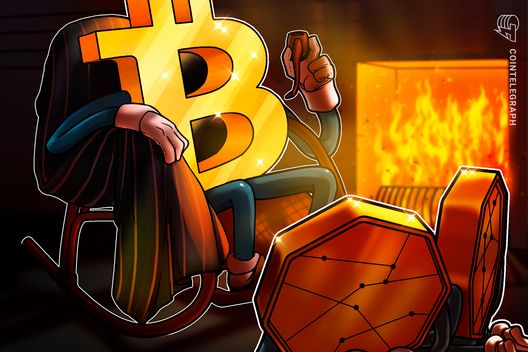
Bitcoin has typically recorded its strongest month for gains in November, and there are certainly macro tailwinds to make it happen again.
As the early ‘Uptober’ buzz fizzles and Bitcoin struggles to hold $110,000, the overall crypto market sentiment has seemingly taken a beating. According to online reports, market participants are disappointed with the recent performance, but some experts argue that this means the industry is “winning.”
On Thursday, investor and analyst Will Clemente shared on X that “the vibes in the crypto groupchats are just sad.” He explained that investors seem “jaded, depressed, and defeated,” adding that they are “completely giving up” and switching to other asset classes after BTC’s performance this year.
Bitwise’s CEO, Hunter Horsley, weighed in on the matter, affirming that “Crypto natives are now in a multi-month bear market sentiment,” while the “off-Twitter” sentiment is the “best it’s ever been.”
Horsley detailed that the offline positive outlook is fueled by the notable decrease in regulatory risk, which has led to the recent spike in institutional adoption and mainstream recognition.
Notably, the second wave of crypto-based exchange-traded funds (ETFs) started trading this week, with Bitwise’s Solana Staking ETF (BSOL) stealing the spotlight. Moreover, the Digital Asset Treasury (DAT) trend, led by Strategy, continues to pour millions of dollars into cryptocurrencies.
“The market is changing,” the CEO asserted in his Friday X post, pointing out JPMorgan CEO Jamie Dimon’s recent approach shift. Dimon has been a long-time crypto skeptic, calling the flagship crypto a “Ponzi scheme” and dismissing it as “useless as a pet rock.” Nonetheless, he recently admitted that he was wrong and that crypto, stablecoins, and blockchain are “real.”
In a response to Clemente’s post, Nic Carter stated that the sentiment shift highlights a deeper truth about the market: the space has matured significantly. He explained that crypto is “boring” now because most of the questions and uncertainties that drove much of the historical volatility have been answered.
So many of the open questions have been answered, will stablecoins be allowed? yes. will we be banned? no. will we all go to jail for writing software? no. will we be incorporated into tradfi? yes. can tokens have cashflows and not be securities? Apparently. (…) There are still some unanswered questions, particularly around cash-flowing pseudoequity tokens, but we will probably get answers to those in the coming years.
He also argued that the crypto industry has been largely derisked as a technological substrate, bringing large corporations to adopt these tools, which shows that “crypto natives no longer control the narrative, there’s more serious businesses (which don’t require tokens), there’s less chaos, the whole space has matured significantly.”
To Carter, this means that the industry has “won.” However, he noted that clarity and maturity come with less excitement, as “winning means the inherent volatility in the space is highly reduced! This applies to both startups and the underlying assets themselves.”
“So if you’re sad that volatility has been dampened smile through the tears. it means we won,” he concluded.
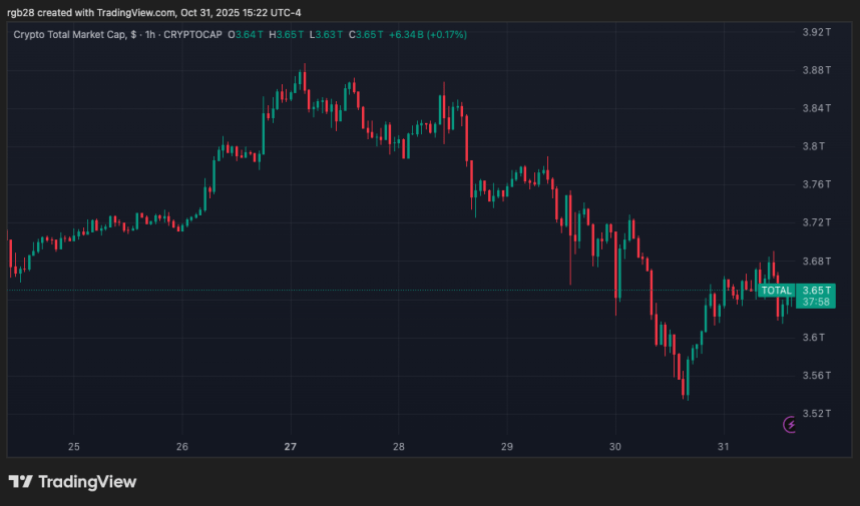

On-chain data shows Bitcoin is currently retesting a historically significant level that has often decided the course of the cryptocurrency’s price.
In a new post on X, on-chain analytics firm Glassnode has talked about how Bitcoin is retesting a level that has historically been a “make-or-break” one for the asset.
The level in question is part of Glassnode’s “Supply Quantiles Cost Basis Model.” The model reflects price levels corresponding to important investor profitability thresholds.
Below is the chart shared by the analytics firm that shows how the levels of this model have changed over the last few years.
As is visible in the graph, Bitcoin surged above the 0.95 quantile during the recent rally to the all-time high (ATH). This level corresponds to 95% of the supply being in profit.
With the market downturn that has followed since, however, the cryptocurrency has slipped under the level. Recently, the asset has been making retests of the 0.85 quantile, situated at $109,000.
BTC has already seen brief drops below this mark, but so far, it has managed to climb back above it each time. At present, the coin is trading right around the level, indicating that about 85% of the supply is carrying a net unrealized gain.
In the past, Bitcoin’s interactions with this level have tended to carry consequences for its trajectory. “Holding it has sparked major rallies, but losing it often sees a slide toward the 0.75 band,” noted Glassnode.
The 0.75 quantile is equivalent to $98,000 at the moment. It now remains to be seen whether BTC can hold above the 0.85 quantile, or if a retrace to this level is coming.
In some other news, the latest decline in Bitcoin below $107,000 came alongside negative values on the Coinbase Premium Gap, as pointed out by CryptoQuant community analyst Maartunn in an X post.
The Coinbase Premium Gap measures the difference between the Bitcoin price listed on Coinbase (USD pair) and that on Binance (USDT pair). The metric basically tells us about how the behavior of the users on the former exchange differ from that of the latter platform.
As the below chart shows, the metric was at positive levels on Wednesday, but the indicator turned red on Thursday.

The trend would imply that Coinbase traders, primarily made up of American institutional entities, sold the cryptocurrency at a higher intensity than Binance’s global whales during the Bitcoin drawdown.
Since the wave of selling on Coinbase, Bitcoin has witnessed some recovery back to the $109,500 level, reclaiming the 0.85 quantile once again.

As October comes to a close, Bitcoin (BTC) has disappointed many who had anticipated the month to be a strong one for the cryptocurrency, often referred to as “Uptober” due to its historically positive performance. Instead, Bitcoin finished the month down, creating a gap of approximately 13% from its all-time high.
Joel Kruger, a market strategist at LMAX Group, noted that while October was a letdown compared to historical trends, it’s essential to contextualize the price movements. He remarked, “Prices have held up well overall, especially after a September that actually bucked the usual weakness.”
Notably, on the 6th of this month, the market’s leading cryptocurrency reached an all-time high just beyond $126,000. Additionally, the current downturn has failed to erase the year-to-date gains, with Bitcoin still recording a 55% uptrend during this period.
However, according to a recent analysis by Fortune, this October marks the fourth-worst performance for Bitcoin since 2013 and the worst in the past seven years. Bitcoin’s performance lagged behind that of the S&P 500, which saw a gain of roughly 2.3% during the same period.

Despite this under performance, Kruger remains optimistic about Bitcoin’s potential recovery in the upcoming months. “Historically, Q4 has been one of the best periods for crypto performance,” he stated, expressing hope for a push toward record highs for both Bitcoin and Ethereum (ETH) as the year draws to a close.
The month proved challenging not only in terms of price but also due to significant market events. Adam McCarthy, a senior research analyst at digital market data provider Kaiko, observed that cryptocurrencies entered October tracking gold and stocks at near all-time highs. However, as uncertainty crept into the market, investors did not flow back into Bitcoin as anticipated.
In addition, October witnessed the largest liquidation event in cryptocurrency history, triggered by President Donald Trump’s announcement of a 100% tariff on Chinese imports, alongside threats of export controls on crucial software.
McCarthy commented on the impact of this liquidation, stating, “That washout on the 10th really reminded people that this asset class is very narrow.” He emphasized that even dominant cryptocurrencies like Bitcoin and Ethereum can experience sharp drawdowns, citing instances of 10% declines occurring in just 15 to 20 minutes.
Amid these developments, concerns have been raised by several figures regarding the high valuations in equity markets. Jamie Dimon, CEO of JPMorgan Chase, recently warned of a heightened risk of a significant correction in the US stock market within the next six months to two years.
Jake Ostrovskis, head of trading at Wintermute’s over-the-counter desk, noted that participants in the market remain hesitant as they grapple with the implications of the largest liquidation event on record. He added that this caution persists amid ongoing speculation about vulnerabilities that might still exist within the financial system.
When writing, BTC was trading at $109,688, losing its nearest support floor of $110,000.
Featured image from DALL-E, chart from TradingView.com
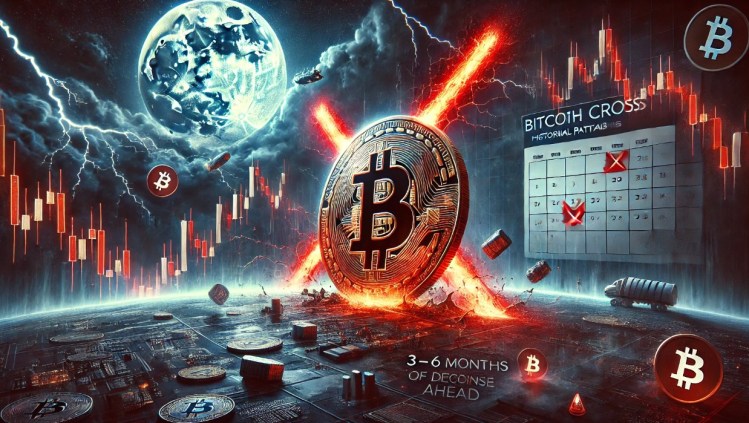
Have you ever stared at the Solana chart and wondered how different life would look if you had acted back when it was the best crypto presales to join now in its earliest stages? Early adopters bought Solana for under $1 before it surged past $250, transforming small bets into dream-level wealth. Some believers celebrated those gains, while many skeptics dismissed it as another risky blockchain gamble. Today, those doubters still refresh charts and quietly ask themselves why they ignored the moment when the price was tiny and the opportunity was practically screaming for attention right in front of them.
That same spark of excitement returns as BullZilla launches its live presale and momentum accelerates. Anyone who missed Solana’s meteoric rise now sees a fresh shot to join early while pricing remains unbelievably low. The desire for round two at history-making gains is alive again as traders search for a presale project built on real growth potential. BullZilla delivers that early entry advantage before the crowd rushes in. It feels like the redemption storyline for every investor who once regretted saying, “I should have repurchased it then.”
In its early days, Solana was seen as a bold experiment focused on ultra-fast blockchain performance and scalability. Prices were low enough for even modest investments to accumulate massive token holdings. Early believers faced skepticism until Solana skyrocketed past $100 and eventually exceeded $250, transforming ordinary investors into overnight millionaires. What began as a technical curiosity became one of crypto’s greatest success stories. The missed Solana entry remains a lasting reminder that hesitation in innovation often carries a heavy cost.
Solana traded under $1 before exploding above $250, turning tiny investments into immense wealth. Those who hesitated now feel the sting of missing a life-changing opportunity.
Solana still has strong technology and adoption, but the early moonshot gains are gone. Late buyers often wish they had acted sooner when the price was extremely low and overlooked.
BullZilla creates excitement by empowering supporters through a unique ecosystem that rewards conviction and loyalty. The HODL Furnace offers long-term believers a massive 70% APY on locked tokens, strengthening community commitment. Vesting rewards grow over time, encouraging holders to stay dedicated. The Roarblood Vault powers referral bonuses, including 10% rewards on $50 purchases, and continues supporting sustainable growth. These features help BullZilla stand out as the best crypto presales to join now, offering powerful returns ahead.

BullZilla presale is live, triggering urgency among investors hunting the best crypto presales to join now. It is in Stage 8, Echoes of the Bull, Phase 4 at $0.0002124, with over $1 Million raised and more than 31 billion tokens sold. Early buyers have already gained significant ROI as prices move toward the $0.00527 listing target. A $1,000 investment secures 4.86 million tokens, and with each new stage increasing in price, opportunities for low-entry positions are quickly disappearing.
BullZilla adopts a progressive pricing engine that makes the presale move like a living creature. 50% of the total supply, or 80 billion tokens, is allocated to the presale. The price automatically climbs every 48 hours or with each additional $100,000 raised, ensuring continuous upward motion. This dynamic model fuels market momentum and rewards early buyers as the community grows, driving valuation higher. For investors, every hour counts because waiting even a little longer could mean paying significantly more for entry.
With automated price increases and growing excitement fueling participation, a steadily rising price floor becomes an exhilarating reality. This structure establishes the ideal foundation for the next major crypto coin breakout. It’s a system powered by belief, transparency, and action at every stage of the presale process. As more investors recognize the potential and global awareness spreads, curiosity intensifies-many now wonder just how high this project could climb once mainstream attention fully converges on its rapidly expanding ecosystem.
Remember every conversation about Solana when it was brand new. People said it would not last or that it was not worth the risk. Yet here we are. Solana holders celebrate while those who did nothing replay history again and again. BullZilla brings a new storyline where early believers can finally take that swing. When presale live updates shift prices quickly, only the decisive investors win big. The next big Crypto coin should be seized during its early phase when affordability meets unmatched potential.
BullZilla is a structured presale project offering significant ROI potential, backed by loyalty features, high APY staking, and real community rewards. It attracts early buyers seeking upside before major listings drive access and price increases higher.
BullZilla uses a progressive pricing model in which the token price automatically rises every 48 hours or whenever another $100,000 is raised. This motivates quick participation to secure lower entry levels before costs climb.
The presale offers incredibly low pricing that will never be available again once public market access arrives. Early buyers gain the most substantial upside, while those who procrastinate often face much higher entry points later when demand explodes.

The best crypto presales to join now momentum is rare and powerful because true early opportunities often appear when most people hesitate. Solana proved how a small, early decision can transform into life-changing gains once the world pays attention. BullZilla now creates a similar pathway for those craving redemption and a comeback story worth celebrating. Its presale live status invites confident action, not delayed reactions. This project stands at a thrilling crossroads where belief meets massive upside before broader recognition arrives across global markets.
BullZilla represents more than just another token-it’s an opportunity to shape a new financial destiny where early conviction outweighs perfect timing. The presale rewards bold investors with exceptionally low entry prices available for only a limited time as momentum rapidly builds. This is the moment before opportunity transforms into hindsight. The question now is urgent yet straightforward: will investors seize this chance, or once again watch another potential moonshot soar beyond reach while they stand on the sidelines?

Follow BZIL on X (Formerly Twitter)
This content is for information only and not financial advice. Cryptocurrency involves risks. Always do your own research before investing.
Read More: Still Regret Not Buying Solana? BullZilla Fuels The Best Crypto Presales to Join Now">Still Regret Not Buying Solana? BullZilla Fuels The Best Crypto Presales to Join Now



The post What Whales Bought During the Crash: A Look at the Best Altcoins for Q4 appeared first on Coinpedia Fintech News
The recent crypto crash led to sharp declines, and many retail investors exited early. Some major holders took a different route, buying assets when sentiment was weak.
This article examines four altcoins that saw accumulation during the downturn. Each token offers a different risk profile and potential for the remainder of Q4.
While all entries have merit, Digitap ($TAP) stands out, seeing major whale investment during the crash due to its live app, omni bank model, and Visa integration.
$TAP demonstrates several features that attract interest from larger investors. It combines a crypto‑fiat app, a Visa‑backed card, and a mechanism whereby 50% of platform profits go to burning tokens and staking.
Its payments app is available from Apple and Google stores right now, offering instant payments as well as international IBANs for wages and transfers. The project has raised more than $1.2M, with 80M tokens sold thus far.
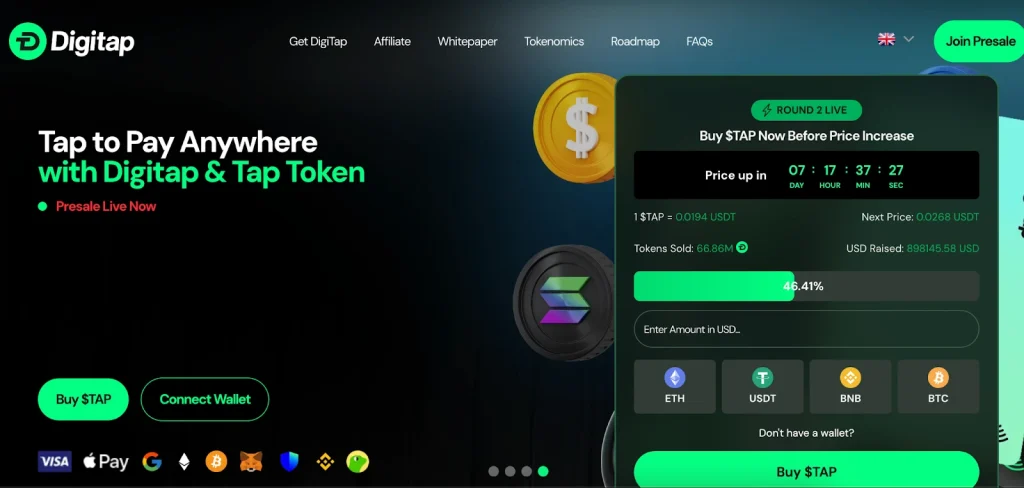
The Digitap structure might appeal to holders seeking early exposure ahead of mass adoption. It targets the 1.4 billion globally unbanked as well as the growing demographic of remote work professionals who are demanding a low-fee, zero-KYC payments model.
If it gains traction in this market, the token price could experience parabolic returns similar to payment coins like XRP, in their early stages.

Given these conditions, $TAP qualifies as one of the best altcoins to invest in right now. Crypto whales have already taken note and allocated significant positions throughout Q4. Presales also have an added advantage as the price remains constant throughout major bear markets. Currently priced at $0.0268, $TAP will rise to $0.0297 in the next round before ultimately listing at $0.14.
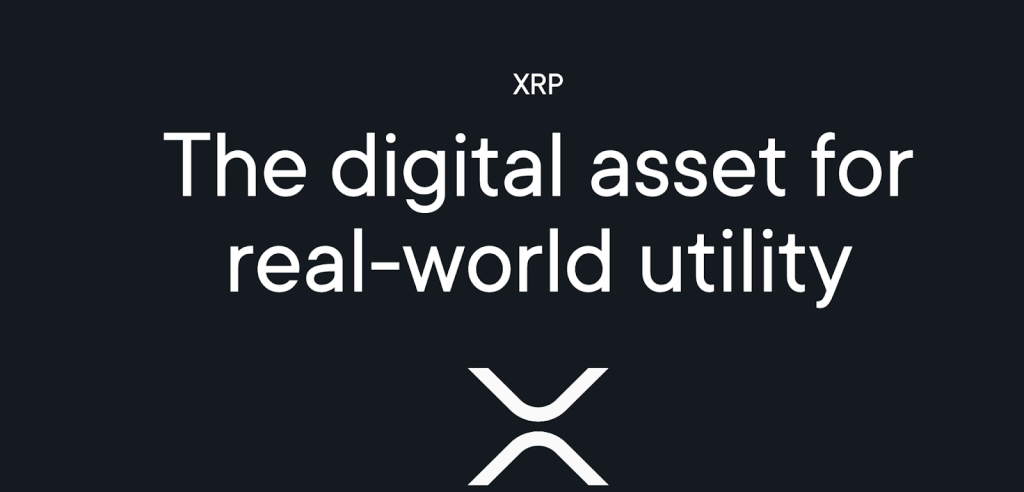
XRP stands out for its mature ecosystem and apparent accumulation by large wallets during the recent downturn. Data shows significant XRP being withdrawn from exchanges and moved to long‑term addresses. That behavior may reduce short‑term selling pressure. With its history of institutional use, the token may offer a relatively lower risk compared to smaller altcoins.
In a recovery scenario where capital rotates into altcoins, XRP could be well-positioned as it fits the profile for those looking for a somewhat higher confidence level with less speculative risk. The trade‑off is that the upside may be more modest than ultra‑early projects. The time to enter XRP was last year when it traded at less than $0.50, not now when it trades nearer to $3.0.

Polkadot aims to support multiple blockchains (“parachains”) and enable interoperability. During the crash, some wallet data show accumulation trends, which may indicate confidence in its long‑term infrastructure role. As altcoins recover, mid-cap infrastructure projects like DOT may benefit if funds rotate away from large caps and into more growth‑oriented platforms.
While risk remains — including competition, technology execution, and ecosystem build‑out — DOT offers a balance of maturity and upside potential. Polkadot offers an infrastructure angle rather than purely speculative hype.DOt presently trades underneath $3.0, extremely far from its all-time high of around $52. This can be interpreted either way, but many have been frustrated at its steady downward trajectory since 2021.
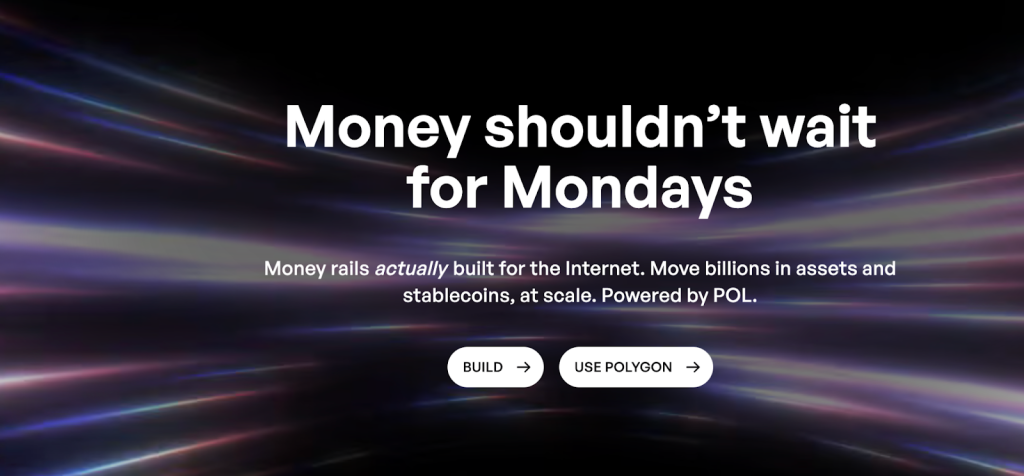
Polygon has repositioned toward an ecosystem of zero‑knowledge rollups and scaling solutions, which are central in the crypto recovery narrative. Some whale interest appears evident via accumulation and defending support zones during the crash phase. However, its price action has been lackluster this past year, steadily declining from January 1st, 2025.
POL belongs to the category of tokens that may capture the next wave of growth if market sentiment improves. However, it’s hard to understand what Polygon’s market case is right now. It seems to be focused on real-world assets and payments, areas where there are other blockchains with deeper market penetration. It is still trying to adjust its market narrative after its recent token rebrand and restructure, confusing many investors.
When major market participants accumulate during a downturn, it often reflects a view that the risk‑reward ratio is becoming favorable. The tokens above cover a spectrum, from presale ($TAP) through large cap (XRP) to infrastructure mid-cap (DOT, POL). This breadth means coverage of different risk categories to cater to different investors.
Digitap is an interesting entry as it offers major upside but also proven utility, distinguishing it from practically all other presales. Users can download and test the global payments app today, seeing how efficiently it works at a Visa-compatible point of sale terminal. How many other presales can say the same?
This is one of many reasons why whales have seen the value in $TAP and worked to reallocate capital to it during the Q4 downturn.
Discover the future of crypto cards with Digitap by checking out their live Visa card project here:
Presale https://presale.digitap.app
Website: https://digitap.app
Social: https://linktr.ee/digitap.app
The rivalry highlights the competitive landscape in blockchain adoption, influencing market dynamics and strategic partnerships in the crypto space.
The post Solana dunks on XRP supporter after Ripple Swell promo draws comparisons appeared first on Crypto Briefing.
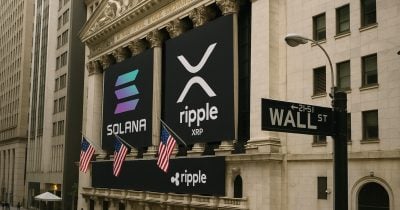

The fast-food chain is also donating 210 sats from every Bitcoin meal toward open-source Bitcoin development.

Elon Musk expects X Chat to launch within the next few months and promises it won’t sell or share users’ data with advertisers.
Crypto analyst @BullrunnersHQ on X social media has issued a new market update, suggesting that XRP may be on the verge of a major rally as traditional markets reach record highs. His latest technical breakdown links the recent strength in the NASDAQ to potential moves within the crypto sector, warning that the “unthinkable” is about to occur for XRP soon. The analyst highlighted that XRP’s price structure and broader crypto signals are aligning for a decisive move that could determine whether the current bull market cycle continues or starts to reverse.
According to @BullrunnersHQ, the equity market is approaching critical levels that could dictate the next major trend in the crypto market and XRP price. Despite the crypto market struggling to reach similar highs, XRP remains firmly above the $2.50 range. He described this setup as “the unthinkable” moment for XRP, where the asset could finally break free from its prolonged consolidation and rally by “multiple hundreds of percent.”
Notably, @BullrunnersHQ asserts that XRP’s price structure remains technically healthy despite market volatility. The analyst also noted that the overall crypto market cap and sentiment indicators have improved, with the Fear & Greed Index climbing to 42 from mid-October lows. He further emphasized that Bitcoin continues to hold comfortably above its 50-week EMA, showing a pattern consistent with previous rallies that led to new peaks.
The analyst added that BTC’s new local high around $116,000 and a bullish crossover between the 10 EMA and 20 EMA suggest that momentum is returning to risk assets, setting the stage for XRP to outperform potentially. Notably, this period mirrors earlier market cycles where Bitcoin’s consolidation above key levels triggered explosive altcoin rallies.
XRP, which has held its support much longer than most cryptocurrencies in the market, could climb to a new all-time high once momentum shifts.
To support his analysis, @BullrunnersHQ has referenced crypto market expert and Chartist Peter Brandt’s discussion about whether the NASDAQ’s recent price action represents a breakaway or an exhaustion gap. While Brandt leans cautiously bearish from an equities standpoint, @BullerunnersHQ remains confident that even if stocks slightly pull back or halt temporarily, money could still rotate into cryptocurrencies, potentially fueling XRP’s next major rally.
In his analysis, @BullrunnersHQ also referenced crypto trader Abdullah, who believes that the NASDAQ’s rally also shows signs of an exhaustion gap, a signal often seen near the end of a bull market uptrend. Absullah points to overbought readings in both the Relative Strength Index (RSI) and the Stochastic RSI on the weekly timeframe, indicating that the markets could be nearing the end of their current bull market phase.
@BullrunnersHQ agreed that the market may be nearing exhaustion but reiterated that XRP’s position offers more upside potential compared to other assets. He also emphasized that Bitcoin must continue to hold between $107,000 and $109,000 on the weekly timeframe. A failure to do so could signal the end of the broader bull market.

On-chain data shows the Dogecoin whales have participated in a significant amount of selling recently, a potential reason behind the memecoin’s decline.
As pointed out by analyst Ali Martinez in a new post on X, whales have reduced their Dogecoin supply over the past few days. The indicator cited by the analyst is the “Supply Distribution” from on-chain analytics firm Santiment, which tells us about the total amount of DOGE that investors belonging to a given coin range are holding as a whole.
In the context of the current topic, “whales” are the traders of interest. Their wallet range is typically defined as 10 million to 100 million tokens. At the current DOGE exchange rate, the lower end converts to $1.8 million and the upper end to $18 million. Given the scale, only big-money holders would be able to qualify for the group.
Such investors can carry some degree of influence in the market, so movements related to them can be worth watching. Their behavior doesn’t always impact the memecoin’s price, but it can still be revealing about the sentiment among this key cohort.
Now, here is the chart shared by Martinez that shows the trend in the Dogecoin Supply Distribution of the whales over the last few months:

As displayed in the above graph, the Dogecoin whales have seen a sharp decline in their supply recently, indicating that these humongous holders have been distributing. In total, the group has shed 440 million DOGE (worth $81.4 million) from its collective holdings during the last 72 hours. Alongside this trend, the DOGE price has slid down, implying that the whale selloff may have had a role to play.
The Supply Distribution of this cohort could now be monitored, as where it goes next could potentially contain hints about what’s coming for the cryptocurrency’s price.
Earlier in the week, Martinez shared another chart related to Dogecoin, this one showing a technical analysis (TA) pattern that DOGE has been trading inside on the 12-hour timeframe.
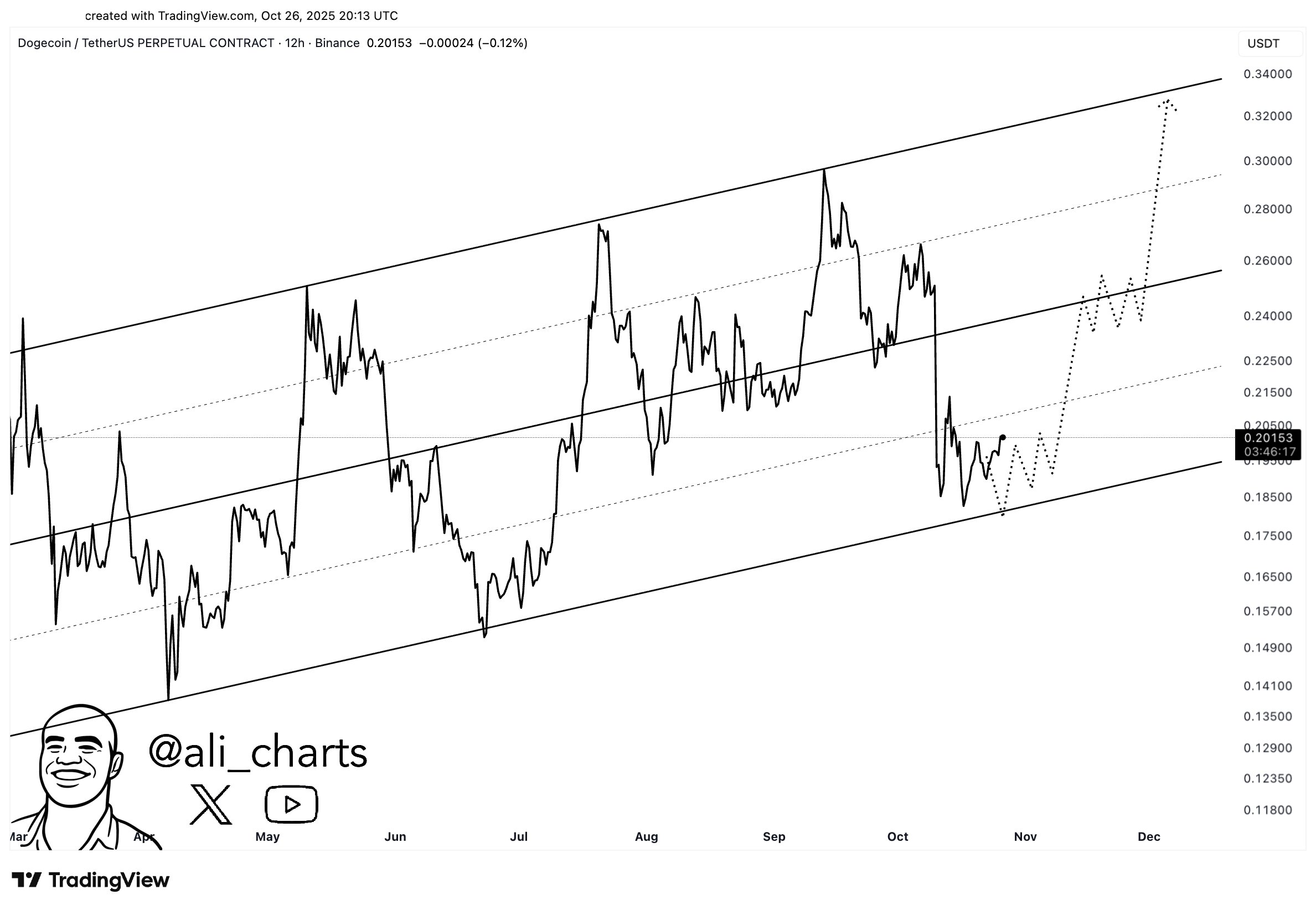
From the graph, it’s visible that the pattern in question is an Ascending Channel, a type of consolidation channel that appears whenever an asset trades between two parallel trendlines sloped upward.
The support line of the channel is located at $0.18. In the post, the analyst noted that holding this level could be key for DOGE. Following the whale selling, the coin is now retesting the level, with a brief fall below it even happening on Thursday, before the memecoin recovered back above it on Friday.
“If bulls defend it, next targets: $0.25 and $0.33,” said Martinez.
At the time of writing, Dogecoin is floating around $0.185, down almost 6% in the last seven days.

Ethereum (ETH) remains under pressure, trading below the $4,000 mark as bulls attempt to reclaim control following weeks of post-crash uncertainty. The sharp sell-off on October 10 not only flushed leveraged positions across the market but also disrupted the uptrend ETH had been building throughout the summer.
Since then, price action has weakened, and momentum has shifted toward the downside, raising concerns among analysts that a deeper correction could unfold if buyers fail to defend key demand levels in the days ahead.
Despite these technical challenges, on-chain and institutional flow data tell a different story beneath the surface. Large-scale investors — including funds, corporate entities, and crypto-native institutions — continue to accumulate ETH during the pullback.
The divergence between price weakness and institutional accumulation creates a pivotal setup for Ethereum. If ETH can stabilize and reclaim the $4,000 threshold, it may re-ignite bullish momentum. But failure to hold support could open the door to further downside before a sustainable recovery emerges.
According to data tracked by Lookonchain, institutional player Bitmine has continued its aggressive accumulation strategy. Purchasing 44,036 ETH — worth approximately $166 million — during the recent market pullback.


This purchase lifts Bitmine’s total holdings to roughly 3.16 million ETH, valued at around $12.15 billion, reinforcing the company’s position as one of the largest Ethereum holders globally. Such sizeable buying activity during periods of price weakness highlights a notable divergence between institutional behavior and short-term market sentiment.
While retail traders and leveraged participants may be shaken by Ethereum’s inability to reclaim the $4,000 level, long-horizon buyers appear unfazed. For them, price dips represent accumulating opportunities rather than reasons for concern.
This duality is becoming increasingly evident across the market: spot inflows, exchange outflows, and whale accumulation metrics all point to growing long-term conviction, even as the chart reflects hesitation and downward pressure.
This divergence underscores a familiar pattern in crypto market structure. Price action often lags underlying fundamentals, particularly during transitional phases where macro catalysts and liquidity shifts are still being digested. Ethereum remains structurally supported by rising institutional participation, increasing staking demand, and expanding Layer-2 ecosystems — all of which strengthen its long-term investment thesis.
Ethereum (ETH) is trading around $3,847, testing a critical support zone after failing to hold above $4,000 and rejecting from the $4,200 resistance area earlier this week.
The daily chart shows ETH breaking below both the 50-day (blue) and 100-day (green) moving averages, signaling weakening momentum and a shift toward a more defensive market posture. This breakdown places increased pressure on bulls to defend the $3,800 region — a level that has repeatedly acted as a pivot point over the past two months.

If ETH loses this support, the next meaningful demand zone lies near $3,500, followed by the 200-day moving average around $3,200, which would serve as a deeper structural retest within the longer-term uptrend. For now, however, ETH remains above its long-term trend line, meaning the broader bullish structure is intact despite short-term weakness.
On the upside, bulls need to reclaim $4,000 and then $4,150–$4,200 to revive bullish momentum and break the series of lower highs forming since September. Until that happens, price action favors consolidation and caution. With macro shifts underway and institutional accumulation rising, Ethereum’s chart suggests a wait-and-see phase, where holding support becomes crucial before any renewed upside attempt.
Featured image from ChatGPT, chart from TradingView.com

The crypto market is beginning to display early indications that a new altcoin season could be approaching, as analysts reference historical patterns and technical signals hinting at a rebound after a lengthy slump. Although altcoins have recently lagged behind Bitcoin, bullish factors from data and macroeconomic parallels are building optimism that a change in liquidity conditions might trigger a strong market-wide rally for altcoins.
According to crypto analyst Javon Marks, altcoin dominance has entered oversold conditions for the first time in history. Marks highlighted in his post that the indicator, which measures the market share of all altcoins, is now the most oversold it’s ever been.
The OTHERS.D chart shows the market dominance percentage of all cryptocurrencies except the top 10 by market capitalization. It is a measure of the combined market share of smaller altcoins and can be used to identify broader altcoin rallies. His long-term chart of the OTEHRS.D movement spans over a decade, with each major low followed by an extended period of recovery and massive market gains.
The chart reveals that dominance has declined sharply since its 2021 peak of around 20%. At the time of writing, the OTHERS.D dominance is around 7%. A wave trend indicator at the bottom of the chart is in deep negative territory around negative 50%, which is its lowest in history.
Marks noted that such oversold conditions often precede strong reversals. It means that selling pressure has been exhausted and that a major rebound could soon begin. If this pattern repeats, altcoins may be entering one of their most attractive accumulation phases in years.
 Crypto Total Market Cap Excluding Top 10 Dominance. Source: Javon Marks on X
Crypto Total Market Cap Excluding Top 10 Dominance. Source: Javon Marks on X
Another technical perspective came from analyst Ted Pillows, who compared current market conditions to the 2019-2020 cycle when the Federal Reserve ended quantitative tightening (QT) and later resumed quantitative easing (QE). His chart of the crypto total market cap excluding Bitcoin shows a 42% decline following the end of QT in late 2019, followed by an explosive recovery after the Fed initiated QE in March 2020.
Pillows explained that while ending QT may ease financial pressure, it does not directly inject liquidity into the economy, something altcoins need to rally. In contrast, QE or Treasury General Account (TGA) releases flood the market with liquidity and allow inflows into cryptocurrencies.
He noted that ending QT isn’t enough for alts to rally. It is either the Fed starts another QE or the Treasury releases TGA liquidity into the economy. The most feasible option right now is the second one.

Crypto Total Market Cap Excluding BTC. Source: Ted Pillows On X
With the US government currently in a shutdown, he suggested that a TGA-driven liquidity release may occur once the fiscal impasse is resolved, and this will serve as the next major driving force for the altcoin market.

Bitcoin (BTC) tumbled below the $110,000 level in a sharp move that rattled markets and triggered a wave of short-term panic selling. The sudden decline followed an initial post-Fed volatility spike, as traders reacted to the US Federal Reserve’s 25bps rate cut and announcement of an impending end to quantitative tightening. With uncertainty still lingering, BTC briefly slipped into a risk-off spiral, testing investor conviction and flushing out leveraged positions in the process.
Despite the market turbulence, several analysts argue this move may represent a classic shakeout, rather than the beginning of a larger breakdown. Historically, Bitcoin has often seen sharp pullbacks immediately before renewed upside momentum, especially during early liquidity-expansion phases.
For now, all eyes are on whether Bitcoin can stabilize and reclaim the $110K zone, a level that has repeatedly acted as a pivot throughout the past month. As markets digest the Fed’s decision, the focus turns to whether Bitcoin can wake up from this sudden sell-off and reclaim strength heading into November.
According to top analyst On-chain Mind, Bitcoin’s current price structure is being defined by a major volume cluster centered around $117,000, which now serves as the Point of Control (PoC) in the local market profile.
This level represents the price zone with the highest traded volume in the recent range — effectively the point where buyers and sellers have shown the strongest interest and where the market has spent considerable time balancing liquidity.
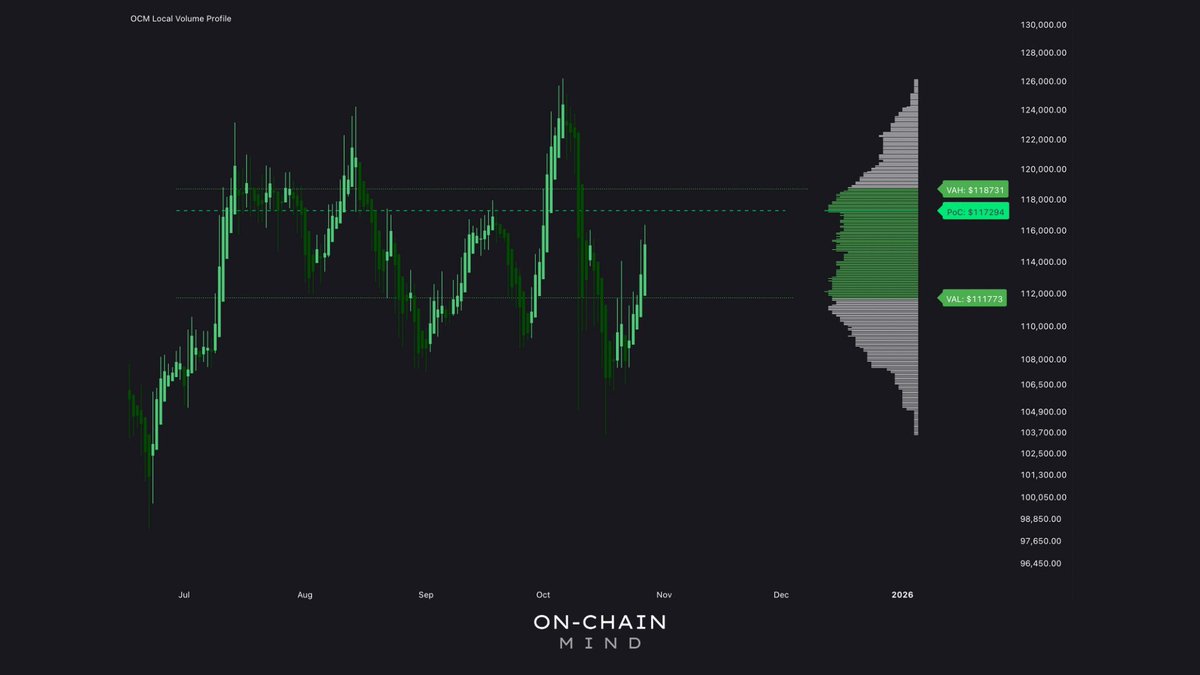
In practical terms, the PoC functions as a fair value zone for market participants. When the price trades below it, bulls need to reclaim the level to regain trend strength; when the price trades above it, the zone tends to act as support. Today, BTC remains beneath the $117K PoC, signaling that the market has yet to re-establish bullish dominance after the recent shakeout.
On-chain Mind notes that reclaiming $117K would likely trigger renewed momentum, opening the door for a retest of the $120K–$123K range. Until then, however, the structure remains indecisive, with price hovering in a neutral zone where neither bulls nor bears hold a clear advantage. This aligns with broader market behavior: reduced leverage, mixed sentiment, and trader caution following aggressive liquidations earlier in October.
The market is digesting macro shifts, recalibrating position sizes, and waiting for a clearer signal. If Bitcoin can stabilize above recent support and begin rotating back toward the PoC, reclaiming $117K could mark the moment the next leg up begins.
Bitcoin (BTC) is currently trading near $110,180 on the 4-hour timeframe, attempting to stabilize after yesterday’s sharp drop. The price managed to reclaim the $110K level, suggesting buyers stepped in at intraday lows around $108,500, an important local demand zone that has repeatedly supported the price since mid-October. However, the recovery remains fragile, with BTC now approaching a cluster of short-term resistance levels.

The 50-period EMA sits just above the current price, and the 100- and 200-period moving averages remain overhead, stacked bearishly. This alignment indicates that momentum has not fully shifted back to the bulls yet.
To regain control, BTC must break above $112,000–$113,000, where multiple moving averages converge and prior support now acts as resistance. Clearing this zone would open the path toward the critical $117,500 Point of Control — the key level bulls need to reclaim to re-establish medium-term strength.
If Bitcoin fails to hold $110K, support lies at $108,500, followed by the deeper liquidity zone around $106,000, where buyers strongly defended price during the October 10 flush. For now, BTC remains in a neutral recovery posture, trying to build a base while navigating overhead pressure from macro uncertainty and recent leverage unwinds.
Featured image from ChatGPT, chart from TradingView.com
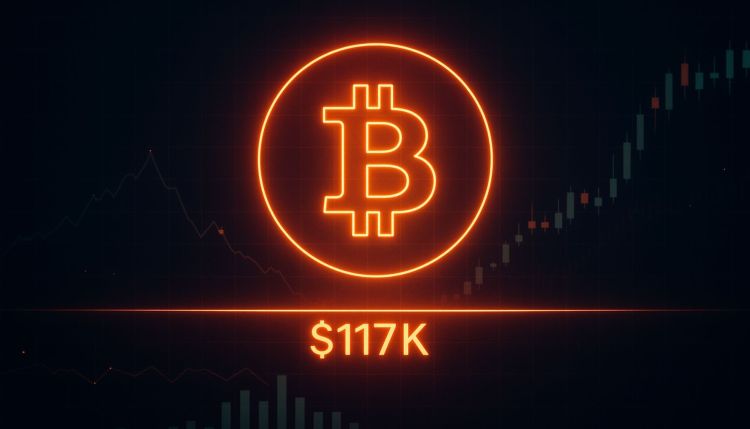
The crypto community has long referred to October as Uptober, a nickname earned through Bitcoin’s consistent history of strong monthly performances. The trend has been so reliable that the month became synonymous with price surges.
Bitcoin has always closed October in profit over the previous seven years, a record streak unmatched by any other month in its history. However, October 2025 appears to be challenging that reputation. As the month draws to an end, Bitcoin is roughly 4% below its monthly open, and October might finally end in red territory for the first time since 2018.
Bitcoin’s price opened October at $114,079, and its sentiment was overwhelmingly bullish at the beginning of the month, carrying over a positive 5% monthly close in September. This bullish sentiment saw the leading cryptocurrency break above $126,000 for the first time before finally setting a new all-time high of $126,080 on October 6. The move strengthened hopes that Uptober would live up to its name once again.
However, the bullish momentum cooled off rapidly, with Bitcoin slipping below $120,000 very quickly. By the middle of the month, Bitcoin witnessed a flash crash that caused its price to fall as low as $101,000 in a quick move. As it stands, Bitcoin is now consolidating near $110,000 by late October, and it can only register a monthly close above this level.

The last time Bitcoin closed October in the red was in 2018, when it closed at $6,303, which is about 4% below its October open of $6,958. That year was during the height of a prolonged bear cycle, when the crypto market was struggling to recover from the massive 2017 rally. Bitcoin’s price had already suffered consecutive down months, and October’s decline was followed by an even more brutal 36.4% crash in November, the steepest monthly loss in the cryptocurrency’s history.
The question now is whether Bitcoin might repeat this downtrend in November 2025. If history were to repeat itself, like it always does in the crypto market, a negative October close could precede another correction in November. However, the answer might not be as straightforward.
Unlike in 2018, Bitcoin’s current market structure is supported by several bullish fundamentals. Institutional interest through Spot Bitcoin ETFs, exchange outflows, and on-chain data shows that long-term holders are not selling aggressively. Even as the price is consolidating around $110,000, volatility is lower than during previous market tops, and this indicates a phase of cooling before another breakout.
Even if the month closes in red, the overall bullish trajectory of Bitcoin is intact. Bitcoin continues to hold its dominance and attract capital inflows. The only sure way Bitcoin might end November 2025 in red is if Spot Bitcoin ETFs perform very poorly throughout the month.
At the time of writing, Bitcoin is trading at $109,700.

Curious about which cryptocurrencies have turned early believers into millionaires? Stellar (XLM) is a prime example. When it launched in 2014, Stellar traded for just a fraction of a cent, around $0.002 to $0.003. At the time, few paid attention. Crypto was young, uncertain, and full of skeptics. Today, with the Stellar price hovering at levels that multiply its early value by thousands, its early investors have become crypto legends.
Yet, as history often repeats itself, there’s always a “next big thing.” And that next big thing is MoonBull ($MOBU), the project that has crypto communities buzzing. MoonBull ignites as the next big crypto to explode, bringing a presale frenzy that feels like déjà vu for anyone who missed Stellar’s breakout moment. The MoonBull presale is live, and early believers are already positioning themselves before the rocket takes off.
MoonBull is shaping up to be one of 2025’s most talked-about crypto presales, combining hype with real utility. This innovative project is now empowering its community like never before. Beginning at Stage 12 of its presale, MoonBull will unleash its Community Voting Power, giving every holder real influence. Each $MOBU token equals one vote, with no lockups and no barriers. Holders will decide key project moves, from campaign execution to supply burns and incentive allocations. Transparency will be the foundation, ensuring that every proposal and result strengthens trust.

And that’s just the start. MoonBull’s massive 73.2 billion total supply is designed with precision and purpose. Half the tokens, a massive 36.6 billion, fuel its 23-stage presale, creating scarcity-driven momentum. Another 10% (7.32 billion) will be locked in liquidity for 2 years, ensuring smooth, stable trading. 20% (14.64 billion) will back a powerful 95% APY staking program, and 11% (8.05 billion) will boost the referral system, rewarding both referrer and referee with extra tokens.
Meanwhile, 5% (3.66 billion) is allocated to drives and community incentives, while 2% each (1.46 billion) is reserved for influencers and the team, with smart lockups to prevent early sell-offs. MoonBull is poised to be the next big crypto to explode because it’s built to last.
MoonBull ($MOBU) is the opportunity of today. The MoonBull presale is live, currently in its 5th stage, and crypto enthusiasts are rushing in. The price is currently $0.00006584, with over $500,000 raised and more than 1,700 holders joining the revolution. At this point, early participants who entered at Stage 1 have already seen a 163.36% ROI, and projections show a massive 9,256% ROI from Stage 5 to the listing price of $0.00616.
Here’s the kind of math that makes headlines: investing just $600 in Stage 5 secures 9,113,001.22 $MOBU tokens, translating to $56,136.09 at listing. With each presale stage seeing a 27.40% price increase (and a 20.38% surge at the final jump), time is literally money.
When Stellar (XLM) first launched its ICO in 2014, few realized they were witnessing the birth of a future blockchain powerhouse. Back then, one Stellar token was worth less than $0.002, giving early investors a chance to enter at an almost negligible cost. As the network grew, focusing on cross-border payments, low transaction fees, and partnerships with major financial institutions, its value skyrocketed.
By 2018, Stellar had reached an all-time high of around $0.93, turning small investments into massive fortunes. Those who recognized its potential early reaped life-changing gains, while many stood on the sidelines, watching history unfold. Missing the Stellar ICO became a powerful reminder: visionary projects can turn cents into millions.

This is the moment that separates spectators from success stories. The $MOBU presale is live, vibrant, and climbing. Each stage fills faster than the last. Investors who once said “I’ll wait for the next one” after missing Stellar’s rise now have that “next one” staring them in the face. MoonBull’s community-driven structure, fair tokenomics, and astronomical ROI projections make it one of the most promising opportunities in 2025.
The window is open, but not for long. MoonBull ignites as the next big crypto to explode, and those who grab their share before Stage 6 could be looking back one day, realizing this was the turning point.

For More Information:
Website: Visit the Official MOBU Website
Telegram: Join the MOBU Telegram Channel
Twitter: Follow MOBU ON X (Formerly Twitter)
MoonBull ($MOBU) is viewed as a 1000x crypto to buy thanks to its 23-stage presale, structured scarcity, and massive ROI potential for early investors.
The live MoonBull presale is growing rapidly, driven by community engagement, early-stage staking, and token burns that tighten supply.
Projects like MoonBull highlight clear presale stages, transparent goals, and reward mechanisms that build long-term growth.
MoonBull’s 95% APY staking pool and reflection-based incentives position it among the highest-rewarding crypto ecosystems.
A strong community, transparent tokenomics, and real governance influence make the MoonBull presale worth watching and joining early.
Presale: Early investment phase before public launch, often offering lower token prices.
ROI: Return on Investment, the percentage gained compared to the initial amount invested.
Governance: Voting system allowing token holders to influence a project’s future direction.
Tokenomics: Structure of token supply, allocation, and economic design.
Liquidity: The ease with which tokens can be traded without affecting price stability.
Stellar (XLM) transformed early believers into millionaires, but the chance to ride that kind of wave returns with MoonBull ($MOBU). With its presale live, a 9,256% projected ROI, and governance-led tokenomics, MoonBull ignites as the next big crypto poised to unlock the opportunity investors who missed Stellar have been waiting for.
Disclaimer: This article is for informational purposes only and does not constitute financial advice. Cryptocurrency investments carry risks. Always conduct independent research before investing in any project.
Read More: Missed Stellar (XLM) Gains? Here’s How MoonBull Ignites as the Next Big Crypto to Explode in 2025">Missed Stellar (XLM) Gains? Here’s How MoonBull Ignites as the Next Big Crypto to Explode in 2025


Hong Kong-based healthcare firm Prenetics ($PRE) has deepened its Bitcoin strategy, purchasing an additional 110 BTC and bringing its total holdings to 378 Bitcoin, valued at roughly $41 million, according to company disclosures.
The move cements Prenetics’ growing alignment between biotech innovation and digital asset management, following its recent $44 million equity raise completed on October 28, 2025.
Prenetics, listed on NASDAQ, first surprised investors earlier this year when it began allocating treasury reserves to Bitcoin. The firm has now increased its position by 100 BTC at an average acquisition price of $109,594.
According to Bitcoin Treasuries’ latest rankings, Prenetics now sits at No. 72 among public companies holding BTC.
The company’s balance sheet remains strong, with total liquidity of $127 million, including $86 million in cash and $41 million in Bitcoin. That blend of fiat and crypto liquidity underlines what the company calls its “dual-engine” strategy, pairing growth in healthcare innovation with digital asset exposure.
JUST IN: Publicly traded healthcare company Prenetics $PRE buys 110 additional #Bitcoin and now holds a total of 378 BTC.
🔸Bitcoin 100 Ranking: 72🪜🔸 pic.twitter.com/xbu18yl8Eb
— BitcoinTreasuries.NET (@BTCtreasuries) October 31, 2025
The recent Bitcoin purchase marks the first major use of proceeds from Prenetics’ $44 million equity offering, which closed just days before the announcement.
The offering was significantly oversubscribed, drawing in a diverse pool of strategic investors such as Kraken, Exodus, GPTX (founded by Bitdeer’s Jihan Wu), XtalPi, DL Holdings, and even world tennis champion Aryna Sabalenka.
According to Prenetics, the participation of such high-profile backers validates its strategy of bridging two fast-growing sectors, health innovation and blockchain-based treasury management.
The move also underscores how Bitcoin is evolving from a speculative asset into a legitimate corporate reserve tool for public companies across industries.
Prenetics’ approach is unusual but increasingly strategic. The firm isn’t pivoting away from healthcare, it’s enhancing it with financial stability backed by a decentralized asset base.
By anchoring part of its treasury in Bitcoin, Prenetics aims to offset traditional currency risks while tapping into the long-term appreciation potential of BTC.
Its move follows a growing trend of non-crypto companies integrating Bitcoin into treasury management, joining a list that now includes firms from energy to technology, and now, healthcare.
The move also lands in a period of strong Bitcoin performance.
As of late October 2025, Bitcoin trades around $109,000, according to CoinMarketCap, maintaining a strong YTD rally supported by institutional inflows and ETF demand.
Meanwhile, Strategy, one of the world’s largest corporate Bitcoin holders, reported Q3 2025 results showing $3.9 billion in operating income and $2.8 billion in net income. The company’s Bitcoin holdings profit rose by $12.9 billion year-to-date, generating a 26% BTC yield across 640,808 BTC held.
Strategy reaffirmed its 2025 full-year guidance with projected $34 billion in operating income and $20 billion in Bitcoin gains, signaling growing institutional confidence in Bitcoin’s long-term trajectory.
Against that backdrop, Prenetics’ recent BTC purchase appears less speculative and more strategic, positioning the healthcare company to participate in the asset’s broader market upside.
Strategy announces Q3 2025 results & reaffirms 2025 guidance.
Q3 results: $3.9B Operating Income, $2.8B Net Income, $8.42 Diluted EPS
FY2025 guidance: $34B Operating Income, $20B BTC $ Gainhttps://t.co/BizC9HyJLD— Strategy (@Strategy) October 30, 2025
Prenetics’ dual-focus model, combining biotech research with blockchain-backed asset management, continues to attract investor attention.
Its leadership describes the approach as a “hybrid growth model” designed to enhance capital efficiency while maintaining aggressive innovation within its health vertical.
By integrating Bitcoin as a balance sheet asset, Prenetics can both protect its reserves against currency devaluation and signal confidence to institutional investors seeking financially agile, forward-looking public companies.
The concept of holding Bitcoin on corporate balance sheets was once experimental. Today, it’s strategic.
Prenetics’ latest acquisition follows the blueprint pioneered by companies like Strategy and Tesla, which integrated BTC holdings as a long-term inflation hedge and store of value.
For a healthcare company, the move is unconventional, yet increasingly logical in a macro environment shaped by rising interest rates, fiat volatility, and institutional digital adoption.
Prenetics’ timing also aligns with increased market optimism around Bitcoin ETFs and global regulatory clarity, further reinforcing the firm’s positioning as a first mover in the healthcare sector embracing digital assets at scale.
The market has responded positively to Prenetics’ transparency in treasury operations. The announcement comes with precise figures and clear rationale, signaling maturity and risk management discipline.
While the company remains focused on medical innovation, its Bitcoin allocation offers additional leverage for shareholder value.
Given the backing from high-profile strategic investors and the liquidity from its equity raise, Prenetics is now better positioned to expand both its R&D initiatives and its digital asset reserves.
Prenetics’ latest Bitcoin purchase might mark a turning point, not just for the company, but for corporate treasury practices across sectors.
By pairing healthcare innovation with blockchain-based balance sheet strategies, the firm demonstrates how traditional industries can integrate decentralized assets into their long-term capital frameworks.
As Bitcoin continues to mature and outperform major asset classes, companies like Prenetics are proving that corporate diversification no longer stops at stocks and bonds, it now extends to the digital frontier.
Disclosure: This is not trading or investment advice. Always do your research before buying any cryptocurrency or investing in any services.
Follow us on Twitter @themerklehash to stay updated with the latest Crypto, NFT, AI, Cybersecurity, and Metaverse news!
The post Prenetics Expands Bitcoin Treasury, Acquires 110 More BTC Following Equity Raise appeared first on The Merkle News.
In collaboration with Tether, TRON, and TRM Labs, the T3 Financial Crime Unit marks a major milestone in global crypto crime prevention.
In just one year since its launch, the T3 Financial Crime Unit (T3 FCU) has frozen over $300 million in illicit crypto assets worldwide. The task force, jointly established by Tether, TRON, and TRM Labs, is emerging as one of the most efficient public-private partnerships in blockchain security.
https://twitter.com/Tether_to/status/1984202505719263490?t=ucHxB-sGg6X0xnxtUoCMNw&s=19
Launched in 2024, the T3 FCU was designed to track, trace, and freeze stolen or criminally linked crypto funds in real-time. Its mission: disrupt money laundering, fraud, and terrorism financing within digital finance.
As of October 2025, the unit has provided assistance to law enforcement agencies in 23 jurisdictions, collaborating on hundreds of investigations across continents.
“The creation of T3 was about action, not headlines,” said a Tether spokesperson. “We wanted a structure that could deliver results and restore trust in blockchain transparency. The $300 million milestone shows that we’re doing exactly that.”
According to internal reports, the United States remains the most active jurisdiction for collaboration, accounting for $83 million in frozen assets, about 27% of total volume, across 37 cases.
Other high-activity regions include Spain, Germany, Albania, Bulgaria, Finland, Brazil, Australia, Poland, and the United Kingdom.
In Brazil, where T3 cooperated with local authorities to dismantle a major crypto-fraud ring earlier this year, more than $13 million in assets were frozen across seven cases.
This cross-border collaboration underscores the increasing recognition of blockchain-based intelligence as a vital tool in financial crime prevention.
The T3 FCU combines the technological backbone of TRON, the market influence of Tether, and the analytical precision of TRM Labs, a blockchain intelligence firm specializing in tracing illicit transactions.
By integrating on-chain analytics with regulatory-grade data, the T3 FCU enables real-time flagging of suspicious transactions across both centralized and decentralized systems.
The synergy between these entities has created what some in the crypto community are calling the “Interpol of blockchain.”
Tether, the issuer of the world’s largest stablecoin USD₮, continues to play a leading role in maintaining integrity within the crypto ecosystem.
In its Q3 2025 attestation report, Tether revealed over $10 billion in profit year-to-date, driven by Treasury holdings and strategic investments. The company now holds $135 billion in U.S. Treasuries, ranking as the 17th largest holder globally.
With a circulating USD₮ supply exceeding $174 billion and excess reserves of $6.8 billion, Tether remains the most capitalized and profitable stablecoin issuer.
Beyond crypto, Tether is also diversifying into AI and renewable energy sectors, positioning itself as a key player in both financial and technological infrastructure.
“Blockchain innovation must go hand-in-hand with security and sustainability,” said Tether CTO Paolo Ardoino. “That’s why we’re investing not only in digital transparency through T3, but also in real-world technology that powers global progress.”
https://twitter.com/T3_FCU/status/1984297959694221345?t=ucHxB-sGg6X0xnxtUoCMNw&s=19
The TRON blockchain, one of the most actively used public networks in the world, serves as a crucial infrastructure for T3 operations. Its fast transaction speed and high throughput make it ideal for real-time enforcement actions, such as wallet blacklisting and transaction freezes.
TRON’s growing compliance integration with global law enforcement has made it an essential partner for Tether and TRM Labs in identifying and isolating bad actors.
The T3 FCU has become a template for how public-private collaboration can work effectively in the crypto space. Unlike traditional regulatory efforts, which often lag behind the speed of blockchain activity, T3 acts in real time, detecting, flagging, and freezing illicit transactions before they can vanish into mixers or cross-chain protocols.
The model’s success has drawn interest from several governments, with regulators in Europe and Southeast Asia reportedly exploring partnerships to adopt similar frameworks for local enforcement.
Analysts also note that T3’s ability to provide actionable data could help shape upcoming international crypto compliance standards.
While the freezing of $300 million in criminal assets is a major win for law enforcement, its symbolic impact may be even greater. The milestone demonstrates that blockchain transparency, once seen as a risk, is now becoming a key asset for global security.
With players like Tether and TRON leading the charge, the T3 FCU proves that crypto can coexist with compliance without sacrificing innovation.
As the industry moves toward greater regulatory integration, the T3 Financial Crime Unit stands as evidence that transparency, collaboration, and technology can redefine how financial systems protect themselves in the digital era.
Disclosure: This is not trading or investment advice. Always do your research before buying any cryptocurrency or investing in any services.
Follow us on Twitter @themerklehash to stay updated with the latest Crypto, NFT, AI, Cybersecurity, and Metaverse news!
The post T3 Financial Crime Unit Freezes Over $300 Million in Criminal Crypto Assets appeared first on The Merkle News.

Lawmakers opted to study the proposal further following a wave of public concern over plans to loosen local controls on crypto mining in the state.

The lack of understanding about Bitcoin's economic properties will result in a market dump at the first sign of trouble, Vineet Budki said.
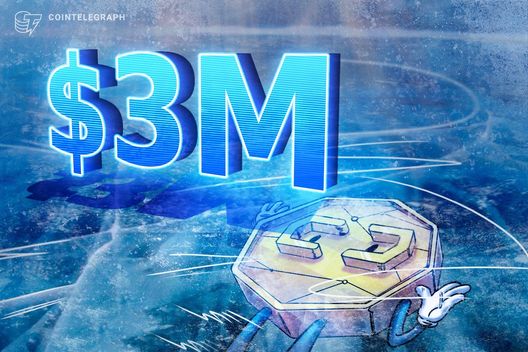
Many crypto users online praised the decision but continued to criticize the exchange for freezing the funds in the first place.

Borderless Capital’s Amit Mehra said quantum computing remains years away from threatening Bitcoin, though rapid advances could make post-quantum security urgent.
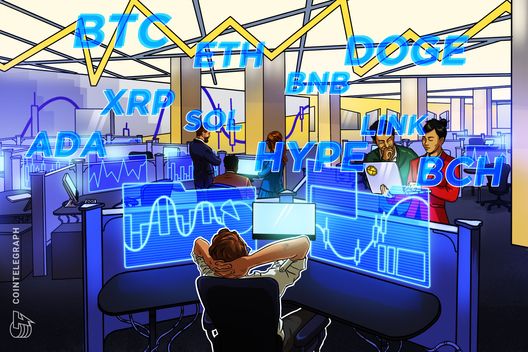
Bitcoin bulls defended the $107,000 level, but the net outflows from the spot Bitcoin ETFs increase the risk of a breakdown in the near term.

Citi and Western Union lead Wall Street’s stablecoin charge as Bitcoin miners and lenders shake up the post-halving crypto landscape.
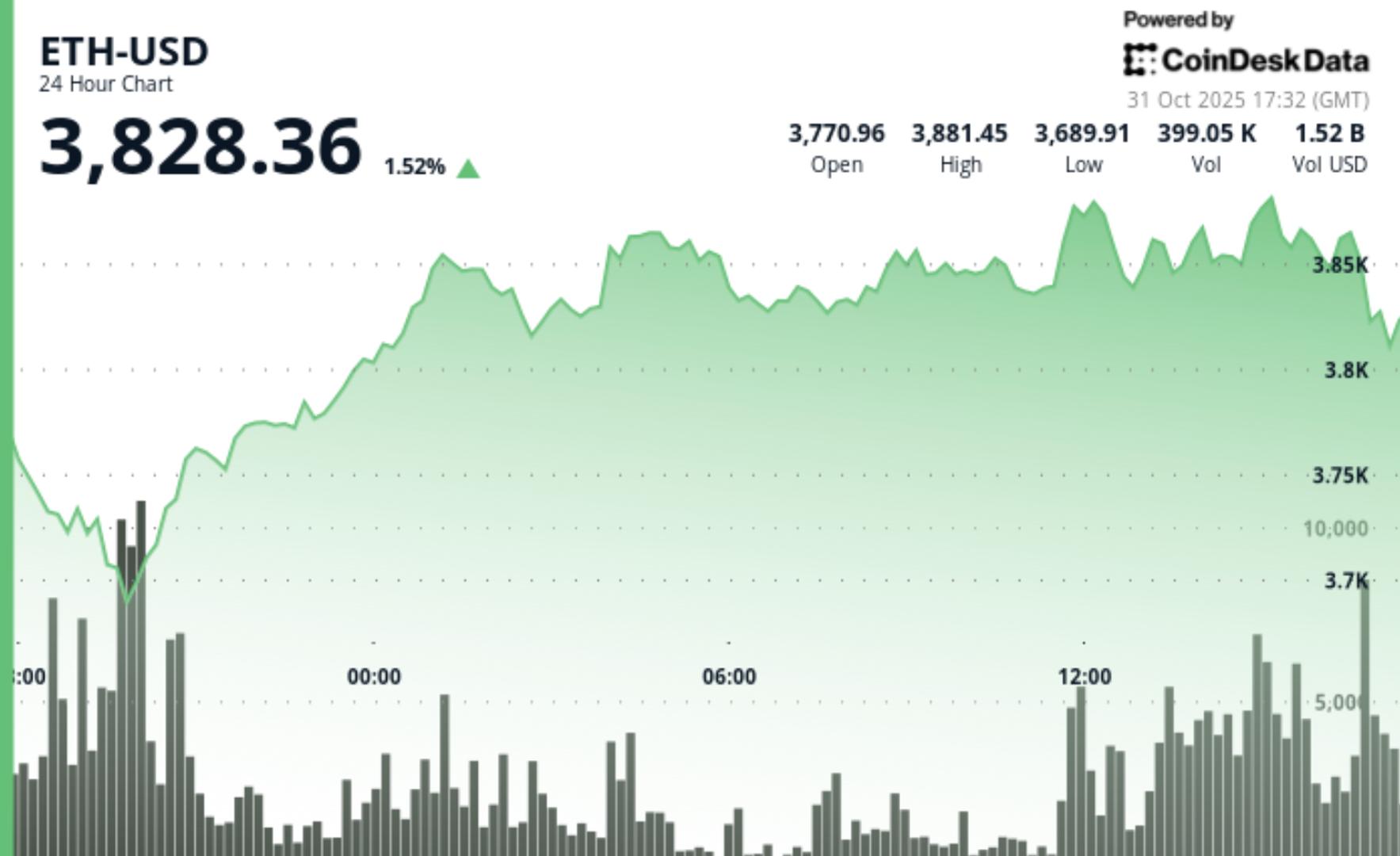
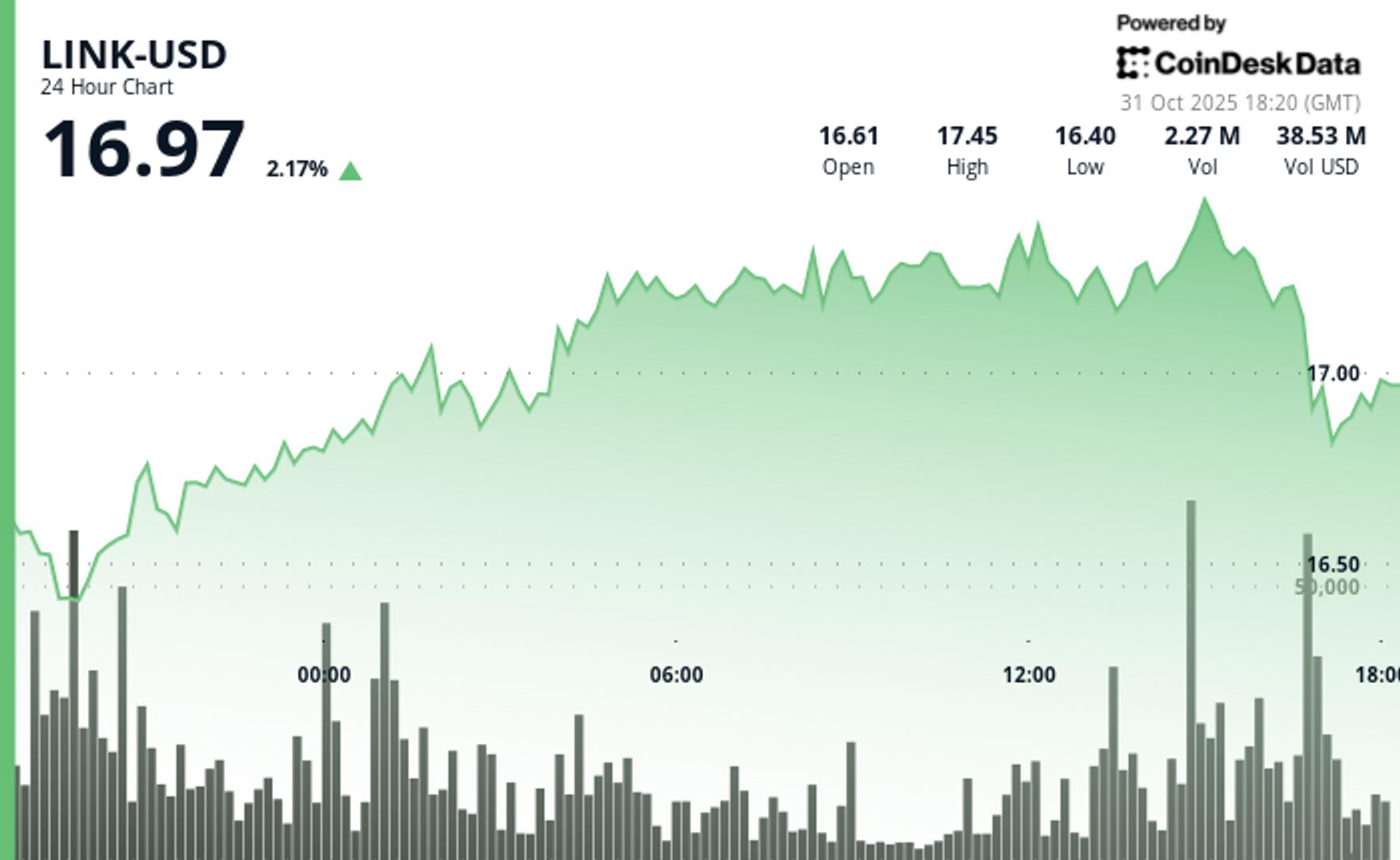

Ethereum is once again testing the strength of its key support band around the $3,700 zone, a level that has acted as a crucial lifeline for bulls in recent months. With momentum fading after repeated rejections near resistance, speculations are whether buyers can step in to spark a renewed push upward or if a deeper correction is on the horizon.
In his latest market update, Luca shared insights on Ethereum’s current technical setup, noting that the asset recently faced rejection at the high-timeframe resistance zone he had highlighted in earlier analyses. This rejection aligns with the golden pocket between the 0.5 and 0.618 Fibonacci points of interest (POIs). Following this rejection, Ethereum’s price has retreated into the broader accumulation range marked in green on his chart.
According to Luca, this accumulation zone has served as a strong reversal area in recent months, providing crucial support whenever price corrections intensified. It also coincides with the Weekly Bull Market Support Band, reinforcing its importance as a potential turning point in Ethereum’s next major move.

Despite this, the analyst cautioned that the current market structure appears vulnerable to a breakdown. Luca emphasized that while he remains optimistic about Ethereum’s long-term potential, if the breakdown is confirmed, he plans to stay objective by hedging part of his spot holdings. Doing so, he believes, would help reduce exposure to downside volatility while keeping capital ready to re-enter the market once a more sustainable bullish reversal emerges.
Luca concluded by reiterating his adaptive trading strategy, a balance between flexibility and discipline. By maintaining moderate cash positions and exposure to defensive assets, he ensures the ability to act quickly when clear opportunities arise while safeguarding capital during volatile market phases.
According to GrayWolf6, Ethereum is currently trading within a defined range between $3,900 and $3,100, with the price recently touching the mid-range support area around $3,600–$3,700. He noted that the Stochastic RSI is flashing a bullish signal, hinting at the potential for a short-term rebound from this zone as buyers begin to regain momentum.
GrayWolf6 further explained that since ETH reached $4,250 just a few days ago, another move toward the upper band remains a possibility. Should the price reclaim strength, the next upside target could extend to around $5,200.
Despite this optimistic outlook, the analyst cautioned that Ethereum remains confined within the lower range, keeping the downside risk near $3,100 in play. He mentioned taking profits on his earlier short position and is now watching closely for signs of a bounce from this intermediate support level. For him, the strategy remains steady, risk-managed, positions hedged, and the next move is patiently waiting.

Bitcoin is sitting on its first true make-or-break support of the cycle, and the market is now in what crypto analyst Dom (@traderview2) calls a “fork in the road.” His message is direct: if Bitcoin cannot stabilize and reclaim key levels quickly, the structure that has defined this entire run breaks for the first time — and he’s positioning for downside.
“This is the last chance for Bitcoin to hold this level and to push higher,” he said in a live analysis stream on October 29. “If Bitcoin does not see its footing here over the next week or two, I think that this is going to break down. And I think that we’re going to see the mid to low $90,000s again.”
Dom’s base case is not a classic crypto winter. He does not expect an 80% wipeout. Instead, he’s warning that the next few days will decide if Bitcoin can defend the “staircase” structure that has held all cycle. If that breaks, he expects a controlled but persistent retrace — not a collapse, but not continuation either.
“I don’t think that we’re going into a year and a half bear market like we always have,” he said. “Those are a thing of the past… unless the world goes into a terrible recession like Great Depression type thing.”
The key line he’s watching for Bitcoin is roughly the $111,000–$114,000 region, which he referenced in the context of reclaimed resistance and VWAP levels. “If it doesn’t regain that in a quick timeframe, I think we need to get ready for a larger breakdown and that’s going to be sub $100K,” he said. His first target on breakdown is near $98,500, which lines up with what he called the 12-month rolling VWAP — “our bull market band this entire cycle.”

Below that, he’s looking at whether buyers step in aggressively or not at all. That reaction, he says, will decide if $95,000 is a local wipeout and reset, or the start of something worse.
The reason he considers this moment “do or die” is that, unlike earlier legs in the cycle, Bitcoin is no longer bouncing instantly from support. Throughout the advance, Dom says, Bitcoin followed a single clean pattern: break a major resistance, retest it once, and explode higher. “Any time that we cleared resistance, we held that as support,” he said. “It’s been a perfect pattern throughout the entire cycle.”
That behavior has now changed. After the October 10 liquidation event and the brief strength around the Fed decision and China headlines, Bitcoin stalled. It broke above resistance, then just sat there for “four or five months,” failed to expand, and is now losing momentum at the exact same level buyers previously defended with urgency.
“Somebody does not believe that this is a discount,” he said. “We’ve had so many bounces at the same price and buyers just aren’t interested. What’s going to get them interested? Logically lower prices.”
This is classic auction theory for him. In strong uptrends, the first retest of a key level is bought instantly because participants see it as cheap. Now, he says, order flow shows hesitation, not urgency. That is how tops actually form in crypto: not one dramatic candle, but buyers refusing to defend the same level for the fifth time.
He also pointed directly to shallow liquidity on major spot books. On Coinbase, he said, “these order books are empty… nobody’s saving us down here.” He described only thin passive bid interest near $100,000 — “that’s only 170 Bitcoin. That’s really not much” — and heavy active sell pressure on Binance. “People are actively market selling… and we don’t have anyone on the other side to absorb that pressure.” His conclusion: this is exactly the setup that precedes fast air-moves lower if a key level breaks.
That fragility is not hypothetical. Dom says the October 10 crash already proved how dependent crypto still is on a handful of market makers. “We basically slid through an empty order book,” he said. “It proves how fragile crypto really is… If their risk systems say, ‘Hey, we’re not going to quote this,’ markets are going to crash like they did.”
Still, Dom is not in the “cycle is over forever” camp. He thinks the market has changed structurally and that most traders are still using a 2021 mental model in a 2025 market.
He argues Bitcoin is now an institutional instrument, not a purely speculative retail instrument. “This right here has been a very steady staircasing kind of growth,” he said. “The difference… is that this was really pushed because of institutions. I think the institutions were the main driver behind this cycle… ETFs launched and we’ve kind of just staircased our way up.”
That slow, controlled advance is why he rejects the idea that Bitcoin will repeat the classic -80% drawdown after topping. He calls the new flow “parked money” — capital from ETFs, corporate treasuries, allocators, and “financial advisors, 401k money,” that is not actively panic-selling every 5% move. “They’re not calling you every other day and saying, ‘Oh, you know, it’s down 5%. Let’s sell it,’” he said.
He also pointed out that this cycle barely doubled the old all-time high instead of going vertical, and even printed new highs before the halving. In his view, if the upside blow-off was muted and institutional, the downside is likely to be muted and institutional.
At press time, BTC traded at $110,280.
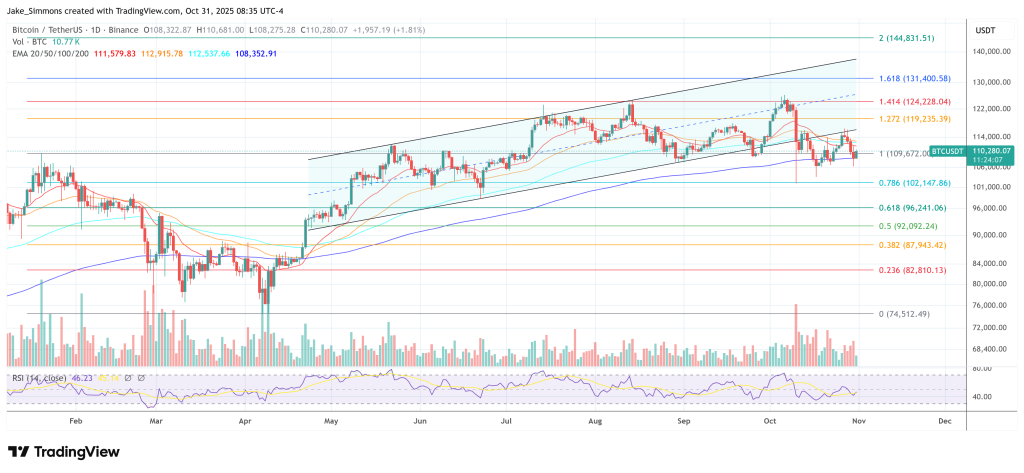

This article was first published on The Bit Journal.
In a sudden turn around, investors yanked more than $550 million out of Bitcoin and Ether ETFs, which ended a week-long rally and also gave the signal that there is a temporary cool-off in institutional demand for the top two digital assets. Yet; while the rest of the market was in red, Solana’s ETFs headed in the opposite direction, attracting around $48 million in fresh capital.
Analysts and fund managers point out that Solana’s ability to pair staking with strong network fundamentals is changing investor attitudes.
Just recently, U.S. spot crypto ETFs tracking Bitcoin registered around $470.7 million in outflows. Fidelity’s FBTC lost $164.36 million, while ARK and 21Shares’ ARKB was down by around $143.80 million. Other Bitcoin-linked ETFs like BlackRock’s IBIT and Grayscale’s GBTC also chipped in with redemptions of $88.08 million and $65.01 million respectively.
Ethereum ETFs were also in the red, registering around $81.44 million in withdrawals (Fidelity’s FETH accounting for $69.49 million) even as day trading volume reached $2.43 billion.
This stood in stark contrast to Solana ETFs, which jumped into positive territory. Bitwise Asset Management’s flagship Solana product (BSOL) pulled in about $46.5 million in net inflows on the day (in addition to earlier inflows), while Grayscale investment’s GSOL added $1.4 million on its first full trading day.
In total, combined spot Solana ETFs inflows drew $47.9 million and since launch, they have pulled in $117 million in total.
The rise in Solana ETF inflows is rooted in many factors. The Solana product structure gives investors a taste of yield via staking. The Bitwise Solana Staking ETF (BSOL) holds about 82% of its SOL in stake and is working towards full staking, making it more appealing to institutions that are after returns.
Solana’s network fundamentals also gained a lot more credibility with institutions; its DeFi TVL had more than tripled year to date, transaction volumes were up, and uptime patterns were on point.
The flow data highlights the scale of this shift. While Bitcoin and Ethereum funds collectively saw a net outflow of about $552 million, Solana ETFs drew around $47- $48 million on the same day.
Further, even the Solana ETF launches themselves were a huge success. BSOL reported a massive first-day inflow of $69.45 million on debut, taking its AUM up to nearly $289 million.
In contrast, Bitcoin and Ethereum still have much larger assets under management but the net outflow event suggests the flow momentum may be shifting.
Solana ETF inflows may have multiple implications for the crypto ecosystem. Increased institutional access via ETFs improves Solana’s visibility in traditional portfolios.
The capital flowing into Solana may reduce available liquid supply (given staking and locking mechanisms), potentially supporting price. Sources note 70% of SOL circulating supply is staked which tightens tradable liquidity.
The Solana ETF inflows may stimulate a broader altcoin-infrastructure rotation. Investors looking beyond Bitcoin and Ethereum may allocate to networks like Solana that have staking yields, infrastructure potential and ETF access.
The current Solana ETF inflows are part of an ongoing change in the crypto ETF space. According to global data reported earlier this month, cryptocurrency ETFs saw $5.95 billion in weekly inflows ending October 4, 2025; with Solana seeing $706.5 million that week.
This means the recent Solana ETF inflows are part of a larger trend that altcoins infrastructure chains will increasingly get dedicated ETF capital.
Moreover, ETF issuers are now offering staking-enabled products (like BSOL) not just price-tracking exposure which expands the type of institutional product available.
The magnitude of the Solana ETF inflows, therefore, means both flow rotation and product innovation.
Driven by yield, network and product, the Solana ETF inflows show institutional allocation in crypto is going beyond the top coins.
ETF (Exchange-Traded Fund) – A pooled investment product traded on exchanges; providing exposure to assets such as cryptocurrencies.
Staking rewards – Income generated by locking tokens in a proof-of-stake network; to validate transactions or secure the network.
AUM (Assets Under Management) – Total value of assets managed by a fund.
Liquid supply – The portion of a cryptocurrency’s circulating supply; that is readily tradable on exchanges or markets.
Infrastructure chain – A blockchain platform (like Solana) that supports applications; DeFi, tokenization and other on-chain activity beyond mere value transfer.
It’s the net investment into ETFs that offer Solana (SOL) exposure; specifically BSOL and GSOL, not ETFs that track Bitcoin or Ethereum.
Part of it is the shift in investor focus; institutions want exposure to yield-enabled; infrastructure-layer assets (like Solana) not just the top two coins. Also; macro and product design differences may contribute to the diverging flows.
According to multiple sources, Solana ETFs pulled in $46.5m (Bitwise BSOL) and $1.4m (Grayscale GSOL) that day, totaling $47-48m.
The flows show crypto ETFs are evolving: infrastructure-layer assets and staking-enabled designs are gaining traction which may lead to broader institutional diversification beyond Bitcoin/Ethereum.
Read More: Solana ETF See $48M Inflows as Bitcoin and Ethereum Funds Lose $550M">Solana ETF See $48M Inflows as Bitcoin and Ethereum Funds Lose $550M
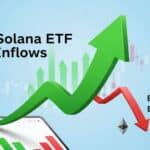

This article was first published on The Bit Journal. The Coinbase revenue in the third quarter reached 1.9 billion dollars, up 26% from the previous one and also beating Wall Street expectations, set at 1.8 billion dollars. The strong earnings performance underlines the company’s growing diversification beyond trading fees and its strengthening market position amid a volatile crypto environment.
According to Yahoo Finance, analysts had expected $1.8 billion in revenue for Coinbase, up 50% from the year-ago period. The cryptocurrency exchange also posted earnings per share of $1.50 against a forecast of $1.10, with net income reaching $433 million down from $1.4 billion in Q2 but significantly higher than the $75 million reported in the same period last year.
Anil Gupta, Coinbase’s vice president of investor relations, attributed the sequential decline in net income to “mark-to-market adjustments” related to the exchange’s holdings in stablecoin issuer Circle and its crypto portfolio. There’s non-cash noise in the net income number, Gupta said, adding that Coinbase revenue growth and profit margins remained robust. Overall, it was a great quarter for us.
Coinbase shares jumped in after-hour trading to 341 dollars, extending their year-to-date 33% gain. The stock reached its high at about 444 dollars in mid-July when crypto sector investor optimism went up.
Transaction-based income remained the company’s largest contributor to Coinbase revenue, totaling $1 billion a 37% quarter-over-quarter increase and well above the $573 million recorded a year ago. The surge in Q3 was powered by renewed market activity as BTC and ETH reached their all-time highs.
Along with an increase in trading volumes, the company’s stablecoin and staking services continued to power Coinbase revenue. The exchange recorded $355 million in revenue related to stablecoins, representing a 43% increase year-over-year, while posting $185 million from blockchain rewards.
USDC, the stablecoin issued by Circle and partially backed by Coinbase, reached an all-time high of a $74 billion market capitalization, while $15 billion in USDC held within Coinbase’s ecosystem further supported Coinbase revenue diversification.
Gupta also emphasized “really good progress” in the derivatives business of Coinbase, subsequent to its purchase of Deribit. The latter contributed materially to overall Coinbase revenue performance. It reported $840 billion in notional derivatives trading volume in Q3.
Meanwhile, the firm’s Ethereum layer-2 network, Base, was still a strong contributor to Coinbase revenue. In its earnings report, Coinbase attributed “higher average ETH prices and increased transaction volume” as key drivers of Base’s revenue growth.
Base has rapidly become a leading layer-2 network for stablecoin adoption, with the total value of dollar-pegged tokens hosted reaching $4.6 billion, according to DeFiLlama.
Recently, analysts at JPMorgan estimated that a possible Base token would add $12 billion to $34 billion in value to Coinbase and raised their price target to $404. Developments like this could significantly alter the long-term dynamics of Coinbase revenue streams.
Coinbase confirmed it has filed for a national bank trust charter, joining the ranks of such peers as Circle, Paxos, and Ripple. The move would position Coinbase to expand its revenue model into custodial and financial services under official banking regulations.
Besides that, Coinbase announced new plans to offer tokenized assets, which would further extend revenue sources for Coinbase. The initiative has also come a few months after similar announcements by Kraken and Robinhood.
Coinbase also added $299 million worth of Bitcoin in Q3 and has increased the fair value of its digital assets held for investment to $2.6 billion as of Sept. 30. CEO Brian Armstrong echoed the company’s long-term strategy on X:
“Coinbase is long Bitcoin and we keep buying more.”
Coinbase is long bitcoin.
Our holding increased by 2,772 BTC in Q3. And we keep buying more.
— Brian Armstrong (@brian_armstrong) October 30, 2025
Given the ongoing momentum in derivatives trading, Base network growth, and stablecoin adoption, the revenue outlook for Coinbase looks strong going into the next quarter. Innovation, regulation, and diversification have all been balanced well by the company, making it one of the most resilient players in the global crypto industry.
Coinbase’s third-quarter results highlight the company’s strong financial resilience amid a recovering crypto market. With expanding revenue streams, growing Base network activity, and increasing Bitcoin holdings, Coinbase appears well-positioned for sustained growth. As innovation and regulation converge, the exchange continues to solidify its leadership in the global crypto ecosystem.
Follow us on Twitter and LinkedIn, and join our Telegram channel to be instantly informed about breaking news!
Coinbase Revenue: Total earnings from Coinbase’s crypto operations.
Stablecoin: Cryptocurrency pegged to a stable asset like USD.
USDC: A popular stablecoin jointly managed by Coinbase and Circle.
Derivatives Trading: Contracts based on the value of crypto assets.
Base Network: Coinbase’s Ethereum layer-2 scaling solution.
Tokenized Assets: Real-world assets represented as blockchain tokens.
Circle: Stablecoin issuer and Coinbase’s USDC partner.
Brian Armstrong: CEO and co-founder of Coinbase.
JPMorgan: Financial firm providing crypto-related analysis.
Coinbase earned $1.9 billion, up 26% from last quarter.
Growth came from trading, stablecoins, staking, and derivatives.
By expanding into Base network, tokenized assets, and custody services.
Base boosted revenue with $4.6B in stablecoins and higher ETH transactions.
Read More: Coinbase Reports $1.9B Q3 Revenue, Powered by Trading and Stablecoin Boom">Coinbase Reports $1.9B Q3 Revenue, Powered by Trading and Stablecoin Boom


Bitcoin Magazine
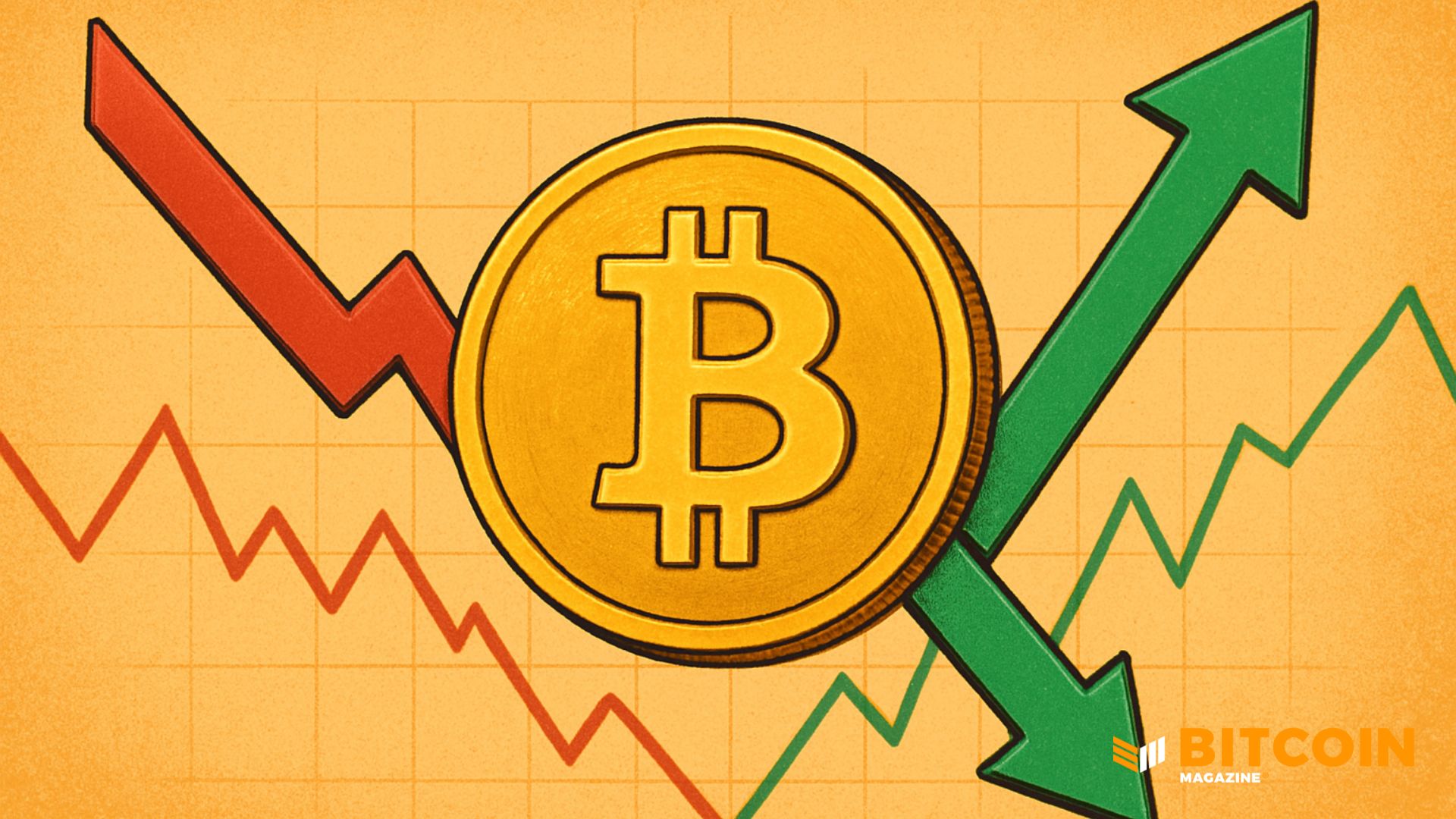
Bitcoin Price Rebounds to $109,000 After ‘Uptober’ Disappointment, Traders Eye November Bounce
Bitcoin price has rebounded slightly to $109,600 after yesterday’s dip to $106,000, ending what has been a tumultuous October for bitcoin.
Traders are now cautiously optimistic as the market transitions from the failed “Uptober” rally to the historically stronger month of November.
Yesterday, Bitcoin tumbled over 3% amid renewed risk-off sentiment sparked by Federal Reserve Chair Jerome Powell’s hawkish comments on future rate cuts and renewed U.S.–China trade tensions.
The dip extended a week-long decline that began after the Fed delivered a modest 25 basis point cut but signaled uncertainty for December’s meeting.
Bitcoin entered October with high hopes for “Uptober,” a seasonal trend historically associated with double-digit gains.
Early in the month, Bitcoin briefly touched $125,000, only to give back much of those gains amid macroeconomic jitters and slow institutional activity. On October 10, the bitcoin price dropped sharply to the $108,000 range from $117,000 as the U.S.-China trade tensions and new tariffs triggered a market-wide sell-off.
At its lowest, Bitcoin fell about 10% on that day and other cryptocurrencies dropped 20–40%, though it later rebounded to around $113,000 amid high volatility.
Strategy (MSTR), one of the largest Bitcoin accumulators, bought just 778 BTC in October — down 78% from September — bringing its total holdings to over 640,000 BTC.
JUST IN: #Bitcoin is about to enter into it's highest performing month on average
— Bitcoin Magazine (@BitcoinMagazine) October 31, 2025
Bullish on Novemberpic.twitter.com/GTDUSGIhQd
Altcoins mirrored Bitcoin’s struggle this month. At times, Ethereum fell below $3,790, while Solana dipped under $187. Despite the weakness, Bitcoin dominance remains steady at roughly 57%, suggesting the market is consolidating rather than capitulating.
Looking ahead, traders are turning their attention to next month, November — sometimes nicknamed “Moonvember” — which historically follows strong October performances.
Despite macroeconomic pressures, some analysts see potential for Bitcoin to retest all-time highs going into 2026, assuming stable Fed guidance, renewed inflows, and no new shocks.
That being said, bitcoin has traded in an unusually tight range between $106,000 and $123,000 for over four months, pushing volatility to record lows, a pattern that historically precedes major trending moves.
If past fractals repeat, Bitcoin could see significant gains toward $170,000–$180,000 by and through 2026, though sideways trading may persist until macro catalysts like Fed rate cuts or capital rotation spur renewed volatility.
This post Bitcoin Price Rebounds to $109,000 After ‘Uptober’ Disappointment, Traders Eye November Bounce first appeared on Bitcoin Magazine and is written by Micah Zimmerman.
Bitcoin Magazine
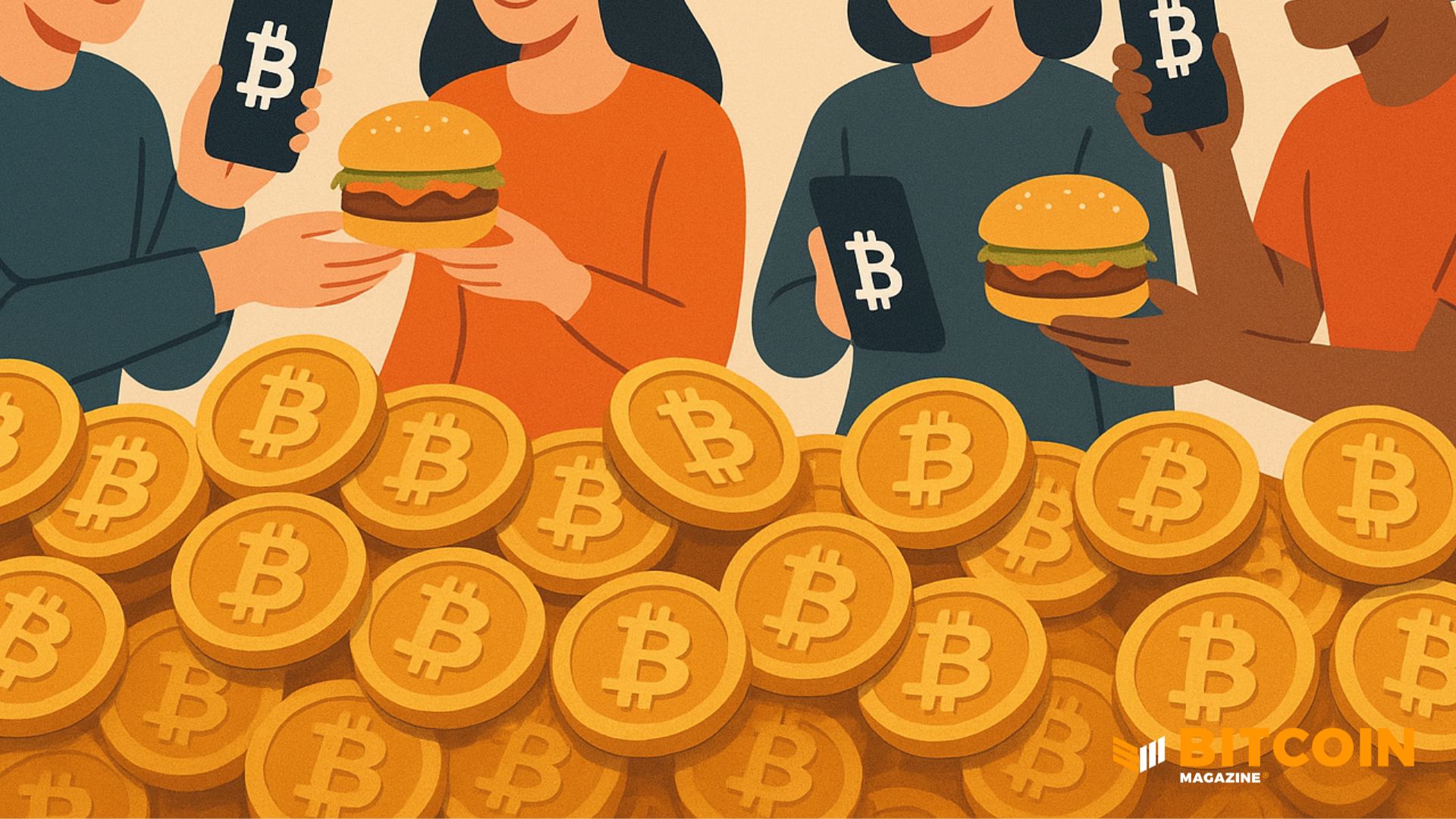
Steak ’n Shake Launches First-Ever Strategic Bitcoin Reserve
Steak ’n Shake is making history as the first major restaurant to establish a Strategic Bitcoin Reserve.
All payments received in Bitcoin will now be added to their Strategic Bitcoin Reserve (SBR), marking a fun and major step into bitcoin adoption for the fast-food chain.
As part of the initiative, the company will donate 210 sats from every Bitcoin Meal sold to the Open Sats Initiative, Inc. over the next 12 months.
Customers who purchase and register their Bitcoin Steakburger through the Fold App will also receive $5 in free Bitcoin, with instructions provided on their receipts.
The move comes on the heels of a strong quarter, with same-store sales up 15% — outpacing all competitors — highlighting the growing impact of cryptocurrency engagement on the restaurant’s bottom line.
JUST IN: Fast food giant Steak 'n Shake announces its created a Strategic #Bitcoin Reserve
— Bitcoin Magazine (@BitcoinMagazine) October 31, 2025
They're also donating to open source bitcoin developmentpic.twitter.com/Mod3XDfMX8
Earlier today, the company and Fold Holdings launched a limited-time promotion at more than 1,200 Steak ’n Shake locations, letting customers earn $5 in bitcoin with their Bitcoin Meal or Bitcoin Steakburger.
Diners simply upload their receipt to bitcoinmealdeal.com, redeem a code through the Fold app, and instantly receive their reward.
The promotion marks the first U.S. restaurant menu item tied to bitcoin rewards, with the Bitcoin logo even stamped on the burger bun as a nod to mainstream adoption.
The campaign coincides with the 17th anniversary of the Bitcoin white paper and builds on Steak ’n Shake’s earlier adoption of Lightning Network payments.
Fold, which holds roughly 1,500 BTC, continues expanding its bitcoin rewards ecosystem.
At the Bitcoin 2025 Conference, Steak ‘n Shake executive Dan Edwards highlighted the company’s global adoption of Bitcoin payments via the Lightning Network.
He noted that Bitcoin transactions immediately exceeded expectations, with one in every 500 global Bitcoin transactions occurring at Steak ‘n Shake on launch day
Edwards said that accepting Bitcoin reduced processing fees by 50%, benefiting both the company and customers.
He stressed that the initiative was a genuine payment upgrade, not a marketing stunt, and reported that customer behavior had shifted positively since implementation.
Steak ‘n Shake reported that customer behavior has already shifted. “We’ve seen a sustained spike since adding Bitcoin,” Edwards noted.
Edwards also teased the company’s future plans, calling for more technical talent. “We’re not done. We’re investing in cyber chefs, autonomous drives, AI tech — and we need engineers to help us build it.”
This post Steak ’n Shake Launches First-Ever Strategic Bitcoin Reserve first appeared on Bitcoin Magazine and is written by Micah Zimmerman.
Bitcoin Magazine

Tenth Circuit Hands Fed a Win: Custodia Denied Master Account in Blow to Crypto Sovereignty, Dissent Brings the Heat
In a 2-1 decision issued today, the Tenth Circuit affirmed the denial of a Federal Reserve master account to Custodia Bank, the Wyoming-chartered Special Purpose Depository Institution (SPDI) that has become the test case for crypto-native banking. The panel upheld the district court across the board and left Reserve Banks with broad (and potentially unreviewable, in the words of the dissent) discretion over access.
Master accounts are the keys to the fiat kingdom. They’re the ledger entries that let institutions clear and settle directly at the Fed; without one, a “bank” is functionally just a vault dependent on fickle intermediaries and third-party rails. That practical choke point (which has been abused by regulators before) gives any discretion over access extraordinary policy significance.
Wyoming created SPDIs to pair traditional (but fully reserved) dollar banking rails with segregated digital-asset services. Custodia, barred from making loans and required to keep dollar deposits 100% backed by high-quality liquid assets, applied for a master account in October 2020. Early signals from the Kansas City Fed were positive (“no showstoppers”), but after the Board finalized its 2022 access Guidelines, FRBKC treated Custodia as a Tier 3 applicant, the bucket that “generally receive[s] the strictest level of review,” and formally denied the account in January 2023. The Board, consulted beforehand, emailed it had “no concerns” with FRBKC communicating a denial.
Writing for the court, Judge Ebel rejected Custodia’s statutory and administrative claims, and essentially granted the Federal Reserve broad, and potentially unbounded, discretion on this point. Reading the Federal Reserve Act’s § 342 (“may receive deposits”) together with the Monetary Control Act’s § 248a, the panel concluded that access decisions remain discretionary with the Reserve Banks; § 248a(c)(2)’s “shall be available” language concerns pricing and parity for services the Board prices, it doesn’t force the Banks to open an account for every eligible institution. The court also treated the 2022 “Toomey Amendment” (§ 248c) as transparency-oriented, not a mandate to approve applications.
On the APA front, the panel held the Board’s “no-concerns” email was not final agency action, the ultimate decision belonged to FRBKC under the Guidelines, so it carried no independent legal effect. That also undercut theories aimed at the Board itself. Finally, Judge Ebel dispenses with Custodia’s constitutional argument related to the Presidential appointment of inferior officers on a (in my opinion) flimsy technicality: that the argument was not properly preserved.
Judge Tymkovich dissented, reading § 248a(c)(2)’s “shall be available” as a substantive access guarantee, not mere pricing boilerplate. In his view, when Congress opened the Fed’s services to “nonmember depository institutions,” it made master-account access a duty enforceable, if necessary, through traditional tools like mandamus, rather than a roving veto lodged in unappointed Reserve Bank officers (a framework he warns invites constitutional headaches). He also emphasized that courts in related master-account litigation (e.g., Banco San Juan) recognize the centrality of § 342 but do not resolve away the MCA’s “shall” command.
We are bound by the ordinary language of the statute and, in my view, shall means shall. Section § 248a(c)(2) mandates access to the Fed’s payment services for all nonmember depository institutions. By denying Custodia a master account, the Kansas City Fed has unlawfully denied it access to those services which are vital to its business. That, it cannot do.
We need to see the result in PayServices (Ninth Circuit). If that court goes the other way, a circuit split would materially increase the odds of Supreme Court review. It’s interesting to note that Judge Tymkovich was also on that case. But, for now, the ball is firmly in Custodia’s court.
Today’s ruling cements Reserve Bank discretion at the access gate; the dissent, by contrast, reads the MCA as Congress’s promise of open access for state-chartered, deposit-taking institutions like Custodia’s SPDI. The stakes, for constitutional structure, state innovation, and Bitcoin-adjacent banking, couldn’t be clearer.
Disclosure: I authored an amicus brief on behalf of Wyoming’s Secretary of State supporting Custodia.
This is a guest post by Colin Crossman. Opinions expressed are entirely their own and do not necessarily reflect those of BTC Inc or Bitcoin Magazine.
This post Tenth Circuit Hands Fed a Win: Custodia Denied Master Account in Blow to Crypto Sovereignty, Dissent Brings the Heat first appeared on Bitcoin Magazine and is written by Colin Crossman.
ZIGChain price hovers near $0.08, but could target key levels as a significant development emerges from the intersection of traditional finance and web3 innovation.
Nasdaq-listed SEGG Media Corporation announced a bold $300 million strategic initiative to integrate blockchain technology into its sports and entertainment operations.
SEGG plans a notable focus on accumulating ZIG, the native token of ZIGChain.
SEGG Media (formerly Lottery.com Inc.) has disclosed an ambitious plan to allocate a portion of its newly established $300 million Digital Asset Treasury toward acquiring ZIG.
The strategy dedicates 80% of the treasury to a multi-asset crypto portfolio.
It includes Bitcoin, with validator-based income generation on networks like Ethereum, Solana, and ZIGChain.
The remaining 20% will be used for acquisitions.
SEGG also targets pilot programs for tokenizing assets such as athlete intellectual property and fan stakes.
A memorandum of understanding with ZIGChain outlines a collaborative effort to tokenize SEGG Media’s sports and entertainment businesses.
The firm plans to leverage ZIGChain’s infrastructure for real-world asset tokenization.
The partnership also aims to launch a trading platform on Sports.com and Concerts.com, enabling tokenized teams, bands, and events.
SEGG Media’s CEO, Matthew McGahan, has emphasized the company’s mission to bridge traditional markets with blockchain innovation.
ZIGChain’s founder, Abdul Rafay Gadit, also highlighted the milestone this represents for institutional blockchain adoption.
The strategic accumulation of ZIG by a Nasdaq-listed entity like SEGG Media has sparked speculation about the token’s price trajectory.
ZIG is currently trading at $0.086, according to CoinMarketCap data, with a 24-hour trading volume of $2.48 million.
While the price has tanked towards new year-to-date lows since flipping from highs of $0.12 in April, ZIG remains well above the all-time lows of January 2023.

Mainnet launch, which occurred recently, has the network eyeing growth.
Just a month into the mainnet launch, ZIGChain has recorded over 1 million transactions.
More significantly, the involvement of a $300 million treasury could inject significant liquidity into the ZIGChain ecosystem, potentially driving demand and price appreciation.
If SEGG Media’s allocation mirrors the enthusiasm seen in related trends, ZIG could see a short-term surge to mirror current outperformers.
A retest of $0.10 could allow bulls to aim for $0.12 and potentially $0.15.
Buyers reached these highs in December 2024.
The post ZIGChain eyes gains as Nasdaq-Listed SEGG Media backs ZIG appeared first on CoinJournal.

Ethereum-based Layer 2 Starknet has officially integrated with a renowned institutional wallet infrastructure provider, Dfns.
The move marks a crucial breakthrough in bringing automated, auditable, and secure wallet operations to the thriving STRK blockchain.
This integration allows enterprises and developers to build and manage Starknet wallets via Dfns.
That will mean real-time visibility, webhook automation, complete DeFi & NFT compatibility, and policy-based governance.
The wallet service provider said:
Dfns brings enterprise-grade wallet management to Starknet, enabling automated, auditable, and programmable wallet operations.
Dfns is now live on Starknet.@dfnsHQ brings enterprise-grade wallet infrastructure, a complete control system for digital assets built for automation, compliance & scalability.
Now, every Starknet app and builder can leverage it. pic.twitter.com/2JRgbKP3D6
— Starknet (BTCFi arc) (@Starknet) October 31, 2025
Precisely, Dfns is offering the STRK community control over their assets with the same transparency, scalability, and management that institutions demand.
Dfns’s Tier-1 integration introduces a massive system that handles the entire transaction lifecycle, from execution to confirmation.
Meanwhile, developers can access these innovative tools via an intuitive dashboard or API.
That promises streamlined wallet creation and management without complex infrastructure setups.
Some newly added capabilities include:
Today’s integration is part of the history of a technical alliance between Starknet and Dfns.
Mid-last year, the wallet service provider participated in Starknet’s STARK curve implementation, allowing MPC wallets to run natively with Starknet’s cryptography.
The 2024 announcement read:
This toolkit will help developers currently building apps and services on Starkware and Starknet to enhance key management using multi-party computation and threshold signatures.
That advancement laid the groundwork for the recent integration, finalizing Dfn’s complete support for the Starknet ecosystem.
With the full infrastructure now live, developers and businesses can deploy decentralized applications (dApps) that merge compliance, decentralized scalability, and automation.
The Starknet-Dfns alliance comes as institutions navigate the blockchain sector, drawn by compliant, auditable, and automated tools.
With Dfns’ infrastructure, organizations can access such perks when leveraging Starknet’s high-speed, low-cost ecosystem.
The alliance merges Ethereum’s scalable L2 system with enterprise-grade wallet management.
That reflects a maturing blockchain industry, blurring the line between DeFi and TradFi.
Starkent’s digital token demonstrated stability amidst the latest Dfns updates.
It trades at $0.1061 after a less than 1% dip on its daily chart.

However, the 35% plunge in 24-hour trading volumes signals weakness, reflecting the broader market uncertainty.
The post Starknet (STRK) integrates Dfns to unlock institutional-grade wallet automation appeared first on CoinJournal.

Shiba Inu price has bounced back following a wave of renewed institutional attention sparked by crypto ETF speculation, though its long-term outlook remains mixed.
The SHIB token has climbed 3% today, outpacing the broader crypto market’s 2.03% gain, as traders reacted to T. Rowe Price’s proposed $1.6 trillion Active Crypto ETF filing — a move that officially lists Shiba Inu among potential holdings.
Despite the short-term rebound, the broader memecoin trend still shows signs of strain, with on-chain weakness, declining network activity, and lingering security concerns tempering optimism about a sustainable recovery.
Beneath the headlines, supply and liquidity metrics paint a more cautious picture.
Exchange reserves have also fallen sharply after an 84.55 trillion token decline from September 2024 to September 2025.
Such a supply shock often foreshadows short-term spikes as available sell pressure thins, but those same withdrawals raise volatility risk and can amplify swings if whales decide to redeploy balances into markets rather than hold.
Technical indicators tell a nuanced story.
SHIB found support near the 61.8% Fibonacci retracement and bounced from a key area around $0.0000095–$0.0000098, with the RSI sitting near 30 and the MACD histogram recently turning positive.
Short-term projections point to $0.00001078 and higher if buyers can clear immediate resistance at the 7-day and 30-day SMAs.
However, resistance remains stiff, and the 200-day and 30-day moving averages present obstacles that could stall rallies.

At the same time, on-chain fundamentals and development metrics limit conviction.
Shibarium activity cratered in October after a reported 82% decline in daily transactions, undercutting burn mechanics and utility-driven demand.
Token burn totals collapsed from tens of millions earlier in the week to just 2.57 million SHIB on October 31.
Combined with falling whale holdings and low open interest, that deterioration makes a sustained, ETF-fueled rally less certain and raises the possibility that SHIB might slide another decimal place if market conditions sour.
Compounding the uncertainty is a security incident: multiple signer keys associated with ShibaSwap appear compromised, and estimated losses approached $2.8 million in that event.
The project’s community response and any follow-up audits will be closely watched, because governance and custody issues can quickly sap institutional appetite for memecoins despite ETF windows.
Short-term traders should focus on whether SHIB can hold the $0.0000095 support and reclaim the $0.0000102–$0.0000109 zone on stronger volume.
On the other hand, longer-term traders should watch ETF progress, on-chain activity, and governance fixes to gauge whether Shiba Inu can move past its memecoin label and attract meaningful institutional flows.
A failure to cement technical gains or to restore Shibarium utility could mean SHIB slips toward another decimal decline, even as crypto ETFs keep the narrative alive.
The post Shiba Inu price forecast: SHIB could drop further amid the crypto ETF buzz appeared first on CoinJournal.

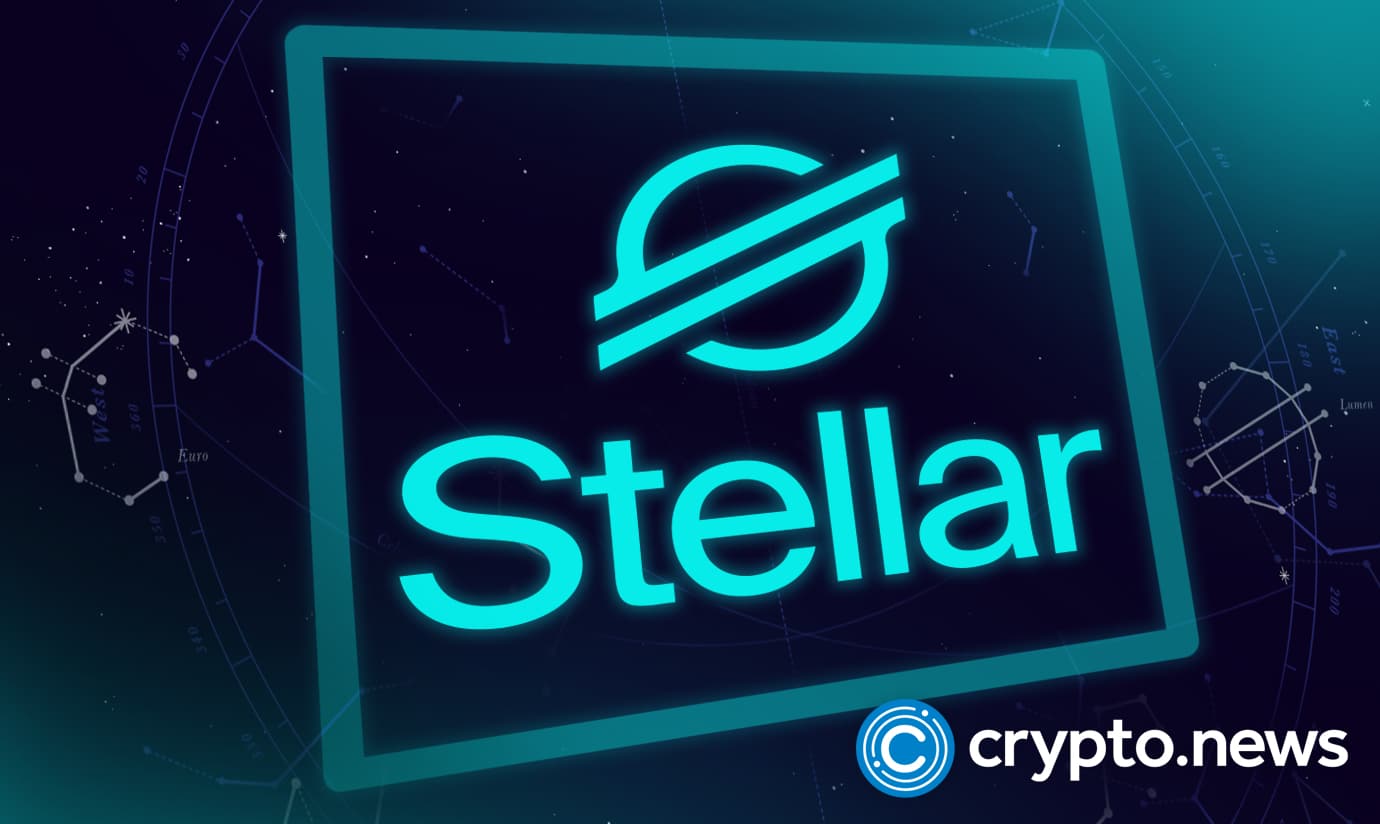

Custodia said it was “actively considering” petitioning the appellate court for a rehearing following the Tenth Circuit judgment, filed more than five years after its application.
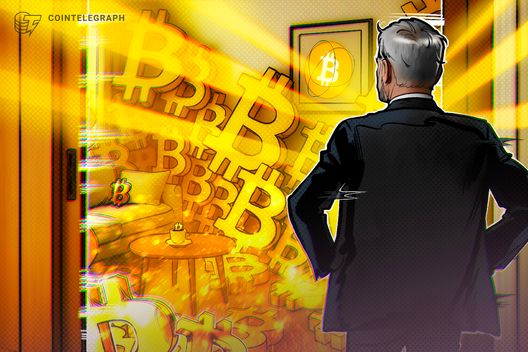
Michael Saylor still foresees a $150,000 Bitcoin price by the end of the year, despite temporary concerns with import tariff escalations.

Older, more established altcoins are likely to be the focus of institutional interest and investment, Maen Ftouni told Cointelegraph.
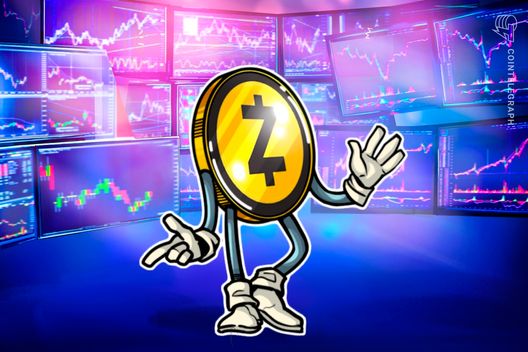
Zcash’s rise mirrors a shifting mood toward privacy in an increasingly monitored online world.

Scott Bessent met Prime Minister Lawrence Wong during the APEC 2025 summit, as world leaders gathered to address global growth, energy security and technology.

Crypto users must deal with costly fees, protocol-level restrictions and multiple service providers to execute simple stablecoin transactions.

The chief policy officer said that the company was “proud to have supported the building of a new ballroom” in response to allegations of corruption from a US senator.

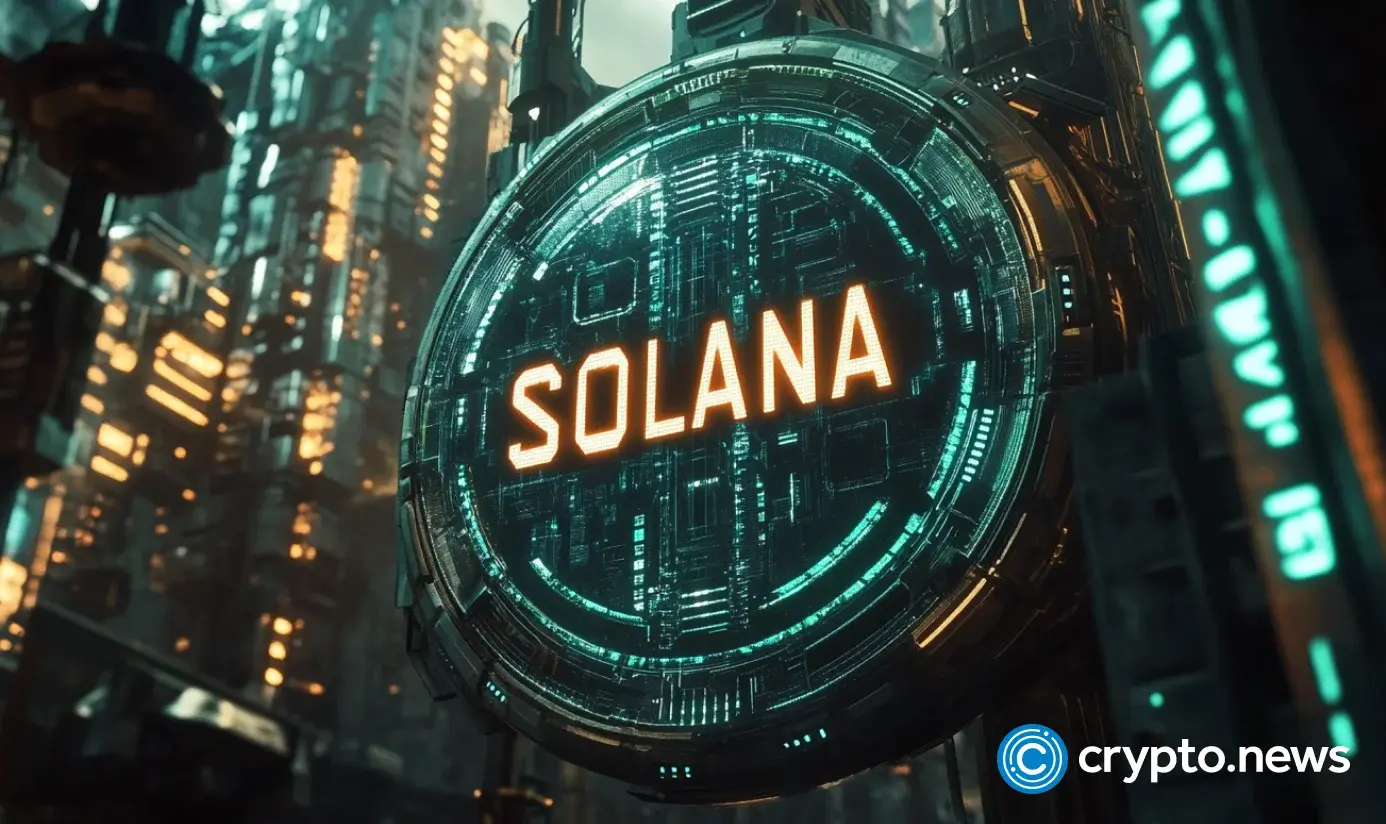




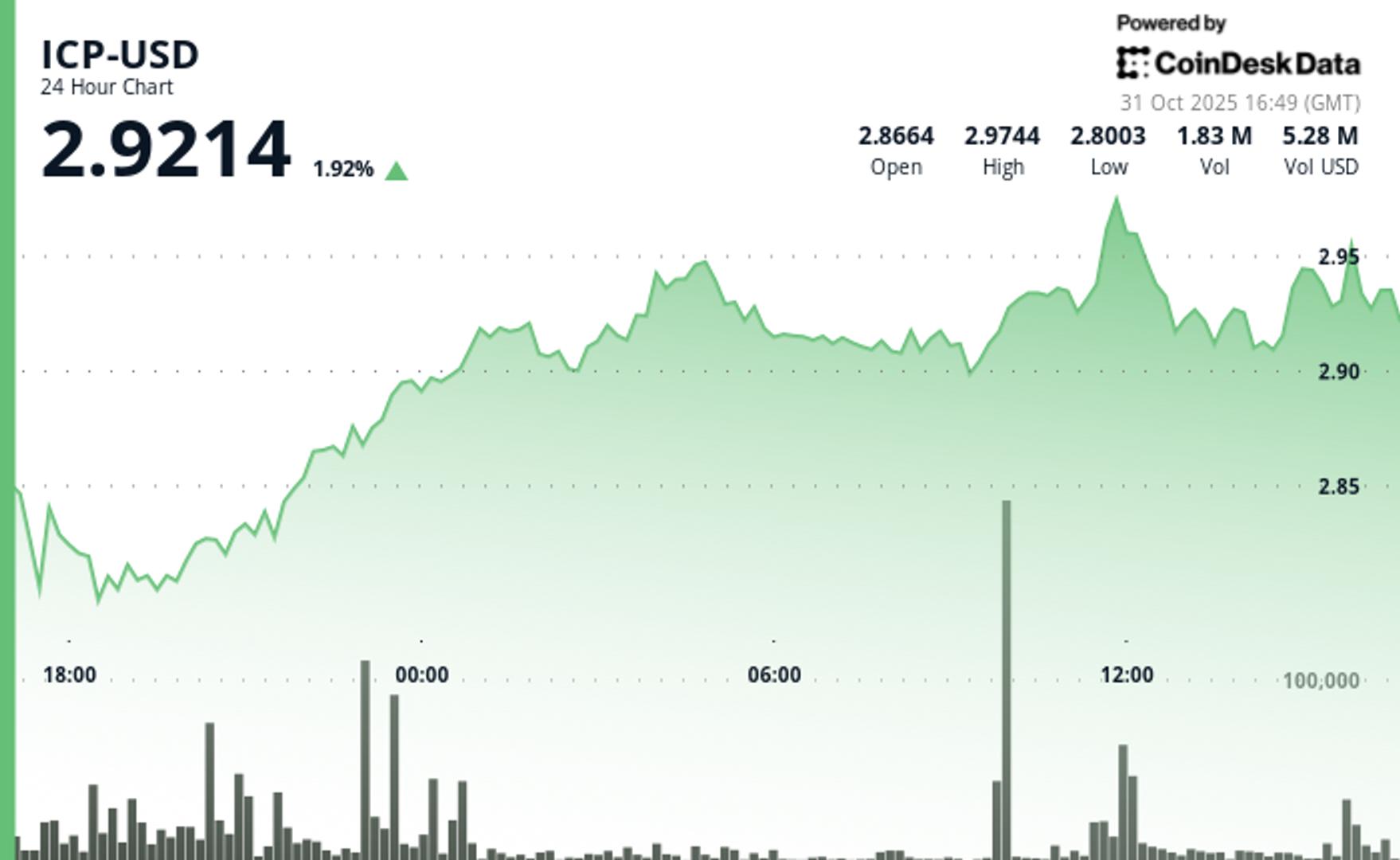
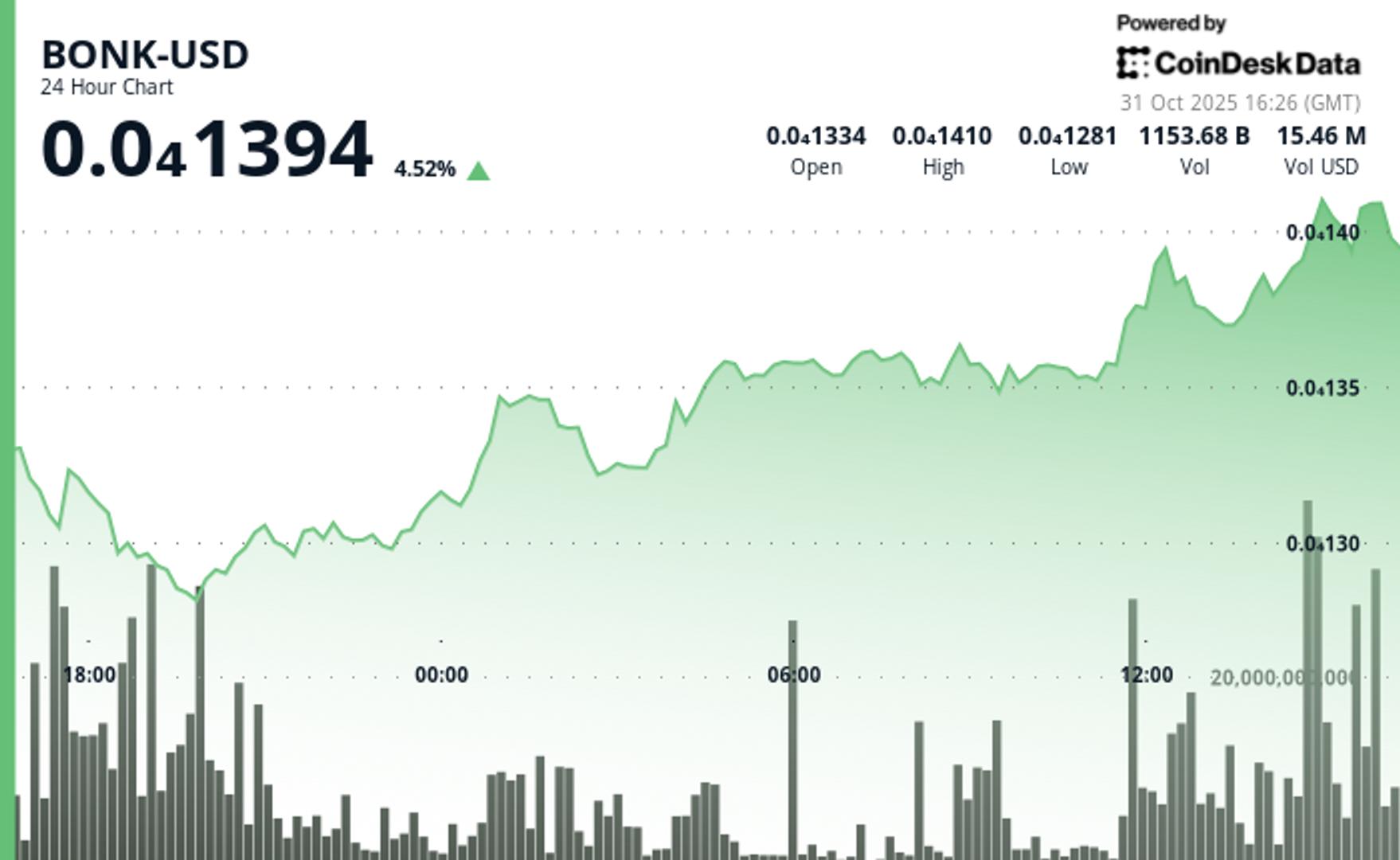
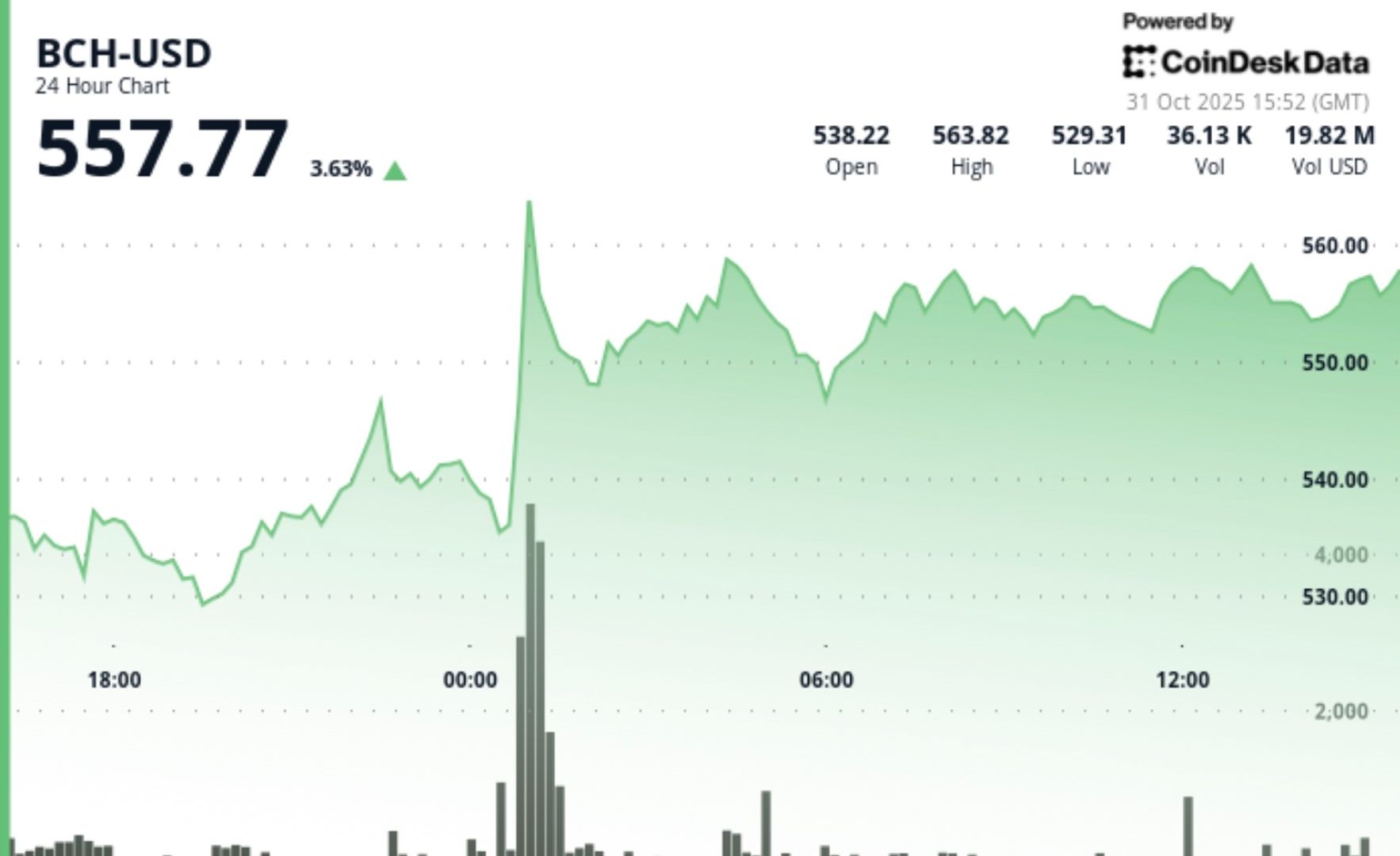
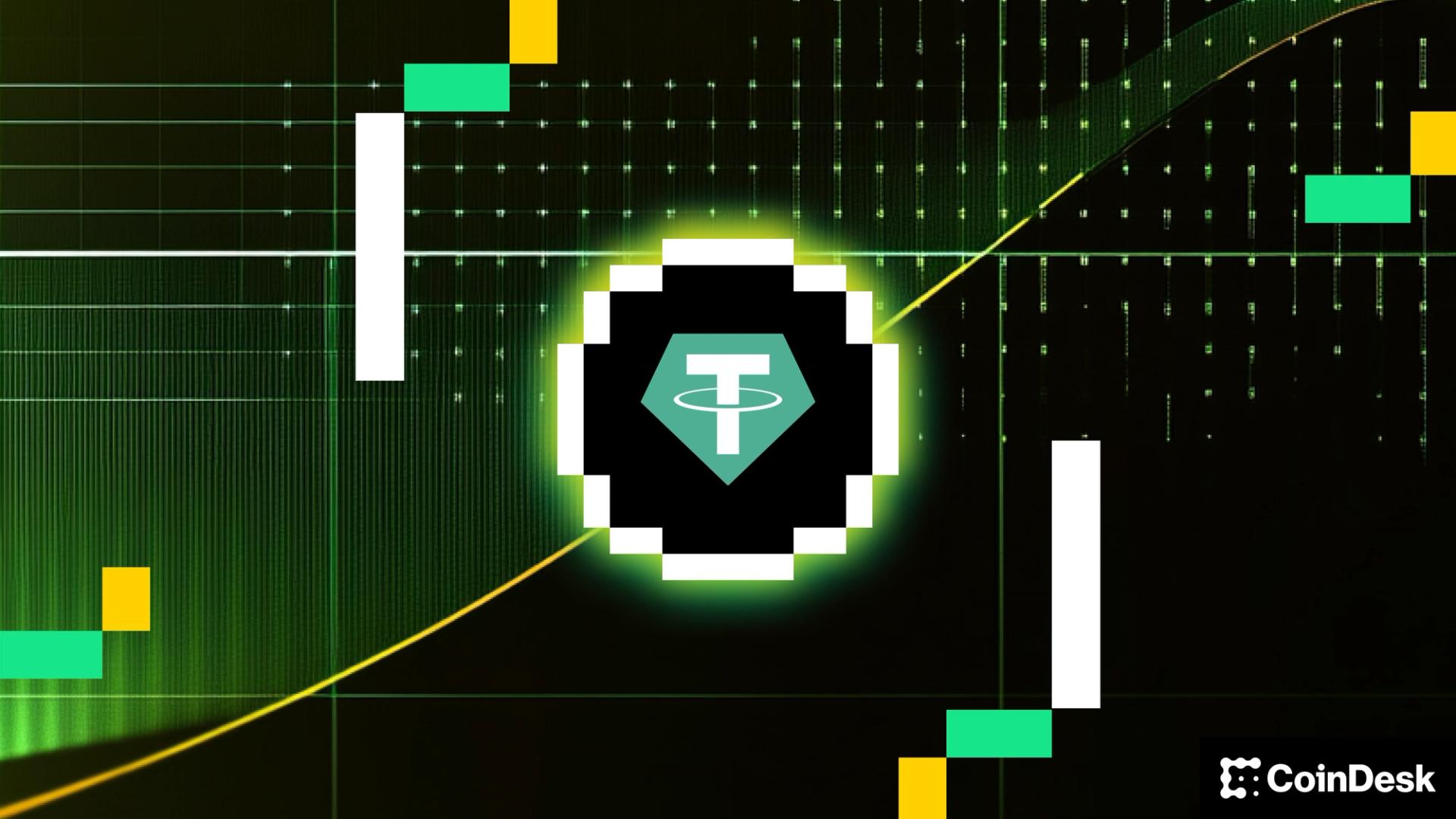
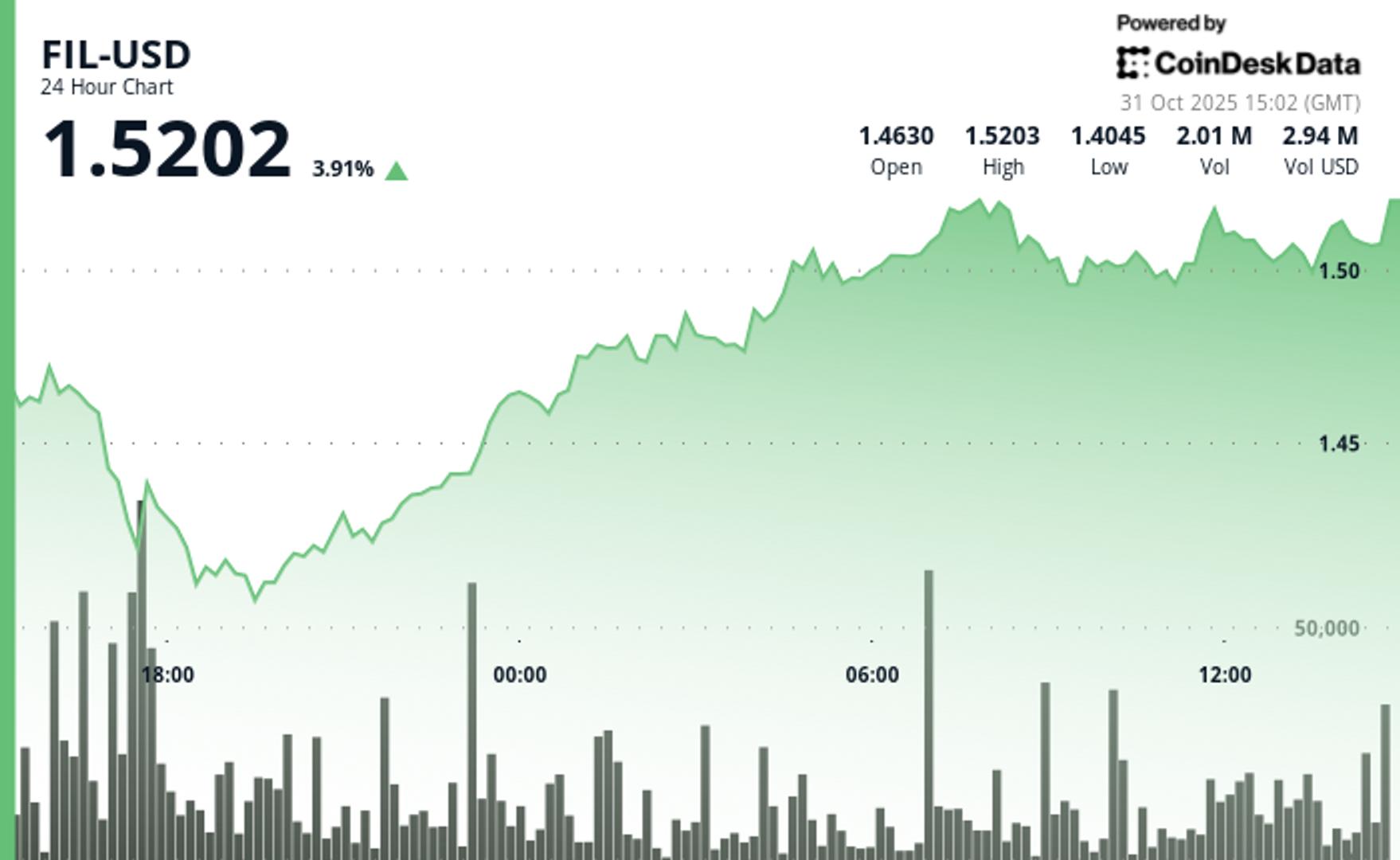

Galaxy Digital sold 1,531 BTC as Jump Crypto rotated $205M in Solana into Bitcoin, showing diverging institutional strategies.
The post Galaxy Digital sees 1,531 Bitcoin outflow amid market pressure appeared first on Crypto Briefing.

BitMine predicts a $2 trillion stablecoin market, highlighting Ethereums leading role in global blockchain finance.
The post BitMine forecasts $2 trillion stablecoin market driven by Ethereum growth appeared first on Crypto Briefing.

Steak 'n Shake's Bitcoin reserve strategy highlights growing corporate adoption of digital assets, potentially influencing industry trends.
The post Steak ‘n Shake creates strategic Bitcoin reserve appeared first on Crypto Briefing.

The ruling highlights the ongoing struggle for digital asset banks to gain equal access to traditional banking systems, impacting financial innovation.
The post Court rejects Custodia Bank’s appeal in fight over Federal Reserve master account appeared first on Crypto Briefing.

The government shutdown stalls financial regulatory progress, creating uncertainty and potentially delaying diversification in retirement investments.
The post US government shutdown hinders SEC’s 401(k) investment rule changes, says SEC’s Atkins appeared first on Crypto Briefing.

Square's Bitcoin incentive could accelerate crypto adoption in commerce, potentially reshaping payment systems and merchant-customer interactions.
The post Square offers $50 Bitcoin incentive to first 20,000 merchants participating in BTC conversions appeared first on Crypto Briefing.

This trend towards self-custody may signal growing distrust in centralized exchanges, potentially impacting market liquidity and stability.
The post Whales withdraw 2,000 Bitcoin worth $220M from Binance in 2 hours appeared first on Crypto Briefing.

The Dogecoin price has been experiencing severe volatility and extended periods of sideways trading in recent weeks. However, seasoned analysts suggest that there’s little reason to panic. Beneath the short-term turbulence lies a long-term structure that experts believe could set the stage for a major price breakout. They suggest that the broader technical picture paints a bullish narrative, one that could eventually drive DOGE above $1 once momentum resumes.
According to a technical analysis presented by crypto analyst EtherNasyonal on X social media this week, the Dogecoin price is preparing for a major bull run above $1. He explained that the DOGE’s price action remains within a powerful long-term Ascending Channel, maintaining structural integrity despite ongoing price fluctuations. His analysis of the monthly chart reveals that the meme coin has been establishing a multi-year accumulation base, similar to the patterns formed before its explosive rallies in 2017 and 2021.
EtherNasyonal highlights that momentum is quietly building above key support levels, indicating that the next expansion phase could be forming. The chart illustrates that Dogecoin, which has been trading within a rising parallel channel since 2014, is currently consolidating around the lower boundary near $0.18.

Historically, each time Dogecoin has completed a similar descending pattern within this structure, it has initiated a parabolic move upward. The previous breakout propelled the meme coin by several thousand percent, lifting it from fractions of a cent to all-time highs above $0.70.
Dogecoin’s current chart setup suggests a repeat of this bullish behavior. A large, rounded base pattern is visible between 2022 and 2024, reflecting steady accumulation and a potentially decreasing selling pressure. EtherNasyonal’s projection targets the upper midline of the Ascending Channel, potentially above $1, if historical patterns play out as expected.
On shorter timeframes, crypto analyst Trader Tardigrade provides additional context to Dogecoin’s current price action. His 4-hour chart highlights a “false breakout” followed by a “false breakdown.” Dogecoin initially broke above resistance near $0.206 but failed to hold, retracing sharply to retest the lower boundary around $0.178.
This quick reversal pattern, marked by aggressive selling followed by a swift rebound, often precedes a recovery move back toward former resistance levels. Trader Tardigrade’s chart structure indicates that the breakdown beneath the horizontal support level was short-lived, with buyers likely stepping in to absorb liquidity and push prices upward.
The chart setup suggests that DOGE could soon reclaim the $0.20 – $0.21 region as the next target zone from its current price of $0.18. If the bounce continues and momentum aligns with the broader monthly structure, this could serve as the first leg of a sustained uptrend.

What to Know:
The market cap for crypto fell below $3.59T on October 30, sparking concerns of a new crypto dip. However, for savvy buyers, it’s a chance to buy the best altcoins.
While Bitcoin is holding steady above $110K, the overall crypto market cap fell to $3.59T on October 30. It has since rebounded to $3.69T, adding $100B back into the crypto market.

One of the biggest losers during this decline was Pump.fun, which experienced a drop of over 20% from an intraweek high of $0.0053 to below $0.0042.
Sustaining above $110K will be key for Bitcoin to drive the broader recovery of the cryptocurrency market. If it does, we may have already seen the worst of the dip, but there’s still plenty of time to scoop up cheap crypto before the market returns to normal.
That’s why we’re taking a closer look at three altcoins we believe are undervalued at the moment. Let’s check out why PEPENODE ($PEPENODE), Bitcoin Hyper ($HYPER), and Chainlink ($LINK) are the current best altcoins to buy.
PEPENODE ($PEPENODE) is for everyone who wants to experience the feeling of building a crypto mining empire without needing the time and money required to make a real-world server farm. It’s a virtual crypto mining simulator with its own meme coin, $PEPENODE.
Servers you buy through the PEPENODE project are all stored on-chain and passively generate $PEPENODE over time. You can access them through your own customizable virtual server room through the PEPENODE game by an in-browser interface.
Each server node you buy adds to your overall hash rate, which generates passive $PEPENODE for you over time. More expensive servers offer a better hashing rate, but you’ll need to select the right combination to maximize your investment in $PEPENODE.

The $PEPENODE token keeps the game’s economy running. While you’ll want most of your $PEPENODE invested in servers to keep your hash rate high, if you need to cash out or upgrade your servers, you can sell your nodes for a return in $PEPENODE.
The more $PEPENODE you have invested, the better your returns will be. Investing from the start gives you an advantage over later players, and the best way to ensure you have enough $PEPENODE to spend on your first server farm is with the $PEPENODE presale.
Getting to the top of the PEPENODE leaderboards could reward you with airdrops in other meme coins, including $PEPE and $FARTCOIN.Any $PEPENODE purchased during the presale can be staked for rewards of up to 642% annually, significantly increasing your initial stack as soon as the game goes live. That’s why $PEPENODE has already raised over $2 million in presales, pushing the price to $0.0011272.
Join the PEPENODE project before the game goes live.
Bitcoin Hyper ($HYPER) is revolutionizing the way we perceive the Bitcoin network. It’s upgrading Bitcoin’s transaction speeds and lowering clearing fees with a Solana Virtual Machine (SVM) using zK rollups.
Buying Bitcoin is an excellent idea if you need a long-term investment asset that you won’t be trading frequently. However, if you want to make a time-sensitive $BTC transaction, you’re going to be paying excessive transaction fees – and you’ll still have to wait at least ten minutes.
However, Bitcoin Hyper aims to reduce transaction friction for Bitcoin to comparable levels with Ethereum and Solana. Instead of using Layer-1 for transactions, Bitcoin Hyper uses a separate Layer-2 with an SVM to temporarily record trades in a ledger.
These transactions are then written back to the Layer-1 when congestion is low, offloading pressure from the Bitcoin network. This Layer-2 also supports smart contracts, allowing you to use DeFi services, trade NFTs, and swap crypto with $BTC.

$HYPER is the lifeblood of the Bitcoin Hyper network. The official utility token grants you access to the Bitcoin DAO as well as exclusive features on select dApps running on the Bitcoin Hyper network.
Best of all, it reduces the fees you pay when trading crypto using Bitcoin Hyper, where you can vote on the project’s future.The $HYPER presale is still live, having raised over $25.3M in token presales. It’s now $0.013195 per token, but if you buy now, you can lock in up to 46% in staking rewards. We’ve put together a quick ‘How to Buy Bitcoin Hyper’ guide if you need more information.
Get your $HYPER tokens today and earn up to 49% in staking rewards.
$LINK is the native token of Chainlink, a decentralized oracle network that enables blockchain developers to build smart contracts that securely connect with external data sources.
Developing infrastructure for Web3 is very different from working with the rest of the internet. You can assume that the data sources you’re working with are verified on-chain and thus trustworthy, but that’s not true if the data you need to process comes from off-chain sources.
Chainlink solves this problem by providing tamper-proof information provided by a decentralized network. Each Chainlink operator runs nodes that can be asked for data by other blockchain programs. The node fetches the data from the internet, which is then presented back to the chain.
If the data provided is validated by the rest of the nodes in the network, the Chainlink operator is rewarded with $LINK.

$LINK is currently trading at $17.22, representing a 45% increase over the last year. Although October was a difficult month for $LINK, it remains the 13th largest cryptocurrency by market cap at $12 billion. Additional institutional investment into $LINK could see the token jump to over $20.
For example, JPMorgan completed its first inter-chain fund transfer this year after using Chainlink to facilitate a trade between its internal Kinexys blockchain and the Ondo Finance chain. News of this boosted the coin’s value by $4 in May 2025.You can purchase $LINK through any major CEX or DEX.
All crypto products are volatile. Be sure to always do your own research before investing – and only invest what you’re prepared to lose. This article is not financial advice.
Authored by Aaron Walker, NewsBTC – https://www.newsbtc.com/news/crypto-market-is-down-smart-money-buys-dip-best-altcoins/

Bitcoin mining is entering a new era in Japan, where it’s no longer viewed as an energy drain. The transformation is being spearheaded by Canaan (CAN), a forward-thinking initiative that integrates BTC mining into Japan’s renewable energy ecosystem to balance power demand and supply.
In an X post, crypto analyst TheGentleTraveler has shed light on a significant and innovative development at the intersection of Bitcoin mining and energy infrastructure. CAN (Canaan Inc.) has announced a 4.5 MW smart BTC mining deployment set to power Japan’s energy grid.
Related Reading: China’s Bitcoin Mining Isn’t Dead — It’s The World’s No. 3 Contributor
According to TheGentleTraveler, CAN has secured a 4.5 MW contract in Japan to deploy its advanced Avalon A1566HA hydro-cooled mining servers for power-grid load balancing and energy-efficiency optimization. The project, which runs in collaboration with a major Japanese utility, will use Canaan’s smart-control chip capable of dynamically adjusting frequency, hashrate, and voltage in real time. This flexibility helps to stabilize the grid amidst rising AI and residential power demand.
The GentleTraveler noted that this initiative reflects Canaan’s expanding strategic role, which combines BTC mining with renewable energy and AI infrastructure. Furthermore, it aligns seamlessly with Japan’s recent crypto-asset regulatory reforms. Canaan CEO Nangeng Zhang emphasized that this technology allows utilities to utilize BTC mining as a digital load balancer. Zhang confirmed that similar deployments have already been launched in the Netherlands, with further expansions planned for 2026.
Despite this groundbreaking news, CAN’s stock is currently down – 7% after the announcement. This short-term dip is attributed to a combination of the general weakness in the broader BTC sector and the At-The-Market (ATM) announced by Canaan last Friday.
A key observer in the Bitcoin landscape, GoMining, has stated that every block mined secures the network and strengthens BTC’s role in the modern economy. GoMining has highlighted several standout developments from the past week that collectively underscore this accelerating trend of institutional and sovereign adoption.
The expert first draws attention to the strategic actions of mining companies in the US, exemplified by American Bitcoin Corp boosting its reserves to 3,865 BTC. According to GoMining, this is proof that miners are not just securing the network; they are becoming long-term institutional holders. Meanwhile, France’s National Assembly has advanced a bill to create a national BTC reserve, a signal that sovereign adoption is moving from concept to policy.
Furthermore, GoMining explains that the public companies now collectively hold over $117 billion in BTC, representing a substantial 38% increase in Q3 alone. Such a surge indicates a growing trend where corporate balance sheets are becoming part of BTC’s security layer. GoMining concluded that every hash is a vote for an open institutional future.

Last updated on October 31, 2025
This Article Was First Published on The Bit Journal.
Binance QR payments have officially gone live in Argentina, giving verified users a new way to spend crypto on daily purchases. According to the source, customers can now scan a merchant’s interoperable QR code through the Binance Pay app, select their preferred cryptocurrency, and pay instantly.
The system automatically converts the crypto into Argentine pesos so merchants receive local currency directly. This development turns digital assets into real-world spending power.
The launch of Binance QR payments allows verified users in Argentina to make purchases with more than 100 supported cryptocurrencies, including Bitcoin (BTC), Ethereum (ETH), and Tether (USDT).
The feature connects with the country’s interoperable QR network, making it compatible with many merchants already using digital payment systems. According to the platform’s FAQ, this functionality is only available to individual users in Argentina.
There are spending limits to maintain compliance and stability. Each transaction can reach up to 1,500 USDT, while the total monthly cap is 5,000 USDT. Merchants do not need to manage wallets or worry about crypto volatility because all conversions to Argentine pesos are handled automatically by regulated local partners.
Users benefit from zero transaction fees and near-instant processing times. For a typical crypto holder, this means buying a coffee or clothing item can be as easy as sending a text message.
Binance QR Payments are essential for the crypto community as they connect trading and daily use. Argentina suffers from constant inflation and decreasing currency value, which has made crypto a great option for keeping one’s wealth. But with this project, the whole digital asset world is practically transformed into a convenient way to use that value in everyday life.
Merchants gain too. They receive pesos immediately without needing to understand blockchain or track crypto price swings. The system simplifies the process, removes friction, and helps small businesses tap into new customer bases who prefer digital currency.
Market analysts suggest this rollout could mark a new chapter for crypto adoption across Latin America. It highlights how digital assets can solve real-world problems rather than remain speculative instruments.
This streamlined process makes Binance QR payments faster and more practical than traditional banking systems, especially in economies with high transaction fees and currency instability.
The service currently operates only for verified users based in Argentina. Asset volatility still exists before conversion, but once the transaction occurs, the merchant is shielded from crypto price movements. Regulatory compliance and merchant adoption will determine how quickly this feature scales beyond Argentina.
With Binance QR payments, crypto is taking its first big step into Argentina’s mainstream payment scene. It turns digital coins into spendable money and shows how blockchain technology can fit into everyday life.
For crypto enthusiasts, this marks the start of a more usable, practical ecosystem where digital assets can be moved from wallets into real-world value.
Yes, users pay no extra transaction fees in Argentina.
More than 100 digital assets, including BTC, ETH, and USDT, are supported.
Each payment can reach 1,500 USDT, with a 5,000 USDT monthly limit.
Merchants receive Argentine pesos through a regulated payment partner.
No, it is currently limited to verified Argentine users.
Read More: Binance Turns Crypto Into Cash on the Spot with New QR Payments">Binance Turns Crypto Into Cash on the Spot with New QR Payments

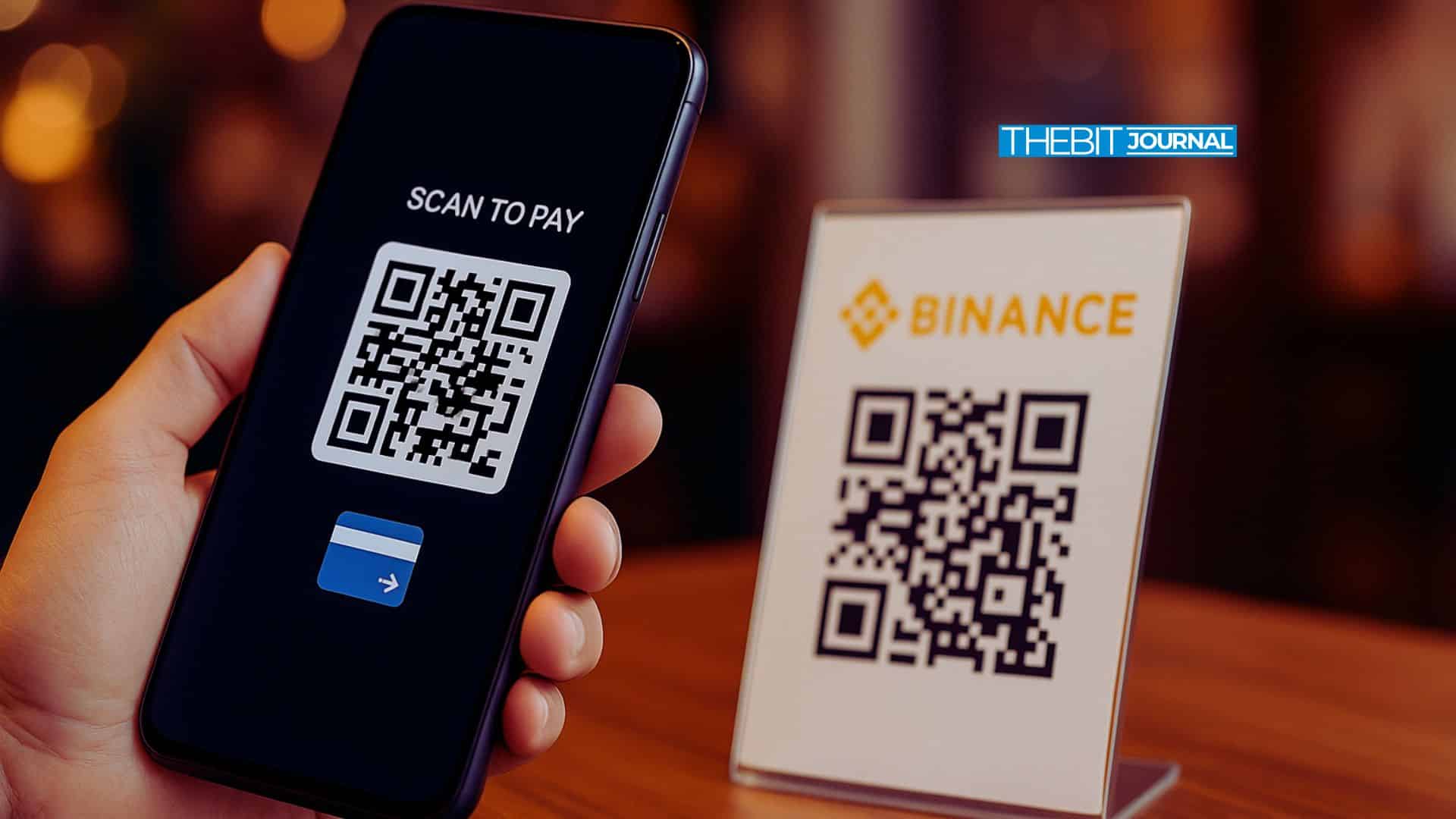
The Sui Name Service community woke up to a major announcement this week. The network’s identity protocol has launched a retroactive airdrop to reward its earliest active supporters.
The surprise drop, revealed on October 31, 2025, gives a governance boost to contributors who helped shape the platform’s foundation. This move marks a big step for Sui Name Service, showing how blockchain projects can reward real participation instead of speculation.
Early members of Sui Name Service are receiving staked NS tokens. These tokens represent both value and voting power. More than 7.6 million NS tokens have been distributed to 95,000 eligible addresses.
Also Read: SUI Price on the Edge: Could a 950% Rally Repeat Before 2026?
Recipients were chosen based on their voting activity between November 2024 and June 2025. The earlier and more consistent their participation, the higher their rewards. Unlike other airdrops, users do not need to claim anything. Tokens appear automatically in their accounts at vote.suins.io.
This eliminates gas costs and prevents phishing risks. The process also highlights Sui Name Service’s focus on safety and simplicity.
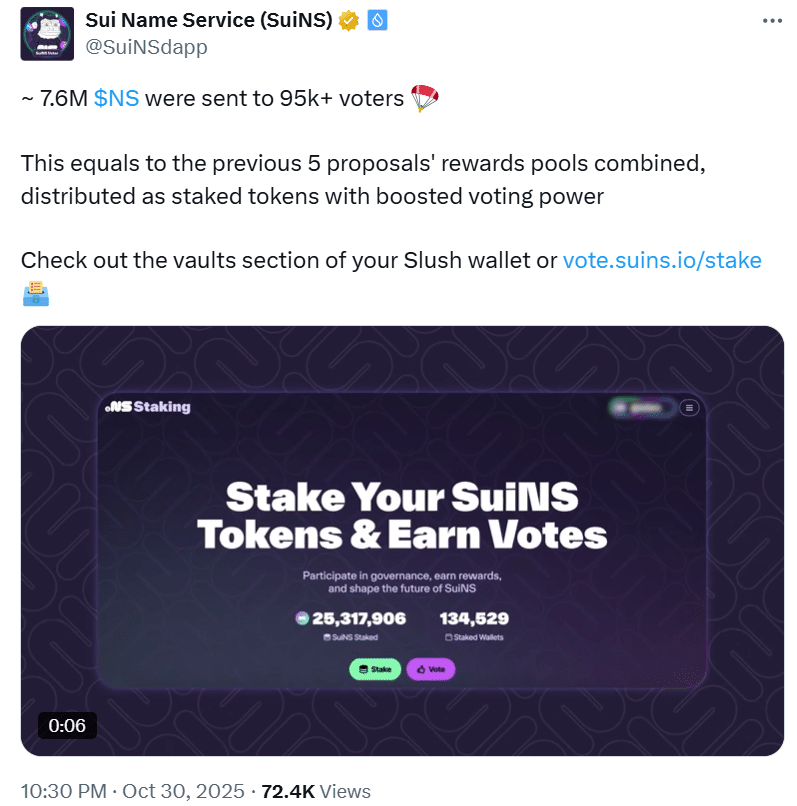
Sui Name Service is a key part of the Sui blockchain. It turns long wallet addresses into short, human-readable “.sui” names. Like domain names on the internet, these make blockchain use easier.
Its links identity, governance, and ownership in one system. It powers DAO voting, social profiles, and decentralized applications. With this new airdrop, Sui Name Service proves that on-chain identity can also carry real-world meaning and governance rights.
The retroactive airdrop celebrates those who helped guide the platform. Each participant’s allocation depends on how early and often they voted on SuiNS DAO proposals. Frequent and early contributors received more tokens.
This system encourages ongoing involvement in governance. It rewards loyalty and ensures that influence stays with those who have earned it through action. Sui Name Service wants governance to be meaningful, not just symbolic.
The Sui Name Service team eliminated all the barriers to claiming tokens. Users do not have to sign transactions or pay network fees. Tokens are shown directly in their wallets in staked form so that they’re ready for governance use.
This model makes user experience better and reduces the risk of scams. It also demonstrates the potential use of automation by blockchain projects to increase community trust. By integrating security and convenience, Sui Name Service has set the bar for airdrop execution.
Through this initiative, Sui Name Service would like to develop into a stronger decentralized organization. Voting power is now based on actual participation rather than token ownership. This means that future proposals will come from an engaged and experienced community.
By rewarding early contributors, the platform builds a cycle of engagement. The more members that vote, the more influence they have. Sui Name Service is taking DAO governance from being a one-time event to becoming an active, ongoing process.
The retroactive airdrop strengthens loyalty among early supporters. It sends a clear message that their work mattered. This recognition helps Sui Name Service maintain trust within its growing user base.
Such programs create a sense of belonging. Members feel seen, rewarded, and motivated to stay involved. In Web3, this sense of connection is as valuable as financial incentives.
Other blockchain projects may look to Sui Name Service as an example. By linking reputation and governance, it has created a balanced reward model. It proves that decentralized identity can drive engagement and accountability.
This airdrop goes beyond free tokens. It represents a new way to reward meaningful contributions in the Web3 ecosystem. The program could inspire similar approaches across DAOs and decentralized platforms.
Since its launch in 2024, Sui Name Service has become the main identity layer on the Sui blockchain. It integrates with SuiPlay, Cetus DEX, and other decentralized applications. The platform supports sub-name communities, staking incentives, and future domain auctions.
Is’s plans to connect digital identity with governance and reputation across the Sui network. The team says this airdrop is “only the beginning” of a broader mission to build a unified onchain identity system.
The Sui Name Service airdrop is more than a reward. It is a declaration of values. It proves that decentralized governance thrives when contributors are recognized and empowered. By distributing NS tokens to its most active members, it reinforces the core principles of transparency, fairness, and participation.
This event will likely stand as a defining example of how Web3 projects can combine innovation, community, and governance. For Sui Name Service, the future of decentralized identity looks stronger than ever.
Also Read: ETF Delays Hit Institutional Crypto Demand: Solana, Cardano, and Sui See Pullbacks
Sui Name Service – A decentralized naming system on the Sui blockchain that converts complex wallet addresses into simple “.sui” domains for easier use and identity recognition.
NS Tokens – The native governance tokens of Sui Name Service, used for voting, staking, and participating in DAO decisions.
Airdrop – A token distribution event rewarding users for their early participation or contribution to a blockchain project.
DAO – A community-led structure that makes decisions through blockchain-based voting rather than centralized control.
Staking – The process of locking up tokens to support the network and gain governance influence or rewards.
Sui Name Service (SNS) is a naming protocol on the Sui blockchain that converts wallet addresses into readable “.sui” names.
The airdrop rewards early governance participants with staked NS tokens that grant voting power.
About 7.6 million NS tokens were sent to 95,000 eligible wallets.
No. Tokens appear automatically at vote.suins.io with no claim steps or gas fees.
Read More: Sui Name Service Airdrop Rewards 95,000 Early Users with 7.6M NS Tokens">Sui Name Service Airdrop Rewards 95,000 Early Users with 7.6M NS Tokens

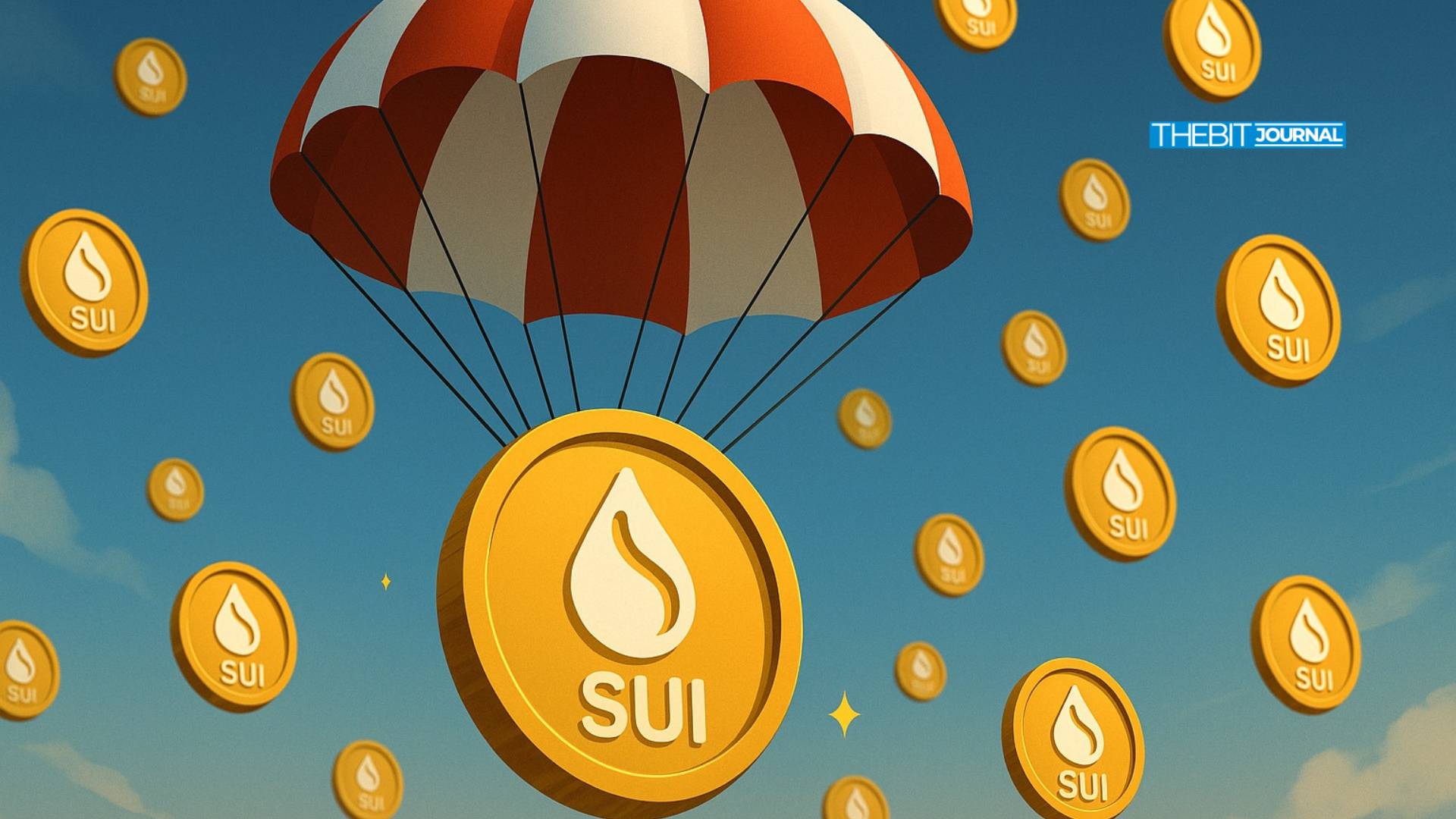
This article was first published on The Bit Journal.
Solana (SOL) exposure through exchange-traded funds is changing how investors access on-chain yield and how the network distributes power. Some ETFs don’t stake SOL at all, while others embed delegation and reward pass-through.
For years, the network encouraged native staking. Over two-thirds of circulating SOL was delegated to validators earning around 6% annual yield. Now, new ETF models risk changing that.
Solana has built a strong on-chain staking culture. More than 66% of its circulating supply is delegated, earning rewards from inflation plus transaction fees. This native model supports decentralization by distributing stake across many validators.
The arrival of ETFs offering SOL exposure, from U.S. stake-enabled funds like SSK (REX-Osprey) or BSOL (Bitwise), to Hong Kong’s non-staking spot product (e.g., ChinaAMC Solana ETF), is a big feat.
Some U.S.-stake-enabled ETFs delegate their holdings and pass rewards to investors, while other global spot funds don’t stake at all. For example, the Hong Kong product launched on October 27 doesn’t stake at all. Hence; Solana ETF staking is the key differentiator between fund models.
The key difference in Solana ETF staking lies in two models. Non-staking ETFs hold SOL passively and don’t delegate to validators. The Hong Kong spot product, for example, charges a 1.99% fee and provides exposure without taking rewards.
Investors in such funds miss out on the 6% yield native stakers earn; the fee drag effectively turns the yield negative versus holding SOL directly.
Staking-enabled funds delegate holdings and distribute net rewards. A fund like SSK might deliver 4.8% to 5.1% after expenses (0.75% fee plus custodian/validator costs) to shareholders.
Native staking mechanics also respond when ballots change. If large amounts of capital reside in non-staking funds, the fraction of supply being staked falls, raising per-staker APY.
With a circulating supply of 592.5M and a staked ratio 67%, a $1.5 billion non-staking AUM shift could push the staked ratio to 65.7% and APY from 6.06% to 6.18%.
Hence; the structure of ETF models directly interacts with on-chain yield and staking incentives.
While staking-enabled ETFs can pass yield to investors, they can also centralize control. Funds like SSK allow the custodian to assign validator delegations. If billions in SOL flow through a small number of custodians, Solana’s validator economics may tilt from “community-chosen, performance-based” to “institution-selected, fund-driven.”
That trend echoes what happened in the Ethereum ecosystem with initiatives like Lido. At one point, reports say it controlled 32% of staked ETH, raising centralization concerns.
Non-staking ETFs avoid the validator control issue entirely by not staking. But as staking-enabled funds grow, the governance and decentralization implications become more acute.
In effect, Solana ETF staking is far more than yield; it touches on network security and distribution of power. The difference between “just holding SOL” and “delegating through a fund” matters for how the chain evolves.
Solana’s ETF environment is not uniform. Globally, products differ in mandate, fee structure and staking policy. In Europe, ETPs like ASOL reinvest rewards but charge high fees (2.5%), reducing net yield.
In Canada, spot Solana ETFs with staking already exist. In the U.S., newer stake-enabled products (REX-Osprey SSK, Bitwise BSOL) position staking as a feature.
Meanwhile, in Hong Kong, the first spot Solana ETF deliberately excludes staking due to regulatory caution following prior incidents (e.g., staking-provider hacking) and hence emphasizes pure price exposure.
Thus, Solana ETF staking is embedded as a design choice: either traders want yield + stake (and accept fund/custodian model) or they want spot exposure only and forego staking return.
The international variation also provides a natural experiment. Will investor flows prefer yield-enabled vehicles or pure spot wrappers? And how will that preference influence Solana’s on-chain economics?
Given the mechanics and implications of Solana ETF staking, several variables stand out. Larger fund sizes could alter the staking ratio significantly, thereby nudging APYs. Also, if a handful of custodians control large delegations, decentralization metrics may shift.
Investors will compare what they get from ETF structures versus native staking options (such as liquid staking tokens). Regulatory clarity and product mandates; for example, Hong Kong’s exclusion of staking reflects how policy shapes product design.
Finally; as non-staking funds grow, native staking yields may rise, potentially pulling liquidity back on-chain. All of these factors determine how Solana’s staking economy will morph in the era of regulated exposure.
Through the lens of Solana ETF staking, investors are not just choosing exposure to SOL, but choosing how the chain’s economics and governance evolve.
Solana ETF staking is going to be a big theme in 2025. With funds launching under two models: non-staking spot wrappers and staking-enabled funds. The choice is not just about price exposure but yield, validator control and network dynamics.
Non-staking funds reduce yield for investors but potentially increase native APY for on-chain participants.
Staking-enabled funds pass through yield but bring governance and decentralization issues. As Solana’s regulated products expand globally, the choices made by issuers, custodians, and investors will impact how the chain works, how rewards are distributed, and how decentralized the network remains.
Solana ETF staking – A regulated Solana investment fund that holds SOL and delegates to validators, passing staking rewards to investors.
Non-staking ETF – A Solana fund that does not delegate SOL; offers only price exposure and forgoes staking income.
Delegation – The act of assigning SOL tokens to a validator node to help secure the network and earn rewards.
APY (Annual Percentage Yield) – The annualized return from staking; inflation and transaction fees for SOL token holders.
Validator concentration – When staking power is held by a few validators or custodians, it potentially impacts decentralization.
Liquid staking token (LST) – A tokenized representation of staked assets that allows users to maintain liquidity while earning staking yield.
A staking-enabled fund delegates SOL and distributes rewards, offers yield in addition to price exposure. A non-staking fund simply holds SOL without delegating, offers only price exposure and no yield.
Not necessarily. Staking funds may offer yield, but they include fees and custodial structures that reduce net gain. Investors must compare pass-through yield versus fees and compare to staking directly on-chain.
If large funds delegate through a few custodians or validators, control of network security and transaction ordering may concentrate. That could change decentralization and governance.
As non-staking funds grow, fewer tokens are staked on-chain, which increases APY for those who keep staking. That may attract native staking interest and create yield feedback.
Yes. The model determines yield, governance influence, exposure structure and long-term implications for network economics; not just token price.
Read More: Who Wins with Solana Staking ETFs? Investors or Large Validators?">Who Wins with Solana Staking ETFs? Investors or Large Validators?


The best meme coins are rewriting the rules of digital investing, turning laughter into serious profits. Recent headlines have crypto enthusiasts buzzing about BullZilla and La Culex, two projects showing incredible presale traction. Yet, a new contender is stomping onto the scene – MoonBull, whose presale Stage 5 is live and already creating major waves. This isn’t just another hype token; it’s a calculated shot at reshaping the meme economy.
Crypto investors who missed past moonshots like PEPE and BONK are now watching MoonBull presale closely. Early entrants are already seeing massive ROI potential thanks to its 23-stage structure. It’s a first-come, first-served frenzy where the bulls are running wild, and those ready to charge early might just grab their next 1000x opportunity.
MoonBull ($MOBU) isn’t just another meme project – it’s an ecosystem designed for sustainability, long-term value, and pure FOMO appeal. This Ethereum-based gem combines humor and hype with structured tokenomics and an incredible $MOBU presale model. The current Stage 5 price is $0.00006584, with over $500K raised and 1600 holders. Early participants are sitting pretty with over 9256% ROI potential from presale to listing.

The MoonBull presale follows a 23-stage roadmap where each step raises the price, fueling urgency and scarcity. For example, a $25,000 investment at Stage 5 could turn into over $2.3 million by the final stage – enough to make even the calmest trader’s tail twitch. This is where the best meme coins separate from the herd. MoonBull’s blend of real tokenomics, reflection rewards, and smart deflationary mechanisms gives it power far beyond hype.
The project’s 2% auto-liquidity injection, 2% reflections to holders, and 1% burn on every transaction keep the ecosystem roaring. Add to that a fully audited contract, locked liquidity, and transparent community governance launching at Stage 12 – MoonBull stands as a fortress among the best meme coins of 2025.
MoonBull also brings a jaw-dropping 95% APY staking system that starts at Stage 10. Holders can stake from the MoonBull dashboard, earn daily rewards, and still enjoy the freedom to unstake anytime. The staking pool – backed by 14.6 billion $MOBU – guarantees long-term sustainability. Imagine your $MOBU growing while you snooze; this is how real bulls build wealth in the meme jungle.
MoonBull’s referral system adds a community-driven boost. With 15% bonuses for both referrers and buyers, it fuels organic growth like wildfire. Every referral is instant – no waiting, no claiming, just pure token rain. These features make MoonBull more than hype; they make it the best meme coin to lead the 2025 bull run.
BullZilla is another beast making waves. Currently in its 8th Stage (Echoes of the Bull), priced at $0.00020573, the project has raised over $990K with 3300 token holders and 31 billion tokens sold. Its ROI from early stages sits around 3477.91%, a massive leap that’s got the crypto herd talking.
The presale has been a slow burn of bullish energy, with each phase climbing toward its listing price of $0.00527. For those who joined early, the returns are already eye-watering. However, with the next phase promising only a 3.24% price increase, late entrants may find smaller margins. Still, BullZilla’s disciplined structure and consistent growth place it among the best meme coins to monitor – though MoonBull’s stage-based scarcity model could soon outpace it in both speed and volume.
La Culex might sound like a small insect, but it’s buzzing loudly in the crypto swarm. Sitting in Stage 3 (Bug Spray Dip), it’s priced at $0.00002274, moving toward $0.00002458, with over $8000 raised so far. Its momentum is building gradually, appealing to investors who like getting in at the ground floor.
The charm lies in its quirky branding and community vibe. Still, its lower funding and smaller holder base mean it’s in the early stages of development. Compared to giants like BullZilla and MoonBull, it’s got potential but needs stronger tokenomics and larger liquidity to compete in the long race of best meme coins. For now, it remains a fun, speculative play, while MoonBull’s presale delivers real structure, stronger rewards, and greater upside.

Based on the latest research and market trends, BullZilla and La Culex have shown impressive growth, with one charging forward and the other just beginning to flap its wings. Yet both projects pale beside MoonBull, whose dynamic presale stages, robust community rewards, and Ethereum-based security position it as the most exciting of the best meme coins heading into 2025. Its blend of sustainability and high-velocity ROI potential puts it in a league of its own.
MoonBull has become the talk of the town, and for good reason. With the $MOBU presale live at Stage 5, a 95% APY staking program, and rewards that could make early backers financial legends, the opportunity is roaring. The clock is ticking, the bulls are charging, and this might just be the second chance at a life-changing moonshot. Jump in before the herd stampedes past – MoonBull isn’t just another meme coin; it’s the movement redefining crypto freedom.

For More Information:
Website: Visit the Official MOBU Website
Telegram: Join the MOBU Telegram Channel
Twitter: Follow MOBU ON X (Formerly Twitter)
Among the current presales, MoonBull ($MOBU) shines brightest. Its 23-stage structure, transparent roadmap, and community-driven model make it the most promising investment opportunity of 2025. Early participants benefit from the lowest prices and rising demand across each stage.
Based on its presale momentum and deflationary tokenomics, MoonBull has the highest potential to explode in 2025. Its staking rewards, liquidity lock, and community governance ensure it’s built for both hype and long-term sustainability.
For investors seeking real returns rather than short-term noise, MoonBull is currently the best meme coin to invest in. With its audited contract, structured growth model, and staking APY of 95%, it’s designed to deliver both stability and excitement in equal measure.
MoonBull ($MOBU) is one of the rare meme coins with genuine 1000x potential. Its presale’s exponential stage-based increase and smart scarcity model allow early buyers to multiply gains significantly as prices rise toward launch.
Reaching $1 is a dream target in the meme world, but projects with deflationary supply and strong liquidity mechanisms stand the best chance. MoonBull fits this profile perfectly, combining community strength and strategic burns to sustain long-term growth.
MoonBull, BullZilla, and La Culex represent the new wave of meme coins driving 2025’s crypto excitement. While BullZilla charges ahead and La Culex buzzes with potential, MoonBull steals the spotlight with its 23-stage presale, 95% APY staking, and powerful tokenomics. It combines humor, strategy, and scarcity to deliver a balanced yet thrilling opportunity. For those who missed past moonshots, MoonBull could be the comeback ticket to crypto glory.
This article is for informational purposes only and does not constitute financial advice. Cryptocurrency investments carry risks. Always conduct independent research before investing in any project.
Read More: MoonBull ($MOBU) Gains Traction Among the Best Meme Coins of 2025 with BullZilla ($BZIL) and La Culex ($CULEX)">MoonBull ($MOBU) Gains Traction Among the Best Meme Coins of 2025 with BullZilla ($BZIL) and La Culex ($CULEX)


Armada Acquisition Corp. has officially debuted on Nasdaq under the ticker symbol XRPN. This XRPN Nasdaq debut marks a major milestone for the platform’s strategic transformation into a leading institutional XRP digital asset treasury company.
According to official reports, XRPN focuses on institutional-grade XRP exposure, targeting institutional investors with a $1 billion strategy. The project aims to attract institutional capital and drive adoption of XRP-linked financial products.
Notably, Armada Acquisition Corp has made its Nasdaq debut after collaborating with Evernorth Holdings. With over $1 billion in gross proceeds secured for open-market purchases, Evernorth is poised to drive institutional adoption of XRP, according to Michael Arrington, founder of Arrington Capital and chairman of Armada. “As longtime supporters of XRP, we believe Evernorth will drive meaningful shareholder value and solidify XRP’s place in the evolving digital asset economy,” Arrington said.
As the Ripple token’s price exceeded $2.60, the company’s XRP treasury valuation has reached over $1 billion. This positioned the company for its public market launch under the ticker symbol XRPN.
The XRPN Nasdaq debut announcement read, “Representing a key milestone in the company’s strategic transformation, this change underscores the company’s evolution into the world’s leading institutional XRP digital asset treasury company.”
The company, supported by Arrington XRP Capital Fund, has changed its ticker symbols to reflect its XRP focus, with Class A shares now trading as “XRPN,” units as “XRPNU,” and warrants as “XRPNW,” effective October 30. In an official post, Evernorth noted,
“Evernorth has signed a business combination agreement with Armada Acquisition Corp II, which is now trading on the Nasdaq under the ticker XRPN…A major step toward bringing institutional-scale adoption to XRP and building the next generation of on-chain digital asset treasuries. The journey starts NOW.”
Earlier this week, Asheesh Birla, the CEO of Evernorth, announced the company’s plans to go public under the ticker XRPN. He added that global leaders like Ripple, Pantera Capital, SBI, Kraken, and Arrington Capital support the XRPN Nasdaq debut. One of the key players who backs the development is the Ripple co-founder, Chris Larsen.
The CEO highlighted a shift in crypto adoption, emphasizing that access, trust, and transparency will drive the next wave, rather than hype. He described Evernorth as a publicly traded XRP treasury with a unique approach: not only holding XRP, but actively growing its holdings to deliver long-term value.
According to Birla, the company plans to reinvest its treasury revenue into acquiring more XRP, aiming to compound long-term value for shareholders. This XRPN Nasdaq debut marks just the beginning, as the company seeks to offer public markets and institutional investors a straightforward, regulated, and liquid way to access XRP. The strategy is designed to drive shareholder returns while promoting the adoption and utility of XRP, aligning with the growth of the XRP ecosystem. He stated,
“We’ve built an incredible team of leaders from crypto, capital markets and finance… people who’ve been at the forefront of innovation, regulation and risk management for years. Together, we’re committed to building something enduring for the long term.”
In conclusion, the XRPN Nasdaq debut marks a significant milestone in the company’s mission to drive institutional adoption of XRP, providing a regulated and liquid platform for investors to access the digital asset. With a $1 billion strategy and backing from industry leaders, the company is poised to play a key role in the growth of the XRP ecosystem.
Read More: XRPN Nasdaq Debut Marks $1B XRP Treasury Drive">XRPN Nasdaq Debut Marks $1B XRP Treasury Drive



As October ends without an SEC decision on the pending XRP ETF applications, a new potential launch timeline for the products is now on the horizon. For context, the final decision deadlines for the XRP ETF applications submitted by Grayscale, 21Shares, Bitwise, and Canary Capital were scheduled for October 18, 19, 22, and 23, respectively.

Dogecoin is showing similarity with its first full bull cycle, and a full mirror could send the meme coin surging to unprecedented prices. October ends today, and Dogecoin is deep in the red.

Bitcoin Magazine
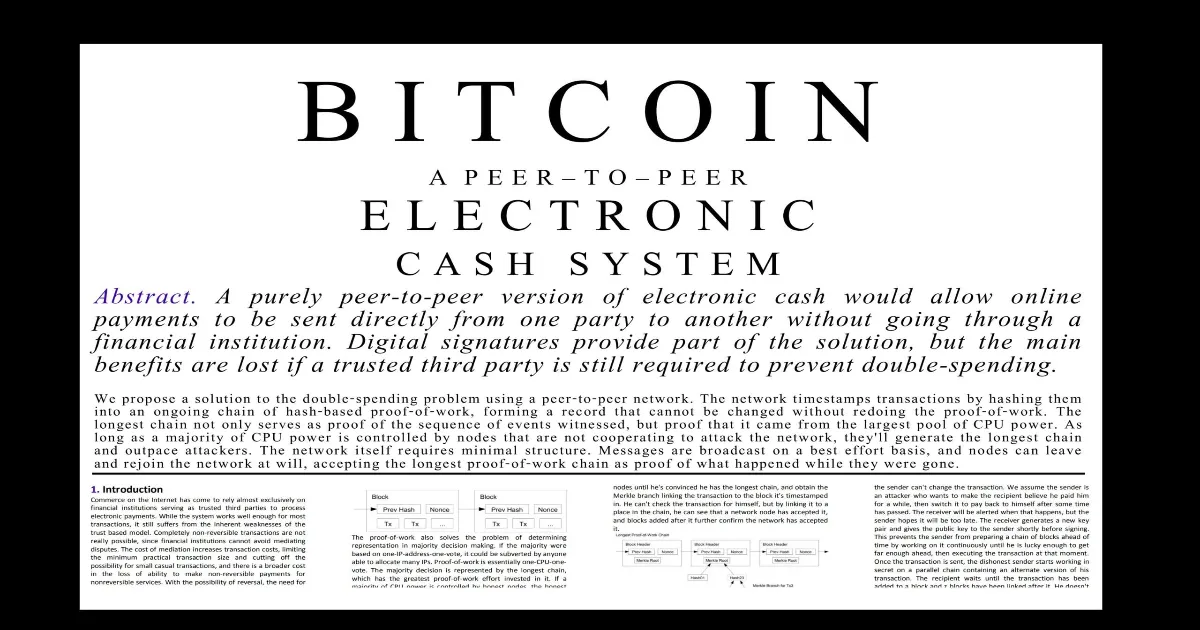
What Has Bitcoin Become 17 Years After Satoshi Nakamoto Published The Whitepaper?
Today marks seventeen years since Satoshi Nakamoto’s publication of the Bitcoin Whitepaper on the cryptography mailing list in 2008. Back then Bitcoin was nothing more than a proposal for a new niche technology, the latest in a long lineage of niche technologies created by the cypherpunks of the 1990s.
Bitcoin has gone through many massive transformations since that day 17 years ago. It went from a niche internet collectible, to a decentralized network powering illegal dark net markets, to a mainstream speculative investment for retail, to Wall Street and governments all over the world’s favorite new asset class. We have all had front row seats to the first explosive global technological revolution to the internet, and it’s been a wild ride.
On this anniversary I think it’s important to touch on a concept that is very relevant, POSIWID, or the Purpose Of A System Is What It Does. The basic idea is that when you have a complex system, it is pointless to try to define it based on what you want it to do, what really matters is what the pieces of that complex system are actually doing. That is all that matters at the end of the day.
We have once again found ourselves in a time period where people are calling back to the whitepaper as a placeholder for some kind of founding document, or definition, or blueprint. The whitepaper is none of those things. It is simply a high level abstract explanation of a Proof-of-Work blockchain being used to implement a digital currency. It is the idea of a cart with wheels, versus the actual blueprint of the cart (the source code).
Bitcoiners seem to periodically fixate on the whitepaper in this manner, and inevitably use that as a justification for acting antagonistic towards some use case or idea of improving Bitcoin that they disagree with. Maybe we will eventually get past this, maybe we won’t, but it is an unhealthy attitude to have towards such a potentially impactful technology such as Bitcoin.
People didn’t recite the writings and speeches of Alexander Graham Bell when digital modems were invented to allow the first tendrils of the early internet to reach out between devices and facilitate digital signals flowing between them. They embraced it as a valuable technological innovation, and in the world today that dynamic has completely inverted itself. Most telephonic signals are now actually conveyed by communication mediums specifically constructed for digital communications.
Telephone networks were used to bootstrap the digital medium of the modern internet in a way that Alexander Graham Bell might have had only the barest inklings of, reshaping the entire world in ways that would have been impossible to conceive for people of his generation.
Satoshi did not give us a founding document to be shackled and constrained by when he released the whitepaper, he gave us a high level description of the software that followed.
That is the actual gift he gave us, the software. And he gave it to us completely freely, open-source, to do with what we decide to do.
“BitDNS users might be completely liberal about adding any large data features since relatively few domain registrars are needed, while Bitcoin users might get increasingly tyrannical about limiting the size of the chain so it’s easy for lots of users and small devices.” -Satoshi Nakamoto, 2010
This quote is always brought up in the context of the blocksize limit, or Bitcoin enabling multiple functionalities, but the thing that has always stood out the most to me is “users might get.” In the end before his disappearance, Satoshi is clearly being explicitly deferential to the wishes of users, and in the context of a critical and foundational decision like the blocksize limit.
Bitcoin isn’t Satoshi’s anymore, it’s ours, and collectively with how we actually use our bitcoin, we decide what the purpose of the system is. It’s important to remember that.
This post What Has Bitcoin Become 17 Years After Satoshi Nakamoto Published The Whitepaper? first appeared on Bitcoin Magazine and is written by Shinobi.
Bitcoin Magazine

Prenetics Spends $11 Million to Add 100 Bitcoin to Treasury
Prenetics Global Limited (NASDAQ: PRE) announced the purchase of 100 bitcoin at an average price of $109,594, expanding its total holdings to 378 BTC — valued at roughly $41 million.
The move comes just days after the health sciences company completed a $44 million equity offering that was oversubscribed by strategic investors including Kraken, Exodus, GPTX by Jihan Wu, XtalPi, DL Holdings, and tennis champion Aryna Sabalenka.
“This 100 Bitcoin acquisition demonstrates our immediate execution on the strategic vision we outlined to investors,” said CEO Danny Yeung, highlighting Prenetics’ dual focus on scaling its wellness brand IM8 and building long-term value through bitcoin accumulation.
Following the acquisition and equity raise, Prenetics holds $127 million in total liquidity with no debt—$86 million in cash and $41 million in bitcoin. The company continues to purchase one bitcoin per day, supplementing that with opportunistic larger buys.
Yeung noted that IM8 has reached $100 million in annual recurring revenue in just 11 months, calling it the fastest growth in the supplement industry’s history. Prenetics aims to expand IM8 globally while strengthening its bitcoin treasury as a core balance sheet asset.
For context, Prenetics made headlines earlier this year by becoming the first healthcare firm to implement a Bitcoin treasury strategy. The company initially purchased $20 million worth of BTC, acquiring 187.42 coins at an average price of $106,712, with plans to allocate the majority of its $117 million balance sheet to Bitcoin.
Since then, Prenetics has executed a disciplined accumulation plan, purchasing roughly one bitcoin per day since August 1, 2025, and now holds about 275 BTC, valued at $31 million as of late October.
The strategy is part of a broader effort to combine its fast-growing supplement brand, IM8 — which reached $100 million ARR in under a year — with long-term cryptocurrency holdings.
The company has also strengthened its leadership and advisory team, appointing former OKEx COO Andy Cheung to the board and engaging industry experts from Kraken and TOKEN2049.
The firm’s dual focus on health supplements and Bitcoin accumulation underscores its ambition to reach $1 billion in annual revenue alongside $1 billion in Bitcoin holdings over the next five years, highlighting the growing intersection of healthcare and cryptocurrency innovation.
Back in 2024, former footballer David Beckham became a strategic investor in Prenetics and co-founded IM8, citing his focus on advanced consumer health products.
Beckham also engaged with shareholder Professor Dennis Lo, learning about his pioneering prenatal testing work and early cancer detection focus, reinforcing the potential impact of Prenetics’ innovations on global health.
This post Prenetics Spends $11 Million to Add 100 Bitcoin to Treasury first appeared on Bitcoin Magazine and is written by Micah Zimmerman.

Toncoin price has surged, fueled by strong adoption news and strategic technological integrations, with Chainlink playing a central role in expanding TON’s reach across the blockchain ecosystem.
The cryptocurrency has seen a notable uptick, driven by both real-world utility developments and enhanced cross-chain capabilities.
A key driver behind TON’s recent performance is its adoption of Chainlink’s Cross-Chain Interoperability Protocol (CCIP) and Data Streams.
.@ton_blockchain, the L1 bringing Web3 to Telegram’s 900M+ users, is adopting Chainlink CCIP as the canonical cross-chain infrastructure for its native token TON, making it a Cross-Chain Token (CCT) to be transferable across leading blockchains.https://t.co/4hnmUOptun
TON is… pic.twitter.com/95DIHLpGu2
— Chainlink (@chainlink) October 31, 2025
This move positions TON as a Cross-Chain Token (CCT), allowing seamless transfers of Toncoin across more than 60 leading blockchain networks.
Beyond facilitating token mobility, Chainlink’s Data Streams provide low-latency, real-time market data, enabling developers to build advanced decentralised finance (DeFi) applications with institutional-grade reliability.
The integration addresses a longstanding challenge for TON: liquidity fragmentation.
By connecting TON to the broader multi-chain ecosystem, Chainlink helps create a composable, interoperable environment where assets, protocols, and liquidity can flow freely between chains.
This expansion also opens opportunities for developers to attract capital from Ethereum, Solana, and other ecosystems, elevating TON beyond a niche within the Telegram network into a serious contender in the multi-chain DeFi landscape.
The total value locked (TVL) growth on TON-based decentralised exchanges such as STON.fi and Dedust will serve as key indicators of how effectively the integration translates into tangible network activity and economic impact.
Another key driver of the current Toncoin surge is the launch of Binance-Telegram QR payments, a fee-free system currently active in Argentina.
This integration allows users to spend Toncoin directly via QR codes while merchants receive pesos instantly.
With Telegram boasting over 1 billion users globally, this adoption represents a significant step in bridging cryptocurrency with real-world transactions.
In countries facing high inflation, such as Argentina, this kind of utility makes TON particularly attractive as a payment alternative.
Market observers are keenly watching adoption metrics in Argentina, as well as potential expansion into other regions with similar economic dynamics, including Turkey and Nigeria.
This integration not only increases TON’s real-world utility but also strengthens its position as Telegram’s default blockchain, a factor likely to sustain demand over the medium term.
If usage of TON for payments grows consistently, it could translate into higher stability and further price appreciation, potentially pushing Toncoin beyond its current resistance levels.
Toncoin price recently broke through the $2.25 resistance, reaching a high of $2.28, signalling strong technical momentum.
While short-term traders have responded to this breakout, trading volume has slightly decreased, dipping to $209 million, raising questions about the sustainability of the rally.
Despite this, the MACD histogram has turned positive, and the price remains above the 7-day moving average, suggesting a healthy short-term trend.

Market analysts have identified the next potential resistance at $2.36, with targets as high as $3 if trading volume picks up.
In the longer term, Toncoin could even reach $5.30, particularly if adoption of TON in real-world payment systems expands and the Telegram ecosystem continues to support innovative blockchain features.
With November approaching, historical data indicate that TON often posts positive monthly performance, adding further optimism to its trajectory.
The post Toncoin price rallies as Chainlink extends CCIP and data streams to TON appeared first on CoinJournal.

Bittensor’s TAO token has experienced a sharp rise, climbing double digits to hover just shy of the $500 psychological barrier.
The TAO price had hit an intraday high of $490 at the time of writing.
The move has driven TAO to the top of daily gainers lists, surpassing even privacy-focused coins like Zcash, which had jumped 15% in 24 hours.
The latest catalyst for TAO’s ascent traces directly to institutional advancements.
In particular, as analysts continue to ponder whether the decentralized AI project has the potential to flourish into the Nvidia of crypto. More on this later.
More of the latest gains for TAO come after the October 29 announcement of the world’s first staked Bittensor Exchange Traded Product (ETP).
Deutsche Digital Assets and Safello launched the ETP, which went live as fresh digital asset investment product hype resurfaced.
Bittensor’s growing network and the ETP rollout seem to have come just at the right time for the project- hence TAO’s price gains.
Secured by BitGo Europe and domiciled in Liechtenstein, the product bridges traditional finance with decentralized AI, potentially unlocking billions in European institutional capital previously sidelined by regulatory hurdles.
TAO’s price outlook is predominantly bullish. That’s despite it being tempered by inherent crypto volatility and macroeconomic headwinds in the short term.
A sustained close above $500 could catalyse a breakout to $700.
These are the highs seen in December 2024, and above that, bulls will be targeting a new all-time high.
In March 2024, bulls reached the all-time peak of $767.
Crypto analyst Dread Bongo shared this outlook about the token.
This top band on $TAO should act like a magnet here..
– Broken out of year long downtrend
– First ever #Bittensor Halving in 40 days
– Subnet products going live
– Major ecosystem upgrades coming
– Alpha's bottomed out
– Huge subnet partnerships and developmentsPeople are now… pic.twitter.com/rH9hJwPGcY
— DREAD BONGO (@DreadBong0) October 31, 2025
Data from CoinGecko shows that the artificial intelligence token category is marginally lower, with a 1.2% dip in total market capitalisation.
Top AI-linked cryptocurrencies such as NEAR Protocol, Internet Computer, Story, and Render have posted 24-hour gains of 2–4%.
Bittensor (TAO), however, has outperformed the group, surging 18% in the past day to maintain its position as the largest AI token by market cap at $4.69 billion.
The rally in Bittensor comes amid renewed investor enthusiasm for artificial intelligence, fueled by gains in AI-focused equities following recent developments from Nvidia and Microsoft.
Yet as investment in Bittensor funds further validates traction, whale accumulation and halving sentiment may be huge catalysts to watch.
The post Bittensor price pops 18% to lead top gainers: what next for TAO? appeared first on CoinJournal.

Presale crypto projects often generate excitement, but many fail to deliver meaningful user experiences.
Fragmented chains, high fees, and complex DeFi infrastructure can stall adoption and engagement.
In 2025, the next potential big presale crypto is Mono Protocol, which has quickly captured attention by addressing these challenges.
Its Stage 15 presale focuses on utility-based features that unify token balances across networks, provide instant execution, and simplify blockchain interactions.
By combining transparency, MEV-resilient execution, and easy developer integration, Mono Protocol highlights why some presale ICOs succeed where others falter.
With the presale launched and early participants actively engaging, it offers a real-world example of how thoughtful Web3 design drives both adoption and retention.
Mono Protocol is a chain-abstraction protocol that unifies per-token balances across networks and delivers instant, MEV-resilient execution.
By stripping out the complexity that undermines user acquisition and retention, it allows developers to focus on building apps that just work.
There is no need to construct cross-chain logic or infrastructure.
This presale crypto 2025 project lets teams ship products faster while lowering costs.
Users benefit from monetizable network effects and streamlined interactions.
Stage 15 of the Mono Protocol presale saw strong momentum, with the current token price at $0.0450, offering potential gains near 1011% at a projected launch price of $0.500.
Recent updates included the Smart Contract Audit on October 30, the Launch Beta on November 7, and the CEO AMA scheduled for November 13.
Participants can engage with social, referral, and presale quests to earn bonus $MONO and unique promo codes in the Rewards Hub.
DeepSnitch ($DSNT) has raised over $480K, aiming to give traders access to insights previously reserved for whales.
Its five AI engines run continuously, tracking market shifts, whale transfers, and suspicious contract activity.
The presale crypto enables users to anticipate trends without relying on slow, manual analysis.
By providing automated, data-driven intelligence, DeepSnitch demonstrates how presale crypto projects in 2025 are leveraging Web3 and blockchain innovations to solve practical problems.
Early participants gain a first-mover advantage in accessing AI-enhanced trading strategies while learning how DeFi analytics can level the playing field for smaller investors.
Nexchain combines Proof-of-Stake with AI-driven systems to deliver faster, more stable blockchain performance.
Its hybrid consensus improves network speed, scalability, and adaptability while maintaining decentralization.
Between October 13 and November 28, the presale crypto offers a 100% token bonus using the code TESTNET2.0.
Nexchain has surpassed $11.35 million raised at a token price of $0.112.
Projects like this illustrate how presale ICOs in 2025 are integrating intelligent technology to optimize DeFi networks and provide users with more predictable, reliable experiences.
BlockchainFX (BFX) is another standout presale crypto project, with over $10.4M raised and more than 15,000 participants.
The token price is $0.029, with a confirmed launch at $0.05.
Analysts anticipate a long-term price of $1 if adoption continues at this pace.
BlockchainFX is designed as a trading-focused platform within Web3, demonstrating how presale crypto 2025 initiatives can provide structured investment opportunities and early-stage access to community-first tools.
MoonBull ($MOBU) prioritizes fairness and user security.
Built on Ethereum, it protects small investors from whale manipulation while rewarding early supporters through automated liquidity, holder reflections, and consistent burns.
Its referral system grants 15% bonus tokens to both referrer and invitee, with monthly USDC rewards for top participants.
APY staking unlocks at Stage 10, offering both yield and long-term engagement incentives.
MoonBull demonstrates how presale ICOs in 2025 can integrate tokenomics and community mechanisms to build trust and sustainable growth.
The presale crypto landscape in 2025 is increasingly focused on projects that solve real Web3 and DeFi problems.
Mono Protocol leads this movement with utility-focused design, instant execution, and simplified multi-chain management.
Alongside projects like DeepSnitch, Nexchain, BlockchainFX, and MoonBull, it shows how thoughtful tokenomics, developer-friendly infrastructure, and user-centric experiences define the next wave of successful crypto presales.
As the market grows, investors and participants are evaluating projects not only on hype but on tangible benefits, transparency, and potential for long-term engagement.
These presale crypto projects illustrate the shift toward meaningful innovation and practical solutions in blockchain.
Learn more about Mono Protocol:
Website: https://monoprotocol.com/
X: https://x.com/mono_protocol
Telegram: https://t.me/monoprotocol_official
LinkedIn: https://www.linkedin.com/company/monoprotocol/
The post Top 5 presale crypto projects 2025: why Mono Protocol leads a new era of utility-based tokens appeared first on CoinJournal.

The Zcash price has defied the broader crypto market downturn, soaring to new heights and capturing global attention.
The ZEC price just surged to an eight-year high, marking one of the strongest rallies among major privacy coins this year.
With growing investor interest, celebrity endorsements, and accelerating adoption of privacy technologies, Zcash has reemerged as a powerful force in the cryptocurrency market.
Zcash (ZEC) has skyrocketed 89% over the past two weeks, hitting a new all-time high (ATH) of $388 and flipping Monero (XMR) to become the most valuable privacy-focused cryptocurrency.
At a market capitalisation of around $6.2 billion, Zcash now stands as the leading altcoin in the privacy sector.
Notably, the surge in the ZEC price reflects a wave of renewed demand for privacy coins amid rising global concerns about data surveillance and financial transparency.
Over 4.5 million ZEC, roughly 28% of the total supply, are now held in shielded addresses using Zcash’s zk-SNARK privacy protocol.

This milestone marks the highest level of private holdings since 2021, signalling increased trust and usage of ZEC’s privacy technology.
Shielded coins tend to remain off exchanges longer, reducing liquid supply and adding upward pressure to the Zcash price.
Besides the privacy coins demand, a significant percentage of the excitement surrounding the ZEC token can also be traced to high-profile endorsements.
Renowned investor Naval Ravikant described Zcash as “insurance against Bitcoin” in early October, triggering a massive 60% daily price jump.
Soon after, Helius co-founder Mert Mumtaz floated a $1,000 target, while BitMEX co-founder Arthur Hayes predicted that the ZEC price could rise to $10,000.
Each endorsement fueled further gains and drew new investors to the privacy coin sector.
The rally has also been amplified by an influx of short liquidations.
In the past two weeks alone, ZEC futures recorded approximately $65 million in liquidations — more than half from short positions.
This created a classic short squeeze, forcing bearish traders to close positions as prices climbed higher.
Retail investors followed suit, with Google search trends for “Zcash” spiking in late October as fear of missing out (FOMO) took hold.
The feedback loop between short liquidations and rising retail demand has propelled the ZEC token into one of the most dramatic recoveries of 2025.
From a technical perspective, Zcash remains in a strong position but faces short-term risks.
The ZEC price trades well above its 7-day simple moving average of $332.01 and its 200-day exponential moving average near $96.68.
Indicators such as the Relative Strength Index (RSI) and MACD point to strong bullish momentum, though both are approaching overbought levels.
The current $370–$400 zone represents a critical resistance area, and a sustained breakout could set the stage for a move toward $450.
However, chart analysts have identified a rising wedge pattern — typically a precursor to corrections — that could lead to a 30% pullback toward the $260–$270 support range if momentum weakens.

The immediate support level to watch is $304.32, according to CoinLore’s analysis, which, if breached, could lead to a further decline to the next support level at $296.96, and further to the $260–$270 support range.
But despite these technical warning signs, market sentiment remains overwhelmingly positive.
Zcash’s +900% year-to-date rally demonstrates deep investor conviction and a structural shift in the market’s perception of privacy coins.
While whales have taken partial profits, on-chain data shows that the number of ZEC holders has surged by more than 60% in the past week, underscoring continued retail participation.
The post Zcash price hits new all-time high: how high can the ZEC price climb? appeared first on CoinJournal.

Venezuela is preparing to merge its struggling traditional banking system with digital currencies as payment giant Conexus plans to integrate Bitcoin and stablecoins into the national banking infrastructure.
The move, expected to launch in December 2025, marks a significant step in the country’s financial transformation, offering Venezuelans a regulated channel for cryptocurrency use.
With the bolivar’s persistent depreciation and rising adoption of stablecoins, this development could make Venezuela one of the first nations to formally blend fiat and crypto operations under a unified system.
The integration also reflects Venezuela’s long-standing struggle with international sanctions that have limited access to global banking.
By adopting blockchain-based systems, Conexus aims to provide citizens with a more resilient alternative that can facilitate remittances, domestic transfers, and business payments without heavy dependence on foreign intermediaries and unstable local exchange rates.
The initiative also seeks to improve financial inclusion nationwide, making digital transactions more accessible to individuals and businesses across the country.
Conexus, which currently processes nearly 40% of Venezuela’s electronic transactions, is leading this shift by allowing local banks to offer direct crypto services such as custody, transfers, and fiat conversion for Bitcoin and stablecoins.
The integration seeks to make digital currency access seamless for customers within their regular bank accounts, eliminating the need for external wallets or apps.
The new infrastructure will be built on blockchain technology to enhance transparency and transaction security.
According to the company, the system will enable both individuals and businesses to move between digital and traditional currencies safely, reducing reliance on unregulated exchanges.
Years of hyperinflation have eroded confidence in the bolivar, pushing Venezuelans to rely heavily on stablecoins like Tether (USDT) as a store of value and medium of exchange.
From small retailers to freelancers, many now prefer stablecoins to protect earnings from volatility.
Conexus President Rodolfo Gasparri has highlighted that this surge in stablecoin transactions demonstrates a clear public demand for better integration between crypto and banking systems.
The company’s upcoming model aims to formalise this reality by providing regulated access to crypto within Venezuela’s financial framework, allowing citizens to transact and save using digital assets with greater confidence.
The Conexus initiative could reshape not only Venezuela’s financial sector but also set an example for other economies facing currency crises.
By offering a direct bridge between fiat and digital assets, the model could help millions gain access to stable, low-cost, and transparent financial services.
Venezuela’s attempt to merge traditional finance with blockchain technology aligns with global trends toward digitalisation of money, particularly in regions where economic instability drives innovation.
If implemented successfully, this system could serve as a prototype for countries in Latin America and beyond, where inflation and limited banking access continue to affect economic stability.
The post Venezuela to integrate Bitcoin and stablecoins into its banking network by December appeared first on CoinJournal.

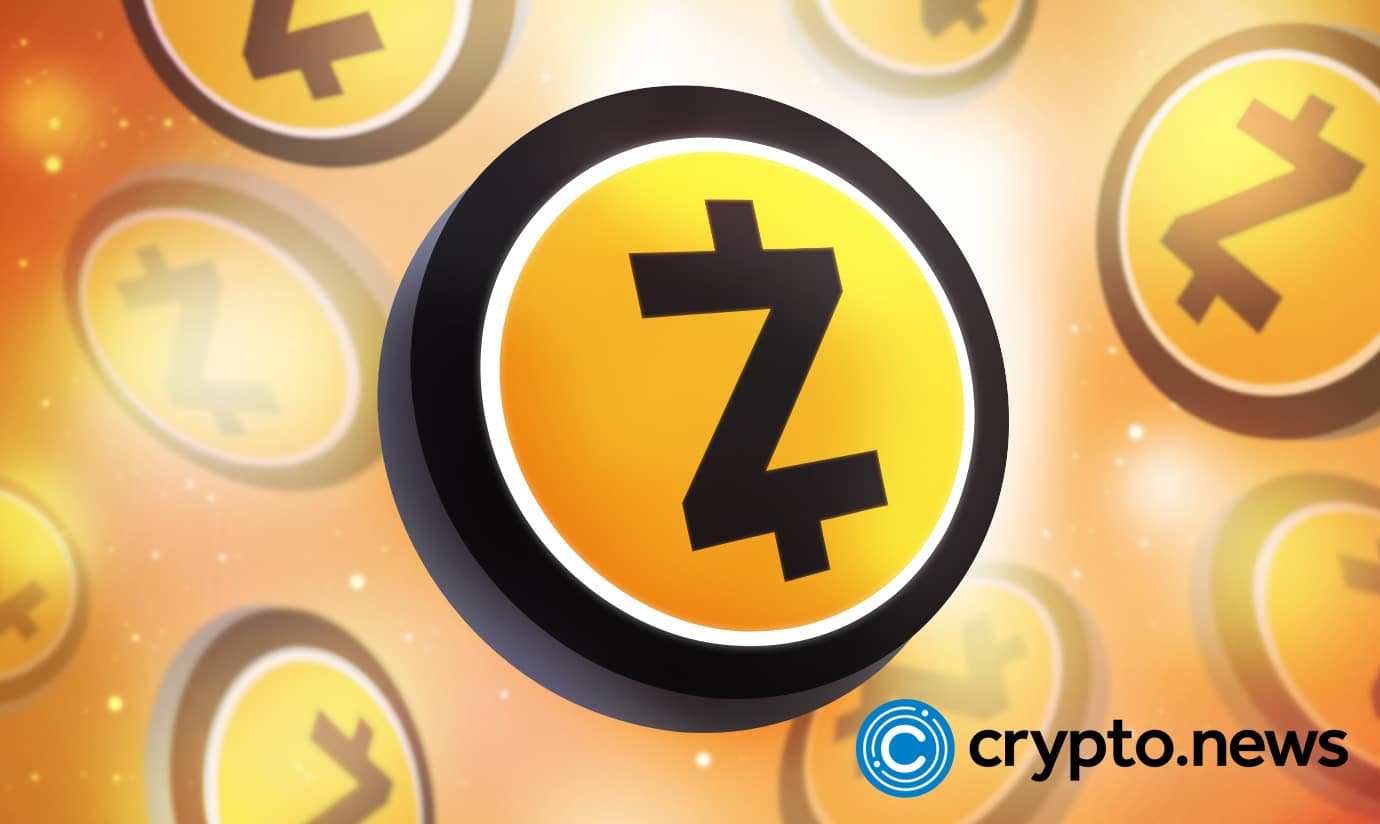


The post XRP, DOGE, and SHIB Forecasts Are Heating Up—But Ozak AI Leads the List appeared first on Coinpedia Fintech News
Crypto markets are entering an explosive segment as altcoins gain momentum across the board. XRP, Dogecoin, and Shiba Inu are leading the price with bullish forecasts and renewed investor excitement. XRP represents institutional utility, DOGE captures retail-driven meme power, and SHIB blends community hype with tokenomics evolution.
Yet, whilst these popular assets warm up, one name is unexpectedly taking center stage amongst whales and early traders—Ozak AI. With its AI-powered basis and presale price of simply $0.012, Ozak AI is being called one of the most promising early-level tokens of 2025.
XRP is presently trading around $2.62, with its chart displaying a clear bullish shape. Resistance levels are forming near $3.10, $4.20, and $5.00, even as strong support sits at $2.20, $1.90, and $1.60.
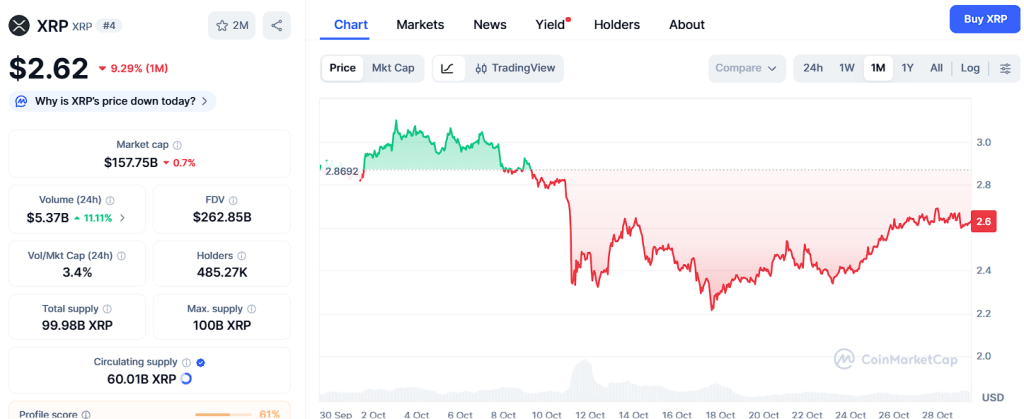
With growing adoption for cross-border payments and developing institutional trust, XRP is still one of the few properties that combine essential application with robust technical momentum. Its long-term outlook remains stable, and analysts count on a breakout past $3 if present momentum is sustained.
Dogecoin is trading around $0.194, building a bullish sample in advance of what might be another retail-fueled run. Resistance levels are located at $0.225, $0.265, and $0.300, whilst key support zones lie at $0.185, $0.162, and $0.140.
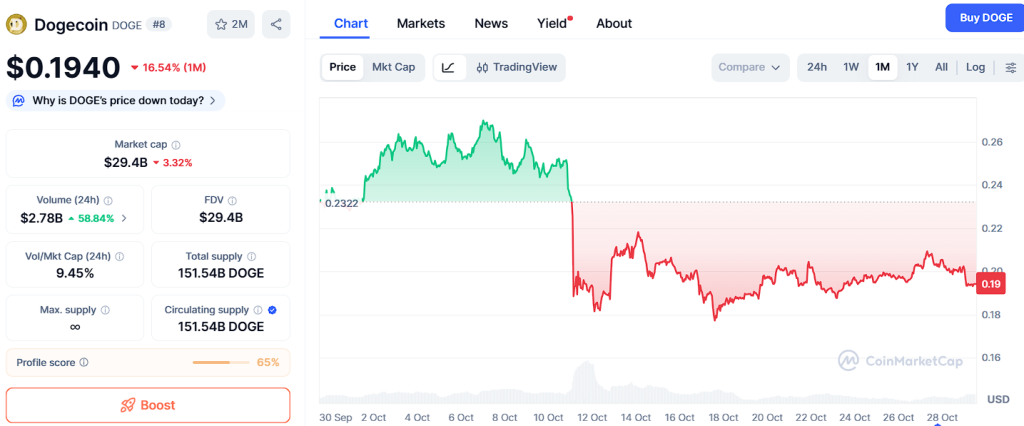
DOGE continues to dominate social sentiment and often acts as a main indicator of retail enthusiasm all through bull runs. Its simple branding, big community, and established music report make it a reliable meme asset for buyers looking for short-term momentum and robust liquidity.
Shiba Inu is holding steady near $0.00001014 and showing signs of accumulation. Resistance levels are forming at $0.00001120, $0.00001250, and $0.00001400, with support at $0.00000950, $0.00000880, and $0.00000800.

SHIB remains one of the most popular meme coins globally, backed by a passionate community and deflationary mechanics through its token burn initiatives. If retail energy spikes during the bull market, SHIB could easily replicate its historical performance and deliver double- or triple-digit returns for holders.
While XRP, DOGE, and SHIB continue to attract attention, Ozak AI is quickly emerging as the breakout project leading the next narrative wave. Currently in its 6th OZ presale stage at $0.012, Ozak AI has raised over $4.2 million and sold more than 980 million tokens.
Youtube embed:
Its unique AI-powered prediction agents are designed to give traders real-time insights, intelligent forecasts, and automated trading strategies—bringing tangible utility to the blockchain world. This makes Ozak AI not just another speculative token but a technology-driven platform positioned at the intersection of crypto and artificial intelligence.

Ozak AI’s momentum is further supported by key partnerships with Perceptron Network, HIVE, and SINT. These collaborations enhance its AI accuracy, scalability, and data processing capabilities, while ensuring the project remains technically competitive. Unlike meme coins that rely purely on community hype, Ozak AI offers a clear roadmap, sustainable development, and early access pricing—all ingredients for potential exponential growth post-launch.
XRP’s strong fundamentals, DOGE’s meme-driven momentum, and SHIB’s community-driven power ensure all three remain top-tier plays this cycle. However, Ozak AI stands apart as the token with the most upside potential. Its combination of utility, early entry, and AI innovation makes it a standout project for investors seeking 50x to 100x returns.
As the 2025 bull run continues to build, XRP, DOGE, and SHIB will dominate headlines—but Ozak AI is likely to dominate results. For those looking beyond hype and into high-growth opportunities, Ozak AI could be the token that defines the next chapter of crypto success.
About Ozak AI
Ozak AI is a blockchain-based crypto innovation that gives a tech platform that makes a specialty of predictive AI and superior information analytics for economic markets. Through the machine learning algorithms and decentralized network technologies, Ozak AI permits real-time, accurate, and actionable insights to assist crypto enthusiasts and companies in making the perfect decisions.
For more, visit:
Website: https://ozak.ai/
Telegram: https://t.me/OzakAGI
Twitter: https://x.com/ozakagi
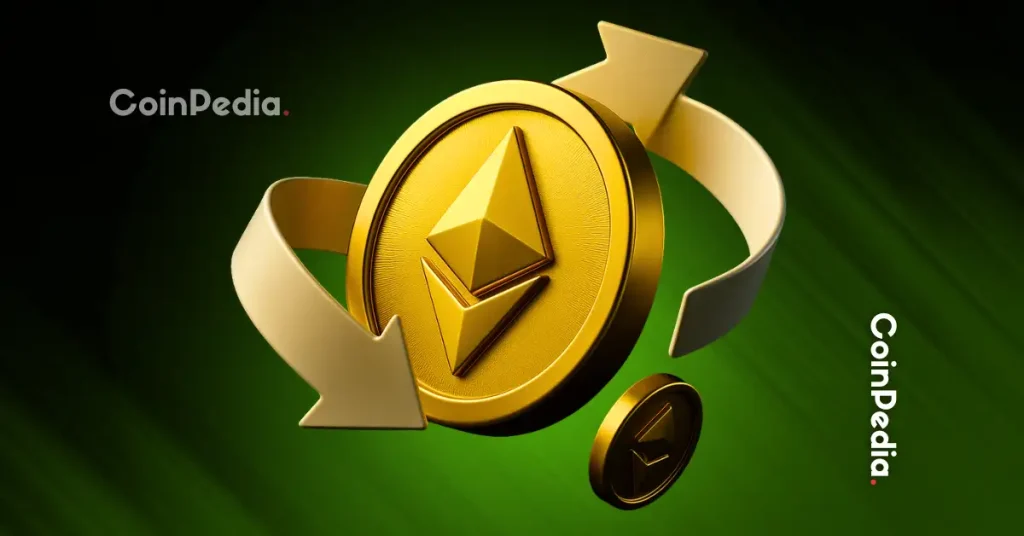
The post Ethereum Price Prediction 2025: On-Chain Activity Hints ETH Eyeing $5,600 appeared first on Coinpedia Fintech News
The Ethereum price prediction 2025 narrative is heating up again, as the second-top crypto faces intense short positioning. On-chain analysts suggest this shorting is increasing market fear. This setup is evident, as it creates opportunities for the upside, as the market does the opposite of what bearish expectations would suggest.
This is historically evident in the funding rates chart. Similar setups in the past have preceded major ETH price bounces. The Ethereum price today hovers near $3,850. Both on-chain and technical data suggest a growing bullish divergence. This divergence could fuel an explosive recovery rally.
Over the past two months, according to Santiment Insights data, the funding rate has become a critical indicator for predicting the next direction of the Ethereum price USD across exchanges.
Historically, when the market tilts too heavily toward long positions, corrections follow. Conversely, when shorts dominate, prices often stage a rebound. This seems to be happening in recent times.
Currently, Ethereum is witnessing a surge in short positions across major exchanges, signaling that traders are betting on further downside.
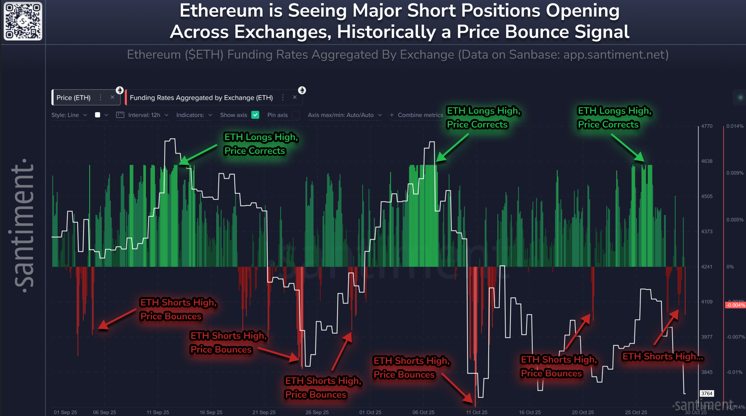
However, such periods of extreme bearish sentiment often mark the end of corrections and the beginning of recoveries. The Ethereum price chart shows ETH price is consolidating near $3,850 after a pullback from recent highs, while funding rates indicate a rising likelihood of short liquidations, which could be a classic precursor to a relief rally.
This setup has positioned Ethereum crypto for what some call a “historic bounce signal,” as exchanges remain poised to liquidate excessive bearish bets, potentially triggering a swift move higher.
On-chain data from CryptoQuant analyst further strengthens the bullish outlook for Ethereum price prediction 2025. According to recent metrics, a divergence has emerged in the Market Value to Realized Value (MVRV) ratio between staked ETH and circulating ETH.
According to the analyst research conducted this week, the MVRV for circulating supply was at 1.5, while staked ETH was little bit higher at 1.7, indicating approximately 20% greater unrealized gains for staking holders. This reflected that stronger conviction among validators, who are less likely to sell and more likely to hold through volatility.
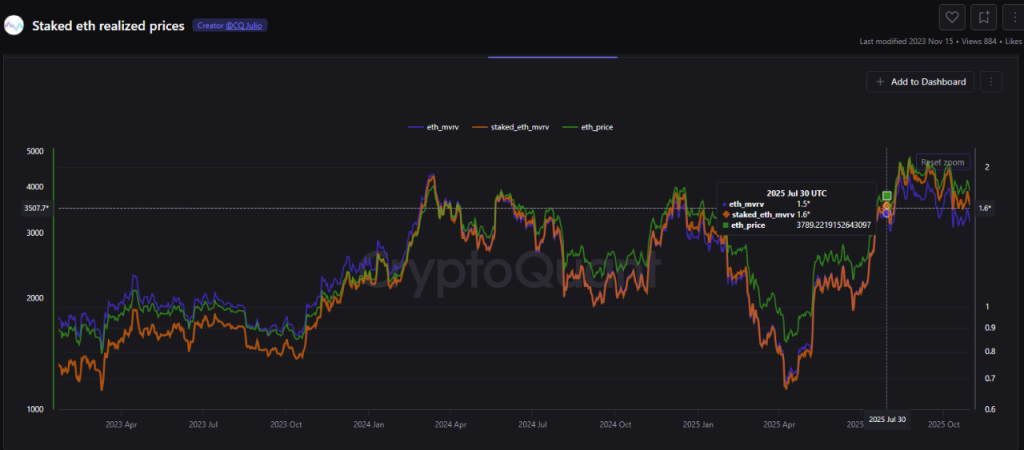
The analyst mentions that, Currently, 36.1 million ETH are staked out of 121.12 million ETH in circulation. This steady rise in staked coins underscores a maturing network foundation. Meanwhile, Ethereum’s burn mechanism continues to offset inflation, balancing supply and demand dynamics.
This gap in MVRV highlights a “healthy” market structure as long-term stakers provide ecosystem stability, while liquid ETH maintains moderate profit zones that prevent speculative overheating.
From a technical perspective, Ethereum price forecast suggests ETH is testing a crucial weekly support zone that could serve as the springboard for a year-end rally.
If this level holds, the next potential upside target sits near $5,600, aligning with both structural resistance and historical rebound patterns.
If that happens, the nearest target appears to be most likely hit before the year ends, which also coincides with the upper boundary of a rising parallel channel.
The growing divergence between short-term fear and long-term conviction paints a compelling picture for the coming months.
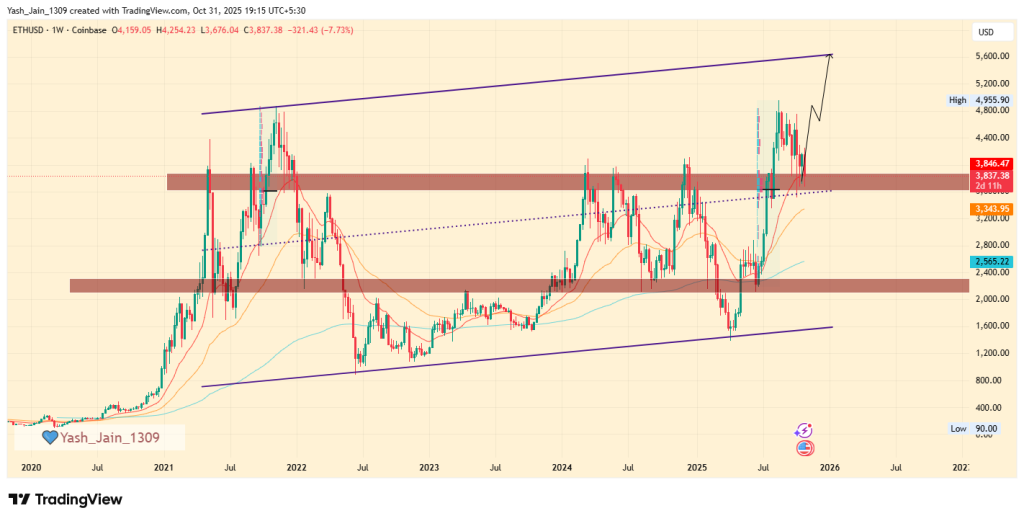
Should market sentiment shift and short positions begin to unwind, Ethereum price USD could see an accelerated breakout toward higher ranges as liquidity floods back in.
In summary, the current blend of short positioning, on-chain stability, and technical resilience creates a favorable environment for Ethereum’s next major move, reinforcing optimism in the Ethereum price prediction 2025 outlook.

The post Top Crypto to Watch in 2025: This Token Under $0.003 Offers Bigger Upside Than Bitcoin, Ethereum, XRP, and Every Other Top 10 Coin appeared first on Coinpedia Fintech News
Little Pepe (LILPEPE) has completed several rounds of presale, which has garnered attention, as stage development, capital raised, and community momentum are strong indicators of high initial demand. It has now drawn attention and is tagged the top cryptocurrency to watch in 2025 for its bigger potential than Bitcoin, Ethereum, and other top 10 cryptocurrencies.
Momentum matters in crypto markets, and the raw numbers behind LILPEPE are hard to ignore. The project is priced in its current presale stage at $0.0022, with organizers and multiple market outlets reporting that the campaign is roughly 96% complete for Stage 13 and that more than $27.3 million has been raised across stages so far. Over 16.5 billion tokens have reportedly changed hands in the presale to date, leaving a relatively small remaining allocation in the current stage, a dynamic that tends to create scarcity-driven interest ahead of listing.
When mainstream, high-market-cap coins already trade at double- and triple-digit billions in valuation, a token available at a sliver of a cent naturally offers a different risk-return profile. For the same percentage gain that would move Bitcoin from $110k to $220k, a sub-$0.003 token needs only a fraction of the absolute capital appreciation to generate life-changing multiples for early backers. LILPEPE’s presale trajectory, from early rounds around $0.001 to the current $0.0022, illustrates how staged price increases can translate into rapid paper gains for early entrants when momentum accelerates.
Beyond headline numbers, the narrative driving sustainable upside is utility. LILPEPE positions itself as a meme-themed token built on Ethereum-compatible Layer 2 infrastructure, promising fast, low-fee transactions alongside features such as staking, rewards, and an ecosystem that includes NFTs and a proposed meme launchpad. Such a mixture moves it out of all pure speculation and into the utility-oriented meme asset category, which has historically drawn retail interest as well as developer interest when implemented according to the roadmap. Reports also note that the project completed a security audit, a factor that helps institutional and cautious retail players take part in presales with more confidence.
Community activation remains a primary driver of token velocity. LILPEPE’s presale campaign has been accompanied by a series of large giveaways and promotional efforts that amplify awareness across social channels, drawing in new wallets and increasing on-chain distribution. The staged presale design funnels demand into discrete pricing windows; when a stage nears full subscription, the implied next-stage price increase creates urgency. This interplay between marketing, scarcity, and incremental pricing has been visible in the presale’s fast sell-through rates.
Bitcoin, Ethereum, and other top-10 cryptocurrencies are large-cap coins with an enduring reputation, and although limited, their continued upside is generally tied to macro adoption and institutional flows. Meanwhile, Little Pepe delivers a much higher beta to speculative interest: small absolute inflows can produce outsized percentage moves. For investors willing to accept higher volatility, that asymmetry can translate into returns that beat those possible from any of the top-10 coins.
Bullish cases must acknowledge the binary nature of early crypto projects. The elements that could validate LILPEPE’s upside include a clean token launch on reputable exchanges, real-world or on-chain usage of its Layer 2 features, transparent treasury and tokenomics execution, and sustained community engagement beyond giveaways. Conversely, listing delays, poor liquidity management, or unmet roadmap commitments would materially reduce upside and could trigger rapid downside. Prospective participants often watch liquidity depth at listing, auditor statements, and observable token distribution on-chain as the most immediate signals post-presale.
Little Pepe’s presale performance in 2025 places it among the most prominent high-beta opportunities in the market: a token priced under $0.003, moving through a near-sellout presale stage, backed by reported multi-million-dollar funding and a utility-oriented roadmap. For investors who seek asymmetric returns and accept elevated risk, that profile offers the theoretical potential to outperform much larger, more established coins.
For more information about Little Pepe (LILPEPE) visit the links below:
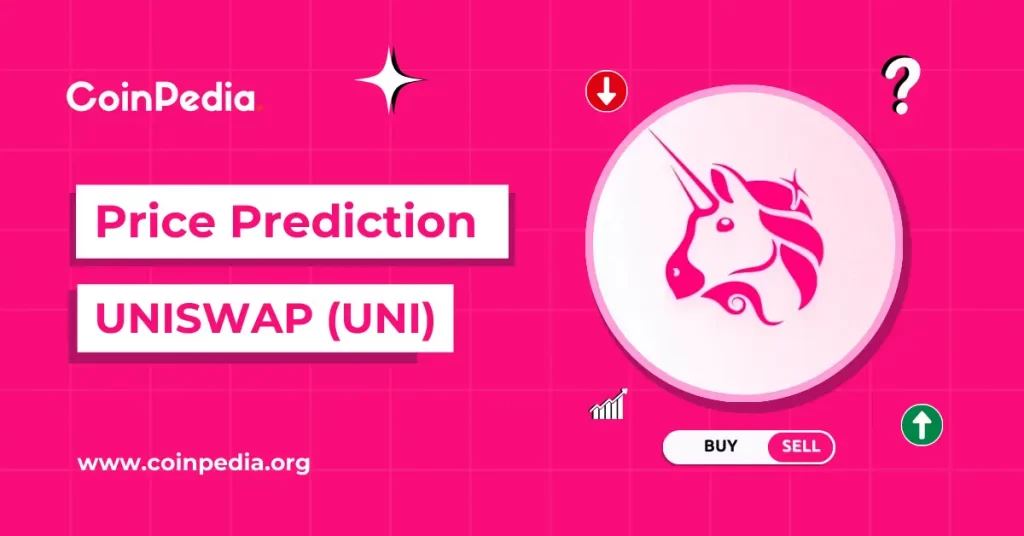
The post Uniswap Price Prediction 2025, 2026 – 2030: Is Uniswap a Good Investment? appeared first on Coinpedia Fintech News
Uniswap is one of the most active and liquid decentralized exchanges. Layer 2 adoption is fueling its growth, with nearly $40 billion in protocol volume this month from Arbitrum, Unichain, and Base. Unichain alone came close to $12 billion in volume.
The recent proposal from the Uniswap Foundation, seeks DAO approval to form a Wyoming-based nonprofit called “DUNI.” This move would give the DAO legal recognition, reduce regulatory risks, and open doors for upgrades such as protocol fee activation.
| Cryptocurrency | Uniswap |
| Token | UNI |
| Price | $5.7459
|
| Market Cap | $ 3,621,817,041.74 |
| 24h Volume | $ 249,794,507.3961 |
| Circulating Supply | 630,330,527.71 |
| Total Supply | 1,000,000,000.00 |
| All-Time High | $ 44.9741 on 03 May 2021 |
| All-Time Low | $ 0.4190 on 17 September 2020 |

Uniswap (UNI) is trading near $5.77, remaining below the 20-day SMA at $7.448. Technicals indicate:
With more than $7 billion locked, Uniswap ranks second only to PancakeSwap in DEX trading. Key drivers ahead include V4’s advancements, Unichain’s scalability, and potential fee-sharing opportunities. If market conditions remain supportive, Uniswap is well placed to strengthen its lead in DeFi and deliver more value to its ecosystem.
In an optimistic scenario, UNI price could chug up to a maximum of $16.91. That being said, regular buying and selling pressures could limit the closing price to $10.58. Conversely, the price could plunge to $4.23 if it fails to meet the market expectations.
| Year | Potential Low | Potential Average | Potential High |
| 2025 | $4.23 | $10.58 | $16.91 |
Also, read 1-inch Network Price Prediction 2025 – 2030
| Year | Potential Low ($) | Potential Average ($) | Potential High ($) |
| 2026 | 6.05 | 15.10 | 24.16 |
| 2027 | 9.68 | 24.16 | 38.66 |
According to our analysts, if the tokens’ dominance remains consistent in DEX and regulatory clarity improves. The bullish UNI coin price prediction for the year 2026 is at $24.16. On the flipside, it could plummet to $6.05. Successively, the average price of Uniswap could be around $15.10.
Uniswap price for the year 2027 could range between $9.68 and $38.66, and the average price of UNI could be around $24.16.
| Year | Potential Low ($) | Potential Average ($) | Potential High ($) |
| 2028 | 15.48 | 38.66 | 61.85 |
| 2029 | 24.76 | 61.85 | 98.95 |
| 2030 | 39.61 | 98.95 | 158.32 |
According to our analysts, UNI crypto prediction for the year 2028 could range between $15.48 to $61.85 and the average Uniswap coin price could be around $38.66.
The Uniswap forecast for the year 2029 could range between $24.76 to $98.95, and the average UNI coin price could be around $61.85.
According to our analysts, UNI predictions for the year 2030 could range between $39.61 to $158.32, and the average Uniswap price could be around $98.95.
| Firm Name | 2025 | 2026 | 2030 |
| Wallet Investor | $18.93 | $21.43 | – |
| Priceprediction.net | $28.11 | $38.52 | $194.74 |
| DigitalCoinPrice | $41.01 | $57.21 | $121.68 |
As per CoinPedia’s formulated Uniswap price prediction, specific collaborations and partnerships could boost the protocol, thereby propelling the price to $16.91.
On the flip side, the price may drop to $4.23 if UNI fails to concentrate on certain developments. With this, the average price of this digital asset could settle at $10.58.
| Year | Potential Low | Potential Average | Potential High |
| 2025 | $4.23 | $10.58 | $16.91 |
CoinPedia has dedicated a team of expert analysts to cover the possible crypto price prediction and sum it all up in one place, just for you!
Stay ahead with breaking news, expert analysis, and real-time updates on the latest trends in Bitcoin, altcoins, DeFi, NFTs, and more.
Uniswap is an automated liquidity protocol. There is no order book, no centralized party, and no central facilitator of trade.
With a potential surge, the UNI price may reach $158.32 by 2030.
No, Uniswap cannot be halved as it works on the Ethereum blockchain, and it can only be mined.
The price of the altcoin could surge to its potential high of $16.91 during 2025.
Yes, UniSwap is a safe buy; the network presently hosts over 440,000 active addresses.
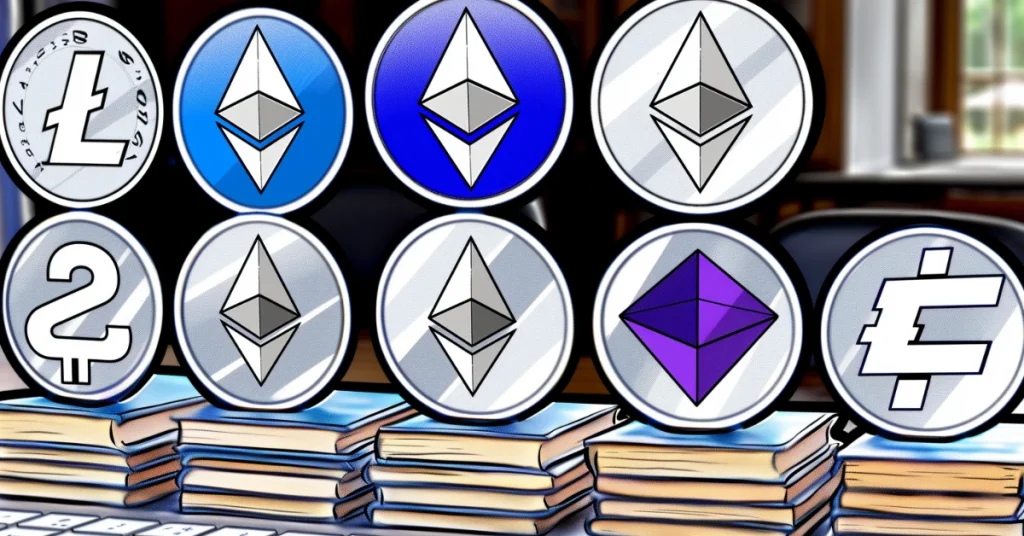
The post Best Cryptocurrency Under $0.75? Analysts Say This New Crypto Coin Could Explode Soon appeared first on Coinpedia Fintech News
Every bull market has its breakout story, and according to many in the crypto space, that story for 2025 could belong to Mutuum Finance (MUTM). Priced at just $0.035 in its ongoing presale, the token is catching the attention of investors searching for the best cryptocurrency under $0.75 with strong long-term upside potential. As the project moves closer to its V1 protocol launch and surpasses $18 million raised, it’s quickly emerging as one of the top crypto tokens to watch before the next market cycle kicks in.
Mutuum Finance (MUTM) is developing a non-custodial liquidity protocol that allows users to lend or borrow crypto safely using automated smart contracts. The goal is to make decentralized finance (DeFi) more secure, transparent, and efficient for everyone — from retail investors to institutions.
At the heart of the protocol is the Peer-to-Contract (P2C) model. This system lets users supply crypto to a shared liquidity pool and earn yield automatically. When someone deposits tokens, they receive mtTokens, which represent both their deposit and the interest it earns. For example, depositing 3 ETH gives the user 3 mtETH, which gradually increases in value over time as borrowers pay interest back into the pool. This simple mechanism allows anyone to earn passive income from their idle crypto.
The second component is the Peer-to-Peer (P2P) marketplace, which allows users to create direct lending agreements on less common assets. Here, borrowers can lock in either variable or stable interest rates depending on market conditions. For instance, someone borrowing stablecoins might choose a stable rate to avoid future fluctuations, while another user might opt for a variable rate to benefit from lower short-term costs.
Mutuum Finance also enforces strict Loan-to-Value (LTV) ratios to keep the system stable. For example, stable assets like ETH or USDT can reach up to 75% LTV, while more volatile assets are capped around 40%. If a borrower’s collateral drops too far in value, automatic liquidations occur to protect lenders. This mechanism maintains balance and reduces the risk of bad debt — something that has challenged many DeFi protocols in the past.
Mutuum Finance’s presale has become one of the most talked-about in the DeFi crypto scene. It is currently in Phase 6, with each token priced at $0.035. The next stage will increase to $0.04, followed by a confirmed launch price of $0.06 — representing a potential 500% MUTM appreciation for phase 1 participants.
Out of the 4 billion total tokens, about 1.82 billion (45.5%) are allocated for the presale. This structure provides transparency and limits the risk of oversupply, while ensuring enough liquidity remains for ecosystem growth. So far, the presale has raised over $18 million and attracted more than 17,600 holders, making it one of the best-performing new crypto launches of the year.
Early participants have already seen notable appreciation. Tokens that were available for around $0.01–$0.02 in early stages have now more than doubled in value. Each new phase is selling out faster than the previous one, showing strong and accelerating demand.
To keep engagement high, Mutuum Finance runs a 24-hour leaderboard, rewarding the top daily presale contributor with $500 worth of MUTM tokens. This not only encourages ongoing participation but also adds transparency to fundraising activity.
Mutuum Finance recently introduced card payments for direct token purchases — with no purchase limits — making it easier for newcomers to join without needing complex crypto wallets. This move has opened the presale to a wider audience and fueled another wave of demand.
The next key step for Mutuum Finance is its V1 protocol launch, set to go live on the Sepolia Testnet in Q4 2025. This version will include the platform’s core components — the Liquidity Pool, mtToken yield system, Debt Tokens, and an automated Liquidator Bot to handle under-collateralized positions. Initially, it will support ETH and USDT, chosen for their deep liquidity and stability.
Importantly, Mutuum Finance has already undergone a CertiK security audit, scoring 90/100 on the Token Scan report. CertiK is one of the most respected audit firms in crypto, and such a high score boosts investor confidence ahead of launch. In addition, the project operates a $50,000 bug bounty program to further enhance code security before mainnet deployment.
While Mutuum Finance’s team avoids making exaggerated claims, several independent analyst reports have speculated that MUTM could outperform many mid-cap DeFi coins once it goes live. Based on presale metrics, limited token allocation, and clear use cases, price targets ranging between $0.35 and $0.55 in the months following launch have been mentioned — roughly a 10x–15x potential upside from the current presale price.
These projections are grounded in realistic metrics: strong presale performance, verified security, and a working product set to launch soon. Combined with a growing community and whale participation, the market momentum appears sustainable rather than speculative.
Beyond lending, Mutuum Finance also plans to issue its own USD-pegged stablecoin, which will be over-collateralized by loans within the protocol. This stablecoin will be minted and burned on demand, ensuring stability and reducing excess supply. It’s designed to act as a self-sustaining part of the ecosystem — helping users access liquidity without leaving the platform.
The project also intends to expand to Layer-2 networks such as Arbitrum or Optimism, making transactions cheaper and faster. This multi-chain vision aligns Mutuum Finance with current DeFi trends, where scalability and cross-chain compatibility are increasingly important for long-term growth.
Few new crypto coins offer as much clarity and progress as Mutuum Finance. Between its detailed roadmap, audited contracts, and active community, it’s proving to be more than just another presale. As Phase 6 crosses 80% allocation, the remaining supply is selling out quickly, fueled by both retail and six-figure whale investments. These larger contributions suggest growing confidence from experienced investors, often viewed as an early signal of future market strength.
With its V1 testnet fast approaching and strong fundamentals in place, Mutuum Finance (MUTM) continues to gain ground as one of the best cryptocurrencies to watch in 2025.
For more information about Mutuum Finance (MUTM) visit the links below:
Website: https://www.mutuum.com
Linktree: https://linktr.ee/mutuumfinance
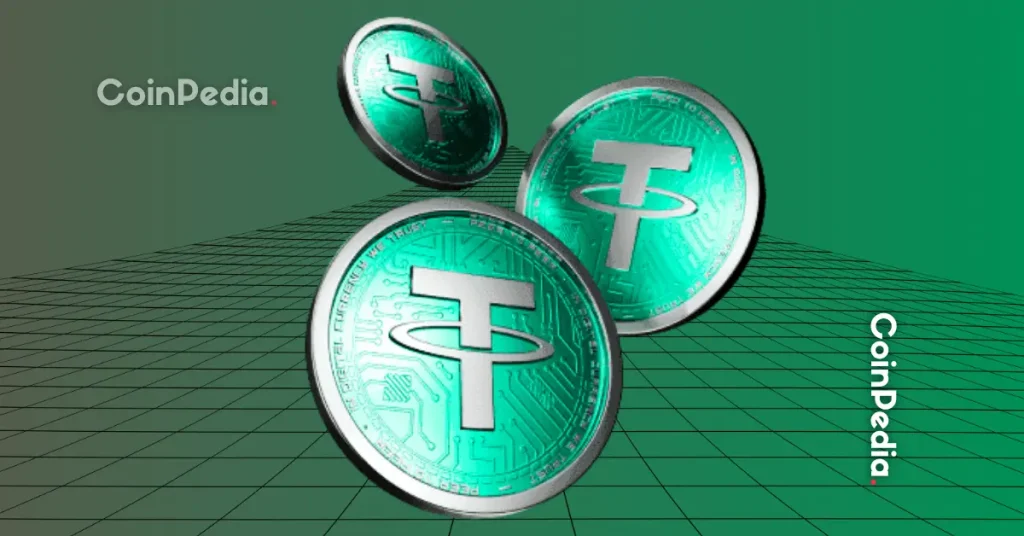
The post Tether & TRON Freeze $300M in Illicit Crypto appeared first on Coinpedia Fintech News
T3 Financial Crime Unit, a coalition of Tether, TRON, and TRM Labs, has frozen over $300 million in illicit crypto assets since its 2024 launch. Collaborating with law enforcement in 23 countries, T3 targets money laundering, fraud, and cybercrime. The unit is recognized for aiding major cases like Brazil’s Operation Lusocoin, involving billions in frozen assets. Its success highlights the critical role of public-private partnerships in combating blockchain crime and enhancing crypto security worldwide.

The post Bitget Token Price Prediction 2025, 2026 – 2030: Will BGB Price Hit $15? appeared first on Coinpedia Fintech News
Bitget is rising fast in the crypto space, ranked 33rd by market cap. It recently teamed up with Wov Labs to create new ways of blending physical and digital experiences. It’s no surprise that investors are paying close attention. As the token continues to outperform major exchange tokens, the big question heading into the last quarter of 2025 is clear: What’s the Bitget Token price prediction for 2025 and the years to come?
| Cryptocurrency | Bitget Token |
| Token | BGB |
| Price | $4.5421
|
| Market Cap | $ 3,167,844,814.04 |
| 24h Volume | $ 53,498,615.7083 |
| Circulating Supply | 697,439,436.1811 |
| Total Supply | 919,992,035.9788 |
| All-Time High | $ 8.4851 on 27 December 2024 |
| All-Time Low | $ 0.0584 on 11 August 2021 |
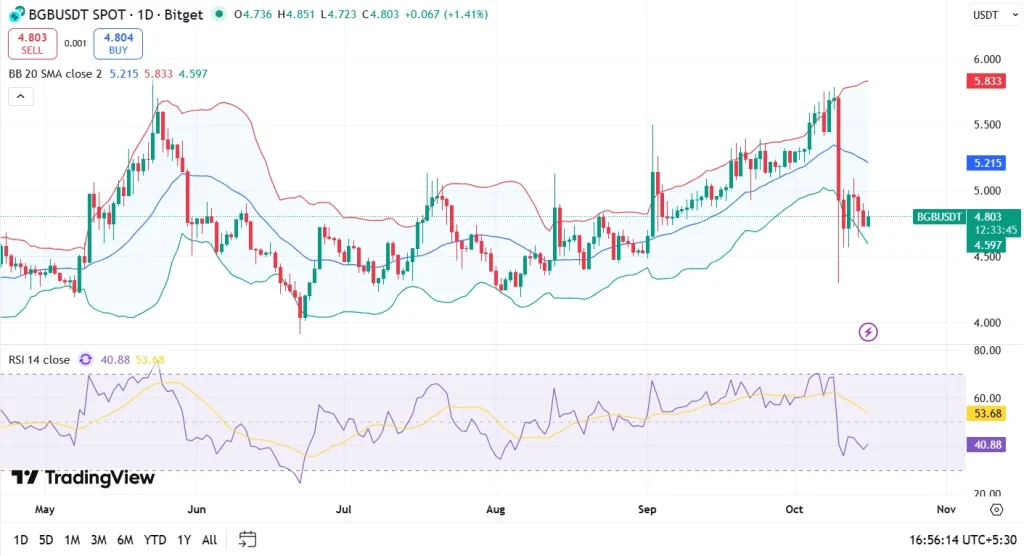
BGB is trading near $4.49, positioned below the 20-day SMA at $5.215. Technicals indicate:
Bitget is working to evolve the BGB token from a simple exchange utility token to a real-world payment asset. The platform has introduced gas fee-based token burns, which are tied to transaction activity on Bitget Wallet and Exchange. This burning mechanism could steadily reduce the token’s circulating supply, helping to increase scarcity over time.
Later in 2025, its PayFi integration is expected to go live. This move would allow users to spend the token for everyday services like travel, dining, and shopping. Moreover, the proposed BGB token burn is another catalyst that is expected to go live in November 2025.
Under such an optimistic outlook, the Bitget price could smash its target price of $10 and achieve a new high of $16.02 this year. On the contrary, a bearish setback could pull the price of the BNB token toward its annual low of $4.85. That being said, the Bitget Token (BGB) price could conclude the year 2025 with an average trading price of $10.93.
| Year | Potential Low | Potential Average | Potential High |
| 2025 | $4.85 | $10.93 | $16.02 |
Curious to explore the long-term price prospects of the largest altcoin by market capitalization? Read Ethereum Price Prediction to uncover the possible mysteries!
| Year | Potential Low ($) | Potential Average ($) | Potential High ($) |
| 2026 | 8.67 | 14.24 | 19.82 |
| 2027 | 11.29 | 17.72 | 24.16 |
Looking ahead, a major event is lined up for January 26th, 2026. Bitget will unlock 140 million BGB tokens, which is nearly 12% of the current circulating supply. Such large token unlocks often bring market volatility, so traders are keeping a close watch.
During 2026, the BGB price may range between $8.67 and $19.82. With this, the average price could land at around $14.24.
By 2027, the value of a single Bitget Token price could reach a maximum value of $24.16 with a potential low of $11.29. With this, the average price could land at around the $17.72 level.
| Year | Potential Low ($) | Potential Average ($) | Potential High ($) |
| 2028 | 15.47 | 22.57 | 29.68 |
| 2029 | 19.68 | 27.73 | 35.79 |
| 2030 | 23.50 | 32.55 | 41.60 |
The BGB price could range between $15.47 and $29.68 for the year 2028. Moreover, the altcoin could have an average trading price of $22.57.
Looking forward to 2029, the single Bitget token price could reach a maximum value of $35.79 with a potential low of $19.68. Considering the buying and selling pressure, the average trading price could settle at $27.73.
The BGB coin price could range between $23.50 and $41.60 for the year 2030. Moreover, the altcoin could have an average trading price of $32.55.
Wondering if the BNB coin price will achieve the $1000 mark this AltSeason? Read Binance Price Prediction to uncover the possible price projection until 2030!
| Firm Name | 2025 | 2026 | 2030 |
| Changelly | $1.62 | $2.36 | $10.83 |
| CoinCodex | $7.01 | $7.02 | $11.92 |
| DigitalCoinPrice | $14.11 | $16.47 | $36.15 |
*The aforementioned targets are the average targets set by the respective firms.
Also Read: Decred (DCR) Price Prediction 2025, 2026-2030: Will DCR Break The $50 Mark?
With more fundamental updates and partnerships, the Bitget cryptocurrency exchange could attract more users to its platform. This could result in its native token “BGB” gaining significant attention from the crypto space. Further, with a unique strategy, the Bitget exchange could become a key player.
If the bullish sentiment sustains, the BGB coin price could reach a high of $16.02 this year. On the flip side, if the cryptocurrency market experiences a strong bearish setback, this could result in this altcoin settling at a low of $4.85.
| Year | Potential Low | Potential Average | Potential High |
| 2025 | $4.85 | $10.93 | $16.02 |
Planning on investing in CRO crypto buy and concerned about its price prospects? Read CoinPedia’s Cronos Price Prediction 2025, 2026 – 2030!
Bitget cryptocurrency exchange has its own native token, “BGB” which was launched in July 2021.
If the bullish sentiment sustains, the BGB coin price could conclude the year 2025 with a potential high of ~$16.
No, the Bitget crypto exchange is not available for users in the United States of America (USA) due to its regulatory restrictions.
With a potential surge, this altcoin may achieve a high of $41.60 by the year 2030.
With a trading value of $6.69, 1000 BGB are currently valued at $6,690.
Bitget is a Seychelles-based crypto exchange. Reportedly, it empowers 20+ million users across 100+ countries with copy trading and various smart tools.
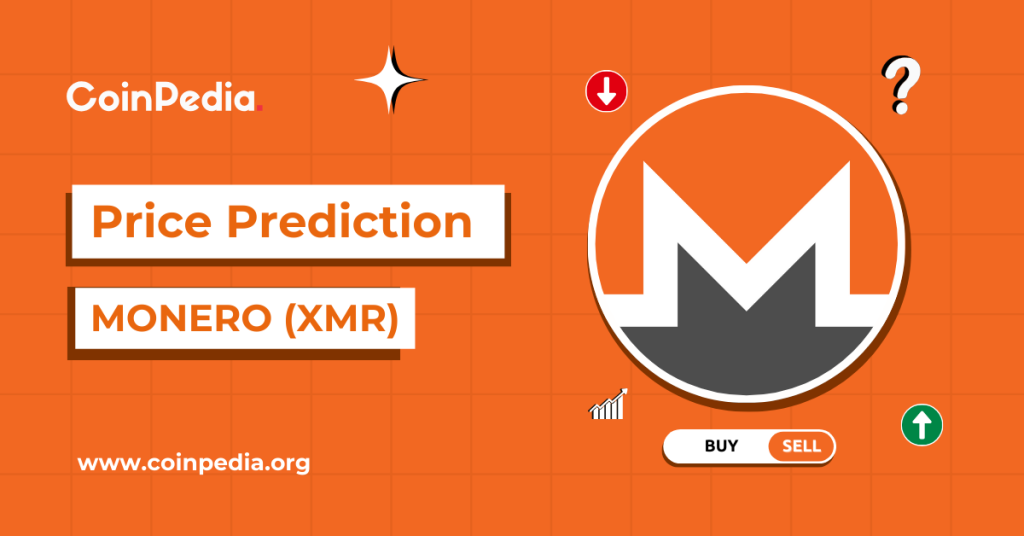
The post Monero Price Prediction 2025, 2026 – 2030: Will XMR Price Cross $300? appeared first on Coinpedia Fintech News
Story Highlights
Imagine making an online payment without leaving any digital footprint. That’s the promise Monero (XMR) has offered since 2014. Known for its strong privacy features, Monero became the top choice of users for maintaining the gold standard for anonymity in blockchain transactions.
Kraken has restarted Monero (XMR) deposits after suspending them due to the Qubic attack. The exchange now requires 720 confirmations, equal to around 24 hours of waiting time. While this reduces trading convenience, it also strengthens security and may stabilize the market over time.
However, by prioritizing security, Kraken could stabilize trust in the market. If conditions improve, the exchange might fully restore normal deposit times by late 2025, which could also influence XMR’s price outlook.
Despite the government’s tightening of the rules around digital assets, Monero has ranked 21st globally. Driven by rising interest, XMR stands out as a privacy-focused coin. So, what’s coming next for Monero in 2025 and the years to come? In this Monero price prediction article, we look at the potential price targets.
| Cryptocurrency | Monero |
| Token | XMR |
| Price | $341.3566
|
| Market Cap | $ 6,296,918,537.00 |
| 24h Volume | $ 140,948,593.9118 |
| Circulating Supply | 18,446,744.0737 |
| Total Supply | 18,446,744.0737 |
| All-Time High | $ 517.6202 on 07 May 2021 |
| All-Time Low | $ 0.2130 on 14 January 2015 |
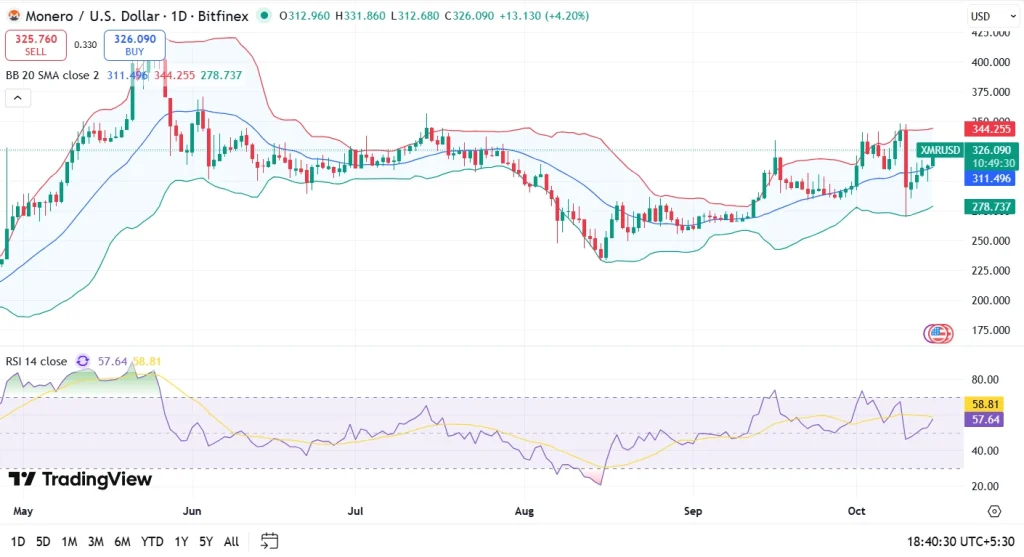
Monero (XMR) is trading near $327.04, holding above the 20-day SMA at $311.50. Technicals indicate:
The Tari blockchain expansion, which aims to add real-world utility to private asset transfers, could push XMR price to new highs over time. Moreover, looking ahead, Monero’s Seraphis upgrade in late 2025 could be a game-changer. It brings quantum-resistant tech and a new address format called Jamtis, which will cut transaction sizes by 40 percent. This could boost both speed and adoption. On an optimistic note, the XMR price could chug up to a maximum of $882.64 by year-end.
Contrarily, events like the EU privacy coin ban and a crackdown by the U.S. Department of Justice could drag the price down to $294.21. That being said, considering the highs and lows, the average price could settle at $588.42.
| Year | Potential Low | Potential Average | Potential High |
| 2025 | $224.21 | $588.42 | $882.64 |
Also read, Stellar Price Prediction 2025, 2026 – 2030!
| Year | Potential Low ($) | Potential Average ($) | Potential High ($) |
| 2026 | $383.76 | $767.51 | $1,151.27 |
| 2027 | $575.64 | $1,151.27 | $1,726.90 |
According to forecast prices and technical analysis, Monero’s price is projected to reach a minimum of $383.76 in 2026. The maximum price could hit $1,151.27, with an average trading price around $767.51.
Looking forward to 2027, XMR’s price is expected to reach a low of $575.64, with a high of $1,726.90 and an average forecast price of $1,151.27.
| Year | Potential Low ($) | Potential Average ($) | Potential High ($) |
| 2028 | $863.46 | $1,726.90 | $2,590.35 |
| 2029 | $1,295.19 | $2,590.35 | $3,885.53 |
| 2030 | $1,942.76 | $3,885.53 | $5,828.30 |
In 2028, the price of a single Monero is anticipated to reach a minimum of $863.46, with a maximum of $2,590.35 and an average price of $1,726.90.
By 2029, XMR’s price is predicted to reach a minimum of $1,295.19, with the potential to hit a maximum of $3,885.53 and an average of $2,590.35.
In 2030, Monero is predicted to touch its lowest price at $1,942.76, hitting a high of $5,828.30 and an average price of $3,885.53.
| Firm Name | 2025 | 2026 | 2030 |
| Wallet Investor | $178.21 | $164.09 | – |
| priceprediction.net | $307.32 | $446.59 | $1,952 |
| DigitalCoinPrice | $476.53 | $614.76 | $1,372.39 |
*The targets mentioned above are the average targets set by the respective firms.
As per CoinPedia’s formulated Monero price prediction, increased adoptions, collaborations, and new partnerships could result in the price of Monero recording a high of $882.64.
Conversely, the XMR price may plunge to $294.21 if it fails to regain momentum. With this, the average price could settle at around $588.42.
| Year | Potential Low | Potential Average | Potential High |
| 2025 | $294.21 | $588.42 | $882.64 |
Also read, Kaspa Price Prediction 2025, 2026 – 2030!
Stay ahead with breaking news, expert analysis, and real-time updates on the latest trends in Bitcoin, altcoins, DeFi, NFTs, and more.
With a potential surge, the price could go as high as $5,828.30 by the end of 2030.
Monero is a privacy-oriented crypto that is untraceable.
As per our Monero price prediction, the XMR price might surge as high as $882.64 in 2025.
A single block of Monero requires approximately 2 minutes to mine. Hence, nearly 720 blocks are mined in a day.
Yes, you can mine XMR on your laptop or Android phone, using the right app.


This month saw the first “Uptober” in seven years to finish with Bitcoin in the red. Meanwhile, BNB takes off thanks to memecoins.

Banks may soon take a softer stance on crypto as the Basel Committee prepares to revise its 2022 guidance on banks’ exposure to digital assets, according to Bloomberg.

Like early email protocols, DeFi remains complex and isolated. Bridging DeFi and TradFi through hybrid payment solutions could unlock crypto’s mainstream potential.

Anticipation of Ripple’s annual event has failed to lift investor sentiment as XRP price risks dropping to $2 in the coming days or weeks.

Bitcoin has become a $2 trillion asset in the 17 years since Satoshi Nakamoto published the white paper, but it faces its first red October since 2018.

Canaan will supply 4.5 megawatts of water-cooled Bitcoin mining ASICs to a Japanese engineering firm for real-time grid balancing and energy optimization.

Zcash defied the crypto market downturn with a 45% rally this week, making it the most valuable privacy-focused cryptocurrency, following Hayes’ call for a $10,000 price target.





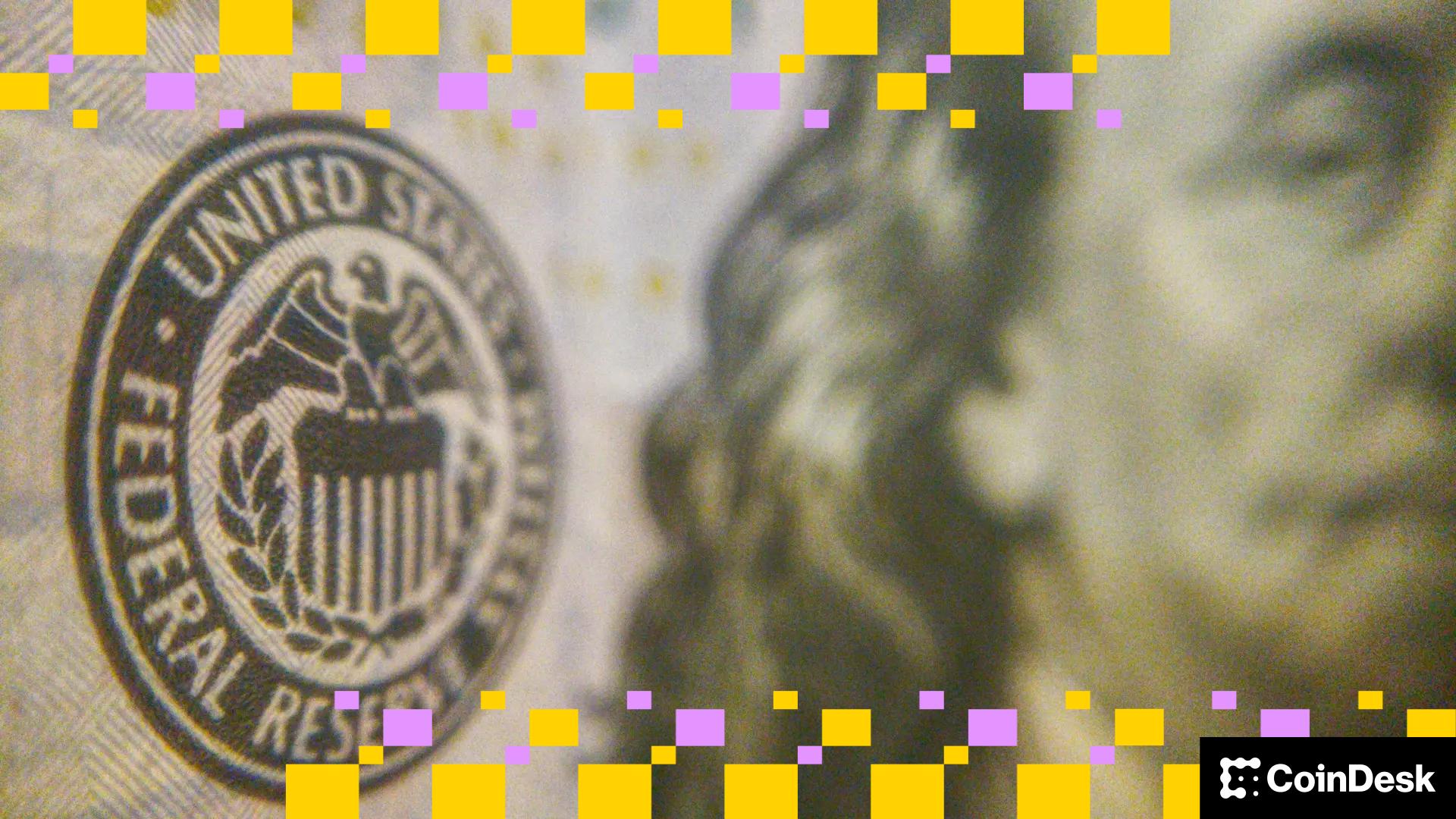
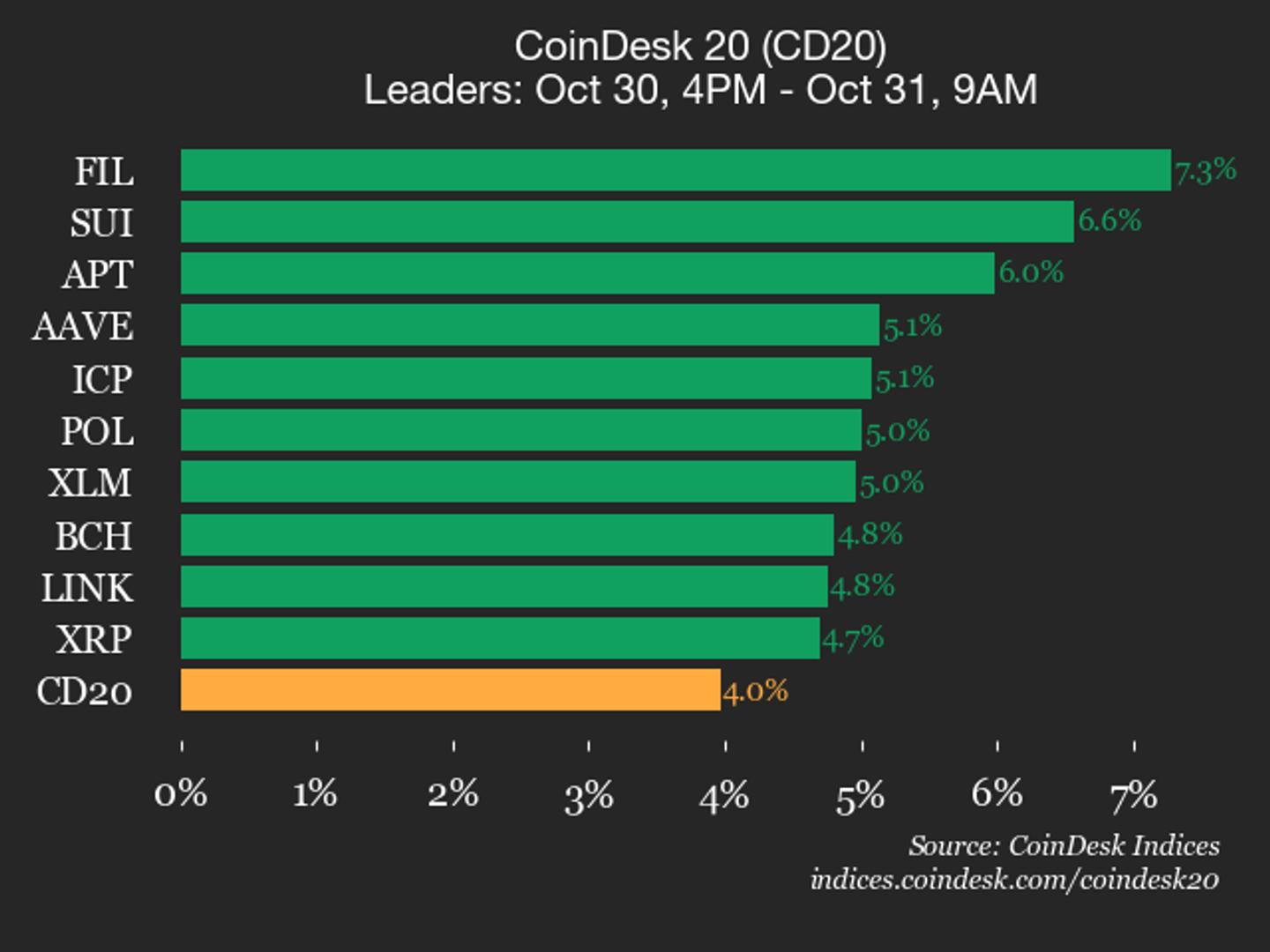
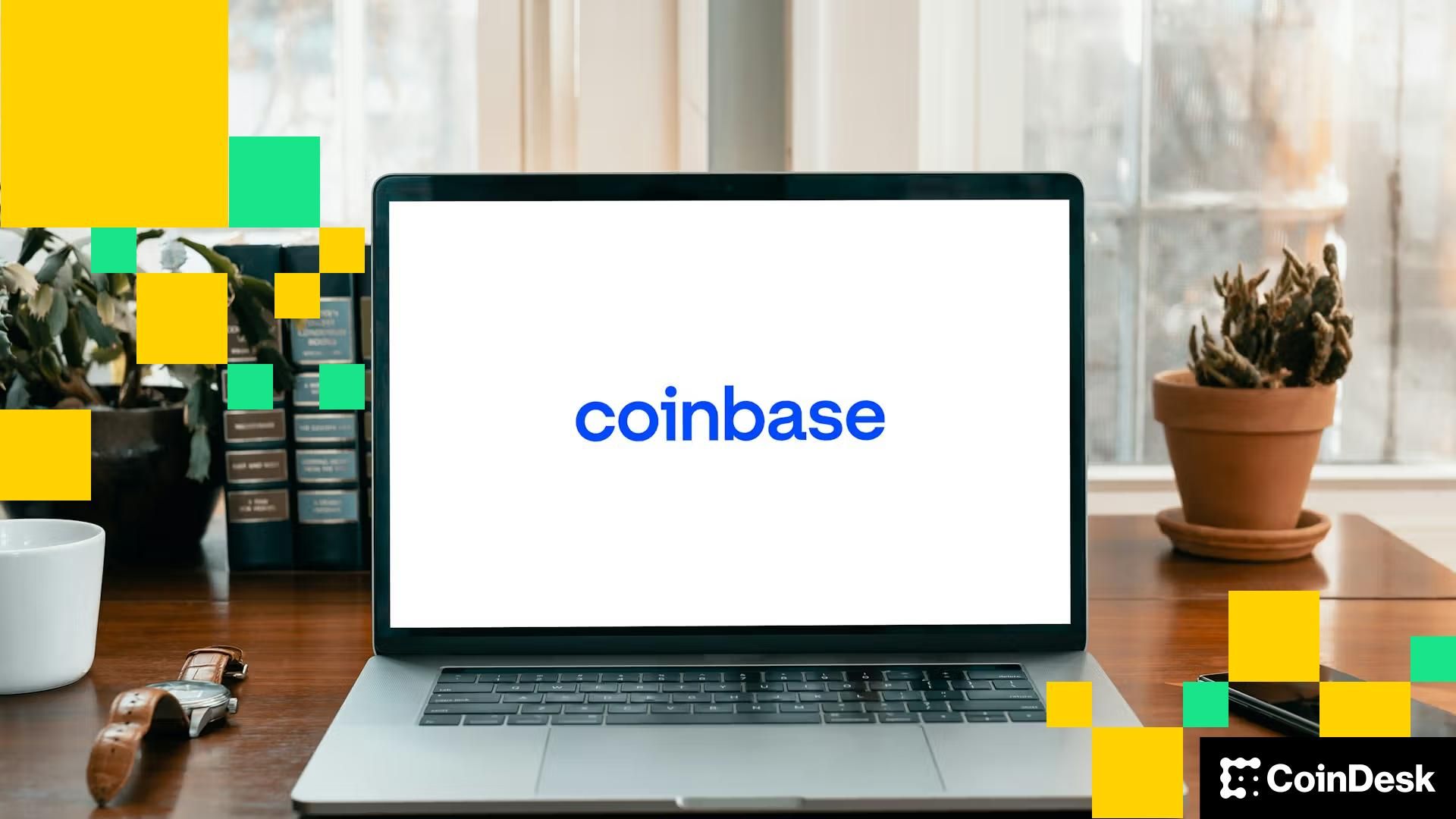




Canada is following the U.S. in crafting stablecoin laws, with regulators rushing to fit a new framework in the upcoming budget docs.
The post Canada’s stablecoin rules; Aussie VASPs flag gaps in proposed law appeared first on CoinGeek.
ASIC has released an updated version of its guidance clarifying how Australia's existing financial services laws apply to digital assets.
The post Australia’s top finance watchdog updates digital asset guidance appeared first on CoinGeek.
Prenetics' Bitcoin strategy may influence other healthcare firms to consider crypto assets for treasury management, impacting industry norms.
The post Prenetics acquires 100 Bitcoin, increasing holdings to 378 BTC appeared first on Crypto Briefing.

Bitcoin's retest of a critical cost-basis band could signal significant market shifts, influencing future price trends and investor strategies.
The post Bitcoin retests critical $109K cost-basis band, historical turning point appeared first on Crypto Briefing.

The deal could hinder EDF's technological advancements and competitiveness in AI and cloud sectors, impacting France's digital economy.
The post MARA’s Exaion deal could bar EDF from Bitcoin mining, AI and cloud for two years: Report appeared first on Crypto Briefing.

The review of crypto banking rules could reshape financial stability and innovation, impacting how banks engage with digital assets globally.
The post Global regulators review crypto banking rules amid stablecoin surge appeared first on Crypto Briefing.

Venezuela's move towards Bitcoin integration could stabilize its economy, offering a hedge against hyperinflation and currency volatility.
The post Venezuela inches toward integrating Bitcoin into its national banking rails appeared first on Crypto Briefing.

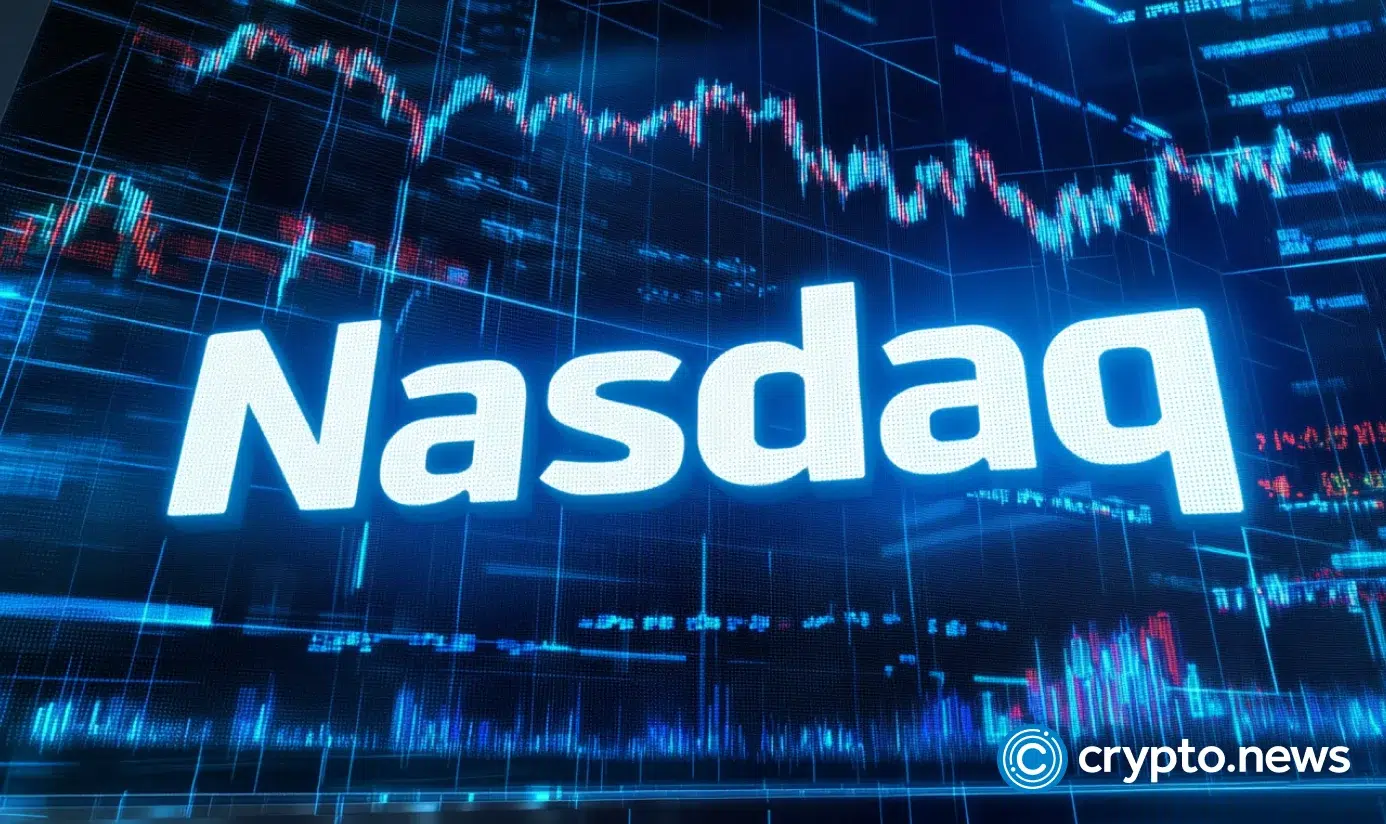

Bitwise Chief Investment Officer Matt Hougan is now applying his long-standing Bitcoin framework to Solana — and he’s calling the setup “explosive.”
In an October 29 memo, Hougan says the best trades in crypto are the ones where you get “two ways to win” with one position. For Bitcoin, he defines those two bets as: “1) The global ‘store of value’ market will grow. 2) Bitcoin will take an increasing share of that market.” He says only one of those outcomes has to be true for Bitcoin to work.
Hougan sizes that “store of value” market at roughly $27.5 trillion today, including about $25 trillion in gold and $2.5 trillion in Bitcoin. He argues investors focus too much on Bitcoin replacing gold and not enough on the overall market itself expanding.
He notes that this market has already grown by roughly 10x in the last 20 years, from under $3 trillion in 2005 to $27.5 trillion today. In his view, if that repeats, Bitcoin can 10x without needing to fully displace gold. If, on top of that, Bitcoin also closes the gap with gold and ends up with half of the total store-of-value market, “every bitcoin would be worth $6.5 million.” He adds, “I’m not saying that will happen,” but he uses the math to show how powerful the dual-bet structure can be.
Hougan now argues Solana fits the same model. “When I invest in Solana, I am also making two bets at once,” he writes. Those two bets are: “1) The stablecoin and tokenization infrastructure market will grow. 2) Solana will win an increasing share of that market.”
He defines that market as the set of blockchains that power stablecoin payments and asset tokenization today. He names Ethereum as “the market leader,” and lists Tron, Solana, and Binance Smart Chain as major challengers in stablecoins. Together, he says, those networks represent $768 billion in market value. Solana’s share of that is $107 billion, or roughly 14%.
For Hougan, that is the opening. He says he has “a lot of confidence that the stablecoin and tokenization infrastructure market will grow,” and argues most people “significantly underestimate how much these technologies will remake markets.”
His long-run claim is blunt: “Over time, I suspect nearly all payments will be in stablecoins and nearly all assets will be tokenized.” If that plays out, “the blockchains that facilitate this growth will be extremely valuable.” He calls it “easy to imagine this market growing by 10x or more.”
The second part, in his view, is Solana’s ability to capture more of that expansion. He calls Solana “fast” and “user-friendly,” backed by a community with a “ship-fast attitude.” He also notes that Solana is still “playing catch-up” in winning institutional mandates, but says that is starting to change. As an example, he cites Western Union’s announced stablecoin effort this week, and points out that Western Union chose Solana as the underlying blockchain.
Hougan’s argument is that if the overall market for stablecoin settlement and tokenized assets 10xes, and Solana grows its share of that market from 14%, the result is not linear — it compounds. “If I’m right,” he writes, “the combination of a growing market and a growing share of that market will be explosive for Solana. Just as with bitcoin.”
He closes with a note on positioning. Crypto, he says, rewards humility because “even the most seasoned experts don’t know exactly how things will play out.” But he says you can still tilt odds in your favor by owning assets that embed two high-conviction bets at once. In his view, Bitcoin already fits that profile. Solana now does too.
At press time, SOL traded at $186.
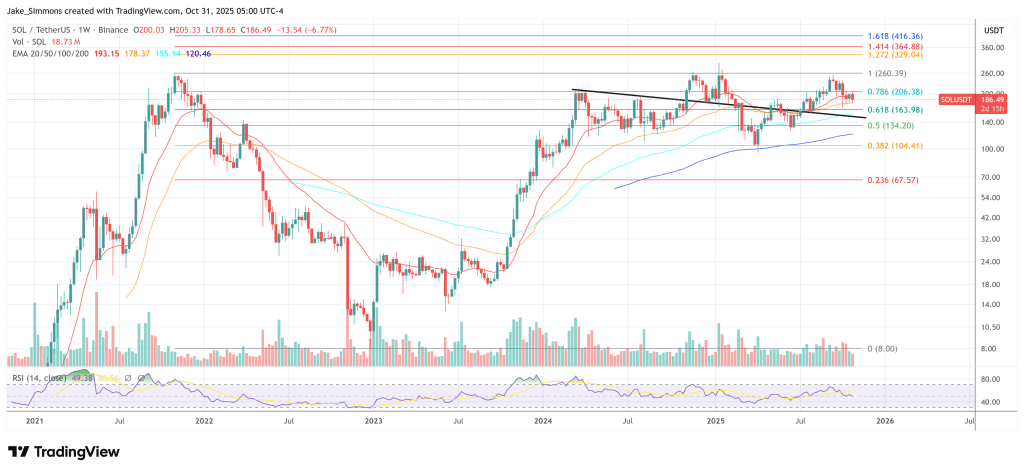

Crypto analyst XForce has predicted that the XRP price could rally to $10 on a wave 3 impulsive move to the upside. The analyst also indicated that the bottom was in for XRP even as the crypto market remains in a downtrend.
In an X post, XForce told XRP holders to get ready for a rally to $10 or higher, which he described as a conservative wave 3 target. He noted that there are minor market inefficiencies in the local timeframes for the XRP price. However, the analyst added that the macro chart shows clear accumulation and a solid price floor after almost a year of distribution.
Crypto analyst CasiTrades had also predicted that the XRP price could rally to as high as $10 on the wave 3 move. However, she predicted that XRP would crash to as low as $1.4 first to complete the macro wave 2 correction, which had begun around the largest liquidation event on October 10.

XForce indicated that this projected crash to $1.4 for the XRP price was unlikely to happen. The analyst opined that the major low was in and alluded to the macro chart, which showed that the low had been broken, but XRP bounced hard from it. He added that XRP could stay in this current range for more distribution before the next leg up, but believes that predictions about a further downtrend are all “noise.”
The XRP price has continued to range between $2.4 and $2.6 as the market recovers from the October 10 crash, which saw XRP drop to as low as $0.77 on Binance. Meanwhile, it also dropped below the psychological $2 level on other exchanges.
Crypto analyst CasiTrades doubled down on her prediction that the XRP price would witness one final crash before a rally to the upside. She noted that the altcoin is reacting exactly as expected, having rejected the Wave 4 resistance near $2.68. She added that the price is now turning bearish and the RSI is making a new low, which is starting to confirm that Wave 5 down is underway.
CasiTrades stated that breaking below $2.42 would confirm continuation toward the lower targets at $2.03 and $1.65. These two lower levels are said to have alignment with the Wave 5 extension. The analyst again indicated that the XRP price could drop to at least $1.65, which she noted is the macro .618 retracement.
CasiTrades opined that this projected crash should complete the final wave of the correction before a massive wave 3 impulse to the upside. She added that once the bottom forms, the next impulse should be “fast and obvious,” with the XRP price cutting through resistance on the way to new highs.
At the time of writing, the XRP price is trading at around $2.48, down in the last 24 hours, according to data from CoinMarketCap.

Satoshi Nakamoto’s Bitcoin holdings dropped nearly $5 billion in a single day, cutting the estimated value of the stash to roughly $118 billion.
According to tracking data that ties thousands of early Bitcoin addresses to the name Satoshi, the decline mirrors a wider pullback in crypto markets this week and reflects the sharp swings in Bitcoin’s price.
Reports have disclosed that blockchain analytics firm Arkham Intelligence expanded the set of addresses it attributes to Satoshi and now counts roughly 1,096,354 BTC in those clusters.
That haul is the basis for the big headline numbers used by media outlets measuring the “value” of Satoshi’s holdings.
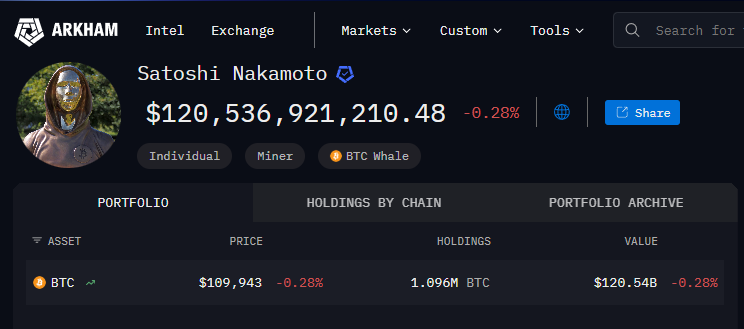
The coins themselves show little sign of movement, and most of the addresses have been inactive for years.
The fall in dollar value does not mean coins changed hands. It only means the market price of Bitcoin fell enough in the past 24 hours to shave about $4.9 billion from the paper worth of those wallets.
Short, sharp swings like this are common in crypto. Longer price trends are what move headline wealth totals more meaningfully.
Based on reports, the slide happened Thursday as traders reacted to broader selling pressure across the digital-asset space. Analysts and market feeds tied the drop directly to a correction in Bitcoin’s price, not to any outgoing transfers from the old addresses.
That detail matters because a sale from a wallet tied to Satoshi would be an event with big market implications; none has been recorded.
At the recent peak in mid-August, when Bitcoin briefly pushed above $124,000, those same addresses were valued at about $130billion.
That comparison shows how volatile headline “net worth” figures can be when they track a fluctuating asset rather than bank accounts or shares.
The holdings of Satoshi Nakamoto are often used as a shorthand to show how much value is effectively locked away in early-mined coins.
For observers, the point is simple: large sums can vanish from dollar-denominated lists overnight when prices move. For traders, those moves feed into short-term momentum and sentiment.
What This Means For InvestorsFor now, the situation is a valuation story more than an operational one. Reports highlight that the coins remain largely dormant and that the tally is an estimate built from on-chain patterns linked to early mining activity.
That leaves market watchers with two basic facts: the dollar value can swing wildly, and the coins have stayed put.
Featured image from Vecteezy, chart from TradingView

The crypto market has seen every narrative under the sun. From “Bitcoin is dead” to “DeFi is the new Wall Street,” the ecosystem is full of cycles where hype and skepticism take turns in the spotlight. Now, the debate has shifted toward altcoin saturation, the belief that the altcoin market is overcrowded, leaving little room for new projects to shine. But recent analysis suggests that this idea may be overstated.
The term altcoin saturation refers to the perception that the crypto market has too many tokens chasing limited liquidity and attention. With thousands of projects listed globally, investors often assume that the next big “altseason” is no longer possible. However, this interpretation ignores the cyclical nature of crypto markets and the underlying shifts in investor behavior.
Crypto analysts note that the altcoin market continues to evolve despite its saturation. New sectors like real-world asset (RWA) tokenization, decentralized AI protocols, and cross-chain infrastructure are attracting capital. The data tells an interesting story. While Bitcoin dropped by around 5 percent over a short period, the overall altcoin market cap fell only 3.6 percent. This relative resilience implies that altcoins are still holding their ground.
One of the most reliable indicators for gauging altcoin saturation is Bitcoin dominance, often referred to as BTC.D. This metric measures Bitcoin’s share of the total crypto market capitalization. Historically, when Bitcoin dominance drops sharply, altcoins rally, signaling an “altseason.”
In recent months, Bitcoin dominance fell from nearly 66 percent in June to about 59 percent by late October. The decline suggests that liquidity is slowly moving toward other digital assets. However, analysts caution that the current structure of Bitcoin dominance still leans bullish, meaning altcoins may need more time before experiencing a full-scale breakout.
The takeaway? Altcoin saturation might not represent a ceiling but rather a transitional phase in market rotation. When investor confidence builds, funds typically trickle down from Bitcoin to larger-cap altcoins like Ethereum, Solana, and XRP, and later to mid and low-cap projects.
To understand altcoin saturation, one must separate noise from substance. While it is true that most altcoins lack real utility, only a small percentage of projects historically drive the majority of market gains. That pattern has remained consistent across every bull cycle.
Much like the stock market, where thousands of companies exist but only a handful consistently outperform, the crypto market tends to reward innovation and network effects. Layer-2 scaling solutions, AI-integrated protocols, and tokenized real-world asset platforms have emerged as serious contenders.

Investors are beginning to differentiate between speculative tokens and those building real ecosystems. The illusion of saturation fades when the focus shifts from quantity to quality.
Market psychology plays a crucial role in the altcoin saturation narrative. Many retail traders equate the abundance of coins with a lack of opportunity. Yet, that abundance could also represent innovation at scale. As blockchain networks mature, interoperability and token standards are improving, making it easier for altcoins to coexist rather than compete destructively.
Over the long term, institutional adoption will determine how sustainable this phase becomes. If more regulated funds start exploring tokenized assets, the liquidity inflows could easily offset perceived market saturation. Moreover, advancements in layer-2 networks and decentralized exchanges are reducing the barriers to entry for smaller, more efficient projects.
Analysts remain split on the future trajectory of altcoin saturation. Some argue that the current environment mirrors early 2020, when Bitcoin was still dominant, but innovation in DeFi and NFTs triggered a powerful altcoin rally months later. Others believe that the crypto landscape today is too fragmented, with regulatory uncertainty acting as a brake.
Still, optimism prevails. Several data points indicate renewed accumulation in select altcoins. Analysts point out that liquidity concentration in a few strong projects can spark sector-specific rallies, even if the broader market remains cautious. Historically, such phases have preceded some of the biggest gains in the space.
Looking forward, altcoin saturation could reshape the crypto hierarchy. The next rally may not lift all tokens equally. Instead, investors might see a bifurcation between projects with genuine adoption potential and those surviving only on speculation.
The evolution of decentralized finance, gaming, and AI-driven protocols could play pivotal roles in defining the new leaders. As blockchain use cases diversify, the term “saturation” could become outdated. What appears crowded now might simply be the early blueprint of a multi-chain financial ecosystem.
Altcoin saturation might be more myth than reality. The abundance of tokens does not signal the end of opportunity; it highlights the maturation of a dynamic, competitive market. Bitcoin dominance continues to guide sentiment, but cracks in its supremacy are showing.
Altcoins that deliver innovation, compliance readiness, and sustainable tokenomics stand to benefit most in the next phase. The crypto market may be crowded, but in every crowd, a few voices eventually rise above the noise.
The notion of altcoin saturation has become a convenient scapegoat for a market in transition. The data, however, paints a different picture, one of selective resilience and shifting dominance. As Bitcoin matures, altcoins are slowly carving out their roles within a broader financial ecosystem. The market may appear crowded, but it is far from exhausted. Investors who understand this nuance may find that the next wave of opportunity lies not in escaping saturation but in navigating it wisely.
1. What is altcoin saturation?
Altcoin saturation refers to the belief that the crypto market has too many coins competing for limited investor attention and liquidity.
2. How does Bitcoin dominance affect altcoins?
When Bitcoin dominance decreases, it often signals that investors are rotating funds into altcoins, leading to broader market rallies.
3. Are all altcoins affected equally by market saturation?
No. Strong projects with active ecosystems and use cases tend to outperform weaker, speculative tokens.
4. Could altcoin saturation slow down market growth?
Not necessarily. While it can fragment liquidity, innovation and institutional involvement can offset the effects.
5. What should investors watch to predict altcoin rallies?
Key indicators include Bitcoin dominance trends, total crypto market cap, and sector-based momentum in areas like DeFi or AI tokens.
Altcoin: Any cryptocurrency other than Bitcoin.
Altcoin Saturation: A condition where too many altcoins compete for limited market attention.
Bitcoin Dominance (BTC.D): A metric showing Bitcoin’s percentage of total crypto market capitalization.
Altseason: A market period when altcoins outperform Bitcoin.
Tokenomics: The economic design of a cryptocurrency, including supply, incentives, and distribution.
Liquidity: The ease with which an asset can be bought or sold without affecting its price.
DeFi: Decentralized Finance, financial systems built on blockchain without intermediaries.
RWA (Real World Assets): Tokenized physical or traditional assets like bonds, property, or stocks on blockchain networks.
Interoperability: The ability of different blockchain networks to communicate and share information seamlessly.
Layer-2 Solutions: Protocols built on top of existing blockchains to improve scalability and reduce transaction costs.
Read More: Is Altcoin Saturation Real? Experts See Room for a Fresh Rally">Is Altcoin Saturation Real? Experts See Room for a Fresh Rally


This Article Was First Published on The Bit Journal| The Ethereum Fusaka upgrade is redefining how the network handles speed and scalability, but could this bold step toward modular efficiency be the turning point that reshapes Ethereum’s future?
The Ethereum Fusaka upgrade is an essential milestone in the road of Ethereum’s development. It aims to increase the network’s speed, efficiency, and ability to manage higher levels of activity.
It is mainly focused on upgrading the overall performance of the system to be more efficient without any changes to the core structure that supports it. Experts say this is a major step forward that strengthens Layer 2 (L2) systems while keeping Layer 1 (L1) secure for final settlements.
The upgrade combines two major development paths called Fulu for consensus and Osaka for execution into one system. The Ethereum Fusaka upgrade aims to make data processing faster, cut fees, and keep the network stable for users and developers.
This will increase Ethereum’s data capacity and make fees more efficient. It allows the network to adjust data limits smoothly without major system changes, which experts see as a smart and advanced improvement.
Blockchain researcher Elena Park said that the upgrade is more than a small change, explaining that it reshapes how Ethereum handles data and makes rollups easier to use every day.
The Ethereum Fusaka upgrade mainly targets lower fees on Layer 2 instead of Layer 1. With Peer Data Availability Sampling (PeerDAS), validators can check only parts of data instead of full sets. This change helps save bandwidth and reduces overall network costs.
For users, the Fusaka upgrade brings lower costs and better efficiency. Developers expect rollup fees on networks like Arbitrum, Optimism, and Base to drop by 15% to 40%, and sometimes even up to 60%.
Layer 1 gas prices should stay mostly stable, with small possible reductions of around 10% to 20%.
Yes, and that is exactly the goal. The Fusaka upgrade supports ETH’s long-term plan to work as a modular system. Layer 1 will stay the secure base for settlements, while Layer 2 networks will become faster and more affordable for users.
The Ethereum Fusaka upgrade will raise the block gas limit from 45 million to 150 million, allowing more transactions per block and making the network faster and more efficient.
According to blockchain analyst Ravi Deshmukh, the upgrade is not meant to draw users back to Layer 1 but to make Layer 2 an even stronger choice for everyday use.
This approach fits with Ethereum’s long term vision of a layered system where most activity happens on scalable rollups, and final settlements stay secure on the main network.
The Ethereum Fusaka upgrade also adds user-friendly features. It includes WebAuthn passkeys, letting wallets use biometric or hardware logins. This replaces traditional seed phrases with a safer, password-free option.
The update helps transactions happen faster and more reliably. It also makes using Ethereum easier and smoother for everyone. The upgrade adds a new system to make transactions more predictable and faster.
These changes make using Ethereum smoother and easier. They bring Web2 like convenience while keeping the security of Web3.
The Ethereum Fusaka upgrade is more than an update and reflects Ethereum’s long term vision. It keeps the network decentralized while making it easier to use and ready for growth.
Experts think Fusaka will boost interest in Layer 2 projects and decentralized apps. Lower costs for posting data could also increase activity in DeFi, raising the Total Value Locked (TVL) across networks.
Developer Mira Zhao said that Fusaka shows Ethereum is growing carefully while keeping the system that already works intact.
Ethereum Fusaka upgrade strengthens Ethereum as a modular network, a layer 1 solution that provides security and settlement for layer 2 ecosystems, which are vibrant and cost-effective.
Lowering transaction fees, raising block gas limits, and refining user authentication are some of the ways Fusaka is enabling a smoother, faster, and more user-friendly blockchain environment. The Ethereum Fusaka upgrade is a key move for all users, helping the network grow faster and stay fully decentralized.
Layer 2 (L2): A network built on Ethereum to speed up and lower costs.
Layer 1 (L1): The main Ethereum network where final records are stored.
PeerDAS: A feature that helps check data faster and use less space.
Gas Limit: The amount of work the network can do in one block.
Rollups: Tools that group many transactions together to save time and money.
It helps lower fees, increase data space, and make Ethereum work faster without changing its main system.
Experts say it could reduce Layer 2 transaction fees by up to 60%.
It introduces PeerDAS for faster data checks, higher gas limits, and better tools for developers.
Layer 1 gas prices should stay mostly stable, with small reductions in cost.
Both users and developers benefit because transactions become faster, cheaper, and smoother.
Read More: Ethereum’s Fusaka Upgrade: How PeerDAS Could Cut Layer 2 Fees by 60%">Ethereum’s Fusaka Upgrade: How PeerDAS Could Cut Layer 2 Fees by 60%


This article was first published in The Bit Journal: Does the move by Ondo Finance to bring over 100 US stocks and ETFs to Binance Chain underscore the growing integration between traditional finance and blockchain technology? Read on to understand more.
Real World Asset (RWA) firm Ondo Finance has made a groundbreaking move within the cryptocurrency ecosystem by integrating tokenized US stocks and ETFs within the BNB Chain. The move has coincided with a surge in the tokenized asset market, boasting an impressive $700 million market valuation.
According to an official blog post by Ondo Finance, the move will open access for over 3.4 million BNB Chain users, who will be able to buy and sell tokenized shares of leading companies, such as Apple and Tesla, as well as popular ETFs, 24/7 via Ondo Global Markets. The primary targets are non-US investors seeking exposure to tokenized US stocks and ETFs, despite the challenges posed by geographical and regulatory hurdles.
Experts believe the expansion of the market will bring competition to other firms offering tokenized asset products on the BNB Chain, like Backed and Kraken’s xStocks. Furthermore, the move is also expected to expand the market’s reach into new areas, such as Latin America and Asia, where the BNB Chain has a strong user base.
The introduction of tokenized US stocks and ETFs comes at a time when the tokenized stock market has more than doubled in value to over $700 million since August 2025. Ondo Finance accounts for about $320 million in total value locked since its September launch. Commenting on the development, Sarah Song, the Head of Business Development at BNB Chain, opined that this was a long-term opportunity for both Ondo Finance and BNB Chain. She said:
“Real-world assets are one of the fastest-growing areas on BNB Chain, and having Ondo Finance join the ecosystem further proves that momentum […] together, we’re making high-quality financial assets more accessible and driving the next wave of adoption that bridges traditional markets with blockchain technology.”
The broader impact of adding tokenized US stocks and ETFs is the potential to influence the correlation between the crypto market and the traditional stock market.
As tokenized assets continue to gain traction, users can expect higher volatility in BTC and ETH during US market hours, a move that could create hedging opportunities, as their tokenized versions on the BNB Chain could offer faster liquidation options and attract swing traders.
Additionally, institutional flows may be another focal point with the market’s doubling to $700 million, attracting inflows from inspired funds from leading entities that could propel BNB Chain’s TVL beyond the current $10 billion.
The initiative by Ondo Finance to introduce tokenized US Stocks and ETFs to BNB Chain has the potential to open doors for more innovative trading strategies. By integrating stock market dynamics with cryptocurrency efficiency, the move fosters a hybrid ecosystem that other firms could explore and advance in the near future.
RWAs: Real-World Assets, which are tangible or traditional assets like real estate, commodities, or bonds that are digitized and represented on a blockchain through tokenization.
Tokenized Stocks: Blockchain-based digital assets that represent ownership or exposure to traditional company shares, such as those of Apple or Tesla.
ETFs: Exchange-traded funds (ETFs) issue publicly traded securities that offer exposure to the price movements of bitcoin futures contracts.
Tokenized stocks are digital assets on a blockchain that represent exposure to traditional equity shares in publicly traded or privately held companies.
A blockchain-based platform issues an equivalent number of digital tokens (typically on a 1:1 basis) using smart contracts. These tokens are listed on compliant cryptocurrency exchanges or DeFi platforms, where users can buy, sell, or hold them like other crypto assets.
Not exactly. While they track the price of the actual stock, holding a tokenized stock typically provides economic exposure (price movement and sometimes dividends) but not direct legal ownership. Your claim generally is on the issuer or a regulated custodian that holds the actual shares in reserve.
Read More: Ondo Finance Brings Tokenized US Stocks and ETFs to BNB Chain">Ondo Finance Brings Tokenized US Stocks and ETFs to BNB Chain

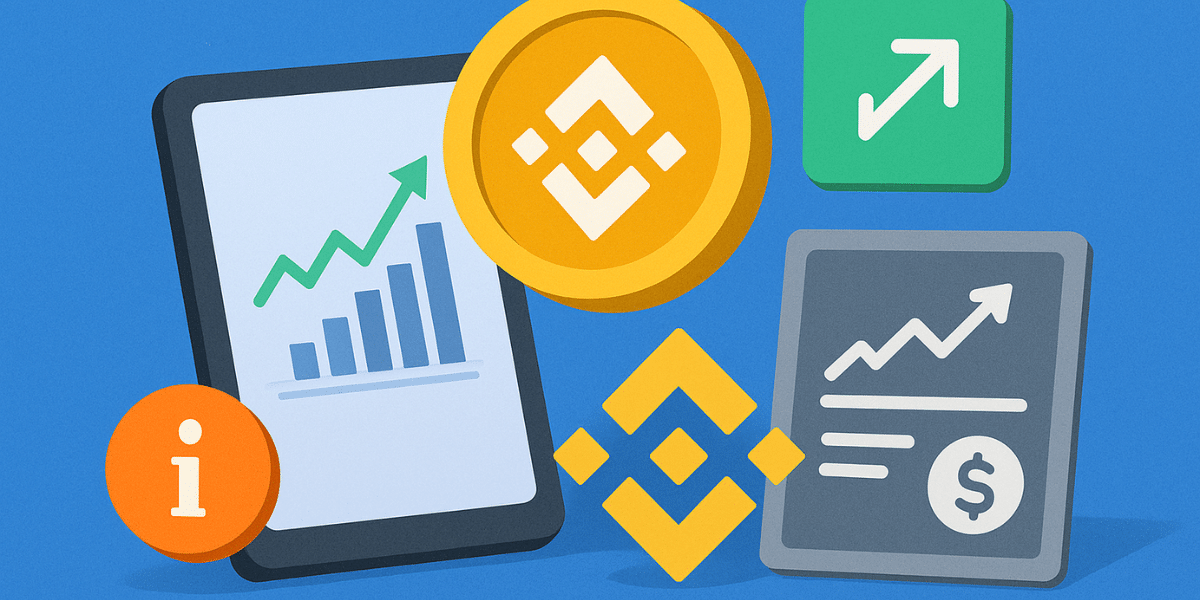
Bitcoin Magazine

Steak ’n Shake Partners With Fold to Launch $5 Bitcoin Burger Reward
Fold Holdings (NASDAQ: FLD), the bitcoin rewards company known for letting users earn sats on everyday purchases, has teamed up with iconic fast-food chain Steak ’n Shake for a limited-time promotion that lets customers earn $5 in bitcoin with their meal.
Starting today, Steak ’n Shake diners who order a Bitcoin Meal or Bitcoin Steakburger at one of the 1,200+ participating Steak ’n Shake locations can visit bitcoinmealdeal.com, upload their receipt, and receive a code redeemable for $5 in bitcoin through the Fold app.
Once the Fold app is downloaded and activated, the reward is instantly credited. The partnership marks the first time a U.S. restaurant chain has paired a menu item with bitcoin rewards, blending food, finance, and pop culture in a single bite.
Even the bun carries a message: it’s stamped with a Bitcoin logo, a subtle but unmistakable symbol of how far the orange coin has traveled into mainstream consciousness.
“Bitcoin goes mainstream when it starts showing up in everyday life,” said Fold Chairman and CEO Will Reeves in a note to Bitcoin Magazine. “That’s been our vision from the beginning, and our promotion with Steak ’n Shake is the next step in that journey. For many people, this will be the first time they ever own bitcoin — and it’ll come from something as ordinary as grabbing a burger.”
For Steak ’n Shake, the partnership deepens its ongoing relationship with the Bitcoin community.
Earlier this year, the 90-year-old chain rolled out Lightning Network payments across all U.S. locations, allowing customers to pay for meals using bitcoin with instant, low-fee transactions.
The company even sparked headlines when it publicly scrapped plans to accept Ethereum, declaring its “allegiance” to Bitcoiners.
Now, it’s taking that loyalty a step further.
“Steak ’n Shake has never been afraid to take a bold position, and putting bitcoin on the menu is the latest example,” said Sardar Biglari, CEO of Steak ’n Shake. “Bitcoin is rewriting the rules of culture and commerce, and we want our guests to be part of that future every time they sit down for a meal.”
Fold, which went public earlier this year through a SPAC merger, currently holds roughly 1,500 BTC in its corporate treasury — valued near $160 million — and maintains a market cap just under $200 million.
The company recently launched a bitcoin rewards Visa card powered by Stripe and continues to expand its product suite bridging traditional finance and Bitcoin-native tools.
The campaign — launching today, a date that coincidentally marks the 17th anniversary of the Bitcoin white paper — runs nationwide while supplies last. For both companies, it’s a symbolic nod to Bitcoin’s evolution from white paper to burger wrapper.
This post Steak ’n Shake Partners With Fold to Launch $5 Bitcoin Burger Reward first appeared on Bitcoin Magazine and is written by Micah Zimmerman.



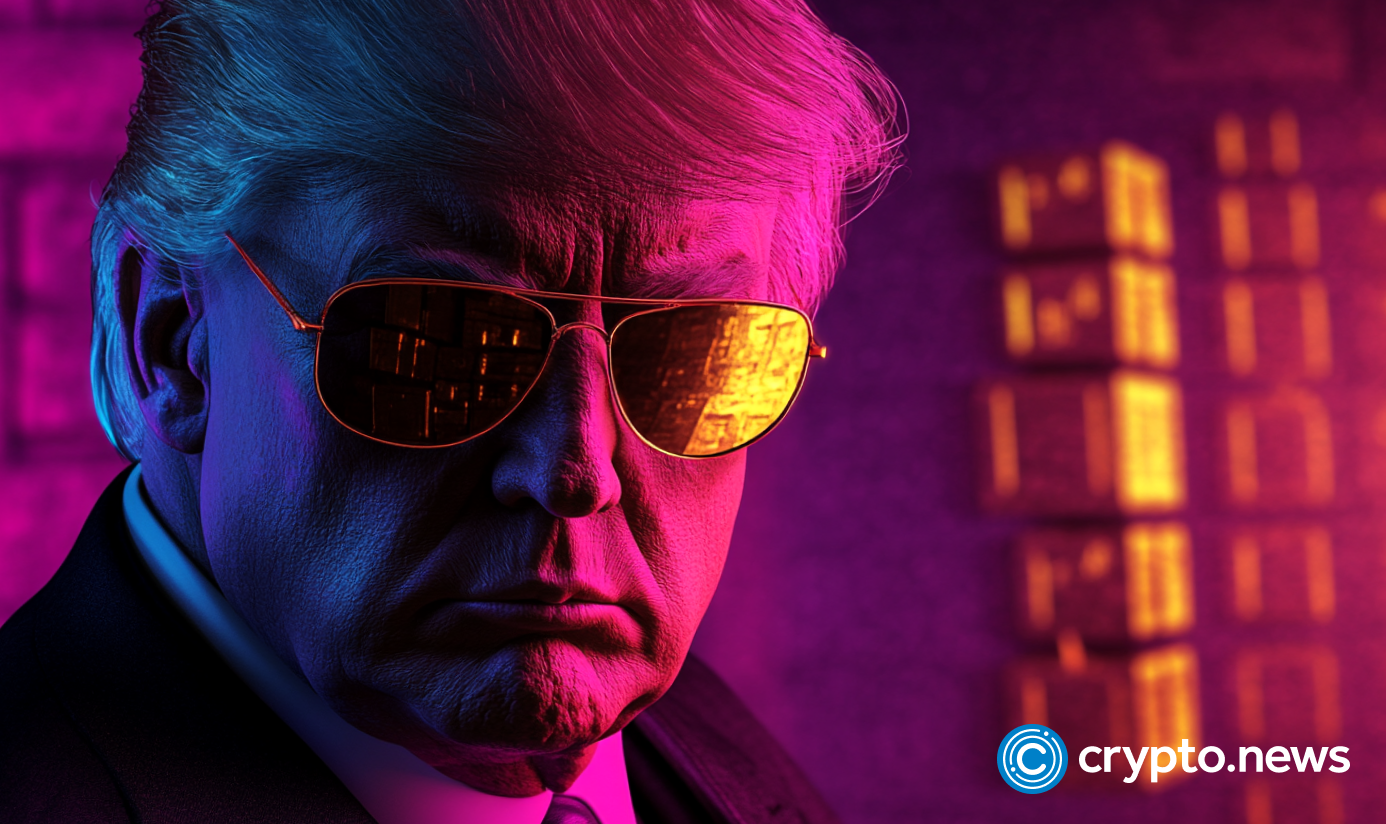

Canary Capital has amended its S-1 filing for a proposed spot Ripple (XRP) exchange-traded fund, removing a procedural clause that could clear the way for a November 13 launch.
The tweak is technical but meaningful: by eliminating the “delaying amendment,” the fund could become automatically effective under the 20-day statutory waiting period unless the SEC intervenes.
Canary’s latest submission to the Securities and Exchange Commission (SEC) removes language that usually allows the agency to control the effective date of a registration.
In practical terms, the fund is now positioned to become effective automatically after twenty days under Section 8(a) of the Securities Act of 1933 — a path several recent altcoin ETFs have followed.
Journalist Eleanor Terrett flagged the amendment in a social media post, noting that the change now sets up a possible November 13 launch.
🚨SCOOP: @CanaryFunds has filed an updated S-1 for its $XRP spot ETF, removing the “delaying amendment” that stops a registration from going auto-effective and gives the @SECGov control over timing.
This sets Canary’s $XRP ETF up for a launch date of November 13, assuming the… pic.twitter.com/MKvEN23t5P
— Eleanor Terrett (@EleanorTerrett) October 30, 2025
The fund, however, still needs Nasdaq to clear a Form 8-A listing.
If Nasdaq greenlights the 8-A and the SEC staff does not raise new comments, the statutory clock would make November 13 a realistic target.
Despite the procedural move, the timeline is not guaranteed.
The SEC could still issue comments that require Canary to amend its filing again, which would push the effective date back.
The broader reopening of government operations adds a further variable: staff availability and review priorities could either accelerate or delay finalisation.
SEC Commissioner Paul S. Atkins recently expressed support for issuers using the auto-effective route during periods when agency operations slow.
He praised the legal mechanism behind the 20-day waiting period, noting it as a long-standing option for issuers.
While Atkins did not comment directly on Canary’s filing, his remarks suggest a regulatory environment that — at least in principle — can accommodate automatic effectiveness when filings are in order.
Even before this XRP ETF wins full approval, the market for XRP-linked ETF products has been busy.
Several funds already trade, including leveraged and volatility products from providers such as Teucrium, Volatility Shares, Rex-Osprey, ProShares, and Purpose.
These offerings have drawn meaningful inflows, highlighting investor appetite for XRP exposure through ETF wrappers.
Teucrium’s leveraged XRP product in particular has accumulated substantial assets, while Rex-Osprey’s recently launched fund crossed the low hundreds of millions in assets under management.
A wider slate of issuers, including some of the industry’s larger names, has pending applications, suggesting further competition if Canary’s product does reach market first.
The post Canary Capital updates its XRP ETF application, eyeing November 13 launch appeared first on CoinJournal.

Blockchain security firm PeckShield has reported that the exploiter behind the 2024 Radiant Capital hack has moved 5,400 Ethereum (ETH) tokens.
PeckShield shared the alert on October 31, 2025, noting that the substantial ETH transfer went to Tornado Cash.
The latest in the Radiant Capital hack coins movement comes over a year after the protocol was exploited.
Ethereum (ETH) traded around $3,832 at the time of writing, down 1.5% in the past 24 hours and 3.2% in the past week.
Lending protocol Radiant Capital suffered a major security breach on October 16, 2024, with $51 million in user funds drained from its pools on the Arbitrum and BNB Chain networks.
Following the incident, cybersecurity researchers linked the hackers to North Korean state-sponsored actors.
Radiant also sought help from law enforcement agencies, including the FBI.
Over the subsequent year, the funds have seen multiple movements indicative of laundering attempts.
On October 31, 2025, PeckShield alerted that the exploiter deposited 5,411.8 ETH, valued at approximately $20.7 million, into Tornado Cash.
#PeckShieldAlert #RadiantCapital Exploiter deposited 5,411.8 $ETH (worth ~$20.7M) into #TornadoCash. pic.twitter.com/Ouqiue0soF
— PeckShieldAlert (@PeckShieldAlert) October 31, 2025
This transfer involved a series of deposits in denominations of 0.1 ETH, 1 ETH, 10 ETH, and 100 ETH.
Onchain data shows the hacker’s address 0x0fa503e4…2e748ef9e sending the coins to the mixing service.
This transfer of over $20 million worth of Ether from the hacker’s address to Tornado Cash isn’t the first such movement.
On September 11, 2025, the suspected attacker moved 5,933 ETH (worth about $26.7 million at the time).
Again, through the mixer. Prior to that, on August 12, 2025, the hacker swapped 3,091 ETH for $13.26 million in DAI stablecoins, further diversifying the holdings.
There has also been a 2,834.6 ETH deposit to the mixing service via the Arbitrum bridge as the hackers break down the large heist into small batches.
In early October, blockchain security firm Elliptic revealed that North Korea-linked hackers had so far stolen more than $2 billion in crypto in 2025.
It is the North Korea-linked hackers’ “largest annual total on record,” Elliptic noted.
Notably, these attackers have cumulatively stolen over $6 billion in crypto.
“The majority of the hacks in 2025 have been perpetrated through social engineering attacks, where hackers deceive or manipulate individuals in order to gain access to cryptocurrency,” the firm noted.
The post Radiant Capital hacker transfers 5,400 ETH to Tornado Cash: PeckShield appeared first on CoinJournal.

Revolut has introduced fee-free, 1:1 USD-to-stablecoin conversions, eliminating traditional costs and spreads and allowing the company’s 65 million users to exchange US dollars for USDT or USDC across multiple blockchains at no extra cost.
The new feature enables Revolut users to convert USD directly into Tether (USDT) or USD Coin (USDC) on a true one-to-one basis.
Customers can swap up to $578,000, or roughly €500,000, over a 30-day rolling period without paying any fees or spreads.
For every dollar deposited, users receive a matching stablecoin amount, effectively removing the pricing anxiety and conversion friction that typically come with moving between fiat and crypto.
The service supports transactions across six major blockchain networks, including Ethereum, Solana, and Tron, giving users flexible routing options.
The app automatically handles the technical steps, letting customers pick their destination chain without dealing with complex bridging or on-chain settlements.
Revolut’s Head of Product for Crypto, Leonid Bashlykov, described the rollout as a major leap toward making crypto access seamless.
Bashlykov said the company is covering the spread internally to guarantee exact 1:1 conversions, provided the stablecoins maintain their dollar peg.
Revolut’s in-app swap feature mirrors the company’s earlier approach to foreign exchange, which set a new standard for transparent, real-time conversions in digital banking.
Just as Revolut made zero-commission FX trading mainstream a decade ago, it now aims to make stablecoin swaps just as simple and accessible.
The fintech clarified that while the in-app conversion is completely free, standard network gas fees or withdrawal costs may still apply when tokens move off-platform.
Even so, the elimination of spreads and conversion fees marks a rare example of a financial institution fully absorbing costs to simplify crypto adoption.
For small and medium-sized businesses, particularly in regions facing currency instability, the implications are significant.
Venture capitalist Elbruz Yılmaz noted that Revolut’s clean one-to-one ramp “turns stablecoins from a speculative asset into working capital infrastructure,” helping businesses reduce foreign exchange losses and speed up payment cycles.
The rollout builds on a strong year for Revolut’s wealth division, which includes crypto trading, commodities, and savings.
The segment posted a 298% jump in revenue in 2024, reaching £506 million, driven largely by growing demand for digital asset products.
The company’s full-year results showed a record £1.1 billion in profit and total revenue of £3.1 billion, underscoring its evolution from a digital bank into a global financial powerhouse.
Much of that momentum stems from Revolut X, the firm’s professional trading platform launched in 2024.
Offering over 100 tokens with zero maker fees and minimal taker fees, Revolut X positioned the fintech as a direct competitor to established crypto exchanges.
Its expansion to 30 European countries later that year strengthened the company’s foothold in the region.
With its new 1:1 stablecoin conversion, Revolut has not only removed a major barrier to digital asset adoption but has also redefined what a modern neobank can offer.
In doing so, it positions itself at the intersection of traditional banking and the decentralized financial future that is rapidly taking shape.
The post Revolut rolls out 1:1 USD-to-stablecoin swaps with zero fees or spreads appeared first on CoinJournal.

AI16Z price is up by more than 11% in the past 24 hours and currently ranks among the altcoins defying broader cryptocurrency market downside pressure.
In the last 24 hours, altcoins such as Zcash and GHOST have gained as the privacy-coin narrative persists.
ai16z has also gained and is among the digital tokens that are looking to thrive on the back of major network support.
One of the likely catalysts for ai16z price in the past 24 hours appears to be Binance’s endorsement of the AI16Z to ELIZAOS token swap.
The exchange, the world’s largest by trading volume, is set to suspend AI16Z trading on its Binance Alpha platform on November 6, 2025.
According to details, the brief halt in trading will allow the exchange to facilitate the transition.
Specifically, Binance will support the token swap at the ratio of 1 AI16Z to 6 ELIZAOS.
“At 2025-11-06 10:00 (UTC), deposits of AI16Z tokens to Binance Alpha 2.0 Accounts will be suspended. Users should ensure they leave sufficient time for their AI16Z deposits to be fully processed prior to this time. After the event is complete, deposits of AI16Z will no longer be supported,” Binance wrote.
Trading of the elizaOS (ELIZAOS) token will resume at 2 pm UTC on Nov. 7, with users also able to deposit to their accounts.
ElizaOS began as the memecoin ai16z (AI16Z) inspired by the tech venture capital firm Andreessen Horowitz (a16z).
However, it has since transitioned to become one of the leading agentic operating systems, rebranding from ai16z to ElizaOS in January 2025.
The project’s token is issued on Solana’s network and allows for ElizaOS governance, AI agents payments and ecosystem rewards.
ElizOS leverages decentralized governance via its decentralized autonomous organization model and features AI-driven governance.
The token is also up amid a broader bullish outlook for artificial intelligence-related cryptocurrencies, with AI16Z price up more than 17% this past week.
Bulls have pushed this token from intraday lows of $0.055 to above $0.069.
If bullish momentum holds, the altcoin could target October 2025 highs above $0.10.

Daily volume is up 49% to over $62 million. Meanwhile, AI16Z has a total supply of 1.1 billion tokens, with a market cap of $76.4 million.
Given, some coins are seeing fresh momentum despite Bitcoin’s crash to lows of $106k on Thursday.
While the benchmark digital asset has since recovered to around $110,000 in early trading Friday, it is in the red on the day.
Top alts Ethereum, XRP and Solana are also battling as bulls attempt to reclaim key price zones.
The post ai16z gains as Binance announces AI16Z to ELIZAOS token swap appeared first on CoinJournal.


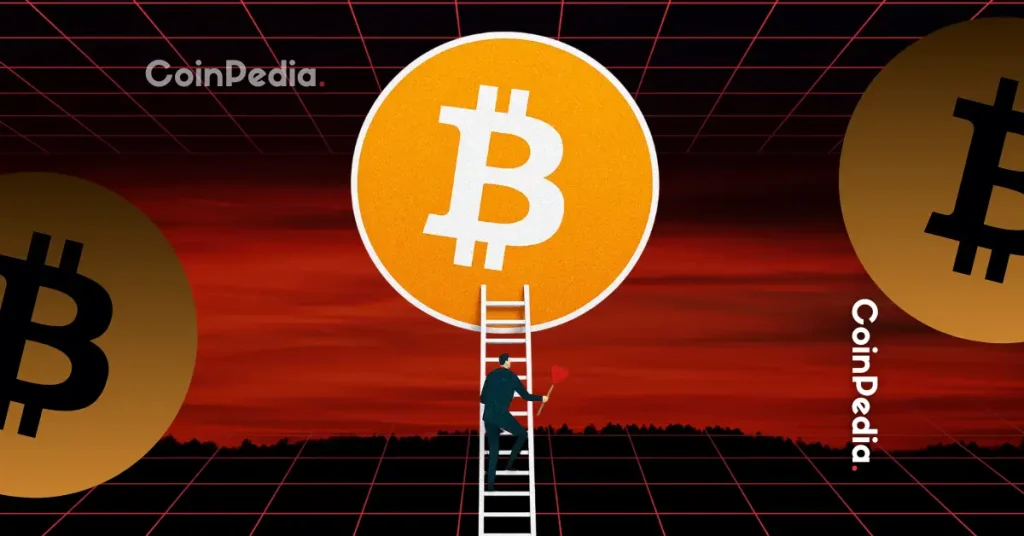
The post Is It Too Late to Buy Bitcoin and Crypto in 2025? appeared first on Coinpedia Fintech News
Early October, Bitcoin hit a new all-time high of over $126,270. ETFs are breaking records, institutional buying continues increasing, and yet the market still swings wildly.
There’s never been a year like 2025 for crypto. The market finally looks mature, with Trump’s advocacy and regulatory clarity.
For many retail investors, that raises the big question – is it too late to get in?
Asking whether it’s too late misses the point as Bitcoin isn’t a quick trade anymore, instead it’s a long-term asset. The smarter question is: what role should it play in your portfolio?
Over the past few years, Bitcoin has shifted from being a speculative token to a strategic asset that many investors use as a hedge against inflation and currency weakness.
For anyone thinking beyond the next bull run, what matters is time in the market, not timing the market.
Institutional money has poured in this year.
Early October saw record weekly global ETF inflows of ~$5.95B, helping push Bitcoin to new highs, according to Reuters.
A few days later, a sharp sell-off on October 10-11 erased ~$19B in open interest and affected around 1.6M traders, which was one of the largest wipeouts in crypto history.
Bitcoin now sits in the portfolios of global asset managers, but the market structure is still fragile.
Despite the rollercoaster, adoption keeps expanding.
Chainalysis’ 2025 Global Adoption Index shows countries like India, the U.S., and Brazil leading in crypto usage. The State of Crypto 2025 report by a16z also highlights that regulated products and better infrastructure are now driving long-term capital into the space.
On the tech side, upgrades like Taproot and the Lightning Network are making Bitcoin faster and more usable, pushing it beyond the “digital gold” tag and closer to real-world utility.
Investors don’t need to bet everything to participate. Dollar-cost averaging, which is investing a fixed amount regularly, helps smooth volatility and reduce stress. Treat Bitcoin as a small, steady allocation: 1-5% for conservative investors, up to 10% for those with higher risk tolerance.
And security matters. Hardware wallets, strong passwords, and 2FA should be non-negotiable for anyone holding crypto long-term.
Bitcoin has come a long way from its early days. But calling it “too late” ignores how far adoption, infrastructure, and global integration have come. The opportunity today should not be seen as chasing quick profits, but entering the market with a plan.
As long as you remain disciplined and back your investments with research, you are likely to continue benefiting from the market.
Stay ahead with breaking news, expert analysis, and real-time updates on the latest trends in Bitcoin, altcoins, DeFi, NFTs, and more.
As per Coinpedia’s BTC price prediction, the Bitcoin price could peak at $168k this year if the bullish sentiment sustains.
With increased adoption, the price of Bitcoin could reach a height of $901,383.47 in 2030.
As per our latest BTC price analysis, Bitcoin could reach a maximum price of $13,532,059.98
By 2050, a single BTC price could go as high as $377,949,106.84
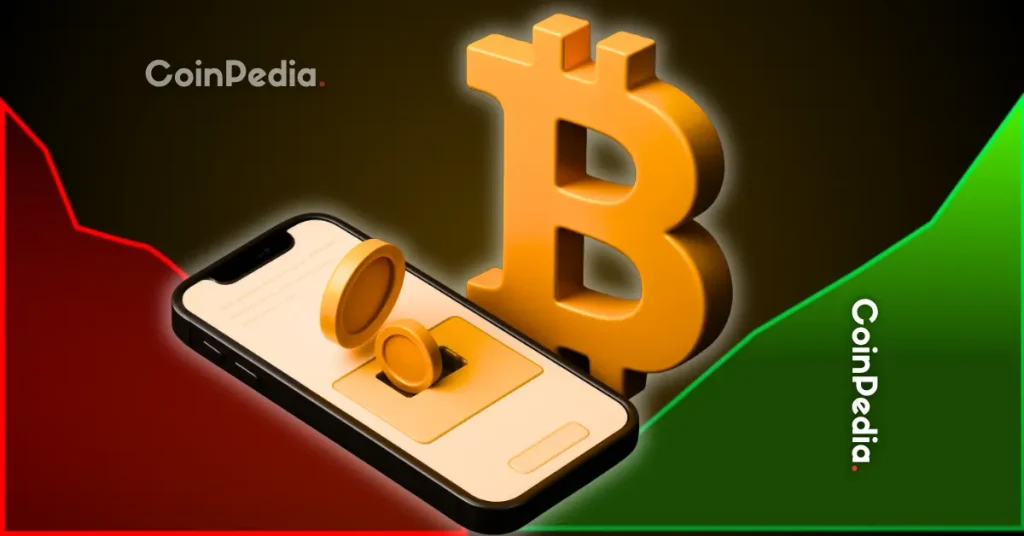
The post Venezuela Banking Giant to Integrate Bitcoin and USDT Soon appeared first on Coinpedia Fintech News
Venezuela is getting ready to take a big step by joining traditional banking with digital assets. Conexus, one of the country’s largest payment companies, works to integrate Bitcoin and stablecoins directly into the national banking system.
If successful, the Conexus model might inspire other nations to follow.
For years, Venezuela has battled a collapsing currency and runaway inflation, forcing many citizens to turn to cryptocurrencies for financial stability. Meanwhile, Conexus, which already processes nearly 40% of the nation’s electronic transfers, now plans to make a key part of Venezuela’s financial network.
Now, the company wants to go further by allowing local banks to provide direct crypto services, including custody, transfers, and fiat exchange for Bitcoin and stablecoins.
The initiative is set to launch in December 2025, marking a major leap in Venezuela’s financial modernization. If successful, it would make Venezuela one of the first countries in the world to fully integrate crypto into its national banking network.
据 Bitcoin com 报道,委内瑞拉支付公司 Conexus 正开发一套系统,将比特币与稳定币纳入全国银行网络。该公司处理约 40% 的电子转账业务,计划让银行可直接提供加密资产的托管、转账及法币兑换服务。总裁 Rodolfo Gasparri 表示,由于本国货币剧烈贬值,越来越多民众使用 USDT…
— 吴说区块链 (@wublockchain12) October 31, 2025
According to Conexus President Rodolfo Gasparri, Venezuela’s national currency, the bolivar, has sharply depreciated, pushing more citizens toward stablecoins like USDT (Tether). Many Venezuelans now use these digital dollars to protect their money from inflation and to carry out daily transactions.
Gasparri noted that this growing trend shows the need for a smoother, more secure bridge between banks and the crypto world.
The new system will let users handle crypto directly through their bank accounts, without external apps. Built on blockchain, it aims to make transactions safer and build trust in regulated crypto use.
Analysts believe Conexus’s plan could reshape Venezuela’s financial landscape. By merging traditional banking with crypto. As of now company is building a bridge between fiat and digital money, something that could help millions gain easier access to stable and low-cost financial tools.
If successful, it could become a model for other nations battling currency instability.
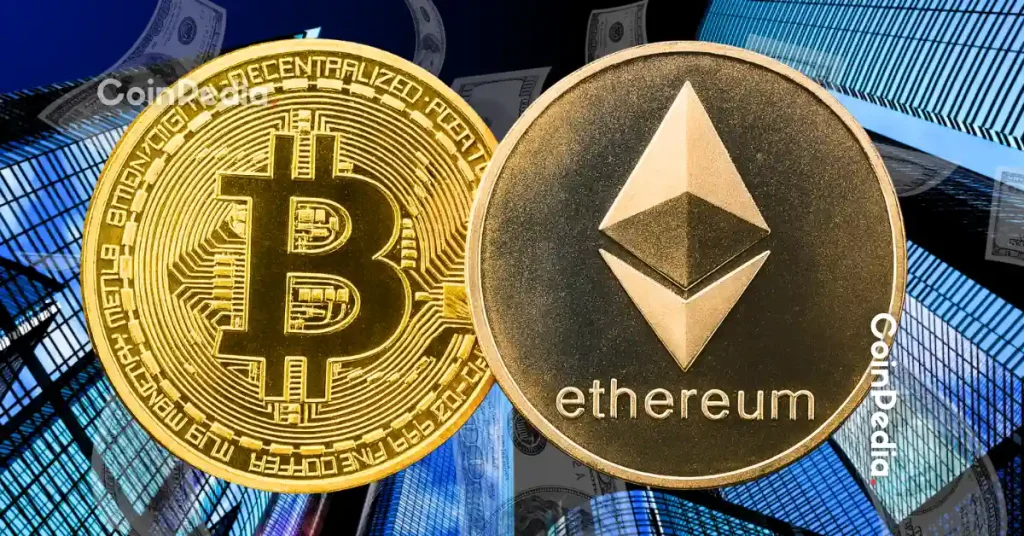
The post Why Is Crypto Crashing? Analyst Reveals What Comes Next for BTC and ETH appeared first on Coinpedia Fintech News
The crypto market entered the week with excitement, expecting rate cuts from the Federal Reserve to spark a rally. Instead, traders were left confused. Despite a rate cut and signs of quantitative tightening ending soon, Bitcoin and Ethereum both fell sharply.
This reaction surprised many. Historically, lower rates and easier liquidity boost risk assets like crypto. But this time, the market did not respond. Analysts say this unusual behavior shows a deeper technical setup rather than a fundamental shift.
Bitcoin started the week trading near $115,000 but quickly lost momentum. Analyst DataDash said that once BTC gave up the $114,000 support level, a sharp drop followed. This pattern is often seen after major rallies.
Bitcoin is now expected to move between $97,000 and $120,000 in the short term. This sideways movement reflects uncertainty, not weakness. Once the market digests recent macro developments, Bitcoin could rebound strongly.
Part of the reason for the market’s hesitation is the Fed’s tone. Chairman Jerome Powell hinted that no further rate cuts are likely in December, warning about inflation and economic stability. This conservative stance spooked investors, leading to risk-off behavior across markets, including crypto.
Still, analysts argue that these developments are not bearish in the long run. With quantitative tightening expected to end soon, liquidity could improve in early 2026, supporting higher crypto valuations.
Ethereum followed a similar path. After briefly testing higher levels around $3,900, ETH fell to the $3,700 region. Despite this correction, the analyst says Ethereum remains in a healthy range as long as it stays above $3,300.
In the short term, ETH is expected to trade sideways. But in the bigger picture, analysts see potential for a move toward $5,000 to $7,000 between November and early next year, especially with growing demand for tokenized securities and institutional adoption.

The post Venezuelan Banks to Support Bitcoin and Stablecoins appeared first on Coinpedia Fintech News
Conexus, handling around 40% of Venezuela’s electronic transfers, is developing a system to integrate Bitcoin and stablecoins like USDT into the country’s banking network. This new platform will allow banks to offer custody, transfers, and fiat exchange services for crypto assets with bank-level security. The initiative responds to the growing local demand for stablecoins as a hedge against currency devaluation. The system is expected to launch in December 2025, marking a major step in Venezuela’s digital finance evolution.
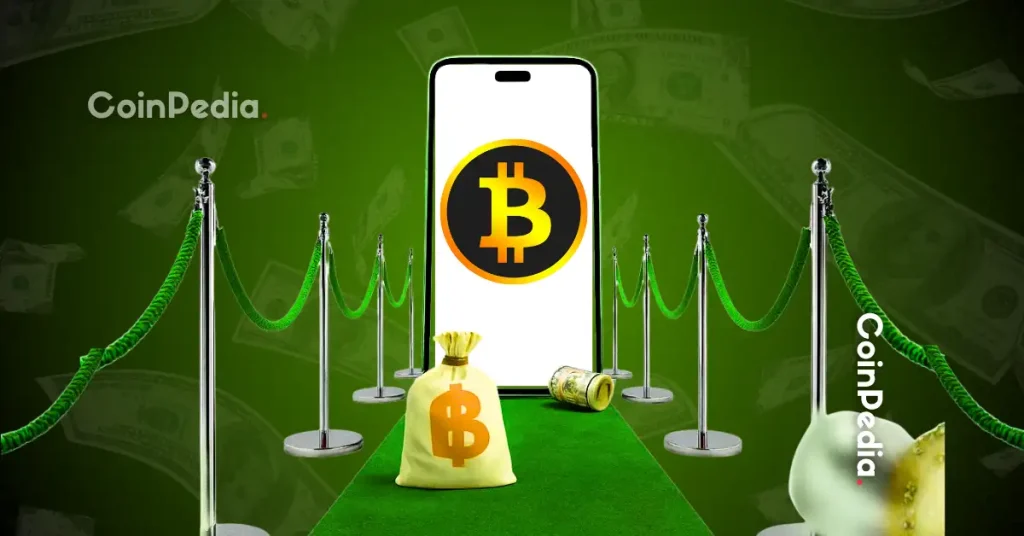
The post Bitcoin White Paper 17th Anniversary: BTC Entering Adulthood appeared first on Coinpedia Fintech News
As the Bitcoin white paper marks its 17th anniversary, the world reflects on how a simple email from Satoshi Nakamoto transformed global finance. Seventeen years in, BTC crypto is now leaving its adolescence and entering adulthood. From its humble beginnings at $0.00076 to today’s Bitcoin price USD of over $109,980, Bitcoin’s story displays the world’s largest rise of a decentralized financial revolution.
On October 31, 2008, Satoshi Nakamoto introduced the Bitcoin white paper to a mailing list of cryptography enthusiasts under the subject line “Bitcoin P2P e-cash paper.”
The mail was pretty brief, describing a peer-to-peer digital currency system. This laid the groundwork for what BTC has turned out to be today, as the world’s first decentralized monetary network.
Just over a couple of months later, in early 2009, the first Bitcoin block, known as the Genesis Block, was mined. That began as a small experiment, which later evolved into a financial revolution.
In its early days, Bitcoin crypto traded at mere fractions of a cent on platforms like New Liberty Standard in 2009, according to a Reddit discussion post, where a single BTC was valued at just $0.0007639.
Fast forward to 2025, and the Bitcoin price chart tells a completely jaw-dropping and bone-breaking story. Today’s Bitcoin price USD is near $109,890, representing an astronomical 14.6 million percent gain since its inception. This is an achievement unmatched in the history of modern finance, having surpassed every shiny metal in existence in terms of the fastest gains.
“Seventeen years to the Bitcoin Whitepaper! This isn’t just an anniversary; it’s the moment when the entire crypto space transitioned from idea to reality.
It still holds the crown, accounting for over half of the market cap, and every innovation we see can be traced back to that one document. The legacy is simple: the future of finance is built on transparency, technology, and the collective belief in an open system.“-Edul Patel, CEO of Mudrex.
Over the past 17 years, perceptions around Bitcoin have undergone a complete transformation. What was once dismissed by institutions and governments is now recognized as a strategic asset of importance.
As a result of its demand, the price has increased significantly, which is clear evidence of this. Major corporations now hold Bitcoin in their treasuries, while nations like US, China, El Salvador, and others have integrated it into their official reserves.
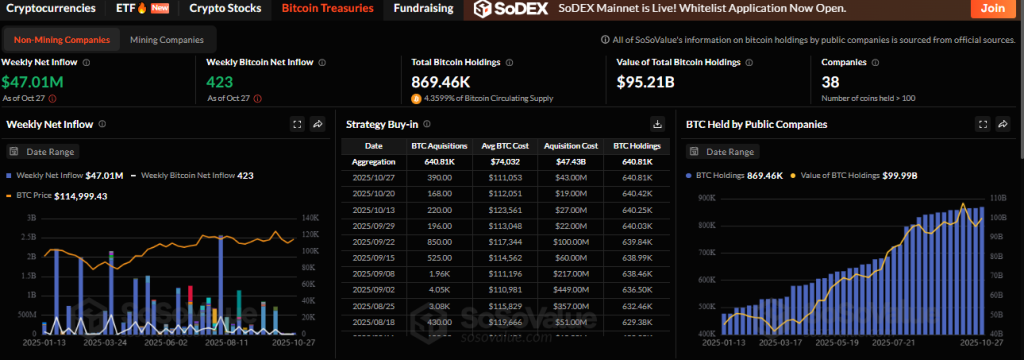
The launch of spot Bitcoin ETFs in Q1 2024 marked another significant shift, providing institutional investors with secure, regulated exposure to BTC. The BTC ETF total net assets have reached $143.94 billion with 12 ETF issuers.
This move strengthened Bitcoin’s legitimacy and deepened its integration into global financial systems. The Bitcoin white paper 17th anniversary arrives at a time when Bitcoin commands a $2.18 trillion market cap and dominates 59.4% of the entire crypto market.
Its scarcity is even more attractive than gold. With a hard cap of 21 million coins, its value proposition as “digital gold” has only grown stronger. This remained Bitcoin’s defining feature, and its fast growth on its Bitcoin price chart is clear evidence.
Combined with growing institutional frameworks and an inflation-hedge narrative, Bitcoin continues to attract new waves of capital amid global economic uncertainty.
Despite recent volatility, Bitcoin price today remains resilient, holding firm near $109,980 even as global markets faced risks from the U.S. government shutdown. The Federal Reserve’s recent 25-basis-point rate cut, coupled with its decision to end quantitative tightening (QT) on December 1, 2025, could prove pivotal for Bitcoin’s next move.

If these monetary shifts inject new liquidity into markets, Bitcoin price prediction models point toward a potential retest of $120,000 in the short term or even a retest of its ATH level.
However, the long-term BTC narrative remains strongly bullish, with $126,296 being flipped, $135K would be the first target out of many higher.
As 2025 approaches its final months, the Bitcoin white paper legacy stands as a testament to resilience, innovation, and unstoppable global adoption.

The post Why the Crypto Market Is Down Today? Bitcoin, Ethereum, and XRP Price Lead Massive Drop appeared first on Coinpedia Fintech News
Bitcoin, Ethereum, XRP, and other major altcoins tumbled as the crypto market shed over $200 billion in value. In just 24 hours, more than $1.2 billion in long positions were liquidated, sending shockwaves across traders. The crash came right before a massive Bitcoin and Ethereum options expiry worth over $16 billion, leaving investors anxious about what’s next.
The latest dip appears to be driven by traders and large institutions taking profits ahead of the October 31 options expiry. Data from CME and Deribit indicate that these derivative contracts have a strong influence on short-term price movements.
On Deribit alone, over 123,000 Bitcoin options worth $13.52 billion are set to expire. With a put-call ratio of 0.70 and a max pain price near $114,000, dthe ata suggests potential upside after expiry. However, in the past day, put volumes surpassed call volumes (1.35 ratio), signaling that traders are hedging for further downside. Still, some analysts expect Bitcoin to rebound above $112,000 once the expiry concludes.
Crypto analyst Miles Deutscher attributes Bitcoin and Ethereum’s weakness to several factors. He highlighted an ongoing “DAT unwind,” where digital asset trusts are protecting their values, adding mild selling pressure. Additionally, ETF demand has cooled, with consistent outflows in recent weeks reflecting a temporary lack of institutional interest.
Deutscher also noted that October 10 inflicted lasting damage on the market — as market makers unwound positions, retail confidence eroded, and sentiment hit rock bottom. However, he believes a single strong Bitcoin rally could reverse the trend. Historically, Bitcoin often tracks equity market momentum, and with stocks hitting new highs, a “catch-up rally” wouldn’t be surprising.
Deutscher urged traders to use this quiet market phase to explore emerging sectors such as x402, robotics, real-world assets (RWA), and prediction markets. He emphasized that the best opportunities often arise when most traders have stepped back from the market.
According to on-chain analytics firm CryptoQuant, fading institutional demand and uncertainty over U.S. monetary policy are the main drivers behind the recent downturn. The Coinbase Premium Gap turned negative, signaling weak U.S. buying activity.
However, CryptoQuant expects liquidity conditions to improve once the Federal Reserve officially ends quantitative tightening, which could boost risk appetite heading into 2026.
Stay ahead with breaking news, expert analysis, and real-time updates on the latest trends in Bitcoin, altcoins, DeFi, NFTs, and more.
Yes, Bitcoin often leads market trends. Its recent drop, driven by massive options expiries and weak ETF demand, has created a domino effect, causing major altcoins like Ethereum and XRP to tumble in its wake.
Absolutely. Uncertainty over U.S. monetary policy and the Federal Reserve’s stance has weakened institutional risk appetite, directly impacting crypto liquidity and contributing to the recent market downturn.
The total crypto market capitalization shed over $200 billion in a 24-hour period, a sharp decline that led to the liquidation of more than $1.2 billion in leveraged long positions.
Some analysts expect a potential rebound after the options expiry concludes. A catch-up rally could occur if Bitcoin follows equities higher, with improved liquidity conditions possible into 2026.
Traders should monitor the post-options expiry price action for a potential rebound, track Bitcoin’s correlation with the stock market, and research emerging sectors like real-world assets (RWA) and AI.

The post Cardano Price Breakdown, Can ADA Hold $0.55 After Losing $0.61 Support? appeared first on Coinpedia Fintech News
Cardano’s price action this week has left traders on edge as the much-watched $0.61 support finally buckled. This move came amid a fresh wave of risk aversion across crypto, highlighted by the Fear & Greed Index plummeting to just 31.
In the span of 72 hours, Cardano whales holding 100 million to 1 billion ADA offloaded more than $100 million worth of tokens. Thereby, sparking a wave of liquidations that included $15.9 million in short positions being squeezed around the $0.666 mark. As the dust settled, ADA’s price found itself on shaky ground, with traders now eyeing technicals for any early signs of opportunity.
After days of relentless selling, ADA price currently trades at $0.6117, down 3.42% on the day and nearly 6% for the week. The 24-hour trading volume nudged up by 0.5% to $1.18 billion. The breakdown below the $0.61 Fibonacci 50% retracement not only invalidated Cardano’s multi-month sideways trend but also positioned the altcoin at a crossroads among traders.
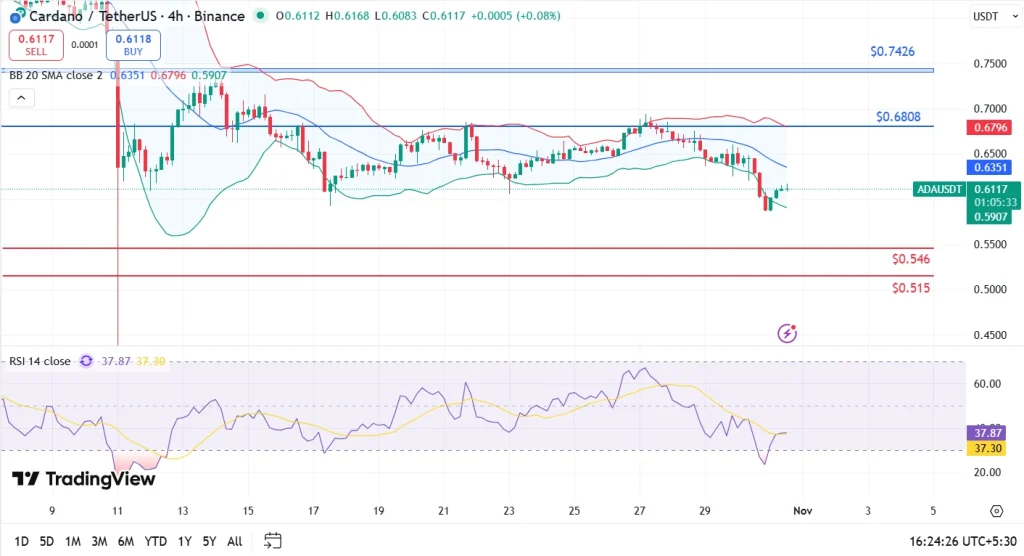
The 200-day SMA sits way above at $0.7426, marking a significant resistance level that bulls must reclaim for upside momentum to return. More immediately, the $0.6808 area reinforces the upper Bollinger band that any relief rally will need to overcome.
Looking at indicators, the RSI hovers at 35.1. This signals an oversold market, yet there is no concrete sign of a bottom or reversal as bears continue to drive sentiment. The MACD histogram has just flipped positive at +0.0029, suggesting a hint of short-term relief but not yet a confirmed change in trend.
If the current price fails to hold, eyes turn to the next vital support at $0.546, which lines up with the 2025 swing low. A sustained move below this level might expose ADA to a deeper slide, while a bounce from here could trigger a round of short covering and potentially set up a relief rally if volume supports the move.
Large holders rapidly sold over $100 million in ADA in just three days, which led to a technical breakdown and a cascade of liquidations.
Yes, the RSI is hovering around 35, which signals an oversold market, but there is still no definite sign of a trend reversal at this stage.
Immediate support rests at $0.546, with $0.515 as a deeper backstop. The 200-day SMA near $0.74 remains a distant upside target.
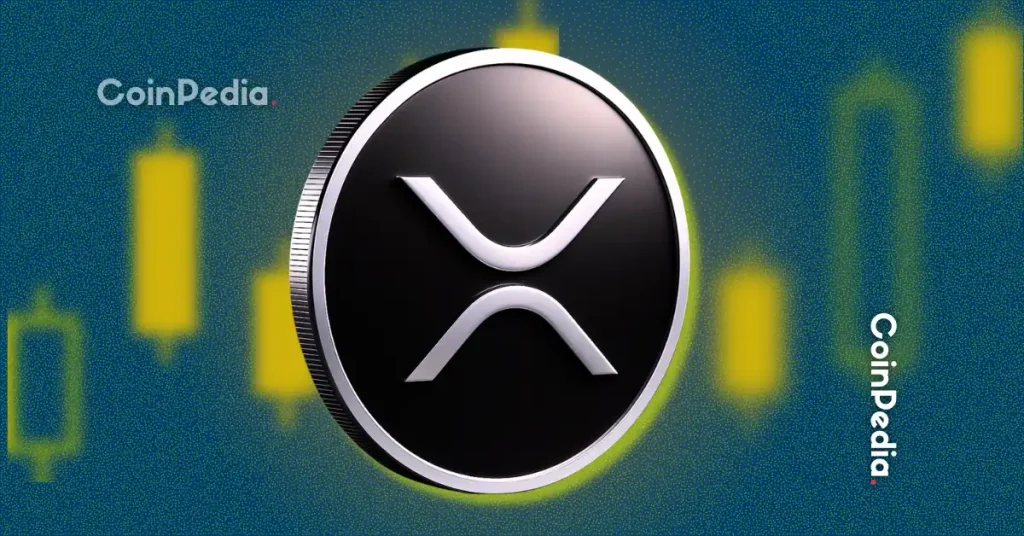
The post XRP News: Should Retail Investors Exit as Ripple Targets Wall Street? appeared first on Coinpedia Fintech News
Ripple’s recent acquisitions and partnerships are revealing a larger strategy that appears to move far beyond the retail market. While many early investors viewed XRP as an digital asset for individuals, the company’s ongoing moves hint its real focus is on institutions, banks, and global financial systems.
On the Paul Barron Podcast, the host discussed how Ripple’s acquisition of Hidden Road was a big signal. The deal allows financial giants such as BlackRock and other Wall Street players to gain access to improved prime brokerage services using Ripple’s infrastructure.
Ripple has also made strategic moves with GTreasury and Evernorth, both of which enhance its footprint in digital asset treasury management.
According to Jesse from Apex Crypto Consulting, XRP was never intended for retail speculation in the first place. He described it as the digital successor to Special Drawing Rights (SDRs), a global reserve asset issued by the IMF.
This perspective could mean that XRP could eventually serve as a global stable asset, backed by institutional reserves or financial instruments, forming the foundation for a new “digital Bretton Woods” system, a modern version of the global reserve framework established after World War II.
Documents from global organizations, including the World Bank, have already referenced XRP and Stellar (XLM) as potential stablecoins. While these assets are not currently pegged to any currency, such classification implies that they could be backed or stabilized by reserves in the future, aligning with Ripple’s long-term institutional focus.
The expert argues that retail investors were never the main target for Ripple — they were simply part of the early phase to generate liquidity and kickstart market adoption.
Years ago, a Ripple executive mentioned that retail traders helped “get the ball rolling,” but the company preferred less noise and volatility, focusing instead on enterprise-grade applications. Hence, the expert concluded that retail participation provided initial exchange liquidity, but the endgame has always been global financial integration.
Stay ahead with breaking news, expert analysis, and real-time updates on the latest trends in Bitcoin, altcoins, DeFi, NFTs, and more.
Ripple’s strategy focuses on institutional and global finance use, not retail trading, aiming to power cross-border settlements for banks.
Ripple’s acquisition of Hidden Road expands access for major financial firms to use Ripple’s infrastructure for digital asset brokerage.
Not primarily. Retail users helped build liquidity, but Ripple’s long-term goal centers on institutional adoption and global financial systems.
Analysts and AI forecasts project XRP could reach $5.05 by the end of 2025, driven by ETF approvals, partnerships, and regulatory clarity.

The post Binance Backs AI16Z Rebrand to ELIZAOS appeared first on Coinpedia Fintech News
Binance will support the token swap, redenomination, and rebranding of ai16z (AI16Z) to elizaOS (ELIZAOS) starting November 6, 2025. During this period, trading of AI16Z will be temporarily suspended on Binance Alpha 2.0, and all AI16Z tokens will be automatically converted to ELIZAOS at a 1:6 ratio. The process aims to expand the token supply from 6.6 billion to 11 billion and improve ecosystem liquidity and growth. Trading is expected to resume on November 7, 2025.
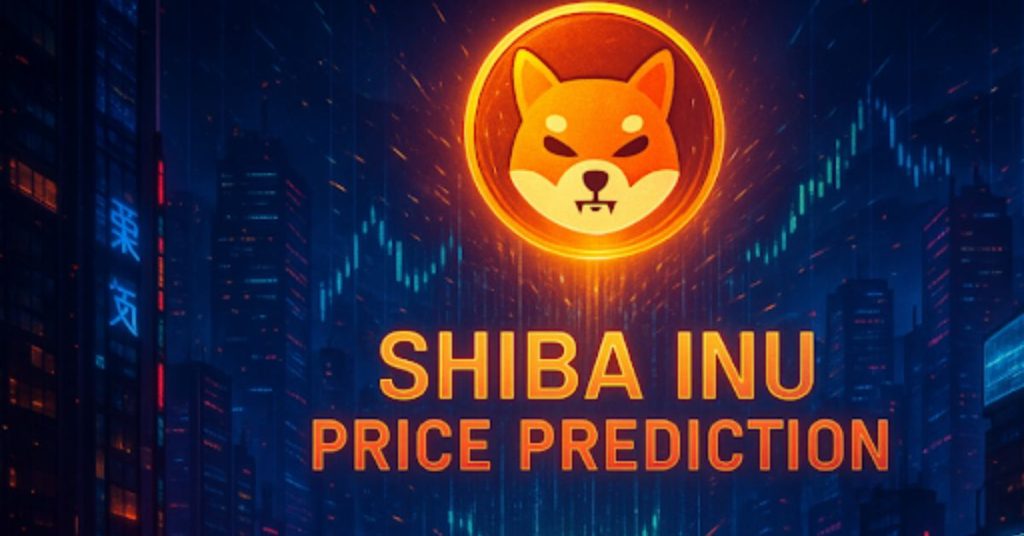
The post SHIB Price Forecast: Whales Choose PEPE Over SHIB, but This Breakout Altcoin May Outperform Both appeared first on Coinpedia Fintech News
In a not-so-surprising turn of events, on-chain data has indicated that the whales are choosing PEPE over SHIB. While PEPE appears to be the choice of meme enthusiasts, expert investors are looking at a dark horse in the form of a new PayFi sensation, RTX, which they believe will outperform both for the rest of 2025.

According to Investtech’s Shiba Inu Price prediction, SHIB is in a horizontal trend channel in the medium-long term. A continued bearish rally is indicated, and SHIB is faced with resistance.
While some investors are optimistic about SHIB and Pepe coin, it’s an unwise investment move in 2025. Although meme coins were once the hottest altcoins, especially during the 2021 bull run, now they’ve run out of momentum.
Like typical meme coins, both altcoins offer no utility; they ride on hype and trends, which have waned. The Meme coin market cap, which once stood at over $67 billion, is pegged today at $45 billion.
The drop in meme coin interest is also sponsored by the broader diversification into utility-driven projects. Investors are aware that meme coins often follow the market tide and are heavily affected during bearish periods, which is why they choose projects that can withstand market fluctuations.
Analysts believe that the next 1,000x will come from utility-focused projects, especially Payfi solutions, like Remittix, due to the increasing adoption of cryptocurrency as a mode of payment.
Remittix (RTX) is positioned to disrupt the global remittance industry. It’s bridging a $19 trillion payment gap between traditional payment systems and cryptocurrency.
It facilitates cross-border crypto-to-fiat transactions in over 30 countries and supports more than 40 cryptocurrencies. Users send cryptocurrency, which is converted using the live FX rate on the app and deposited directly into their bank accounts as fiat.
Remittix offers numerous earning opportunities for its users. Users can earn a 15% reward for referring a new buyer (15% of the referral purchase back in USDT).
Remittix highlights:
Discover the future of PayFi with Remittix by checking out their project here:
Website: https://remittix.io/
Socials: https://linktr.ee/remittix
$250K Giveaway: https://gleam.io/competitions/nz84L-250000-remittix-giveaway







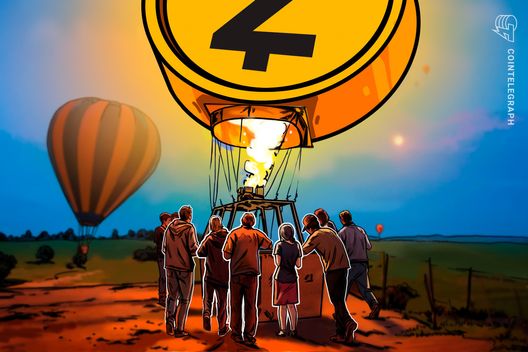
Zcash’s rally faces a test as a rising wedge pattern signals a possible 30% pullback toward the $260–$270 support zone in November.

The Australian Federal Police cracked a coded crypto wallet backup holding $5.9 million after a data scientist deciphered a complex numerical sequence on a phone.

“Uptober” has turned into a red month for Bitcoin, with Fed rate cut hopes and easing US-China trade tensions doing little to uphold BTC prices.

AllUnity’s euro-pegged MiCA-compliant stablecoin, EURAU, is expanding across major blockchains using Chainlink’s CCIP protocol.

EU's ProtectEU mandates on-device scanning before encryption, creating a two-tier security system where states encrypt while citizens are surveilled. Digital feudalism codified.
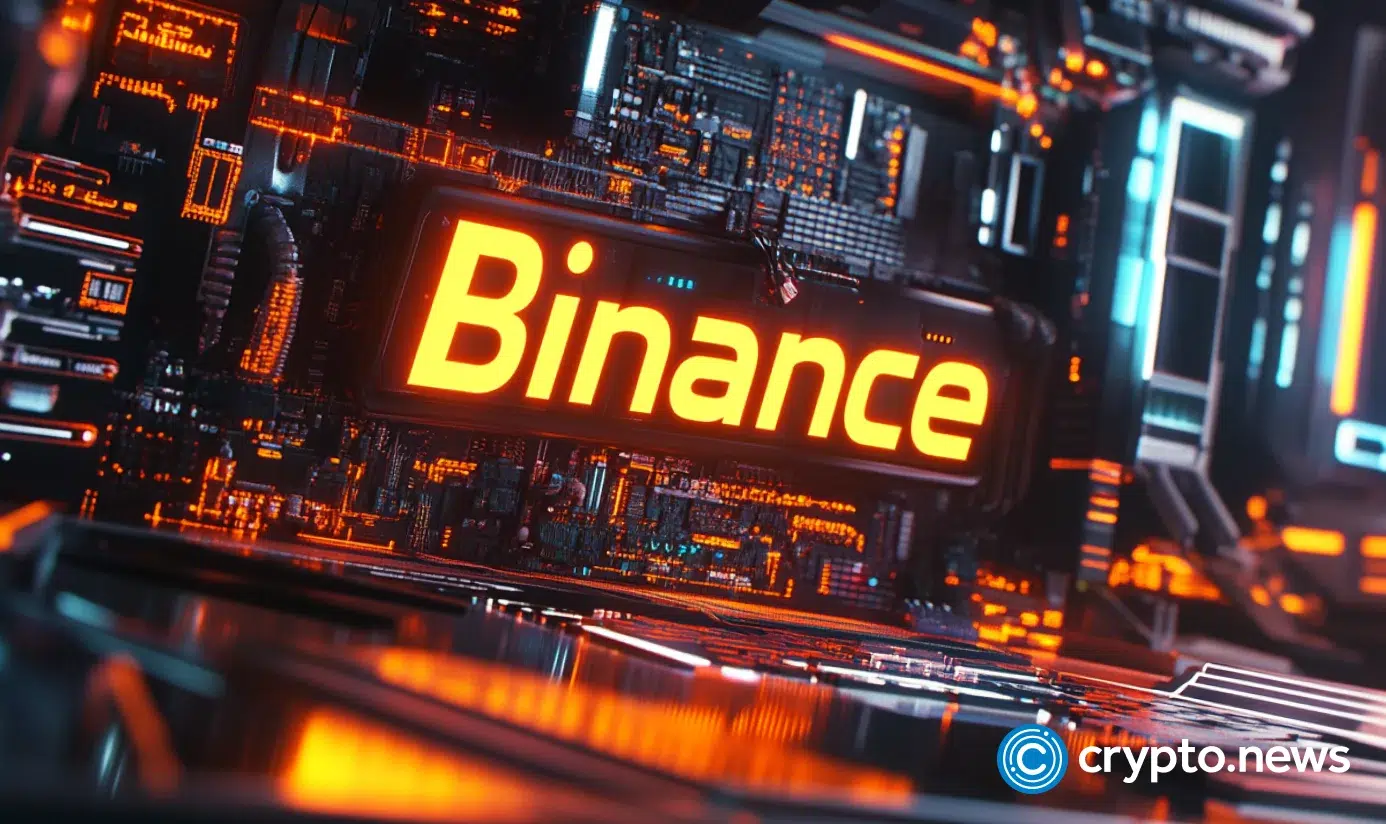
Coins.ph announced a partnership with BCRemit that will allow OFWs in the U.K., EU, U.S., and Canada to easily send money to the Philippines.
The post Coins.ph and BCRemit tie-up for fast, affordable money transfers from filipinos abroad appeared first on CoinGeek.
In his livestream after the London Blockchain Conference 2025, Kurt Wuckert Jr. shares what he learned and what the future of the blockchain looks like.
The post CoinGeek Weekly Livestream: ‘2026 is the big year’ appeared first on CoinGeek.
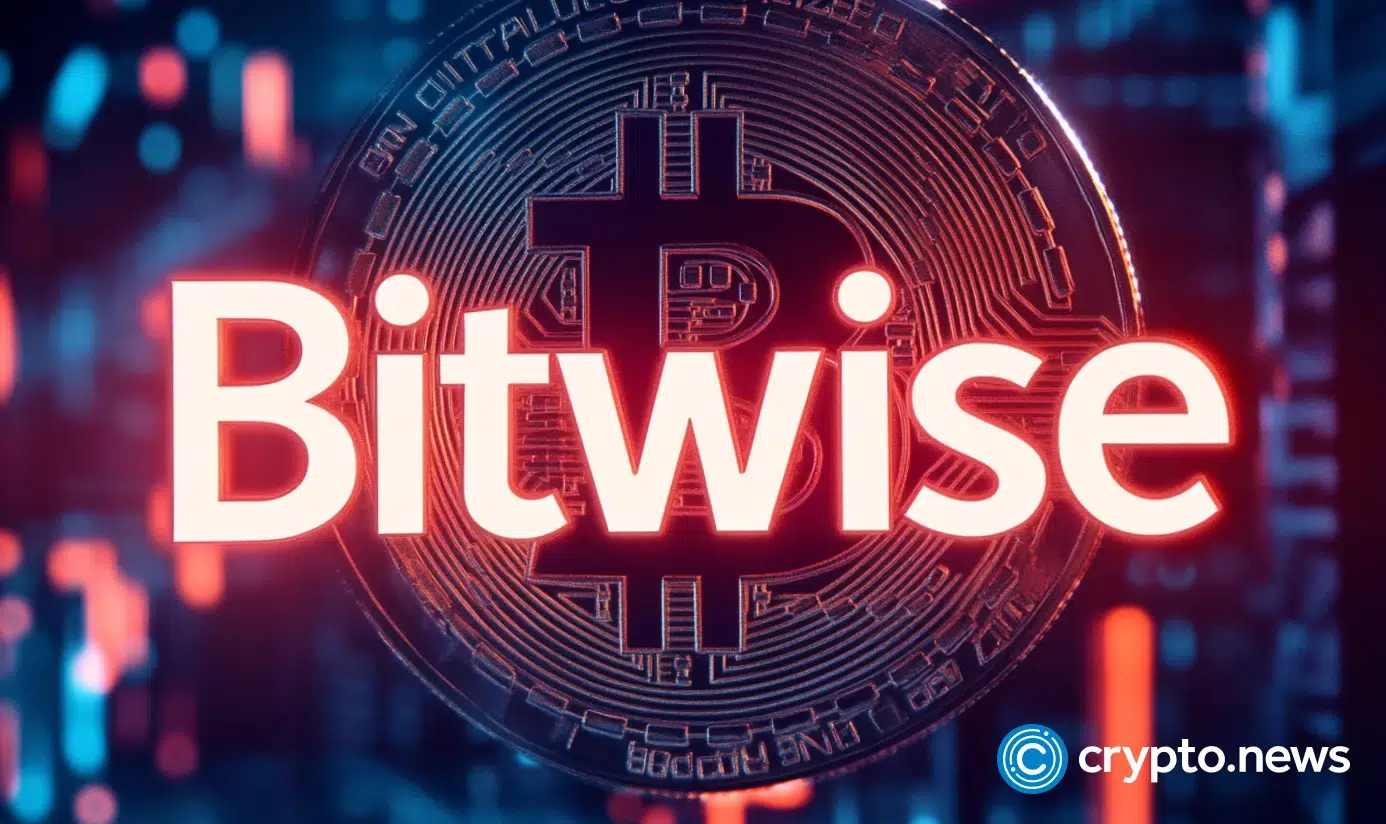
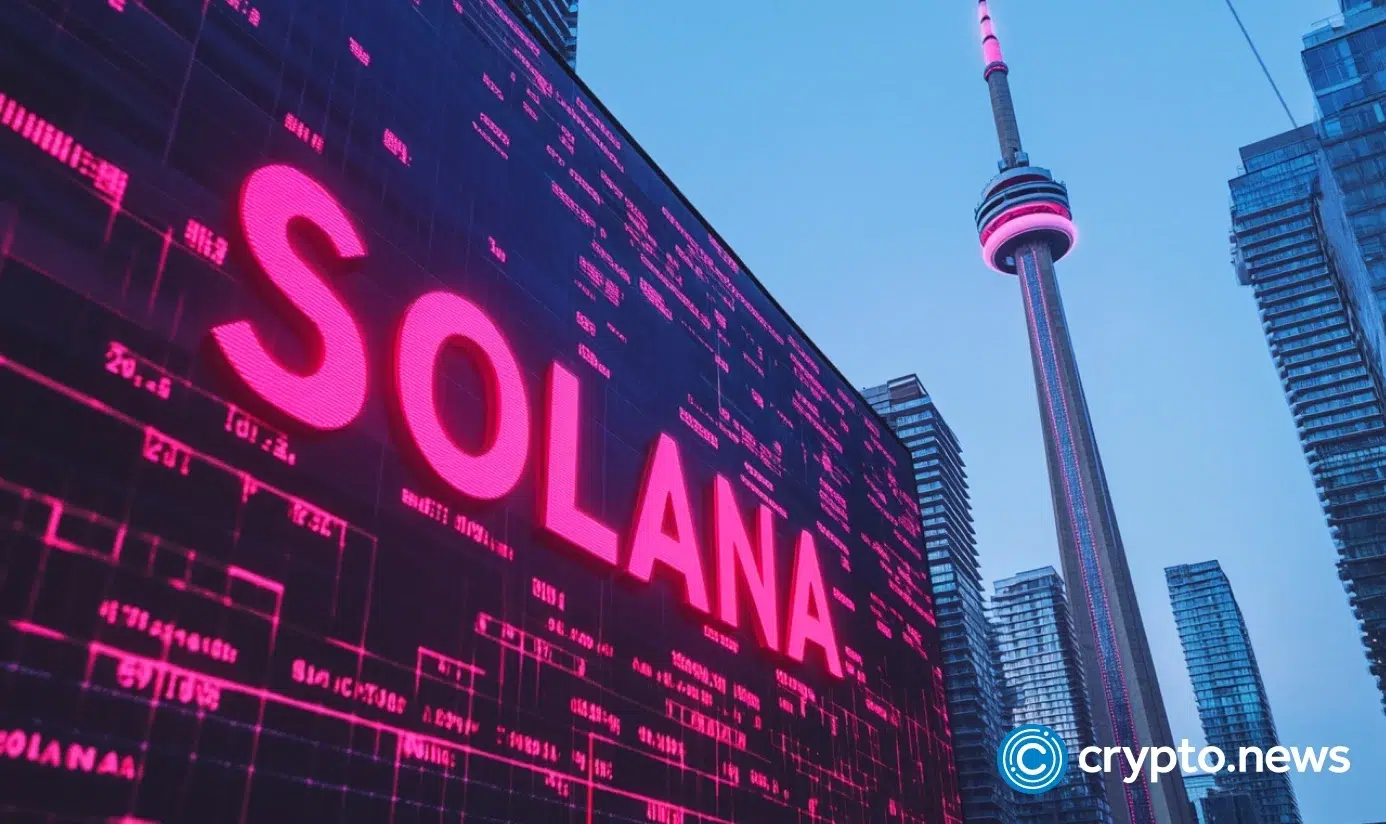

What to Know:
The latest Federal Reserve rate cut triggered a major crypto sell-off. Much of the shift is due to Powell remarking that a December rate cut is far from likely.
The downward trend has now well and truly seeped into hype-driven tokens, which are often the biggest losers whenever such a sell-off happens. The most notable ones are Pump.fun ($PUMP) and Virtuals Protocol ($VIRTUAL).
Pump.fun, for instance, has lost nearly 20% in the last 48 hours alone, whereas Virtuals Protocol is down 15% since its latest swing high of around $1.68.
These are not isolated instances. Even the biggest meme coins in the industry, like $PENGU, $SPX, and $APE, have each lost between 10-15% in just the last week, hinting at a broader, industry-wide downturn.
But before you embrace the FUD and sell all of your crypto, it’s worth taking a good, long look at the charts. These suggest that the current downturn is most likely just a pause before the longer-term bullish momentum resumes.$PUMP, for instance, is currently retesting the $0.0044 level, which it broke out from after overcoming resistance around the same zone with a 55% rally just a couple of weeks ago.

$VIRTUAL, on the other hand, looks even more positive. Last week, it broke out of a major, long-drawn downward sloping resistance line – one that had held the token down since May 2025 – and all it appears to be doing is giving a healthy pullback.

The bottom line is that, while the altcoin market is now consolidating, the long-term bullish picture remains intact. Especially with the USA and China now closer to a trade deal, effectively eliminating major macroeconomic instability news, at least in the near future.
So, how do you go about building a crypto portfolio in such a market? For many retail traders, the most obvious answer is looking into the best crypto presales.These are low-cap tokens, meaning they’re still under the radar and carry a lot of explosive potential.
Plus, they’re currently in ‘pre’-sale, meaning they’re not yet listed on exchanges. This gives them the ability to ward off noise from current market conditions while also getting ahead of the next big wave.
Here are our top three suggestions.
Best Wallet Token ($BEST) has the potential to revolutionize how people buy into crypto presales. Right now, Best Wallet is the only crypto wallet that lets you purchase new projects directly from the app.
Other wallets, by contrast, require you to visit external presale websites, connect your wallet there, and then return to authorize the transaction.
Best Wallet’s ‘Upcoming Tokens’ section lists all these early-stage moonshot opportunities in one place, saving you the trouble of digging around to find the best investment options.
The internal Best Wallet team vets every new meme coin before making it available for purchase, adding a crucial extra layer of security that can save you from rug pulls and phishing websites.Speaking of security, the wallet uses state-of-the-art encryption and robust two-factor authentication, including biometric login.
It’s also a completely non-custodial crypto wallet, meaning only you have access to your private keys.

On top of that, you have the option to set up multiple ERC-20 and multichain wallets, giving you the freedom to organize your crypto endeavors however you like – perhaps one wallet for HODLing, one for staking, and another for active trading.
And, according to Best Wallet’s roadmap, it aims to capture 40% of the non-custodial crypto wallet market by 2027. That’s why buying $BEST, which has already pulled in $16.7M+ in its ongoing presale, could be a smart move.
Based on our $BEST price prediction, the token could soar 170% by the end of 2030, reaching a potential high of $0.07.
You can buy $BEST today for just $0.025875.
Crypto mining is largely inaccessible to the general public due to its high costs and technical know-how. Well, there are other options to earn crypto on the side, and they’re way easier, cheaper, and less boring.
Enter PepeNode ($PEPENODE). This crypto projects brings a novel, gamified, virtual crypto mining experience. It lets you earn crypto rewards while having fun in a game light enough to play via browsers.
When you become a $PEPENODE holder, you get access to an empty virtual server room. The next step is to go shopping and grab some meme nodes, and this is where things get exciting.
Every node is unique in terms of its characteristics, mining quality, and compatibility with other nodes, meaning you’ll need to experiment and fine-tune to build the perfect mining setup for yourself.

Furthermore, PepeNode ranks its miners on a leaderboard, which ultimately determines the rewards they receive.
These rewards include free $PEPENODE, as well as other meme coins like $PEPE, and $FARTCOIN, all of which are strong and explosive meme coins in their own right.
 Here’s our step-by-step guide on how to buy $PEPENODE for just $0.0011272 and stake it for a chunky 642% APY.
Here’s our step-by-step guide on how to buy $PEPENODE for just $0.0011272 and stake it for a chunky 642% APY.
All you have to do is wait for the completion of PepeNode’s TGE (Token Generation Event). That’s when the mining game and rewards go live, and you can building your mining rig and compete.
If you just plan to HOLD, a $100 investment into PEPENODE today could turn into $700 by the end of 2026 – according to our PEPENODE price prediction.
Grab your $PEPENODE tokens today.
There’s a reason Remittix ($RTX) has been able to attract over $27.7M from investors in its ongoing presale.
After all, its mission is to transform the cross-border payments market by creating the perfect synergy between cryptocurrency and fiat.
Remittix allows you to send crypto directly to fiat-based bank accounts around the world. The receiving party gets the funds in fiat currency, completely unaware that the transaction originated as crypto.

By doing so, Remittix hits two targets with one arrow. It lets the receiver, who might be in a crypto-unfriendly region, safely receive fiat, while allowing the sender to comfortably pay using crypto.
On top of that, Remittix charges zero additional forex fees and offers same-day transaction processing, positioning itself one step ahead of the current banking system.
The $RTX token is still available on presale for just $0.1166, with Ethereum, $USDT, and fiat payment options available.
Recap: With hype-driven tokens proving remarkably resilient amid a broader market downturn, the future for emerging low-cap presale gems like Best Wallet Token ($BEST), PepeNode ($PEPENODE), and Remittix ($RTX) looks bright.Disclaimer: Invest in crypto only after doing your own research. The market is highly unpredictable. This article is not financial advice.
Authored by Elena Bistreanu, NewsBTC – https://www.newsbtc.com/news/best-crypto-presales-to-buy-as-pumpfun-and-virtuals-protocol-dump

What gives XRP its value? In an exchange on X, Ripple CTO David Schwartz – known as “JoelKatz” – tried to answer that question without pretending crypto already behaves like traditional assets. He didn’t lean on marketing language about instant settlement or global payments. He talked about power, control, censorship, incentive design, and speculation.
First, Schwartz reframed what XRP is actually for. He argued that the XRP Ledger is built for people and institutions that don’t want an intermediary sitting in the middle of their transactions. He put it in blunt terms: “Do you want to use a blockchain where people can be their own bank and no middlemen tax their transactions or do you want to be someone else’s bank and tax their transactions? If you want the latter, there are dozens of blockchains for you. If you want the former, there’s XRP.”
In that framing, XRP is not just another token. It’s the only counterparty-free asset native to XRPL. Everything else on the ledger is an IOU from someone – a promise by an issuer, bank, fintech, money transmitter, or gateway. XRP is the exception. It exists on-ledger, without an issuer, and can move between any accounts without anyone else’s permission, freeze authority, or seizure authority.
Schwartz made that explicit: “XRP is the only asset without a counterparty that can be accessed by every account in every jurisdiction with no risk of default, freeze, or clawback.”
That point is central to how Ripple has always positioned XRP: the ledger is multi-currency, but only one asset on it is universally clean. What Schwartz is arguing is that this special status is not cosmetic. It is economic. He said: “I do think XRP’s special place on XRPL ensures that XRP will capture some of the value XRPL transactions generate.”
To understand that claim, you have to understand how most blockchains try to “capture value.” The dominant 2020–2025 playbook in crypto is explicit extraction. Protocols design fee switches, burn mechanisms, staking capture, MEV capture, sequencer rent, or other tolls, and then say to the market: holding this token entitles you to a share of that toll.
Schwartz is openly saying XRPL is not built like that. The XRP Ledger was not designed to tax users at the protocol layer. In his view, that’s a feature, not a bug. He described XRPL as a public good, not a rent machine.
He explained it by analogy: “When you ask what eBay is good for, you normally don’t think about it being a good way to enrich the people who invest in eBay. You think of it as a way of bringing buyers and sellers together with the buyers and sellers wanting the costs to be as low as possible. The buyers and sellers shouldn’t want eBay’s investors taxing their transactions as much as they can get away with because that is mostly money the buyers have to pay but sellers don’t get.”
Then he applied that logic directly to XRPL: “I think of XRPL as a public good that doesn’t tax people who want to use its capabilities. I am not arguing that it is the best design or even that it’s better than most other designs. But it is different. XRP really is about being your own bank and having no middlemen passively taxing your transactions.”
This is where the philosophical tension becomes an economic tension. If XRPL is designed not to skim value from users, then how does XRP appreciate? Why should holding XRP benefit from the ledger’s success?
Schwartz’s answer is that XRP’s role as the only universal, non-freezable settlement asset on XRPL is itself enough to force some level of demand if XRPL becomes important infrastructure. In other words, the ledger doesn’t have to tax flow in order for XRP to matter. XRP matters if the ledger matters.
But Schwartz did not pretend that this mechanism is currently driving price on its own. In fact, he went in the opposite direction and said something most executives in crypto either won’t admit or can’t afford to say in public.
He said the market is still pricing the future, not the present: “The funny thing is that I think that most of the value of most cryptocurrencies comes from expected future speculation. So if what you care about future price changes, what people think will happen is much more important than what has happened.”
Then he pointed at bitcoin to make the point unavoidable: “Look at bitcoin. Most of the current investment thesis is something like, ‘Imagine if most companies start storing 1% of their treasury in bitcoin, what will that do to the price?’. What that’s saying is that in the future, more people will speculate on future price appreciation than speculate currently.”
And he went even further: “It’s not even based on expected future utility, it’s based on expected future speculation! I want to believe utility matters, I really do.”
That last line is probably the most revealing thing Schwartz said. He is not saying “XRP price today is purely a function of measurable payment volume today.” He’s saying that’s not how crypto is priced, period. Crypto, in his view, is reflexive: people buy because they believe other people will one day buy for the same reason, at higher size and higher urgency.
That leads to the next objection: if value is driven by expectation of an “explosion scenario,” shouldn’t tokens be basically worthless until that scenario actually hits scale?
Schwartz rejected that. He argued that markets continuously reprice probability, not outcomes: “There may come a day when we look at today’s cryptocurrency values as, in comparison, nothing. But the idea that values will be very low and then suddenly rise is just not how speculation works. As the probability of explosion or size of expected explosion grows, value follows.”
At press time, XRP traded at $2.48.
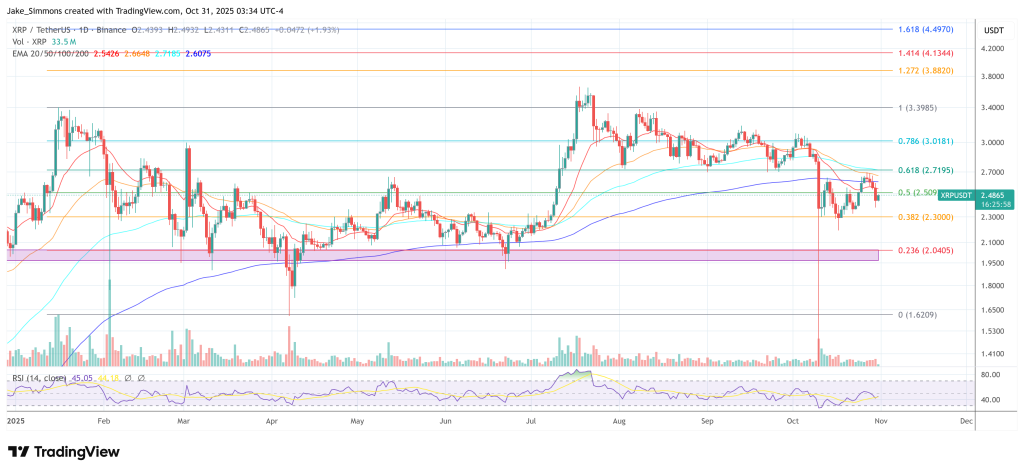

The Shiba Inu open interest has been one of the worst-performing among the top cryptocurrencies by market cap in the year 2025. While there has been a general increase in open interest across the likes of Bitcoin and Ethereum, pulling the market up with them, Shiba Inu has not followed this trajectory. Instead, the meme coin’s open interest has crashed significantly, making new 2025 lows in the process.
At the start of the year, on January 16, 2025, the Shiba Inu open interest had hit a new all-time high above $519 million despite the SHIB price action remaining relatively muted. It wasn’t long until the open interest began to decline, and it has been mostly downhill from there since.
By the start of February 2025, the Shiba Inu open interest had crashed by more than 50%, recording one of the sharpest declines in the market. However, the open interest had managed to stay above the 2024 lows as the SHIB price fluctuations kept traders interested.
Now, however, the majority of the open interest that was seen in Shiba Inu at the start of the year is almost completely gone. Data from the Coinglass website shows that the open interest has now fallen below $100 million for the first time in 2025, marking a new yearly low.

The current average of around $89 million translates to an over 80% decline in the last 9 months, painting a similar picture to the alt coin’s price, which is down 88% from its 2021 all-time highs. As this decline continues, it continues to impact the price, affecting its ability to stage a meaningful recovery.
As mentioned above, the last time that the Shiba Inu open interest was this low was back in 2024, but the interesting thing is that periods of low interest have often preceded some of the biggest moves. Back in August 2024, the Shiba Inu open interest had fallen to its lowest levels since 2023, but the next three months would see a rapid increase in both interest and price.
Times of low interest, such as these, have often been breeding grounds for accumulation ahead of the next move. Thus, the Shiba Inu open interest dropping to yearly lows could be setting the stage for another price rally.

dYdX (DYDX), one of the leading decentralized cryptocurrency trading platforms in the industry, is reportedly preparing to enter the US market by the end of the year, following the recent shift in crypto policies by the Trump administration.
In an interview with Reuters, Eddie Zhang, the president of dYdX, emphasized the importance of this move, stating that having a presence in the United States aligns with the platform’s future direction.
Unlike centralized exchanges such as Coinbase (COIN) and Kraken, which act as intermediaries between buyers and sellers, dYdX aims to eliminate the middleman, allowing users to transact directly on a blockchain network that underpins cryptocurrencies.
The platform specializes in perpetual contracts, a form of derivative that enables traders to speculate on asset prices without ownership and without an expiration date, distinguishing it from traditional futures contracts. Since its inception, dYdX has surpassed $1.5 trillion in total trading volume.
As part of its expansion strategy, dYdX plans to introduce spot trading for Solana (SOL) and other linked cryptocurrencies, potentially including XRP and Cardano (ADA), to US users by the end of the year.
This move comes in the wake of President Donald Trump’s increased support for the cryptocurrency sector, which has led to the dismissal of numerous lawsuits against major crypto platforms and prompted financial regulators to develop specialized rules for digital assets.
These new measures include Congress’s passage of the GENIUS Act earlier this year and the potential passage of the Market Structure Bill. Together, these measures address the industry’s call for a new framework that could boost adoption and growth of the broader digital asset ecosystem in the US.
Upon its entry into the US market, Reuters reports that dYdX intends to reduce its trading fees significantly, with plans to cut them by as much as half, bringing them down to between 50 and 65 basis points.
However, while perpetual contracts will not be available to US users immediately, Zhang expressed hope that regulators will eventually provide the necessary guidance for decentralized platforms to offer these products.
The US Securities and Exchange Commission and the Commodity Futures Trading Commission (CFTC) recently issued a joint statement indicating their willingness to consider allowing crypto perpetual contracts to trade across regulated platforms in the US, which could pave the way for dYdX’s future offerings.
As of this writing, the platform’s native token, DYDX, is trading at approximately $0.30. However, the token has experienced a significant decline of nearly 68% over the past year, shedding about $1.43 billion in market cap value.
Featured image from DALL-E, chart from TradingView.com

The market opened softer on Friday, October 31, with risk appetite cooling after a burst of long liquidations. Crypto prices fall as live pricing shows Bitcoin near $109,700, down about 1.6 percent on the day, while the total crypto market value drifts lower. Funding rates have eased and open interest has slipped, a tell that leverage is backing off after a busy week.
Bitcoin trades around $109,700 after a quick fade from the prior session high. The day’s drawdown follows nearly $900 million in marketwide liquidations over 24 hours, the bulk from longs. That deleveraging pins BTC in a tight range. “The most likely outlook is we are rangy between 100 and 120 or 125, unless we take out the top side,” Mike Novogratz said this month, adding that holding 100 remains key support.
ETH changes hands near $3,835 after a 2 to 3 percent dip, with 24-hour lows under $3,700 and highs just below $3,945. Spot volumes are elevated, yet derivatives positioning is lighter than earlier in the week. Traders point to a neutral relative strength profile and slightly negative funding, which fits a “cooling, not cracking” tape.

XRP trades close to $2.48 with daily losses of around 4 percent. Liquidations on XRP outpaced several peers during the overnight move, adding pressure as momentum traders stepped aside. Even so, the circulating float and rising on-chain activity provide a floor when volatility spikes, keeping the pair anchored to the mid-$2 zone for now.
SOL sits near $185, off roughly 5 percent in 24 hours. The move mirrors broad risk reduction across high beta assets. SOL’s volumes remain thick, but open interest has cooled, which usually reduces whipsaws after sharp swings. If liquidity stabilizes, the network’s active dApp flow often helps price recover faster than the market.
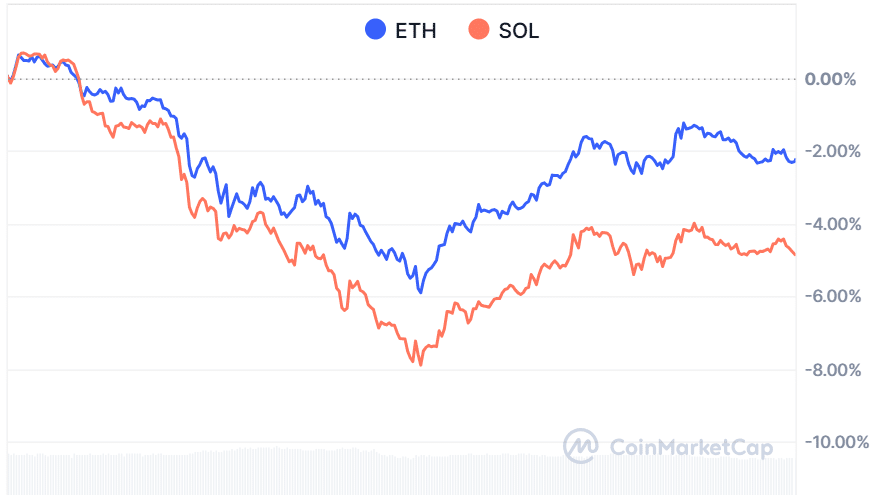
The Federal Reserve cut rates by 25 basis points on October 29, but Chair Jerome Powell said “a further reduction in the policy rate at the December meeting is not a foregone conclusion.” That cautious line trimmed the initial boost to risk assets and helped trigger a classic sell-the-news shakeout. Policy paths in the Gulf followed with 25-bp trims, which should slowly filter through regional liquidity.
Data show about $890 million in 24-hour liquidations, with longs taking most of the hit. Bitcoin accounted for roughly $310 million, Ethereum about $195 million, Solana near $69 million, and XRP close to $42 million. Open interest dropped to about $159 billion, and the average RSI sits near 40, signaling neutral momentum after the flush.
Price action looks more like a mid-cycle purge than a trend break. BTC holds the six-figure shelf. ETH keeps its core range intact. SOL and XRP feel heavy but not broken. If funding stays neutral and macro signals stop surprising, liquidity can creep back. As Novogratz put it, the market likely chops between $100,000 and $125,000 unless a fresh catalyst arrives.
Q: Why did prices fall today
A: A cluster of long liquidations hit overnight after the Fed’s cautious tone and a crowded leverage build-up earlier in the week. That forced exits and pushed prices lower together.
Q: What levels matter most for Bitcoin right now
A: Market depth and recent commentary point to support near $100,000 and resistance in the $120,000 to $125,000 area. A clean break above the top band would invite trend traders back.
Q: Does the Fed cut help crypto
A: Lower rates can help over time, but the message matters. Powell’s “not a foregone conclusion” on December limited the immediate boost.
Open interest: The total value of outstanding futures and perpetual contracts that have not been closed. Falling open interest after a selloff implies deleveraging rather than strong new shorts.
Funding rate: A periodic payment between longs and shorts on perpetual swaps that nudges price toward spot. Slightly negative funding tells that longs are less aggressive and shorts are paying less to stay in.
Liquidation cascade: A chain reaction where price drops trigger forced closures, which push price lower again and cause more liquidations until leverage resets and order books stabilize.
Read More: Crypto prices today: BTC, ETH, XRP and SOL weaken as leverage unwinds">Crypto prices today: BTC, ETH, XRP and SOL weaken as leverage unwinds


Crypto jokes age faster than meme coins. One day, everyone is shouting “wen moon,” and the next, they swear they always loved fundamentals and liquidity metrics. Markets look calmer today as traders watch whether Chainlink can regain strength amid expanding oracle adoption and as TRON prepares a new stablecoin innovation. The shift feels less chaotic, but confidence still depends heavily on where capital rotates next. Strong news stories keep attention glued to assets positioned for meaningful roles as global adoption of DeFi and tokenized financial systems increases.
BullZilla steps into that environment with a high-energy presale and a structure that rewards early believers more aggressively than typical launches. Its transparent milestones, staking system, and community traction set a clear path for major upside as supply tightens. Investors searching for the best crypto to invest in right now often look beyond old favorites toward projects where timing still unlocks exponential potential. BullZilla’s narrative combines innovation, affordability, and hype, motivating early participation before prices automatically increase further each stage.
Chainlink remains the market’s most dominant oracle solution even after its price dipped slightly. Trading around $18.25, LINK holds a market cap above $12 billion and continues attracting institutional recognition across real-world asset tokenization and cross-chain communication. Despite the current pullback below the psychological $20 level, many analysts still view Chainlink as a foundational piece of Web3 infrastructure. Network activity remains strong, and the circulating supply nears 697 million. Growth may accelerate again once broader volatility cools and new enterprise integrations increase demand.
Chainlink secures price feeds for decentralized applications and tokenized assets. As more financial organizations adopt blockchain, trusted external data becomes essential, fueling long-term demand for LINK liquidity and reliable oracle execution.
Historically, LINK rebounds when the crypto market structure improves and demand grows for secure real-world asset infrastructure. Continued integrations often push price momentum higher once sentiment shifts firmly back into bullish territory.
BullZilla delivers its narrative with clarity as it positions itself among the best crypto to invest in right now. Its Stage 8 presale sits near $0.00020573, while more than $996k has already been raised from over 3300 holders. Over 31 billion tokens have been sold, signaling confidence and rising awareness. The listing price target is $0.00527, implying a 2462.29% ROI from today’s entry. The earliest participants enjoy even higher potential above 3477.91 percent. Scarcity increases at every stage as prices rise automatically, and limited availability fuels urgency. That base keeps buyers engaged before exchanges’ demand creates new pricing power.

Investing $2000 now yields about 9.72 million tokens at the current Stage 8 price level. If the projected listing price reaches around $0.00527, those tokens could be worth more than $51,000 on launch day. Momentum favors early conviction because hesitation usually increases cost as stages automatically move upward. BullZilla aims to become a leader in utility-powered meme assets with a long-term ecosystem and substantial staking rewards. Its structured price increases encourage buyers to act before demand causes faster market discovery.
Start by setting up a Web3 wallet, such as MetaMask or Trust Wallet. Purchase ETH through a trusted exchange and transfer it to your wallet. Visit the official BullZilla presale site, connect your wallet, and swap ETH for $BZIL directly on the dashboard. Tokens automatically lock until the event ends to secure fair distribution among buyers. Claiming occurs after completion, and vesting details remain displayed on the platform to maintain transparency, so every participant understands the timelines clearly and easily at launch.
BullZilla presale price is around $0.00020573 in Stage 8. Prices increase as each milestone is completed, rewarding earlier buyers through staged launches that add positive pressure and deeper scarcity.
The projected listing value is $0.0052,7, which offers significant upside from current levels. Price performance depends on exchange demand, staking participation, and sustained community growth as launch approaches.
Listings depend on post-presale decisions and exchange approvals. Strong performance, liquidity growth, and community traction give BullZilla a higher chance of achieving listings as major platforms as they seek trending assets.

TRON strengthens its position in digital finance through massive stablecoin settlement volume and rapidly expanding ecosystem development. The gasless stablecoin initiative planned for late 2024 aims to eliminate transaction fees entirely, which could dramatically increase adoption for payments and everyday transfers. With millions of active addresses, TRON already supports high throughput and reliable settlement. The new model may attract users seeking low-friction environments where spending stablecoins costs nothing. That vision keeps TRON relevant during market transitions while DeFi usage becomes more universal worldwide.
Lower transaction friction increases liquidity flows and encourages payments at scale. More daily usage helps TRON secure stability and growth potential as a preferred settlement network.
TRON continues to build through protocol upgrades and adoption plays in decentralized finance. Its strong infrastructure keeps the ecosystem capable of handling large transaction volumes as international demand rises.
Chainlink and TRON illustrate blockchain stability during calmer market conditions, where fundamentals matter again because adoption drives value more than speculation. Chainlink advances enterprise connectivity through a secure oracle infrastructure that supports tokenization and smart contract automation. Meanwhile, TRON’s gasless stablecoin plan highlights how everyday DeFi payments could operate seamlessly for global users. Both reflect how resilient networks anchor the next crypto evolution, even when short-term charts appear choppy. Continued technology achievements and ecosystem expansion keep their overall outlook constructive while markets search for clearer direction and renewed confidence.
Yet opportunity also favors those who move before the crowd arrives. BullZilla’s presale offers attractive upside, driven by early-stage pricing, community traction, and a clear utility roadmap that includes staking benefits. By positioning itself as a fast-growing contender, it gives buyers room to multiply outcomes beyond what mature networks usually deliver. Many searching for the best crypto to invest in right now track BullZilla closely because the next bull wave often rewards preparedness and a strong appetite for early conviction.

Follow BZIL on X (Formerly Twitter)
This article is for informational purposes only and does not constitute financial advice. Readers should conduct their own research before investing in any cryptocurrency or presale project.
Read More: BullZilla ($BZIL) Captures Market Hype as the Best Crypto to Invest In Right Now While TRON and LINK Flatten Out">BullZilla ($BZIL) Captures Market Hype as the Best Crypto to Invest In Right Now While TRON and LINK Flatten Out


Ever feel like the crypto market wakes up on a different side of the bed every day? One moment it’s celebrating new highs, and the next, it’s quietly nursing a hangover. With Avalanche slipping 0.36% and Bitcoin Cash rising 1.98% in the past 24 hours, investors are closely tracking how capital shifts across top assets. As October draws to a close, the market’s mood is being shaped by events like ETF approvals, U.S. CPI updates, and fresh regulatory headlines. These developments suggest not panic, but healthy repositioning before the next bullish leg begins.
Beyond the well-known giants, one fresh name is capturing attention, BullZilla ($BZIL). Blending meme energy with real token utility, BullZilla is quickly gaining traction among presale enthusiasts who see it as the best crypto to buy for long term growth. With ROI projections surpassing 2,548%, it combines storytelling, staking, and burn mechanics in a way that fuels both hype and sustainability. While Avalanche and Bitcoin Cash solidify their roles as market mainstays, BullZilla’s presale surge represents the excitement of early discovery, the kind of opportunity long-term investors rarely want to miss.
Bitcoin Cash (BCH) currently trades at $564.96, marking a 1.98% gain in the last 24 hours with a daily volume of $646 million. This steady upward movement reflects renewed retail and developer confidence following network upgrades that enhanced transaction speed and reduced fees. As one of the leading peer-to-peer digital payment solutions, BCH’s lightweight structure and low-cost transfers make it ideal for global transactions. Merchants and users continue to embrace Bitcoin Cash for its reliability, fast settlements, and practical blockchain functionality in real-world commerce.
Recent developments in smart contract integration and layer-2 compatibility are further strengthening Bitcoin Cash’s position in the evolving blockchain landscape. The network’s rising transaction volume, especially across Latin America and Asia, underscores its growing adoption for everyday payments and cross-border use. Despite short-term market volatility, BCH maintains solid on-chain fundamentals, scalability, and a dedicated community. Analysts view it as a resilient, utility-driven asset that offers long-term value to investors seeking stability, efficiency, and steady ecosystem growth in the broader crypto economy.
Bitcoin Cash’s 1.98% increase is driven by growing payment adoption, strong on-chain activity, and investor confidence in its fast, low-fee transaction system supporting global blockchain utility.
Yes. Bitcoin Cash’s expanding merchant base, low transaction costs, and consistent network upgrades make it a dependable blockchain asset with strong long-term growth and real-world application potential.
BullZilla is rapidly emerging as one of the best crypto to buy for long term growth projects in the market, redefining how community-led tokenomics can create sustainable value. Priced at $0.00020573, it has already raised more than $990K, sold over 31 billion tokens, and attracted a base of 3,300 holders. The project’s Progressive Price Engine automatically raises token prices every $100K raised or every 48 hours, building real scarcity while rewarding early adopters. Its 24-stage burn model continuously reduces supply, adding deflationary momentum throughout the presale. This structure fosters long-term demand and creates measurable growth potential for investors entering early.

Supported by a narrative-driven ecosystem, BullZilla seamlessly blends storytelling, community engagement, and tangible financial incentives. Its staking hub, the HODL Furnace, offers an attractive 70% APY, encouraging holders to lock in tokens and strengthen price stability. Meanwhile, the referral system distributes 10% bonus tokens to both the inviter and invitee, fueling organic community growth without paid marketing. Analysts estimate an ROI exceeding 2,548% from presale to projected listing, making it one of the most talked-about crypto launches of 2025. Far beyond a meme coin, BullZilla represents a carefully structured, deflationary ecosystem tailored for long-term investors who value innovation, scarcity, and reward-driven participation.
To join, visit the official BullZilla website, connect your MetaMask or Trust Wallet, and select ETH or USDT as your payment method. Investors who spend more than $50 instantly qualify for a 10% token bonus through the referral system, encouraging early participation. The token price automatically rises by 4.37% per stage, creating urgency for timely entry. All tokens purchased remain securely locked until the phase concludes, ensuring transparency, fairness, and protection against early dumping. This structured approach helps maintain token stability, prevents manipulation, and rewards investors who act decisively during early-stage opportunities.
The BullZilla Presale Price is $0.00020573, rising automatically every 48 hours or after $100K is raised, driven by its Progressive Price Engine and stage-based system.
While not confirmed yet, BullZilla’s Ethereum foundation, rapid presale growth, and strong community engagement could enhance its chances of Coinbase or major exchange listings in 2025.
The BullZilla Presale concludes after all 24 stages are completed or token allocations sell out, with each stage automatically increasing the price and tightening token supply.
Presales like BullZilla’s offer early investors an opportunity to get in before public listings drive prices higher. By joining during these early stages, participants lock in low-cost entries that can multiply substantially when broader market demand increases. BullZilla’s smart structure enhances this advantage through automated price hikes, token burns, and high-yield staking programs that continually increase scarcity. Each stage compounds value while rewarding long-term holders for conviction and patience. When combined with a strong community, transparent development, and sustainable tokenomics, presales like BullZilla’s demonstrate how strategic early participation can generate significant long-term returns and steady passive income potential.
Avalanche currently trades at $19.45 with a 24-hour trading volume of $554.6 million, marking a slight 0.36% dip in price. This minor correction mirrors the overall cooldown in layer-1 token demand following recent liquidity surges across major assets. Still, Avalanche’s fundamentals remain strong. Its subnets and low-latency transaction model continue to attract decentralized finance (DeFi) protocols, gaming projects, and enterprise integrations. Despite the market’s cautious tone, on-chain metrics reflect sustained activity, proving that developers and users remain committed to the network’s efficiency and flexibility.
From a long-term perspective, Avalanche maintains a compelling growth outlook driven by its technical advancements and expanding institutional footprint. Its strategic collaborations with finance firms and blockchain innovators reinforce confidence in its scalability and cross-chain capabilities. Analysts view Avalanche’s quick transaction finality, low costs, and environmentally efficient design as major catalysts for renewed adoption once market sentiment stabilizes. As investors rebalance portfolios, many continue to see Avalanche as a solid hold for long-term blockchain exposure and ecosystem expansion potential.
Avalanche’s 0.36% decline is mainly due to short-term profit-taking and liquidity rotation after recent rallies. Market participants are rebalancing portfolios, but network fundamentals remain solid and show no structural weakness.
Yes. Avalanche’s advanced subnet architecture, growing developer ecosystem, and expanding DeFi integrations continue to build its long-term value. Its scalability and speed position it as a strong blockchain investment through multiple market cycles.

Bitcoin Cash and Avalanche continue to demonstrate how established blockchain networks sustain their relevance through innovation, scalability, and consistent adoption. Bitcoin Cash has evolved beyond its origins, now serving as a global low-fee payment solution with real-world merchant integration and growing user activity. Its efficient structure and expanding acceptance in developing economies highlight its staying power. Avalanche, meanwhile, showcases cutting-edge technology with its subnets, rapid transaction finality, and enterprise-level partnerships. Together, these two projects represent reliability and maturity, showing why blockchain remains at the heart of digital finance’s evolution.
Still, 2025 could mark a shift toward new frontiers. BullZilla ($BZIL) is capturing attention as one of the best crypto to buy for long term due to its deflationary design, 70% APY staking model, and dynamic presale mechanics. With over $990K raised, 31 billion tokens sold, and 3,300 holders, BullZilla’s combination of community-driven growth and progressive tokenomics makes it more than just a meme, it’s a structured ecosystem built for exponential returns. If current momentum continues, BullZilla could become 2025’s breakout project, bridging storytelling, strategy, and sustainability in a single roaring package.

Follow BZIL on X (Formerly Twitter)
This article is for informational purposes only and does not constitute financial advice. Readers should conduct their own research before investing in any cryptocurrency or presale project.
Read More: Bitcoin Cash Climbs 1.98% As Avalanche Slips 0.36% – See Why BullZilla Is Catching Attention As The Best Crypto to Buy For Long Term Gains">Bitcoin Cash Climbs 1.98% As Avalanche Slips 0.36% – See Why BullZilla Is Catching Attention As The Best Crypto to Buy For Long Term Gains


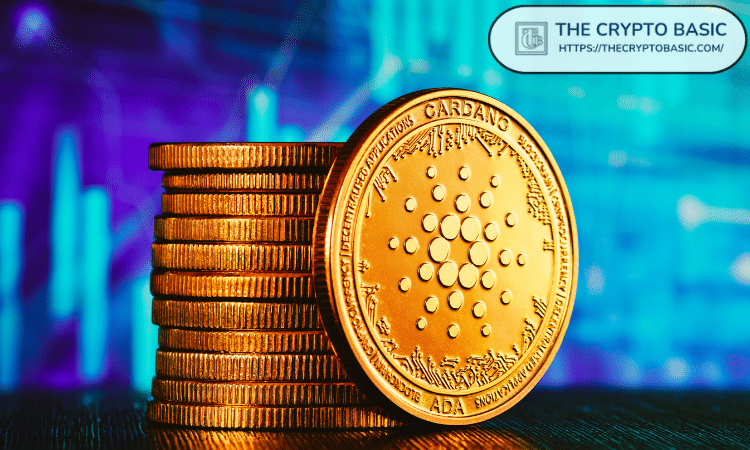
Members of the Cardano community are buzzing with expectation following a cryptic post from the official X account of stablecoin project Moneta (USDM). In a recent X post, Moneta (USDM on Cardano) teased an upcoming development, sparking excitement within the community.

An XRP community figure recently suggested that assets like XRP are "golden geese," explaining how one could make them feed one's family forever. Notably, as investors continue to anticipate an XRP rally to new highs, most of them still don't know what they'll do once XRP reaches those ambitious price targets besides selling it off for profit.

A prominent market analyst has dissected Shiba Inu trends over the past two years, giving insight into what to expect when its bullish phase starts. Specifically, Income Sharks, a widely followed analyst, highlighted several market phases for Shiba Inu.

Former Binance CEO Changpeng Zhao (CZ) has denied reports alleging he sold a massive quantity of ASTER tokens. The rumors originated from a Riyadh-based crypto advocate known as Farzad, who claimed Zhao had liquidated 35 million ASTER tokens worth approximately $30.42 million.

Forbes has dramatically shifted its stance on XRP and Ripple, describing the company as almost unrecognizable compared to the version it profiled in early 2024. Back then, XRP and Ripple topped Forbes’ list of “zombie blockchains” projects with billion-dollar valuations, but with supposedly minimal real-world usage.

Zach Pandl, head of research at Grayscale Investments, believes Solana exchange-traded funds (ETFs) could soon rival the success of Bitcoin and Ethereum investment products. He expects that within one to two years, about 5% of all Solana tokens could be held in regulated exchange-traded structures, a share worth over $5 billion at today’s prices.

Cardano founder Charles Hoskinson is cautious of the Inverse Cramer effect, particularly after Solana co-founders met with the CNBC Mad Money host. Solana could be in trouble, a reaction from Hoskinson suggests.

A social media account once linked to Sam Bankman-Fried, the imprisoned founder of FTX, posted a new document on X late Thursday. The 14-page file argues that the crypto exchange was never genuinely insolvent.

Charles Hoskinson, the founder of Cardano, has once again reaffirmed his commitment to improving Dogecoin and transforming it into the official currency of X. Hoskinson’s renewed comments follow a Dogecoin community member resurfacing his March 2025 proposal to Dogefather Elon Musk.

The Ripple CTO, David Schwartz, recently suggested that the XRP value proposition is that it allows people to be their own banks without depending on middlemen. His comments came after Western Union chose Solana over the XRP Ledger (XRPL) to build its stablecoin, a decision that led to discussions across crypto circles about whether XRP still holds unique value within the crypto scene.
Key takeaways
The demand for spot Bitcoin ETFs has declined over the past few days amid the current financial climate. Fed Chair Jerome Powell revealed earlier this week that it remains unclear if there will be another rate cut in December.
Data obtained from CryptoQuant’s latest weekly report shows that U.S. investor demand for spot Bitcoin ETFs has cooled sharply. Spot bitcoin ETFs posted a seven-day average outflow of 281 BTC, one of the weakest readings since April. Meanwhile, Ether inflows have stalled over the last seven days.
The report added that Coinbase premiums for BTC and ETH have flattened to near zero, and the CME futures basis has dropped to multi-year lows. These data show that institutional and retail traders alike are taking profits rather than adding exposure.
According to Glassnode, Bitcoin continues to struggle below the short-term holders’ cost basis of around $113,000, with the coin’s long-term holders still distributing roughly 104,000 BTC per month.
Transfer volumes from whale wallets to exchanges have surged to $293 million a day, suggesting that investors are taking profit rather than increasing exposure to the market.
The BTC/USD 4-hour chart remains bearish and efficient as it is down 1% in the last 24 hours. The monthly candle will close in a few hours and could indicate how the market will react in the near term.
If Bitcoin continues its correction and closes the candle below the 61.8% Fibonacci retracement level at $106,453, it could extend its dip towards the October 10 low of $102,000.
The RSI of 46 is below the neutral 50, indicating bearish momentum is gaining traction. The Moving Average Convergence Divergence (MACD) lines are also converging, suggesting a bearish trend.
However, if Bitcoin holds the support level at $106,453, it could rally towards the 50-day EMA at $112,872 over the next few hours and days.
The post Bitcoin price forecast: BTC could dip lower as ETF demand fades appeared first on CoinJournal.

GHOST is among the few tokens with an upside trajectory as the overall cryptocurrency market displays significant selling pressure.
The digital token thrived in the past few sessions as privacy cryptocurrencies gained increased traction, with Zcash leading the trend.
Meanwhile, GHOST’s remarkable performance is grabbing the attention of dip-pocketed investors.
For context, the alt surged roughly 65% over the past seven days.
According to Lookonchain, a new wallet withdrew 523.39 SOL, worth approximately $100,500, from Binance to buy around 4.8 million GHOST coins over the past 24 hours.
Someone created a new wallet 8tqszG and withdrew 523.39 $SOL($100.5K) from #Binance to buy 4.8M $GHOST.
Address:https://t.co/OOn2Pcddqj pic.twitter.com/3Fl2LWF7hg
— Lookonchain (@lookonchain) October 31, 2025
The transaction has stirred speculation due to its timing. Should we expect continued rallies from the altcoin?
The entry appears strategic as it comes amid bullish price actions, likely signaling conviction of extended upsurges for GHOST.
Ghost is a decentralized platform aiming to transform the crypto world with privacy.
The network uses GHOST as its native token. The ecosystem allows individuals to transact anonymously and privately.
While assets like Bitcoin have all their transaction history publicly available, Ghost obfuscates transactions across the network.
It hides transaction details on the senders and receivers’ ends to guarantee maximum privacy.
The altcoin remained in the spotlight in recent sessions as privacy tokens gained increased attention.
For instance, Zcash soared nearly 400% in October as the entire crypto sector struggled with uncertainty. GHOST gained around 115% the previous month.
The whale transfer has sparked the Ghost community, with social posts mentioning the token gaining attention.
While some questioned the whale’s motives, others perceive the accumulation as a sign of trust in the project.
Trading volumes mirrored the enhanced sentiments. GHOST’s daily trading volume skyrocketed by more than 600% to $2.81k.
That reflects renewed user interest in the digital currency.
Also, Ghost appears to have adequate liquidity on decentralized exchanges. That suggests that organic demand is fueling GHOST’s rally.
The alt maintains an optimistic outlook, changing hands at $0.06215 at the time of writing.

It has gained over 65% and roughly 115% the past week and month.
Technical indicators point to further rallies for the alternative token.
For instance, GHOST is hovering well above the vital 50 and 100 Exponential Moving Averages on the 4Hr timeframe.
That indicates a reliable support barrier for the digital asset.
The Moving Average Convergence Divergence displayed a bullish crossover with robust green histograms.
GHOST will possibly extend its rallies before cooling.
The 4Hr Relative Strength Index reads 72, highlighting overbought situations and the possibility of imminent corrections.
The post GHOST extends rally as whale scoops 4.8 million tokens appeared first on CoinJournal.

An X account, currently controlled by a friend of Sam Bankman-Fried, stirred the cryptocurrency market with a post claiming that the firm wasn’t insolvent.
The 15-page document claims FTX encountered a liquidity crisis that “was on track to be resolved by the end of the month” until the exchange’s external counsel assumed control. It declared:
FTX was never bankrupt, even when its lawyers placed it into bankruptcy.
[SBF says:]
This is where the money went. https://t.co/HVRwEw5Z1k https://t.co/5DrA13L5YE pic.twitter.com/O6q77DvmTn
— SBF (@SBF_FTX) October 31, 2025
The disgraced founder and his team supposedly wrote the document, which highlights that the exchange didn’t file for bankruptcy after a plan to commit fraud and mishandle billions of customer funds, as the court concluded.
They insist that FTX encountered a liquidity crunch after “a sudden shortage of cash.
Meanwhile, the exchange’s native token, which has survived without solid utility since FTX’s debacle, turned bullish amid the developments.
FTT gained more than 2% on its daily chart to trade at $0.8473.
Its trading volume has increased by over 25%, indicating optimism.
For context, the global crypto market capitalization remained muted the past 24 hours with a mere 0.08% uptick to $3.7 trillion.
The document argues that the cryptocurrency exchange and sister company Alameda boasted assets worth $25 billion, alongside $16 billion in equity value, against liabilities worth $13 billion, as it fell in 2022.
That means a net value of approximately $28 billion. It added:
During the crisis, the value of the assets and (presumably) equity took a temporary hit, but even at the peak of the crisis, the companies remained solvent – even if one were to ignore equity.
SBF and his team claim their empire would be worth roughly $136 billion if lawyers didn’t sell assets that they invested in.
That would comprise a $7.6 billion stake in Robinhood broker, $14.3 billion investment in AI startup Anthropic, among other assets.
However, cryptocurrency enthusiasts and online investigators aren’t buying SBF’s claims.
Some believe these are desperate attempts to secure a pardon, after Donald Trump’s similar move on Binance founder CZ.
Meanwhile, some questioned why FTX suspended withdrawals if it had enough money for creditors.
A DeFi enthusiast and X user, Hanzo, referenced the incident where Bybit suffered $1 billion ETF scam, stating:
Many CEXs went through stress tests after some massive fuck ups, and they all are here.
FTX’s native token gained more than 2% amid these developments.
It is hovering at $0.8473, with soaring trading volumes highlighting enthusiasm.

Nevertheless, FTT recoveries will likely be short-lived.
Broader market weakness and negative community reaction to the team’s claims weigh on the digital token.
The post FTT price turns bullish as SBF claims FTX exchange was never insolvent appeared first on CoinJournal.


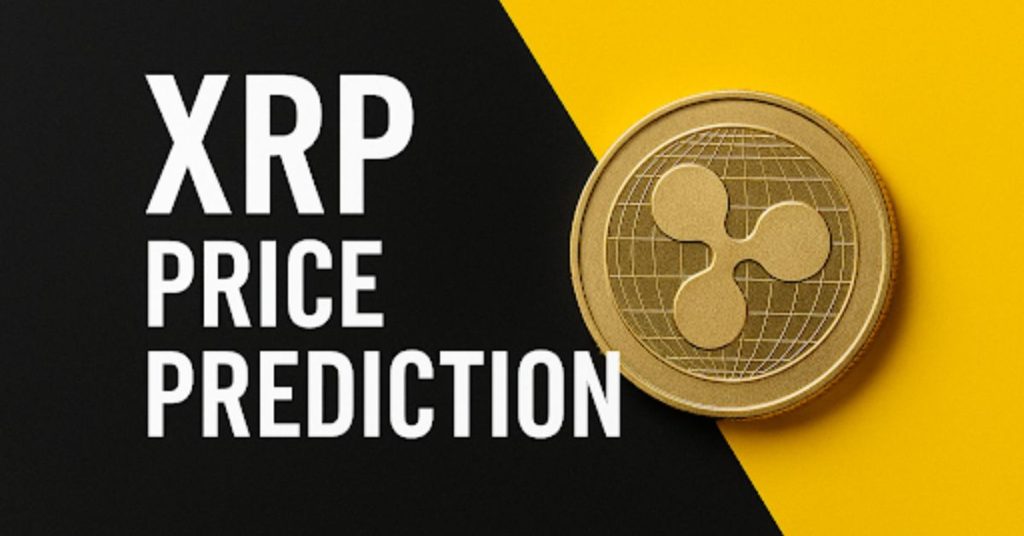
The post XRP Price Outlook for November 2025: Sentiment Turns Bearish, but Data Suggests Ripple’s Rally Is Far From Over appeared first on Coinpedia Fintech News
XRP Price chatter has turned cautious in November, with traders pointing to softer momentum and mixed headlines. Market depth is still strong, and recent corporate news ties XRP more tightly to real-world use.
A Ripple-backed venture is moving toward a public listing with a plan to hold large XRP reserves, which signals long-term confidence. For balance, investors also consider a payments newcomer, Remittix, against XRP to show where fresh demand could give the token a new boost.

XRP currently trades at $2.45 with a market cap of $147 billion and a 24-hour trading volume of $6.7 billion, reflecting active participation even during pullbacks. Live market tables list XRP alongside the largest tokens, underscoring continued liquidity. Short-term sentiment has cooled, with outlets flagging bearish signals on the chart into late October.
Reports noted that Ripple-backed Evernorth aims to raise more than $1 billion through a market listing to accumulate XRP, positioning it as a dedicated treasury. That plan supports the long view on network utility and payment corridors. The takeaway for November is balanced: near-term caution, but a stronger base case if support holds and liquidity stays firm.

XRP targets bank and enterprise settlement, yet timelines can be slow. Remittix enters the same payments lane with a tighter near-term focus on crypto-to-bank transfers and everyday payouts. Where XRP must convert regulatory and enterprise steps into broader volume, the Remittix approach centres on direct payment rails and a wallet that is already in community testing.
This makes Remittix relevant for users who want simple send-and-receive flows with fiat exits. It positions Remittix as a practical complement to XRP’s institution-led path in the current crypto market.
The Remittix DeFi project is fully verified by CertiK, ranked number one for Pre-Launch Tokens on Skynet, and the team has completed KYC. Wallet beta testing is live and is now opening to more holders, with iOS invites for the top ten weekly purchasers.
Remittix reports over 681 million tokens sold and is currently priced at $0.1166, with more than $27.7 million raised. BitMart and LBank listings are secured, with a third listing in progress. A limited-time RTX50 code offers a 50% token bonus, adding a clear incentive as the raise nears the $30 million mark.
Below are reasons why Remittix can capture share now:
For November, the base case for XRP Price is cautious but constructive. Liquidity remains healthy, corporate interest is rising, and any defence of support can reset the upside. The Evernorth plan reinforces use-led demand that does not depend only on short-term trading.
Remittix, on the other hand, adds a direct payments hedge to this picture with a live wallet beta, expanding tester pool, and a clear exchange pathway. That mix lets investors balance XRP’s institutional lane with Remittix for practical flows and steady adoption.
Discover the future of PayFi with Remittix by checking out their project here:
Website: https://remittix.io/
Socials: https://linktr.ee/remittix
$250,000 Giveaway: https://gleam.io/competitions/nz84L-250000-remittix-giveaway

The post Solana Price Holds Above $180 as Traders Eye a Breakout Toward $200 appeared first on Coinpedia Fintech News
Solana (SOL) price is inching closer to the crucial $180 mark, igniting speculation that a breakout toward $200 could be on the horizon. After weeks of steady gains and surging network activity, traders are debating whether this rally signals the start of a new leg higher—or the calm before a reversal. With bullish momentum building and key technical indicators flashing green, the next few sessions could determine whether Solana’s 2025 run is just getting started.
At press time, SOL trades near $186, down nearly 2.34% in the past 24 hours, as the broader crypto markets continue to experience significant upward pressure. Trading volumes across centralized exchanges have plunged, with open interest in Solana futures also dropping—signaling rising speculative activity.
Institutional flows also remain positive, as Solana continues to attract capital through staking platforms and DeFi protocols built atop its network. The blockchain’s growing DEX volume and steady NFT activity have added fundamental support to its price base.
The Solana price rally faced a halt after it failed to break above the pivotal resistance at $250. Moreover, the bearish start for the month strengthened the bears, while the US-China trade tensions helped the token to form an intraday low close to $170. Since then, the SOL price has been trying hard to break through the pivotal resistance at $200, but each attempt has failed. Currently, the token is consolidating just below this threshold, appearing to be accumulating strength to trigger a breakout soon.
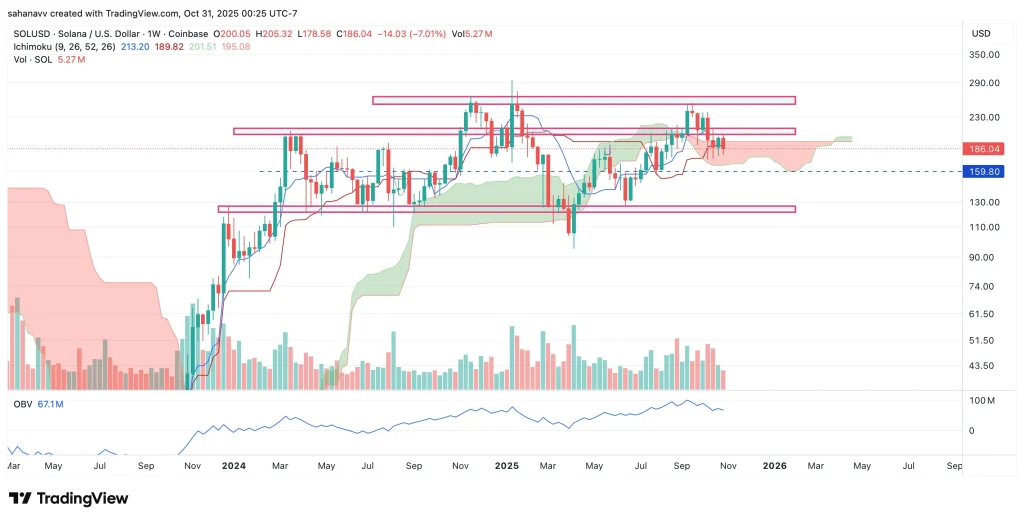
The latest pullback seems to have pushed the token into a brief consolidation phase as the price has entered the Ichimoku cloud, which is currently bearish. The levels have dropped below the baseline, and hence, continued bearish action could initiate a bearish crossover. Meanwhile, the On-balance volume has begun to form lower highs and lows, hinting towards a rise in the selling pressure on increasing volume. The volume is constantly flowing out of the crypto, which could weaken the rally in the short term.
The SOL price is heading towards a bearish close for the month as the RSI is draining both in the weekly and daily timeframes. However, the bulls may defend the pivotal resistance at $183, which could help the token to begin the November trade on a bullish note. The current trade setup suggests the price could rise above $200 and make it to $208 to $210 range in the early months. The support at $200 will hold the rally strong throughout the month and close the month above the resistance zone around $215 and $220.

The post Chainlink (LINK) Price Analysis Today – October 31, 2025: LINK Drops Below $17, Can Bulls Regain Control? appeared first on Coinpedia Fintech News
As of October 31, 2025, Chainlink (LINK) is trading near $17.05, down around 2.8% in the last 24 hours. The decline comes as broader crypto market momentum cools, with Bitcoin struggling to hold above $110,000.
Despite this pullback, LINK remains one of the top-performing altcoins over the past quarter, posting a 30% gain in Q3 2025 due to steady growth in Chainlink’s oracle adoption and integrations across DeFi protocols.
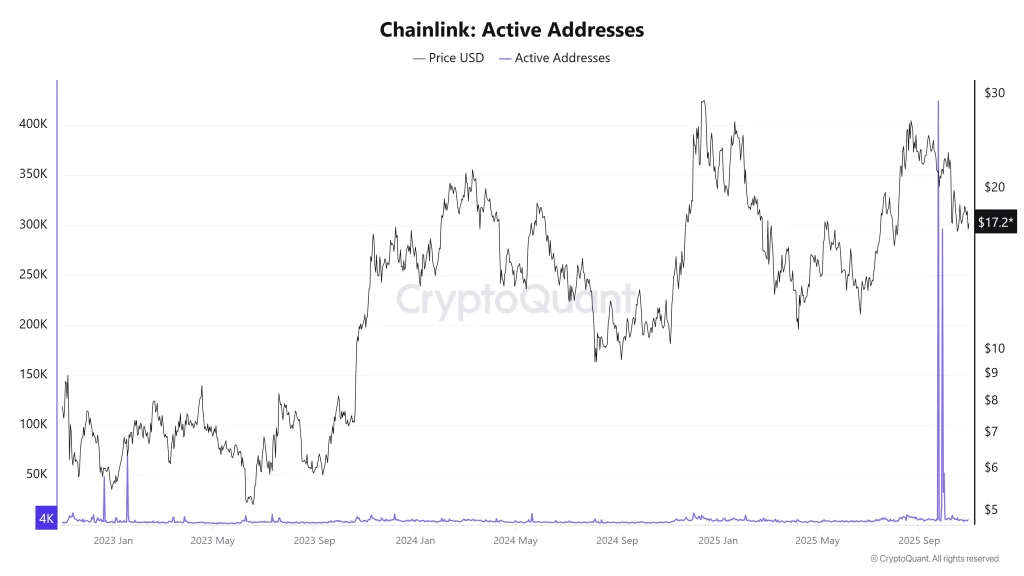
As per CryptoQuant, Recent on-chain data shows that whale transactions have slowed compared to last week, signaling reduced accumulation. However, the total number of active addresses remains stable, reflecting consistent user engagement within the Chainlink ecosystem.
Additionally, traders are closely watching Bitcoin’s next move, as LINK tends to mirror BTC’s short-term price action. A BTC rebound above $112,000 could help stabilize LINK above $17 once again
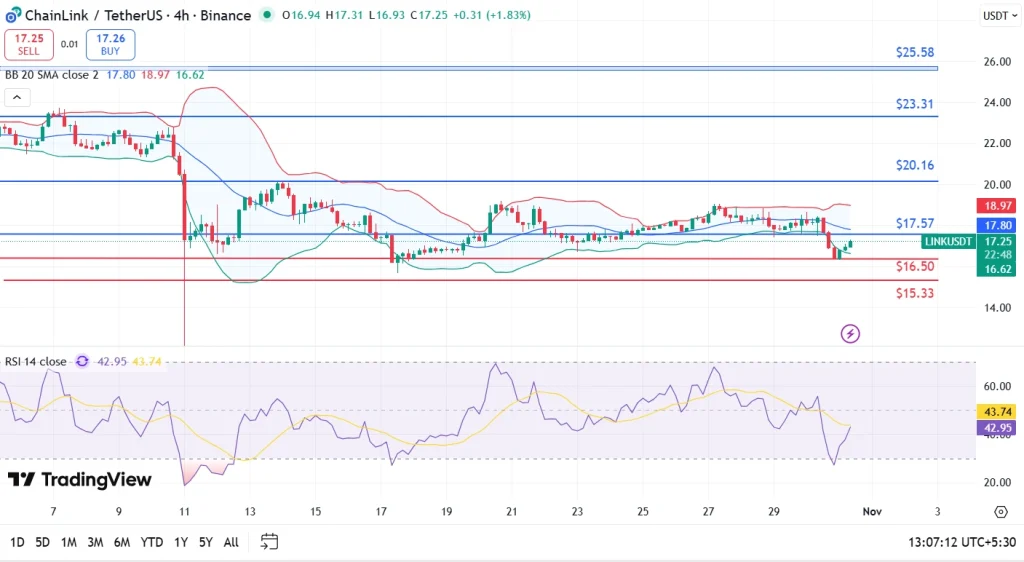
On the daily chart, LINK has broken below its ascending support line near $17.50, turning it into immediate resistance. The next major support lies around $16.5, followed by $15.8.
Looking ahead, the $16.5 support zone will likely determine LINK’s next direction. A successful defense could attract new buyers and push the price back above $18, while failure to hold may lead to a test of $15.5.
With Chainlink’s continued partnerships in real-world data tokenization and oracle expansion, long-term sentiment remains bullish, even if the short-term trend appears slightly bearish.
Chainlink price fell due to heavy institutional selling, loss of key technical support, and overall risk-off sentiment driven by Bitcoin’s correction.
Current support levels are at $16.50 and $15.33, while resistance stands at $17.20.
Spikes in active addresses signal rising on-chain activity and volatility, which could precede either a rebound or deeper decline, depending on how traders react to new momentum.
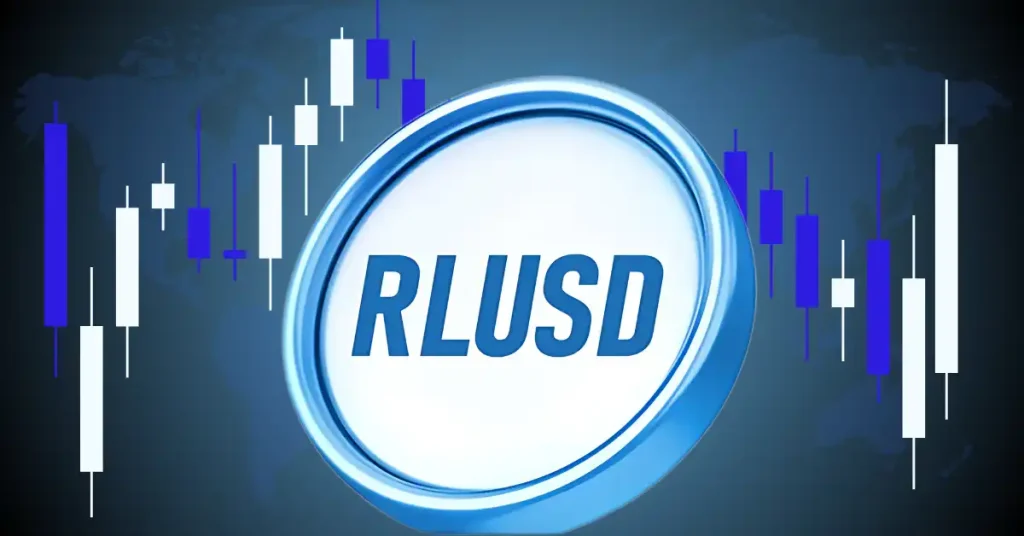
The post At Ripple Swell 2025, RLUSD Stablecoin Set to Redefine Global Payments appeared first on Coinpedia Fintech News
Ripple, the company behind XRP, is once again turning heads, this time with its game-changing stablecoin RLUSD. Ripple President Monica Long recently said that the growing use of RLUSD in real-world payments shows “real impact,” not just hype.
Her statement comes right before Ripple’s Swell 2025 event, where the company is expected to unveil major updates on how it’s using blockchain technology to reshape global finance.
Ripple’s stablecoin RLUSD is now being used to power instant, real-time payments around the world. According to Monica, more financial institutions are turning to Ripple because its technology lets them send money in seconds, something traditional banks still take days to do.
Built on both the XRP Ledger and Ethereum blockchain, RLUSD enables fast, low-cost, and transparent cross-border payments, making it ideal for businesses and charities alike.
One of the most powerful examples of RLUSD in action is how it’s helping nonprofits deliver aid faster than ever. Ripple has teamed up with global organizations like World Central Kitchen, Water.org, Mercy Corps, and GiveDirectly, all of which use Ripple Payments and RLUSD to send emergency funds within seconds.
In times of crisis, this speed isn’t just convenient, it’s life-changing.
Ripple’s Head of Stablecoin Strategy, Jack McDonald, revealed that the company has already deployed over $50 million worth of RLUSD this year across both the XRP and Ethereum networks.
The goal is to prove that blockchain payments can solve real-world problems, not just drive speculation or trading.
As Monica Long explained, Ripple’s mission is about “real adoption and real impact,” showing that blockchain can transform how the world moves money, making payments smarter, faster, and more meaningful.
The growing adoption of the RLUSD stablecoin signals a major shift in how people view money movement. With blockchain, Ripple is helping charities, corporations, and individuals avoid high banking fees, slow transfers, and outdated systems that have dominated global finance for decades.
In short, RLUSD isn’t just another crypto token; it’s a real-world utility stablecoin that proves how blockchain can power instant, borderless payments and drive financial inclusion worldwide.
As Ripple prepares for Swell 2025, the excitement is building. The company isn’t just developing technology, it’s building trust, showing the world that crypto and blockchain innovation can create real change, one transaction at a time.
Stay ahead with breaking news, expert analysis, and real-time updates on the latest trends in Bitcoin, altcoins, DeFi, NFTs, and more.
RLUSD is Ripple’s blockchain-based stablecoin built on XRP Ledger and Ethereum, enabling instant, low-cost, and transparent global payments.
Financial institutions and charities use RLUSD for real-time cross-border payments, moving funds in seconds instead of days.
Unlike trading-focused coins, RLUSD powers real payments on XRP and Ethereum, proving blockchain’s real-world impact and utility.
Ripple Swell is Ripple’s annual global conference showcasing blockchain innovations, real-world use cases, and financial partnerships.
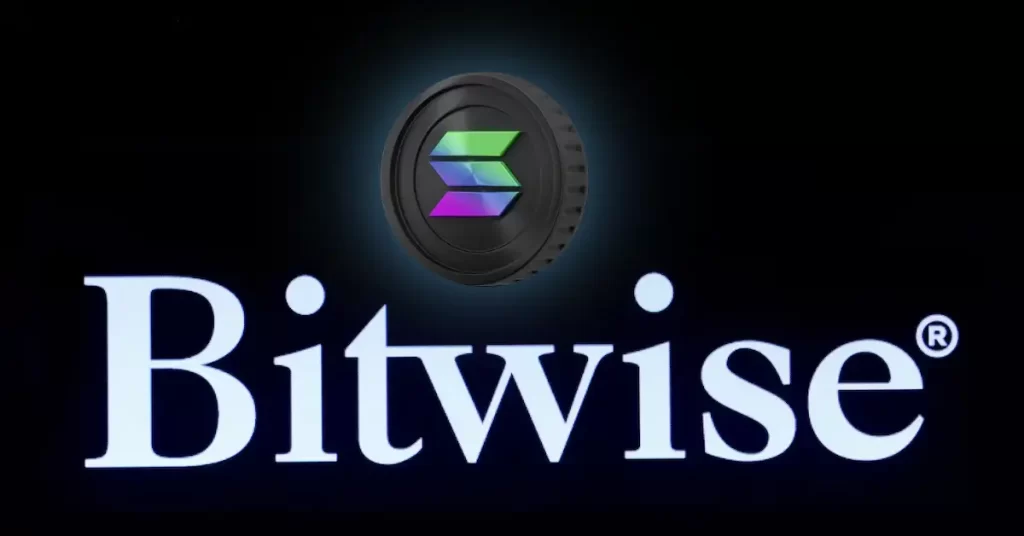
The post Bitwise CIO Reveals His Bullish Case for Solana, A ‘Two Ways to Win’ Strategy” appeared first on Coinpedia Fintech News
Could Solana become the next Bitcoin-level success story? Bitwise CIO Matt Hougan thinks so, and his reason is simple yet powerful. He believes the blockchain is sitting at the center of one of crypto’s biggest upcoming booms, with two powerful forces driving its rise.
But what exactly makes Solana so special, and why does Hougan think its growth could be “explosive”?
Hougan started by explaining how his favorite investments share one trait, they let you win in more than one way. For Bitcoin, he said, investors benefit if either the global “store of value” market expands or Bitcoin itself captures a larger piece of that market.
Today, the combined value of gold and Bitcoin sits around $27.5 trillion, with Bitcoin holding about 9% of that share. If this market doubles to $55 trillion and Bitcoin keeps its share, its value could also double.
And if Bitcoin’s share grows alongside the market, the upside multiplies. Hougan estimates that if Bitcoin eventually rivals gold’s dominance, its price could soar to $6.5 million per BTC.
3/ Today, the stricttore of value market is worth ~$27.5 trillion: $25tr for gold and $2.5tr for bitcoin. (You could argue that other assets are also part of that market, like silver, art, Ethereum, and real estate, but for the purposes of this thread I’ll keep it simple.)
— Matt Hougan (@Matt_Hougan) October 30, 2025
Hougan then applies this “two-way win” framework to Solana (SOL). In his view, Solana represents a dual opportunity:
Currently, Solana competes with Ethereum, Tron, and BNB Chain in powering stablecoin transactions and tokenized assets. Together, these four have a combined market cap of $768 billion, with Solana holding 14% of that.
Hougan believes that as tokenized assets and stablecoins reshape global finance, this market could grow 10x or more, and Solana is well-positioned to capture a bigger slice.
What makes Solana unique, according to Hougan, is its speed, usability, and community-driven innovation. He notes that institutions are beginning to take notice, citing Western Union’s recent choice of Solana as its stablecoin infrastructure.
For Hougan, Solana isn’t just another Layer-1 blockchain; it’s a platform poised to power the next wave of real-world finance. If both the tokenization market expands and Solana strengthens its position within it, he says, the results could be “explosive.”
As of now, Solana (SOL) is trading around $185.46 with a market cap hitting nearly $102 billion.
Stay ahead with breaking news, expert analysis, and real-time updates on the latest trends in Bitcoin, altcoins, DeFi, NFTs, and more.
According to our Solana price prediction 2025, the altcoin might chug up to a maximum of $400 by 2025.
Solana stock, with its strengths in fundamentals, still holds significant prominence. That said, we can expect its glory to shine brighter with resolutions to shortcomings and major Solana news.
Solana holds the potential to climb higher on the market cap rankings. The digital asset could make it to the target if it does not fall to negative criticism.
By 2050, a single Solana price could go as high as $72,459.

The post Bitcoin Whitepaper Turns 17 appeared first on Coinpedia Fintech News
Seventeen years ago, on October 31, 2008, Satoshi Nakamoto released the Bitcoin Whitepaper. This nine-page document laid out the foundation for a decentralized digital currency, revolutionizing how we think about money and freedom. What started as a small project has grown into a global financial movement. Today, Bitcoin is used worldwide, transforming industries and empowering individuals by providing a new form of trustless, peer-to-peer digital cash.
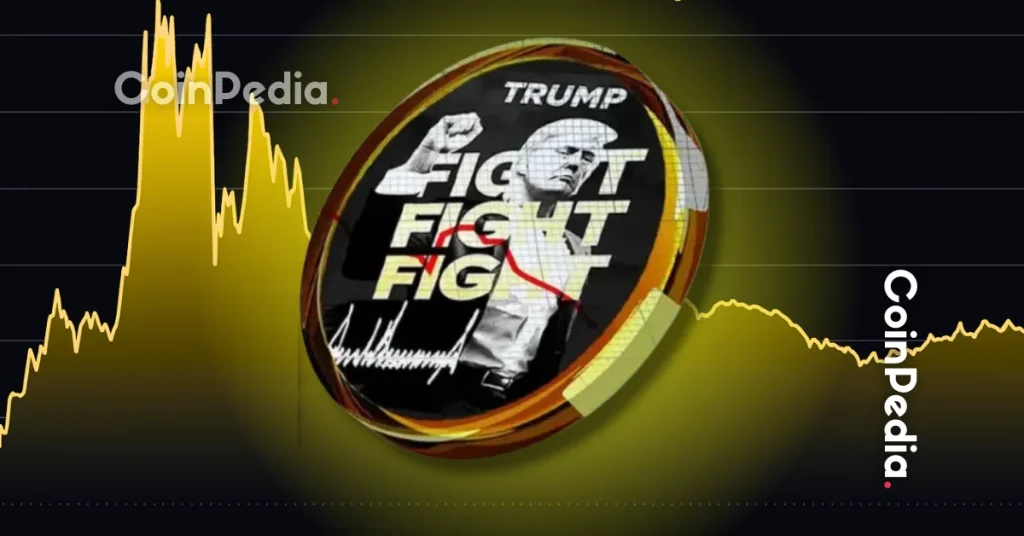
The post TRUMP Coin Price Halts at $8, A Pause or Trend Reversal Ahead? appeared first on Coinpedia Fintech News
Official Trump coin has been a headline driver lately, with a wild swing in price pushing traders to rethink their next moves. Just this week, TRUMP price leaped 36.17%, making waves amid broader crypto volatility. The latest drop of 2.11% in 24 hours seems modest compared to this sprint, but it hints that traders who rode the rally are now cashing out profits.
This wave of selling was most visible as the TRUMP coin price got rejected at $8.64, it has now landed just above $7.25. Behind all the action stands two key stories: first, the ongoing buzz about Fight Fight Fight LLC’s possible acquisition of Republic.com’s US platform. Second, the impact of Bitget’s Onchain Challenge phase 25, which renewed market interest and energized TRUMP’s recent run.
Looking at TRUMP’s performance, the coin currently trades at $8.07, marking a small downtick but still higher than last week’s levels. The market cap stands strong at $1.61 billion, with trading volume across exchanges hitting $1.71 billion in 24 hours. Price action details reveal a volatile range, with the session low at $7.14 and the high touching $8.44.
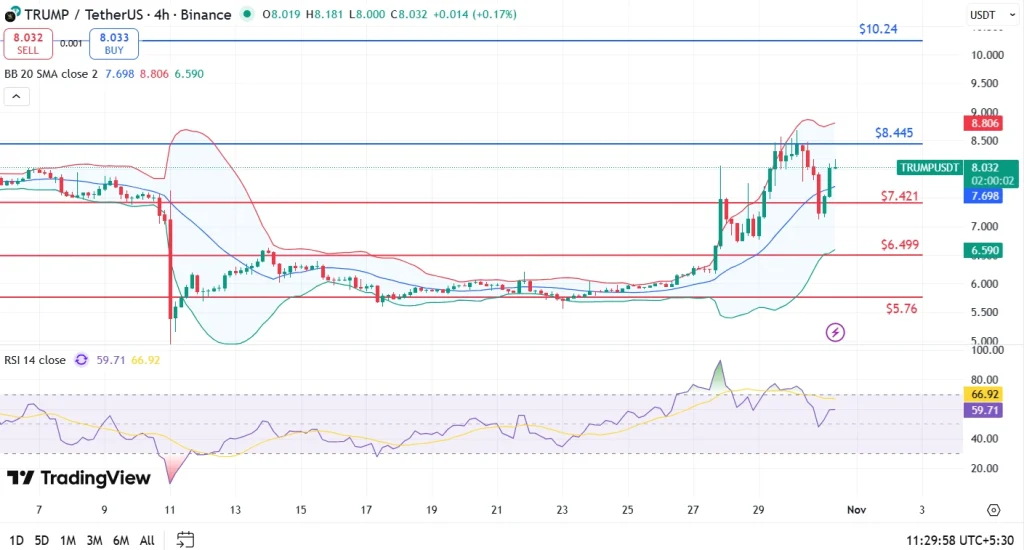
After a failed attempt to break $8.64, TRUMP memecoin price faces critical support at its 7-day SMA of $6.91. The RSI, now cooled to 64.76 after spiking toward overbought, signals buyers may have exhausted the latest push for now.
If the TRUMP price slips below $7.25, the next floor is $6.40, where a flush of sellers could barge in. Contrarily, regaining support above $7.77 would set the token back on the bullish map with sights on $10.24. The current sideways drift is a classic pause after an epic run, with risk and opportunity intertwined. For now, the TRUMP token is at a crossroads as investors watch for signs of new momentum or deeper correction.
TRUMP’s uptrend was sparked by its role in Bitget’s Onchain Challenge phase 25 and acquisition rumors that brought fresh capital and attention into the ecosystem.
TRUMP’s nearest reliable support zone sits around $7.25. A break lower could see losses extending to $6.40 if sellers dominate.
If TRUMP clears the $7.77 pivot point convincingly, bullish momentum could return with a potential run toward $10.24, especially if acquisition speculation picks up.
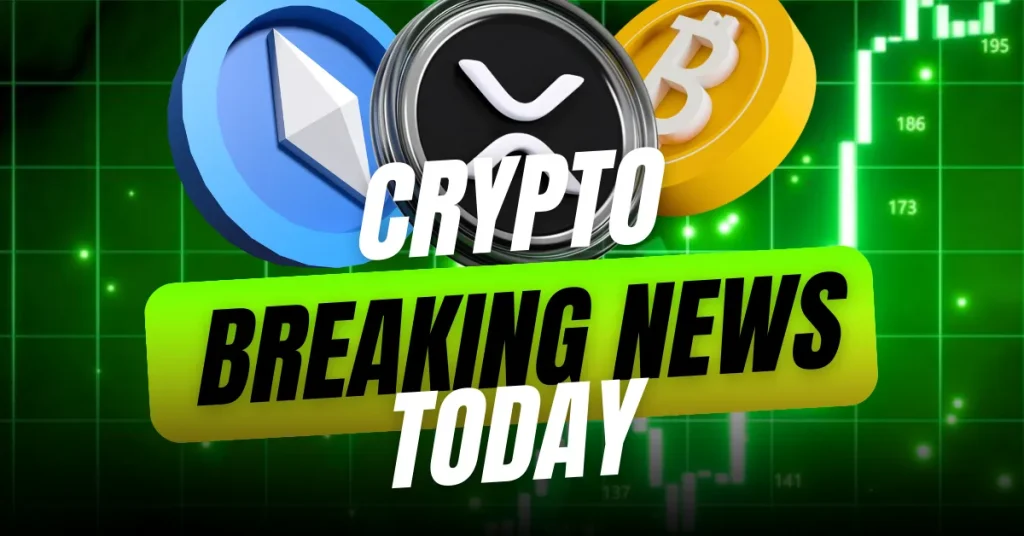
The post Crypto News Today [Live] Updates On October 31 2025 appeared first on Coinpedia Fintech News
October 31, 2025 07:50:15 UTC
A new SEC filing shows that Virtu Financial, Inc. — a global market-making and execution firm — holds a significant amount of XRP in addition to Bitcoin and Ethereum on its balance sheet. According to crypto lawyer Bill Morgan, the company appears financially strong and well-positioned.Virtu operates in over 50 countries and across 25,000+ securities, using high-frequency trading algorithms to provide liquidity in equities, ETFs, fixed income, commodities, and derivatives — signaling growing institutional integration of digital assets like XRP.
October 31, 2025 07:45:53 UTC
A prominent trader believes Bitcoin could find its bottom by mid-November, based on the projected intersection of the 50-day and 200-day SMAs a pattern that has historically marked local lows. He expects BTC could briefly wick down to the $98K range, which aligns with strong support zones, yet still remain within a bull market structure. Despite weakening price action, he argues sentiment never reached euphoric levels typical of cycle tops. The analyst sees the bull market extending into early 2026, urging investors to stay patient, hold BTC until new all-time highs, and only then rotate gradually into altcoins.
October 31, 2025 07:38:35 UTC
Bitcoin option traders are showing signs of tension as short-term implied volatility surges, while longer-dated contracts remain steady a move that hints at an incoming catalyst few are ready for. In contrast, Ethereum’s volatility curve is flattening, suggesting deeper structural uncertainty and a shifting long-term outlook.Traders have been scrambling to hedge macro and expiry risks, causing front-end skew to blow out and snap back quickly. Analysts say this divergence between BTC and ETH options could signal a rare mispricing opportunity across crypto volatility markets.
October 31, 2025 06:53:03 UTC
Veteran trader Peter Brandt shared an honest take on the mental challenge of trading, admitting it feels “intellectually and emotionally awkward” to hold contrary positions across different accounts. Brandt explained that while he’s a long-term Bitcoin investor, his swing trading account is currently short BTC futures, based on a megaphone pattern he’s tracking. His post underscores the tricky balance many traders face when separating long-term conviction from short-term strategy in volatile markets like crypto.
Do others besides me find it a bit awkward intellectually/emotionally when you hold contrary positions in accounts designed to trade different systems/time frames?
— Peter Brandt (@PeterLBrandt) October 30, 2025
As an investor I have owned Bitcoin for years
As a swing trader I am now short $BTC futures based on megaphone pic.twitter.com/bZZDwbypSh
October 31, 2025 06:51:52 UTC
Binance has rolled out QR-based crypto payments in Argentina, letting users pay for goods and services instantly and fee-free. Shoppers can now scan any merchant’s QR code with the Binance app and pay directly using crypto like BTC or USDT, which is automatically converted to pesos at market rates via a regulated local partner. “This brings crypto into everyday life — fast, secure, and simple,” said Andrés Ondarra, Binance’s Argentina GM. The feature, powered by Binance Pay, strengthens real-world crypto use in one of Latin America’s most QR-driven economies.
October 31, 2025 06:50:52 UTC
Sam Bankman-Fried insists that FTX was never actually insolvent, arguing that the missing $8 billion in customer funds never left the platform. According to new bankruptcy filings, nearly 98% of creditors have already received 120% repayment, with total recoveries expected between 119% and 143%. Even after paying off $8 billion in claims and $1 billion in legal fees, the FTX estate reportedly still holds around $8 billion, reigniting debate over the company’s collapse and SBF’s ongoing defense.
October 31, 2025 06:50:02 UTC
Roundhill has filed for a U.S. Government Portfolio ETF, a fund designed to hold the same assets the U.S. government invests in. Essentially, it acts as a “White House asset management tracker,” giving investors a peek — and a stake — in the federal portfolio itself. The move highlights a growing trend of transparency-themed financial products that let retail investors mirror institutional or government-level strategies.
October 31, 2025 06:49:11 UTC
Altcoin markets are facing another rough day, with most major tokens hitting fresh lows. Investor sentiment is also sinking, reflecting growing caution across the board. However, analysts suggest that a major macroeconomic shift could be approaching, one that may turn the tide for risk assets like crypto. For now, traders are advised to stay patient and “hang tight.”
October 31, 2025 06:48:21 UTC
Once the Clarity Act passes, Ripple will need to hold less than 20% of XRP’s total supply to ensure the token isn’t classified as a security. Reports suggest Ripple may transfer part of its holdings to the U.S. government, aligning with compliance requirements and opening the door for IMF involvement. Under this structure, the IMF could set XRP’s global price, as it can only adopt assets already recognized by nations — fueling speculation that XRP could become the new e-SDR.
October 31, 2025 06:42:25 UTC
Canary Funds has updated its S-1 filing for the $XRP spot ETF, removing the “delaying amendment” that allows the SEC to control the timing. This move clears the path for an automatic launch on November 13, pending approval from Nasdaq’s Form 8-A. The timeline could shift slightly depending on the government’s reopening and any SEC comments. Interestingly, SEC Chair Paul Atkins praised firms using this auto-effective route, the same method used by Bitwise and Canary for their recent $SOL, $HBAR, and $LTC ETFs.
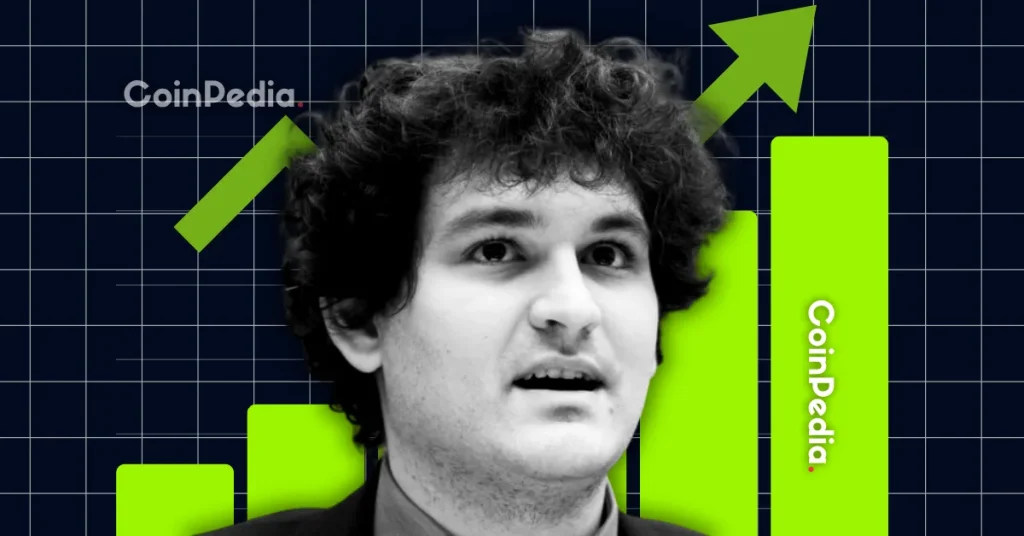
The post “FTX Was Never Bankrupt,” Claims Sam Bankman-Fried appeared first on Coinpedia Fintech News
According to new court filings, bankrupt crypto exchange FTX now holds around $136 billion in assets. The revelation has reignited debate about the company’s dramatic collapse and its controversial founder, Sam Bankman-Fried (SBF), who now insists that FTX “was never bankrupt.”
FTX’s estate, which once faced an $8 billion shortfall, is now overflowing with assets spread across crypto, equity, and cash. Its portfolio includes $14.3 billion in Anthropic equity, $7.6 billion in Robinhood stock, $1.2 billion in Genesis Digital Assets, and $600 million in SpaceX shares through K5 Global.
FTX holds 58 million SOL worth $12.4 billion, 890 million SUI ($2.9 billion), 205,000 BTC ($2.3 billion), 225.4 million XRP ($600 million), and 112,600 ETH ($500 million). Add to that $1.7 billion in cash and $345 million in stablecoins, and the numbers show how dramatically the value of FTX’s holdings has surged during the 2024–2025 bull run.
Reports suggest that 98% of creditors have already received 120% repayment, with final payouts projected to reach up to 143%, meaning most users will ultimately get back more than they lost.
SBF’s legal team now argues that FTX was never insolvent, claiming customer assets “never left the platform” and that the exchange was solvent on a “fair-value basis” even during bankruptcy. But many in the crypto community see this as a desperate attempt at rewriting history.
On-chain investigator ZachXBT blasted the claim, noting that creditors were repaid at November 2022 prices, when crypto values had crashed, not at today’s levels.
“You clearly haven’t learned anything from your time in prison,” he wrote, accusing SBF of twisting facts to justify his past actions.
Another X user pointed out that the bankruptcy court already approved a $16.5 billion recovery, which wouldn’t have been necessary if FTX had truly been solvent.
“If FTX wasn’t bankrupt,” they asked, “why did SBF file for bankruptcy, resign as CEO, and scramble for emergency funding in November 2022?”
Legal experts warn that the estate’s newfound wealth doesn’t erase the original fraud allegations.
“This recovery highlights how volatile valuations can distort bankruptcy outcomes, but it doesn’t absolve criminal conduct,” said a securities attorney familiar with the case.
The turnaround also raises questions about future crypto bankruptcies, with creditors from Celsius and BlockFi now citing FTX’s example to push for greater asset transparency.
Meanwhile, the market has reacted cautiously. Solana, heavily tied to FTX’s holdings, briefly rose 3% after the filings, while speculation about a possible FTX 2.0 reboot has resurfaced among traders.
The news comes amid political controversy following Donald Trump’s pardon of Binance founder CZ, sparking rumors that SBF could also be considered for clemency. Many investors, however, argue that such a move would damage public trust.
“It’s great we’re getting more than we lost,” said one former FTX user on Reddit. “But it doesn’t erase the chaos and sleepless nights we went through.”
FTX’s financial comeback is undeniable, but its founder’s credibility remains shattered. The company may have regained its fortune, yet its reputation and the trust of millions it once served may never fully recover.
Stay ahead with breaking news, expert analysis, and real-time updates on the latest trends in Bitcoin, altcoins, DeFi, NFTs, and more.
FTX now holds about $136 billion in assets, boosted by rising crypto and equity values during the 2024–2025 bull market.
Yes. Creditors are expected to receive up to 143% repayment, meaning most users recover more than their original deposits.
SBF claims FTX was solvent on a fair-value basis, but critics argue it’s an attempt to rewrite history after the 2022 collapse.
There’s renewed speculation about an FTX 2.0 reboot, but no confirmed plans. Legal and trust issues remain major hurdles.

The post SBF Says FTX Was Never Insolvent appeared first on Coinpedia Fintech News
Sam Bankman-Fried (SBF) claims that FTX was never insolvent. When FTX filed for bankruptcy, the $8 billion in customer assets remained on the platform. Almost all customers have been or will be repaid between 119% and 143% of what they lost. Around 98% of creditors have already received 120%. After covering $8 billion in claims and $1 billion in legal fees, the bankruptcy estate still holds $8 billion. This shows a significant recovery for FTX customers despite the platform’s collapse.






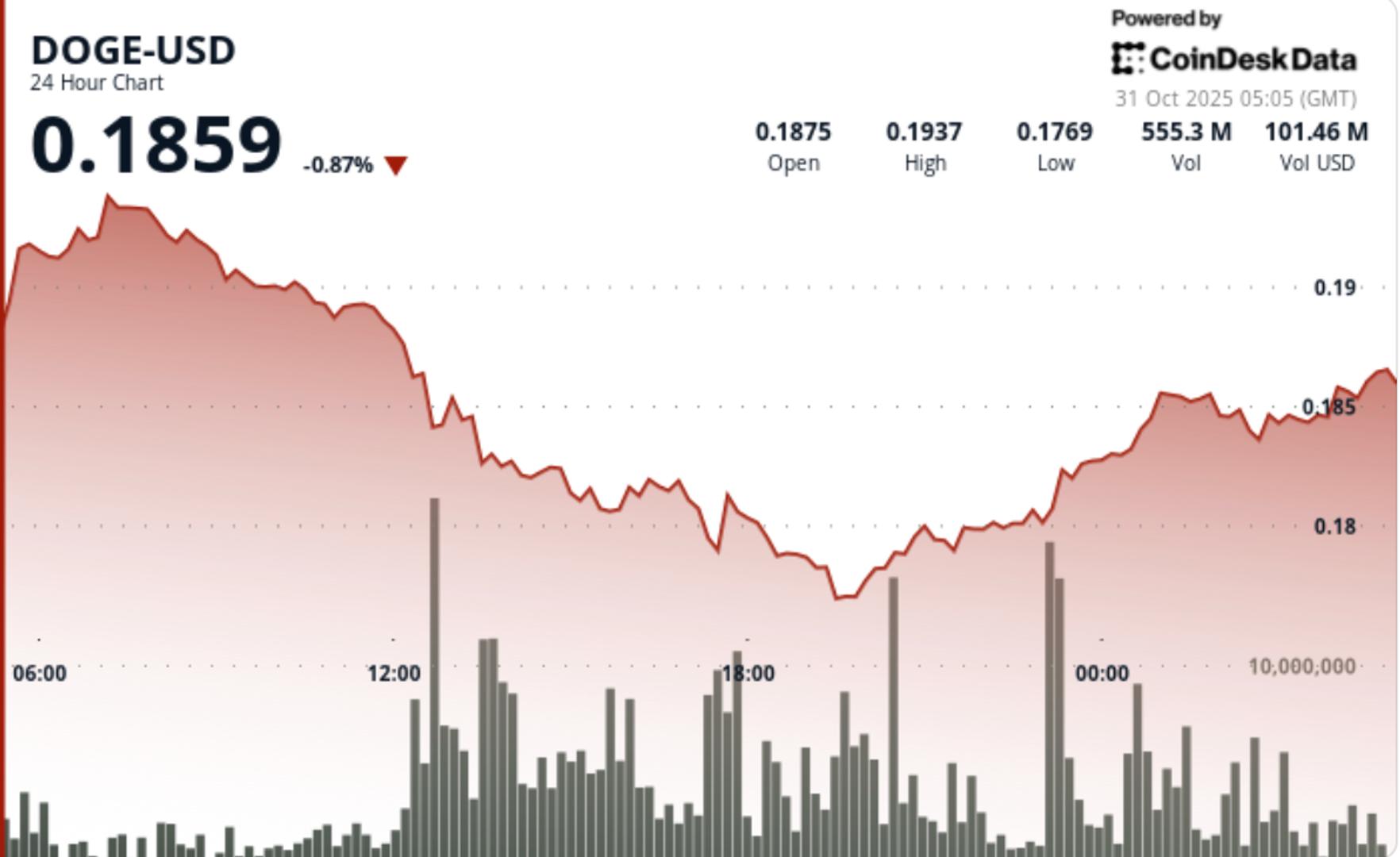



Spot Ether ETF inflows have surpassed Bitcoin ETFs during the third quarter of 2025, signaling dormant appetite for regulated altcoin investments.

Bitwise’s Matt Hougan said Solana has good odds of winning a larger share of the stablecoin and tokenization market.

A trademark filing by Western Union for “WUUSD” suggests the company is looking into building crypto wallet, crypto trading and even crypto lending services.

Nordea announced in 2018 that it would ban employees from buying and holding Bitcoin due to concerns that the crypto market was unregulated.

Revolut has made on and off-ramping to crypto easier by removing fees, spreads and other costs, allowing users to convert USD and stablecoins at a 1:1 ratio.

Strategy is unlikely to make deals to acquire its Bitcoin-buying rivals, with founder Michael Saylor saying it’s too risky.

Salesforce's Agentforce 360 weaves AI agents into every part of its platform, making intelligence feel seamless while keeping trust, control, and visibility.
The post Salesforce ‘Agentforce 360’: LLMs enter enterprise suites appeared first on CoinGeek.
Mastercard aids Uzbekistan in its digital payments adoption after identifying hurdles, while Nestlé future-proofs its operations with a major upgrade.
The post Uzbekistan faces hurdles; Nestlé powers up with AI appeared first on CoinGeek.
The CEO's unexpected remarks highlight the growing intersection of corporate communications and prediction markets, impacting trader strategies.
The post Coinbase CEO turns earnings call into unexpected jackpot for prediction market traders appeared first on Crypto Briefing.

Ethereum's low exchange supply and increased shorts may trigger a price surge, reflecting typical market cycle dynamics and investor behavior.
The post Ethereum falls to $3.7K as major shorts hint at price rebound: Santiment appeared first on Crypto Briefing.

The claims challenge the bankruptcy narrative, potentially impacting ongoing legal proceedings and efforts to recover user funds.
The post SBF’s X account claims company was never bankrupt despite legal filing appeared first on Crypto Briefing.


Despite the Federal Reserve (Fed)’s announcement of a 25-basis-point rate cut, Bitcoin (BTC) has dropped nearly 4% in the past 24 hours, losing its local range low for the first time in a week. Some analysts have warned that this week’s close is crucial for the flagship crypto’s short-term performance.
On Thursday, Bitcoin dropped below the recently reclaimed $110,000 area, hitting a one-week low of $106,700. Notably, the cryptocurrency has been trading within the $108,000-$120,000 price range since July, but has failed to reclaim the range highs after the early October correction.
Amid this performance, Ted Pillows suggested that the market volatility was expected, as BTC has shown a similar price action since the start of Q3. The analyst explained that Bitcoin has dropped 6%-8% after the last three Federal Open Market Committee (FOMC) meetings, but it has also made a new all-time high (ATH) before the next one.
According to the chart, BTC’s price reached its local bottom 5-9 days after the meeting, quickly recovering from the drop and rallying to new highs in the coming weeks. As price retests the $106,000 area, Ted predicted that a repeat of the same playbook could happen.
However, he warned that Bitcoin must reclaim the $113,500 in the coming days to prevent a larger pullback. “A weekly close below that level will increase the likelihood of a bigger correction,” the analyst explained.
Similarly, Rekt Capital pointed out that Bitcoin must close the week above the $114,500 to turn this level back into support. He noted that after the recent performance, a volatile retest of this level would be “perfectly fine” as long price closes above this crucial level at the end of the week.
Confirming the Range Low of ~$114k as support would confirm re-entry into the Range, kickstart consolidation within the Range again, and enable a move across it towards the Range High of ~$119000 (red) in an effort to breakout from it and challenge $120k+ once again.
Michaël van de Poppe affirmed that $112,000 is the next key area to break before a new ATH, as it has been a crucial resistance level in the daily timeframe for the past few weeks. Per the post, a breakout from this area could set the base for a retest of the $119,000-$120,000 zone.
On the contrary, a rejection from this level could send the price toward the $103,000 mark or lower, he warned. “I do think we’ll see a new ATH in November,” the market watcher added.”
Meanwhile, Daan Crypto Trades highlighted that BTC is “just playing ping pong” between its key levels and will continue to move within its range until one of the boundaries is successfully broken.
The trader added that November is one of Bitcoin’s best months based on historical performance, which could suggest that a price rally could be near. Notably, 8 out of 12 Novembers have closed in green, with a median return of 10.82%, according to CoinGlass data.
Moreover, he noted that the last two months of the year are when the three previous bull runs topped and the past two bear markets bottomed. “Whether it’s on the bullish or bearish side, volatility and big market pivots have been the theme into the end of the year,” he concluded.


According to market figures, Dogecoin remains one of the largest cryptocurrencies by market value, carrying a market cap near $28 billion.
The token’s price has fallen sharply lately — about 20% in the last month and roughly 30% so far in 2025 — moves that have put traders and casual holders on edge.
Dogecoin started as a joke. Based on reports, its creators never set out to build a major payments system or a technical breakthrough.
That origin still matters. On-chain activity and payment volume for DOGE are lower than for many rivals, and that makes the token prone to sudden, often large swings. Quick rallies happen. Sudden drops do too.
A wider shift in the crypto market is also at work. Reports show meme tokens have lost favor this year. That pullback has pushed coins with weaker fundamentals into deeper declines. When markets turn cautious, speculative coins are usually hit hard.
Despite the memecoin’s dismal performance of late, Dogecoin price prediction points to an increase of 13% and reach $ 0.21 by November 29, 2025. Based on technical indicators, the current sentiment is Bearish while the Fear & Greed Index is showing 34 (Fear).
Still, some traders believe this downturn may be the point where the real gains begin, arguing that DOGE’s strongest rallies often follow periods of fear and steep declines.
Those numbers show mixed signals: the model expects gains over the coming month, while short-term indicators point to weak momentum and fear among traders. That split can lead to choppy trading, where prices move up for a few days and then fall again.

Community interest and media attention still move DOGE. Big social moments can lift prices quickly. They can also reverse direction just as fast.
That dynamic separates Dogecoin from projects that trade mainly on protocol upgrades or corporate deals. For many investors, headlines matter more than slow technical progress.
Foundational MovesBased on reports, the Dogecoin Foundation has been pushing to build a more formal ecosystem. Plans and partnerships have been discussed. Whether those efforts will change how the market values DOGE is uncertain. Some proposals take months to show results. Others remain only ideas until wider adoption appears.
DOGE Optimism Still HighDogecoin’s sharp slide this year reflects both its meme-coin roots and a market-wide move away from risky crypto assets. The key figures are plain: nearly $28 billion in market cap, a 20% drop in the past month, and 30% down for the year. Reports and models show a possible bounce to $ 0.2146 by November 29, but technical signals still read Bearish.
Even so, some market watchers think this could be the setup for the next big DOGE rally, arguing that major recoveries often begin when sentiment is at its weakest.
Featured image from Unsplash, chart from TradingView

In a recent financial disclosure, two of the crypto industry’s giants, Coinbase (COIN) and Strategy (MSTR), reported significant gains in their third-quarter (Q3) results.
Coinbase exceeded analysts’ expectations for its Q3 profit, buoyed by increased volatility in digital assets that elevated trading volumes on its platform. The company reported a transaction revenue of $1.05 billion for the quarter, a substantial rise from $572.5 million during the same period last year.
Additionally, the cryptocurrency exchange recorded a net income of $432.6 million, translating to $1.50 per share, compared to just $75.5 million, or $0.28 per share, a year prior. Analysts had projected a profit of $1.06 per share, according to Reuters.
Coinbase also completed its acquisition of Deribit in the third quarter. Alesia Haas, the company’s finance chief, noted during a conference call that Deribit commands over 75% of the market share for options, primarily outside the US.
This acquisition opens pathways for Coinbase to expand its options market within the US. As part of its broader strategy, Coinbase also highlighted its commitment to accelerating payments through stablecoin adoption, citing favorable policy trends and growing interest from financial institutions and corporations.
David Bartosiak, a stock strategist at Zacks Investment Research, remarked, “Coinbase is cash-rich and growth-ready,” emphasizing that the company is evolving beyond merely trading cryptocurrencies to establishing the infrastructure for a new financial internet.
Meanwhile, Strategy, previously MicroStrategy, reported profits in the third quarter after experiencing a loss the previous year. This positive sentiment surrounding the cryptocurrency sector has benefited the company, which is the largest corporate Bitcoin (BTC) holder.
As of October 26, the company held 640,808 Bitcoin, with a total acquisition cost of $47.44 billion, averaging $74,032 per BTC. With the market’s leading crypto currently trading around $107,400 when writing, the company’s holdings are positioned for significant appreciation.
Strategy’s net profit for the three months ended September 30 was reported at $2.78 billion, or $8.42 per share, contrasting sharply with a loss of $340.2 million, or $1.72 per share, a year earlier. However, it’s worth noting that Strategy’s shares have declined 12% so far in 2025, even as Bitcoin prices have risen by 14.5%.
COIN stocks closed Thursday’s trading session with a 3% surge toward $328 on the wake of the financial disclosure. Similarly, Strategy’s shares climbed nearly 4% following its earnings report toward the $254 mark.
Featured image from DALL-E, chart from TradingView.com

Zcash (ZEC) is stealing the spotlight once again. The privacy-focused asset has surged more than 50% in the past week, climbing above $350 and fueling talk of a potential return to the top 20 digital assets by market capitalization.
Related Reading: Bitcoin Technical Setup Shows Short-Term Pullback May Fuel Long-Term Upside
Behind this rally lies a mix of technical strength, institutional catalysts, and renewed global demand for digital privacy.

Supporting Zcash’s resurgence is a major milestone. 4.5 million ZEC are now stored in shielded addresses, representing roughly 28% of total supply.
These shielded pools leverage Zcash’s zero-knowledge proof technology (zk-SNARKs), allowing users to transact privately without revealing sender, receiver, or transaction amounts.
This rise in shielded coins signals growing trust in ZEC’s privacy infrastructure, especially as wallets and exchanges improve support for shielded transactions. The move also expands Zcash’s overall anonymity set, strengthening privacy for all participants while tightening on-chain liquidity.
As one of the oldest and most advanced privacy blockchains, ZEC’s growth in shielded adoption reinforces its core mission of financial confidentiality in an increasingly monitored digital world.
Zcash’s market momentum remains robust. Daily trading volume soared above $730 million, while the RSI at 71.8 and a bullish MACD crossover suggest strong buying pressure.
The token’s structure continues to make higher highs and higher lows, indicating a healthy uptrend. Analysts see resistance near $370–$400, with a potential breakout opening the path toward $450–$500 in the coming weeks.
ZEC’s recent surge also coincides with Arthur Hayes’ bold prediction that the coin could reach $1,000, as the market rotates into privacy-focused assets.
With Grayscale’s Zcash Trust surpassing $137 million in assets under management, and whispers of a possible ETF conversion, institutional exposure could further amplify this rally.
Zcash’s resurgence reflects a broader renewal of interest in privacy tokens like Monero (XMR) amid heightened surveillance and KYC mandates in global markets. As governments tighten oversight, traders and institutions are rediscovering ZEC’s unique role as a bridge between compliant infrastructure and privacy rights.
Related Reading: Bitcoin Crash To $87,600 Looms If This Support Snaps, Warns Veteran Analyst
If Zcash sustains its current momentum, maintains its 4.5M shielded supply growth, and breaks the $400 ceiling, a return to the top 20 cryptos by market cap could soon become reality, supporting ZEC’s comeback as the flagship privacy asset of this cycle.
Cover image from ChatGPT, ZECUSD chart from Tradingview

What if the next big crypto rocket is already fueling up and you’re still watching from the ground? The hunt for the best crypto to join now is heating up as investors race to find the next gem before it blasts off. Timing matters more than ever when meme energy meets real token utility and community strength.
People chase the best crypto to join now like it’s a meme coin gold rush where early birds grab the fattest worms. TRON and Solana are big names making bold moves, but MoonBull ($MOBU) is the one getting talked about in every presale group chat. Its presale momentum, community design, and early rewards make it hard to ignore.
MoonBull ($MOBU) is turning heads across the meme coin space and quickly earning the label of best crypto to join now. Built on the Ethereum network, it focuses on fairness and sustainability. The token rewards early backers through a 23-stage presale, 95% APY staking, and an auto-liquidity system that stabilizes prices with every trade. Holders earn token reflections while regular burns reduce supply, increasing scarcity over time.

Two features help build real trust. The project passed its audit and locked liquidity for the long term, proving transparency isn’t just a promise. Community voting starts mid-presale, giving holders control over burns and marketing pushes. One token equals one vote, creating a fair and open decision process. This setup makes MoonBull more than hype; it’s a community-driven system with real decision-making power.
MoonBull’s fifth presale stage is live at $0.00006584, with over $500K raised and more than 1,600 holders. Current ROI has climbed to 9,256% from Stage 5 to its listing price of $0.00616, while early joiners have already seen 163.36% gains. The next price jump is 27.40%. A $20,000 investment today is equivalent to about 303,766,707 $MOBU, potentially worth $1,871,202.92 at listing.
TRON continues to prove why it remains a reliable option for investors searching for the best crypto to join now. Its ecosystem now hosts over $80 billion in USDT, outpacing Ethereum’s stablecoin activity. Recent governance votes reduced transaction fees by 60% to strengthen competitiveness and drive adoption, showing TRON’s focus on real usability.
Network activity recently spiked, hinting at renewed investor confidence and potential for price recovery. TRON’s role as a high-volume, low-cost blockchain positions it well for long-term stability. While its growth might not match the wild swings of newer tokens, it delivers consistency and utility. That’s why TRON still earns a place in conversations about the best crypto to join now. It’s reliable, battle-tested, and globally active.
Solana, another major player in the race for the best crypto to join now, continues gaining institutional attention. A public company recently added over 2.3 million SOL, worth about $20 million, to its treasury, showing real confidence in Solana’s scalability. The launch of the $GSOL ETF on NYSE Arca brought Solana staking exposure to traditional investors, further expanding its reach.
These developments boost Solana’s credibility and liquidity. The chain’s high throughput, active DeFi and NFT communities, and strong institutional backing make it a premium choice for investors who prefer established ecosystems. While its upside may be steadier than meme coins’, Solana’s infrastructure ensures it remains among the top candidates for the best crypto to join now.

Solana shines with institutional growth, TRON delivers real-world utility, and MoonBull delivers early-stage excitement with high-potential returns. MoonBull’s mix of staking, referral bonuses, and community control sets it apart as the best crypto to join now for those who want both hype and real mechanics.
Based on research and market trends, MoonBull ($MOBU) is shaping up as the next major presale success story. Its momentum is building, tokenomics are solid, and early investors are already seeing real gains. The presale is live, and time is ticking. Those who act early could see massive growth from a small entry.

For More Information:
Website: Visit the Official MOBU Website
Telegram: Join the MOBU Telegram Channel
Twitter: Follow MOBU ON X (Formerly Twitter)
MoonBull ($MOBU) leads current presales with staking rewards, liquidity locks, and governance, making it the top meme coin contender.
Yes, MoonBull’s 23-stage presale is one of 2025’s biggest, offering early buyers exclusive pricing and rewards.
Follow verified launchpads, crypto news sites, and official project pages that share presale details.
Look for tokens with locked liquidity, transparent audits, and active communities like MoonBull’s.
MoonBull ($MOBU) currently leads with its structured presale and high-yield staking.
MoonBull ($MOBU), TRON (TRX), and Solana (SOL) all compete for the title of best crypto to join now. TRON offers stability, Solana brings institutional confidence, and MoonBull’s presale combines meme energy with real mechanics, making it the most exciting early-entry opportunity in 2025.
Read More: Could MoonBull Be the Best Crypto to Join Now? TRON Slashes Fees by 60% and Solana Sees Major Whale Buys – Market Update">Could MoonBull Be the Best Crypto to Join Now? TRON Slashes Fees by 60% and Solana Sees Major Whale Buys – Market Update



With gold recently seeing new ATHs, how high would XRP price go if the market witnessed a 5% capital rotation from gold to XRP? While the broader crypto market has faced bearish pressure, leading to price struggles for Bitcoin (BTC) and altcoins like XRP, gold has been an excellent performer.
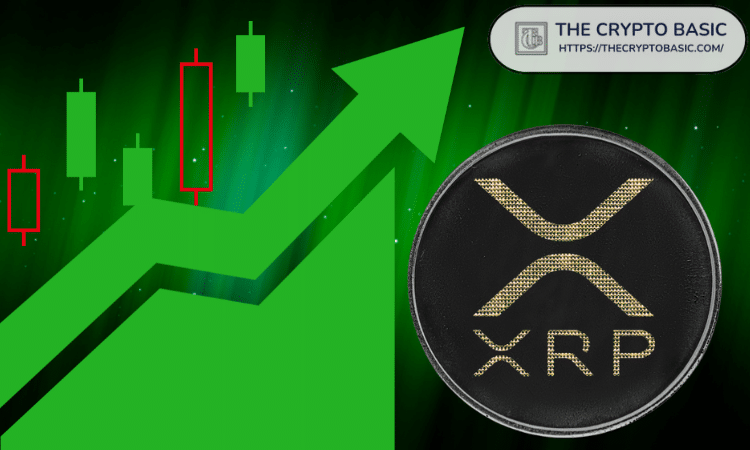
Prominent analyst EGRAG Crypto insists XRP has not reached its top for this cycle, leveraging the Gaussian Channel to share his bull run target. Notably, XRP and the wider crypto market started a recovery earlier this week, but the momentum has slowed as prices met resistance.
A surging crypto market powered Coinbase Global to a stronger-than-expected third quarter, with the exchange reporting significant beats on both profit and revenue as trading activity boomed and its services division hit a new record.
The impressive results, which reflect a crypto market that saw Bitcoin reach an all-time high during the quarter, underscore the company’s successful strategy of catering to advanced traders and expanding its institutional offerings.
The news sent Coinbase stock up as much as 2.6% in after-hours trading.
Coinbase’s financial results significantly outpaced the same period last year.
The company reported a net profit of $433 million, or $1.50 per share, a massive increase from just $75.5 million a year ago.
Net revenue for the quarter tallied $1.79 billion, up from $1.13 billion in the prior year.
This was driven by a sharp increase in trading volume, which totaled $295 billion for the quarter, a substantial jump from $185 billion in the same period last year.
The company’s revenue growth was powered by strong performance in both of its core business segments.
Transaction fee revenue, the company’s traditional bread and butter, climbed 83% from a year ago to hit $1 billion.
Coinbase CFO Alesia Haas told Yahoo Finance Executive Editor Brian Sozzi that this growth was fueled by sophisticated market participants.
“We rolled out this new white-glove service offering that’s seen a lot of traction that we’re able to retain and grow these advanced traders on our platform,” she said.
Meanwhile, the company’s subscription and services division—which includes revenue from stablecoins, staking, and interest—rose 34% to a record high of $747 million, demonstrating the company’s successful diversification efforts.
Coinbase credited a more favorable regulatory environment in Washington for creating new opportunities, particularly in the stablecoin sector.
The Trump administration’s move to create a federal framework for stablecoins in July has provided a significant boost.
“We are accelerating payments through stablecoin adoption, which we anticipate will continue given policy tailwinds, and ongoing adoption from financial institutions and corporates for payment and treasury needs,” the company said in its letter to shareholders.
With regulatory clarity accelerating, crypto rails are set to power more of global GDP, and we believe Coinbase is positioned to lead.
The company’s focus on USDC, the second-largest stablecoin, generated $354 million in revenue, with the average USDC held across its products reaching an all-time high of over $15 billion in the quarter.
Coinbase has been aggressively expanding its institutional footprint through both acquisitions and partnerships.
The $2.9 billion purchase of derivatives exchange Deribit in May is already paying dividends. “Our institutional trading revenues, they grew over 120% in the quarter,” Haas said.
The company is also embedding itself in the traditional finance world by forging key partnerships with major US banks.
These include a credit card partnership with JPMorgan Chase, a crypto-as-a-service deal with PNC, and a crypto payments collaboration with Citigroup.
To further enhance these efforts, Coinbase applied for a national trust bank charter earlier this month.
The post Coinbase crushes Q3 estimates as crypto market boom fuels revenue appeared first on CoinJournal.
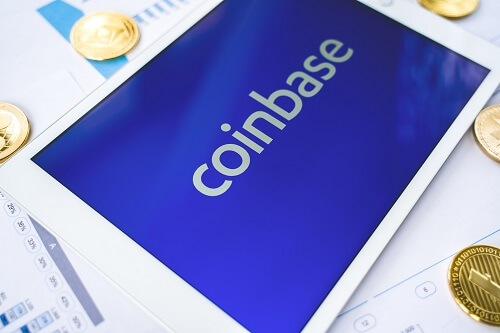

The post Crypto Crash Wipes Out $672 Million from Bitcoin and Ethereum ETFs in 48 Hours appeared first on Coinpedia Fintech News
On October 30, both U.S. spot ETFs continued their two-day streak of sell-offs. Bitcoin ETFs recorded $488.43 million in outflows, while Ethereum ETFs recorded $184.31 million. Neither of the funds recorded any gains for the day, as per SoSoValue data.
Bitcoin ETFs saw a combined $488.43 million in inflows, with BlackRock reporting the largest of $290.88 million. Other funds like Ark & 21Shares ARKB $65.62 million, Bitwise BITB $55.15 million, and Grayscale GBTC $10.01 million, posted a moderate amount of sell-offs.
Smallest ETF outflows were posted by Grayscale BTC $8.49 million, Invesco $7.9 million, and VanEck HODL $3.78 million. Eight out of twelve funds posted withdrawals with no inflows.
The total trading value dropped to $5.17 billion, with net assets coming at $143.94 billion. This represents 6.71% of the Bitcoin market cap.
Ethereum ETFs recorded a total net outflow of $184.31 million. All eight funds posted withdrawals, except for Grayscale ETHE. BlackRock led the session with $118.00 million outflow, while Invesco QETH posted the smallest with $2.02 million.
Bitwise ETHW, Fidelity FETH, and Grayscale ETH withdrew $31.14 million, $18.53 million, and $4.52 million, respectively. Other smaller sell-offs were reported by Franklin EZET of $4.23 million, and 21Shares TETH $3.15 million.
The total trading value reached $209 billion, slightly lower than yesterday. Total net assets came in at $24.99 billion, representing 5.51% of the Ethereum market cap.
Bitcoin price noted a little progress on Friday of 0.57%, reaching around $109,750.27. Its daily trading volume of $$69.48 billion, and market cap of $2.18 trillion also surged.
Meanwhile, the Ethereum price fell by 0.93% in 24 hours, trading around $3,867.97. The token’s trading volume reached $39.48 billion, and its market cap is now around $466.68 billion.

The post The Next Meme Coin Sensation: 4 Reasons Little Pepe (LILPEPE) Could Follow Shiba Inu (SHIB) and Pepe Coin’s (PEPE) Path appeared first on Coinpedia Fintech News
Little Pepe (LILPEPE) is rapidly emerging as one of 2025’s most-watched meme projects — and not just because it’s funny. Positioned as a meme-first Ethereum Layer-2, LILPEPE combines viral culture with infrastructure, and recent on-chain and community signals suggest it may be following the pathway carved by Shiba Inu (SHIB) and PEPE. Below are four reasons why Little Pepe could replicate, and potentially expand on, the breakout trajectories of the meme-coin greats.
Momentum matters in crypto, and LILPEPE’s presale progress has been unusually robust for a meme project. Currently in Stage 13 at $0.0022, the presale has raised roughly $27.31 million and sold about 16.58 billion tokens. The presale spans 19 stages with a confirmed listing price of $0.003 on at least two top-tier centralized exchanges.
That combination, substantial early capital and staged scarcity, creates a classic bootstrapping effect. Early-stage participants have reportedly seen ~120% paper gains since Stage 1, a performance pattern that historically attracts retail FOMO and social amplification. If listings and exchange liquidity behave as expected, LILPEPE’s presale momentum sets a credible launch pad, similar to earlier memecoins that experienced explosive growth after their exchange debuts.
Meme coins thrive or die by their community. LILPEPE’s social footprint is notable: active Telegram groups, rapidly growing follower counts, and persistent trending mentions across niche crypto channels. Unlike one-off viral pushes, the engagement here is multifaceted — including AMAs, influencer syndication, and community-driven content (such as memes, NFT drops, and influencer partnerships) that feed back into token demand.
Network effects matter: when a community is both large and engaged, liquidity and on-chain activity follow. That cultural momentum is precisely how SHIB and PEPE transformed meme hype into market moves—first by building an enthusiastic base, then by converting attention into transactions, listings, and wider adoption. Little Pepe’s community appears to be building the same feedback loop at an earlier stage.
Marketing alone draws attention; organized incentives make people hold. A $777,000 giveaway and a Mega Giveaway that gives 15 ETH to the finest presale customers are among Little Pepe’s popular reward schemes. These activities reward early members and encourage sharing, referrals, and on-chain purchases, which boost liquidity and awareness. If winners become vocal holders, they can boost trade and community size. Incentive schemes and a staggered presale and exchange listing plan boost diffusion and virality. Similar marketing strategies helped SHIB and PEPE become popular.
What distinguishes Little Pepe from most meme plays is its technology-first positioning. LILPEPE is developing an Ethereum-compatible Layer 2 tailored for meme projects, featuring a native meme launchpad that promises near-zero gas fees, zero trading tax, and protection against sniper bots. That mix transforms the token into more than a speculative asset; it becomes infrastructure that other meme projects can utilize. LILPEPE’s CertiK audit and CoinMarketCap listing have helped people trust meme coins. Audits and reputable listings enable institutions and large retailers to participate in and trade listings more smoothly.
Little Pepe has four key strengths: presale capital and scarcity, viral community dynamics, incentive-driven distribution, and a technology layer that enhances its utility. Those parts are like the building blocks that helped SHIB and PEPE go from being niche memes to well-known crypto stories. If LILPEPE’s team executes the exchange listings, continues community growth, and the broader market remains receptive, the project could follow a similar ascent.
That said, the memecoin market is high-risk and speculative. Success requires execution, fair token distribution, and sustained interest, any of which can falter. Investors should view Little Pepe as a high-upside, high-risk opportunity and perform their own due diligence.
For more information about Little Pepe (LILPEPE) visit the links below:

The post Top 4 Blue-chip Altcoins to Buy Before 2025 Ends appeared first on Coinpedia Fintech News
Bitcoin has fallen below $110,000 after the recent FOMC meeting and the market is volatile. In times like this, focusing on strong, proven altcoins can be a smart move. Here are four blue-chip projects that continue to show long-term growth possibilities:
Solana has had a strong year despite the recent dip. The launch of two Solana-based spot ETFs from Bitwise and Grayscale has added new legitimacy to the project. This is a big step for investor confidence and long-term price stability.
Western Union also announced plans to use the Solana network for its USDPT stablecoin, connecting over 150 countries. This move brings real-world use and recognition from a global financial company.
Solana’s price is currently around $185, down about 7 percent, with a market cap near $12 billion. Many analysts still expect Solana to reach $500 or higher in the next cycle. Despite short-term volatility, Solana remains one of the strongest blockchains in the market.
Sui continues to grow with strong on-chain activity. The BTCFi feature lets users earn passive income or borrow against their Bitcoin holdings. The network also offers many DeFi platforms such as Swelland, Scallop, and BlueFin.
Ledger recently added full support for Sui tokens, improving safety for users. Ledger is also launching a reward campaign offering 400,000 SUI to its users, encouraging more adoption.
Sui’s current price is $2.35, down 7 percent, but there is still room for growth up to $6.50 or even $10. The network’s steady development and strong partnerships make it one to watch.
Cardano has always taken a patient and careful approach to growth. After a strong rally last year, the ADA token has pulled back, losing over half its gains. Still, the project continues to make progress.
Interest from major institutions is growing. T Rowe Price has filed for a crypto ETF that includes ADA, and Grayscale has registered a Cardano Trust ETF under the ticker GADA. These developments could open the door for more traditional investors to access Cardano staking and yield.
The upcoming Cardano Summit in December, to be held in Berlin, could bring key announcements and partnerships. ADA is trading around $0.61 with a $22 billion market cap. Some AI-based models predict it could reach $5 by year-end.
BNB continues to be the backbone of the Binance ecosystem. The token hit an all-time high near $1,370 earlier this year before settling around $1,087.
BNB’s strong burn program supports its price by reducing supply. The network has already burned 64 million BNB, about 32 percent of the total supply. This makes it one of the most effective burn mechanisms in the crypto market.
With the recent pardon of Binance founder CZ, regulatory pressure has eased, and investor confidence may rise again. The BNB ecosystem continues to expand, and new all-time highs by the end of the year remain possible.

The post Ripple News: SEC Delay Removed, XRP ETF Could Go Live by November 13 appeared first on Coinpedia Fintech News
Canary Funds has officially filed an updated S-1 for its XRP spot ETF, removing the delaying amendment that previously stopped the registration from becoming auto-effective. This move transfers the timing control from the U.S. Securities and Exchange Commission (SEC) back to the issuer, putting the launch date on track for November 13, 2025, pending Nasdaq approval of the 8-A filing.
The filing update means that Canary is ready to bring XRP exposure to traditional markets, following the recent debut of the first Solana, Hedera, and Litecoin spot ETFs earlier this week. The XRP ETF, if approved, would be the first of its kind to give investors direct access to the price performance of XRP through a regulated exchange-traded product.
As reported by Eleanor Terrett, by removing the delaying amendment, Canary’s filing now falls under Section 8(a) of the Securities Act of 1933. This section allows the registration to automatically become effective after a 20-day statutory waiting period, unless the SEC objects..
SEC Chair Paul S. Atkins recently said he was pleased to see companies taking advantage of this long-standing legal route, noting that it helps maintain market efficiency during times of limited government function. His comments, while not directly addressing the XRP ETF, were seen as an indirect endorsement of the method Canary and other issuers are using.
Bloomberg ETF analyst Eric Balchunas described the update as “interesting,” explaining that the XRP ETF documents did not have the same level of back-and-forth with the SEC as Solana’s filing did. He added that while that might make approval less certain, it was still “worth a try.”
Crypto attorney Bill Morgan also shared excitement, saying it was good to see a specific target date for an XRP ETF launch. “Good to hear that a spot XRP ETF may go live on a specific date: 13 November,” he wrote.
The timing could still shift depending on how quickly the government reopens and whether SEC staff issue additional comments before the effective date. If Nasdaq clears the 8-A filing without delay, Canary’s XRP ETF could become active by mid-November, marking a significant milestone for Ripple and the broader digital asset industry.
With the success of recent Solana, Hedera, and Litecoin ETFs, the XRP community is watching closely to see whether this long-anticipated listing will finally bring one of crypto’s most established tokens into Wall Street’s mainstream spotlight.





Riot Platforms sees Bitcoin mining as a “means to an end,” planning to pivot its power resources to build a 1-gigawatt AI data center campus.

Coinbase CEO Brian Armstrong rattled off a bunch of crypto buzzwords at the end of its Q3 earnings call — resolving all prediction market bets on them to a “yes” in one swoop.

MegaETH surpassed its fundraising cap with over $1.3 billion committed, achieving a theoretical valuation of more than $27 billion after closing on Thursday.
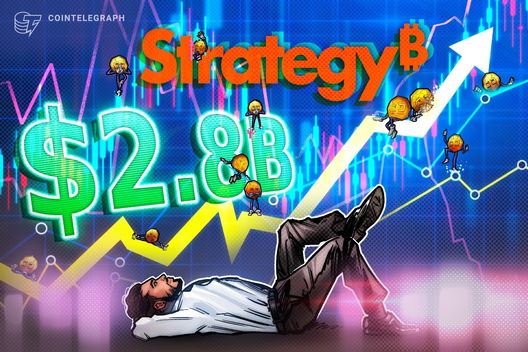
Strategy’s third-quarter net income was down from its record $10 billion in Q2, but still lifted its shares after the bell.
Ethereum (ETH) is struggling to break above the $4,000 mark and regain a clear bullish structure, with price action tightening after several failed attempts to reclaim momentum. The market remains cautious following recent volatility, and traders are watching closely to determine whether ETH will resume its uptrend or continue drifting lower. Analysts are currently split: some argue Ethereum’s fundamentals remain strong, fueled by network activity, scaling advancements, and institutional traction, while others point to increasing downside pressure and weakening market structure that could lead to a deeper pullback.
Despite the uncertainty in price, fresh on-chain data signals growing confidence among long-term participants. According to Santiment, more than 200,000 ETH — worth approximately $780 million — have been withdrawn from exchanges over the past 48 hours, marking one of the largest short-term outflow spikes this quarter. Such activity typically suggests accumulation, as investors move assets into self-custody rather than keeping them on exchanges to sell.

This divergence between price hesitation and heavy accumulation reinforces the current market debate. With liquidity dynamics shifting, Ethereum sits at a pivotal moment, and its ability to reclaim $4,000 will likely determine whether bullish momentum re-emerges heading into November.
The recent wave of large Ethereum withdrawals from exchanges further reinforces a growing theme in the market: investor conviction is strengthening. With more than 200,000 ETH moved into self-custody within 48 hours, many participants appear confident in Ethereum’s medium-term outlook, suggesting accumulation rather than distribution. Historically, substantial exchange outflows have coincided with accumulation phases ahead of major market advances, especially when paired with favorable macro shifts.
For many analysts, Ethereum now sits at the center of a potential bullish impulse across altcoins. Despite its recent struggle to convincingly reclaim the $4,000 level, sentiment in the broader market remains constructive. ETH continues to benefit from fundamental tailwinds, including increasing network utility, expanding Layer-2 activity, and rising staking participation. If market conditions turn decisively risk-on, Ethereum’s role as the primary settlement and liquidity hub for the altcoin ecosystem positions it to lead capital flows.
Macro conditions are also aligning in ETH’s favor. With the Federal Reserve cutting interest rates by 25 basis points and signaling the end of quantitative tightening, global liquidity is expected to gradually improve. Historically, shifts toward monetary easing have accelerated inflows into risk assets — crypto included. As traditional markets anticipate a clearer pivot, investors may increasingly seek exposure to high-beta assets with strong structural narratives, and Ethereum fits that profile.
Ethereum (ETH) is trading near $3,905, holding a key support region but struggling to reclaim upside momentum as price remains capped beneath major moving averages. After failing to sustain moves above the $4,200 resistance area earlier this month, ETH has drifted lower into a tightening range, reflecting indecision and reduced volatility following recent macro-driven swings.

The chart shows ETH trading below both the 50-day (blue) and 100-day (green) moving averages, which currently sit just above price and are acting as dynamic resistance. For bulls, reclaiming these levels — particularly a daily close above $4,050–$4,150 — would be a constructive sign that momentum is shifting back in favor of buyers. Such a reclaim could open a path toward retesting $4,300–$4,500, where recent supply pressure has consistently emerged.
On the downside, the $3,800 level remains the primary support to watch. A sustained break below this zone could expose ETH to lower levels near $3,500, especially if broader market sentiment weakens. However, the 200-day moving average (red) remains well below the price near $3,200, signaling that the long-term bullish structure is still intact.
Featured image from ChatGPT, chart from TradingView.com

The cryptocurrency XRP is once again drawing parallels to its explosive 2017 rally as analysts point to mounting institutional demand and bullish chart patterns. Trading in the $2.50–$2.70 range, XRP may be in the early stages of a new upward leg driven by ETFs, treasury-flows, and structural technical setups.
XRP’s resurgence is supported by a sharp uptick in institutional interest. A recently launched XRP-exposure vehicle has already pulled in over $115 million in assets, while trading volumes in related futures markets have soared into the billions.
This trend echoes the supply-constraint thesis that many analysts believe will fuel the next leg higher.
Beyond ETF vehicles, corporate treasuries and dedicated acquisition firms are lining up behind XRP. One example is a firm planning to raise over $1 billion for a publicly-traded entity focused exclusively on XRP accumulation via its balance sheet.
With such large-scale buying set to lock up supply, scarcity dynamics could increasingly favor the bulls. This institutional tailwind now places XRP in the same narrative once reserved for Bitcoin and Ethereum, but with XRP rapidly capturing mainstream investor interest.
Technically, XRP’s current structure has drawn comparisons to its 2017 run. Analysts tracking Elliott Wave counts suggest XRP may be in the early phase of Wave 3, a phase that historically triggers major price moves. Under one scenario, this could propel the token from its current $2.56 level into double-digit territory.
Support near the $2.50–$2.60 band remains intact, underpinning the bullish case. If XRP can break and hold above nearby resistance (circa $2.67–$2.70), momentum could accelerate.

That said, caution flags remain. Divergence between price and momentum indicators and elevated selling pressure from large holders suggest that short-term pull-backs are possible unless volume picks up decisively.
Nevertheless, with the institutional backdrop strengthening and a classic bullish base forming, XRP appears positioned to follow its 2017 ‘re-accumulation to breakout’ script, potentially setting up a move toward $10, $20, or beyond, should all variables align.
Market watchers will be keeping close tabs on two key levels. On the upside, a sustained breakout above $2.70 could open a path to $3 and perhaps much higher if institutional flows accelerate.
On the downside, a breakdown below $2.50 might signal delay and consolidation. Meanwhile, headlines around ETF approvals, corporate treasury buys, and real-world asset activity on the XRP Ledger will likely set the tone for the next major leg.
With XRP’s narrative shifting from retail speculative token to institutional vehicle, the coming weeks may mark the inflection point where theory turns into price, and the 2017 echo becomes real.
Cover image from ChatGPT, XRPUSD chart from Tradingview

Dogecoin’s recent decline may be nearing exhaustion as the price edges toward a crucial support zone. With the downward wave showing signs of completion, market watchers are now eyeing a potential shift in momentum that could spark the next bullish reversal.
After examining the Dogecoin (DOGE) 30-minute chart, the Elliott Waves Academy updated its outlook to confirm a period of strong selling pressure. Technical analysis clearly indicates that the DOGE/USD pair is nearing the completion of a defined price channel pattern, with only one key level remaining before the next major wave is confirmed.
Specifically, the downward leg represents Wave (5) of Wave 3 within a larger bearish sequence. According to Elliott Waves Academy, the bearish outlook is heavily supported by the preceding structure, which involves a confirmed and strong downward wave representing Wave (3), demonstrating robust and sustained momentum from the sellers.
A continuation of the bearish outlook is structurally reinforced by the presence of the price channel pattern itself. Key to confirming the final downward wave hinges on the price breaking the key support level of the current minor correction.

Elliott Waves Academy emphasized that successfully breaking this critical key level will provide undeniable confirmation of the bearish view and set a precise trajectory for the completion of the move. Elliott Waves Academy targets the $0.1843646$ level as the expected floor for this phase. The objective is anticipated to be the point at which the internal wave structure is complete and the current bout of selling pressure is exhausted.
Finally, Elliott Waves Academy noted that a crucial follow-up action: after reaching the $0.1843646$ level, a corrective upward main wave is predicted to follow. This implies that anticipated downside is part of a structural cycle and should be followed by a noticeable relief rally.
According to EᴛʜᴇʀNᴀꜱʏᴏɴᴀL, Dogecoin continues to follow the same structural rhythm observed in previous market cycles. The price action is unfolding in a familiar pattern, suggesting that the asset may be preparing for another significant move once conditions align.
In his post, EᴛʜᴇʀNᴀꜱʏᴏɴᴀL revealed that momentum is quietly building above key support levels, signaling underlying strength in the market despite the recent volatility. The structure remains technically sound, indicating that buyers are gradually regaining control.
He concluded by emphasizing that patience is key before the next ignition phase, as Dogecoin consolidates and gathers momentum. The current setup suggests a potential upside once a breakout confirms renewed bullish momentum.

Vincent Scott, a well-known voice in the XRP community, urged patience while restating a big claim: he called XRP and the XRP Ledger humanity’s “best chance” to change how money moves around the globe.
His message, shared on X, mixed optimism about Ripple’s corporate moves with a warning that legal clarity must come first.
According to Scott, Ripple’s licensing work, recent acquisitions and new partnerships show the company is lining up for much bigger demand for XRP.
He argued the token’s real value is practical — it can act as gas for transactions or as a bridge currency to move value between different systems.
XRP/XRPL is the best chance we got
We see Ripple the company making all the moves to drive demand and solidify themselves with licensing, acquisitions, and relationships
We know the laws are the goalpost
We understand the concept of it: that XRP is backed by its use to…
— VincentScott (@VincentSco72192) October 26, 2025
Scott believes these changes could cut fraud, increase competition among banks and other payment providers, and speed up settlements.
He also suggested that if countries needed smaller foreign reserves because payments were easier and cheaper, that would shift long-held financial balances.
That kind of shift could face strong pushback. Scott noted a decentralized payment and reserve setup “ruins the existing power structure,” meaning political resistance is likely.
The post prompted a range of reactions from within the XRP crowd. Nenad Stojkovic said Ripple stands out because of its infrastructure and regulatory steps, calling it a rare “serious financial company” in crypto — a view Scott agreed with.
One user, SonOfRichard, argued Ripple’s new product Ripple Prime might lift XRP even without new laws, since it’s already compliant with some rules.
Scott pushed back, replying that real progress still needs clear laws. Other voices were critical; Tommy Raz questioned the company’s top leaders.
He spoke in their favor, saying their actions match the stated mission and that some online comments, especially from Ripple’s CTO David Schwartz, get misunderstood.
I find the #XRP vs ETH debate, and who will outperform fascinating. Certainly Ethereum will fairly soon explode, however, I am coming back to this XRP/ETH chart. Take a look where the bounce occurred and what happened when XRP bounced from that support (twice) in 2017. Also, the… pic.twitter.com/8MlLWi2cjy
— CryptoBull (@CryptoBull2020) October 28, 2025
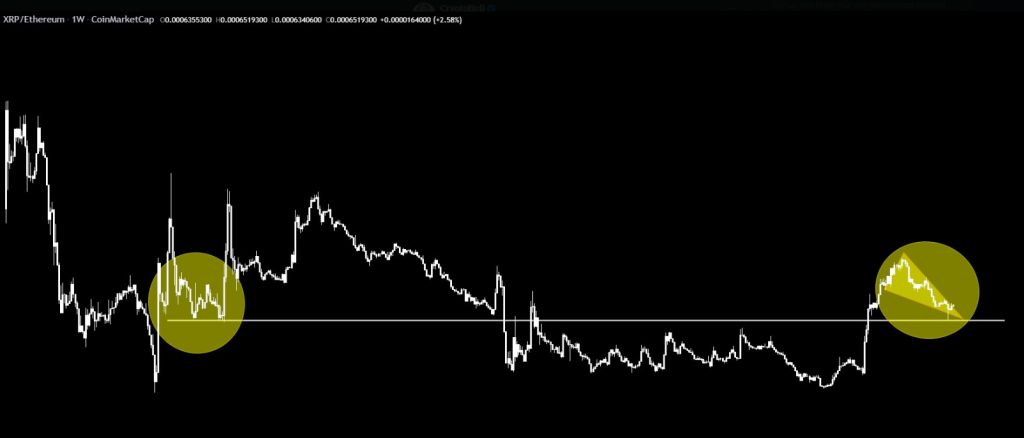
Meanwhile, a separate market watcher, CryptoBull, said Ethereum is set to surge soon but predicted XRP would outperform ETH in the near term.
Based on market moves, ETH recovered 9% to over $4,200 on Oct. 27 while XRP climbed 10% to $2.68 in the same stretch. Both later fell from those highs.
ETH remains only up 1.4% from its Oct. 22 lows. XRP, by contrast, has kept a 6% gain and sits above the key $2.5 mark.
According to Scott, no major shift will happen until regulators and lawmakers finish their work. He pointed to comments from Rep. French Hill, chair of the House Financial Services Committee, who said Congress could pass the CLARITY Act by the end of the year if the Senate moves.
Featured image from Unsplash, chart from TradingView

What defines the top crypto with 1000x potential in 2025? It’s not hype but real adoption, performance, and sustainability. TRON ($TRX) exemplifies this shift with over 5.2 million daily transactions, low fees, and expanding developer participation. Its scalable, energy-efficient network powers stablecoins and DeFi growth across borders. As the ecosystem evolves with cross-chain integration and institutional traction, TRON continues proving that long-term utility, not speculation, drives true market dominance in the next wave of digital finance.
Meanwhile, BullZilla ($BZIL) and Cronos ($CRO) are shaping the narrative from different fronts. BullZilla’s cinematic presale mechanics and progressive price model are rewriting the playbook for structured early-stage investing, giving believers access to exponential ROI opportunities. Cronos, on the other hand, builds strength through interoperability, linking Ethereum and Cosmos ecosystems to drive long-term network value. Together, these three projects represent the evolving face of crypto, where innovation, utility, and conviction unite to create the next generation of breakout winners.
TRON ($TRX) climbed 0.55 percent in the past 24 hours to $0.2972, marking another milestone in its steady growth streak. Network usage continues to expand as daily transactions cross 5.2 million. Its low-fee structure and strong developer engagement make it a magnet for decentralized applications and stablecoin movement. TRON’s ability to sustain high throughput without congestion keeps it among the top utility-driven blockchains. The ecosystem’s expanding DeFi products and cross-chain bridges reinforce its adaptability, making TRX an essential part of the global digital finance conversation in 2025.
Behind the scenes, TRON’s partnerships and token burns are fueling steady upward momentum. Founder Justin Sun’s consistent updates and real-world utility have kept TRX in investor portfolios for years. As institutional adoption grows, TRON’s strong liquidity ensures reliability and scalability. Analysts predict its network value will continue rising as Web3 applications mature across entertainment, payments, and NFTs. With a proven track record and renewed ecosystem energy, TRON’s fundamentals position it as one of the best performers within the smart contract category heading into the next cycle.
TRON’s price surged on the back of rising on-chain activity, strong stablecoin transaction volume, and expanding network partnerships. Its growing role in cross-border payments and increasing institutional adoption further fueled investor confidence and sustained upward momentum.
Yes, TRON’s exceptionally low transaction fees, high-speed network, and rapidly growing DeFi ecosystem make it one of the most efficient and scalable blockchains. For long-term investors seeking reliability, consistent growth, and active utility expansion, TRON remains a strong contender.
BullZilla has become the talk of the crypto arena. It isn’t just a token, it’s a cinematic ecosystem engineered for believers. Built on Ethereum, its BZIL presale raises the price every $100,000 or 48 hours, fueling a continuous momentum loop. Currently in Stage 8 (Echoes of the Bull), Phase 3, at $0.00020573, BullZilla has raised over $990,000 with 31 billion tokens sold and more than 3,300 holders. Its design transforms emotion into structure, making it the leading top crypto with 1000x potential heading toward 2026.

The BullZilla presale rewards conviction with numbers that impress. A $3,000 investment now buys 14.58 million BZIL, valued at over $76,923 at listing. ROI from Stage 8C to $0.00527 is 2,462.29 percent, while early entrants could see up to 3,477.91 percent. Referral bonuses offer 10 percent extra tokens on $50+ buys and 10 percent of referred purchases. Rewards unlock after two weeks. Prices rise automatically every $100K in funding, ensuring consistent upward momentum. It’s like grabbing Solana before it went full throttle, a cinematic investment for those who act fast.
A $3,000 purchase at $0.00020573 secures 14.58 million BZIL tokens. When the price hits $0.00527, that stake could be worth $76,923. This isn’t just math, it’s structured conviction. BullZilla’s progressive pricing ensures supply shrinks and rewards amplify. Every milestone boosts holders’ confidence while the deflationary burn system maintains token scarcity. This calculated balance between psychology and economics transforms holding into a strategic advantage. For investors seeking massive returns, BullZilla offers a cinematic roadmap to exponential growth.
Joining the BullZilla presale takes minutes. Connect an Ethereum-compatible wallet, select the investment amount, and confirm your transaction on the official BullZilla site. Each purchase moves the total raised closer to the next price increase, triggered every $100,000 or 48 hours. Participants earn 10% referral rewards and bonus tokens on $50+ purchases. After the presale, tokens become claimable with full transparency. It’s a seamless, secure experience that rewards fast movers while preserving long-term value.
The Roar Burn system keeps BullZilla’s fire alive. With 8 billion tokens reserved, burns occur at every milestone, permanently removing supply from circulation. These live burns are showcased through visual “roar events,” creating a thrilling community experience while tightening tokenomics. As scarcity rises, so does price potential. This mechanism fuels excitement and sustainability simultaneously, turning every presale stage into a visible moment of evolution. The Roar Burn isn’t symbolic; it’s strategic, ensuring long-term holders watch their tokens grow stronger with every chapter of the BullZilla saga.
The current BullZilla Presale Price is $0.00020573 in Stage 8 (Echoes of the Bull), Phase 3, with over $990k raised. The next 3.24% price jump to $0.0002124 is scheduled for Stage 8D.
The BullZilla Presale Price Prediction projects a listing price of $0.00527141, offering an estimated ROI of around 2,462%. Early investors may reach 3,477%+ gains as automatic price climbs, token burns, and rapid demand fuel BullZilla’s continued momentum through the remaining presale phases.
The BullZilla Presale on Coinbase isn’t confirmed. The team targets major CEX and DEX listings post-presale, starting with CoinMarketCap and CoinGecko, then expanding toward top exchanges like Coinbase as liquidity, adoption, and global trading demand grow.
Fake Telegram presale channels are a growing risk. Always verify the official website link and contract address before investing. Scammers often clone logos and names but redirect users to fraudulent wallets. Legitimate channels never demand personal keys or direct wallet transfers. Cross-check announcements through verified X (Twitter) handles and community moderators. Remember, if an offer feels rushed or exaggerated, it’s likely fake. Staying cautious ensures your investment goes to real, verifiable projects like BullZilla, protecting both your funds and your peace of mind.
Cronos ($CRO) slipped 1.83 percent in the last 24 hours to $1.83, but its fundamentals remain solid. Despite short-term volatility, the network’s DeFi total value locked has grown steadily, showing expanding user engagement. Cronos continues to focus on interoperability, bridging with the Ethereum and Cosmos ecosystems to attract cross-chain builders. Analysts view the pullback as a healthy cooldown before potential growth in Q1 2026. With strong partnerships and active staking participation, Cronos continues to play a significant role in driving accessibility and scalability across multiple decentralized applications.
Cronos’s latest updates center around ecosystem rewards and infrastructure optimization. The project has introduced new liquidity programs and developer grants, driving consistent ecosystem activity. As gas costs drop and cross-chain integrations deepen, Cronos positions itself for renewed momentum. Its clear roadmap for interoperability ensures its continued relevance in the competitive smart contract sector. Traders see its current price zone as a potential accumulation range before another expansion cycle. Cronos’s community-driven growth and stable operations continue to attract long-term DeFi investors globally.
Cronos’s minor dip reflects short-term market corrections after recent gains, yet its strong fundamentals, cross-chain capabilities, and rising user activity continue to support stable long-term growth and sustained investor confidence in its ecosystem.
Cronos focuses on cross-chain integration, stable staking rewards, and expanding user adoption, making it a reliable long-term investment. Its strong fundamentals and continuous ecosystem growth support lasting value and increasing investor confidence over time.

As investors search for the top crypto with 1000x potential, three names dominate the spotlight. TRON maintains consistent growth through network activity, Cronos strengthens interoperability and rewards, and BullZilla revolutionizes presales with cinematic precision. Each offers unique advantages, combining community engagement, functionality, and sustainability. The crypto market now rewards clarity and innovation, not hype alone. For those ready to act early, these projects could form the backbone of the next major bull run, leading from conviction to achievement.
BullZilla, in particular, continues to capture attention with its structured presale and roaring ecosystem. With 70 percent APY staking, live Roar Burns, and price rises every $100K, it is shaping into a powerhouse narrative. The current Stage 8D increase to $0.0002124 is approaching fast, giving investors one last chance to join before the next leap. BullZilla’s fusion of story, scarcity, and staking ensures it remains the true standout among new-generation projects. The roar is getting louder, and believers are multiplying fast.

Follow BZIL on X (Formerly Twitter)
Cryptocurrency investments are subject to market risk. This content is for informational purposes only and should not be taken as financial advice. Always DYOR (Do Your Own Research) before investing.
Read More: Crypto News: TRON Record Activity, Cronos Expands DeFi Reach, and BullZilla’s Presale Leads Top Cryptos with 1000x Potential">Crypto News: TRON Record Activity, Cronos Expands DeFi Reach, and BullZilla’s Presale Leads Top Cryptos with 1000x Potential


Crypto security has changed alot over the years. In the early days of Bitcoin, coins were stored in very simple ways. People printed keys on paper or just saved files on laptops. Some believed this was enough. But as the value of digital assets grew, hackers also grew smarter. This created a big need for safer ways to protect coins offline.
Hardware wallets and cold storage slowly became the gold standard in the crypto world. They are now seen as very safe because they keep private keys away from the internet. This matters because crypto is not like normal money in a bank. Once coins are gone, they normally can not come back. So the evolution of hardware wallets and cold storage is an important story. It shows how the crypto community learned, improved, and worked to protect digital value for many years.
This blog explains how crypto storage started, how hardware wallets appeared, and why cold storage keeps growing today. The goal is to make the topic simple and clear so anyone can understand how crypto protection moved forward.
Cold storage means keeping crypto private keys offline. When keys are not connected to the internet, it becomes very hard for hackers to steal coins. It is like putting treasure in a locked safe that sits far away from roads and crowds.
Cold storage became one of the most trusted ways to protect crypto. Exchanges, big companies, long term holders, and many investors depend on it now. Cold storage is used for saving crypto for longer periods, while software wallets online are more for fast access and spending.
The idea is simple. Online device equals more risk. Offline device equals less risk. Even if a hacker gets into the internet connection or a computer, they can not reach the keys that are stored cold.
Cold storage started as a basic way to keep Bitcoin safe, but over time it became an advanced security system used by the entire crypto world. Some cold systems today are like bank vaults with many steps and controls.
In the early Bitcoin days, there were not fancy wallets or secure devices. Many people printed private keys on paper. These were called paper wallets. A printed wallet looked like numbers and letters on paper, sometimes with QR codes. If the paper was kept safe, the coins stayed safe. But if someone lost the paper or it got damaged, the coins were gone. This was a big problem.
Another method was storing wallet files on computers or USB drives. But computers get viruses, and USB drives can break. People did not think too much about this at first. Bitcoin was small then, and many did not imagine it becoming so big. So the idea of cold storage was there, but the tools were not perfect. There were stories where early users lost millions because they forgot passwords, threw away drives, or had laptops crash.
Still, these early storage ways helped build the idea that crypto needed safe offline protection. The community learned that cold storage must be strong, simple, and reliable.
Hardware wallets came after people realized paper and USB storage had too many risks. A hardware wallet is a small physical device that stores crypto keys offline. It lets users sign transactions safely without letting hackers see the keys.
The first popular hardware wallets appeared around the mid bitcoin growth period. Brands like Trezor and Ledger became famous. These devices had simple screens and buttons. They kept keys offline and needed physical confirmation for actions. This changed everything. Now cold storage was not just papers and USB sticks. It became more smart and safer.
Hardware wallets quickly grew in popularity. Anyone who wanted to keep crypto for a long time started using them. Many saw them as a must have tool. They were small, portable, and easy to use, even if the technology inside was advanced. Hardware wallets proved that crypto security could be simple but strong at the same time.
Hardware wallets work in a very smart but simple idea. They store private keys in a chip that never connects directly to the internet. When a transaction needs to happen, the wallet signs the transaction inside the device. The keys do not leave the wallet. Only the signature goes out.
The wallet normally connects to a phone or computer just to send the signed transaction. This means even if the computer has malware, the hacker still can not steal the keys. The private key stays inside the device always.
Some wallets have screens and buttons. The screen shows what is being signed, so the user can check. The buttons let the user approve actions. This prevents secret signing or mistakes. Newer wallets add extra features like passphrases, backup recovery systems, and seed protection.
Crypto wallets do not all work the same way. Some stay online always. Some work offline. The safety level changes depending on how much internet connection a wallet has. That is why cold storage became the strongest layer of protection. It keeps the private keys away from online danger.
Software wallets live on phones or computers. They are easy and fast for daily use, but they face more risk of viruses and hacks. Exchange wallets are wallets hosted by trading platforms. They are simple for beginners but not really controlled by the owner. Exchanges can lose funds or get hacked, so many people avoid keeping big amounts there.
Hardware wallets sit in the middle, but closer to the safest side. They stay offline, but still let users sign transactions when needed. This balance made them the main choice for long term storage.
Below is a table showing the clear difference between common wallet types.
| Wallet Type | Keys Controlled By Owner | Online Risk | Best Use Case | Security Level |
| Hardware Wallet | Yes | Very low | Long term storage and savings | Very High |
| Software Wallet | Yes | Medium | Daily transactions and quick access | Medium |
| Exchange Wallet | No | High | Trading and short term holding | Low |
Hardware wallets show the strongest control and safety. This is why they became so important as crypto value grew and cyber attacks became more common.
Old hardware wallets had very basic functions. Modern devices have evolved a lot. They now come with stronger chips, safer backup options, and screens that show transaction details. Some wallets also have extra layers like PIN codes, passphrases, and even tamper proof chips that stop hackers.
A key evolution point is backup recovery options. Early users had risky paper backups. Now many use metal seed plates, secret words mixed with passphrases, and multi step recovery systems. This makes the wallet much harder to break into.
Screens also became important. They stop fake transaction signing. The user can see what is being signed and confirm. If a virus tries to send the wrong transaction, the screen will not match, and the person does not approve it.
Modern devices also include better chips called secure elements. These chips protect private keys and do not allow any software to access them directly.
| Feature | Meaning | Security Benefit |
| Secure Element Chip | Special protected chip | Stops hacking and key extraction |
| PIN and Passphrase | Extra login layer | Prevents access if device is stolen |
| Seed Backup and Steel Plates | Strong key backup | Protects recovery phrase from damage |
| Screen and Buttons | Physical approval | Stops fake sign attempts |
| Air Gapped Operation | No wired or wireless network | Reduces attack surface |
Modern wallets took lessons from early losses and mistakes. This improvement helps protect billions in assets globally.
Cold storage did not become advanced overnight. It started very basic. First came paper wallets. Printed private keys worked but could be lost or damaged easily. Then came USB wallet backups. But USB drives can fail, leak keys, or get infected later.
Then hardware wallets arrived. They allowed safe signing without exposing keys. After that came metal seed plates and air gapped computers. These prevented both cyber theft and physical damage.
Today, some institutions use multi signature cold vaults. This means no single person can move funds alone. It needs multiple approvals. Some vaults store crypto in special underground rooms with biometric locks and guards. This shows how serious security has become as crypto gained mainstream adoption.
Many brands helped shape the hardware wallet industry. Trezor was one of the first widely trusted devices. Ledger also came early and became very popular with strong secure chips. Coldcard focused on Bitcoin only and became known for extreme security. BitBox and SafePal also entered the market with more user friendly features and lower costs.
Each wallet brand offers something different. Some focus on top security. Some focus on easy use. Some support many blockchains, while others stay specialized.
Below is a short table comparing popular wallet brands in simple terms.
| Brand | Focus Area | Known For | Ease of Use |
| Trezor | Multi coin support | Early wallet pioneer | Easy |
| Ledger | Multi coin support + secure chip | Biggest global brand | Easy |
| Coldcard | Bitcoin only | Extreme security model | Medium |
| BitBox | Simplicity | Minimal design and speed | Easy |
| SafePal | Budget friendly | Compact and app connected | Easy |
This diversity shows how hardware wallet competition helped the market grow and improve fast.
To help understand wallet choices better, here is a simple pricing and user style comparison.
| Wallet Brand | Price Range | Who Usually Uses It | Style of Security |
| Trezor | Medium | General crypto users | Strong security with open approach |
| Ledger | Medium | Beginners and advanced users | Secure element chip architecture |
| Coldcard | High | Bitcoin security maximum users | Extreme cold storage focus |
| BitBox | Medium | Easy interface users | Simple design, fast setup |
| SafePal | Low | Budget and first time users | Secure offline plus app function |
Prices and user type ideas help readers see how wallets fit different needs.
Cold storage is not only for normal crypto holders now. Large funds, banks, crypto exchanges, and ETF companies also use cold storage. When institutions manage billions in digital money, they need very strong security systems. These systems protect funds even if someone tries advanced hacking or inside attack.
Institutions use vaults, multi signature systems, air gapped computers, and sometimes biometric access. Cold storage is controlled by teams, not one person. This prevents mistakes or fraud. Big companies often insure these vaults also, so if something happens there can be a backup coverage. Traditional finance mixed with crypto created a new level of cold storage. It is not just a device anymore, it is a full system.
Exchange traded products like crypto ETFs also use institutional cold storage. They need to prove to regulators and investors that funds are safe. This helped cold storage become more famous also, and pushed companies to build more advanced safes.
The future of crypto security is growing very fast. As more people enter crypto, and hack attacks get smarter, wallet technology must keep improving. Future hardware wallets may use things like biometric unlock. Fingerprint or face scan makes security stronger than only a PIN.
Another new idea is seedless wallets. These do not show a seed phrase in normal way. Instead they may use secret chips or secure backup networks. So losing a paper or metal plate is less scary. Some companies are testing multi device recovery, where many devices must work together to recover funds.
Artificial intelligence might also play a role. AI systems can detect risky behavior, fake signing attempts, or malware before damage happens. Institutions already begin testing this type of safety.
We may also see mobile devices with secure crypto chip built inside, making phones work like hardware wallets but still very safe. More people will use cold storage as crypto becomes global money.
Cold storage and hardware wallets grew side by side with crypto. In the start, simple paper wallets protected small bitcoin amounts. As crypto value exploded and digital theft increased, security tools had to grow. Hardware wallets arrived and changed the game by mixing strong offline protection with easy everyday use.
Today, big institutions trust cold storage the same way individuals trust their hardware wallet. Banks, funds, and ETF companies build vaults and multi sig systems. Meanwhile, everyday crypto users buy small devices that protect their coins for many years.
The future will bring even safer tools. Biometric systems, seedless recovery, AI, and secure chips inside mobile phones will make crypto safety easier and stronger. Even though technology improves, the main rule stays same. Crypto keys must remain offline to avoid danger. That is the core of cold storage. It will continue to evolve as the digital world grows.
Hardware wallets and cold storage started simple and now protect billions worldwide. This journey shows how crypto security matured and will keep improving for a long time.
A hardware wallet is a small device that keeps private keys offline. It signs crypto transactions inside the device so hackers can not see the keys. It is used for safe long term storage and protection from online attacks.
Cold storage keeps crypto keys away from the internet. This makes it very hard for hackers to steal coins. When keys do not touch online systems, the risk goes down alot. Cold storage is known as one of the safest ways to hold crypto.
A hardware wallet is safer for saving crypto because it stays offline. A software wallet is easier for fast spending but faces more danger from malware or viruses. So the best choice depends on what is needed. Saving long time equals hardware, spending and fast use equals software.
If the seed phrase is backed up safe, the wallet can be recovered on a new device. If the seed was never saved, the crypto can be lost forever. That is why seed backup is a big rule in cold storage.
Cold Storage
Storing crypto keys offline so hackers can not reach them through internet.
Hardware Wallet
Physical device that protects crypto keys and signs transactions offline.
Private Key
Secret code that gives access to crypto funds. Must never be shared.
Seed Phrase
Group of words that can recover the wallet if device is lost. Needs safe storage.
Multi Signature
More than one approval needed to move crypto. Used for high security storage systems.
Air Gapped
Device or system that never touches internet or wireless connections.
Secure Element Chip
Special chip that protects private keys from extraction and attacks.
Exchange Wallet
Wallet controlled by a crypto exchange not by the user fully.
Paper Wallet
Printed private keys on paper used in early days of crypto.
Biometric Security
Unlocking using fingerprint or face scan instead of only password.
Hardware wallets and cold storage changed the crypto world. In the start, crypto holders only used paper wallets and computer files. These methods worked at that time but had big risks like loss and malware. As crypto value increased, stronger security became needed.
Hardware wallets brought a new way. They keep private keys offline and only send signed messages. This stopped internet attacks and made everyday long term holding safer. Big companies also adopted cold storage with vaults, multi signature control and insurance. This showed cold storage became trusted even in finance markets.
Today cold storage means much more than paper or USB. It includes secure element chips, seed backups, air gapped signing, and soon biometric and seedless systems. The future looks even safer with AI alerts and phone secure chips.
The story of cold storage proves one point. When private keys stay offline and protected, crypto stays safe. That idea started simple and now protects billions across the world.
Read More: From Early Bitcoin Days to Secure Devices: Cold Storage Story Explained">From Early Bitcoin Days to Secure Devices: Cold Storage Story Explained


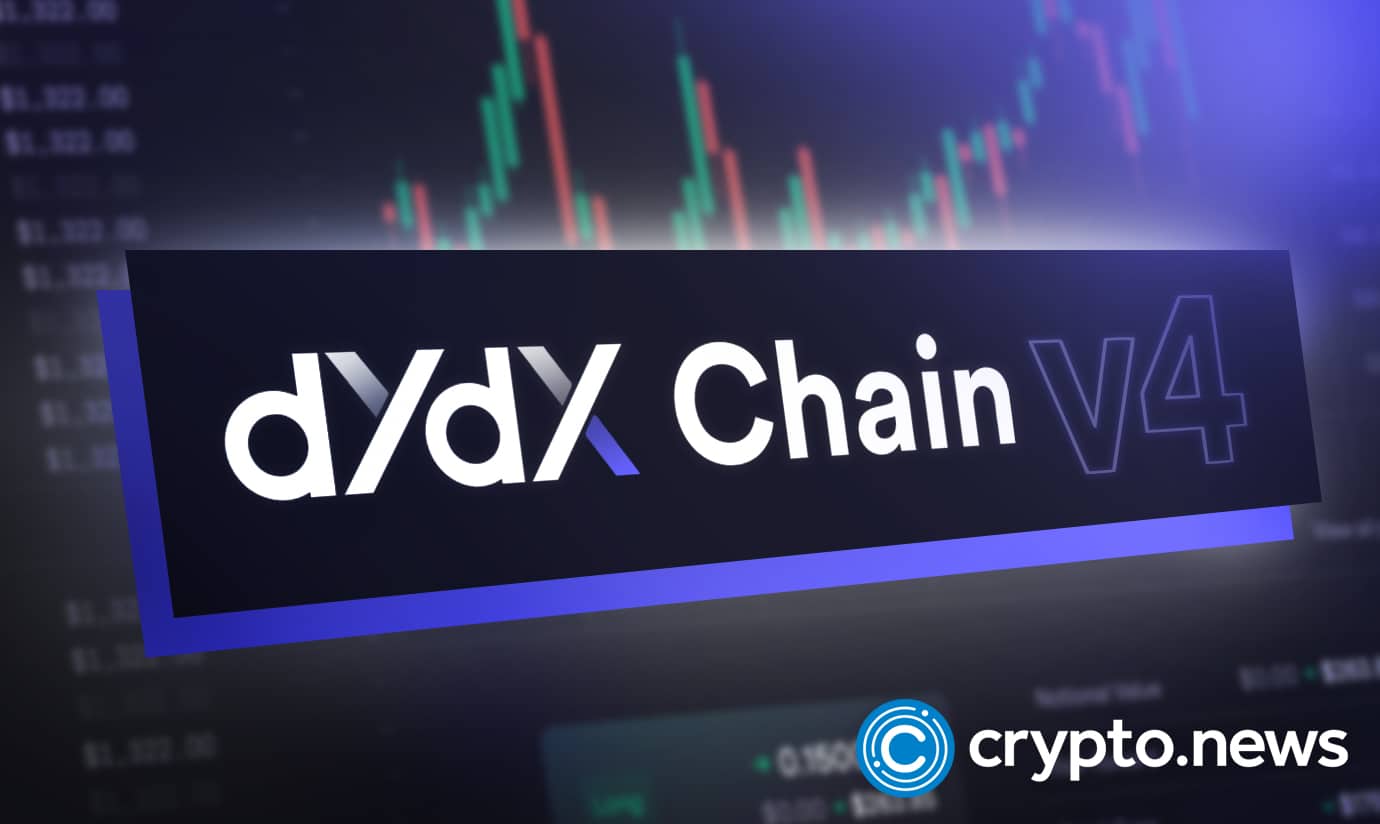
Jump Crypto just made one of the boldest moves in the crypto market this quarter.
In a lightning-fast swap that took just 15 minutes, the trading giant moved 1.1 million unlocked SOL, worth around $205 million, and received 2,455 BTC, worth roughly $265 million, in return.
According to Lookonchain, the transaction was conducted through Galaxy Digital, one of the largest institutional over-the-counter (OTC) desks in the space.
The scale of this trade has the crypto world buzzing, and for good reason.
The swap marks a significant rotation from Solana (SOL) to Bitcoin (BTC), signaling what could be a broader strategic shift for Jump Crypto.
The transaction took place on October 31, with 1.1 million SOL tokens leaving Jump’s wallet and landing at Galaxy Digital. Moments later, the firm’s address received 2,455 BTC in return.
Jump Crypto’s decision to rotate from one high-growth layer-1 token into Bitcoin suggests a deliberate shift in exposure, possibly from growth to store-of-value stability.
Lookonchain’s on-chain tracking showed the entire transaction unfolding in under 15 minutes, confirming the speed and precision typical of institutional crypto moves.
The 1.1 million SOL tokens were unlocked and unstaked before being deposited into Galaxy Digital’s OTC platform.
In return, Galaxy sent 2,455 BTC to Jump Crypto’s address, a swap valued roughly $60 million higher than the outgoing assets.
While OTC desks typically handle large transactions to prevent slippage and on-exchange price impact, this trade still caught analysts’ attention due to its scale and timing.
Interestingly, this move came just as $117 million in Solana ETF inflows were reported, enough to absorb a significant chunk of existing supply.
That liquidity surge may have allowed Jump Crypto to offload a large volume of SOL without destabilizing the market, creating the perfect window for such a swap.
Despite the heavy transfer, Solana’s price has remained stable, hovering near its weekly high. That resilience shows how much fresh institutional demand has been entering the Solana ecosystem.
The Solana ETF inflows, paired with Jump’s sale, illustrate a changing market dynamic, one where large trades can occur without shaking prices, something that wasn’t possible a year ago.
So why rotate into Bitcoin now?
There are a few possible reasons.
First, macro positioning. With Bitcoin leading narratives around ETF approvals, Lightning Network adoption, and institutional expansion, major trading firms may see it as the safer long-term store of value.
Even Lolli’s recent acquisition of Slice, aimed at accelerating Lightning Network adoption, reinforces growing infrastructure confidence around Bitcoin.
Second, Jump Crypto may be hedging portfolio volatility. Solana’s explosive performance in 2025 has rewarded early backers, but it also introduces short-term downside risk. Bitcoin, on the other hand, tends to perform as a stability anchor during market rotations.
Finally, there’s the profit factor. Jump acquired significant Solana holdings early in its ecosystem development phase. Rotating a portion into Bitcoin may simply be a realization of gains while maintaining market exposure through a more established asset.
The crypto community wasted no time reacting to the news.
“Whoa 😮 Jump Crypto just made a bold move in the crypto jungle!” one post read on X, echoing the sentiment of thousands of traders watching on-chain activity unfold live.
Others speculated whether this marks a shift in Jump’s long-term vision, perhaps a recalibration ahead of 2026’s macro cycle.
Either way, the tone was clear: this was not a random rebalance. It was a strategic statement.
Market observers say such high-profile swaps can ripple across sentiment and liquidity flows.
For Solana, the key question is whether Jump’s exit could trigger similar moves from other large holders, or if institutional inflows, like those from ETFs, will continue to balance the scale.
For Bitcoin, it’s another sign of institutional confidence returning in full swing.
Galaxy Digital’s involvement also highlights the growing role of OTC infrastructure in bridging traditional finance and crypto markets.
As of now, neither Jump Crypto nor Galaxy Digital has made a public comment on the swap.
Jump Crypto’s move is more than just numbers. It reflects how quickly institutional strategies evolve in the digital asset space.
Firms like Jump, Alameda, and Wintermute often set the tone for liquidity and capital rotation trends. When they move in size, the rest of the market pays attention.
This particular trade also underscores how Solana’s maturity has unlocked the ability for large-scale exits without on-chain disruption, a sign of growing ecosystem depth.
At the same time, it reaffirms Bitcoin’s place as the final destination for large-cap capital preservation.
For now, Jump Crypto’s rotation from $205 million in SOL to $265 million in BTC stands as one of the largest on-chain swaps recorded in recent months.
It’s a reminder of how fast institutional capital moves, and how blockchain transparency allows the world to watch it happen in real time.
Whether this marks the start of a broader rotation into Bitcoin or just a single strategic rebalance, one thing is clear:
Big money is still playing the long game, and they’re playing it on-chain.
Disclosure: This is not trading or investment advice. Always do your research before buying any cryptocurrency or investing in any services.
Follow us on Twitter @themerklehash to stay updated with the latest Crypto, NFT, AI, Cybersecurity, and Metaverse news!
The post Jump Crypto Swaps $205M in SOL for $265M in Bitcoin, A Massive Strategic Shift appeared first on The Merkle News.
Robinhood’s latest foray into blockchain, its tokenized asset service, is quietly becoming one of the company’s strongest new verticals.
Since the service launched in June 2025, it’s seen consistent month-over-month growth, both in user adoption and asset value. The idea is simple: take traditional assets, from stocks to ETFs to commodities, and tokenize them for on-chain trading.
Four months in, that idea appears to be working.
As of October 28, Robinhood’s tokenization platform has listed 493 tokenized assets with a combined on-chain value of around $8.38 million.
That’s more than double the 207 assets the platform started with in June.
The growth hasn’t just been in listings.
Daily trading volume has climbed from a modest $69,000 at launch to over $8.3 million, reaching an all-time high of $8.52 million on October 15.
Most of the activity comes from tokenized stocks and ETFs, which together make up more than 93% of all listings.
Breaking it down, stocks account for 64.6%, while ETFs make up 29.1%.
The remaining share includes crypto ETFs, commodities, U.S. Treasuries, ETNs, and a growing segment of private equities, all tokenized for blockchain-based trading.
What’s impressive is how stable the growth has been.
The platform didn’t just experience an initial launch hype, it’s maintained steady activity, suggesting users are actually sticking around.
Total tokenized stock trading volume reached $36.7 million by October 28, according to internal data.
Minting and burning activity, the process of creating and redeeming tokenized shares, totaled another $22.1 million, with daily mint/burn volume peaking at $1.18 million on October 15.
That same day, Robinhood also saw its highest overall on-chain activity since the service began, signaling rising user confidence and growing integration between traditional and tokenized markets.
Robinhood’s tokenized asset service arrives at a time when tokenization is becoming one of the most practical bridges between TradFi and DeFi.
By turning real-world assets (RWAs) into digital tokens, Robinhood allows them to move across networks, faster, cheaper, and often 24/7.
The company has managed to keep gas fees incredibly low.
The average on-chain cost for deploying a new stock is just $0.0243, while mint/burn transactions average only $0.0087 each.
That level of efficiency is a technical win, and a competitive edge.
For context, most Ethereum-based DeFi apps still report gas fees averaging between $0.15 to $0.30 per transaction.
Robinhood’s sub-cent costs suggest they’re using optimized rollup layers or private settlement mechanisms.
The service’s appeal lies in its diversity.
Users aren’t just limited to stocks, they can mint or trade tokens backed by ETFs, commodities, crypto ETFs, and even U.S. Treasuries.
That’s a big step for accessibility.
An investor in Southeast Asia can now hold a fractional, on-chain representation of U.S. equities without touching legacy brokers.
It’s also helping Robinhood position itself as more than a retail trading app.
By integrating real-world asset tokenization, the company is building its own on-chain financial ecosystem, one where stocks, crypto, and fixed-income instruments coexist seamlessly.
Robinhood isn’t alone in the race.
Players like Backed Finance, Ondo Finance, and Matrixdock have all launched similar tokenization services targeting institutional users.
But Robinhood’s brand recognition and direct access to retail investors give it a unique edge.
Unlike most tokenized asset providers that rely on third-party infrastructure, Robinhood controls both the front-end user experience and the on-chain settlement layer.
That integration shortens transaction paths and reduces the number of intermediaries, translating to both lower fees and faster execution.
Industry watchers have taken note.
OKX Ventures, one of the early backers tracking the sector, called Robinhood’s tokenization progress “a major catalyst for mass adoption in retail finance”.
Robinhood’s Tokenized Asset Service Sees Steady Growth Since June 2025 Launch
1. Since launching its stock tokenization service in June 2025, Robinhood has maintained sustained growth in this business segment.
As of October 28, the platform has listed 493 tokenized assets with… pic.twitter.com/lNGHEhBFNE
— OKX Ventures (@OKX_Ventures) October 30, 2025
The global narrative around tokenized real-world assets (RWAs) has gained serious momentum in 2025.
Robinhood’s entry into this space signals a strong push toward mainstream integration, where brokerage platforms bring blockchain under their umbrella instead of competing with it.
It also offers a path for younger investors, already familiar with crypto, to access traditional markets without traditional barriers.
If you can mint a tokenized Apple share for a few cents in gas fees, the psychological and financial cost of “stock ownership” drops dramatically.
The only shadow hanging over this progress is regulatory uncertainty.
Tokenized stocks and ETFs raise ongoing questions around custody, securities classification, and cross-border trading rights.
Robinhood has been cautious, operating the tokenization layer through what appears to be a regulated sandbox environment in the U.S. and Europe.
By using blockchain representation rather than direct security tokens, it skirts some of the most restrictive securities laws, but the framework remains under watch.
Analysts expect the SEC and ESMA to issue updated guidelines on digital asset representations before mid-2026.
If approved, tokenized brokerage platforms like Robinhood could become the new default for global stock access.
From a June experiment to nearly half a billion in tokenized value, Robinhood’s service is proving its potential.
Its blend of user familiarity, low fees, and broad asset coverage makes it one of the most promising bridges between traditional finance and blockchain.
The next big test will be scale.
If Robinhood continues its current trajectory, both in listings and daily volume, it could redefine how average users access traditional assets, just as it once did with commission-free trading.
In the evolving world of finance, tokenization isn’t just a trend, it’s the next infrastructure layer.
And right now, Robinhood seems determined to build it.
Disclosure: This is not trading or investment advice. Always do your research before buying any cryptocurrency or investing in any services.
Follow us on Twitter @themerklehash to stay updated with the latest Crypto, NFT, AI, Cybersecurity, and Metaverse news!
The post Robinhood’s Tokenized Asset Service Sees Steady Growth Since June 2025 Launch appeared first on The Merkle News.
The crypto market’s latest bearish flip has seen Bitcoin price plummeting to around $106,411, its lowest value since dipping to near $104,000 on October 17.
With overall weakness across risk assets, Bitcoin’s sharp drop wiped out billions in market value and triggered widespread liquidations that topped $1 billion as of writing on Oct. 30, 2025
Notably, this sell-off comes amid macroeconomic pressures, including uncertainty over Federal Reserve interest rate policies and disappointing corporate earnings from tech giants.
As noted, Bitcoin experienced a sharp decline on October 30, 2025, falling to a low of $106,411 as broader crypto weakness intensified.
This drop came alongside a tumultuous day in traditional markets, where stocks also tanked, led by the Nasdaq Composite.
The tech heavy index fell more than 1.4% and the S&P 500 lost over 0.8% as stocks pared recent gains.
Weakness in crypto mirrors the broader financial landscape, where Federal Reserve Chair Jerome Powell’s cautious stance on a potential December rate cut added to the uncertainty, contributing to the decline in equities.
As such, market sentiment has turned increasingly bearish, with predictions suggesting further downside pressure.
Traders on betting platform Polymarket now see a 61% chance that Bitcoin will dip below $100,000 before 2026.
This is a notable increase in probability that underscores growing pessimism among participants.
However, analysts are bullish still, with BTC having tanked to lows near $100k and bounced hard in subsequent sessions.
Broader market turmoil has culminated in liquidations surpassing $1 billion over the past 24 hours, with this coming as leveraged positions were forcibly closed amid cascading price drops.
Data indicates that long positions bore the brunt, accounting for the majority of losses, with Bitcoin liquidations alone totaling around $424 million.
Ethereum followed with substantial wipeouts estimated at $317 million, while Solana saw approximately $79 million in liquidations.
While these figures pale in comparison to the $19 billion wiped out recently, they are still one of the largest single-day events in recent months.
Coinglass data shows the liquidations hit 237,311 traders, with largest single liquidation being $21.4 million in BTC-USD on Hyperliquid.
Data nonetheless shows more traders stand to be wiped out if BTC jumps above $112,000.
🚨 $3 BILLION Bitcoin shorts to be liquidated if BTC rallies just 5% to $112,600 🙏 pic.twitter.com/ukA0bbrju1
— Bitcoin Archive (@BTC_Archive) October 30, 2025
All top 10 altcoins by market capitalization have tanked in tandem, with Ethereum dropping to $3,680, BNB to $1,050 and XRP to $2.36.
Solana price fell to $179 as Jump Crypto reportedly swapped $205 million SOL for Bitcoin.
The post Bitcoin falls to $106k as crypto liquidations hit $1 billion appeared first on CoinJournal.

Crypto analyst Osemka is drawing a direct structural comparison between XRP’s current consolidation and the final base gold printed before its breakout to fresh highs. According to his charts, XRP/USD on the two-day timeframe is trading in what he characterizes as a reaccumulation range rather than a topping pattern.
The structure is labeled in classic Elliott Wave A-B-C form, with the C leg ending in what he calls a “Spring.” The October 10 crash marks the Wyckoff terms the final violent liquidation wick that clears late longs and forces capitulation before the next markup phase.

The XRP chart shows price capped by a horizontal resistance band near the local top marked “B,” with that B high sitting above $3.40 and extending toward roughly $3.66 at the peak. After that move, XRP retraced into a sideway band where Osemka labels internal subdivisions “a,” “b,” and “c,” implying a corrective internal chop inside the broader range.
The lower boundary of the range is drawn in the $1.62 area. This lower boundary is simultaneously labeled “A” and described as the base of Reaccumulation, implying that buyers repeatedly defended that zone. The subsequent rally back toward the upper boundary defined the “B” top. What followed was a final flush into “C,” which he explicitly tags “Spring,” with the wick piercing below prior support and then snapping back above $2.20–$2.30 and into the ~$2.58 region shown on the chart.
The message is that the C wave was fast, deep, and terminal. He calls it “a sharp ending in the C wave,” adding that this is “very common.” In classical Elliott interpretation, an A-B-C corrective move that ends with an aggressive C spike often resolves with trend continuation in the direction of the original impulse. In his wording, the surge established the impulse, and everything since has been digestion, not distribution. He argues that “it is hard to see this range as anything less than a long reaccumulation after November’s surge.”
Notably, Osemka places XRP’s pattern next to gold’s weekly chart during its own multi-quarter sideways phase. Gold’s structure is annotated almost identically: an “A” low anchored around roughly $1,680–$1,700 per ounce, a mid-range chop labeled “a / b / c,” a “B” high pressing into the $2,050–$2,100 ceiling, and finally a “C” leg that undercut that same $1,700 floor before reversing.
When gold finally pushed through the long-capped $2,100 area in July 2024 and broke into sustained new all-time highs near $2,480, that break acted like a trigger: safe-haven demand, Fed rate-cut expectations and central bank buying drove an almost uninterrupted vertical phase in the metal, and over the following months gold kept taking out round numbers — $2,500, $3,000, $4,000 and beyond — ultimately stretching more than 80% higher from that $2,100 breakout zone to reach about $4,381 per ounce at the peak.
By placing XRP and gold side by side, using the same lettering, same boundary logic, and the same “Spring” terminology, Osemka is presenting XRP as sitting at the equivalent moment gold occupied just before its parabolic run.
“This one is for the XRP community, where I see some gurus preaching for the end of the cycle. Bros, it is hard to see this range as anything less than a long reaccumulation after November’s surge. In Elliott wave terms: an ABC with a sharp ending in the C wave. Very common. Last shakeout or Spring. There is basically no difference to this reaccumulation example on Gold years ago. Thank me later,” the analyst concluded.
At press time, XRP traded at $2.49.


Ethereum’s scaling era is evolving, and Linea is emerging as one of its most important pillars. By enabling faster, cheaper transactions while maintaining full ETH security and composability, Linea is building the infrastructure for real economic activity.
Linea is rapidly evolving into the Ethereum economic backbone. Crypto analyst Henry has revealed on X that Linea was built from first principles as a reinforcement layer for ETH’s future. The reason why Linea is catching serious attention is that over $1 billion in Total Value Locked (TVL) and $130 million in stablecoins represent real liquidity inflow into the network, not inflated metrics.
Furthermore, Linea’s buyback and burn mechanism ties are built directly into protocol revenue. MetaMask’s deep integration and the seamless user experience (UX) are instant reach, and the developer-first architecture actually scales without breaking ETH’s security. The rumors of a MASK airdrop and upcoming institutional deployments only add fuel to the narrative.
While others are chasing hype, LineaBuild is constructing the infrastructure that powers real revenue. Henry concluded that every stat is screaming one thing, and adoption is real. “Nothing can defeat this, and Linea is ETH’s execution layer for the next cycle,” the expert added.
Crypto analyst BullifyX has also made a bold declaration that the next evolution of Web3 is unfolding right on LineaBuild. Linea isn’t just another Layer 2 blockchain, but it’s a new foundation for scalability, speed, and developer freedom. With zkEVM precision, ultra-low gas, and ETH-grade security, Linea bridges the gap between innovation and accessibility.
Furthermore, LineaBuild is a frictionless playground for builders, while for users, it delivers pure performance. BullifyX emphasizes that Linea’s role is to transform complex blockchain experiences into smooth, scalable realities, powering applications, digital economies, and the immersive metaverses. “The future doesn’t wait. It scales on LineaBuild.” BullifyX noted.
In a monumental shift, the institutional adoption of Ethereum had just leveled up. According to Stacy Muur, the founder of GREENDOTS, the catalyst for this advancement is the deployment of an impressive $200 million in ETH on LineaBuild by SharpLink, a publicly traded company, powered by EigenLayer’s EigenCloud, ether_fi restaking, and Anchorage for secure, regulated custody.
Muur explained that this is the first fully verifiable, ETH-aligned institutional treasury activation. Meanwhile, a public company is now using EigenCloud as infrastructure for staking and verifiable on-chain treasury management. This suggests that the ETH restaking economy is robust enough to regulate capital.

The open interest in XRP and Solana (SOL) futures and options has reached a record $3 billion on the Chicago Mercantile Exchange (CME). According to the CME data, this remarkable milestone was reached during Monday’s session, which saw both XRP and Solana reach their highest level of participation.
Both cryptocurrencies have gained traction among institutional investors, who are now treating XRP and Solana as serious alternatives to Bitcoin and Ethereum in the derivatives market.
Data from CME Group reveals that open interest in XRP and Solana futures has climbed to about $3 billion in total value. The figure captures the total capital tied up in active contracts, serving as one of the best indicators of investor activity and confidence.
CME data shows that around 9,900 XRP contracts and 17,400 Solana futures contracts were opened during this surge of high activity, including both standard and micro versions.
This achievement comes less than a year after CME introduced these products. Solana futures launched in March 2025 and quickly rose to prominence, followed by XRP futures in May. Both have now joined the ranks of the exchange’s most traded crypto derivatives, competing directly with Bitcoin and Ethereum futures.
This record milestone is part of a growing interest in its digital currency instruments. Tim McCourt, Global Head of Equities, FX, and Alternative Products at CME, noted that the exchange has witnessed intense client demand for nonstop trading. In response, the CME Group had revealed plans to make cryptocurrency futures and options available for trading 24 hours a day, seven days a week, starting from early 2026, although pending approval.
The increase in open interest highlights how XRP and Solana now dominate the altcoin derivatives scene on CME. Solana futures surpassed $1 billion in open interest by August 2025, just five months after their launch, while XRP futures achieved the same within three months. Recent data shows that XRP futures on the CME reached a notional volume of $26.9 billion in October and over 567,000 contracts traded within six months of trading.
The record in open interest follows CME’s introduction of options on XRP and Solana futures to expand its cryptocurrency derivatives portfolio beyond Bitcoin and Ethereum. This expansion allows traders to access options on SOL, Micro-SOL, XRP, and Micro-XRP futures, each offering daily, monthly, and quarterly expirations to meet different trading strategies.
The expansion also points to the growing sophistication of institutional participation in Solana and XRP derivatives. The first XRP options trade was executed on October 12 between Wintermute and Superstate. The first trade for options on SOL futures was executed on Monday, October 13, between Cumberland DRW and Galaxy.

The last few years transformed token creation from an obscure developer ritual into a practical skill that founders, creators, and communities can wield with confidence, because the tooling matured, the patterns stabilized, and the playbooks finally became teachable.
Suppose you want to create ERC20 token infrastructure that actually works beyond a quick demo. In that case, you need technical steps, design reasoning, security habits, and a launch plan that respects how decentralized systems behave in the wild.
This guide gives you all four, blending step-by-step execution with judgment calls you can reuse across new ideas, governance experiments, loyalty programs, and culture-driven communities that deserve resilient rails.
ERC20 is a smart contract interface that standardizes how fungible tokens report balances, transfer value, grant allowances, and expose metadata, which turns individual tokens into predictable citizens of the broader Ethereum economy.
Standards are boring by design, yet they are the reason a brand-new asset can appear in wallets, trade on decentralized exchanges, integrate with lending protocols, and participate in treasury systems within minutes. When you create ERC20 token contracts that adhere to the standard, you inherit a decade of interoperability decisions that make everything downstream unremarkably smooth.
Ethereum itself provides the execution layer where this standard lives, because it hosts the code, enforces the rules, and records the results without giving any party special privileges.
That neutrality matters for culture, finance, and governance, since the chain enforces outcomes while communities negotiate intent.
Deploying on Ethereum also grants access to abundant developer knowledge, mature infrastructure, and robust security research, which collectively reduce the chance that a small project becomes an expensive postmortem.
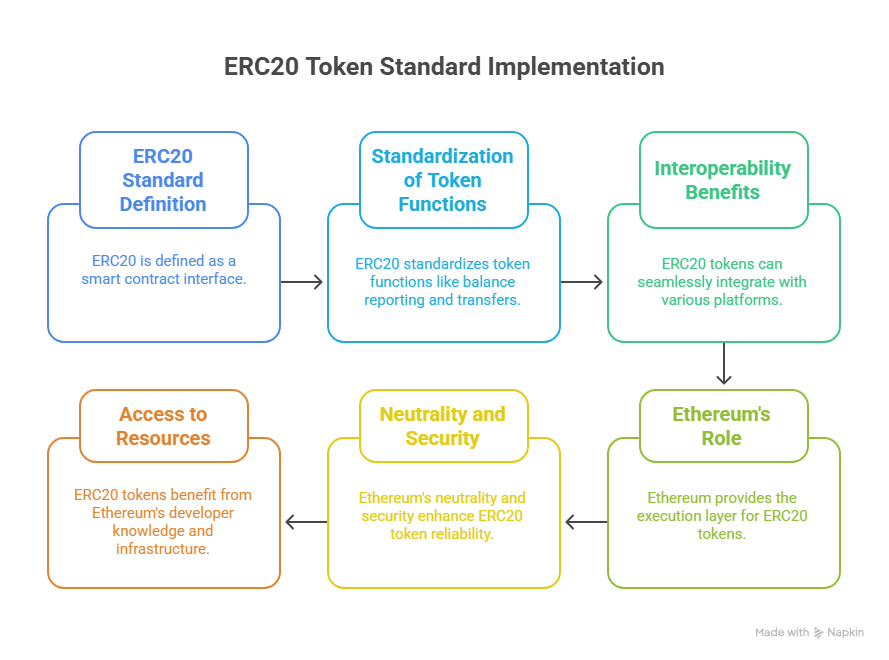
There are many solid reasons to launch a token, ranging from practical loyalty programs to coordination mechanisms for complex communities, and the use cases are multiplying as organizations experiment in public.
Some teams issue governance tokens that direct treasuries and roadmap choices, while others design rewards that encourage learning, contribution, or time-bounded participation in quests and seasonal experiences.
When you create ERC20 token systems thoughtfully, you can express identity, incentives, and authority without centralized gatekeepers, which unlocks coordination experiments that feel playful yet consequential.
Tokens also help align contributors and sustain public goods, since ownership becomes programmable and transparent, which encourages recurring commitment rather than drive-by hype. The trick is building minimalism into the first version while keeping room for future expansion, because the healthiest ecosystems evolve deliberately and keep security constraints visible whenever adding features or privileges.
Before we get into deploying contracts or generating tokens, it’s important to gather a small set of tools and environment pieces that will streamline your build experience. You don’t need a complicated developer stack or specialized software, because most of the work can take place in your browser through Remix, which is a coding and deployment environment tailored specifically for Ethereum smart contracts.
Think of this stage as laying out your ingredients before cooking, because once you start writing and deploying your contract, the flow is straightforward and predictable. Without these items, however, you’d find yourself pausing mid-stream to locate materials, which often breaks learning momentum and clarity
Open Remix in your browser and enable the file explorer, the compiler panel, and the deployment panel, because switching panels repeatedly during first attempts causes context loss and unnecessary mistakes.
Connect your MetaMask wallet and confirm the currently selected network, since Remix will forward transactions through your injected provider exactly as configured.
If you intend to create ERC20 token prototypes on testnet first, switch your wallet to Sepolia or Holesky now to avoid accidental mainnet deployments during early experiments.
Create a file named MyToken.sol and add a short header comment with author, license, and a one-line summary, because tiny documentation details pay dividends when others inspect your contract later.
Consistent naming conventions also help block explorers and auditors build mental models quickly, which reduces misunderstandings about intent. When you create ERC20 token contracts for public audiences, clarity becomes a security feature because it lowers the chance that users misinterpret behavior.
Import the ERC20 implementation from @openzeppelin/contracts/token/ERC20/ERC20.sol, then extend it with a constructor that sets a name, a symbol, and an initial supply while minting to the deployer.
Avoid reinventing allowance logic or arithmetic, since those mistakes are common and expensive. The point is not novelty; the point is reliability. Using OpenZeppelin is how you create ERC20 token contracts that behave exactly as most wallets and exchanges expect without additional integration work.
// SPDX-License-Identifier: MIT
pragma solidity ^0.8.20;
import “@openzeppelin/contracts/token/ERC20/ERC20.sol”;
contract MyToken is ERC20 {
constructor(uint256 initialSupply) ERC20(“MyToken”, “MTK”) {
_mint(msg.sender, initialSupply * 10 ** decimals());
}
}
Pick a name humans can pronounce and a symbol that does not collide with well-known tickers, because searchability and user trust benefit from clean semantics.
ERC20(“MyToken”, “MTK”)
Set supply in whole units and multiply by 10 ** decimals() to respect standard precision, since failing to scale the number correctly leads to confusing supply displays and awkward UX.
When you create ERC20 token parameters carefully, you avoid migrations later, which is often impossible without issuing a new contract and coordinating messy swaps.
Select a compiler version that matches your pragma and enable optimization with a reasonable run count, because gas efficiency matters for every subsequent transaction that calls your contract.
If you encounter import path issues, enable Remix’s dependency management or use the file explorer to confirm the package resides in the expected node-style structure.
Successful compilation yields an artifact and ABI, which you will need for downstream verification and integrations.
Switch to Sepolia or Holesky and deploy using the “Injected Provider,” confirming the constructor’s initial supply parameter reflects your intended tokenomics.
After the transaction confirms, copy the address, view it on the testnet explorer, and add the token to MetaMask to validate decimals, name, and symbol.
When you create ERC20 token deployments, treat testnet as more than a smoke test by practicing transfers, approvals, and allowance spending so you can spot UX surprises before mainstream users encounter them.
After you repeat successful rehearsals, switch MetaMask to mainnet, ensure sufficient ETH for gas, and deploy using the same build artifacts to preserve bytecode determinism.
Record the transaction hash, the block number, and the contract address in your notes, because organized provenance speeds audits, listings, and operational handoffs later.
By the time you create ERC20 token instances on mainnet, the process should feel rehearsed, predictable, and almost boring, which is exactly the right kind of energy for irreversible actions.
Open your contract address on Etherscan, run the verification wizard with the correct compiler settings, and paste your flattened source or import references as required. Verification enables public read functions, contract interaction from the explorer, and downstream tooling that relies on ABI discovery. Verifying is not optional optics; it is operational hygiene, since people will not trust contracts they cannot inspect, and integrations will not proceed without source visibility.
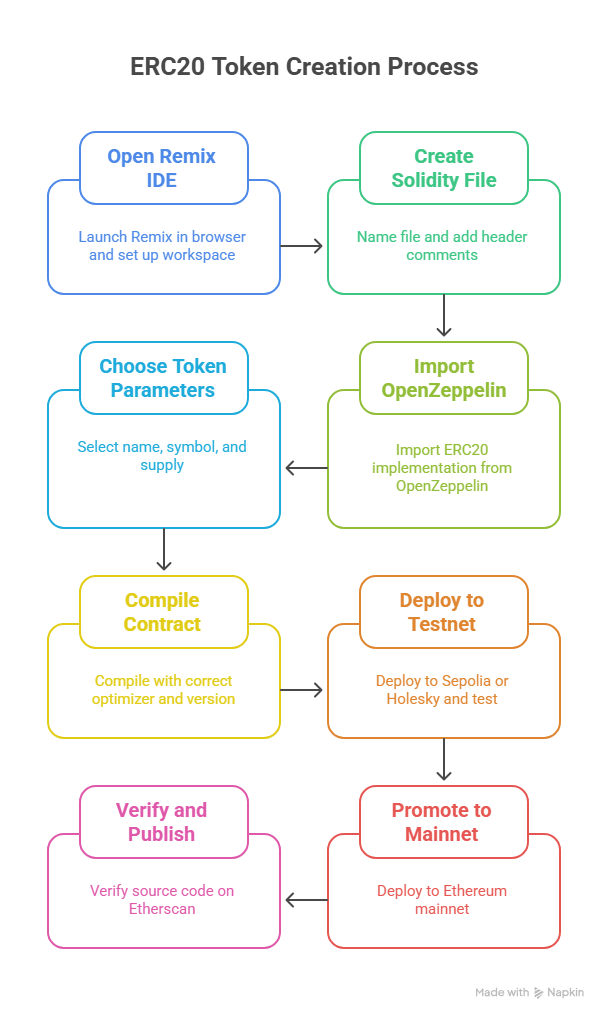
Use minting and burning to manage supply across market cycles, but gate these actions behind a multisig or a timelock so every change is deliberate, transparent, and reviewable by stakeholders before execution.
Clear policies around who can invoke supply changes, under what thresholds, and with what public notice periods keep trust legible and prevent frantic governance drama when conditions shift suddenly.
Introduce staking to reward patience and contribution, yet publish emission formulas that anyone can verify, because predictable math beats vague promises when users evaluate durability.
Align rewards with desired behaviors such as long-term locking, validator participation, or community service, and avoid runaway inflation by modeling scenarios where participation spikes or drops across multiple adoption curves.
Liquidity bootstraps trading and price discovery, but pair incentives with reasonable cliffs and vesting so short-term farmers do not vacuum value before real users arrive.
Choose fee tiers and pool depths based on expected volatility, publish addresses and walkthroughs to avoid phishing risk, and audit any routers or incentives contracts before funding them with meaningful treasury assets.
Start with lightweight off-chain signaling through tools like Snapshot when communities are forming, then graduate to on-chain execution once processes mature and role clarity exists.
Guard powerful actions behind quorum thresholds, role-based permissions, and execution delays, because formal process without brakes becomes theater, while conservative brakes convert participation into reliable, legible authority.
Bridging can expand reach across ecosystems and user bases, yet every bridge introduces additional trust assumptions, validator sets, and failure modes that require explicit documentation.
If you extend or create ERC20 token representations to other networks, publish attestation sources, incident procedures, pause levers, and emergency communication channels so responders can act quickly when anomalies surface.
Start narrow with the essentials, grow intentionally as real usage emerges, and prefer improvements that lower complexity while raising clarity, because that combination compounds trust faster than sprawling feature catalogs.
Roadmaps should prioritize explainable upgrades, measurable outcomes, and reversible decisions, since disciplined iteration beats novelty when ecosystems reward credible commitments over flashy but fragile detours.
Mainnet deployment costs fluctuate with gas prices and bytecode size, so compile with optimization and choose quiet network windows whenever possible.
| Action | Cost | Notes |
| Testnet Deployment | Free | Requires faucet ETH |
| Mainnet Deployment | $10–$120+ | Depends on gas conditions |
| Liquidity Provision | Variable | Depends on initial depth |
The cost to create ERC20 token systems varies, but testnet workflows eliminate financial risk during development.
As you wrap the build, remember that contracts are foundations while communities are the architecture, because real value emerges when users understand, trust, and participate over time.
Your next steps involve clarifying purpose, publishing transparent documentation, verifying code, and creating simple onramps that welcome newcomers without confusing interfaces or unnecessary friction. Pair those steps with liquidity planning, staged governance, and feedback loops that let holders shape priorities, since alignment grows when people feel empowered and informed.
Treat transparency as a habit rather than a press release, sharing roadmaps, risks, and progress with metrics that match onchain reality. Design incentives to reward the behaviors you actually want, encouraging contribution, patience, and collaboration instead of extractive short-term churn.
Finally, prepare for iteration, because the healthiest projects evolve thoughtfully, retire dead ends, and celebrate compounding improvements that feel earned. The contract is permanent, but your playbook is adaptable, and that combination invites participation, culture, and sustainable momentum.
Beginner-friendly if you use Remix for deploys, OpenZeppelin for audited logic, and testnets for rehearsals, while keeping roles minimal, documenting steps clearly, and verifying on Etherscan. These choices externalize complexity into proven libraries and workflows, shrinking the surface area for costly mistakes.
Gas is modest; the real spend is liquidity seeding, security audits, bug bounties, incident response, documentation, and community support. Teams routinely underfund documentation and moderation, which quietly reduce churn, miscommunication, and reputational damage across growth cycles.
Proxies add flexibility but demand governance maturity, emergency procedures, and careful role design to avoid accidental centralization. Immutability simplifies trust and removes entire risk classes, though it limits features, so choose deliberately and communicate the posture before inviting public participation.
In MetaMask, choose Import Token, paste the contract address, and confirm the name, symbol, and decimals. Incorrect displays usually stem from decimal scaling mistakes or early metadata caching, which thorough testnet rehearsals expose before mainnet users encounter them.
Seed a Uniswap pool with a sensible ETH pair and fee tier, provide enough depth to limit slippage, publish exact addresses, and share a step-by-step transaction walkthrough. Keep incentives simple until base mechanics feel routine, because first-week stability compounds trust into durable participation.
This guide walked through the full process of designing, writing, deploying, verifying, and testing a token on Ethereum, explaining each step’s purpose and how it connects to wallets, explorers, decentralized exchanges, and governance or rewards systems that deliver real utility. You learned why standards matter, how audited libraries reduce risk, and where rehearsals on testnets expose UX surprises before public release. We emphasized documentation, liquidity planning, and permissions design, because those operational choices shape credibility as strongly as code quality. The next phase involves community narratives, transparent metrics, and calm iteration, turning a static contract into a living project. With these patterns internalized, you can ship responsibly, communicate clearly, and evolve deliberately, giving early supporters solid rails to build upon with confidence and shared conviction.
Read More: A Full-Proof Guide to Create an ERC20 Token on Ethereum">A Full-Proof Guide to Create an ERC20 Token on Ethereum


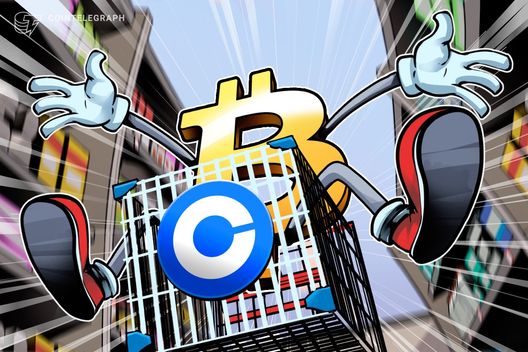
Coinbase recorded another profitable quarter with $432.6 million in net income in Q3 on the back of $1.9 billion in revenue, while Coinbase’s Bitcoin holdings rose by 2,772 BTC.

Crypto prices remain depressed due to macroeconomic and geopolitical uncertainty, despite interest rate cuts and positive trade news.

Blockchain fees are set to reach $19.8 billion this year, demonstrating the technology’s growth beyond speculation into real, user-driven economic activity.

DYdX president Eddie Zhang reportedly said the decentralized exchange would offer spot trading for cryptocurrencies as part of its move into the US later this year.

CoreWeave has been trying to acquire Core Scientific for over a year in one of the most-watched M&A deals in crypto.

Bitcoin Magazine

Michael Saylor’s Strategy (MSTR) Reports $2.8B Q3 Net Income, Bitcoin Gains Soar
Michael Saylor’s Strategy (NASDAQ: MSTR) released its third-quarter earnings after market close on Oct. 30, posting net income of $2.8 billion.
Diluted earnings per share (EPS) came in at $8.42, surpassing analyst expectations of $8.15. As of Oct. 26, 2025, Strategy held 640,808 BTC, acquired for a total of $47.44 billion at an average price of $74,032 per coin.
The company reported a year-to-date Bitcoin yield of 26%, generating $12.9 billion in gains amid the ongoing 2025 crypto bull market.
Looking forward, Strategy projects full-year 2025 operating income of $34 billion and net income of $24 billion, or $80 per share — highlighting its transformation from a business intelligence firm into a de facto corporate Bitcoin investment vehicle.
Total revenues for Q3 reached $128.7 million, up 10.9% year-over-year and above the $118.43 million analysts had forecast.
The firm’s Bitcoin holdings have already produced gains of 116,555 BTC in 2025, translating to $12.9 billion in dollar terms based on an average BTC price of roughly $110,600 as of Oct. 24, nearing its full-year target of $20 billion.
Michael Saylor said recently at Money 20/20, “By the time the bankers tell you it’s a good idea, it’ll cost $10 million per Bitcoin.” He added that Bitcoin is currently at a “99% discount.”
NEW: Michael Saylor says, “By the time the bankers tell you it’s a good idea, it’ll cost $10 million per Bitcoin.”
— Bitcoin Magazine (@BitcoinMagazine) October 30, 2025
It’s at a “99% discount” right now. pic.twitter.com/qaH4pF9xVj
And Saylor’s public discourse towards bitcoin backs this belief up. Saylor reiterated his bullish outlook on Bitcoin, projecting $150,000 by the end of 2025 and up to $1 million within four to eight years.
He cited growing institutional adoption, driven by industry shifts, new investment products, and Strategy’s recent B-minus credit rating, as key catalysts.
Saylor highlighted Strategy’s digital credit instruments offering 8–12.5% yields, tax-efficient returns, and tailored risk profiles. He noted increasing acceptance of Bitcoin by major U.S. banks and praised supportive regulatory policies.
In a recent interview with Bitcoin Magazine, Michael Saylor outlined his ambitious vision for Strategy: building a trillion-dollar Bitcoin balance sheet to transform global finance.
Saylor sees his firm — and potentially other Bitcoin treasury companies — accumulating massive Bitcoin holdings, leveraging the cryptocurrency’s historical 21% annual appreciation to supercharge capital growth.
Central to his plan is the creation of Bitcoin-backed credit markets offering yields significantly higher than traditional fiat debt. By over-collateralizing capital, Saylor argues the system could be safer than AAA corporate debt while providing healthier returns for investors.
This approach, he suggests, could revitalize credit markets worldwide, offering alternatives to low-yield bonds that dominate Europe and Japan.
Saylor also envisions Bitcoin becoming embedded across corporate, banking, and sovereign balance sheets, gradually turning traditional equity indexes into indirect Bitcoin vehicles.
This integration could boost public companies, redefine savings accounts and money market funds, and allow tech giants like Apple and Google to bring hundreds of millions into the digital economy.
Those interested in learning more about Strategy’s earnings report can watch in full detail here.
This post Michael Saylor’s Strategy (MSTR) Reports $2.8B Q3 Net Income, Bitcoin Gains Soar first appeared on Bitcoin Magazine and is written by Micah Zimmerman.

Bitcoin Magazine
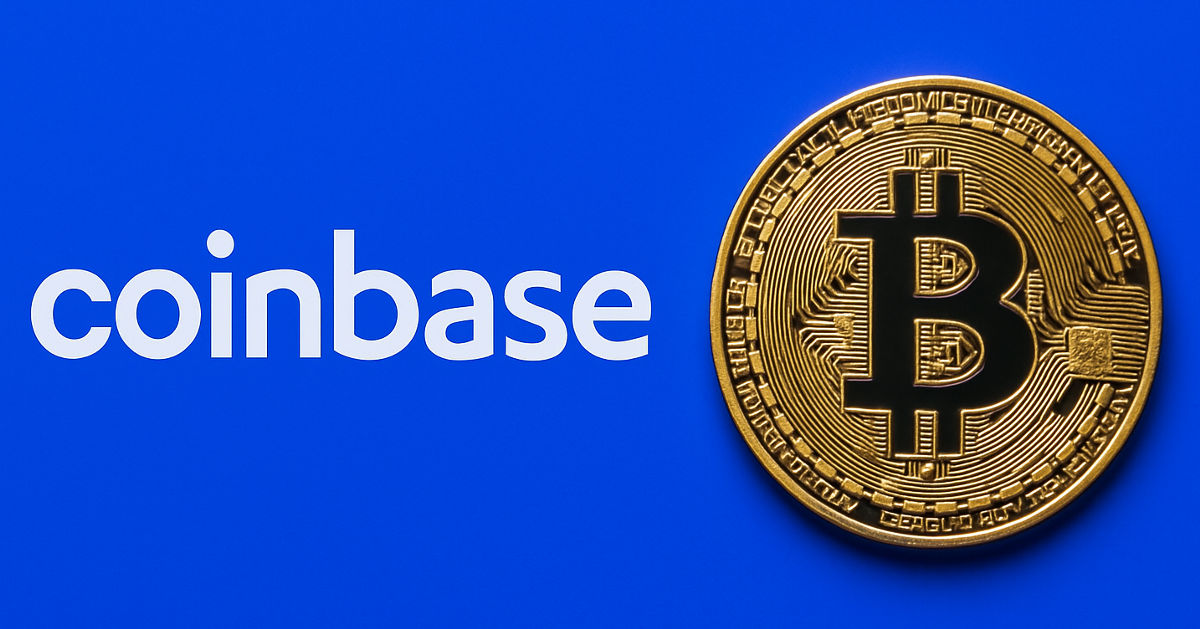
Coinbase Beats Q3 Estimates With $1.9B Revenue, Buys $300M in Bitcoin
Coinbase reported stronger-than-expected third-quarter earnings Thursday, posting $1.9 billion in revenue — up 26% from the previous quarter — as renewed crypto market momentum boosted both trading and stablecoin income.
The San Francisco-based exchange notched $433 million in net profit, or $1.50 per share, surpassing Wall Street expectations of $1.10 per share on $1.8 billion in revenue.
Despite a sequential decline from its record $1.4 billion profit in Q2, Coinbase attributed the drop primarily to non-cash mark-to-market adjustments related to its holdings in Circle and its crypto portfolio.
Shares of Coinbase Global (COIN) jumped more than 4% in after-hours trading to $341 following the results.
JUST IN: Coinbase announced it purchased $299 million #Bitcoin in Q3, 2025
— Bitcoin Magazine (@BitcoinMagazine) October 30, 2025pic.twitter.com/7axMBTxFw0
The stock is up roughly 33% year-to-date after peaking above $440 in July.
Coinbase also bought almost $300 million in BTC in Q3. CEO Brian Armstrong confirmed via an X post that remains bullish on bitcoin, stating, “Coinbase is long Bitcoin. Our holding increased by 2,772 BTC in Q3. And we keep buying more.”
The results came as Bitcoin hit fresh all-time highs during the quarter, fueling renewed retail and institutional activity after a quieter Q2 marked by macro headwinds.
Coinbase reported $1.0 billion in transaction revenue, up 37% from the prior quarter and 83% from a year earlier, on trading volumes of $295 billion.
Institutional volume rose 22% sequentially to $236 billion, driven in part by the August acquisition of Deribit, the world’s largest crypto options exchange.
Deribit contributed $52 million in revenue during Q3 as Coinbase expanded its derivatives business to include 24/7 perpetual futures trading in the U.S.
Retail activity also rebounded, with consumer trading volume climbing 37% to $59 billion. Coinbase said new listings and decentralized exchange (DEX) integrations helped boost activity among “advanced traders” the company said, while the company’s platform now supports trading for roughly 90% of all crypto assets by market capitalization.
Coinbase continues to diversify beyond trading fees, with subscriptions and services revenue climbing 14% to $747 million.
Stablecoin revenue — largely derived from its role in distributing and managing Circle’s USDC — rose to $355 million, a 43% increase year-over-year. Average USDC balances held in Coinbase products reached a record $15 billion, supported by rising market capitalization and new institutional reward programs.
Blockchain rewards, including staking income, grew 28% quarter-over-quarter to $185 million, aided by surging prices for Ethereum and Solana.
Meanwhile, custodial fees and interest income both hit new highs as total assets on the platform reached $516 billion.
Coinbase said it is progressing toward its vision of an “Everything Exchange” — a platform uniting spot, derivatives, and onchain services under one roof.
The exchange also highlighted ongoing development of Base, its Ethereum layer-2 network, which has become the leading L2 for stablecoin adoption with $4.6 billion in dollar-pegged assets.
CEO Brian Armstrong said Coinbase is scaling payments by ‘advancing stablecoin adoption’ and building the foundation of the future financial system.
This post Coinbase Beats Q3 Estimates With $1.9B Revenue, Buys $300M in Bitcoin first appeared on Bitcoin Magazine and is written by Micah Zimmerman.
Bitcoin Magazine
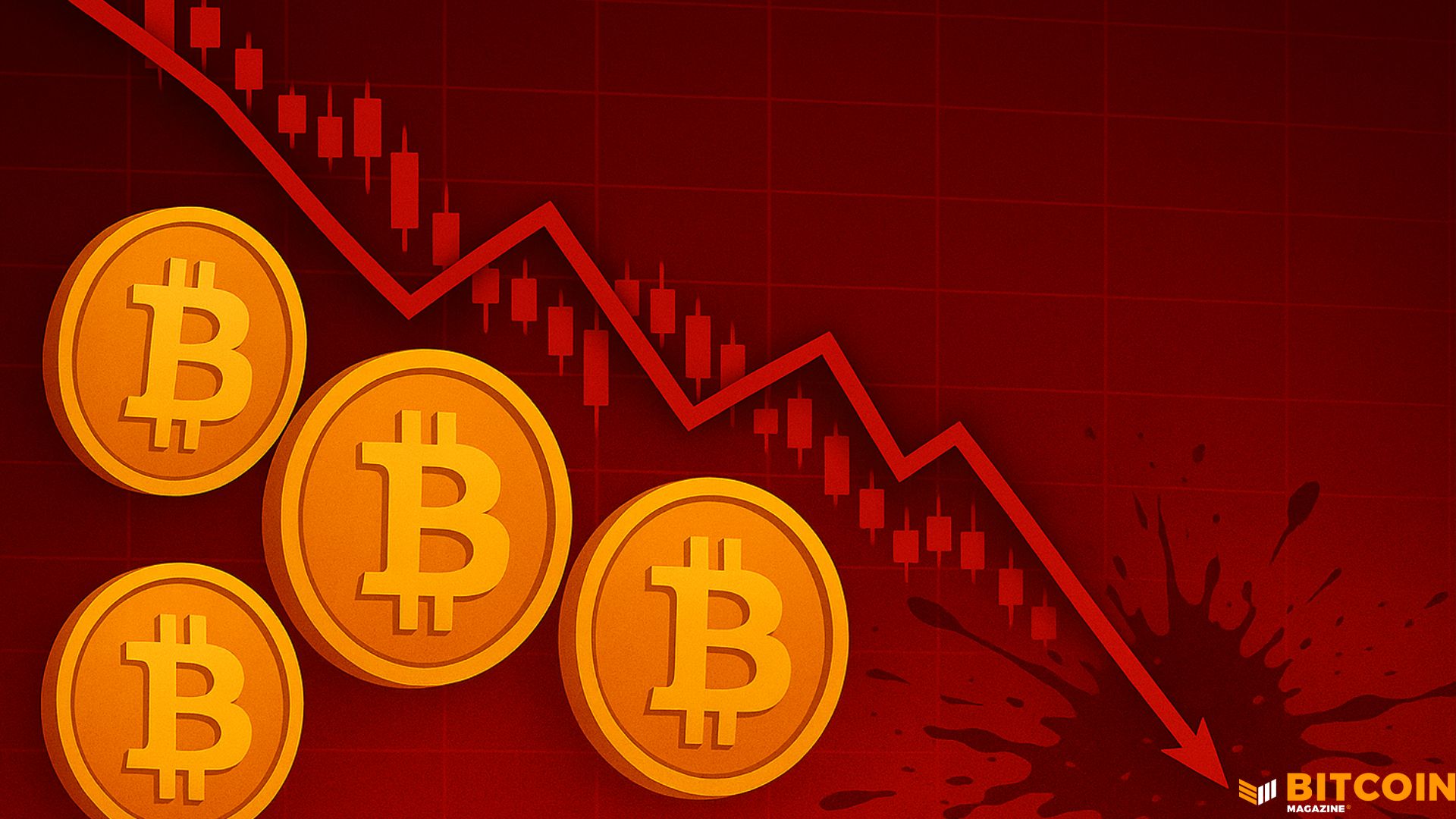
Bitcoin Price Crashes Down to $106,000 As Red Week Continues
Bitcoin price continued its slide through much of Thursday, dipping to as low as $106,290 as traders digested a wave of macro uncertainty — from Federal Reserve Chair Jerome Powell’s cautious tone on future rate cuts to renewed volatility following U.S.–China trade talks.
The bitcoin price fell over 3% in early trading before stabilizing slightly above $107,000. The drop extends a multi-day long decline that began after the Federal Reserve delivered a widely expected 25 basis point rate cut but signaled that December’s meeting may not bring another.
Powell’s remarks at the post-meeting press conference struck a notably hawkish tone. While acknowledging progress toward the Fed’s 2% inflation goal, he emphasized that the committee had “strongly differing views” and that no decision had been made about a December cut.
Traders quickly scaled back expectations — with futures now pricing roughly a 60% chance of another reduction, down from nearly full certainty just a day earlier.
“Powell’s comments created a bit of risk-off sentiment,” said Charlie Sherry, head of finance at BTC Markets, according to Bloomberg. “Add in the Trump–Xi meeting stirring markets today, and, unsurprisingly, you get some volatility. Some technology stocks are rallying, but crypto hasn’t followed — which shows some relative weakness and hesitation in digital assets right now.”
Treasury yields and the U.S. dollar climbed following Powell’s remarks, while risk assets broadly sold off. The two-year Treasury yield jumped nearly 10 basis points as traders reassessed the Fed’s trajectory.
Meanwhile, market attention also turned to Seoul, where U.S. President Donald Trump met with Chinese President Xi Jinping. Trump described the talks as “amazing” and announced a deal to halve tariffs on fentanyl-related goods, claiming the two sides were “pretty close” to a broader trade agreement involving rare earth materials and agricultural purchases.
While such developments have little direct impact on Bitcoin, risk sentiment tends to spill across markets — and Thursday’s pullback in equities appeared to drag digital assets with it.
Amid the macro jitters, on-chain analysts also flagged large Bitcoin movements linked to Elon Musk’s SpaceX. Data from Arkham Intelligence shows the company moved 281 BTC (worth roughly $31 million) late on October 29 — its fifth transfer this month, totaling 4,337 BTC (about $472 million).
The transfers were routed through Coinbase Prime, suggesting institutional custody activity rather than market sales. Some believe SpaceX may be reorganizing its wallets from older Bitcoin address formats (“1”-prefix legacy types) to newer Taproot and SegWit formats.
Musk first confirmed SpaceX’s Bitcoin holdings in 2021, though the firm reportedly reduced its stack by about 70% during the 2022 market crash.
As of this month, Arkham tracks roughly 7,258 BTC (about $799 million) still linked to SpaceX addresses, though that figure could rise as recent transfers are reclassified.
Tesla, meanwhile, retains 11,509 BTC, worth about $1.3 billion, according to the same data.
With U.S. monetary policy in flux, trade negotiations uncertain, and major corporate holders quietly reshuffling coins, Bitcoin’s latest move reflects a broader narrative: investors waiting for direction.
The next major catalyst may arrive in December — either from a Fed rate cut or from markets losing faith that one is coming. Until then, Bitcoin remains in a holding pattern between macro optimism and monetary restraint.
This post Bitcoin Price Crashes Down to $106,000 As Red Week Continues first appeared on Bitcoin Magazine and is written by Micah Zimmerman.
Bitcoin Magazine

Lolli Acquires Slice to Expand Bitcoin Rewards Across Browsing and Shopping
Bitcoin rewards platform Lolli, now a part of the Bitcoin-focused venture studio Thesis*, has acquired Slice, a browser extension that allows users to earn Bitcoin through passive browsing.
The acquisition merges two complementary approaches to earning Bitcoin — shopping and passive browsing — into a single platform, simplifying the user experience and broadening opportunities to “stack sats” across everyday online activity.
Founded in 2018, Lolli empowers users to earn free Bitcoin on purchases at over 50,000 top retailers and through 1,000+ mobile games. The platform has helped more than 600,000 users accumulate Bitcoin through intuitive, everyday experiences, according to a company release.
With the addition of Slice, Lolli now extends rewards to users’ web browsing, streaming, and online scrolling habits, creating a unified ecosystem where earning Bitcoin is seamless.
Slice, a browser extension designed to reward users for passive online activity, brings Lightning Network support for withdrawals built into its platform.
This integration accelerates Lolli’s adoption of the Layer 2 network, allowing faster, cheaper, and smaller Bitcoin withdrawals—an improvement that directly addresses user concerns about withdrawal friction and high minimums.
“Lightning makes small withdrawals economically viable in a way Layer-1 transactions never could,” the Lolli team said.
The merger also signals Thesis*’s continued focus on consolidating the Bitcoin rewards space. Thesis*, founded in 2014, is a pioneering venture studio dedicated to building Bitcoin-first solutions that empower individuals and communities.
Its portfolio includes Fold, Mezo, tBTC, Acre, and Taho. The acquisition of Slice marks Thesis*’s second major move in the Bitcoin rewards sector, following Lolli’s earlier integration, and reflects the company’s strategy to unify a previously fragmented market.
Matt Luongo, Founder and CEO of Thesis*, noted the strategic importance of the acquisition: “Together, Slice and Lolli will make it easier than ever for newly minted Bitcoiners to stack sats. Users already earning on Lolli will now be able to double down on their rewards potential simply by browsing online.”
Luongo also noted that Thesis* is systematically rebuilding Lolli’s app and infrastructure, starting with Layer 2 and sidechain integrations, and plans to expand onchain withdrawal options in the future.
From a user perspective, the acquisition ensures continuity: current Lolli users maintain their existing accounts and rewards, while Slice users continue earning Bitcoin through passive browsing.
Over time, the combined platform will integrate withdrawals through Mezo, Thesis*’s Bitcoin sidechain, and expand merchant partnerships to create a truly global Bitcoin rewards ecosystem.
As the Bitcoin rewards sector continues to grow, this acquisition underscores the broader trend of consolidation and product integration.
This post Lolli Acquires Slice to Expand Bitcoin Rewards Across Browsing and Shopping first appeared on Bitcoin Magazine and is written by Micah Zimmerman.

Bahrain’s GFH Financial Group has become the first Islamic investment bank in the Kingdom to integrate cryptocurrency payments directly into its banking app, marking a major milestone in the nation’s digital finance journey.
The partnership with Binance Pay enables GFH clients to perform real-time crypto-to-fiat transactions, bringing blockchain technology closer to traditional banking in Bahrain.
Through this collaboration, GFH customers can now use Binance Pay within the GFH app to fund investments instantly and securely.
The feature allows users to convert digital assets into local currency without leaving the bank’s ecosystem, streamlining what was once a complex process.
This innovation eliminates the need for third-party exchanges for simple conversions, bridging the gap between crypto and conventional finance.
The service is powered by Binance Pay’s infrastructure, ensuring fast and low-cost transactions.
Clients can top up fiat e-wallets, custody both fiat and cryptocurrencies, and complete investment subscriptions within seconds.
For GFH Financial Group, the partnership is a defining step in its digital transformation strategy, designed to enhance accessibility and efficiency for customers managing digital and traditional assets alike.
The Central Bank of Bahrain (CBB) has played a crucial role in supporting this advancement.
Earlier this year, it granted BPay Global B.S.C.(c) — a Binance Group company — a Payment Service Provider (PSP) license to operate in the Kingdom.
The license enables BPay Global to facilitate fiat and crypto custody, manage e-wallets, and process payments securely under the CBB’s supervision.
In parallel, the CBB introduced a stablecoin framework allowing both USD-backed and Bahraini dinar-pegged stablecoins to circulate in the local market.
This regulatory clarity provides a strong foundation for integrating crypto within the financial system, offering stability and ensuring compliance with international standards.
Financial experts say these policies strengthen Bahrain’s position as a crypto-friendly jurisdiction within the Gulf Cooperation Council (GCC).
Osama Nasr, Chief Digital Banking Officer at GFH Financial Group, described the initiative as a transformative step that bridges traditional banking with blockchain technology.
“By bridging traditional banking with blockchain technology, we are introducing a new era of convenience, security, and accessibility for our customers,” Nasr said.
Nasr emphasised that this integration aligns with GFH’s broader goal of delivering smarter and more connected financial experiences.
From Binance’s side, Tameem Al Moosawi, General Manager of Binance Bahrain, highlighted the partnership’s alignment with Bahrain’s economic vision. “
We are contributing to a more competitive and sustainable digital economy. This partnership not only enhances financial innovation but also fosters digital literacy and positions the Kingdom as a leader in the future of finance,” he noted.
The GFH–Binance partnership reflects a growing trend across the GCC, where financial institutions are increasingly adopting blockchain-based solutions.
In the UAE, Liv Bank, a subsidiary of Emirates NBD, has teamed up with Aqua Now for fiat-crypto settlements, while RAKBANK has partnered with BitPanda to offer similar services.
Together, these developments illustrate how Gulf countries are moving toward harmonising digital assets with established banking systems.
In Bahrain, the combination of regulatory foresight, Islamic finance principles, and fintech innovation has created fertile ground for crypto adoption.
GFH Financial Group’s integration of Binance Pay not only enhances the local banking experience but also signals Bahrain’s readiness to compete as a regional hub for digital finance.
The post GFH Financial Group picks Binance Pay for crypto services in Bahrain appeared first on CoinJournal.

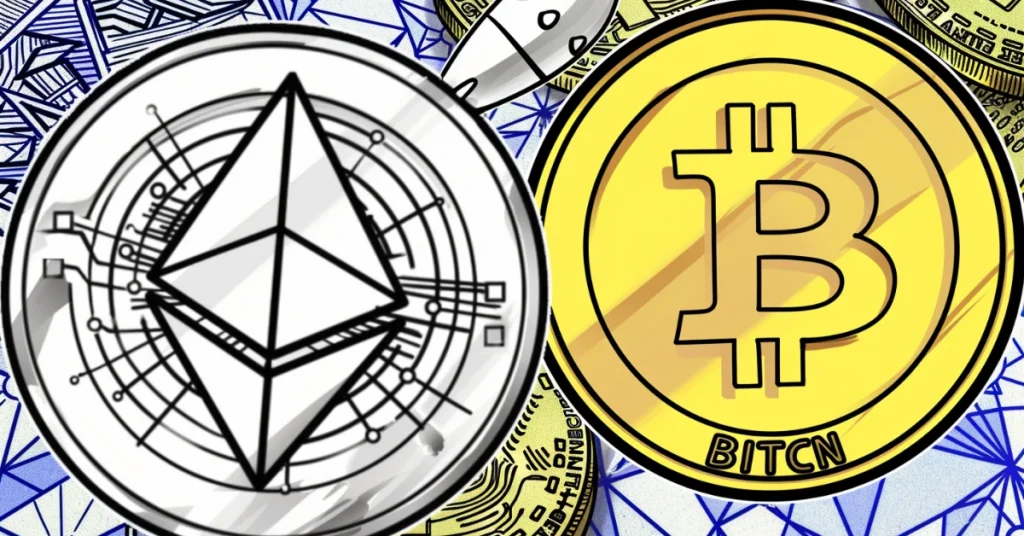
The post Ethereum Price Retests Crucial Support Level As Traders Fear Signal Potential Rebound Amid High Demand appeared first on Coinpedia Fintech News
Ethereum (ETH) price has fallen to retest a crucial support level of above $3,700. The large-cap altcoin, with a fully diluted valuation of approximately $453 billion, dropped 5% over the past 24 hours to trade at around $3,754 on Thursday during the mid-North American session.
The ETH price drop coincided with Bitcoin (BTC), which retraced 4% to hover about $107.5k at press time. Following the sudden ETH price drop today, more than $218 million was liquidated from the Ethereum leveraged market, with the majority involving long traders.
From a technical analysis standpoint, the ETH/USD pair has been retesting a crucial support level around $3,700. Since the October 11 crypto crash, the ETH/USD pair has rebounded from this support level three times, thus signaling potential market reversal ahead.

According to market data analysis from Santiment, Ethereum has attracted a significant number of short positions, which historically coincides with market reversal.
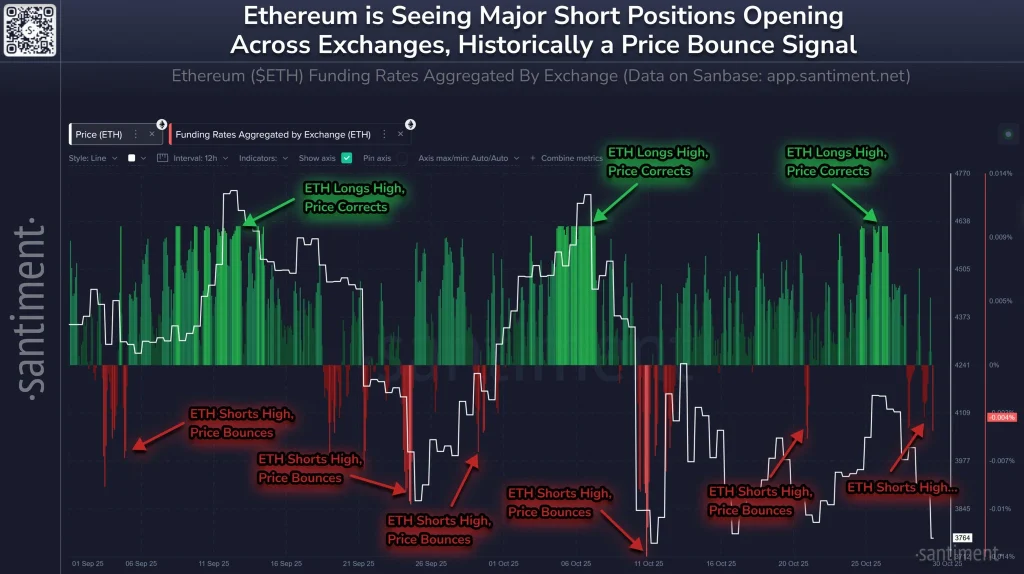
The possibilities of Ethereum price hitting a new all-time high soon has been bolstered by the notable capital rotation from Bitcoin. Notably, the ETH/BTC pair has signaled a market reversal after years of downtrend.
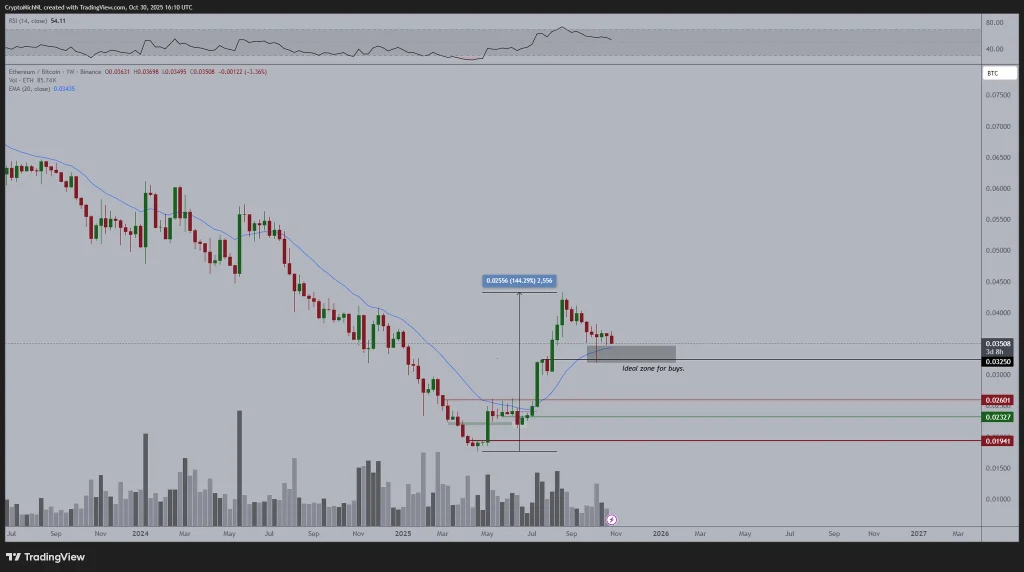
The notable capital rotation from Bitcoin to Ethereum is also observable through their futures market. According to market data from CME Group, the number of Ethereum futures contract significantly compared to Bitcoin’s.
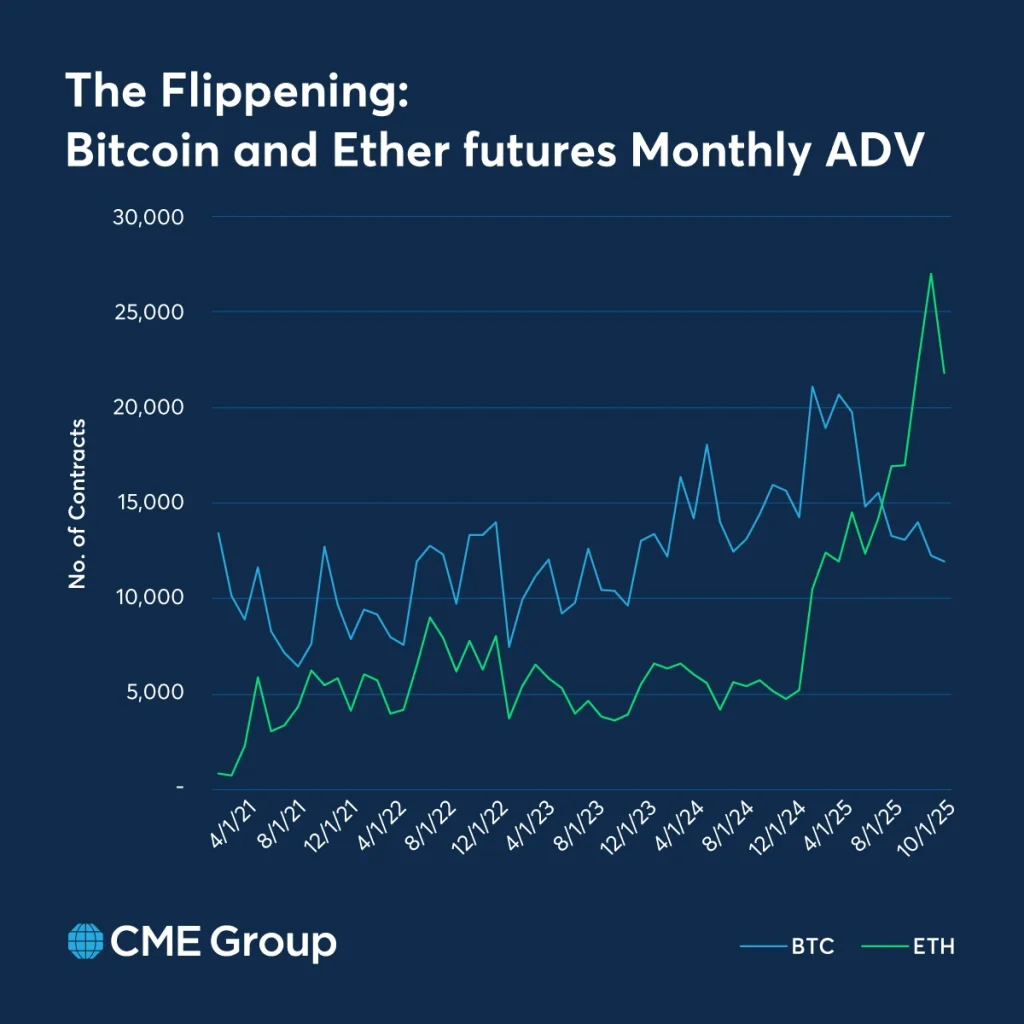
As such, the ETH/USD pair is well positioned for further upsides in the coming weeks, especially if the bulls hold above $3.7k.
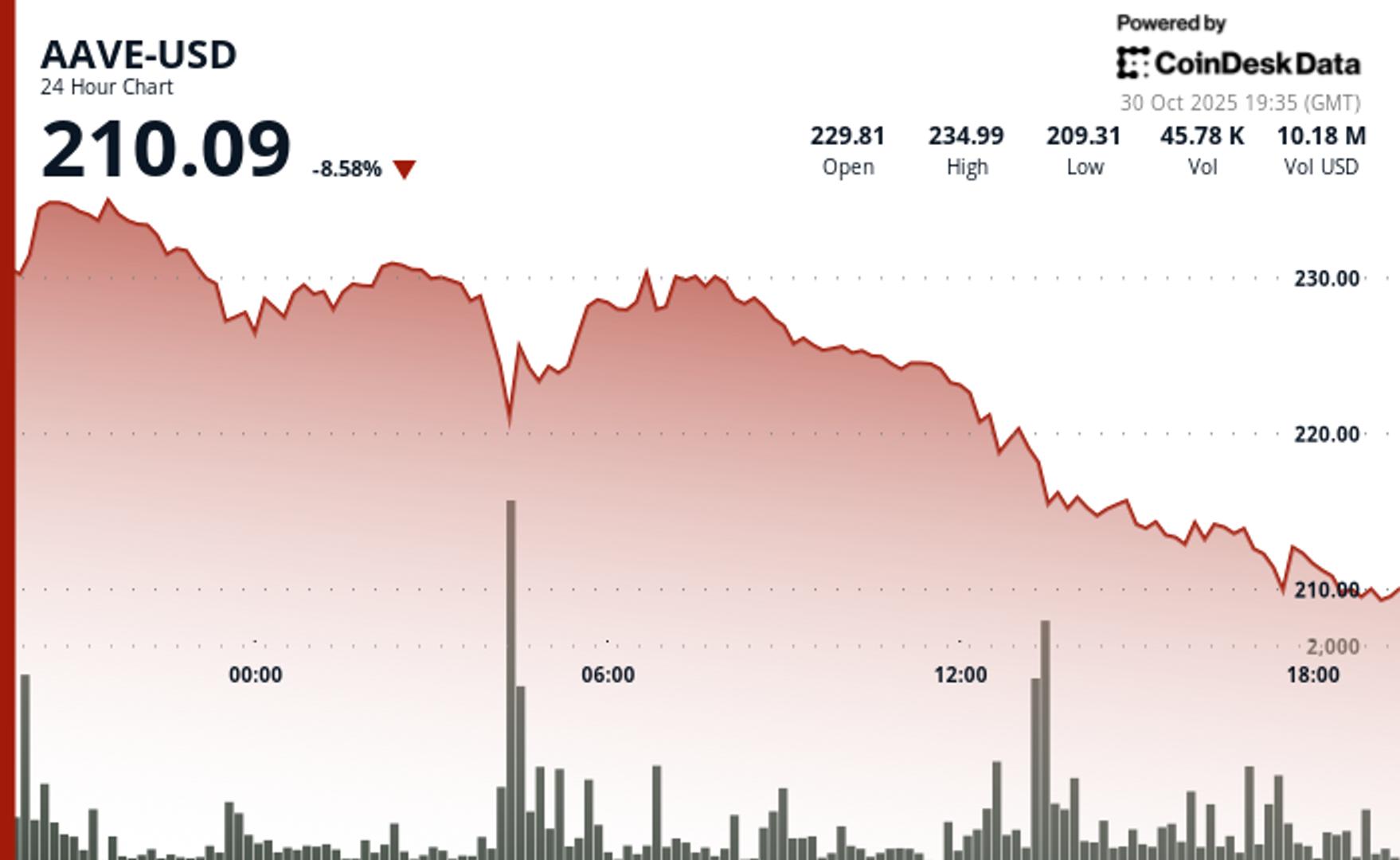
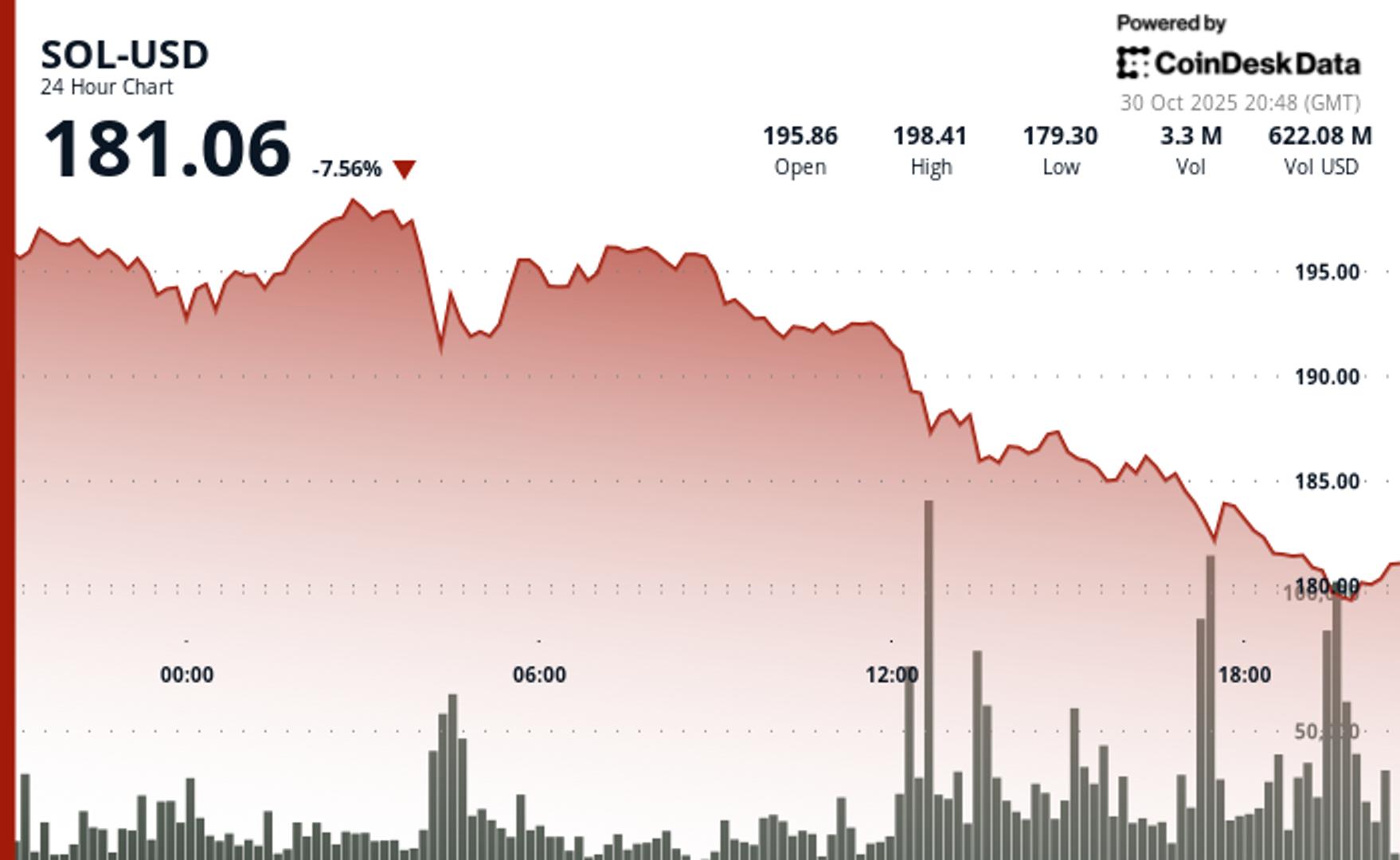
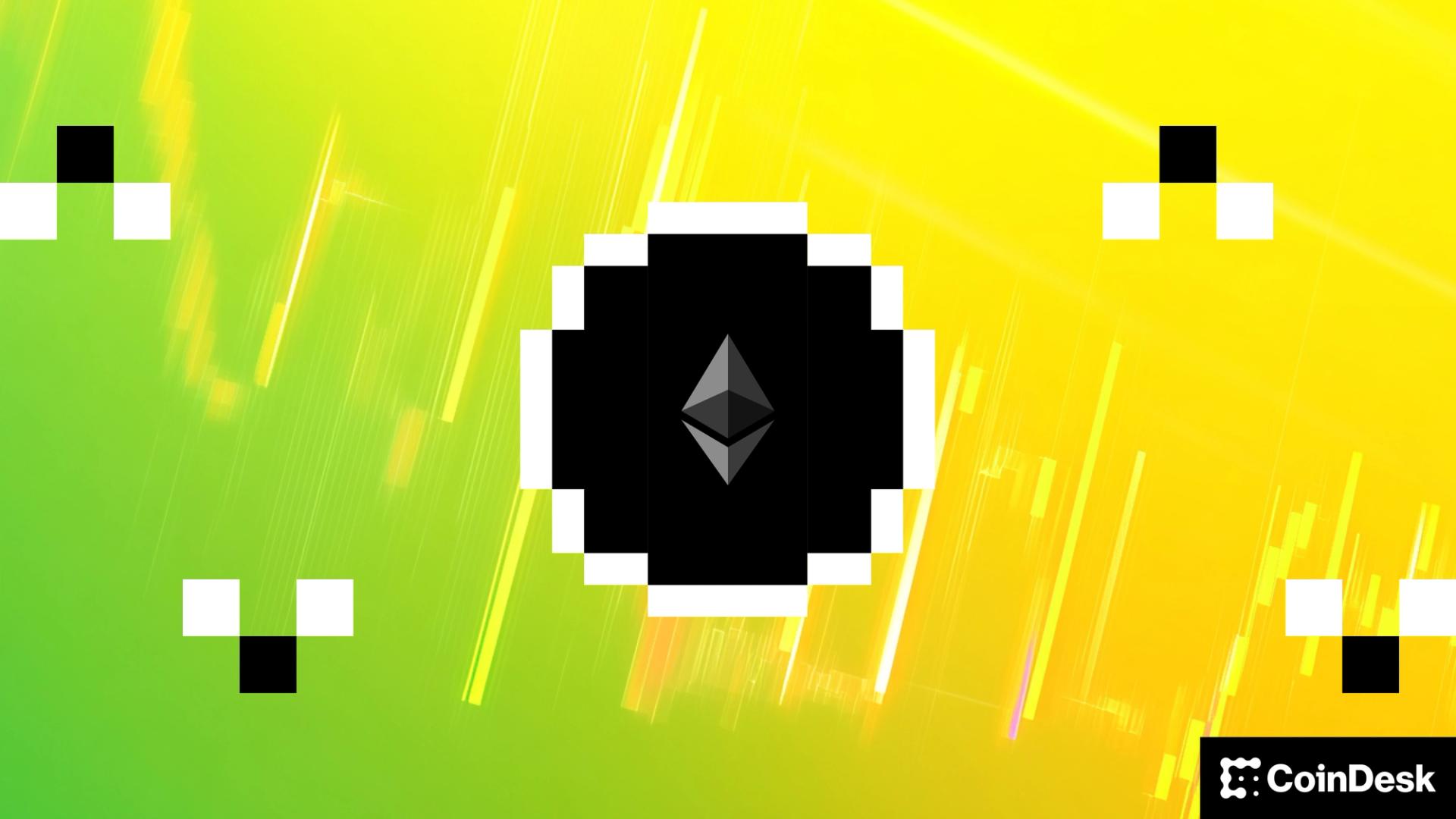

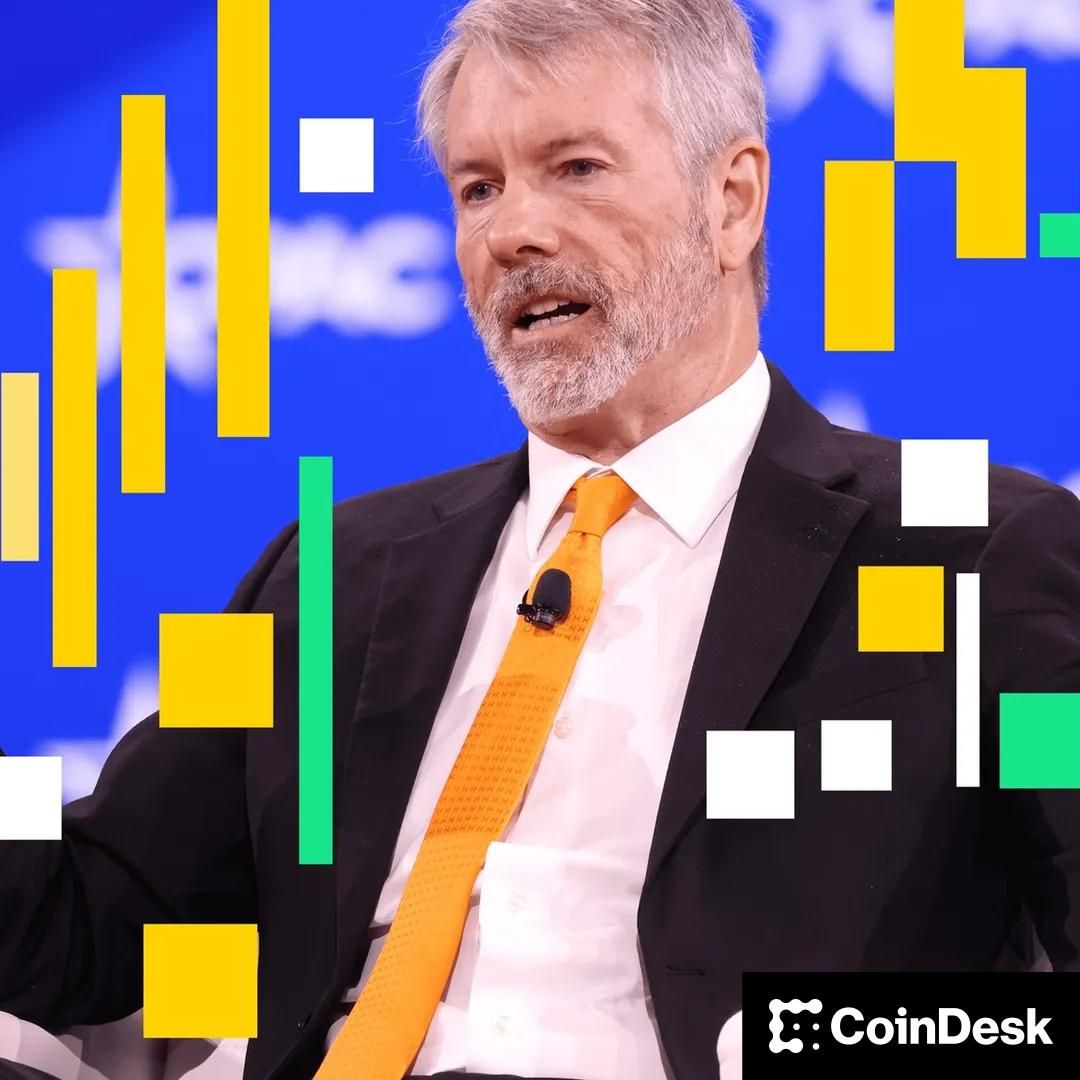
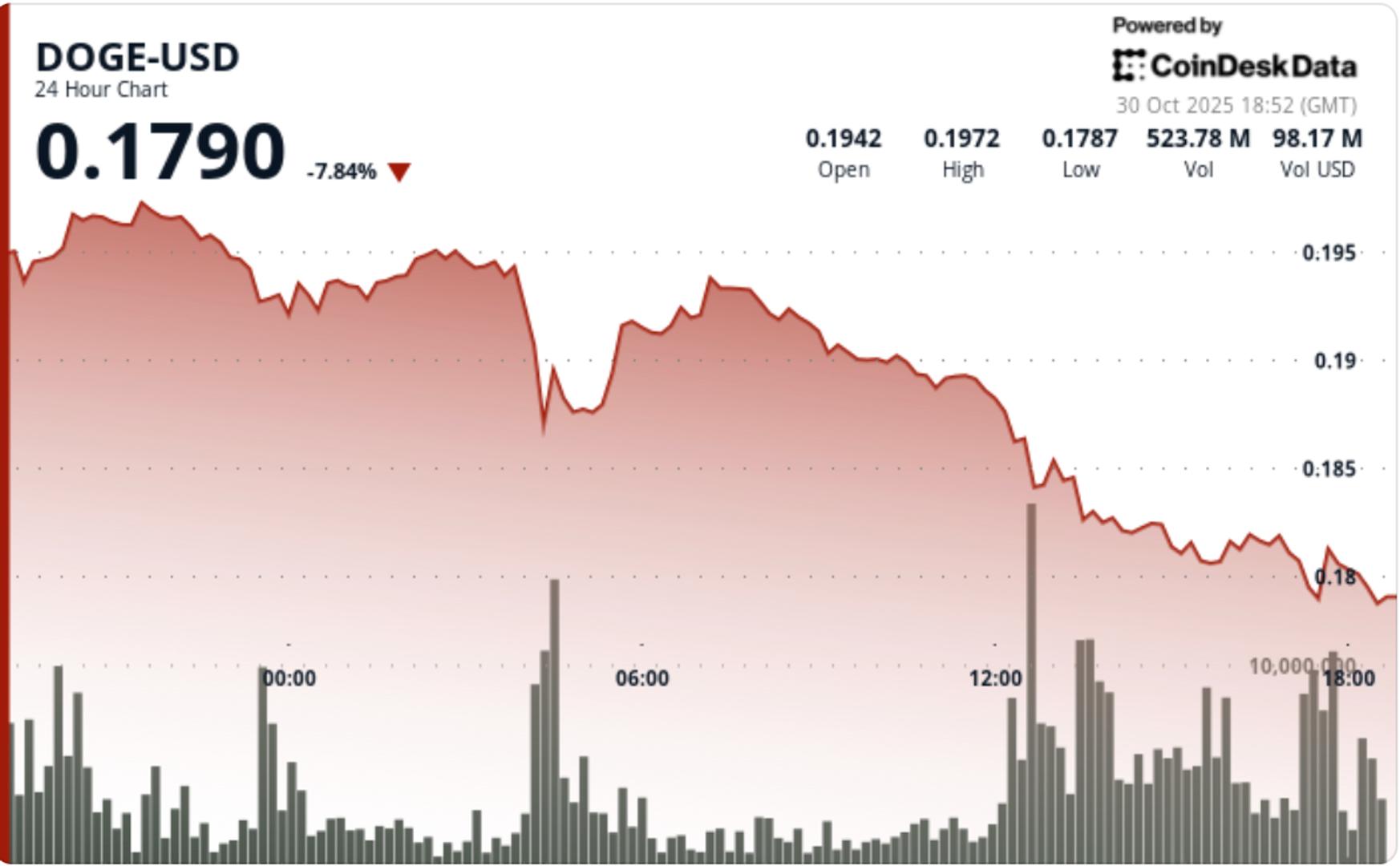


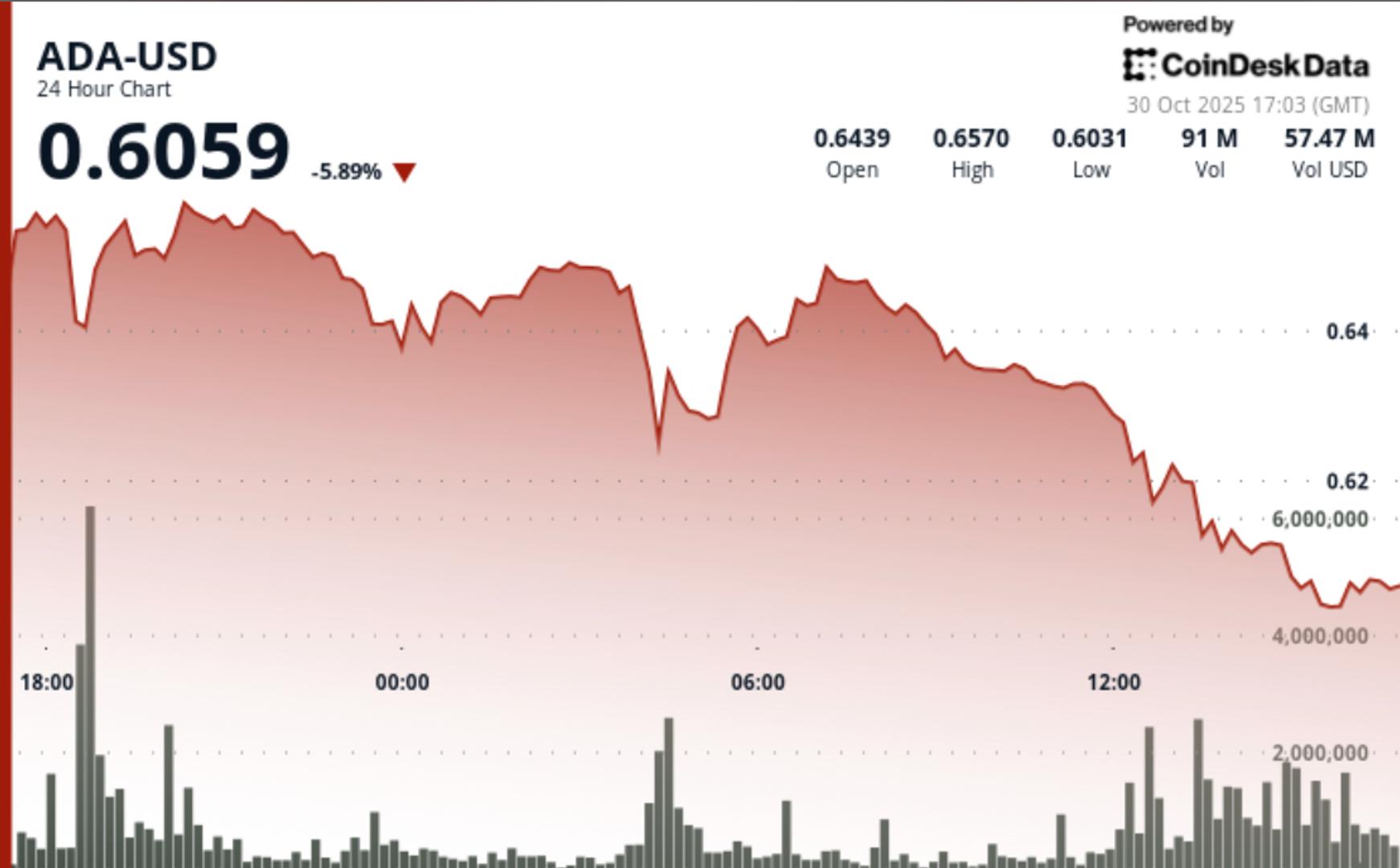
Strategy posts $2.8B Q3 income despite muted Bitcoin prices, expanding holdings to 640K BTC as stock drops 20% in October.
The post Strategy reports $2.8B net income in Q3 2025 despite muted Bitcoin performance appeared first on Crypto Briefing.

Coinbase posts $432.6M Q3 profit as crypto volatility lifts trading volumes amid Trumps pro-crypto policies and market sell-offs.
The post Coinbase reports major net income growth in Q3 2025 amid increased trading volumes appeared first on Crypto Briefing.

Coinbase's increased Bitcoin holdings signal growing corporate confidence in crypto as a strategic asset amid evolving regulatory landscapes.
The post Coinbase boosts Bitcoin holdings by 2,772 BTC in Q3, CEO Armstrong confirms appeared first on Crypto Briefing.

Canary Funds updates S-1 for its XRP spot ETF, removing the delaying amendment and targeting a November 13 launch pending Nasdaq approval.
The post Canary Funds updates S-1 filing for XRP spot ETF, targeting November 13 launch appeared first on Crypto Briefing.

Shekel partners with Symphonyio to launch V2 trading agents, enabling customizable no-code perps on Hyperliquid and Gains Network.
The post Shekel partners with Symphonyio to launch V2 no-code trading agents appeared first on Crypto Briefing.

Kalshi adds native USDC deposits on Base, expanding its multi-chain access after recent integrations with Sui and Aptos.
The post Kalshi adds native support for Base USDC deposits appeared first on Crypto Briefing.

JPMorgan's embrace of blockchain and stablecoins signals a pivotal shift towards mainstream financial integration of digital assets.
The post JPMorgan CEO Jamie Dimon says blockchain and stablecoins are real and will be used by all appeared first on Crypto Briefing.


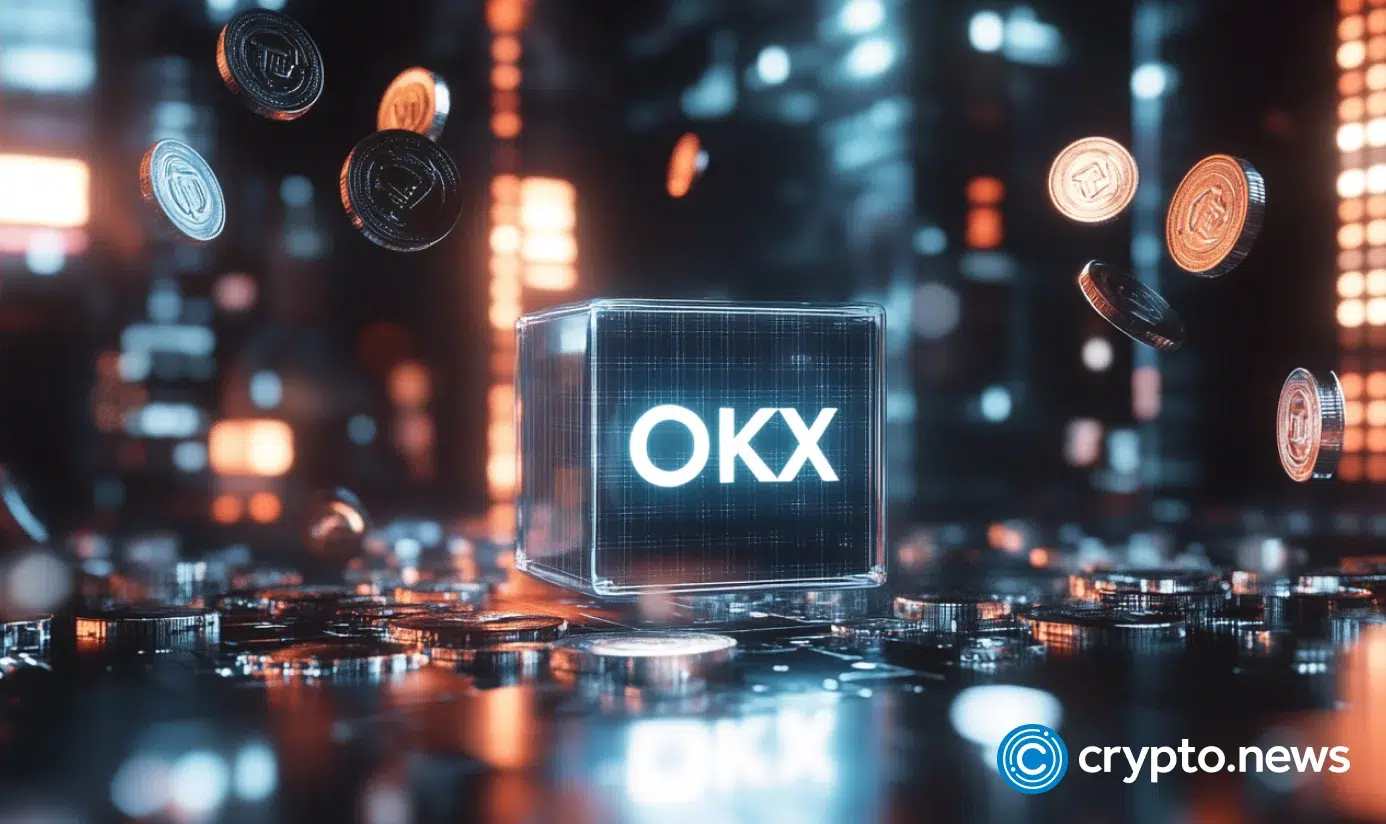
Bitcoin has struggled to reclaim the short-term holder Realized Price, a key on-chain level. Here’s where the next major support line lies for the asset.
In its latest weekly report, on-chain analytics firm Glassnode has discussed about some key Realized Price levels for Bitcoin. The “Realized Price” here refers to an indicator that measures the cost basis of the average investor or address on the BTC network.
When the metric is trading above the asset’s price, it means the holders as a whole are sitting on a net unrealized profit. On the other hand, it being below the spot BTC value implies the dominance of loss on the blockchain.
The Realized Price of the entire network is generally not useful, as often, the cryptocurrency’s price trades significantly over it. The reason behind this lies in the fact that a notable part of the asset’s supply has been dormant for years, possessing a cost basis far below today’s price.
In fact, a chunk of this dormant supply will never return to circulation, as the wallets holding such tokens have had their keys become permanently inaccessible. To account for this, Glassnode came up with the “Active Realized Price,” a metric that only tracks the cost basis of the supply that can be considered economically active.
Below is the chart shared by the analytics firm that shows how the Realized Price and Active Realized Price of Bitcoin have changed since the last bull market.

As is visible in the graph, Bitcoin last interacted with the Realized Price in 2023. Since finding a rebound at it back then, the coin has only moved away from the line.
The cryptocurrency has been trading much closer to the Active Realized Price since breaking above it in late 2023, but even in its case, the gap is still notable. A version of the indicator that BTC regularly interacts with, however, is the third type listed on the chart: the short-term holder cost basis.
Short-term holders (STHs) refer to the Bitcoin investors who purchased their coins within the past 155 days. This cohort represents the recent buyers, who can be reactive to changes in the market.
The Realized Price of the group, which is often considered a divider between bullish and bearish trends, is currently located at $113,100. Bitcoin first fell below this mark during its crash earlier in the month, but the recovery surge took it back above the line. Though the latest retracement has once again brought the asset under it.
“Over the past two weeks, Bitcoin has struggled to close a weekly candle above this key level, raising the risk of further weakness ahead,” noted Glassnode. The next on-chain support level is the Active Realized Price, currently valued at $88,000.
It now remains to be seen whether BTC can recover above the STH Realized Price, or if a deeper correction is coming.
Bitcoin has fallen by nearly 3% during the past day, with its price coming down to the $109,900 level.
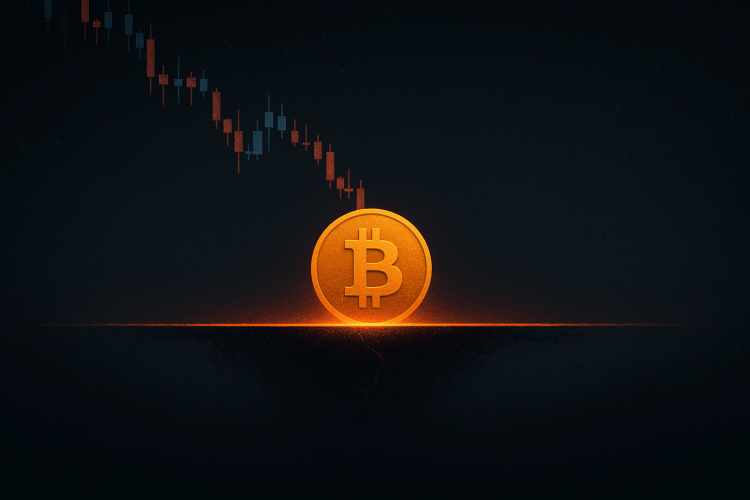
Shiba Inu’s effort to grow beyond being a meme coin is struggling. Its blockchain network, Shibarium, was created to bring real use and value to the project, but it has not gained much attention or activity. Developer interest and user engagement are very low, and the network’s overall growth has slowed down sharply.
Recent network issues, including technical troubles and security problems, have made things worse. Many users have left, and new projects are not joining. As a result, Shibarium now shows very little activity, leading many in the crypto community to call it a “ghost chain.”
Shiba Inu tried to change its image from a simple meme coin into a real blockchain project capable of competing with other networks. The team launched Shibarium, a layer-2 blockchain, in 2023 to help make this move. However, this plan has not worked as expected, with Shibarium failing to attract developers, projects, or users and gaining no market share.
According to data from DeFi Llama, Shibarium has only 18 developers since it began. It is a much lower number than on other blockchains, which have hundreds or even thousands of active developers. The total value locked (TVL) on the network, which shows how much money people have invested in it, has fallen to just $878,000.

Shibarium has also failed to attract any stablecoins, which are among the most widely used tokens in decentralized finance. Not a single stablecoin project has deployed on the network, reflecting Shibarium’s lack of presence in one of the most critical areas of the crypto world. Other newer and more active layer-2 networks like Base, Arbitrum, Plasma, and Linea have already moved far ahead, leaving Shibarium behind.
Things got worse for the network when ShibaSwap, the most popular decentralized app (dApp) on the Shibarium network, was recently compromised. The attack eroded user confidence and forced developers to pause a key bridge connecting Shibarium to other networks. Even with the bridge now active, most of the network’s activity stopped. Many users could not move their tokens or use apps, making the network almost entirely silent.
Because of this drop in network activity, Shibarium is no longer helping burn SHIB tokens. Typically, a portion of network transaction fees goes toward buying and burning Shiba Inu tokens, helping reduce supply and support the token’s price. But now, with very few transactions, the burn process has slowed down significantly.
The decline in users, developers, and activity are indicators that Shibarium’s dream of becoming a strong, useful blockchain has not come to fruition. Instead of growing into a central crypto platform, it has become what some would call the real ghost chain.

A fresh wave of bullish optimism has swept across the meme coin community as technical analysts point to a potential explosive rally that could propel the PEPE price by more than 1,500%. This massive surge could see the meme coin breakout toward a new all-time high of $0.00012 by early 2026.
An analyst from Wins, a cryptocurrency trading school, has projected on X social media a 1,500% move in the PEPE price, forecasting a potential rally toward $0.00012. According to the chart, this bullish target aligns with a projected increase in market capitalization from $2.89 billion to $48 billion. The analysis highlights a Fibonacci Extension setup with a 2.618 target positioned near the $0.00012 level.
The chart analysis also reveals that PEPE is consolidating within a descending wedge pattern, suggesting a strong bullish reversal once a breakout occurs. Currently, the meme coin is trading around $0.0000068, corresponding with a forecasted surge in market cap to $3 billion.

The analyst has identified the current price range, visualized by the green accumulation box, as the final buying opportunity before the next leg upward. The pattern mirrors PEPE’s previous accumulation and breakout phase from late 2023 to early 2024, where a similar descending wedge formed before a significant price surge.
Fibonacci retracements and extensions on the chart suggest that once PEPE clears resistance near $0.000015 and sees its market cap increase to $6 billion, momentum could accelerate toward $0.000035 and eventually reach the final target at $0.00012. The analyst has set the timeline for PEPE to achieve this target around January 12, 2026.
Sharing similar bullish sentiments for PEPE’s price outlook, crypto analyst Chandler wrote on X that “no one is ready for what’s coming for PEPE.” He shared a technical analysis projecting a massive rally for PEPE based on historical trends to support his bold statement.
The comparative chart analysis overlays two distinct timeframes from September 2023 to February 2024 and September 2023 to October 2025. The chart shows repeating cyclical structures, marked by colored circles representing accumulation, breakout, correction, and consolidation phases.
In 2023 – 2024, these patterns preceded a major upward move that took the PEPE price to a new all-time high, from $0.0000009 to $0.0000035, representing a staggering 288% increase. Chandler’s current projection suggests the meme coin is completing a similar sequence, with the blue-circled region around $0.00000728 marking a potential bottom before a powerful surge. The analyst’s forecast maps out a sharp rise to $0.000015 first, followed by a slight drop before an explosive rally above $0.00035, marking a staggering 4,708% gain from the bottom level.

This article was first published on The Bit Journal: What’s inside the plan for the ECB digital Euro, and will the project overcome existing legal obstacles?
The European Central Bank (ECB) will reportedly launch the ECB digital Euro sometime in 2029 if it succeeds in hammering out existing legal and logistical challenges. Officials working on the proposed central bank digital currency (CBDC) are currently laying the groundwork for the launch of the phase, which will conclude at the end of October 2025.
According to a Bloomberg report citing people close to the matter, officials at the European Central Bank are reviewing preparatory activities for the current phase of the ECB Digital Euro project as it nears its end. The ECB began its formal preparations for the proposed central bank digital currency in 2023, following an initial study that took 2 years.
Should the new CBDC project proceed to maturity, experts fear a new attempt to restrict financial freedom within the EU. The ECB Digital Euro initiative extends beyond simply updating existing payment systems. Pundits believe there is an underlying political objective to reduce reliance on non-European financial networks and private cryptocurrencies.
At the moment, the plan faces legal challenges, as national governments and the European Parliament have yet to agree on rules governing the issuance of the ECB Digital Euro. There’s fear among proponents of the central bank digital currency project that the European People’s Party’s preference for private firms to have a role may have slowed the legislative process.
This comes as policymakers express concern about the heavy reliance on US-based payment providers such as PayPal, Visa, and Mastercard, amid pressure to reduce dependence on foreign networks for daily retail payments. There are also concerns about the growth of dollar-backed stablecoins, including those supported by leading US political figures.
Most European Central Banks and regulators believe the potential spread of stablecoins could threaten regional payment autonomy and the proposed ECB Digital Euro. Officials at the European Central Bank argue that a central bank digital currency would offer users a publicly governed alternative for retail transactions, preserving the legal tender status of banknotes and coins.
While the European Central Bank has set a 2029 launch target for its proposed Digital Euro, the project faces several legal and logistical challenges. ECCB Executive Board Member Piero Cipollone had previously suggested mid-2029 as a realistic timeline, in line with current projections.
Still, progress in aligning legal frameworks remains the key indicator of whether the 2029 launch date target will be feasible. Additionally, the European Commercial Bank is still working on the details of a wholesale CBDC after approving the settlement of distributed ledger technology transactions using central bank money.
CBDC: A digital form of a country’s fiat currency that is a direct liability of the central bank, which could be used for payments and complements physical cash rather than replacing it.
Digital Euro: A proposed digital form of central bank money issued and backed by the European Central Bank (similar to physical euro banknotes and coins).
ECB: European Central Bank, which is the central bank for the euro and the monetary authority for the Eurozone countries.
This is a proposed digital form of central bank money, specifically, the euro, that could be used by the general public in much the same way as cash, but in virtual form.
It has not yet been decided whether and when the digital euro will be introduced, but the ECB has given a 2029 target launch date.
The digital euro could be used in all manner of payment scenarios, including at the point of sale or online checkout, and offline in combination with payment cards.
The digital euro would be stored in an electronic wallet set up with your bank or a public intermediary. They would allow users to make all their usual electronic payments – in their local store, online, or to a friend – with their phone or card, online and offline.
Read More: Will the ECB Digital Euro Plan to Reduce Reliance on US Payment Systems Succeed?">Will the ECB Digital Euro Plan to Reduce Reliance on US Payment Systems Succeed?


Updated on 30th October, 2025
Investors seem to be refocusing on infrastructure tokens as 2025 slowly fizzles out. Amid the happenings in the crypto space, ranging from ETF approvals to US-China trade discussions, Fed rate cuts, and regulatory winds, Chainlink price prediction for November 2025 is getting attention.
Being a leading decentralized oracle network, Chainlink (LINK) sits at the intersection of DeFi, real-world assets (RWA) and institutional blockchain services.
Chainlink (LINK) is the industry-standard oracle platform that allows smart contracts to securely access real-world data, off-chain APIs and external systems. The network powers major DeFi platforms, tokenized assets and high-volume financial data feeds.
Chainlink recently announced integration with Intercontinental Exchange to bring forex and precious-metals data on-chain. $LINK’s token functions include staking, node operator rewards and ecosystem governance. Its price is influenced by adoption of oracles, tokenomics (staked supply, inflation), market sentiment and macro-factors.
| Metric | Value |
| Circulating Supply | 696.85 million LINK |
| Maximum Supply | 1.00 billion LINK |
| Market Capitalization | $12.5 billion USD |
| Fully Diluted Valuation (FDV) | $17.9 billion USD |
| Supply Inflation Rate (Annual) | 11.17% |
| Role | Oracle / data-feed network for DeFi & RWA |
| Key Functionality | Decentralized oracle network, connects on-chain + off-chain data |
Chainlink was recently ranked the top project on Santiment’s RWA-development rankings, with institutional momentum building.
Chainlink also launched a native real-time oracle on MegaETH, sub-millisecond data for DeFi apps.
The Hong Kong Monetary Authority (HKMA) revealed in its e-HKD Phase 2 report that Chainlink’s Cross-Chain Interoperability Protocol (CCIP) was used to facilitate secure, cross-chain settlements for tokenized assets.
Just recently, Virtune, a Swedish-regulated digital asset manager, announced integration of Chainlink Proof of Reserve across its Exchange Traded Products (ETPs). Virtune is now one of the largest institutional adopters of Chainlink’s verifiable data standard to date, increasing transparency and investor trust across crypto-backed products.
Streamex Corp. has also partnered with Chainlink to be its official oracle provider. The company is converting its institutional-grade, gold-backed stablecoin GLDY into a Cross-Chain Token (CCT) powered by Chainlink CCIP, allowing secure transfers across Base and Solana.
These partnerships expand Chainlink’s enterprise presence and boost Chainlink price prediction November as adoption grows across traditional and DeFi.That’s more institutional adoption.
Chainlink price prediction for November 2025, is pegged at an average of $24.00 under the assumption that moderate adoption and stable crypto market conditions are around the corner.
If things go really well and adoption of RWA accelerates along with a general crypto market upswing , $LINK could theoretically touch $30 or possibly even $32.
On the other hand, if a bear market scenario with weak demand or regulatory headwinds surfaces, then $LINK might struggle to get much above $20.
On the technical front, If there’s a sustained break above $19 with decent volume, that would likely be a sign to get bullish for the shorter to medium term and try to push through to the mid-$20s. If it holds onto the $17.6-$18.3 support zone; then the market could be looking at sliding back down to lower consolidation levels.
Based on recent data and analysis; here is a forecast table for $LINK in November 2025:
| Period | Low Estimate (USD) | Average Estimate (USD) | High Estimate (USD) |
| Nov 2025 | $19.71 | $24.00 | $31.96 |
Experts are split on what’s likely to happen to $LINK, with some projecting it’s set for some serious upside and others being cautious.
TradingView experts who reckon that $LINK could reach as high as $50-$100 by the end of 2025 due to rising institutional adoption.
Meanwhile, LongForecast is estimating an average price of $42.47 for Nov. 2025, while DigitalCoinPrice has a minimum of $15.80 for the same month.
| Source | Year | Low (USD) | Avg (USD) | High (USD) |
| Changelly | 2025 | $19.71 | $19.68 | $22.16 |
| LongForecast | Nov 2025 | $39.36 | $42.47 | $45.28 |
| DigitalCoinPrice | 2025 | $15.80 | $26.07 | $37.49 |
| TradingView | 2025 | $50 | – | $100 |
| InvestingHaven | 2025 | $12.31 | – | $39.21 |
In the Bull Case, with strong RWA flows and good macro, $LINK could go to $30-$32+ in November as demand and staking increase.
In the Base Case, $LINK trades in the $22-$26 range, with moderate growth and improving fundamentals.
In the Bear Case; weaker adoption or market headwinds could keep $LINK around $17-$20.
Chainlink has established itself as the infrastructure layer that connects blockchains with real-world data. Its clients include DeFi protocols, tokenized asset platforms, and institutional enterprises. With Tokenized Realty, commodity data feeds and DeFi derivatives relying on oracles, LINK’s utility is huge.
As the economy further digitizes, Chainlink’s integration with TradFi and global financial systems makes the case for a bullish Chainlink price prediction November 2025 stronger.
The range of expert forecasts from $15 to $100 by 2025 shows the variance in scenarios and how important ecosystem developments, macro factors and supply dynamics are. Market observers should watch staking trends, node growth, partnerships, and regulatory clarity for signals on which way Chainlink will go.
Oracle Network: A service that connects blockchains to external real-world data feeds; Chainlink is a major oracle network.
Real-World Assets (RWA): Tokens representing physical or financial assets (e.g. bonds, real estate); on blockchain.
Token Staking: Locking tokens to secure a protocol and receive rewards; reduces supply.
Token Unlock: Scheduled release of previously locked tokens into circulation, increases supply.
Macro-Crypto Market Sentiment: The overall climate in cryptocurrency markets is driven by regulation, economy, and institutions.
LINK’s price is driven by network utility (oracle demand), token supply and staking levels; macro-crypto market sentiment and major partnerships.
Some analysts say $50-$100 is possible, but that’s very bullish and depends on strong adoption and good market conditions.
Regulatory setbacks, weak institutional adoption, competition in the oracle space, and token unlocks are increasing supply.
Higher staking locks supply and secures the network and revenue for node operators, which supports price.
Crypto cycles, interest-rate decisions, inflation, and regulation affect investor sentiment and hence $LINK’s price.
Read More: Chainlink Price Prediction November 2025: Can LINK Hit $30 This Month?">Chainlink Price Prediction November 2025: Can LINK Hit $30 This Month?


Updated on 30th October, 2025
Bitcoin price prediction has become a key topic again as Michael Saylor and Robert Kiyosaki renew their trust in the strength of $BTC. Their outlook comes at a time when the crypto market is showing both caution and curiosity.
They believe Bitcoin is entering another important phase that could shape its future path. Both continue to express strong faith in its lasting value and global relevance.
Michael Saylor, Executive Chairman of MicroStrategy, and Robert Kiyosaki, author of Rich Dad Poor Dad, are both strong voices for Bitcoin as a safeguard against inflation and a trusted store of value. Saylor has led MicroStrategy to hold a massive amount of Bitcoin through steady accumulation over the years.
Kiyosaki, on the other hand, teaches people to focus on real assets and long term financial growth. Their shared belief in $BTC continues to inspire optimism in the Bitcoin price prediction discussion.
Both Saylor and Kiyosaki believe the coming year could redefine Bitcoin’s market standing. Saylor expects the coin to reach about $150,000 by the end of 2025, while Kiyosaki believes it could climb toward $200,000 during the same time.
Their Bitcoin price prediction comes from long experience and deep observation of market trends. They view the recent slowdown as a normal phase before another strong push supported by growing investor confidence.
Speaking in an interview with CNBC, Michael Saylor said that Bitcoin’s growth cycle is still on track. He explained that the maturing market and lower volatility are giving investors more confidence in the asset.
His Bitcoin price prediction of $150,000 by the end of 2025 is backed by MicroStrategy’s steady accumulation of Bitcoin. The company recently added 390 BTC worth about $43.4 million,and Saylor believes the coin could keep rising by around 30% each year, potentially reaching $20 million over the long term.
| Metric | Value / Forecast |
|---|---|
| 2025 Price Prediction Range | $125,000 and $200,000 |
| Michael Saylor’s Prediction | $150,000 by end of 2025 |
| Robert Kiyosaki’s Prediction | $200,000 by end of 2025 |
| Market Cap (Oct 2025) | $2.19 trillion |
| Institutional Accumulation | Continuing |
| Investor Sentiment | Bullish/Neutral |
| Potential Long Term Growth | Up to $20 million (very long term) |
Robert Kiyosaki shares Michael Saylor’s optimism but aims even higher in his outlook. Speaking on X, he said he holds millions in Bitcoin and expects $BTC to reach $200,000 before the year ends.
He urged investors to control their emotions, saying fear often blocks success. Kiyosaki noted that patience during market swings can lead to better results. His view added strength to the bullish Bitcoin price prediction shared by other supporters.
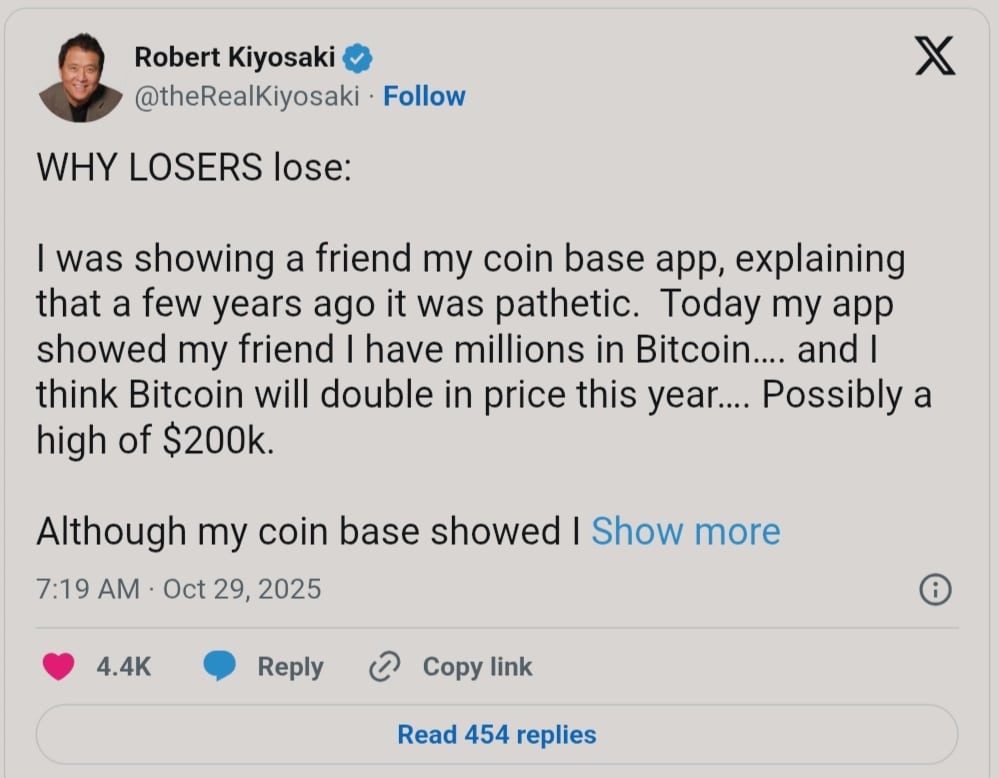
Experts say the recent change in Bitcoin is just a short break in its growth and not a sign that it is losing strength. Many point to signs of steady accumulation and continued interest from large investors.
On chain activity also shows that participation in the network is still increasing. In this setting, Bitcoin price prediction models suggest the possibility of renewed growth and stronger momentum ahead.
Analysts think Michael Saylor’s use of research and Robert Kiyosaki’s insight into investor habits together show a confident view of where Bitcoin is heading. Their optimism reflects a wider belief that clearer regulations and continued support from large investors are making the market stronger.
Even though MicroStrategy’s stock has fallen recently, confidence in its Bitcoin holdings remains firm. This continued belief supports fresh Bitcoin price prediction reports that point to further growth through 2025.
Bitcoin price prediction suggests that the coin remains strong and steady even after the recent ups and downs. The similar outlook of corporate leaders and everyday investors shows that trust in digital assets is growing around the world.
Both Michael Saylor and Robert Kiyosaki believe that the latest pullback is only a pause before a possible big rise ahead. They believe that short periods of decline usually come before growth returns to the market.
Their Bitcoin price prediction of $150,000 to $200,000 by 2025 has encouraged many investors to feel hopeful again about Bitcoin’s future. If their expectations prove right, $BTC could be moving into one of the most defining and exciting stages of its journey.
Store of Value: An asset that keeps its worth over time, like Bitcoin or gold.
Liquidation: When traders sell assets during a market drop.
Michael Saylor: Head of MicroStrategy and a strong Bitcoin supporter.
Inflation Hedge: An investment that protects money as prices increase.
MicroStrategy: A firm led by Michael Saylor known for its big Bitcoin holdings.
What is the Bitcoin price prediction for 2025?
Experts predict Bitcoin could reach $150,000 to $200,000 by 2025.
Why do Saylor and Kiyosaki trust Bitcoin?
Experts trust Bitcoin as they see Bitcoin as a safe hedge against inflation and economic risk.
Did Bitcoin face any challenges recently?
Yes, Bitcoin faced a $19 billion liquidation event in October 2025.
What does Saylor expect for Bitcoin in 2025?
He expects Bitcoin to reach around $150,000 by the end of 2025.
Will Bitcoin reach a new high by 2025?
Both experts believe Bitcoin will set a new all time high soon.
Read More: Bitcoin Price Prediction: How Saylor and Kiyosaki See BTC Surging to $200K">Bitcoin Price Prediction: How Saylor and Kiyosaki See BTC Surging to $200K




Top 4 Coins of 2025: BlockDAG, Sui, XRP, & Solana Compete for Trader Attention
October has brought strong movement across the market, with several coins gaining more attention than others. People interested in investing in crypto are focusing on the top performers showing consistent strength and long-term reliability. Each project in this list highlights real progress, whether it’s record-breaking funding, technical milestones, or a stronger global presence.
This review looks closely at four leading names: BlockDAG, Sui, XRP, and Solana. Each has shown clear growth and trust among users. From a nearly $435M presale to established networks achieving solid traction, these projects mark the key stories shaping the current market.
BlockDAG (BDAG) has earned its spot among the top crypto performers of 2025 through one of the largest presales seen in years, collecting nearly $435 million across 31 batches. Over 312,000 holders have joined early, buying 27.2 billion BDAG coins before the mainnet release. The presale price stands at $0.0015 with the TGE code, while the expected launch price is $0.05. This difference hints at an impressive 3,200% potential rise, drawing strong attention from people trading in crypto.
BlockDAG’s structure solves the well-known “Blockchain Trilemma” by blending Bitcoin-level Proof-of-Work safety with DAG-based parallel processing. This mix allows up to 15,000 transactions each second, a balance that most networks struggle to achieve. With full EVM support and its live Awakening Testnet, developers can easily deploy decentralized apps that scale efficiently.
The platform has passed trusted CertiK and Halborn audits, adding to its credibility. Under CEO Antony Turner and advisor Dr. Maurice Herlihy, BlockDAG (BDAG) shows clear technical direction and leadership transparency.
Its collaboration with the BWT Alpine F1® Team boosts its name globally, giving the project real-world exposure. For anyone focused on trading in crypto, BlockDAG offers not only a functional network but also verified progress and strong community backing. Its mix of tested technology, open leadership, and growing user trust makes it one of the strongest stories of 2025.
Sui (SUI) has maintained a steady position at $2.46, showing firm strength despite market swings. Experts see solid support around $2.38, showing that many users continue to accumulate the coin. With 12% volatility and a $9 billion market cap, Sui remains one of the more stable new-generation blockchains among the top performers.
Sui’s technical base supports parallel transactions and low-latency features, attracting developers in DeFi and gaming. Its EVM compatibility and expanding ecosystem have resulted in a steady rise in wallet activity.

Short-term predictions suggest possible movement toward $3.40–$3.50 if trading activity stays strong. Still, its long-term position depends on keeping developer support and managing supply releases. For now, Sui continues to stand as a performance-driven blockchain with steady momentum.
XRP continues to hold its place among the top performers, trading near $2.44 with consistent volume. Exchange data shows reserves down by roughly 3.3%, a signal of accumulation. This has been viewed positively by analysts who see ongoing trust from major market players.
Ripple’s network continues to expand through projects like Evernorth, which plans to raise $1 billion to add XRP to its treasury portfolio. The Flare Network bridge now connects millions of XRP to DeFi platforms, strengthening the coin’s practical use. With clearer regulations and broader adoption, XRP’s real-world utility and compliance progress help it keep a stable market presence.
Solana (SOL) keeps showing solid performance, trading around $192.15 with a market cap of about $106 billion. The coin has been consolidating below the $200 mark, and many experts believe a move above this could signal the next upward phase. The addition of Solana to Fidelity Investments’ crypto range this month shows growing trust from major institutions.
On-chain activity is increasing, with new addresses and transaction volumes hitting record numbers. Solana’s price compression between $175 and $195 shows possible movement toward $230 or more if momentum continues. While the network must still improve decentralization and speed consistency, its mix of high throughput and market confidence keeps it in the spotlight.
All four coins, BlockDAG, Sui, XRP, and Solana, show unique value, but BlockDAG’s combination of massive presale success, hybrid system, and trusted audits puts it ahead. Sui highlights fast transaction design, XRP connects traditional finance to blockchain, and Solana continues to attract global attention through active development.
Still, BlockDAG’s early achievements and growing reach make it stand apart. Its audited system, functioning testnet, and 312,000+ supporters reflect both readiness and credibility. For people involved in crypto who look for both promise and proof, BlockDAG represents 2025’s strongest example of growth through real results.
Disclosure: This is a sponsored press release. Please do your research before buying any cryptocurrency or investing in any projects. Read the full disclosure here.
The post Top 4 Coins of 2025: BlockDAG, Sui, XRP, & Solana Compete for Trader Attention appeared first on The Merkle News.
Jiuzi Holdings, Inc. (NASDAQ: JZXN) has unveiled a sweeping $1 billion Bitcoin finance initiative through a strategic partnership with SOLV Foundation, a decentralised finance (DeFi) platform managing more than $2.8 billion in total value locked.
The move positions Jiuzi as one of the few Nasdaq-listed firms actively bridging traditional finance (TradFi) with DeFi to create compliant, yield-generating Bitcoin products for institutional investors.
The partnership will see Jiuzi allocate up to $1 billion from its digital asset plan into Bitcoin staking and yield-focused blockchain products.
Central to the strategy is a commitment of up to 10,000 Bitcoin to SOLV’s flagship SolvBTC.BNB vault on the BNB Chain — one of the largest Bitcoin yield platforms in the ecosystem.
The assets will be safeguarded by regulated third-party custodians and verified through Chainlink’s proof-of-reserves auditing system, ensuring transparency and institutional-grade security.
This marks a pivotal moment for Jiuzi Holdings, which is best known for its new energy vehicle infrastructure business in China.
The company has been steadily diversifying into blockchain finance, and its partnership with SOLV Foundation signals a deepened commitment to positioning Bitcoin as a productive, yield-bearing asset rather than a passive store of value.
Jiuzi and SOLV have emphasised that the partnership will operate under strict compliance with US Securities and Exchange Commission (SEC) regulations and Nasdaq listing standards.
The collaboration will establish a joint Steering Committee composed of senior representatives from both organisations.
This committee will develop and oversee Bitcoin-centric DeFi initiatives, including expanding the adoption of SolvBTC across additional blockchain networks such as Solana and Base.
By combining Jiuzi’s regulatory standing and institutional access with SOLV’s on-chain expertise, the partnership aims to create a secure, transparent, and scalable financial framework for Bitcoin-based products.
Both companies view the collaboration as a model for how regulated capital can participate safely in decentralised yield markets.
Beyond its yield products, Jiuzi will anchor its corporate treasury around Bitcoin as its primary digital asset.
The firm’s Bitcoin holdings, including those of its subsidiaries, will be deposited on SOLV’s platform and managed under the supervision of approved custodians.
This approach is designed to maximise capital efficiency while maintaining visibility and accountability through blockchain-based auditing tools.
Li Tao, Chief Executive Officer of Jiuzi Holdings, described the partnership as “a transformative step forward” that strengthens the company’s Bitcoin vault strategy and aligns it with one of the most advanced ecosystems for Bitcoin liquidity and staking.
SOLV Protocol co-founder Ryan Chow added that the partnership merges Jiuzi’s regulatory stature with SOLV’s expertise in managing large-scale Bitcoin assets, paving the way for secure institutional capital flow into DeFi.
Notably, the news of the partnership sparked a sharp rally in Jiuzi’s stock, with shares surging more than 22% in trading following the announcement.
Investors responded positively to the company’s expansion into digital asset finance, recognising the potential for Jiuzi to play a pivotal role in institutional Bitcoin adoption.
The post Jiuzi Holdings taps SOLV Foundation for its $1B Bitcoin investment plan appeared first on CoinJournal.

Garden Finance has become the latest target of a major crypto heist, with hackers siphoning off at least $5.5 million across several blockchains.
The cross-chain bridge exploit has not only rattled investors but also reignited concerns about the security of decentralised finance (DeFi) infrastructure.
The attack on Garden Finance unfolded swiftly, draining millions in assets from multiple blockchains, including Arbitrum and Solana.
On-chain researcher ZachXBT was the first to identify the unauthorised withdrawals, noting that the losses could ultimately exceed $10 million once all affected chains are accounted for.
According to early reports, the attacker used the MetaMask router, a fast but costly swap tool, to immediately convert stolen tokens, which included wrapped ETH (wETH), wrapped Bitcoin (WBTC), Lombard-locked BTC, cbBTC, and SEED, Garden’s native token, to Ethereum (ETH).
🚨ALERT🚨Our system detected that @gardenfi has been hacked ~$6M across multiple chains.
Most of the stolen funds are in $WBTC, $USDC, $USDT and other digital assets.
However, most of the freezable assets are swapped to $ETH.
Team sent on-chain message to hacker offering 10%… pic.twitter.com/76YbG6aPK7— 🚨 Cyvers Alerts 🚨 (@CyversAlerts) October 30, 2025
The move prevented freezing or recovery efforts, as the assets were instantly dispersed through decentralised exchanges.
Garden Finance later confirmed the breach in an on-chain message, stating that its systems had been compromised across multiple networks.
The team offered a 10% white hat bounty to the hacker in exchange for returning the funds and disclosing the vulnerability.
But despite the offer, the attacker has not yet responded.
Investigations led by ZachXBT and other blockchain analysts suggest that the DPRK-affiliated hacker collective “Dangerous Password” could be behind the exploit.
This group has been tied to several recent cross-chain incidents targeting smaller protocols with liquid, fast-swappable assets.
Just days before the Garden breach, ZachXBT accused the protocol of enabling money laundering, claiming that up to 25% of its total fund transfers were connected to previously stolen assets from the Bybit and Swissborg hacks.
Another security researcher, Tayvano, alleged that North Korean hackers had been using Garden’s bridge extensively to move illicit funds.
These findings have cast a shadow over the platform’s recent success.
Earlier this month, Garden Finance proudly announced it had bridged over $2 billion in tokens, but the revelation that a quarter of its traffic may have originated from illicit sources has severely damaged its reputation.
Interestingly, today’s incident carries a note of irony. Garden Finance, once accused of facilitating laundering, has now fallen victim to the very type of attack it was criticised for enabling.
Observers have drawn parallels with THORChain, which was similarly accused of aiding North Korean hackers before being targeted itself.
ZachXBT highlighted this irony in his investigation, stating that the Garden team had profited “high six figures” in fees from illicit transfers but failed to assist victims in past cases.
The exploit, he argued, was a harsh reminder of the risks faced by protocols that neglect compliance and transparency.
With damages estimated between $5.5 million and $10.8 million, and the SEED token in free fall, Garden Finance faces a long road to recovery.
And whether the hacker accepts the 10% bounty or vanishes with the funds, the exploit highlights the urgent need for stronger bridge security, real-time monitoring, and better cooperation between developers and blockchain investigators.
The fallout was immediate. As the hacker dumped stolen SEED tokens into illiquid pools on Uniswap, the price crashed by 64%, plunging to $0.1928 and shrinking its market capitalisation to $2.5 million.
And although the token has slightly recovered to around $0.23, it remains down 57% from yesterday’s close price.

The thin liquidity made the sell-off particularly devastating, eroding investor confidence and intensifying scrutiny of the protocol’s risk controls.
The post Garden Finance exploit: over $5.5M stolen, 10% white hat bounty announced appeared first on CoinJournal.

Bybit, the world’s second-largest cryptocurrency exchange by trading volume, is suspending new user registrations in Japan starting October 31, 2025.
The move comes as the country’s Financial Services Agency (FSA) prepares to implement tighter regulations that could reclassify crypto assets as financial products.
The exchange said the suspension is part of its “proactive approach” to align with Japan’s evolving legal framework.
Bybit pauses onboarding of new Japanese users.
Beginning at 12 p.m. UTC on October 31, Bybit will halt the creation of new accounts for Japanese residents and nationals.
Existing users, however, will continue to have full access to all services for the time being.
In a statement, Bybit said it remains committed to operating “responsibly and in compliance with local laws and regulatory expectations.”
The company added that the pause will allow it to focus on reviewing local requirements and determining how to meet the new standards being drafted by the FSA.
This announcement comes amid growing scrutiny of global exchanges by Japanese regulators, who have been tightening oversight to protect investors and ensure transparency.
Japan’s Financial Services Agency is preparing sweeping changes that could reshape how crypto is regulated in the country.
Japan’s crypto market has grown rapidly, with more than 12 million registered accounts as of early 2025.
Despite this growth, the FSA remains cautious about retail investor exposure.
About 80% of domestic accounts hold less than ¥100,000 ($670), raising concerns about the risks faced by small investors relying on limited information.
In August, the FSA established a new “Crypto Assets and Innovation Division” to monitor the fast-evolving industry while promoting responsible innovation.
The FSA now plans to amend the Financial Instruments and Exchange Act (FIEA) in 2026, reclassifying cryptocurrencies from a “means of settlement” to “financial products.”
This shift would give regulators greater power to investigate and penalise insider trading and market manipulation in the crypto market.
A working group within the FSA is also drafting Japan’s first legal definition of insider trading in crypto, which could soon make it a punishable offence.
These developments mark a decisive step toward aligning Japan’s crypto oversight with that of its traditional securities markets.
At the same time, the FSA is considering allowing banks to hold cryptocurrencies such as Bitcoin for investment purposes.
If approved, this would reverse a 2020 restriction and open the door for banks to participate in crypto trading and custody services under strict risk and capital requirements.
Bybit’s suspension in Japan follows what has been one of the company’s most turbulent years.
In February 2025, the exchange suffered a $1.5 billion hack, one of the largest in the industry’s history, reportedly linked to North Korea’s Lazarus Group.
In the aftermath, Bybit intensified its compliance efforts, introducing monthly proof-of-reserve reports and expanding third-party audits to reassure users and regulators.
Independent auditor Hacken later confirmed that Bybit’s reserve ratio remained above 100% following the incident, easing customer concerns.
The exchange’s heightened transparency and regulatory cooperation mirror Japan’s broader expectations for crypto firms.
Bybit’s approach aligns with the FSA’s emphasis on accountability, financial soundness, and investor protection.
The post Bybit suspends new Japanese accounts ahead of stricter FSA rules appeared first on CoinJournal.

Uphold, a leading digital asset platform, has officially relaunched its highly anticipated debit card for customers in the United States, featuring generous rewards paid exclusively in XRP.
Ripple’s XRP is one of the most popular cryptocurrencies in the market, and continues to attract attention as the US becomes increasingly crypto-friendly.
In recent months, the return of the American market has seen several companies, including Robinhood and Bullish, make forays.
Crypto.com, Gemini, and Coinbase are among the exchanges to launch crypto rewards credit cards in the US.
Announced on Thursday, October 30, the relaunch revives a service discontinued in March 2023 due to regulatory hurdles.
The Uphold crypto rewards card is issued by Cross River Bank as a Visa debit card.
It enables US residents in eligible states to spend fiat, over 300 cryptocurrencies, stablecoins, or metals anywhere Visa is accepted, including via Apple Pay and Google Pay.
The Uphold Debit Card is now available across the U.S. 💳
Spend 300+ digital assets anywhere Visa is accepted, online or in-store.
Earn up to 6% in $XRP on everyday purchases.
No credit checks. No waiting.
Just your crypto, your card, your way. pic.twitter.com/gbMBzRpGOT
— Uphold (@UpholdInc) October 30, 2025
Per details, the premium Uphold Elite Card offers up to 6% XRP back on purchases, zero ATM or foreign transaction fees, and a metal physical card.
The no-fee Uphold Essential Card provides 4% XRP rewards with modest fees. Users activating before January 1, 2026, lock in these promotional rates for three months.
Direct deposit of paychecks unlocks an additional 4% in XRP, potentially totaling 10% back and up to $800 monthly in rewards.
This relaunch arrives at an important moment for XRP, and could help enhance the Ripple token’s real-world utility.
Encouraging spending and other activities will drive demand, with Uphold’s more than 10 million global users, a key market.
Notably, the card incentivizes holding and accumulation. This potentially means reduced sell pressure and is another XRP-focused campaign that could boost transaction volume on the XRP Ledger.
Furthermore, the relaunch positions XRP competitively against rivals like Coinbase, Gemini, and Crypto.com.
Coinbase’s Bitcoin-back card and Gemini’s Solana rewards have notable traction and Uphold’s reentry signals focus amid the broader trend of crypto rewards cards.
XRP adoption in cross-border payments is among the targets for the cryptocurrency.
But as Ripple looks to get flying following the hurdle it faced with the US Securities and Exchange Commission lawsuit, other initiatives are up and running.
The company launched Ripple USD (RLUSD), its flagship stablecoin in 2024. Integrations across the market are on the rise, including Uphold.
The firm is taking payments, lending, and remittances to more people, with acquisitions such as stablecoin platform Rail key.
Recently, it finalized its acquisition of Hidden Road, thereby becoming the first crypto company to own a global multi-asset prime broker.
The post Uphold relaunches XRP rewards debit card in the US with up to 10% back for users appeared first on CoinJournal.


With the end of October approaching, Senate Republicans are in danger of going back on their previously announced deadline for a significant cryptocurrency bill.

Bitcoin continued to drop to new lows on Thursday despite every bullish outcome that traders had forecast being confirmed.

Flutterwave partners with Polygon Labs to launch a stablecoin-powered cross-border payments network spanning 34 countries across Africa.

Senator Chris Murphy alleged corruption over the exchange “promoting Trump crypto” shortly after the US president issued a pardon for Binance founder Changpeng Zhao.

The Bitcoin mining industry is financing its expensive pivot to AI data centers with convertible debt that sometimes features a 0% coupon.

With retail access restored, crypto exchange-traded notes issuers slash fees to historic lows, signaling an intensifying battle for UK market dominance.

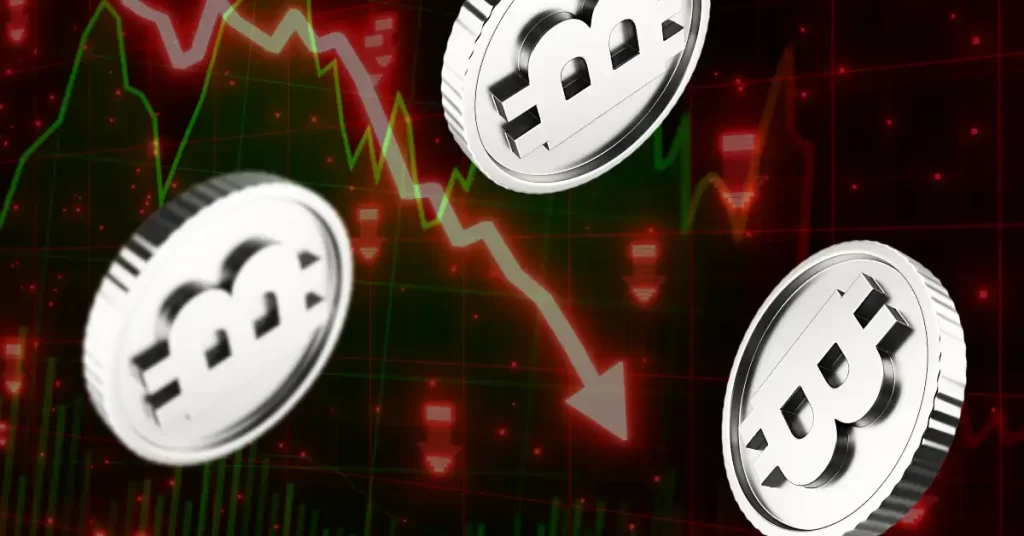
The post Bitcoin Price Drops Below $107k, Crypto Liquidations Tops $1.2B; Is Bull Market Over? appeared first on Coinpedia Fintech News
Bitcoin (BTC) has led the wider crypto market in a correction on Thursday, October 30. BTC price dropped 4% during the past 24 hours to reach a today’s range low of about $106,861 during the mid North American session.
The total crypto market cap dropped 5% during the last 24 hours to hover about $3.6 trillion at press time. The altcoin market was heavily impacted by today’s correction, led by Ethereum (ETH), Solana (SOL), Dogecoin (DOGE), Cardano (ADA), and XRP.
The wider crypto market experienced the impact of a long squeeze on Thursday after a heavy liquidation of long traders. According to market aggregate data from CoinGlass, out of the $1.24 billion liquidated from leveraged crypto trading, around $1.1 billion involved long traders.
The wider crypto market also recorded bearish sentiment on Thursday partially fueled by the sell-the-news impact. On Wednesday, the Federal Reserve initiated its second rate cut of 25 bps to between 3.75% and 4% as investors expected.
Additionally, the Fed announced that its Quantitative Easing (QE) will begin on December 1, 2025. However, the Fed noted that the December policy decision will be impacted by the ongoing government shutdown amid the political impasse in Washington DC.
As such, crypto traders have depicted mid-term fear of further market correction.
The crypto bull market is hanging on by an edge despite the end of tariff wars between the United States and China. From a technical analysis standpoint, BTC price must rebound from the current support level of around $107k to invalidate further correction.

According to market data analysis from Santiment, BTC price tends to record a relief rally every time the crowd shows heightened fear of capitulation.

The post XRP, Pepe, and DOGE Forecasts Heat Up, But Ozak AI Leads the Conversation appeared first on Coinpedia Fintech News
Crypto markets are heating up as bullish sentiment spreads across major altcoins and meme tokens. XRP, Pepe, and Dogecoin are three of the most talked-about properties right now, each representing a unique nook of the market—XRP with its application-driven power, Pepe with its explosive meme attraction, and DOGE because of the original retail hype engine.
Yet even with forecasts for these tokens climbing higher, a new name is rising fast: Ozak AI. With its early-stage pricing and powerful AI-driven foundation, Ozak AI is quickly becoming the breakout narrative leading whale conversations this cycle.
XRP is trading close to $2.65 and building a bullish technical shape. Resistance tiers are forming at $3.10, $4.20, and $5.00, even as support holds at $2.20, $1.90, and $1.60. These levels highlight XRP’s developing energy as adoption expands and regulatory clarity removes uncertainty.
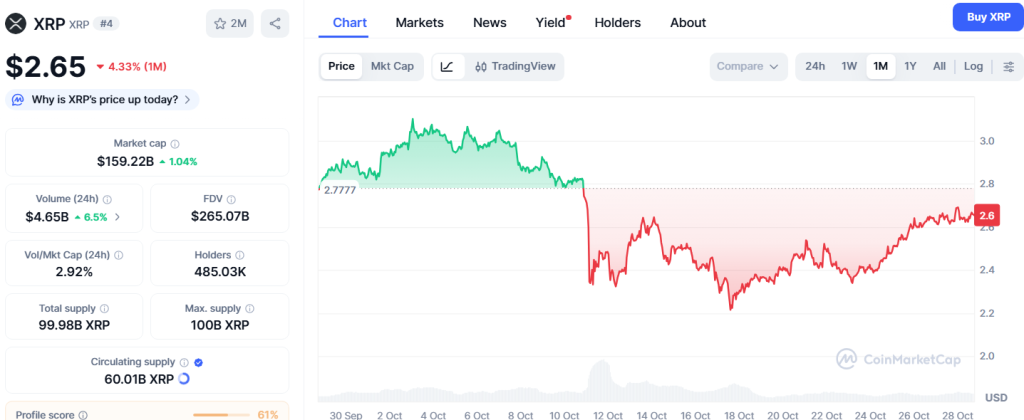
XRP remains a pinnacle preference for buyers who want publicity for an asset with real-world use cases in cross-border bills, making it one of the more stable and basically sound performers in the market.
Pepe
Pepe is trading around $0.000007186, with resistance at $0.000007950, $0.000008600, and $0.000009500, while support sits at $0.000006500, $0.000005800, and $0.000005200. Pepe has become one of the most dominant meme tokens this cycle, driven by viral hype and community enthusiasm.
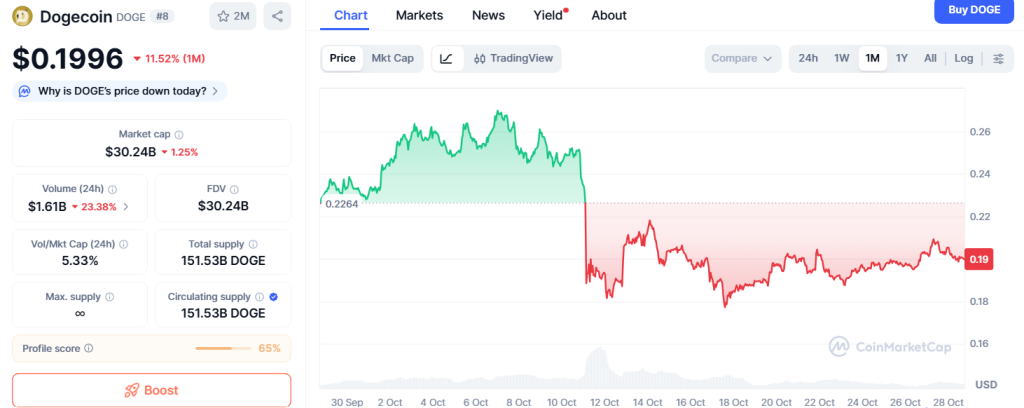
Meme tokens tend to perform best during retail-driven bull runs, and Pepe is perfectly positioned to ride that wave. A retail-fueled rally could push it to impressive multiples in the months ahead
Youtube embed:
Dogecoin continues to play a key role in shaping meme coin momentum. Known for its community strength, viral presence, and history of massive rallies, DOGE remains a favorite among retail traders. Its movements often act as a signal of meme coin mania heating up—a key indicator for the broader altcoin market.

While XRP, Pepe, and DOGE all have strong narratives, Ozak AI is the one asset catching whale attention for its 100x potential. Currently in its 6th OZ presale stage at $0.012, Ozak AI has raised over $4.2 million and sold more than 980 million tokens. Unlike meme tokens, it’s built on real AI-powered prediction agents designed to provide intelligent market insights, real-time trading signals, and automation tools—combining strong utility with perfect timing ahead of a bull run.
Ozak AI’s momentum is amplified by strategic partnerships with Perceptron Network, HIVE, and SINT. These collaborations enhance its data infrastructure, predictive capabilities, and integration across blockchain ecosystems. This gives Ozak AI a credible technological foundation—a rarity among presale tokens—making it particularly attractive to investors seeking early-stage entries with strong fundamentals.
XRP offers utility and stability, Pepe delivers meme-fueled momentum, and DOGE still drives retail hype—but Ozak AI offers something bigger: exponential upside from a low presale entry. As the bull market accelerates, the narrative is shifting from established tokens to early movers with massive potential. And in that conversation, Ozak AI isn’t just participating—it’s leading.
Ozak AI is a blockchain-based crypto project that offers a technology platform that specializes in predictive AI and advanced facts analytics for financial markets. Through machine learning algorithms and decentralized community technology, Ozak AI enables real-time, accurate, and actionable insights to help crypto enthusiasts and businesses make precise decisions.
For more, visit:
Website: https://ozak.ai/
Telegram: https://t.me/OzakAGI
Twitter: https://x.com/ozakagi
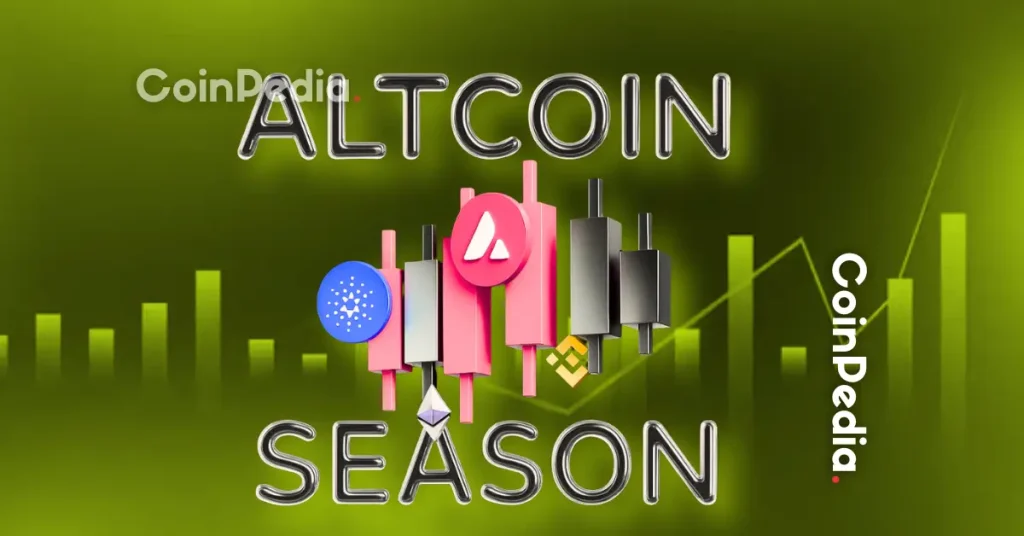
The post This Altcoin Is Approaching a New ATH—Could Be the Start of an Altseason? appeared first on Coinpedia Fintech News
The crypto markets have become extremely volatile in the past 24 to 48 hours, raising huge speculation surrounding popular cryptos. For the second consecutive day, Bitcoin price is losing ground during the American trading session and has gained strength with the beginning of the Asian trade. Amid this, the Memecore (M) price maintains a sustained upswing and is trying to breach a pivotal resistance. This level can be considered a pivotal one, as the next pit stop for the M price rally could be the current ATH, close to $3.
The Memecore price rose heavily by over 600% in September from the consolidated zone around $0.5. This move attracted significant attention from the investors, due to which the price has been consolidating above one of the important supports at $1.77. In times when the bearish influence over the markets is rising, technicals suggest that the Memecore price could eventually break above the current highs.
Although the bullish indicators dominate, the token’s extreme volatility warrants caution. This raises the question of whether the Memecore price can make it to $3 or above, or will profit-taking reverse the gains?
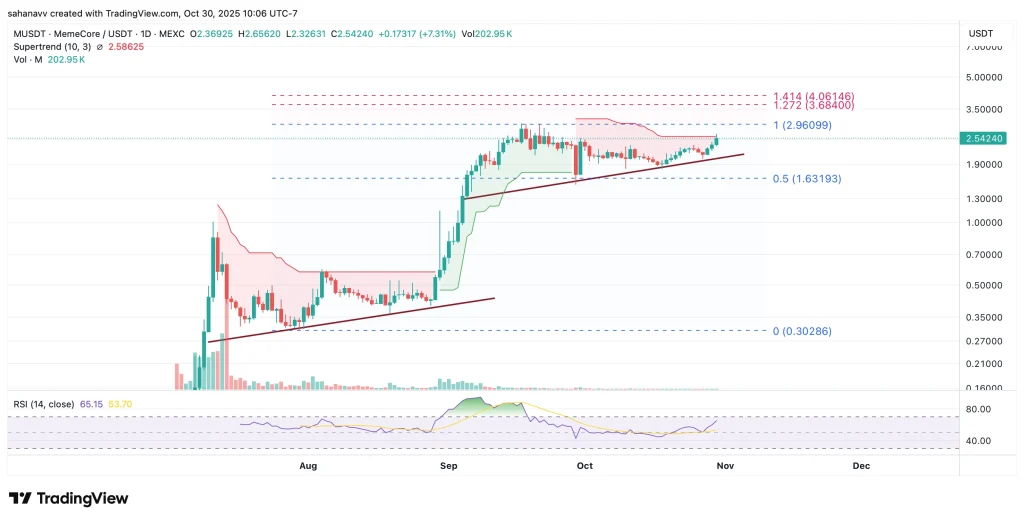
The Memecore price is about to begin with the 3rd bullish wave, as the token is showing signs of replicating a previous pattern. The price has rebounded from the ascending trend line for the third consecutive time. The token experienced over a 600% jump previously, and the current market dynamics suggest a similar upswing could be on the horizon. The RSI is displaying a parabolic recovery, and the price is about to breach the Supertrend line, which is currently bearish.
The price crossing the line implies that the token is undergoing a bullish switch that could strengthen the ongoing upswing. With this, the RSI may enter the overbought range, and the bullish momentum could accelerate, pushing the Memecore price to a new ATH. The first target could be $3.68 at 1.2 FIB and later $4.06 at 1.4. If the token secures above this range, then the bulls may trigger a strong upswing to new highs.
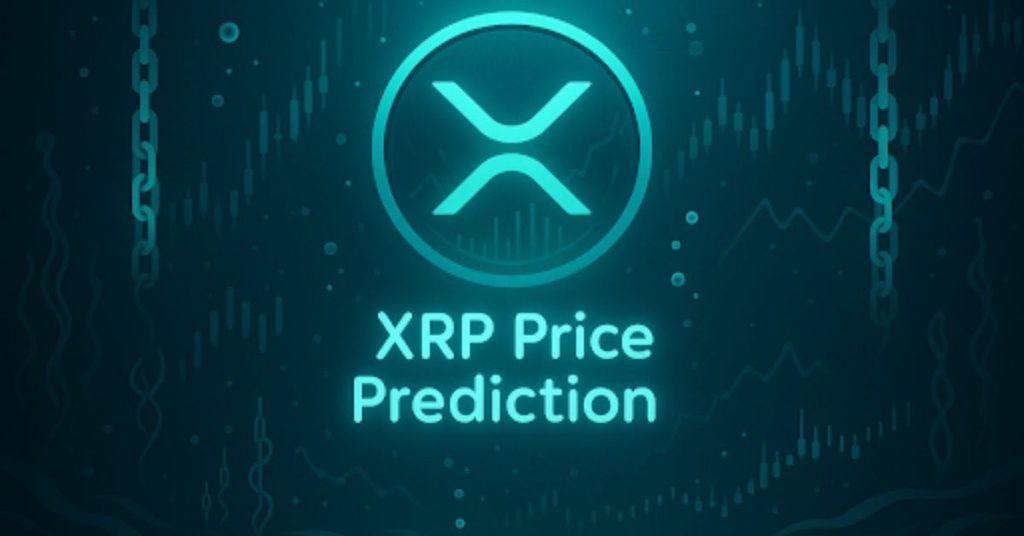
The post XRP Price Prediction: Expert Says Utility Could Push Price to $50,000 appeared first on Coinpedia Fintech News
XRP has spent most of 2025 trading near $3, holding steady while other assets move up and down. Banks are forming partnerships, institutions are buying XRP in large quantities, and Ripple continues expanding its network. Yet many investors are asking the same question: why isn’t the price moving?
According to market expert Jake Claver, this quiet period is not a sign of weakness but a setup for what he calls the calm before the storm. He believes that XRP’s next move could be driven not by hype or speculation but by real-world utility and massive institutional demand.
XRP’s market cap often sparks debate. Critics say it is too large to grow further, but that view confuses crypto networks with traditional companies. XRP is not a stock. It is a digital asset used to move value across the XRP Ledger. The network’s worth depends on how much money flows through it, not on corporate profits.
Claver compares it to the global email system. Billions of messages are sent daily, creating huge transactional volume. XRP’s value will follow a similar path as global payment systems adopt blockchain for cross-border settlement. This shift is slow but inevitable, and when it happens, XRP’s market cap will no longer be a limit. It will be a reflection of global liquidity needs.
While retail investors watch for big green candles, institutions accumulate quietly. They spread out purchases to avoid moving the price sharply. Many large financial players are preparing for XRP-based products and ETFs, meaning they need to hold significant reserves. That accumulation takes time and is often invisible to the average investor.
These quiet moves are setting the stage for a major supply shock. When banks and funds need XRP for settlement at scale, available supply on exchanges could dry up quickly, pushing prices upward.
Claver predicts XRP’s long-term value could be tied to a much larger opportunity: the tokenization of the global derivatives market. Over the next three to five years, he expects XRP to play a central role in this transformation.
The derivatives market is estimated to be worth between $400 trillion and $4 quadrillion, making it the largest financial system in existence. Ripple once developed a project called Codius, designed for smart contracts and potentially linked to XRP’s settlement layer. If XRP becomes the bridge asset for derivatives settlement, Claver says the token could reach prices between $10,000 and $50,000.
He explains that this would not be speculation but a result of pure utility. For XRP to process daily settlements worth trillions, it must hold a high and stable price. Such a role could position XRP as a tier-one risk-free asset similar to U.S. Treasuries, at the heart of global finance.










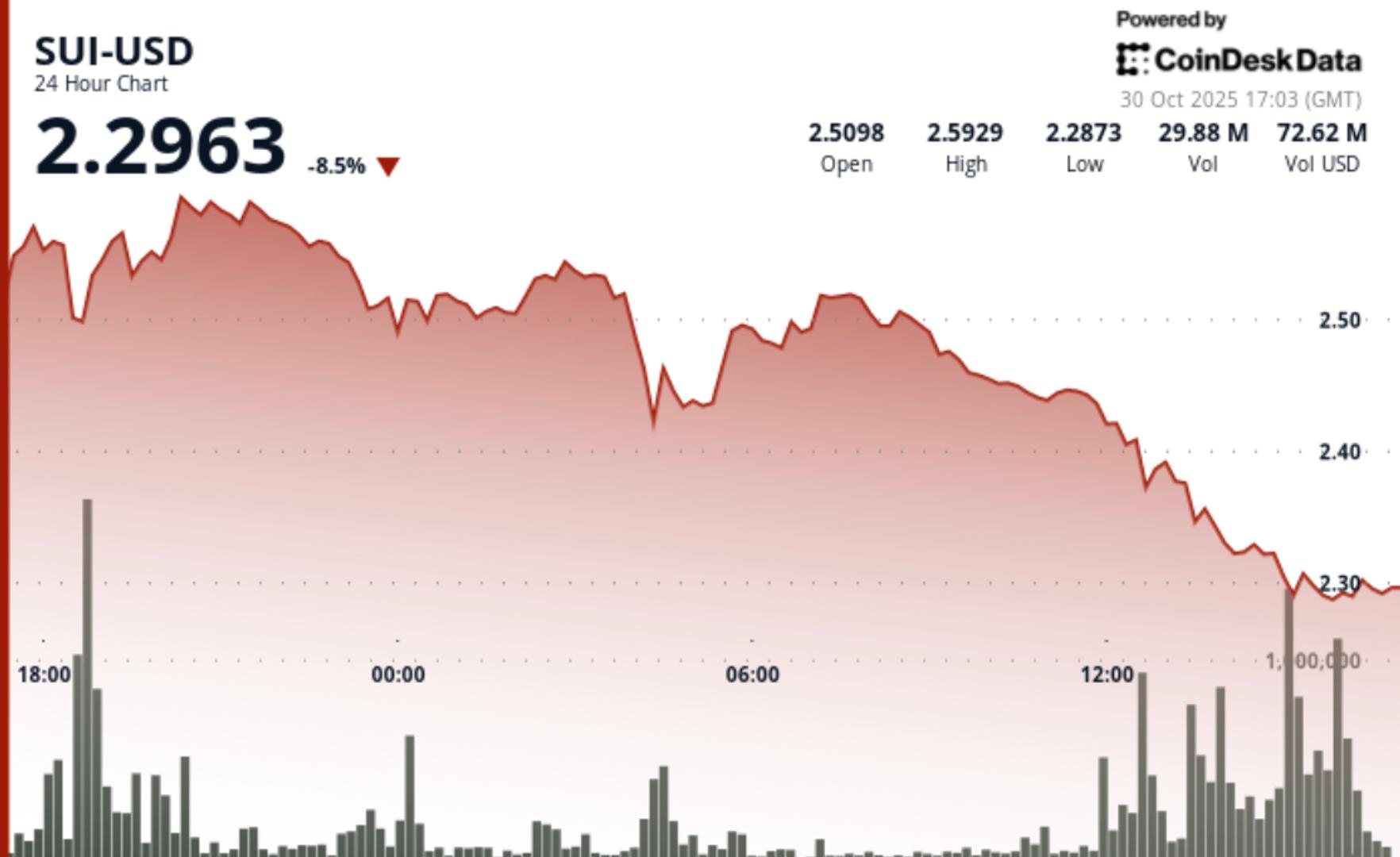
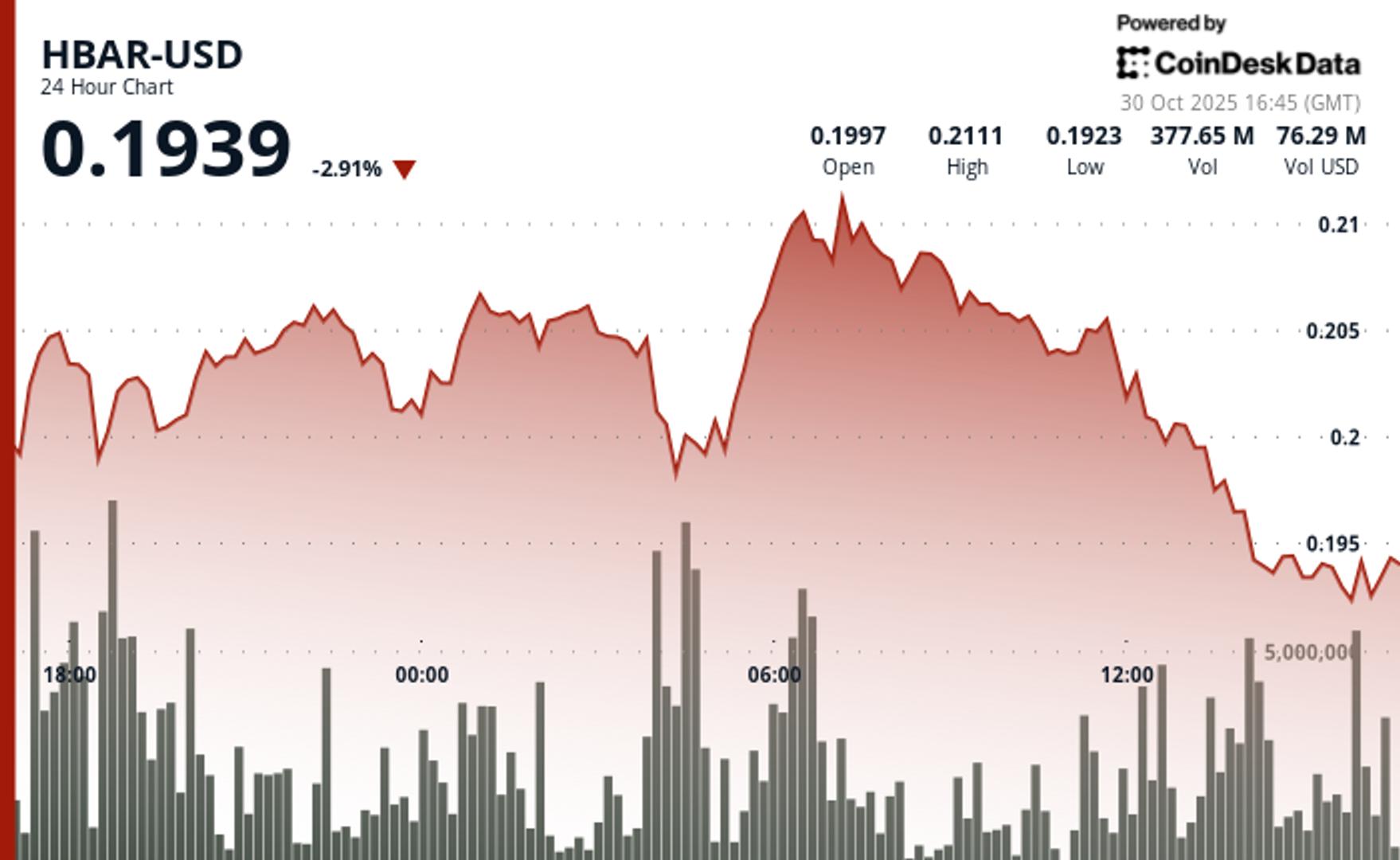

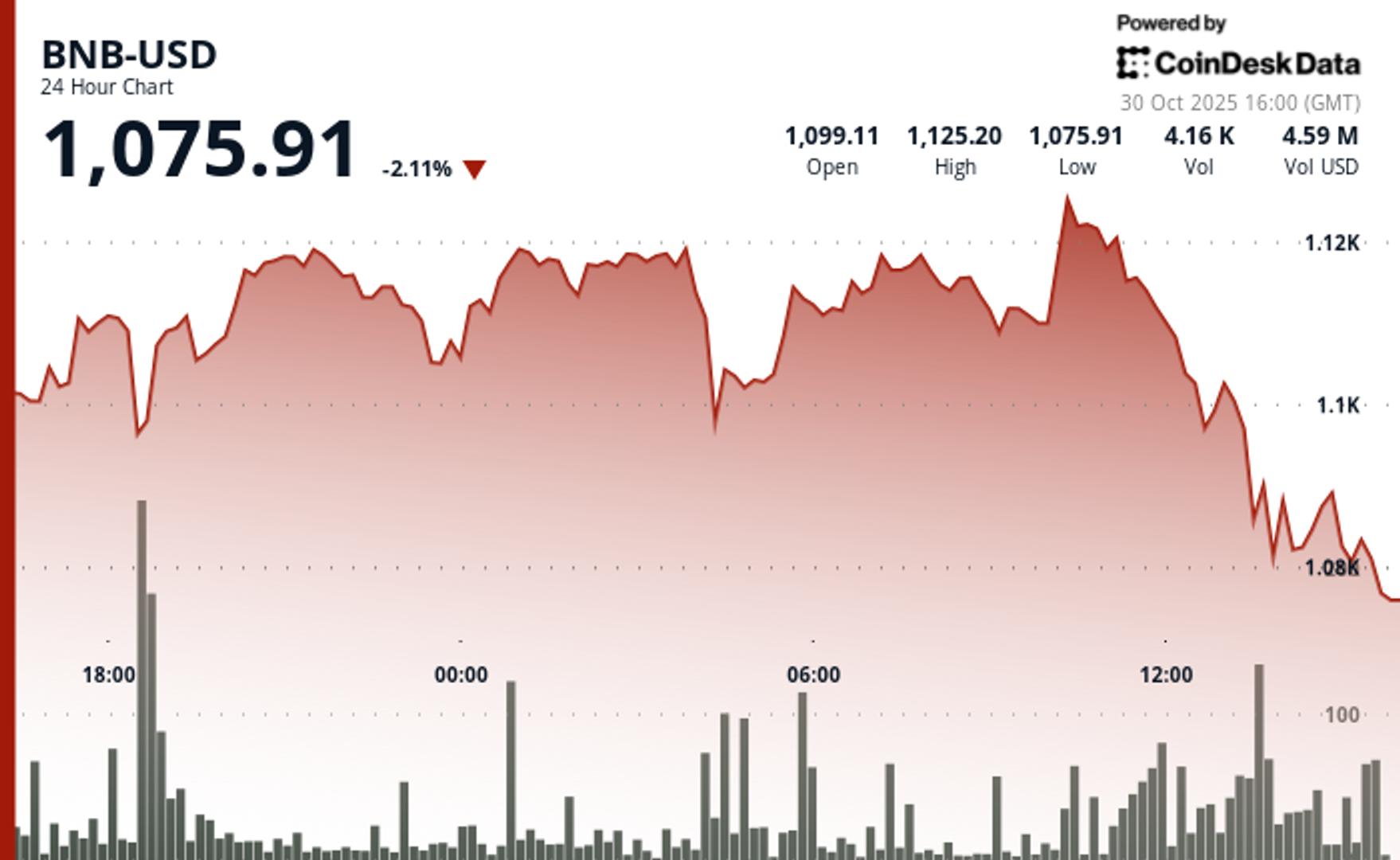
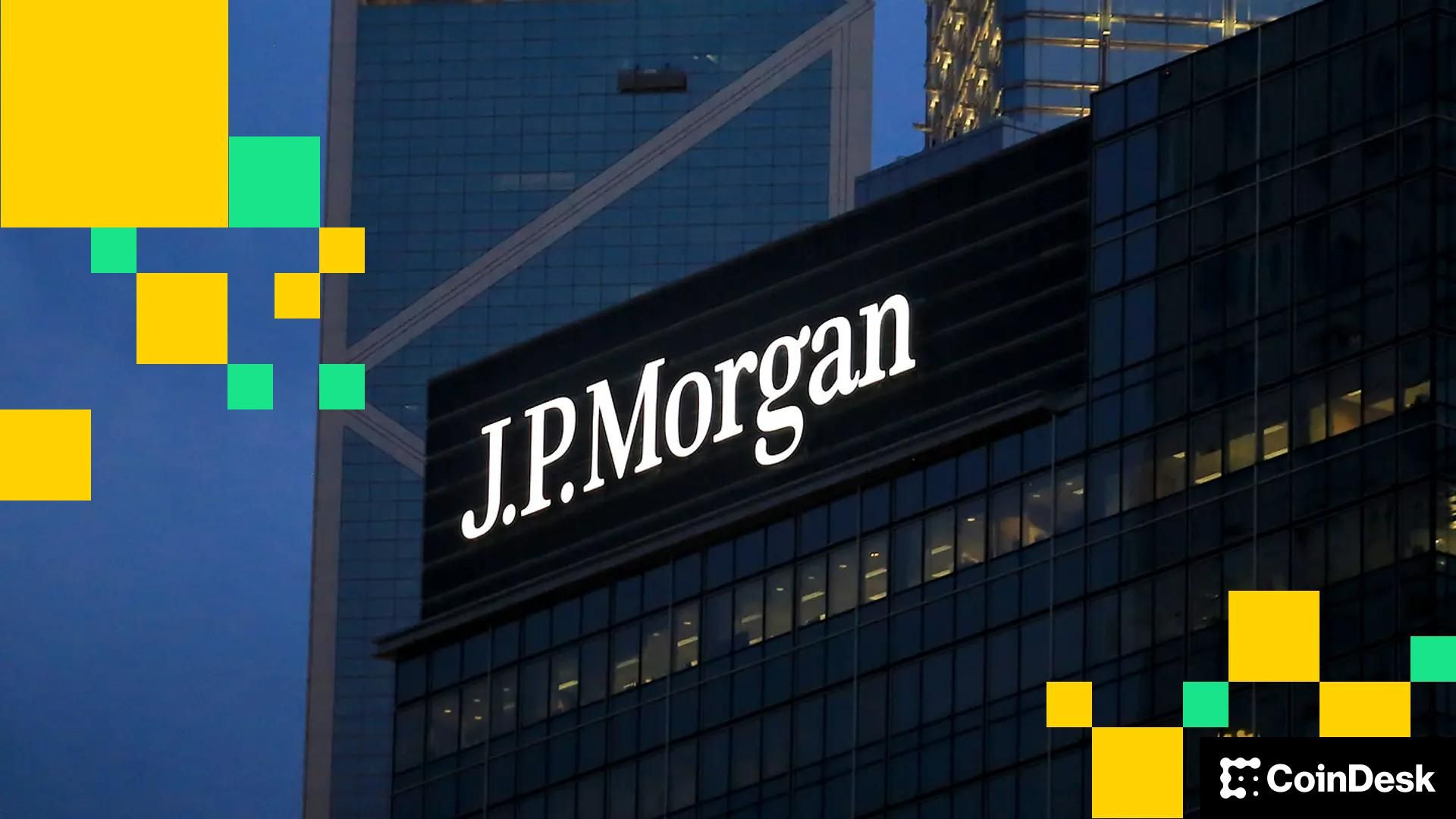




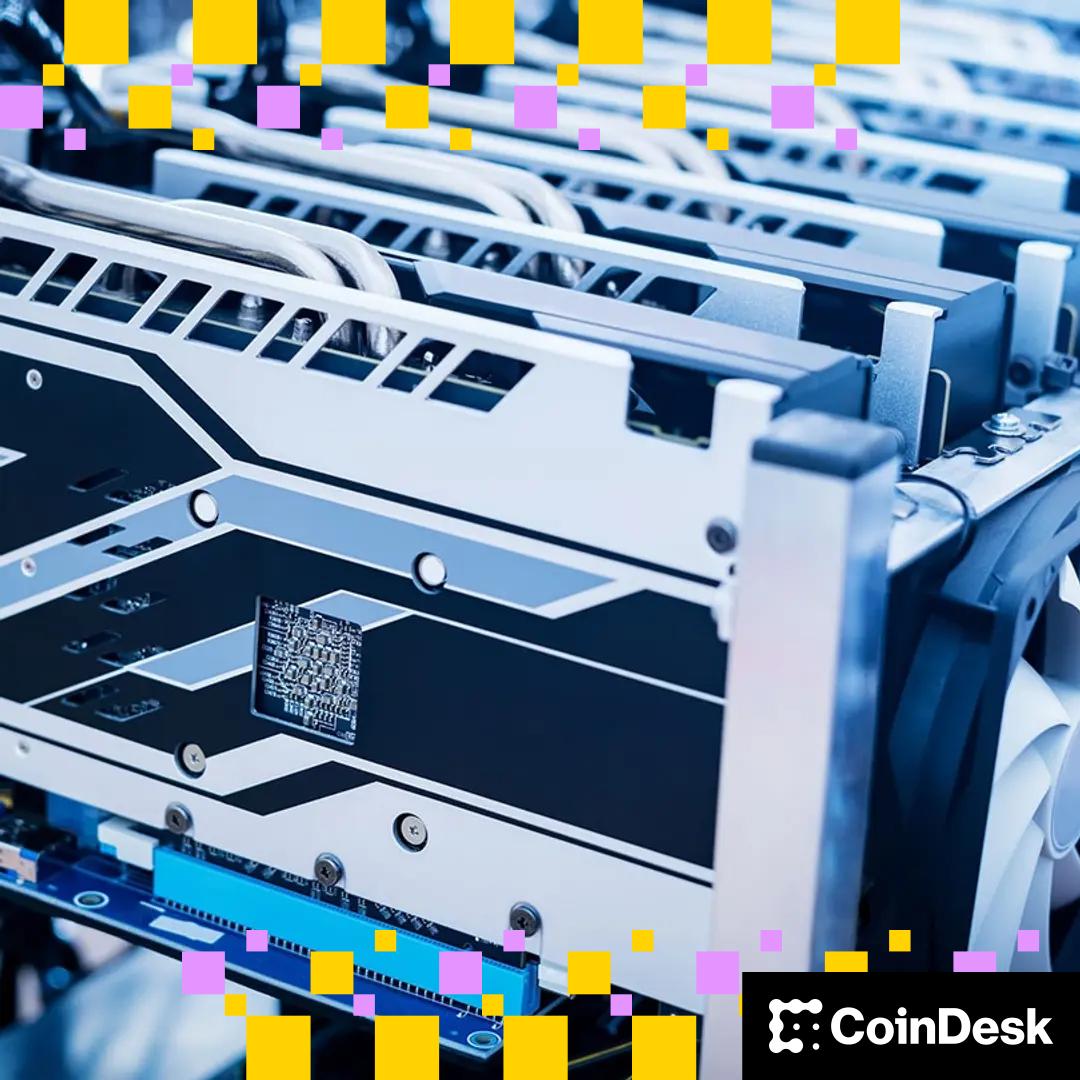

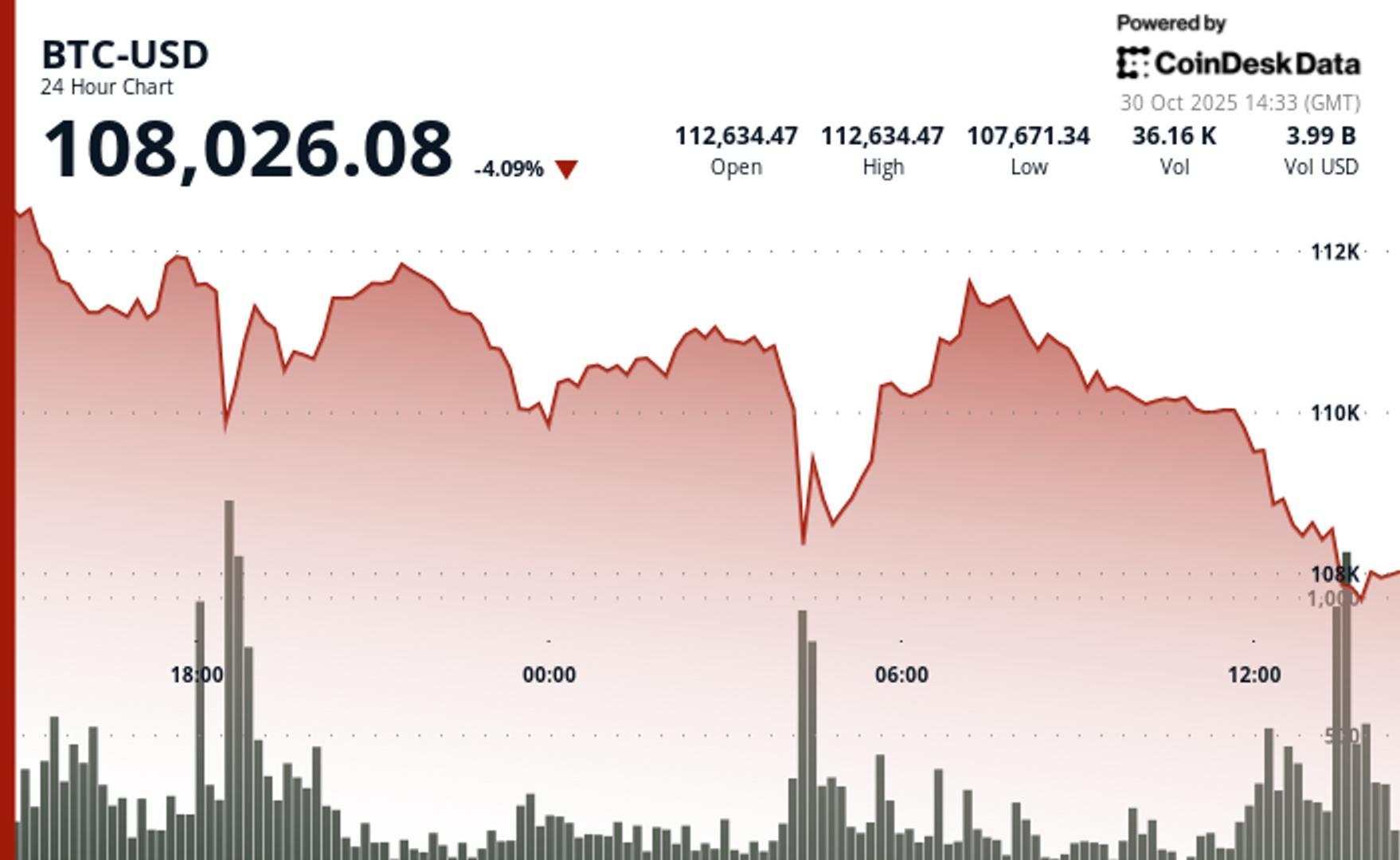




Halliday integrates TRON to cut crypto onboarding times to one minute using its Workflow Protocol and intelligent routing system.
The post Halliday integrates TRON Network, delivering seamless on-ramp payments across the ecosystem appeared first on Crypto Briefing.

Jump Crypto's asset shift may signal changing market strategies, impacting Solana's ecosystem and highlighting Bitcoin's enduring appeal.
The post Jump Crypto reportedly rotates $205M in SOL to $265M in BTC via Galaxy Digital appeared first on Crypto Briefing.

The drop in Nakamoto's holdings highlights the volatility of cryptocurrency markets and their impact on wealth rankings among global billionaires.
The post Satoshi Nakamoto’s holdings fall by $4.9B over the past 24 hours, now at $118B appeared first on Crypto Briefing.

SEGG Media's initiative highlights the increasing corporate trend of leveraging digital assets for treasury management, potentially boosting market legitimacy.
The post SEGG Media plans $300 million digital asset initiative, with initial emphasis on Bitcoin appeared first on Crypto Briefing.

Hyperliquid's role in high-volume trading underscores the risks of leverage in volatile crypto markets, impacting traders and market stability.
The post Hyperliquid sees largest single liquidation order at $21.4M in BTC-USD appeared first on Crypto Briefing.

Core Scientific's decision to remain independent may strengthen its focus on Bitcoin mining, potentially enhancing its market position.
The post Core Scientific shareholders reject CoreWeave merger proposal appeared first on Crypto Briefing.




Bitcoin (BTC) has seen heightened volatility following the US Federal Reserve’s decision to cut interest rates by 25 basis points and announce the official end of quantitative tightening (QT) by December 1st. The move marks a pivotal shift in US monetary policy as the central bank signals the beginning of a more supportive liquidity cycle after months of restrictive financial conditions. Traders reacted sharply across risk assets, with Bitcoin initially spiking before retracing as markets reassessed the implications of renewed liquidity and shifting economic expectations.
Meanwhile, fresh data from CryptoQuant highlights a powerful underlying trend in the Bitcoin market. October has witnessed a meaningful surge in spot trading activity, particularly on Binance, where participation has climbed sharply. Across major centralized exchanges, Bitcoin spot volume surpassed $300 billion this month, with Binance alone accounting for $174 billion. This makes October the second-highest spot volume month of the year, underscoring renewed trader confidence and a shift toward direct Bitcoin exposure rather than leveraged speculation.
This strengthening in spot market flows signals improving market structure and growing conviction among participants. With liquidity expected to increase heading into year-end, investors are positioning for what could be the next major phase in Bitcoin’s macro-driven cycle.
According to top analyst Darkfost, the recent surge in Bitcoin spot volume underscores a growing wave of participation from both retail traders and institutional players, who have become increasingly active outside leveraged markets. This shift is most visible on Binance, which continues to dominate spot trading across centralized exchanges. Its deep liquidity, global retail base, and institutional pipelines remain unmatched, reinforcing its position as the primary venue for real Bitcoin demand.

One key catalyst behind this pivot toward spot exposure was the historic liquidation event on October 10th—the largest in crypto history. The magnitude of that wipeout forced many traders to reassess risk. It became a clear reminder that excessive leverage can amplify losses far more quickly than it generates gains, especially in a market as volatile and structurally reflexive as Bitcoin. In response, market participants appear to have shifted toward a more conservative posture. Choosing to accumulate BTC directly rather than chase high-leverage positions.
This trend is meaningful for Bitcoin’s long-term trajectory. A market driven primarily by spot flows instead of derivatives tends to be more stable, more sustainable, and less prone to sudden liquidation cascades. Elevated spot participation also signals genuine organic demand, rather than speculative interest reliant on borrowed capital. Historically, periods where spot volume leads have aligned with structural accumulation phases and strengthened market bottoms. This could be laying the foundation for durable bull cycles.
If this rotation continues, Bitcoin may be entering a phase defined by healthier price discovery and stronger investor conviction. Supported by growing liquidity and improved market resilience. An encouraging backdrop as the macro environment shifts in favor of risk assets.
Bitcoin (BTC) is trading near $110,800 after facing firm rejection at the $117,500 resistance level earlier this week. The 4-hour chart shows BTC rolling over from this supply zone and dropping below the 50-period moving average. Signaling weakening short-term momentum. Price is now testing a critical support range between $110,000 and $111,000, which previously acted as a key demand zone in mid-October.

Below current levels, the 100-period (green) and 200-period (red) moving averages sit around $109,500–$108,500, forming a critical confluence of support. If Bitcoin can hold this region, it may reset and attempt another push higher once market volatility settles post-Fed. A decisive break below $108,000 would likely expose BTC to deeper downside. Opening the door to a move toward $105,000 or even $102,500.
On the upside, bulls must reclaim the $113,500–$114,500 area to regain traction. A sustained move above this zone would put $117,500 back into focus. With a breakout, there is potential to fuel continuation toward the $120,000–$123,000 range.
Featured image from ChatGPT, chart from TradingView.com

A key technical indicator on the XRP price chart is sending an important signal about the strength of its ongoing price action. The Relative Strength Index (RSI), which measures momentum, is climbing higher in tandem with price, a development that popular XRP analyst EGRAG CRYPTO says validates the current bullish phase.
In one of his recent posts on X, he explained that this alignment between price and RSI shows a healthy uptrend where buying pressure will continue to dominate.
EGRAG CRYPTO highlighted that when both price and RSI make higher highs, it is one of the strongest confirmations that the trend is healthy. He noted that this scenario indicates buyers are firmly in control and that the market is not overextended. According to him, when both price and RSI rise together, the uptrend is real and supported by strength. This is in contrast to bearish divergence, which occurs when price climbs but RSI falls, and is often a precursor to fading momentum and correction.
The RSI data on his chart shows an ascending slope with an angle of about 9.32°, matching XRP’s gradual increase in price over the past year. This synchronized movement implies that the trend is sustainable and supported by genuine market participation instead of temporary hype.
The chart from EGRAG CRYPTO shows that XRP has already broken above the midpoint of its long-term ascending parallel channel. The red trendlines framing the channel stretch back to 2014, and XRP’s breakout above the resistance line shows that bullish momentum is comparable to that of the 2017/2018 rally.
The yellow moving average line, which represents the multi-month trend, is also sloping upward beneath the candles, acting as strong dynamic support. This alignment shows XRP’s improved market structure compared to earlier bear market phases between 2022 and mid-2024.

XRP Price Chart. Source: @egragcrypto On X
EGRAG CRYPTO’s projection identifies $2.07 as the major support level and $3.65 as the near-term target, which aligns with its July 2025 all-time high.
EGRAG CRYPTO’s analysis shows that XRP’s momentum is being confirmed by both price structure and RSI alignment, and this reduces the likelihood of a strong price reversal. The lack of bearish divergence means that the ongoing rally could be setting up for a continuation rather than exhaustion. If XRP sustains its position above the midpoint breakout zone, then a return to $3.65 may follow very soon.
As long as XRP holds above $2.07 and $2.50 for now, the uptrend will stay healthy, and the RSI momentum will support the broader bullish outlook. At the time of writing, XRP is trading at $2.58, having retraced a bit from its intraday high of $2.66. Recent trading sessions have seen the cryptocurrency trying to reclaim $2.60.

The Pi Network price has continued its bullish rally, rising 28.74% over the past week. The move highlights growing investor confidence and positive momentum in the project.
Developers have announced major progress in KYC verification and network migration. These updates have boosted optimism that the Pi Network is moving closer to full-scale launch.
The team confirmed that 3.36 million new Pioneers have completed their KYC process. This follows the rollout of an AI-powered system that helped verify 4.76 million pending users. The total number of migrated accounts has now reached 2.69 million.
Also Read: Pi Network Loses $18B in Six Months: Is This the Biggest Rug Pull of 2025?
The Pi Network price reacted positively to the news. Traders see this as a sign that the project is finally addressing regulatory and identity issues. The network’s next target is integration with ISO 20022 standards, which will align it with global financial messaging systems.
Despite the achievements, Pi’s core contributor Fen Leng clarified that migration is not yet complete. Posting on X, Leng said that Testnet2 is still at version 19 and has not been upgraded to version 23. He warned the community not to believe rumors of full migration.

This statement reassured the market that the team remains transparent and cautious. While this may slow short-term momentum, it supports long-term credibility. Analysts noted that honesty from the core team often builds stronger community trust.
The Pi Network price has been supported by strong community sentiment. According to CoinMarketCap data, 88% of Pi investors voted bullish. That represents more than 4.3 million users who believe the price will continue to rise.
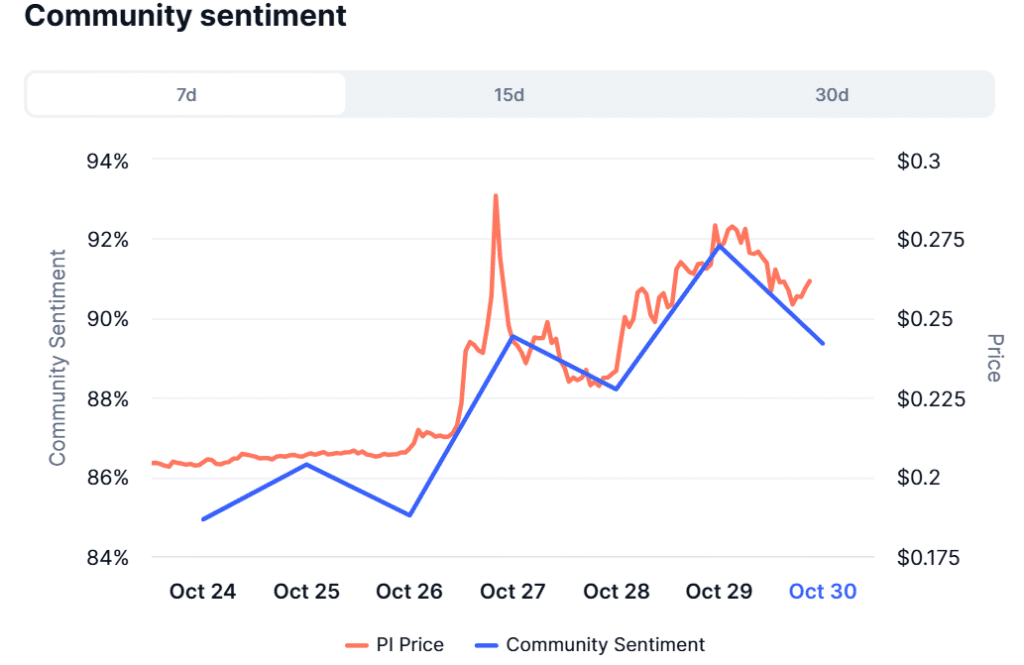
Traders are showing greater accumulation activity. Many expect further gains if Pi maintains its current momentum. This sentiment has fueled optimism across the market.
Data from Coinalyze showed that the Pi Network price also gained support from derivatives traders. The funding rate turned positive at 0.0055%. Open interest jumped to $33 million within 24 hours.
These figures suggest that more traders are opening long positions. A positive funding rate often signals confidence in future price growth. Rising open interest means more funds are flowing into the market, reinforcing bullish sentiment.
The Pi Network price is now at a crucial resistance zone. This level often causes short-term pullbacks, but the Relative Strength Index is at 65, indicating strong buying power.
If the price breaks above this key resistance area, it may rise to $0.50 to $0.60, levels last seen in May, as per expert prediction. Analysts claim continued network improvements may keep this breakout alive.

A potential catalyst for the Pi Network price is the promise of future ecosystem developments. As developers have teased new roadmaps centered around decentralization and utility.
| Month | Min. Price | Avg. Price | Max. Price | Change |
|---|---|---|---|---|
| Nov 2025 | $ 0.1793 | $ 0.2031 | $ 0.2546 |
-1.94%
|
| Dec 2025 | $ 0.1943 | $ 0.2010 | $ 0.2075 |
-20.07%
|
As much as the Pi Network has a long way to go in terms of centralized access, the network is still overly centralized, with the foundation holding 90 billion tokens. A burn event that limited the supply would be a huge boost for the price. This would lead to more trust and a stronger and healthier long term market.
The coin is not yet available on major exchanges such as Binance or Coinbase. The ecosystem is also smaller than most of its competitors. Plus, the token unlock rate is quite high, which could lead to downward pressure.
Thus, in principle, every obstacle above is an opportunity. Once you get listed or confirm a burn, expect a rocket to take off. Experts agree that such actions could spur the price to double or even triple.
The Pi Network price appears to be one of the most intriguing crypto assets to keep an eye on this week. Some excellent technical developments, user growth, and community optimism have combined to establish a strong recovery trend.
The network might have an even better chance of being a significant player in the crypto space if it can maintain its evolution to decentralization and regulatory demands.
Also Read: Is Pi Network Warming Up for Its Next Big Rally?
Pi Network – A mobile-based cryptocurrency project that allows users (Pioneers) to mine coins through a decentralized network.
Pioneers – Members of the Pi Network who mine and validate transactions through the mobile app ecosystem.
KYC (Know Your Customer) – A verification process used to confirm user identities, prevent fraud, and meet international compliance standards.
ISO 20022 – A global financial messaging standard that improves payment interoperability and data exchange across banking systems.
Network Migration – The transition process of moving Pi accounts and tokens from the testnet to the mainnet, enabling full functionality and trading.
Open Interest – The total number of outstanding derivative contracts, showing the level of activity and interest in the Pi Network price market.
The price is rising due to strong investor sentiment, new KYC verifications, and upcoming global compliance updates.
The Pi Network price is tracked by data platforms but not traded on exchanges like Binance or Coinbase.
Key factors include completion of migration, ISO 20022 integration, and any announcement about decentralization or exchange listings.
It carries both risks and rewards. The project is still evolving, but growing adoption and transparency are encouraging signs.
Read More: Pi Network Price Jumps 28% as KYC Milestone Boosts Investor Confidence">Pi Network Price Jumps 28% as KYC Milestone Boosts Investor Confidence


The relationship between Ethereum exchange-traded funds and the ETH price is complex and multifaceted. The recent Ethereum ETF outflows have sparked concerns about its potential impact on the Ether price.
According to Farside Investors data, the Ethereum ETFs have seen a notable outflow of $81.4 million on October 29, exacerbating the negative trend observed over the past week. While this downtrend has coincided with the weakness in the ETH/BTC ratio, the question is whether these Ethereum ETF outflows are a significant indicator of Ether token’s future price movements.
In a recent X post, analyst Ted shared insights on the massive outflow of $81.4 million Ether funds last day. Despite inflows of 133.9 million and 246.0 million on the last two days, the week has witnessed significant outflows totalling almost $320 million since October 22.
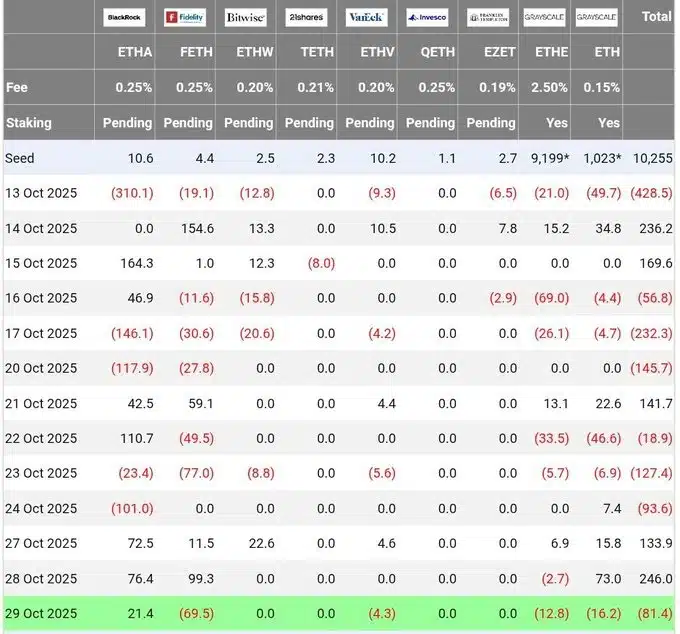
Notably, US spot Ether ETFs experienced significant fluctuations in investor sentiment, with substantial inflows in July and August followed by prolonged outflows in late September and mid-to-late October. The week ending September 26 saw a record $796 million in redemptions, primarily driven by investors exiting Grayscale’s ETHE in favor of lower-fee products or exiting positions altogether.
This trend resurfaced around October 23-24, with the week ending October 29 recording approximately $320 million in net redemptions across US Ether ETPs. These shifts highlight the ongoing volatility and investor rotation in the Ether ETF market.
Reportedly, the recent Ethereum ETF outflows have coincided with the challenges in the ETH/BTC ratio. The timing of these outflows aligned with weekly declines in the ETH/BTC ratio, suggesting that ETF flows may indeed have predictive value for price movements.
In early October, the trend reversed, with the week ending October 6 seeing about $1.48 billion in net inflows to the Ether funds. During this period, Ether ETFs benefited from a broader risk-on environment, and the ETH/BTC ratio stabilized or even ticked higher. This pattern suggests a correlation between inflows and relative strength, as well as outflows and relative weakness.
The relationship between Ethereum ETF outflows and the ETH price is more nuanced than a simple correlation. At daily intervals, the relationship is noisy, and other factors such as regional demand and derivatives market dynamics can dominate.
Non-US Ether exchange-traded products, particularly in Germany, Switzerland, and Canada, have absorbed Ether ETPs during periods of US outflows, leading to net global inflows despite domestic redemptions. For instance, CoinShares data shows that these regions have consistently bought into Ether ETPs during mid-October US outflows, resulting in net global inflows in some weeks. Additionally, Hong Kong’s spot Ether ETFs, although smaller, provide another non-US data point, highlighting the growing maturity of the Asian market.
The impact of Ethereum ETF outflows on the ETH price is complex and depends on various factors. When US outflows coincide with negative market conditions, such as a negative basis and funding rates, and stagnant staking growth, the selling pressure intensifies. However, when European or Canadian inflows counterbalance US redemptions or when staking absorbs released supply, the price impact diminishes.
There are many potential catalysts that could reverse the flow regime, such as Ethereum protocol upgrades that shape the staking economics, US ETF fee structure changes, and/or macroeconomic shifts that lessen competition from real-world assets.
Additionally, flows in Ether ETFs and the ETH/BTC ratio are impacted by the dynamics of Bitcoin ETFs. More specifically, if a Bitcoin ETF attracts significant inflows, this could amplify the relative underperformance of Ether. In general, a US spot Ether ETF outflow is likely to be free to counteract ETH/BTC weakness, but it is an episodic headwind vs. a structural one; in addition, flows are most useful as a risk signal that either confirms or conflicts with the signals of other price signals.
The recent Ethereum ETF outflows signify a change in sentiment among investors and that there is near-term selling pressure on ETH. While large outflows tend to move in tandem with ETH/BTC weakness, there are numerous factors influencing outflows, and the relationship between flow and price action is not entirely causal. Regional inflows, staking activity, and macro conditions are also factors that influence ETH price action.
Read More: Ethereum ETF Outflows Surge as $320M Exits in One Week: Is ETH at Risk?">Ethereum ETF Outflows Surge as $320M Exits in One Week: Is ETH at Risk?


Crypto never sleeps; it just refreshes the charts and reloads the memes. With Bitcoin catching its breath and meme tokens back in the spotlight, traders are hunting the top meme coin to buy this Month before the next bull surge. Dogecoin’s chatter, Shiba’s burns, and new meme giants are filling social feeds, but one project has turned FOMO into fuel. This month’s investor buzz centers on a cinematic creation forged from Ethereum’s blue fire and built for believers: BullZilla ($BZIL), a meme coin that blends story, scarcity, and staking into one unstoppable beast.
BullZilla isn’t another copy-paste token riding hype. It’s a presale phenomenon roaring through Stage 8, backed by deflationary burns, staking rewards, and a 24-chapter narrative that’s captivating the crypto world. With over $993K raised, 3,300 holders, and more than 31 billion tokens sold, its automatic price escalations every $100K or 48 hours make it a ticking clock of opportunity. Analysts and meme investors alike are calling it the top meme coin to buy this Month before its listing at $0.00527 in 2026.
Dogecoin, the original meme king, saw a 3.39 percent decline to $0.1931 in the last 24 hours following reports of whale wallet activity. Over 250 million DOGE moved between major wallets, sparking speculation of short-term selling pressure. Despite the dip, Dogecoin’s social activity remains high, with community campaigns pushing for Tesla payment integration and new tipping mechanics on X. Analysts note that DOGE’s large-holder concentration makes it more volatile, but upcoming retail expansions could reignite upward momentum if sentiment turns bullish again.
The broader market correction hasn’t dimmed Dogecoin’s presence. On-chain data shows an increase in smallholder accumulation, suggesting retail investors are buying the dip. Active addresses climbed by 9 percent week-over-week, reinforcing faith in DOGE’s staying power. Technical analysts highlight $0.188 as key support, with potential rebounds toward $0.205 if volumes rise. Dogecoin remains one of the most recognized brands in crypto; its humor, accessibility, and culture still anchor it within the meme economy despite growing competition from newer, narrative-driven tokens like BullZilla.
Dogecoin dropped 3.39 percent to $0.1931 after whale transfers triggered short-term selling. Despite this, retail accumulation continues, and market sentiment could improve if broader crypto trends stabilize in the coming sessions.
Yes. Analysts expect a potential rebound toward $0.205 if trading volumes increase. Dogecoin’s strong brand, active community, and utility experiments on X maintain long-term growth potential despite temporary volatility.
BullZilla has transformed what meme coins represent, turning speculation into structured growth. Built on Ethereum, it fuses cinematic storytelling with real tokenomics through its 24 lore chapters. Each chapter triggers live Roar Burns, reducing supply and amplifying scarcity. The HODL Furnace offers a blazing 70 percent APY for stakers, while the Roarblood Vault rewards both referrers and referees with 10 percent bonuses on every qualifying buy. BullZilla isn’t chasing memes, it’s building mythology. Its deflationary mechanics and on-chain transparency make it the top meme coin to buy this Month for holders seeking both excitement and long-term value.

Currently in Stage 8 (Echoes of the Bull, Phase 3), the BullZilla presale price is $0.00020573, with more than $993K raised and over 3,300 holders. So far, 31 billion BZIL tokens have been sold, with an ROI of 2,462.29 percent relative to the $0.00527 listing price. The earliest buyers already project gains of more than 3,477 percent. Each $100K milestone or 48-hour timer triggers an automatic price increase, keeping FOMO alive and demand surging. For believers, it’s like catching Solana before the training wheels came off,a rare blend of creativity, scarcity, and unstoppable hype.
At the current presale price of $0.00020573, a $6,000 investment buys roughly 29.1 million BZIL tokens. Upon launch at $0.00527, that stake’s projected value could reach $153,600,a 2,462 percent ROI before staking or referral rewards. Add the 10 percent referral bonus and 70 percent APY staking yield, and the total return potential grows exponentially. As the next stage approaches with a 3.24 percent price hike, BullZilla remains the most time-sensitive presale on Ethereum. Every dollar now feeds the furnace of scarcity and narrative, setting up one of 2025’s most explosive crypto debuts.
Joining the BZIL presale takes minutes. Visit https://www.bullzilla.com/how-to-buy/, connect a wallet like MetaMask or Trust Wallet, and choose ETH or USDT to complete your purchase. Buyers automatically receive tokens upon confirmation, and purchases above $50 unlock a 10 percent bonus. Referrers also earn 10 percent of their friends’ buys, distributed after a two-week vesting period. Each presale phase ends after $100,000 raised or 48 hours, ensuring continuous momentum and scarcity. Simple steps, instant access, and built-in rewards make BullZilla the easiest way to join the top meme coin to buy this Month before it skyrockets.
The HODL Furnace defines loyalty in the BullZilla ecosystem. With a 70 percent APY, holders can lock their BZIL tokens to earn consistent passive income while contributing to supply stability. This feature, powered by 32 billion tokens, transforms patience into profit. The longer tokens are staked, the more they compound, encouraging holders to stay invested through the presale and beyond. Combined with deflationary burns and narrative-driven engagement, the HODL Furnace rewards conviction, not speculation. It’s not just staking; it’s a trial by fire for those determined to become true BullZilla believers.
BullZilla merges cinematic storytelling, staking rewards, and deflationary burns into a single powerhouse ecosystem. Its presale price automatically increases every 48 hours, rewarding early investors with exponential ROI, maintaining scarcity, and driving constant engagement across its growing global community of holders and fans.
Referrers earn 10 percent of every qualifying buy made through their link, while buyers receive 10 percent extra tokens on purchases above $50. Rewards unlock after two weeks for transparency and fairness.
BullZilla will officially launch in Q1 2026 at $0.00527, introducing complete staking and liquidity activation across its ecosystem. This milestone marks the transformation from a powerful presale titan into a fully realized, deflationary meme-coin universe ready for global market integration.
Presales can be powerful wealth builders, but only when chosen wisely. Always check project audits, smart-contract verification, and community transparency before investing. Study token allocation to ensure fairness and sustainability. Avoid tokens with excessive team allocations or unclear burn mechanics. Evaluate referral and staking programs for long-term feasibility. A great presale rewards conviction, not quick flips. Projects like BullZilla set the standard with public audits, locked liquidity, and transparent tokenomics. Before joining any presale, research deeply, engage responsibly, and remember, the best opportunities favor those who roar early, not recklessly.
Shiba Inu fell 1.37 percent to $0.00001017 over the last 24 hours after a temporary slowdown in token burns. Despite the decline, on-chain transactions continue to rise, signaling steady community engagement. Shibarium, the layer-2 network, processed over 3.5 million transactions this week, reinforcing SHIB’s ecosystem strength. Analysts believe consolidation is natural after its recent surge. With marketing expansions and exchange listings in progress, investors expect renewed momentum before mid-November as retail demand strengthens. For now, SHIB holders remain patient, viewing dips as opportunities to accumulate.
The Shiba Inu team announced upgrades to its burn tracker and new DeFi utility projects to stimulate long-term growth. Recent partnerships aim to bridge SHIB with gaming and NFT ecosystems, increasing its cross-sector utility. Analysts predict that sustained burn rates above 500 million tokens daily could reignite the rally. Despite short-term weakness, SHIB’s community-driven narrative and expanding ecosystem continue to make it a favorite in the meme coin sphere. As newer contenders like BullZilla rise, Shiba’s legacy ensures it remains a major player in crypto’s playful frontier.
Shiba Inu declined 1.37 percent amid slower burn activity and moderate profit-taking pressure. However, analysts expect the downturn to be short-lived, noting that growing engagement on the Shibarium network continues to strengthen overall community participation and long-term sentiment.
Yes. SHIB maintains strong community backing and a growing ecosystem of real-world utilities. Its ongoing token burns, staking incentives, and expanding DeFi integrations continue to strengthen its position as a resilient, evolving long-term meme coin.
Across the meme coin universe, DOGE and SHIB showcase veteran strength but slower growth. However, the top meme coin to buy this Month isn’t a legacy token; it’s BullZilla. Backed by Ethereum’s foundation, 24 lore chapters, and on-chain deflation, BZIL transforms meme energy into sustainable tokenomics. With automatic price climbs, staking yields, and referral rewards, it stands apart as a presale engineered for longevity. While DOGE and SHIB reset, BullZilla continues roaring toward its 2026 launch with unstoppable momentum and four-digit ROI potential.
BullZilla’s presale has already surged past the $1 million milestone, drawing over 3,300 passionate holders from across the globe. Each progressive stage deepens the cinematic lore, triggers live token burns, and heightens scarcity-driven demand. As traders hunt for the next viral meme coin with real mechanics, BullZilla stands out through its structured presale, transparent on-chain design, and tangible staking rewards. This is more than just a token sale; it’s a living, unfolding storyline of community conviction, innovation, and deflationary power.

Follow BZIL on X (Formerly Twitter)
Cryptocurrency investments are subject to market risk. This content is for informational purposes only and should not be taken as financial advice. Always DYOR (Do Your Own Research) before investing.
Read More: Dogecoin and Shiba Inu Lose Momentum as BullZilla’s 31B Tokens Sold Make It the Top Meme Coin to Buy This Month">Dogecoin and Shiba Inu Lose Momentum as BullZilla’s 31B Tokens Sold Make It the Top Meme Coin to Buy This Month


The Federal Reserve reduced rates by 25 basis points to a 3.75 to 4.00 percent range, then stressed that another cut in December is not guaranteed. That mix of relief and restraint kept risk assets in check and left XRP hovering around the mid-$2.60s while traders reassessed the path ahead.
XRP traded around $2.63 into the decision and sat just below visible resistance near $2.70 to $2.80. Immediate direction hinges on whether liquidity improves and whether the market treats the cut as the start of a durable easing cycle rather than a one-off adjustment.
Policy is now looser at the margin, but the central bank emphasized optionality. Chair Jerome Powell told reporters that a further reduction this year is “not a foregone conclusion,” a line that cooled hopes for automatic easing and kept the dollar and yields from sliding too far. That stance matters for crypto because easier financial conditions tend to support flows into higher beta assets when growth is steady.
There is also the tone. In recent remarks, the Chair underlined that decisions remain “data-dependent,” which is another way of saying policy can move either way if inflation or jobs data surprise. For digital assets, that keeps volatility risk alive around each macro print, even while funding conditions are improving.
Price sits above the 200-day moving average and the weekly trend structure remains constructive. Order-book dynamics show sellers defending the $2.70 to $2.80 pocket, while buyers consistently reload around $2.58 to $2.63. The article’s base case holds: a decisive close through $2.80 opens a path toward $3.00 to $3.20. A failure to hold $2.50 risks a slide toward $2.30 to $2.40.
Flows are the near-term wild card. Recent reports flagged large whale accumulation in the days leading into the meeting, a sign that deep pockets continue to build exposure on dips. If that pattern persists alongside softer yields, spot demand can offset sluggish altcoin volumes and keep the uptrend intact.
For the next few weeks, the market’s pivot remains $2.70 to $2.80. Clearing that shelf with rising volume would validate a momentum extension toward $3.00 first and $3.20 next. If the level rejects, a drift toward $2.50 is possible as traders digest macro headlines. This tactical map aligns with recent behavior around $2.63 and the repeated failure to close above the local ceiling.

The long-term picture is more straightforward. If policy gradually eases into 2026 and the economy avoids a sharp slowdown, digital assets tend to benefit from cheaper capital and improving risk appetite. In that environment, an XRP price prediction that revisits the cycle highs becomes reasonable, especially if network momentum improves and legal overhangs continue to fade. If growth softens faster than expected, a defensive regime can cap rallies and make any XRP price prediction more conservative.
The phrase XRP price prediction appears often in market chatter, but the version that matters is the one tied to data. Trend, liquidity, and policy do the heavy lifting. At present, the constructive bias holds above the 200-day moving average, which supports a medium-term XRP price prediction that leans positive while respecting the $2.50 line in the sand.
If spot volumes expand on breakouts, that XRP price prediction can stretch toward fresh highs over a multi-quarter window. If volumes fade, the XRP price prediction should be tempered to range outcomes until catalysts arrive.
“Further reduction in December is not a foregone conclusion,” Powell said at the post-meeting press conference, reinforcing the case for a patient approach and a meeting-by-meeting path. That one sentence keeps both risk-on and risk-off scenarios on the table and explains why XRP did not sprint after the cut.
Two forces can derail the constructive path. A growth scare can flip the narrative from gentle easing to fear of recession, which usually dents speculative flows. A renewed inflation flare-up can also force guidance back toward restraint. In either case, a break below $2.50 would invite a deeper pullback and require a reset of any short-term XRP price prediction until the trend repairs.
The Fed delivered relief but not a green light. XRP remains range-bound below a crowded ceiling, supported by the longer-term trend and selective whale demand. Clear $2.80 and $3.00 come into view with room to $3.20. Lose $2.50 and the market likely checks back toward $2.30 to $2.40. For now, a disciplined XRP price prediction favors patient accumulation on weakness and validation on strength, with the long-term path tied to the pace of easing and the health of growth.
Where are the key levels right now?
Resistance sits around $2.70 to $2.80, with $3.00 as the confirmation level. Support is near $2.58 to $2.63 and then $2.50.
What could unlock the next leg higher?
A confident close above $2.80 on rising volume as policy eases and spot demand improves.
What is the main risk to the upside case?
A macro swing to risk-off or a hot inflation surprise that curbs easing expectations.
Federal funds rate target range
The short-term interest rate corridor set by the central bank that influences borrowing costs and risk appetite.
Moving average (200-day)
A trend indicator that smooths price over 200 sessions. Trading above it often signals a constructive long-term bias.
Whale accumulation
Large, identifiable purchases by addresses that historically influence liquidity and direction when sustained.
Read More: XRP Price Prediction After Fed Cut: Can Bulls Clear $3.00?">XRP Price Prediction After Fed Cut: Can Bulls Clear $3.00?

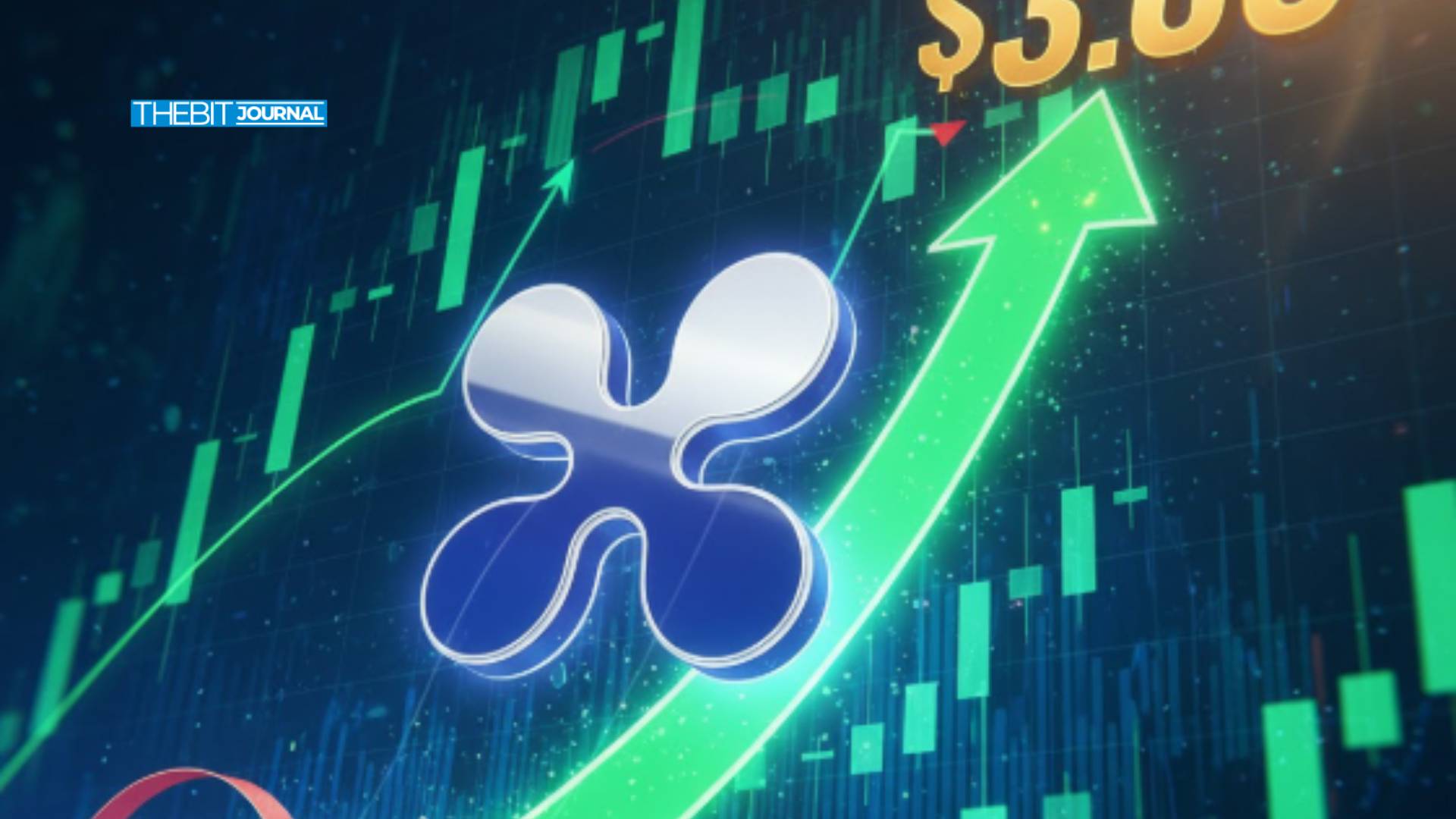
Updated on 30th October, 2025
The spotlight has been on Solana (SOL) as the first US staking-based exchange-traded fund (ETF) was launched. The new fund, BSOL from Bitwise Asset Management, offers direct exposure to Solana plus staking yield.
As a result, analysts are looking into the Solana ETF launch, why the demand was so strong, how Solana’s network fundamentals are aligned, what this means for SOL price in the near term and how it compares to other crypto ETFs.
Just recently, Bitwise’s Solana Staking ETF (BSOL) started trading in the US. The fund saw $69 million in first-day inflows and $57.9 million in first-day trading volume, reportedly the largest of all the new ETFs launched this year.
Bloomberg ETF analyst Eric Balchunas called it “a strong start” noting that BSOL’s pre-seeded capital of about $220 million helped get its assets under management (AUM) to $289 million on day one.
The Solana ETF launch means institutional interest is big as investors looked beyond pure crypto speculation to blockchain networks with yield, regulated exposure and infrastructure credibility.
According to a release, BSOL has a 0.20% management fee, and for the first 3 months on the first billion in assets, 0% fee, indicating more incentive for early adopters.
In short, the Solana ETF launch was a rare combination of big inflows, meaningful trading, and a product that offered staking rewards and regulated access to a major Layer-1 blockchain.
The success of the Solana ETF launch can be attributed to several structural advantages. BSOL has staking rewards. 82% of its Solana holdings are already staked via Helius Labs with a goal of 100%. That’s an estimated 7% annual yield, appealing to institutional investors who typically avoid direct node operation risk.
Solana’s network fundamentals are strong; the network has been up 99.9% since 2024, DeFi TVL has tripled this year and transaction volumes are higher than Ethereum’s, according to recent coverage.
High throughput, low fees, and staking income made Solana a “revenue-generating” Layer-1 blockchain, which is what institutional investors are looking for in infrastructure, not token speculation.
Regulatory clarity also helped create the pad for the Solana ETF launch. Following our earlier reports, US regulators had allowed staking-based crypto products to move forward under new guidelines.
Those conditions were the platform for BSOL to launch and get traction. The Solana ETF launch worked because it combined yield, network strength, and institutional-grade access.
Analysts expect that this Solana ETF launch will be a catalyst for $SOL’s price through multiple channels. 70% of SOL’s circulating supply is already staked, which reduces available liquidity. With a product like BSOL staking 100% of its holdings, it tightens the effective liquid pool further.
Additionally, historical research shows a strong correlation between ETF inflows and price returns in crypto. K33 Research found an R² of 0.80 between Bitcoin ETF flows and 30-day BTC returns.
Solana’s conditions of high staking, infrastructure strength, and now regulated product access could amplify that effect.
If Solana ETF products attract $5-8 billion of new capital, then 60-120% price appreciation is possible.
Some scenarios even see $SOL reaching $500+ in the next cycle. The Solana ETF launch may be the start of a re-rating phase where institutional adoption, network fundamentals and regulated product access converge.
Beyond product launch dynamics, Solana’s network itself is the foundation of the Solana ETF story. Solana processes transactions in milliseconds (400ms) compared to several seconds or minutes on other chains, according to Bitwise’s documentation.
Low transaction fees, high throughput and robust validator infrastructure makes it competitive for DeFi, tokenization and consumer financial rails.
Solana generated over $2 billion in network revenue last year, more than any other chain, which aligns with Bitwise’s argument:
“Institutional investors love revenue. Solana has the most revenue of any blockchain. Therefore, institutional investors love Solana ETFs.”
Hence; the Solana ETF launch is built on a solid network infrastructure.
Staking rewards – Income earned by locking up tokens in a proof-of-stake network, to help validate transactions.
AUM (Assets Under Management) – Total value of assets in a fund.
Layer-1 blockchain – The base blockchain network (e.g. Solana; Ethereum, Bitcoin); that other apps are built on.
Re-rating – big change in how the market values an asset; often caused by new fundamentals or structure.
ETF (Exchange-Traded Fund) – A tradable investment fund on an exchange; often tracking an index or asset.
BSOL is the Bitwise Solana Staking ETF, launched in the US on 28 October 2025, giving you direct exposure to Solana (SOL) and staking rewards.
It had one of the highest first-day inflows and trading volume of any ETF launched in 2025, showing institutional demand is high.
The fund will stake 100% of its SOL holdings, giving you an estimated average yield of around 7% per year.
The constrained supply (due to high staking) and institutional flows through the fund could put upward pressure on price.
Read More: Solana ETF Launch Breaks Records With $69M Inflows: Analysts Eye $500 SOL">Solana ETF Launch Breaks Records With $69M Inflows: Analysts Eye $500 SOL



Two high-profile meme coin traders who made millions in 2025 are now turning their attention to GhostwareOS (GHOST). According to blockchain analytics platform Lookonchain, traders identified as “LeBron” and “CLegS2” have recently accumulated large positions in the emerging privacy token.

A fully regulated euro-backed stablecoin, EURQ, is set to launch on the Xahau Network, a smart contract-enabled sidechain of the XRP Ledger (XRPL). The initiative stems from a partnership between Netherlands-based payments technology company Quantoz Payments and INFTF MTU, a nonprofit dedicated to advancing financial inclusion through blockchain.

Nordea, one of Europe’s biggest banks with €648 billion in assets, has announced that it will enable customers to trade Bitcoin ETPs directly on its platforms. The bank confirmed that, starting December 2025, clients will be able to invest in a synthetic Bitcoin ETP from CoinShares, giving them Bitcoin exposure through regular investment accounts.

Led by Ethereum, the securities tokenization market is booming, as more equities become available for retail and institutional investors to buy on-chain. Data from RWA.xyz indicates that the tokenized public stock sector is on the rise, driven by growing investor interest.
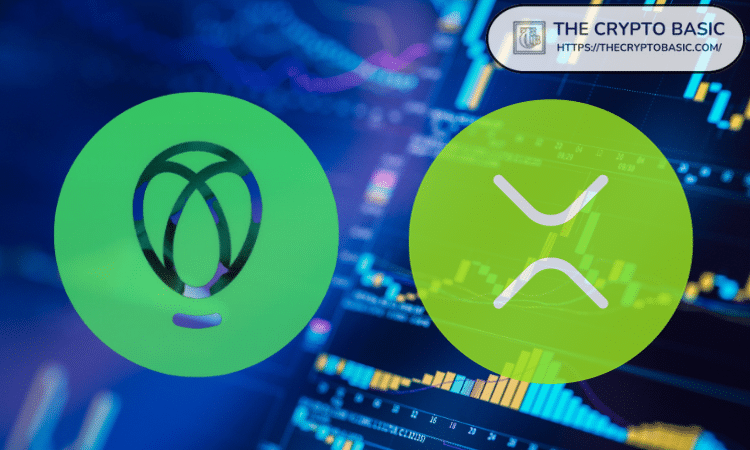
Uphold has reintroduced its U.S. debit card, giving customers a new way to earn XRP rewards whenever they spend.
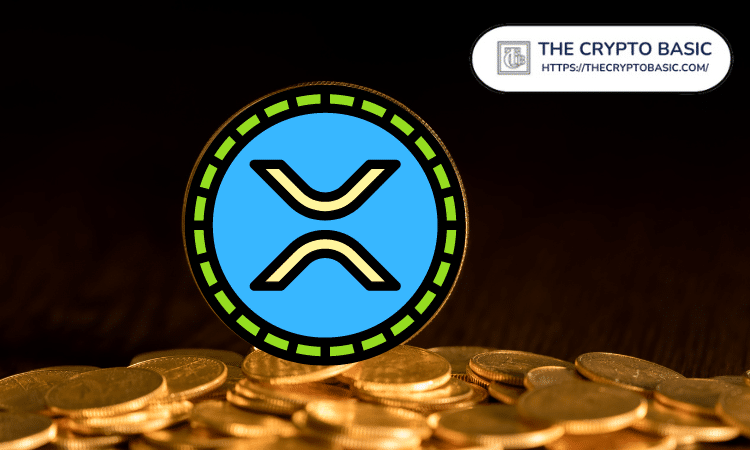
While fear remains in the market, influential market commentators continue to reveal their year-end forecasts for major assets, including Bitcoin and XRP. Among the latest to join the discussion are crypto influencers CryptoJulzss and Leshka.eth, both of whom expect a strong end to the year.
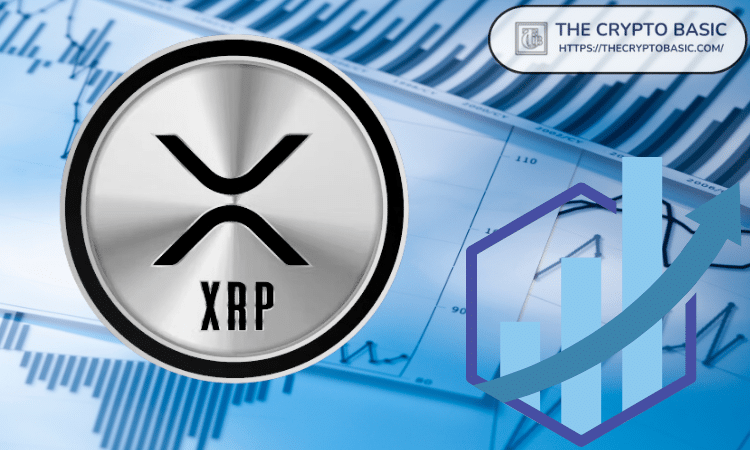
Bitcoin commentator Scott Melker, widely known as The Wolf of All Streets, has stirred a new controversy around the relevance of XRP. In a post on X, Melker questioned what real-world utility XRP holds in today’s evolving payments landscape, especially after major financial players opted for other blockchain networks.

Bitcoin Magazine

Nordic Giant Nordea Opens Crypto Door with Bitcoin-linked ETP
Nordea Bank Abp (Nordea) has announced that it will offer its customers access, from December 2025, to a synthetic exchange-traded product (ETP) whose underlying asset is Bitcoin (BTC).
According to Nordea’s official announcement, the product will be manufactured externally by CoinShares International Limited and made available through Nordea’s execution-only platform.
Under this model, customers may trade the product, but Nordea will not offer advisory services on it.
The bank cites two primary drivers for the move: the maturation of the European regulatory environment for crypto-assets, especially following the implementation of the Markets in Crypto‑Assets Regulation (MiCa) regime across the European Union in December 2024; and growing demand for virtual currencies among retail and institutional investors in the Nordic region.
The ETP in question is described as a “synthetic” product, meaning it provides exposure to Bitcoin via a traditional financial instrument rather than requiring direct custody of BTC.
Nordea emphasises that the offering is aimed at “experienced investors seeking alternative asset exposure.”
Here’s the broader context: ETPs and exchange-traded vehicles tied to cryptocurrencies have been proliferating across European venues, enabling both retail and institutional investors to access digital-asset exposure through familiar channels.
JUST IN: €648 billion Nordea to allow customers to trade #Bitcoin-linked ETP on its platforms.
— Bitcoin Magazine (@BitcoinMagazine) October 30, 2025
Europe is comingpic.twitter.com/L8hhxKscIZ
With Nordea’s move, one of the largest Nordic financial institutions is signalling its readiness to integrate crypto-exposure into its product suite.
At the same time, Nordea remains cautious. In its release, the bank underscores its historic “cautious stance” toward crypto — driven by the absence of investor-protection frameworks, regulatory clarity and supervision in the early days of the digital-asset markets.
For Bitcoin, this development may carry several implications: access broadened into the Nordic regulated-bank channel; increased legitimacy of ETP wrappers as a gateway to exposure; and potentially stronger competition among product issuers aiming to service bank-platform clients under regulated frameworks.
The product’s December launch means it aligns with the current regulatory momentum across Europe.
Still, caveats abound. A synthetic ETP structure carries its own risk profile (as investors are exposed via an issuer product rather than holding the underlying asset directly). Also, the “execution-only” nature means that retail customers may buy without advisory support.
Nordea Bank Abp is the leading financial-services group in the Nordic region. The group offers universal-banking services including personal banking, business banking, large-corporate and institutional banking, and asset & wealth management.
This post Nordic Giant Nordea Opens Crypto Door with Bitcoin-linked ETP first appeared on Bitcoin Magazine and is written by Micah Zimmerman.
Bitcoin Magazine
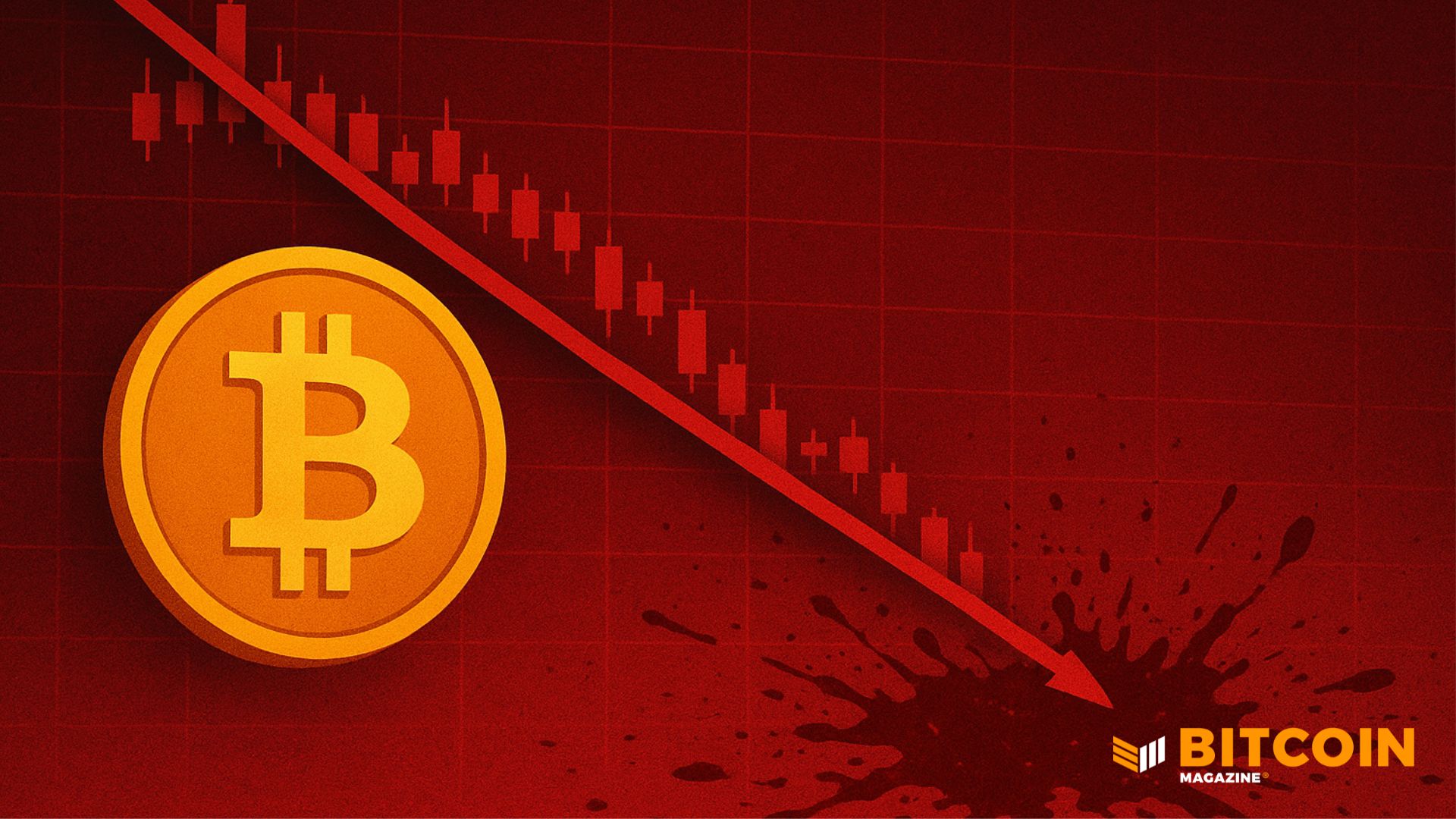
Bitcoin Price Craters to $107,000 as Fed Turns Cautious, Traders React to Trump–Xi Meeting
Bitcoin price tumbled sharply Thursday morning, falling to the low $107,000s as traders digested cautious remarks from Federal Reserve Chair Jerome Powell and mixed signals from the latest Trump–Xi meeting.
The bitcoin price drop erased last week’s rebound and extended the bitcoin’s weak October performance, weighed down by macro headwinds and China-U.S. trade relations.
The world’s largest cryptocurrency was down to $107,472 by early Thursday, according to Bitcoin Magazine Pro data, after briefly plunging to $107,925 overnight.
The move followed the Fed’s 25-basis-point rate cut on Wednesday — its second of 2025 — bringing the target range to 3.75%–4%. While the cut was widely anticipated, Powell’s message was clear: further easing this year is far from guaranteed.
There were “strongly differing views among policymakers,” Powell said during his post-meeting press conference, adding that the Fed might “wait a cycle” before considering another reduction.
The remarks rattled markets that had been pricing in a December cut, with CME FedWatch data showing probabilities for another move dropping from 90% to just 71% after his comments.
Risk assets broadly weakened yesterday. The S&P 500 finished flat, the Dow Jones Industrial Average slipped 0.2%, and the Nasdaq Composite managed a modest 0.6% gain. As of writing, markets for Thursday look bleak as well.
Bitcoin, which traded near $116,000 earlier in the week, sank as Powell spoke, briefly touching $109,000 in a sharp sell-off before stabilizing near $111,000 overnight.
The Fed’s tone also overshadowed what had appeared to be a positive outcome from the Trump–Xi summit. Following the meeting, President Trump said China would “immediately resume soybean purchases” and that “all rare-earth issues have been resolved.”
Still, it looks like traders remained cautious, focusing instead on the Fed’s hawkish pivot and the ongoing U.S. government shutdown, now entering its fourth week.
Institutional demand also showed early signs of weakness. U.S.-listed spot Bitcoin ETFs saw $470.7 million in outflows on Wednesday, ending a four-day inflow streak and marking the largest daily outflow since October 16, per Bitcoin Magazine Pro data.
Powell did confirm that the Fed is nearing the end of its Quantitative Tightening (QT) program — a move that could eventually boost liquidity in risk assets.
Since 2022, QT has drained nearly $1 trillion from the Fed’s balance sheet by allowing Treasury and mortgage holdings to mature without reinvestment.
Powell said the process could conclude by December but warned that future decisions remain data-dependent. Despite the sharp correction, analysts remain divided on Bitcoin’s near-term direction.
This post Bitcoin Price Craters to $107,000 as Fed Turns Cautious, Traders React to Trump–Xi Meeting first appeared on Bitcoin Magazine and is written by Micah Zimmerman.
Flutterwave, one of Africa’s largest financial infrastructure providers, has announced a partnership with Polygon Labs to leverage blockchain technology for cross-border payments.
Fresh off the thrill of @money2020, we’re teaming up with @0xPolygon to make cross-border payments faster, cheaper & more accessible than ever!
With Polygon Proof of Stake (PoS) powering our new solution, businesses and individuals will soon be able to move money across borders… pic.twitter.com/7vmr88zy8e
— Flutterwave (@theflutterwave) October 30, 2025
Under the multi-year collaboration, Polygon will become Flutterwave’s default blockchain network, powering a new cross-border payments product designed around stablecoins.
These digital currencies, pegged to traditional fiat currencies like the US dollar, are expected to streamline international payments by reducing the inefficiencies that have long plagued Africa’s $2 trillion cross-border market.
For many businesses, settlement can take several days, and fees often exceed 8%, creating significant operational challenges.
Flutterwave plans to pilot the new system in 2025 with a select group of verified merchants, before rolling it out more broadly to enterprises and consumers through its Send App in 2026.
The initial rollout will prioritise global corporations such as Uber and Audiomack, which already rely on Flutterwave’s existing payment infrastructure, while subsequent phases aim to bring the benefits of blockchain-powered stablecoins to millions of everyday users.
The partnership also positions Africa alongside other regions where Polygon is already enabling major fintech innovations, including Europe and Asia.
With over a hundred fintech companies globally using Polygon to move money efficiently, Flutterwave’s adoption of the network demonstrates the continent’s growing embrace of blockchain technology for real-world commerce.
For Flutterwave, this initiative represents more than a technological upgrade; it aligns with the company’s broader mission to simplify international payments for African businesses.
CEO Olugbenga “GB” Agboola explained that by making cross-border transactions faster, cheaper, and more accessible, the collaboration sets a new standard for financial inclusion while providing a scalable solution for global commerce.
By integrating Polygon’s high-performance blockchain, Flutterwave aims to cut both costs and settlement times dramatically.
Transaction fees on Polygon are typically fractions of a cent, and settlements can occur in near real-time.
Marc Boiron, CEO of Polygon Labs, highlighted the significance of this development, noting that stablecoins on Polygon can transform settlement periods from days into seconds and reduce fees from percentages into mere pennies.
This partnership not only reduces operational friction but also strengthens financial inclusion by making cross-border payments affordable and reliable.
For small merchants in Lagos, Nairobi, or Johannesburg, as well as individuals sending remittances, the technology promises to make previously cumbersome financial processes simpler and faster.
Flutterwave is taking a cautious approach to regulatory compliance, initially limiting the stablecoin service to verified merchants who meet enhanced Know Your Customer (KYC) and Know Your Business (KYB) standards.
Vincent Yang, Flutterwave’s Senior Product Manager for Stablecoins and Cryptocurrency, emphasised that the company is working closely with regulators to ensure that the service launches only in markets with appropriate regulatory support.
The integration is designed to be seamless for merchants, requiring no technical changes to Flutterwave’s existing API.
This approach allows businesses to access the new payment options without disruption, embedding blockchain capabilities into familiar systems rather than replacing them entirely.
The post African payment giant Flutterwave taps Polygon blockchain for cross-border payments appeared first on CoinJournal.

The rise of every new crypto presale sparks fresh discussions about usability, innovation, and community trust.
Many projects struggle to move beyond technical promises or complex jargon.
The presale crypto landscape in 2025 demands more than token speculation, it needs functionality that improves the Web3 experience.
This is where Mono Protocol has drawn attention. Its $MONO token presale has become a talking point across global DeFi and blockchain communities.
By addressing long-standing problems in accessibility and developer efficiency, Mono Protocol positions itself among the next potential big presale crypto projects shaping the presale ICO market this year.
The blockchain and crypto industry continue to face challenges that limit growth and adoption.
Mono Protocol identifies and aims to simplify many of these issues that stop users and developers from fully embracing Web3 and DeFi.
Through this new crypto presale, Mono Protocol emphasizes practical problem-solving rather than speculation, focusing on building stable foundations for the blockchain ecosystem.
At its current stage, the Mono Protocol presale has emerged as a key entry on the 2025 crypto presale list.
The Stage 15 presale features the $MONO token priced at $0.0450, offering an estimated potential profit of around 1011% at a projected launch value of $0.500.
This momentum has helped place Mono among the most-discussed crypto presale projects in 2025.
What separates it from other cryptocurrency presales is its focus on unifying on-chain experiences through cross-chain logic and universal balances.
Developers can build apps faster, users can transact seamlessly, and the system works across different blockchain networks without technical friction.
The Mono Protocol presale ICO illustrates how utility-driven innovation continues to capture global attention in a maturing DeFi market.
Mono Protocol introduces a gamified community layer through its Reward Hub, turning engagement into progress.
Here, users can explore quests, refer friends, and participate in presale challenges to earn bonus $MONO tokens.
Daily and weekly activities help users advance faster, unlocking unique promo codes and earning opportunities.
The Reward Hub also features a welcome bonus of up to 200%, creating more ways to stay active and connected.
This combination of learning, participation, and earning transforms what a coin presale community can look like.
It brings purpose and collaboration into the Web3 space, where progress depends on contribution rather than passive speculation.
Mono Protocol’s token utility centers on rewarding activity while ensuring platform transparency.
The upcoming Smart Contract Audit, set for October 30, reinforces the project’s commitment to safety and trust.
On November 7, the Launch Beta goes live, allowing early users to experience the system’s cross-chain mechanics firsthand.
Finally, the CEO Announcement and AMA on November 13 will share updates and developments around platform progress, reinforcing trust and communication within the community.
These milestones showcase how blockchain transparency, regular audits, and open leadership can strengthen the credibility of any crypto ICO presale.
Mono Protocol’s growth reflects a wider shift in the presale crypto 2025 market.
The focus is moving from speculation toward solving real issues in DeFi, scalability, and user experience.
By offering universal balances, seamless integration, and meaningful incentives, Mono Protocol highlights what the next generation of crypto presales should look like.
As the blockchain landscape continues to evolve, the projects that simplify complexity and prioritize utility are likely to sustain momentum.
Mono Protocol’s $MONO presale captures that spirit, marking its presence among the next potential big presale crypto opportunities reshaping how Web3 works today.
Learn more about Mono Protocol:
Website: https://monoprotocol.com/
X: https://x.com/mono_protocol
Telegram: https://t.me/monoprotocol_official
LinkedIn: https://www.linkedin.com/company/monoprotocol/
The post Mono Protocol’s $MONO token presale attracts attention across global crypto communities appeared first on CoinJournal.

Amid broader weakness, Avalon Labs fueled optimism through the blockchain industry after releasing its highly anticipated whitepaper.
The document highlights the firm’s mission for launching the world’s first AI-driven RWA marketplace, alongside an AI-MaaS (AI-Model-as-a-Service) platform, which merges blockchain with artificial intelligence.
Today, we’re excited to announce the official release of our Whitepaper for the industry’s first on chain AI-backed RWA marketplace and AI-Model-as-a-Service (AI-MaaS). The exclusive initial launch on @BNBCHAIN!
This marketplace is open to all GPU hardware owners and AI model… pic.twitter.com/1StYiyToN4
— Avalon Labs (@avalonfinance_) October 30, 2025
The new project will debut exclusively on BNB Chain, a move that could welcome lucrative opportunities for GPU owners and AI developers.
The move heralds the next stage of RWA tokenisation’s evolution – powered by innovations beyond blockchain, including self-learning AI programs and intelligent.
According to the announcement:
This marketplace is open to all GPU hardware owners and AI model developers. Our first launch will feature a Reinforcement Learning Model (RL Model) deployed by Avalon abs in collaboration with our AI partner, powered by H200 GPU hardware as the foundation.
Avalon Labs’ alt saw a sharp uptick following the whitepaper release.
AVL soared from the daily low of $0.1436 to $0.1668 – a 16% increase.
However, the digital token has retraced as hype fades and bearish broader sentiments.
Meanwhile, Avalon Labs plans to create a platform that supports artificial intelligence innovation.
The project aims to provide contributors and developers a fair environment to engage in the AI economy.
Beyond the AI-driven marketplace, Avalon Labs also introduced the CRT (Commercial Rights Tokenization) standard.
The concept introduces a new framework for tokenizing commercial rights linked to goods, services, and assets.
CRT might transform how businesses connect with investors and raise capital.
For instance, an enterprise can tokenize rights to future services or sales and offer them to customers via on-chain contracts.
The mode bridged blockchain with traditional commerce to provide a new option for SMEs to access liquidity as investors gain exposure to RWA streams.
The whitepaper highlighted:
CRT isolates and tokenizes commercial rights of access and service. This enables commodities, services, and goods to be legally structured, accessed, exchanged, and monetized through blockchain infrastructure in a regulatory-compliant manner.
Precisely, Avalon Labs is going beyond asset tokenization. It is tokenizing the rights that add value to those assets.
Avalon Labs’ native token decoupled from broader declines as the whitepaper sparked optimism.
AVL soared roughly 16% from a daily low of $0.1436 to $0.1668 intraday peak.
Its 24-hour trading volume surged 50% to signal trader enthusiasm.
Nevertheless, it has cooled to $0.1570 as hype fades, possibly as bears rattled the overall cryptocurrency sector.

Continued broader dups could see AVL erasing its latest gains before establishing a decisive trajectory.
The post Avalon Labs (AVL) releases whitepaper for AI-powered RWA marketplace appeared first on CoinJournal.

Brazil’s central bank is preparing to host one of Latin America’s most closely watched financial events next month, as global reserve managers gather in Rio de Janeiro for the Central Banking Autumn Meetings.
Among the top items on the agenda is the growing debate over whether Bitcoin and other cryptocurrencies could play a role in national reserves.
The meetings, as reported by local media, will bring together central bankers and policymakers from across the region to discuss new approaches to financial resilience, digital innovation, and inflation management.
Brazil’s participation marks a critical step in positioning the country at the centre of the region’s emerging digital asset strategy.
At the Rio meetings, Brazil’s representatives will join officials from Colombia, Jamaica, and the Bahamas to discuss how Bitcoin could be integrated into sovereign reserves.
The discussions will cover issues such as volatility, liquidity, and the potential of Bitcoin as a hedge against inflation.
This focus comes as Brazil’s lawmakers continue to evaluate a proposal to create a $19 billion sovereign Bitcoin reserve.
The plan, which was previously discussed in parliamentary hearings, seeks to position Bitcoin as both a strategic financial asset and a tool to diversify the country’s holdings.
During earlier sessions, policymakers heard from technical experts in the digital asset sector on how Bitcoin could serve as a reserve asset alongside gold and foreign currencies.
By taking these discussions to an international policy forum, Brazil is signalling that the question of Bitcoin reserves is no longer limited to domestic politics but is becoming a subject of regional collaboration.
Brazil’s renewed interest in digital reserves comes amid a wider global shift toward rethinking reserve composition.
In the United States, officials have begun evaluating a proposal to establish a strategic Bitcoin reserve that could act as a safeguard against economic shocks.
Although the plan is still in early stages, it has drawn significant international attention, prompting other economies to assess similar measures.
In Europe, Germany’s second-largest political party recently submitted a motion calling for the creation of a national Bitcoin reserve.
The proposal urged the government to consider Bitcoin as a protection against inflation and currency depreciation, reflecting growing institutional acceptance of digital assets within traditional finance.
Elsewhere, countries such as the Philippines and Pakistan have also initiated reviews of policy drafts that would allow Bitcoin to be recognised as a strategic asset.
While most central banks do not yet hold cryptocurrencies in their reserves, the shift in dialogue from speculation to formal policy review suggests the idea is becoming increasingly mainstream.
Brazil’s exploration of Bitcoin reserves is likely to overlap with its ongoing work on the Drex, the country’s central bank digital currency.
The Drex project aims to create a tokenised version of the Brazilian real that could facilitate interoperability between fiat and blockchain-based systems.
Experts believe that the infrastructure developed for Drex could eventually provide the technical foundation needed for managing reserve assets in digital form.
However, central banks worldwide still face challenges in safely storing, auditing, and reporting digital reserves. Market volatility and accounting standards remain major considerations.
For Brazil, next month’s meetings could help shape a roadmap for addressing these operational hurdles through regional cooperation.
The upcoming Rio meetings could mark a turning point for how Latin American economies view digital reserves.
With inflation pressures and currency volatility continuing to shape monetary policy, Bitcoin’s inclusion in sovereign strategies may no longer be a distant possibility.
Although no immediate policy shift is expected, Brazil’s leadership in hosting these discussions places it at the forefront of digital finance policymaking in the region.
The outcomes could determine how quickly central banks move from debate to implementation, setting the stage for future integration of Bitcoin into the global reserve system.
The post Brazil explores Bitcoin reserves as central bankers meet in Rio appeared first on CoinJournal.

Bank Indonesia (BI) is advancing plans to introduce a blockchain-based financial instrument described as the country’s “national stablecoin version,” a digital currency backed by government bonds.
The initiative was unveiled by BI Governor Perry Warjiyo at the Indonesia Digital Finance and Economy Festival and Fintech Summit 2025 in Jakarta.
It reflects Indonesia’s effort to integrate blockchain technology into its monetary system through tokenised securities tied to the digital rupiah. The announcement was first reported by CNBC Indonesia.
The central bank said the new digital assets will take the form of tokenised government securities backed by the central bank’s planned digital rupiah, Indonesia’s central bank digital currency (CBDC).
The project is designed to blend monetary innovation with national financial stability, positioning Indonesia among a handful of emerging economies developing bond-backed digital assets.
According to Warjiyo, the bank will issue digital versions of its securities, referred to as Bank Indonesia securities in digital form, which will operate as blockchain-based representations of sovereign bond holdings.
These digital securities will be backed by the digital rupiah, making them the foundation of what the central bank describes as Indonesia’s national stablecoin.
He explained that the stablecoin structure would rely on government bonds, or Surat Berharga Negara (SBN), as its underlying collateral, ensuring that its value remains tied to official assets rather than speculative cryptocurrencies.
The initiative marks a step towards tokenising the country’s debt market, creating an ecosystem where digital securities, stablecoins, and the central bank digital currency coexist.
Warjiyo said the plan reflects BI’s broader digital finance strategy aimed at improving transparency, efficiency, and liquidity across financial markets.
If successful, it could reshape how monetary authorities interact with blockchain infrastructure in Southeast Asia.
The introduction of the bond-backed digital rupiah is expected to strengthen Indonesia’s transition towards a blockchain-integrated economy.
While stablecoins are not currently recognised as legal tender, their use in payments and remittances has increased, prompting regulatory attention from Indonesia’s Financial Services Authority, known as the OJK.
Dino Milano Siregar, who leads the OJK’s crypto and digital asset division, said the agency enforces anti-money laundering (AML) compliance and requires periodic reporting from stablecoin traders.
The OJK’s supervision reflects growing awareness of the potential systemic role of digital assets, even without formal recognition as payment instruments.
Siregar added that stablecoins are already being used as hedging tools, especially those backed by credible assets such as government bonds or reserve currencies.
Their comparatively lower volatility makes them appealing for remittance transactions and cross-border settlements.
This practical use case aligns with BI’s ambition to institutionalise a regulated form of stable value exchange through the digital rupiah.
Indonesia’s rapid shift towards digital finance is underpinned by strong adoption trends. The country ranks seventh in the 2025 Global Crypto Adoption Index published by Chainalysis.
It placed ninth in retail activity, seventh in value received through centralised exchanges, and fourth in decentralised finance (DeFi) transactions.
These figures highlight Indonesia’s growing role in global digital asset markets.
In August, local advocacy group Bitcoin Indonesia reported that government officials were exploring Bitcoin as a potential reserve asset, with discussions centred on how such holdings could diversify national reserves and stimulate economic growth.
If Indonesia proceeds with its stablecoin framework alongside its digital rupiah and potential Bitcoin reserve diversification, it could emerge as a major blockchain hub in Asia.
The combination of regulatory oversight, tokenised government debt, and CBDC integration places Indonesia among countries like China and Singapore that are redefining the future of sovereign-backed digital assets.
The post Bank Indonesia moves to issue a national stablecoin backed by government bonds appeared first on CoinJournal.


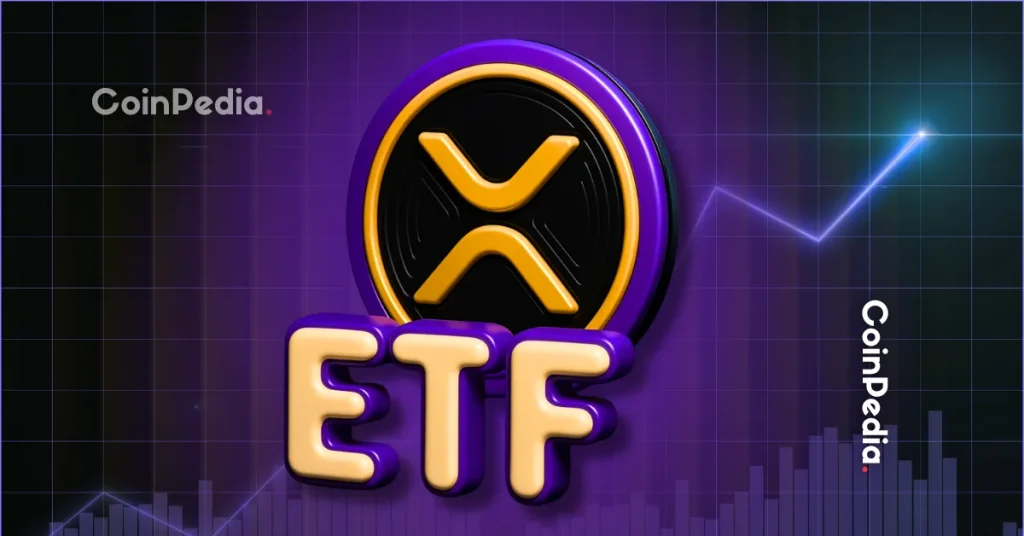
The post XRP ETF Timeline 2025: Grayscale Explains Why Launch Hasn’t Happened Yet appeared first on Coinpedia Fintech News
Wall Street just witnessed a big milestone as the first-ever spot ETFs for Solana (SOL), Litecoin (LTC), and Hedera (HBAR) officially began trading. The launches mark a new phase for altcoin-based investment products, opening the door for institutional investors to gain direct exposure to some of crypto’s fastest-growing networks.
But amid the celebration, one question dominated conversations across the crypto community — where is the XRP ETF?
Addressing the question on Paul Barron Podcast, Zach Pandl, Head of Research at Grayscale Investments, explained the situation in clear terms. According to him, the main reason XRP’s ETF didn’t launch alongside the others was due to timing and regulatory progress before the recent U.S. government shutdown.
“It’s a relatively simple answer,” Pandl said. “Issuers like Grayscale were a bit further along with regulators on Solana than on several of the other potential crypto ETF products at the time of the government shutdown. As soon as the government reopens, we expect to move quickly on the rest of these tokens.”
In other words, it wasn’t about preference or strategy, it was about which filings had progressed the furthest when the U.S. Securities and Exchange Commission (SEC) paused activity during the federal closure. XRP’s ETF is still on Grayscale’s list, but the timeline was simply disrupted by regulatory delays.
Pandl also reassured the XRP community that Grayscale intends to launch an XRP ETF, along with other digital assets, once the regulatory environment allows. He said that the company is committed to building a diverse lineup of crypto investment products, not favoring one blockchain over another.
“We’re proud to bring Solana’s ETF to market, and we’ll be proud to bring others, including XRP,” Pandl said. The goal is to create balanced portfolios that reflect the growing utility across different blockchain networks.
While some XRP holders were disappointed that Solana, Litecoin, and Hedera made it to Wall Street first, Grayscale’s statement confirms that an XRP ETF is still very much in play. Once the U.S. government fully resumes operations and ETF reviews restart, XRP could be among the next batch of crypto ETFs to launch.
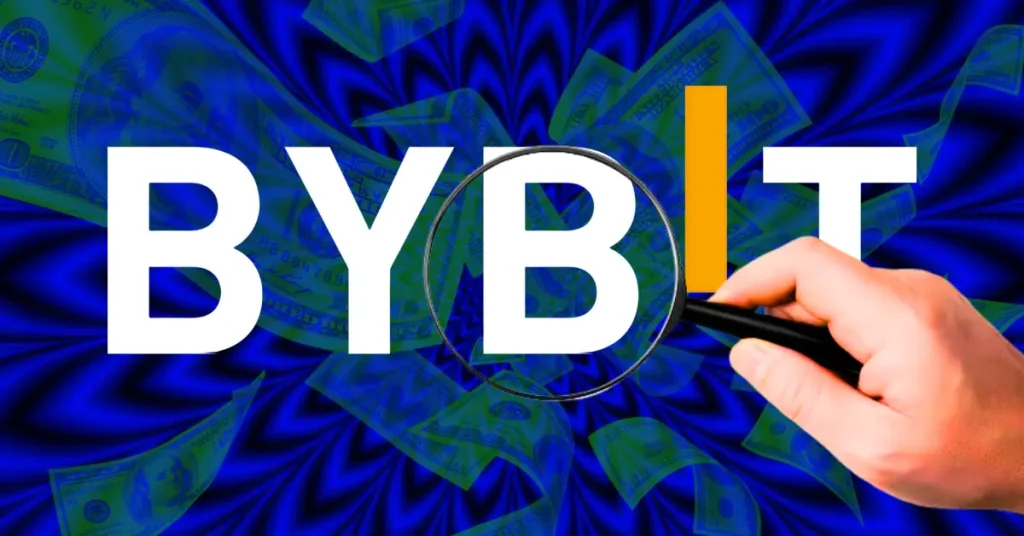
The post Bybit Freezes New User Registrations in Japan to Comply with FSA Rules appeared first on Coinpedia Fintech News
Bybit, one of the world’s largest cryptocurrency exchanges, has announced that it will halt new account registrations for users in Japan. This move highlights the company’s effort to align with Japan’s regulatory framework.
The suspension will take effect on October 31, 2025, at 12:00 p.m. UTC.
Bybit notes that this move is part of its proactive approach to embrace local regulations and stay aligned with the evolving framework set forth by Japan’s Financial Services Agency (FSA).
“It has always been Bybit’s commitment to operate responsibly and in compliance with local laws and regulatory expectations,” it said.
The exchange notes that this decision will allow Bybit to focus on its efforts and resources to review local regulatory requirements and evaluate the best ways to meet the standards outlined by Japanese authorities moving forward.
Bybit notes that there will be no immediate changes to the services available for existing Japanese users for now and the exchange will issue further updates if new regulatory measures are introduced in the future.
This come as the FSA is exploring a major policy shift that could allow banks to buy and hold cryptocurrencies for investment purposes. The regulator is also weighing in to let banking groups obtain licenses as cryptocurrency exchange operators, which would allow them to directly provide crypto trading and custody services.
Meanwhile, Japan’s crypto market is also gaining momentum.
According to a report from Chainalysis, Japan saw the strongest growth among APAC’s top five markets. On-chain activity in the country jumped 120% in the year to June 2025, compared to the previous year and outpaced other markets like Indonesia, South Korea, India, and Vietnam.
Although Japan’s market had been subdued in recent years compared to its neighbours, the latest growth comes amid several policy changes that are expected to drive steady growth in the long run.
Japan is also planning to roll out new rules banning insider trading in cryptocurrencies, with violators facing surcharges based on how much they gain through illicit transactions.
This move is another sign of Japan’s intention to strengthen market transparency and investor protection as the crypto sector continues to expand.

The post TAO Price Prediction 2025: Will Bittensor’s ETP Launch and Halving Push TAO Toward $678? appeared first on Coinpedia Fintech News
The TAO price prediction 2025 outlook aims for $678 target before the year concludes. This optimism stems from Bittensor’s momentum building ahead of its halving and the launch of a new staked ETP.
Currently, the TAO price today is approaching $425, marking six consecutive days of gains. Traders are eyeing a sustained breakout once it sustains above $450 with a daily close. Also, the latest ETP news is why optimism is higher, as growing institutional interest amplifies market optimism.
The late October Bittensor rally coincides with a major development as Deutsche Digital Assets and Safello are set to debut a staked TAO Exchange Traded Product (ETP) on the SIX Swiss Exchange in November.
The product, titled STAO, will provide investors with exposure to both TAO’s price performance and staking rewards, while maintaining an expense ratio of 1.49%.
This launch marks a significant milestone for TAO crypto, signaling its growing presence in regulated financial markets. As institutional access expands, investor confidence may strengthen further, potentially boosting TAO price forecast discussions for 2025.

Meanwhile, derivatives data reinforces this narrative. According to CoinGlass, TAO futures Open Interest rose from $312 million to $317 million in intraday indicating growing leveraged participation. Furthermore, the funding rate flipped positive from -0.0018% to 0.0048%, underscoring bullish conviction among traders betting on higher prices.
Adding to the bullish momentum, TAO price chart dynamics are increasingly influenced by the upcoming Bittensor halving, expected in roughly 44 days. The event will cut daily TAO emissions from 7,200 to 3,600, tightening supply and potentially driving prices higher if demand continues to build.
Historically, halving events across major blockchain networks have reduced sell-side pressure and introduced scarcity, setting the stage for post-halving rallies. For TAO crypto, this reduced issuance rate could magnify the impact of growing institutional interest and investor inflows following the ETP debut.
This combination of fundamental and macro factors positions TAO price USD for an extended uptrend through 2025, provided broader market sentiment remains supportive.
Technically, TAO price has been trading within a wedging structure, recently reclaiming strength after deviating into a green demand region, according to Rekt Capital.
That retest helped reestablish momentum, leading price toward the wedge’s upper boundary near $449.36, which is now acting as resistance.
If TAO secures a weekly close above $449.36, it could reclaim this level as support and re-enter its macro range defined between $449.36 and $678.13.
Rekt Capital also mentions that the historical data shows that confirmed closes above this zone have typically preceded rallies covering nearly 50% of the macro range.
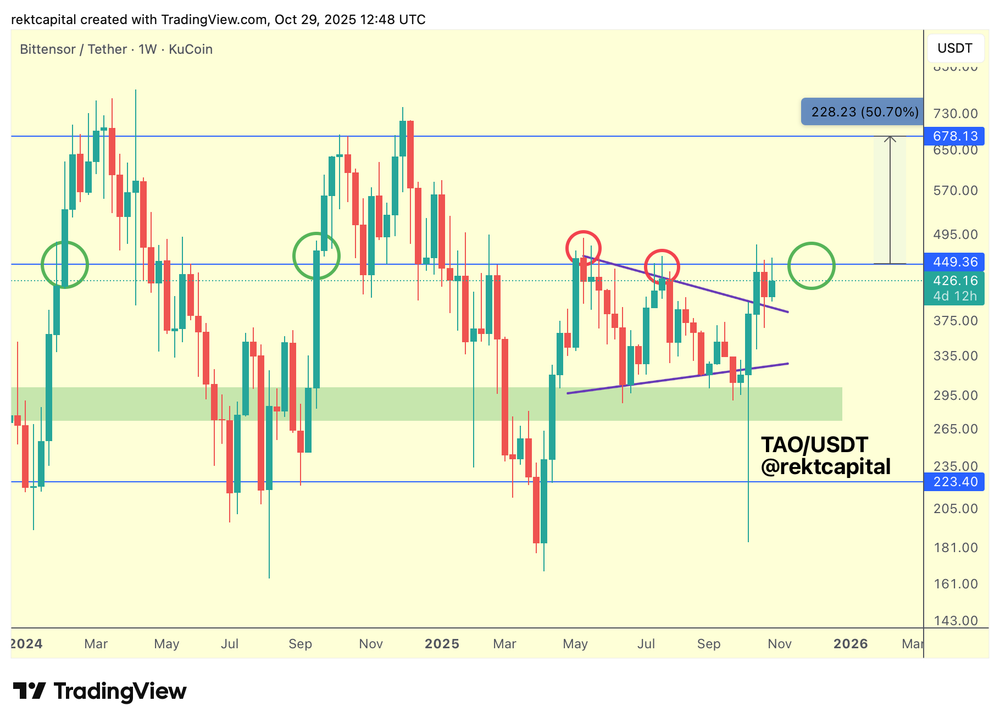
Moreover, the shallower pullbacks observed after each rejection indicate a tightening of supply and rising demand, a sign of strength in the market structure. Sustaining this pattern could open the pathway toward TAO price prediction 2025 targets around $678, potentially even higher if bullish catalysts align post-halving.

The post Avalon Labs Launches On-Chain AI Marketplace on BNB Chain: Details appeared first on Coinpedia Fintech News
Avalon Labs has made a big move in combining artificial intelligence and blockchain. The company released its whitepaper introducing the world’s first on-chain AI-powered RWA marketplace and a new concept called AI-Model-as-a-Service (AI-MaaS).
The project is backed by YZi Labs and Framework Ventures and launched exclusively on BNB Chain.
“Today, we’re excited to announce the official release of our Whitepaper for the industry’s first on-chain AI-backed RWA marketplace and AI-Model-as-a-Service (AI-MaaS),” Avalon Labs said on X.
Traditionally, AI developers rent GPU hardware to train or run their models. Avalon is changing that. Instead of just renting computing power, its marketplace lets users access ready-to-use AI models that are already optimized and trained using reinforcement learning.
This approach, called AI-Model-as-a-Service, makes it easier for developers and enterprises to use advanced AI without managing hardware or complex training setups.
The first model is built on H200 GPU hardware, offering faster and more efficient access to high-performance AI systems.
Alongside the marketplace, Avalon introduced a new standard called Commercial Rights Tokenization (CRT). It’s a different take on how real-world assets (RWAs) are brought to the blockchain.
Instead of tokenizing ownership or securities, CRT tokenizes commercial rights – such as the right to use, access, or rent a service. These rights are legally recognized under U.S. commercial law (UCC Articles 7, 9, and 12), giving token holders enforceable claims.
In simple terms, Avalon’s model focuses on utility. It allows things like compute time, goods, or services to be represented as legally valid digital tokens.
Avalon’s new marketplace works on a two-tier structure that mirrors traditional finance models:
Both tokens represent rental rights. This setup combines predictable access for institutions with flexible opportunities for retail or DeFi users.
Avalon’s whitepaper also details a strong risk management system with automated contract monitoring, liquidity rules, and clearly defined redemption windows. These features aim to make the marketplace transparent and secure.
By bringing AI, blockchain, and real-world assets together, Avalon Labs is positioning itself as a key player in the next wave of digital infrastructure.
The project’s mix of legal backing, on-chain transparency, and real-world use cases could set a new benchmark for how AI and DeFi work together.
Stay ahead with breaking news, expert analysis, and real-time updates on the latest trends in Bitcoin, altcoins, DeFi, NFTs, and more.
Avalon Labs launched the world’s first on-chain AI-powered RWA marketplace and introduced AI-Model-as-a-Service (AI-MaaS) on the BNB Chain.
AI-MaaS lets users access pre-trained AI models directly through a blockchain marketplace, removing the need for costly hardware or training setups.
CRT tokenizes commercial rights—like access or usage rights—into legally recognized digital tokens under U.S. commercial law for secure transactions.

The post “Would Be Great to See Trump Hold Head of Anti-Crypto Army Accountable,” Says Political Commentator Eagleman appeared first on Coinpedia Fintech News
President Trump’s pardon of Binance’s CZ has sparked broader debates in the industry.
The decision drew sharp reactions from lawmakers and has also added new layers to the debate over accountability and fairness.
Gunther Eagleman, a commentator on social media platform X, has raised questions about the legal implications of the comments made by Senator Elizabeth Warren, citing legal analysis from Teresa Goody Guillén, a former SEC attorney and current partner at BakerHostetler.
Eagleman questioned whether Senator Warren’s remarks crossed legal boundaries and also brought up the idea if Warren’s actions could be considered obstruction of justice.
Political commentator Eagleman on Warren: 'Would be great to see the Trump Administration hold the head of the anti-crypto army accountable' | Globe Banner https://t.co/UQ27eaQhJ3
— CZBNB (@cz_binance) October 30, 2025
Guillén recently responded to Senator Warren by citing the 1979 Supreme Court case Hutchinson v. Proxmire. She noted that the Speech or Debate Clause only protects lawmakers when they are doing official legislative work.
However, the protection does not cover any false or misleading information outside of the legislative proceedings.
Great article @CGasparino! I may know something about this…
— Teresa Goody Guillén (@teresagoody) October 29, 2025I’m glad to see that Grok agreed with my assessment. https://t.co/X03MLrBnXh pic.twitter.com/RjHptZDTZB
Eagleman also agreed with her point and called for accountability over Warren’s stance on crypto policy. “Would be great to see the Trump Administration hold the head of the anti-crypto army accountable,” he added.
According to the Supreme Court decision, members of Congress are not protected by the Speech or Debate Clause when they share information through press releases or newsletters.
This means that in some situations, the defamation claims can proceed when the lawmakers are criticized for their statements outside of their official duties.
This comes after President Trump recently pardoned Binance founder Changpeng “CZ” Zhao. The pardon faced strong criticism from several senators and sparked a direct clash between CZ and Senator Warren.
CZ also announced plans to sue Warren for defamation, claiming that she spread false information about money laundering charges that never existed. Guillén, his attorney, has already sent Warren a formal letter demanding an immediate retraction. The letter warns that if she fails to respond, a defamation lawsuit will follow.
Several X users weighed in on the growing influence of politics in the market. While some highlighted the fine balance between necessary regulation and government overreach, others called for fairness, saying that innovation in the U.S. can only thrive if both regulators and builders are held accountable.
Some users also noted that the conflict between regulation and innovation is more political than technical. “What we’re seeing isn’t a crypto war, it’s a struggle over who controls the next financial system,” the user wrote, emphasizing that accountability matters, but clarity matters more.
Stay ahead with breaking news, expert analysis, and real-time updates on the latest trends in Bitcoin, altcoins, DeFi, NFTs, and more.
President Trump pardoned CZ as part of his broader push for crypto innovation, arguing the justice system had been too harsh on industry leaders.
Yes, if remarks are made outside official duties, lawmakers can face defamation claims, as they’re not fully protected under the Speech or Debate Clause.
The crypto community is split—some see it as justice and support for innovation, while others warn it raises new questions about accountability in regulation.
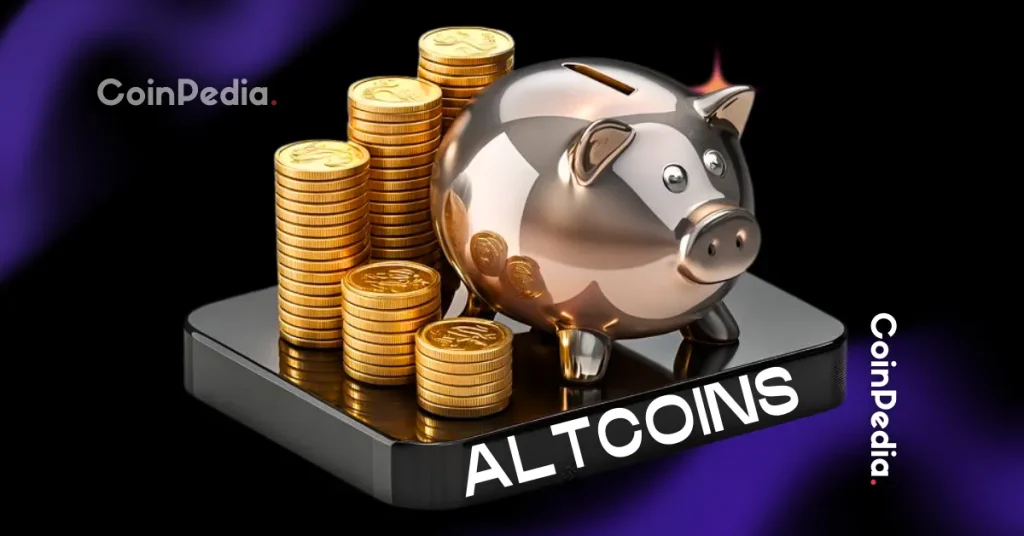
The post The Best Penny Cryptos of 2025 – Learn Why these 3 Altcoins are Primed to Explode in Q4 appeared first on Coinpedia Fintech News
Looking for the best penny cryptos of 2025? On the list of the best cryptocurrencies to invest in without breaking the bank are the Shiba Inu coin, TRX crypto and Digitap ($TAP). Top altcoins like TRX and SHIB, despite their popularity, are budget-friendly and are primed to skyrocket in Q4.
Meanwhile, $TAP, an emerging DeFi-TradFi coin, has more room to run as a low-cap coin. In addition to its upside potential, experts hold a bullish stance due to its innovative solution in the cross-border payments market. By blurring the line between cash and crypto, it has been dubbed the future of finance.
Digitap, unlike SHIB and TRX, is an up-and-coming cryptocurrency with more room to run. Given its upside potential and DeFi-TradFi narrative, it is considered the best cheap crypto to buy now at $0.0268. With bids flying and investors betting accumulating, funding in presale has quickly surpassed the $1 million fundraising milestone.
Currently in its second ICO round, a 10% upswing to $0.0297 is expected in the next round. Unsurprisingly, FOMO is building. However, the projected 25x gain after its market debut in Q4 makes it arguably the best crypto to invest in long-term.
Further, its transformation of the cross-border payments market not only gives a bullish outlook but also sets it up for mainstream adoption. Before, users had to juggle multiple applications, wallets and accounts to manage their assets, but not anymore.
As the world’s first omni-bank, Digitap allows users to hold multiple assets and spend from one unified balance. In addition to this is the power of Visa and the ease of Apple Pay and Google Pay.
USE THE CODE “MILLION30” FOR 30% OFF FIRST-TIME PURCHASES
The Shiba Inu coin costs just $0.000010—investors working with a tight budget can easily position themselves for significant returns. What makes it poised to explode in Q4?
As the leading ERC-20 memecoin, attention shifting to the Ethereum ecosystem is expected to push the Shiba Inu coin price upward. Top analyst Javon predicts a jump to $0.000081, positioning it among the best altcoins to invest in.
Additionally, the consistent SHIB token burn is a bullish catalyst over the long term. At the same time, the growing adoption of its Layer-2 scaling solution, Shibarium, may propel the Shiba Inu coin price past previous highs, making it a good crypto to buy now.
While currently in a downtrend, marked by an 8% dip on its weekly chart, a TRX crypto price reversal is on the table. Tagged a healthy correction, a retest of higher levels is imminent, with the Layer-1 coin currently trading around $0.29.
At the same time, bold price predictions have been flying, highlighting its potential. Vuori Trading, a top analyst on X, is optimistic that the TRX crypto will trade between $0.47 and $1.39. Currently in an attractive buy zone, it might be a smart move in hindsight.
Can't believe I've ignored $TRX
— Vuori Trading (@VuoriTrading) October 25, 2025
This thing has been a money printing machine during these turbulent times!!??
I'm starting to park profits into this cause the trend is obvious! And as we know: the trend is your friend until the end.
I'm expecting $0.47-1.39 in the long… pic.twitter.com/P4zUQtUg5c
Factors expected to drive the price are growing institutional demand and adoption. According to DefiLlama, TRON has a stablecoin market cap of $78 billion (98% USDT dominance) and $1.3 million in fees in the last 24 hours. These on-chain metrics give the TRX crypto a bullish outlook.
While the Shiba Inu coin and TRX crypto are poised to surpass previous highs, $TAP is considered the best new crypto to buy due to its small market cap and DeFi-TradFi narrative. A 25x gain is projected in Q4 after its launch, making it a must-have. Its blend of traditional banking and decentralized finance further sets it up for adoption and growth.
Discover the future of crypto cards with Digitap by checking out their live Visa card project here:

The post Bybit Halts New User Registrations in Japan from October 31 appeared first on Coinpedia Fintech News
Starting October 31, Bybit will stop accepting new user registrations from Japan to comply with local regulatory guidelines aimed at protecting investors. Existing Japanese users can continue using the platform for now, but further restrictions may be introduced in the future. Bybit has faced warnings from Japan’s Financial Services Agency in 2021 and 2023 for operating without proper registration. This move reflects Bybit’s commitment to following evolving regulations and working closely with Japanese authorities.

The post XRP Price Prediction 2025: Can Whale Accumulation and ETF Hopes Drive XRP Toward $4 and Beyond? appeared first on Coinpedia Fintech News
October is nearing its completion, and November is just around the corner. As the year enters its final months, the XRP price prediction 2025 narrative is intensifying amid a positive macroeconomic environment, with people linking the possibilities of similar momentum last seen in late 2024.
When writing, it is XRP price today is trading near $2.53, with rising whale accumulation and renewed optimism for a spot ETF approval, XRP crypto could soon retest the critical $3.50 resistance and potentially extend its rally toward $4 or higher.
In late October, XRP price briefly climbed to $2.70 before pulling back to $2.53, maintaining a strong $152 billion market cap and $5.87 billion in daily volume.
The slight retreat came after the Federal Reserve’s second consecutive interest rate cut, paired with a cautionary statement that December’s cut was “not a foregone conclusion.”
Despite short-term volatility, the data paints a bullish picture. Whale accumulation surged in the last week of October. Moreover, CryptoQuant’s XRP Whale Flow 30-DMA has turned positive for the first time in four months that’s a signal that whales are re-entering accumulation mode, often preceding strong uptrends.
This rising on-chain activity and accumulation trend has made XRP price forecast discussions notably important for traders and investors, as the asset outlook is more optimistic heading into November.
From a technical standpoint, the XRP price chart shows a large cup-and-handle formation developing since 2020. This structure suggests that the asset may be building the foundation for a significant long-term rally.
If the pattern confirms, XRP price could aim for the $4–$10 range in 2025, aligning with the broader market’s risk-on sentiment and institutional inflows. Breaking above the key resistance at $3.50 would be a crucial milestone that could confirm the next bullish phase.

This chart setup reflects growing conviction among traders that XRP crypto could regain leadership among top altcoins in the coming year, particularly if global liquidity improves and ETF approvals accelerate market participation.
Regulatory clarity remains another crucial factor. Market participants are closely monitoring the SEC’s pending decision on several spot XRP ETF applications. If approved, such products would likely open the floodgates for institutional capital, similar to what was seen with the introduction of Bitcoin and Ethereum ETFs.
The combination of multiple factors paints a scenario where XRP price prediction 2025 may lean decisively upward in the months ahead.
Analysts expect XRP could reach between $4 and $10 in 2025 if whale accumulation and ETF approvals continue driving strong market demand.
Yes. A spot XRP ETF could attract large institutional investors, increasing liquidity and potentially pushing XRP toward new highs in 2025.
While XRP shows strong momentum, investors should research carefully and manage risk, as crypto markets remain volatile despite bullish signals.

The post This Altcoin Priced at $0.035 Is Set to Mirror Solana’s (SOL) Recent Momentum appeared first on Coinpedia Fintech News
Solana had surged from $8 lows in late 2023 through volatile swings into 2025, reaching an all-time high near $295 by early that year. Investors watched as SOL captured explosive gains amid broader crypto market recoveries.
Now, another altcoin priced at $0.035 has drawn similar eyes, positioning itself as the best crypto to buy now for those seeking momentum plays. Mutuum Finance (MUTM) holds $18,150,000 since its presale started with 17,530 total holders. Phase 6 tokens are going for $0.035, up 250% from the start of phase one, where the token was $0.01.
This altcoin has very much the same footsteps as Solana, combining DeFi utility and well-timed entry points in a recovering market. Similar to SOL’s path bumping it to the top of CoinsMarketCap’s list, early validators hope that their investment on the platform can help them be listed on major exchanges.
Solana has been hammered to $8 during 2023 bear pressures, but traders could see resilience in the high-speed blockchain. By mid-2024, SOL kept rising steadily reaching $150 as adoption grew. Developers created thriving ecosystems around it and took in billions. Then, in early 2025, SOL launched to $295 after a 3,587% move away from The lows.
Borrowers and lenders flocked to its network, mirroring real-world asset integrations. APYs hit 8-12% on stable pools, drawing passive income seekers. Yet, volatility tested holders; dips followed peaks. Solana proved altcoins could rebound fiercely, rewarding those who timed entries right. This pattern now inspires scans for the next crypto to buy now, where utility drives sustained lifts.
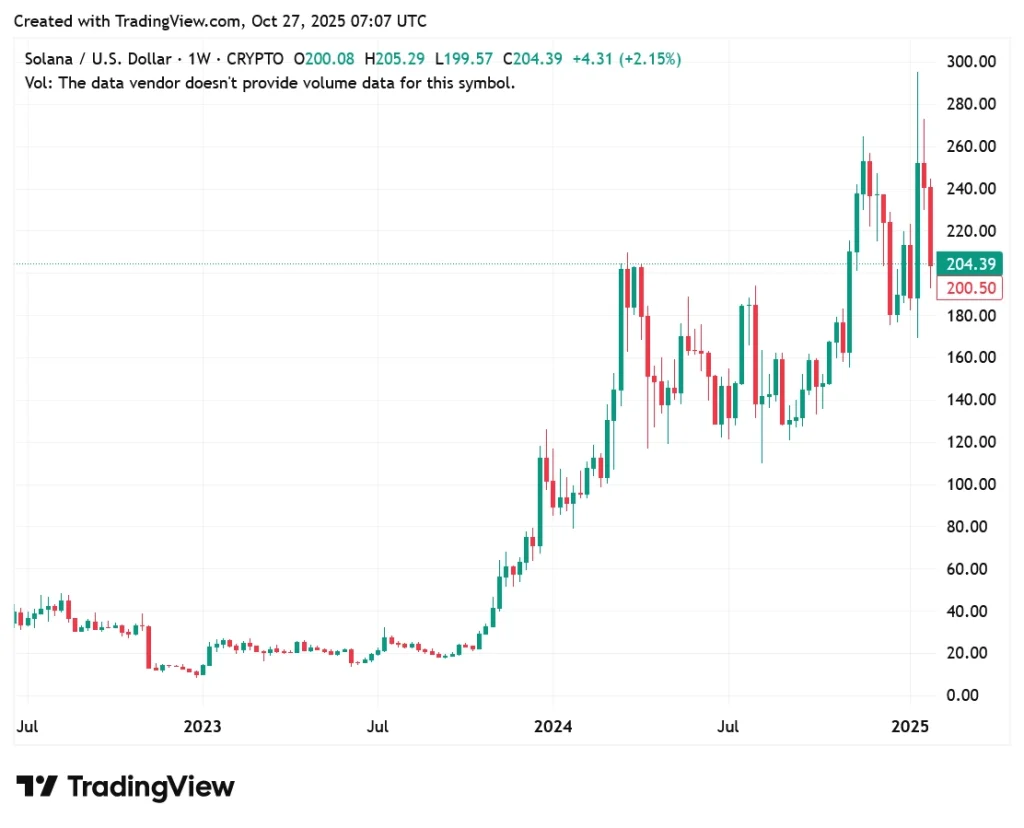
Mutuum Finance (MUTM) has structured its presale across 11 phases, with phase 6 now 80% filled at $0.035 per token. Buyers have scooped up allocations swiftly, pushing urgency as funds hit $18,150,000 overall. Holders number 17,530 since launch, signaling broad appeal in this best crypto to buy scenario. The price jumped 250%, or 3.5x, from phase one’s $0.01 base. Phase 6 sells out fast; the window to grab tokens this cheap closes soon.
Next, phase 7 opens at $0.04, a 14.3% hike. Launch targets $0.06, offering current buyers a 420% ROI post-deployment. Investors who delay risk higher barriers, watching others lock in gains early. This altcoin’s phased model fosters steady builds, much like Solana’s foundational surges.
Mutuum Finance (MUTM) recently unveiled a dashboard tracking the top 50 holders, sparking daily rivalries. The 24-hour leaderboard update rewards the number one spot with a $500 MUTM bonus, tied to at least one transaction in that window. It resets at 00:00 UTC, keeping momentum alive.
Top past-24-hour buys included $622.71, $500, $502.75, and $382.09, highlighting diverse participation. To celebrate, Mutuum Finance (MUTM) runs a giveaway awarding $100,000 in MUTM split among 10 winners—each getting $10,000—after a minimum $50 presale investment qualifies entrants. Such tactics build loyalty, positioning this best crypto to invest in as a community anchor.
Lenders deposit ETH or USDT into pools, earning 5-10% APYs passively; borrowers access funds against collateral. For instance pledging $10,000 ETH for $7,500 loans at 75% LTV. These features promise real yields, tying into roadmap launches alongside the token.
Mutuum Finance (MUTM) has launched its official bug bounty program in partnership with CertiK. MUTM has set aside $50,000 USDT for rewards. The bounty splits into four tiers. These are based solely on severity, assigning payouts to each vulnerability level. This move fortifies the protocol ahead of deployment.
Meanwhile, the team confirmed via official X post that V1 protocol debuts on Sepolia testnet in Q4 2025, featuring liquidity pools, mtTokens, debt tokens, and a liquidator bot. ETH and USDT kick off lending, borrowing, and collateral roles, with expansions planned post-testing. Audits scored high, underscoring reliability for what crypto to buy now. Peer-to-contract pools generate yields automatically; peer-to-peer matches enable custom terms for niche assets, diversifying risks.
Mutuum Finance (MUTM) channels Solana’s proven momentum through DeFi tools that reward active users. Investors have poured in despite market dips, eyeing 420% post-launch returns from $0.035 buys. Phase 6’s near-sellout amplifies the altcoin’s pull, urging quick action before $0.04 arrives. This best crypto to buy now blends passive APYs with secure borrowing, fostering growth akin to SOL’s ecosystem boom. Secure your spot in the presale today to capture the upside.
For more information about Mutuum Finance (MUTM) visit the links below:
Website: https://mutuum.com/
Linktree: https://linktr.ee/mutuumfinance

The post Avalon Labs Introduces AI RWA Platform appeared first on Coinpedia Fintech News
Avalon Labs has introduced an AI-powered blockchain marketplace for real-world assets (RWAs) along with the AI-MaaS concept. They rolled out a Reinforcement Learning model on the BNB Chain and launched CRT, a new token standard granting legal commercial rights. Backed by YZi Labs and Framework Ventures, this project aims to revolutionize asset management by combining AI’s power with blockchain technology, delivering more efficient, transparent, and accessible decentralized finance solutions.

Bitcoin MACD’s bearish crossover and the duration after BTC’s last halving could be signs that the 2025 bull run is over, or is this time different?

Bitcoin fell to the bottom of its local range as traders lost over $1 billion as a result of the surprise BTC price downside after the Fed interest-rate cut.
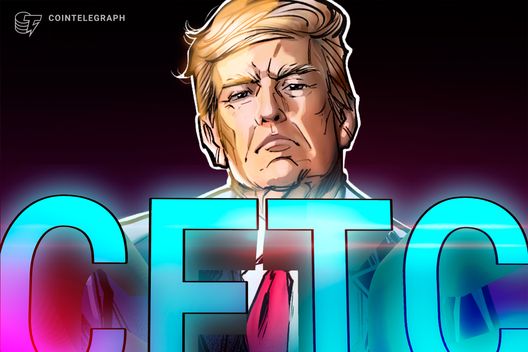
The Trump administration has appointed Michael Selig, a pro-crypto lawyer and SEC counsel, to head up the CFTC.

ChatGPT cannot time crashes but can flag early warning signs by merging onchain, derivatives and sentiment data, helping traders detect risk clusters before markets break.
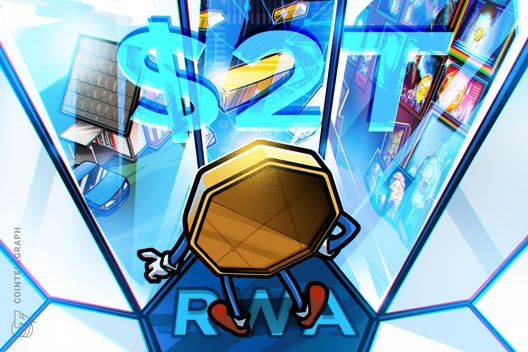
The $300 billion stablecoin market capitalization pushed DeFi into a “self-sustaining cycle” of growth, according to the investment bank’s head of research.

Point-in-time audits fail in composable, adversarial markets. AI-powered continuous assurance using solvers and simulation replaces episodic security checks.

CEO David Bailey told Forbes he plans to fold Bitcoin Magazine, the Bitcoin conference and hedge fund 210k Capital into Nakamoto Holdings to boost cash flow.

JPMorgan is moving forward with the launch of its fund tokenization platform, Kinexys Fund Flow, with the rollout planned for 2026.
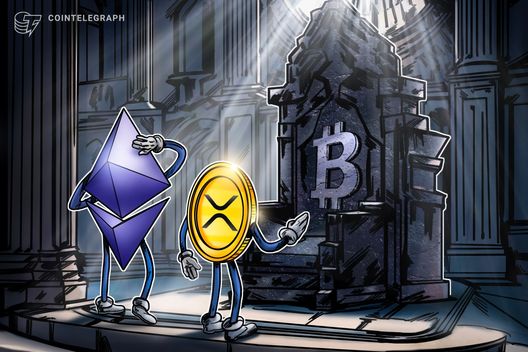
What if Bitcoin crashes? Will Ether and XRP fall with it or hold their ground? Discover how a BTC slump could rattle the entire crypto market.

Bitcoin fell 35% after the Fed ended QT in 2019 and began cutting rates, prompting fears that BTC may decline in the coming months.

Bybit’s pause comes as Japan’s FSA considers reforms that could allow banks to hold Bitcoin and operate licensed exchanges.

Ethereum price wobbled as weak onchain activity and low futures demand supported a potential ETH price drop to $3,500.

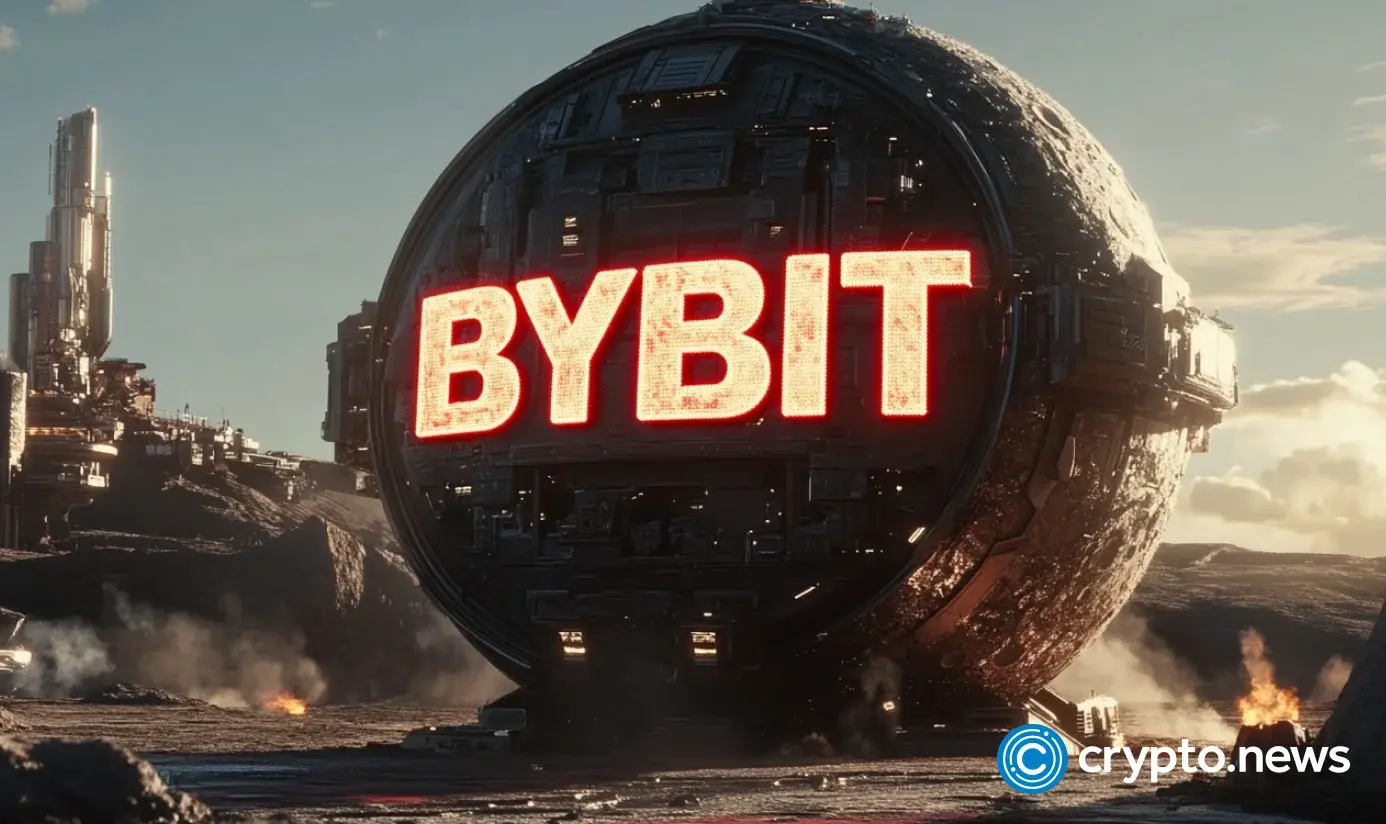


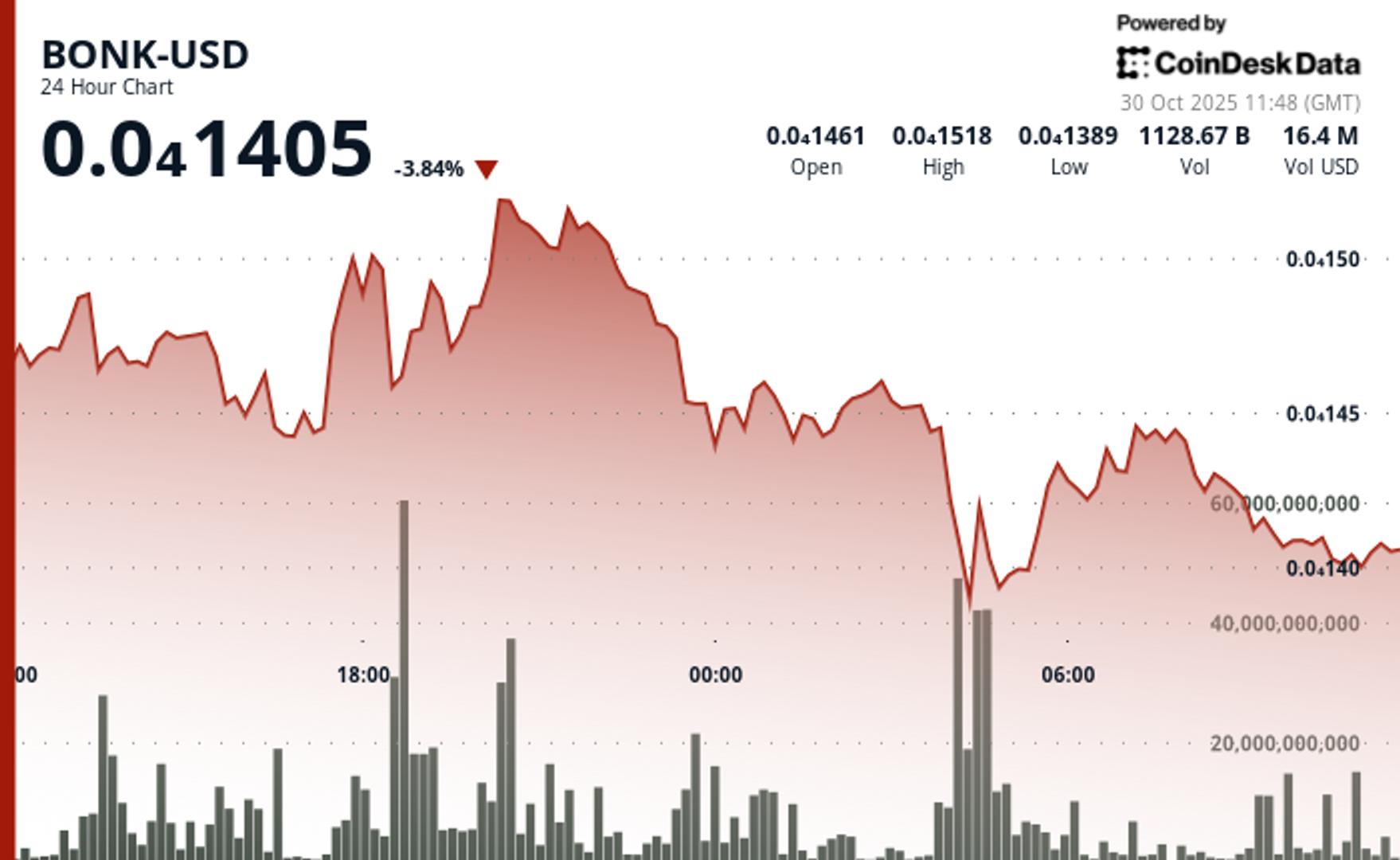

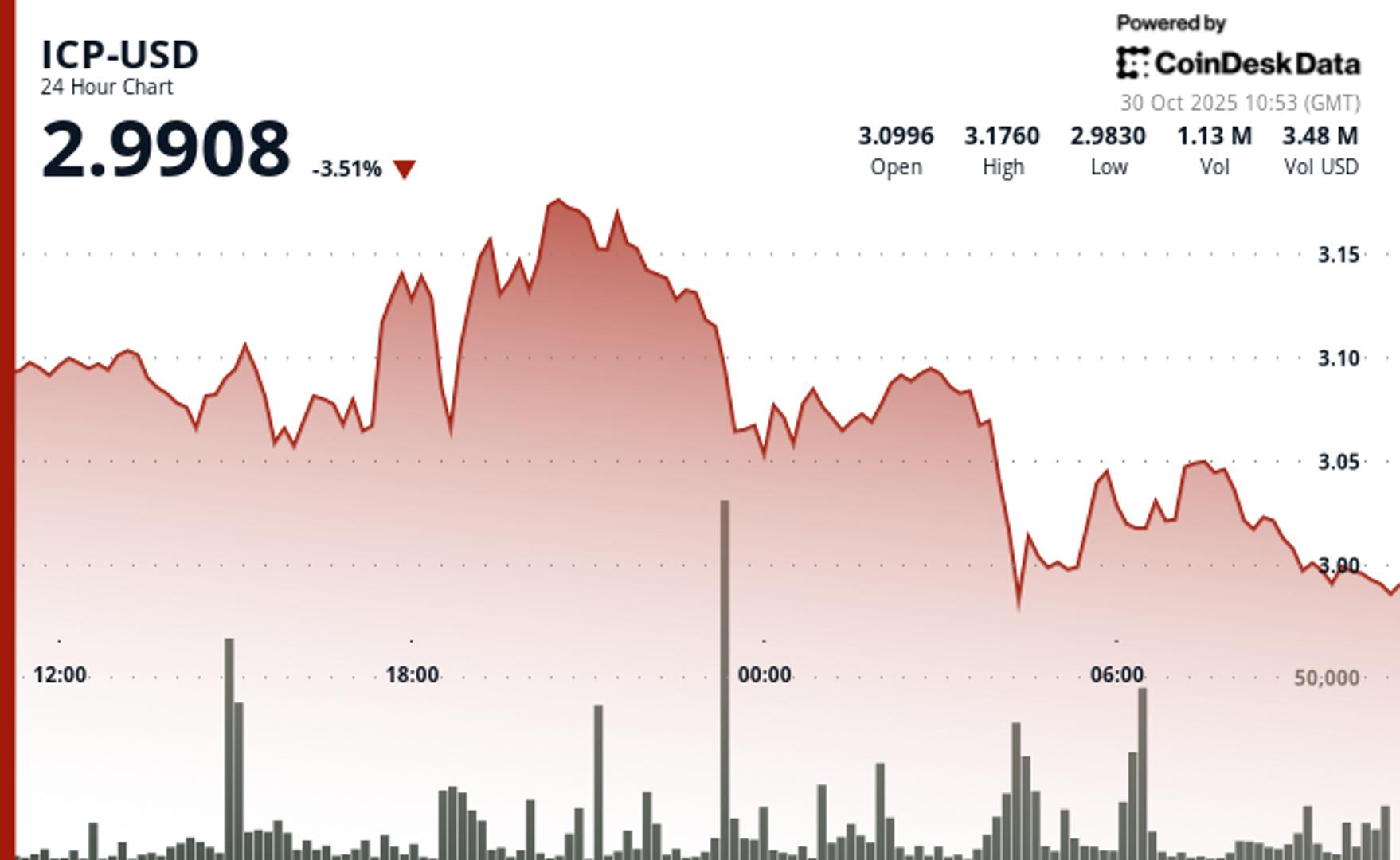


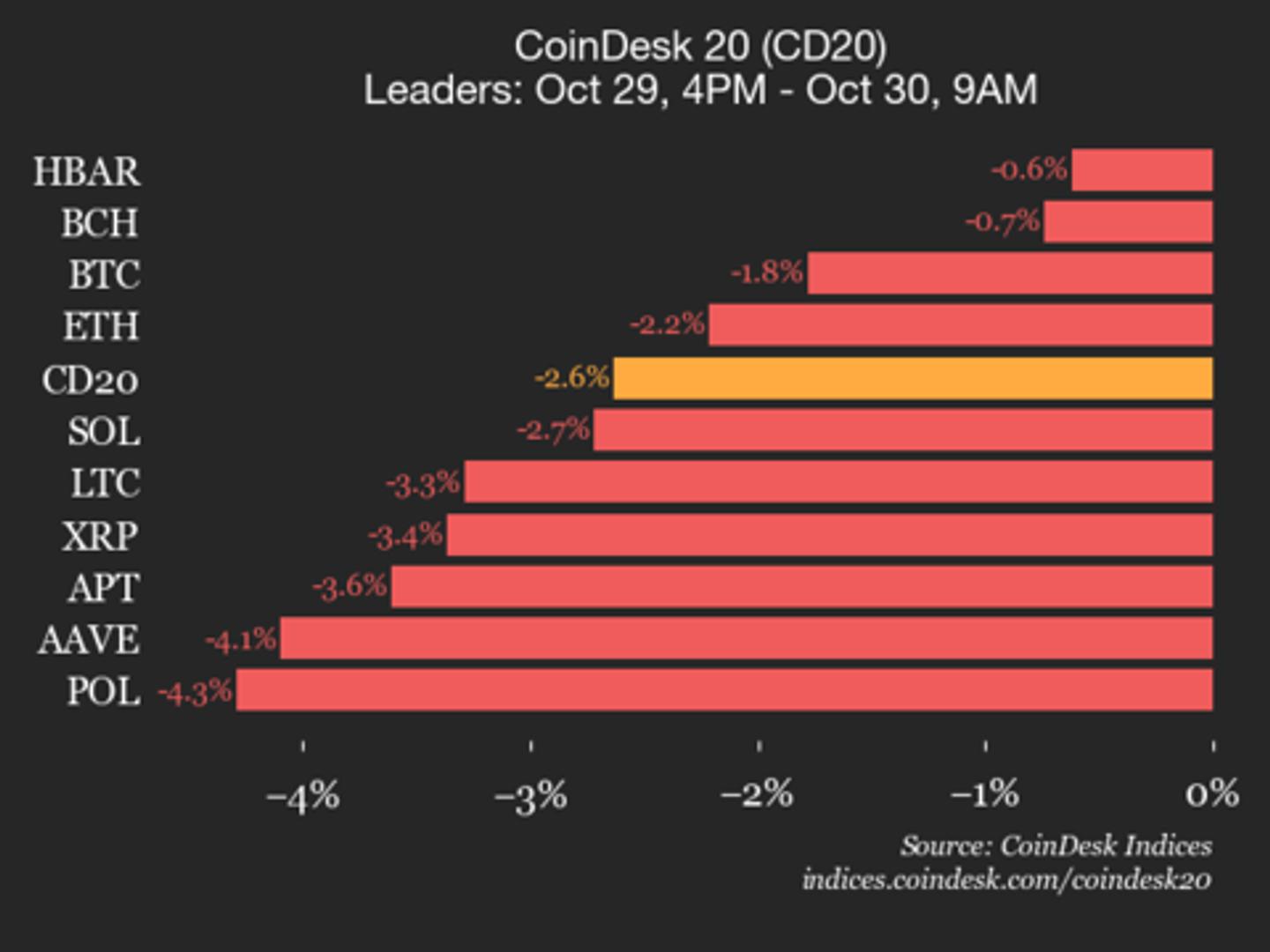







Crypto treasury firms lose shine as mNAVs sink, buybacks fail, and regulators move to curb risky token-hoarding strategies.
The post Digital asset treasuries find hype is easy, endurance is hard appeared first on CoinGeek.
At the London Blockchain Conference 2025, tokenization was front and center, with financial institutions experimenting with tokenized deposits and RWAs.
The post Treasuries, tokenized bonds: What’s driving institutional adoption? appeared first on CoinGeek.
Nordea's move signifies increased mainstream acceptance and integration of crypto assets in European financial systems, enhancing investor access.
The post Nordea to allow Bitcoin-linked ETP trading on its platforms appeared first on Crypto Briefing.

Uphold's card relaunch could accelerate crypto adoption in daily spending, influencing financial habits and expanding digital asset integration.
The post Uphold reintroduces debit card in US with up to 6% XRP rewards appeared first on Crypto Briefing.

The MegaETH token sale's success highlights growing investor confidence in Ethereum layer 2 solutions, potentially accelerating blockchain adoption.
The post MegaETH token sale ends with $1.4B in bids, reaching $27.8B FDV appeared first on Crypto Briefing.

Bybit's compliance move may influence other crypto exchanges to prioritize regulatory alignment, impacting market dynamics in Japan.
The post Bybit to pause new user onboarding in Japan to comply with local regulations appeared first on Crypto Briefing.
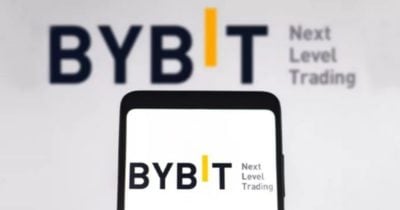
Increased BTC spot trading volume suggests enhanced market stability, potentially reducing volatility from overleveraged derivatives positions.
The post CryptoQuant reports peak in BTC spot trading volume in October appeared first on Crypto Briefing.


